- Home
- Collections
- DAVEY J
- Ardkeen
Ardkeen
First published 2021 By John Davey
State Highway 38, RD5, Wairoa, Hawkes Bay, 4195
[email protected]
Copyright 2021 © John Davey
Illustrations © Annabelle Narey
ISBN: 978-0-473-59635-4
A catalogue record for this book is available from the National Library of New Zealand.
All rights reserved. No part of this book may be reproduced or transmitted in any form by any means, whether electronic or mechanical, including photocopying, recording or by any information storage and retrieval system, without the permission in writing from the copyright holder.
Design and Production by Sue Wilson – SMWDesign [smwdesign].co.nz
Printed by CMYK
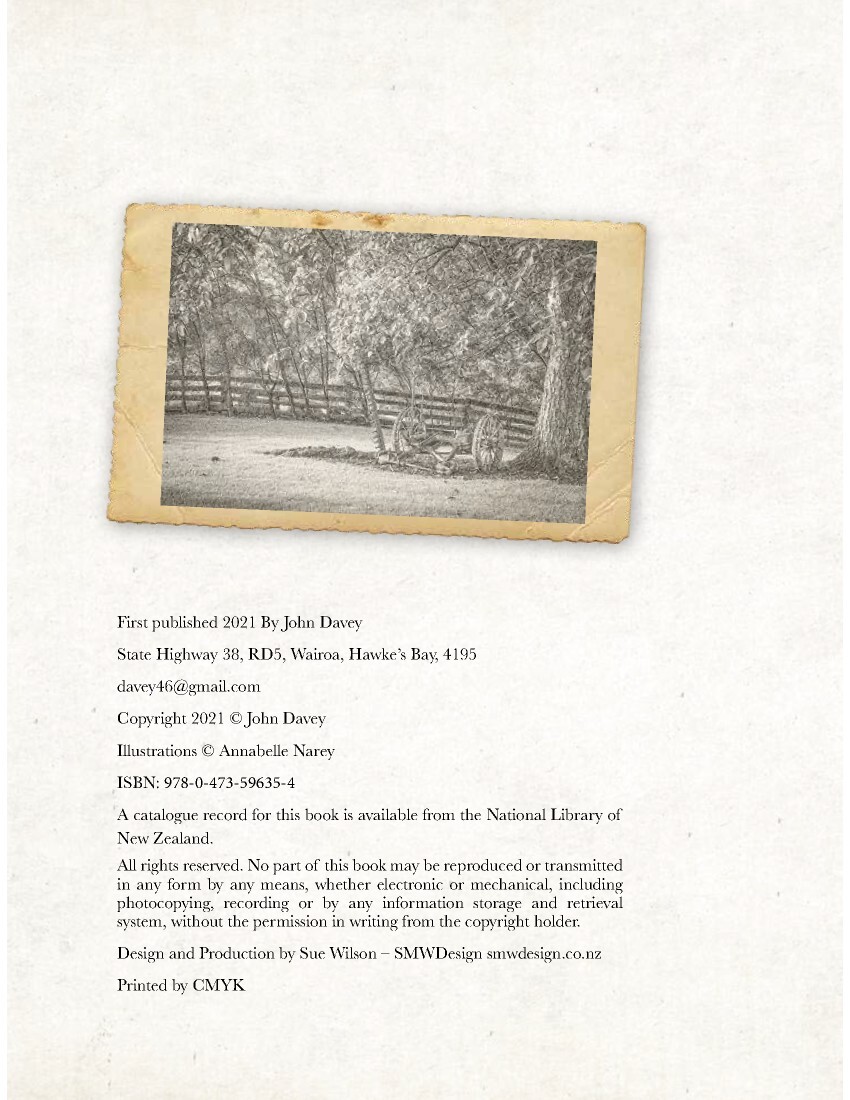
Page 4
CONTENTS
Acknowledgments 6
Foreword 8
The Early History 11
The First Farmers Pre-Ballot 15
William & Isobel Elliot 15
A Trip to Waikaremoana 19
The O’Neil Brothers 20
The Nilsson Family 21
The Soldier-Settler Scheme 23
The Ardkeen Ballot 27
The Settlers 37
Percy Jonas Matson 38
Frank Patrick Meagher 46
Raymond James Meagher (Jim) 52
Dave Robertson 58
Patrick Joseph O’Kane (Paddy) 72
Cranworth Franklyn Jackson 84
James Christopher McLean (Jim) 108
Maurice Patrick Malone (D.C.M.) 124
James Tolme (Jim) 134

Page 5
William John McKay 146
Jack Owen 158
Robert Willson Preston (Bob) 174
William Carson (Bill) 186
William Nicol (Bill) 196
Gerard Edmund Spooner (Gerry) 204
Ernest Charles Clifton (Ernie) 216
Matthew Andrew (Mattie) 238
Oswald George Birrell (Ossie) 246
The Roads 265
The Ardkeen Woolshed 270
Community life 277
Unveiling the Cairn 278
Ardkeen Hall 279
The Dog 280
Ardkeen School 281
Afterword 284
Glossary 287

Page 6
ACKNOWLEDGMENTS
Thanks are due to a great many people who have contributed to this project and without whose help it would not have been completed.
The greatest debt is to the descendants of the original settlers, who have generously given their time and encouragement.
Special thanks to the late Stu Birrell, his sister Helen McKinnon and Airlie Maxwell for the hours spent recounting tales of life on Ardkeen. For me, these have been happy times, and Airlie continues to ply me with stories and whisky. Gratitude also is extended to the second generation descendants; Jeanette Steed née Andrew, Malcolm McLagan, Mason & Marty Birrell who continue to encourage and support.
I want to thank the current Ardkeen farmers: William (Dinty) Little, Richard and Harmony Wallace, Brian & Lynn Jones, Roger Allott, Bill and Fiona Prestage, Alison Carter, Donna Swann, Colin & Marg Baynes, Andrew & Caroline Holden, Grant and Sue Crawshaw and recently Dave Hayward for allowing me access to their farms.
Thank you to the staff of Archives NZ in both Wellington and Auckland, for their kind professional help. A special thank you to Ross Harrison Snow, District Council Archivist at Wairoa, for his guidance and encouragement from the start of the project and also Jill Grooby at the Wairoa Museum.
A big thank you to Dr Ashley Gould for allowing me to quote from his thesis: ‘Proof of Gratitude Soldier Land Settlement in New Zealand after World War I’.
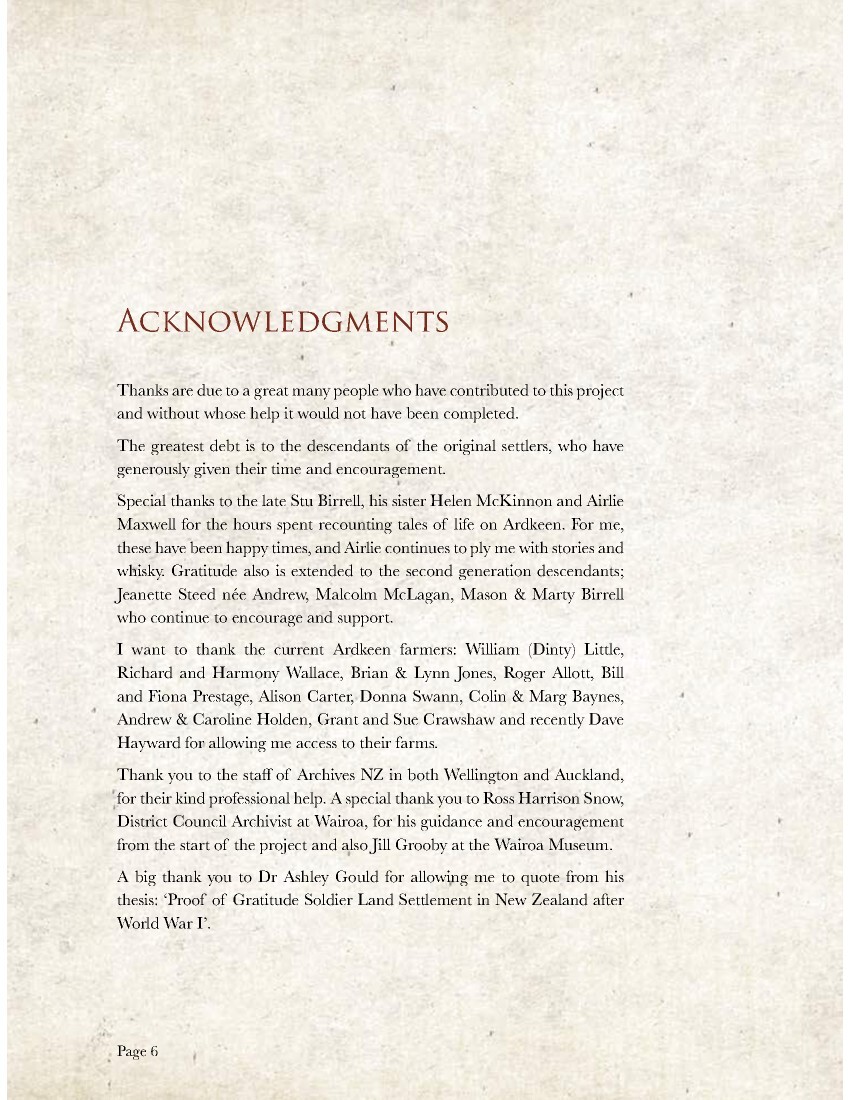
Page 7
I wish to acknowledge Paperspast [Papers Past] for their extraordinary resource and the Pam Torbett Charitable Trust for their assistance.
Liz Greenslade and Dennis Munro have advised and encouraged me throughout the project, and generously allowed me to use some of their research from the Salute Wairoa project. My thanks to Sherayl McNabb for assistance with the settlers’ wartime service records.
A big thank you to Ann Revington for her help with the reading and proofing the book. And to the many others who have been so generous with their time and help and who include: my mom June Vernon, Doreen Owen, Chris Redmond, Rupert Ryan, Craig Little, the late Norm Robinson, John and Ra Cotter, Howard Picton, Yvonne McKinnon, John Bowen, Jenny Anderson, and the Frasertown Pub crew whom I have bored to tears.
Sadly, we found very few photographs; I want to thank my sister Annabelle for illustrating the history and for her invaluable contribution to early editing and the final layout of the book.
I would also like to thank Susan Palmer who generously gave her time to undertake the final proof-reading.
Thanks also go to my wife Sarah for her professional advice, encouragement and support throughout the project.
John Davey

Page 8
FOREWORD
John Davey is to be congratulated in his determination to research and publish a history of the Ardkeen Settlement. John is qualified to produce this work. His maternal Grandfather drew a block on the Clydebank Settlement. John’s paternal grandfather owned the neighbouring property, Mahanga. His parents and four siblings owned and farmed one of the subdivided blocks for over 20 years.
Ardkeen was an example of properties purchased by the Crown and then leased or sold to returning WWI veterans, as repayment of a debt of gratitude to the soldiers for their service in the horrors of WW1, the War to end all wars.
It must have been a red-letter day for the Wairoa District when the local properties Ohuka, Omana and Ardkeen were balloted. It had been a decade earlier, in 1910, that the civilian ballot settlement of Clydebank had occurred. Local Wairoa politicians had long advocated to central government to break up the large estates to get Wairoa going.
The practicalities of farming were challenging at best. The lack of road access meant the balloted were given small homestead blocks to live on although this meant up to two hours daily travelling on horseback to get to the back blocks.
They all had to use the existing Ardkeen Station woolshed which meant driving stock through other settlers’ blocks as the Titirangi Road did not exist. Water for the mobs was an issue as when the mobs arrived on the Waikaremoana Road woolshed and yards it sometimes took days to complete shearing.
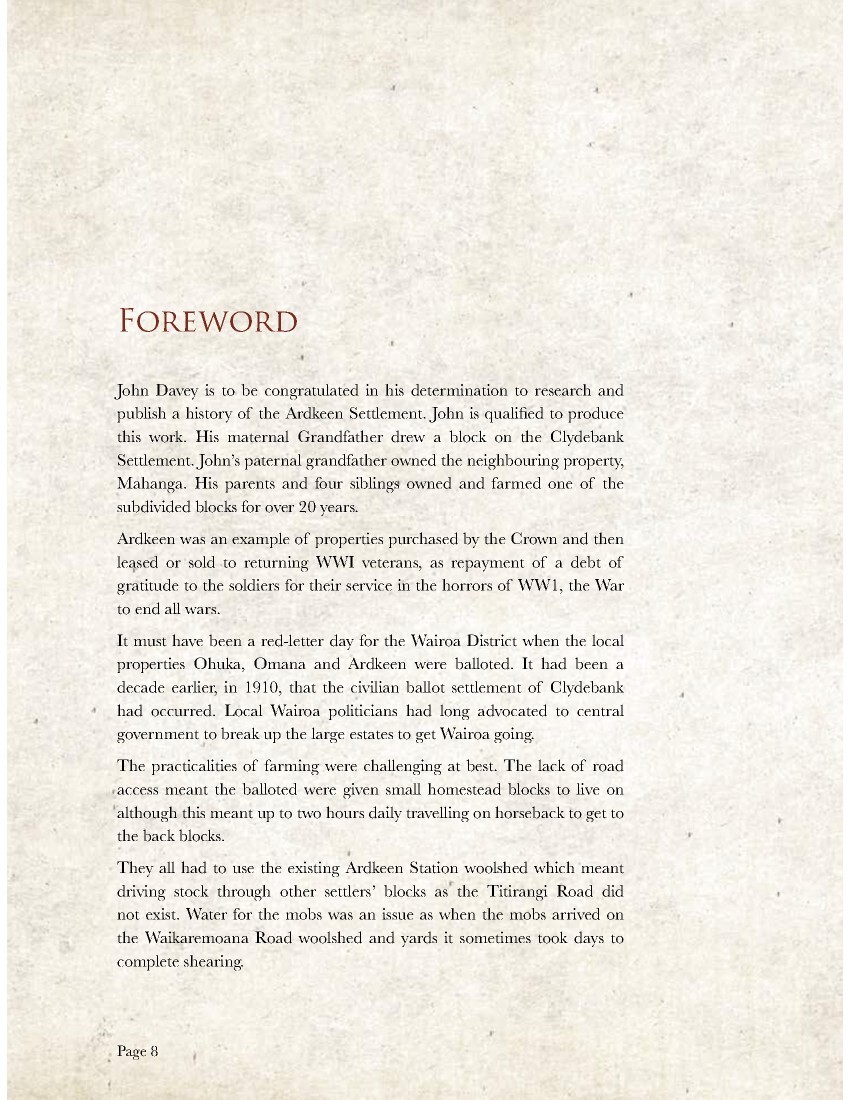
Page 9
The history reflects the day-to-day challenges of life on the farm including droughts, earthquakes, and international financial impacts on farm prices.
1920 was a mini boom driven by the returning soldiers and bulk supply prices for farm produce from the UK. Life got more difficult with a recession from 1921 and decidedly grim in the 1930s with the crippling effects of the Great Depression.
To enable the returning soldiers and families to survive, land was revalued to lower rents and debts written off.
Restructuring also occurred in the wider farming community. Amalgamation of land titles also occurred to cope with those who found the going too tough and to better align land titles to the road access.
The Ardkeen settlement must be considered a success despite the financial problems that occurred along the way. The community today reflects the work and effort put in by the returning soldiers.
The book is a tribute to the 100 years of hopes, vision and effort that have gone into the progress that has occurred over that period. John and his small team of helpers can be justly proud of this production.
Dennis Munro
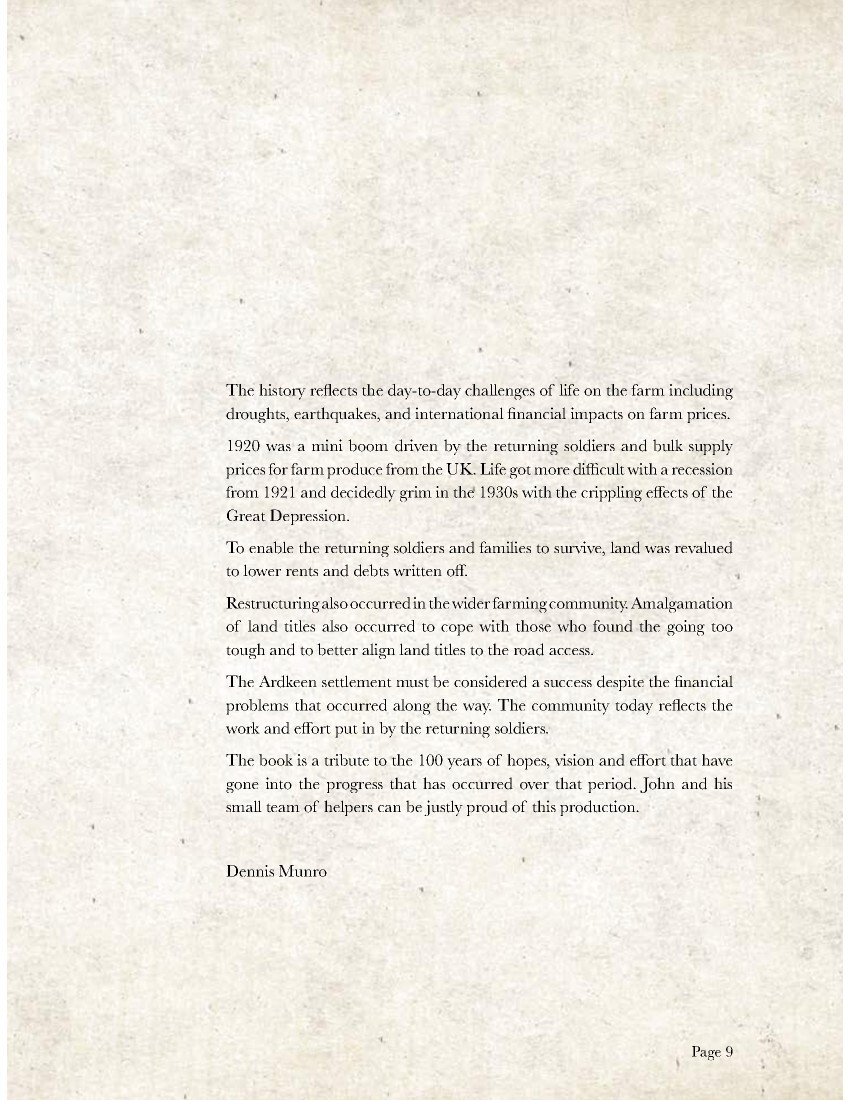
Page 11
THE EARLY HISTORY
Manutawhiorangi was the name of the land lying between the Waiau River and Waikaretaheke River, east to Pakowhai, north to the Mangaaruhe River, and west of the Mangakapua and Makapua streams. Manutawhiorangi – meaning ‘bird – song – lament – sky’; the land was renamed “Ardkeen” in 1900 by the O’Neil brothers, in reference to their Irish heritage. Ardkeen is the name both of a town and parish in County Down; it is proposed that the name is derived from Ard Caoin ‘the pleasant height’. This reinterpretation may have occurred in the Irish language; whether or not this is the case, the spelling Ardkene is found as early as 1306 AD. 1
This country of rolling terraces separated by streams and gorges along river flats beside the Waikaretaheke River and Waiau River, rises from 130 to 1,364 feet above sea level, many of the valleys are narrow with unstable slopes. The high terrace soils are covered with layers of volcanic deposit from the early eruptions in the Rotorua – Taupo region with some banks on the Waikaremoana Road showing at least 12 layers. 2 The last Taupo eruption was approximately 1,700 years ago but a more recent Tarawera eruption 700 years ago left a light layer of ash over the western slopes of Ardkeen. The pumice deposits from these eruptions are evident on the west facing country, and apparent on the ridge tops and terrace country. Over time the pumice has been weathered from the steeper country leaving clay over mudstone. This was well utilised land in the early days of New Zealand with evidence of several well-watered Pa sites across Manutawhiorangi with kumara pits and middens on the contoured terraces still visible today.
1 [https:]//www.placenamesni.org
2 [https:]//www.grassland.org.nz/publications/nzgrassland_publication_1828.pdf
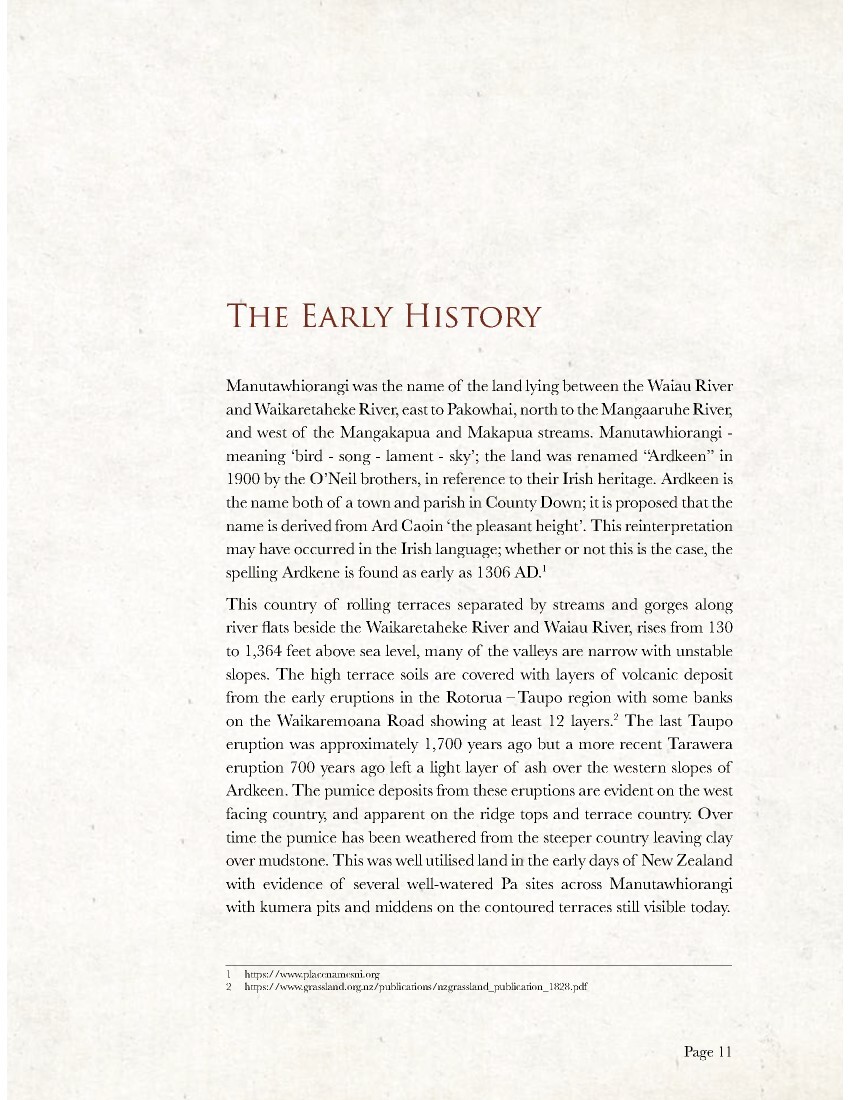
Page 12
The main ridge running west through Manutawhiorangi toward Waikaremoana from Pakowai, near Frasertown, was a thoroughfare to Waikaremoana and the centre of the bush clad Te Urewera, linking the coast to the interior. In June of 1824 a Maori fort, ‘Titirangi’, situated on a high point at the south-eastern corner of Manutawhiorangi, four kilometres west of modern day Frasertown, was the site of a battle. The Arawa, Ngati Awa, and Tuhoe tribes, along with some Nga Puhi, attacked the Ngati Kahungunu people with muskets. This was the first time a European weapon was used in local warfare, resulting in the defeat of the defenders. 3 The Titirangi Pa was not re-occupied.
The first sheep farmer in the valley was Felix Goullet, a whaler of French descent, who farmed 3,000 sheep on the North bank of the Waiau River at Ruapapa. Felix had been married to a Maori woman who died leaving him childless. Felix remarried a European woman and had five or six children, but the family fled their farm when their Maori shearers were slaughtered by Hauhau raiders in 1869. 4
George Burton a Surveyor first surveyed the Taramarama District, within the Hangaroa, Waiau and Ruakituri rivers through to Waikaremoana, for the military in 1866. 5
In 1866 at Waiparapara ‘Te Kapu’, a settlement at the junction of the Waiau and Wairoa rivers five miles inland from Wairoa, there was a gathering of Maori tribes where at Te Hatepe, Kopu’s Pa, four hundred rebels, took an oath of allegiance to the Queen. At this meeting Chief Pitihera Kopu told the rebels that their land had been confiscated because they had supported the Hauhau Pai-Marire uprising.
On the 5 April 1867 the Crown confiscated 42,000 acres of land between the Hangaroa River, Waiau River, the Mangapoike stream, and Kauhauroa Stream to the south-east, the Ruakituri River to the north, and stretching inland to Lake Waikaremoana and south to the Waikaretaheke River. A month later another meeting was held to discuss the question of ceding land to the Government for settlement; this time there were between 1,500 /2,000 Maori people present.
3 Lambert, Thomas (1925) The Story of Old Wairoa and the East Coast. Reed Publishing, p. 317.
4 Ibid, p. 592.
5 Ibid, p. 406.

Page 13
It was decided to provide 30,000 acres for military settlers and others who had helped stem the Hauhau invasions, the balance of the land was to be returned to the people.
At a ceremony on 1 April 1867, costing £1,000, Chief Kopu contributing £300, Mr McLean, representing the Government, was told that the Hauhau did not own land about Wairoa. It was also pointed out that the outrages and murders were committed by people from outside the district. However, the Government took the land. The land the Maori people ceded to the Government that day was 26,000 acres east of the Hangaroa River and 45,000 acres to the west and north of the Waiau River. 6
At the time the confiscation of Wairoa lands as compensation for the rebellion was under discussion between the Government Agent and the chiefs. Among the chiefs present was Pitihera Kopu who was asked if he had any interest in the land. Pitihera indicated that Mere Karaka, his wife, had an interest, however Mere Karaka told the government that although the land was hers she was prepared to hand the area to the Crown as compensation for the sins of the Hauhau followers. 7
In August 1872 Samuel Locke met with the Maori, having previously ridden over the land visiting Onepoto and Waikaremoana, in order to ascertain appropriate boundaries for the blocks to be divided into suitable sheep runs. It was decided that rivers and streams would be used as boundaries in order to avoid the cost of a formal survey.
The original bridle track to Waikaremoana crossed the Waiau River eight times before reaching Te Ariki – Ruapapa, at the Waiau, Waikaretaheke junction, before following the Waikaretaheke River up to Onepoto.
The first road to Lake Waikaremoana was surveyed in 1872, by Mr Straphell. 8 In the meantime travellers followed the bridle path making frequent river crossings.
8 Lambert, Thomas (1925) The Story of Old Wairoa and the East Coast. Reed Publishing, p. 591.

Page 15
THE FIRST FARMERS PRE-BALLOT
William & Isobel Elliot
William Elliot was born in Scotland in 1830 and grew up in Victoria, Australia where his father was a grazier. In 1865 William married Isobel Turnbull in Dunedin. Isobel was born in Scotland in 1830 and grew up in Alexandra, New Zealand where her father was a merchant.
William Elliot was the first to farm the fern and scrub-covered hills of Manutawhiorangi. He paid rates to the Wairoa County Council in 1878 on small sections adjacent to the Waiau River. This was the first year that the new council levied rates across the district. He may have settled on Manutawhiorangi before this. The Elliots’ first homestead was a whare built near the Titirangi Road; a fig tree marks the site today. William cleared bush, fenced, and sowed grass on the hills.
Fencing 9 was essential for settlers of the bush-clad East Coast New Zealand hill country; the Totara tree played a critical role. The typical fencing contractor owned pack-horses with pack saddles, a riding hack or two, his camp gear, cross-cut saws, spades, rammers, shovels, at least 10 wire strainers, hammers, wire cutters, axes, files, chisels, maul and wedges for splitting. When accepting a contract to erect a fence, the farmer usually provided the wire, staples, gate hinges, bolts to build gates, and pieces of broken harness chain for gate latches; everything else the contractor got on the job.
9 See appendix
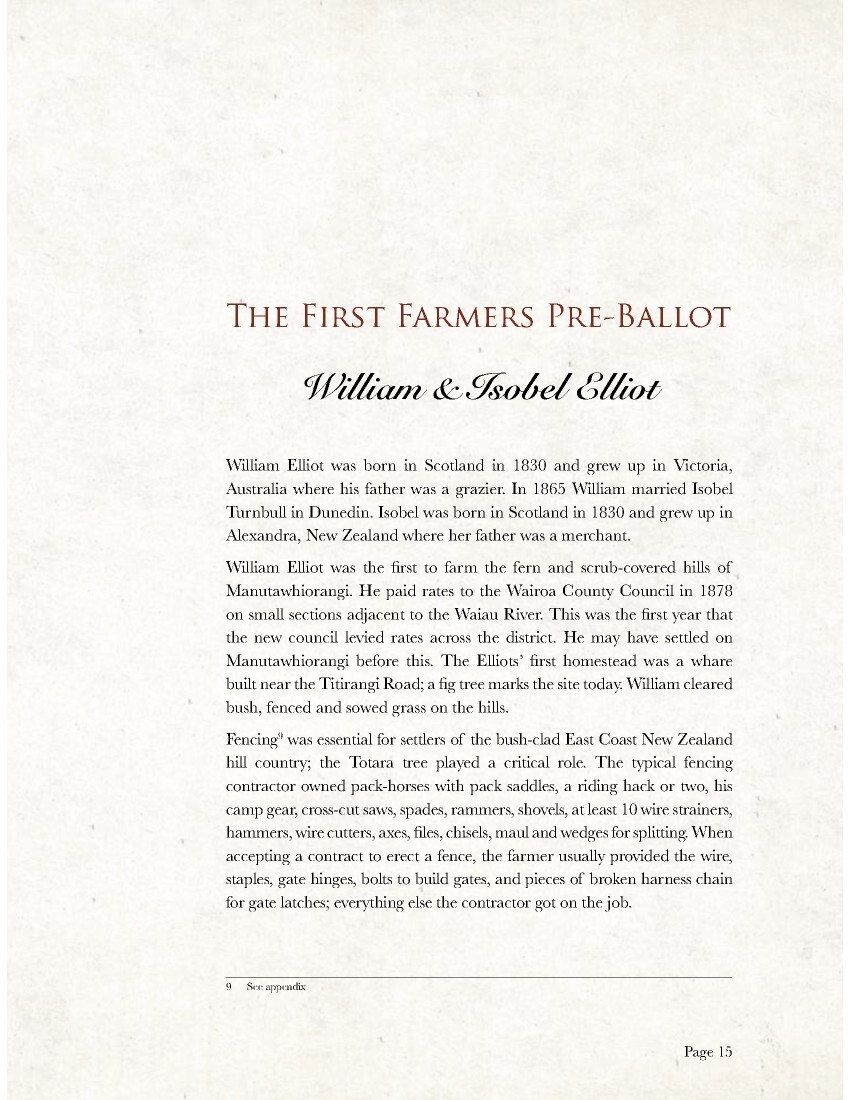
Page 16
The work took him into the back country for long periods. The contractor would set up camp and fell Totara trees for material. From the logs he would split fence-posts, strainer-posts, angle-posts and battens and carry on to the fence line by packhorse.
A packhorse, usually a Clydesdale, carried 8-10 posts or two strainer posts at a time working in teams; their tracks are clearly visible on Ardkeen today.
To enable livestock management, William built small holding paddocks of around three to ten acres throughout the station. Often a set of sheep yards with whare or hut was constructed nearby providing accommodation for the shepherds, bushmen and fencers. These whares were built from split totara or ponga logs, and fern, with a fireplace. Later they were constructed with corrugated iron. Beds were four posts set in the ground with a split totara frame and wire netting stapled to the frame; dry fern served for a mattress. Sometimes a window with a sack to close out the draft was added.
The holding paddocks were used to hold the mobs of stock coming in from, or returning to the outlying country and pastured fresh horses.
Manutawhiorangi has two leading ridges leading southward down to 600 acres of river flats along the Waiau River and homestead. The central ridge has open terraces with natural ponds scattered throughout.
Three miles north of the Waiau River is a ridge running east west that is 1,000 – 1,300 feet above sea level. This ridge served as a route to Waikaremoana in Maori times. Six thousand four hundred acres of Manutawhiorangi lie to the north of this ridge – Jackson Road runs to the west and Preston Road out to the east. This country of easy terraces and steep gullies open to the north, falls away to the Mangaaruhe River.
Currently forty acres of virgin bush that once covered Manutawhiorangi remains on the land set aside as Harbour Board Reserve.
In 1885 the Telegraph newspaper published a notice announcing William Elliot of Frasertown had been appointed a ‘Justice of the Peace’ which suggests that Elliot was a determined and disciplined man with a strong sense of community. William Elliot ‘Returned’ 2,200 sheep that year indicating he had cleared about 2,000 acres.
1887 Papers Past, reported that Mr Elliot owned 4,200 sheep – a further 2,000 acres of Manutawhiorangi had been developed in the first 10 years of his tenure. By 1898 sheep numbers had increased to 9,877 sheep indicating

Page 17
that most of Manutawhiorangi was being farmed.
According to local hearsay, Isobel Elliot was popular with Maori people; when she fell ill they had tried to take her by canoe to see a doctor in Wairoa but unfortunately the river was in flood.
On 27 August 1894 Isobel died; her death certificate notes cause of death as cardiac dropsy, diabetes.
Isobel is buried above the Waiau River where her grave can be seen today. Curiously, although the headstone states Isobel died aged 57, records show that she was in fact 64 years of age.
On the 9 May 1899 William Elliot wrote to the Clerk, Wairoa County Council to advise he had sold Manutawhiorangi to Henry and David O’Neil, owners of Ohuka Station, along with his sections 62- 125 at Frasertown.
At the time of sale Manutawhiorangi was carrying 9,577 sheep.
Isobel Elliot’s grave on the property
Manutawhiorangi sale advice to Wairoa County Council
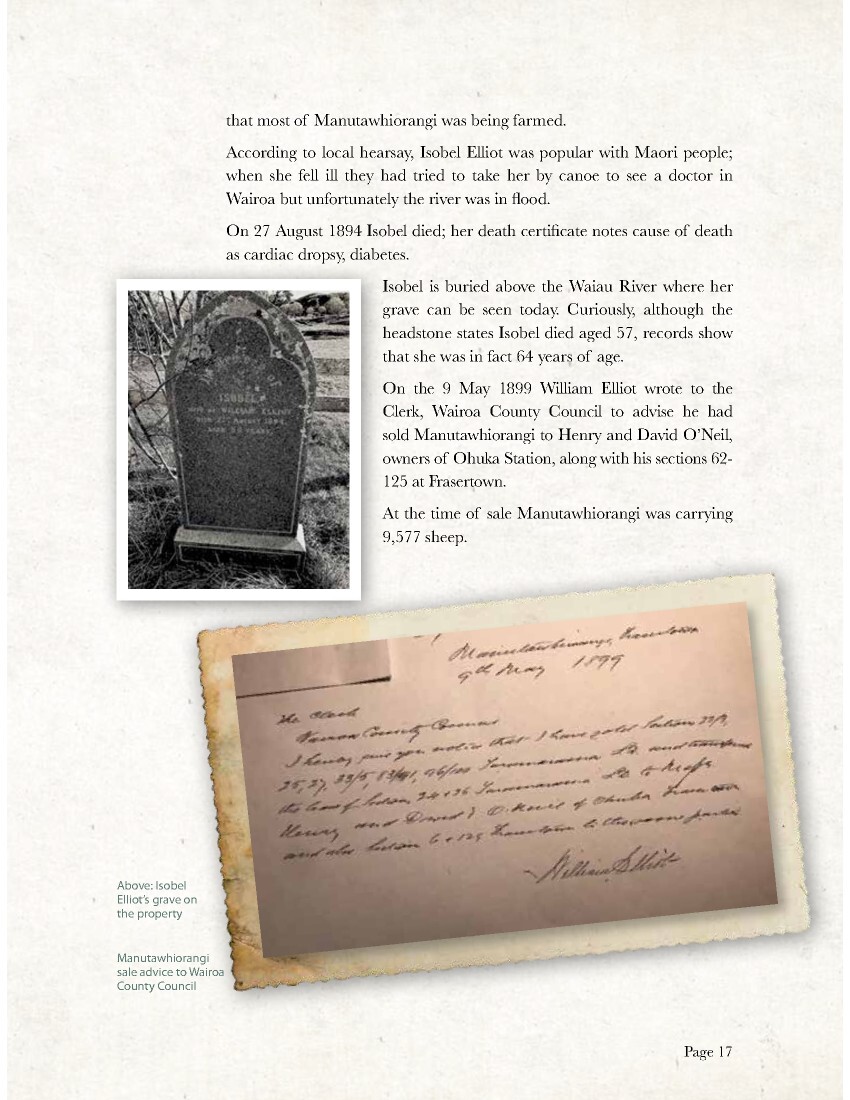
Page 18
William Elliot sailed to Sydney on the S.S. Mararoa, on 21 July 1899, however he died of heart failure and influenza on 26 October 1899 in Melbourne, and is buried at the Boroondara Cemetery, Melbourne. William left an estate of £17,392.0.5.
As William and Isobel had been childless, their estate was left to eleven members of the Elliot family in Australia and Scotland.
William Elliot’s grave in Boroondara cemetery
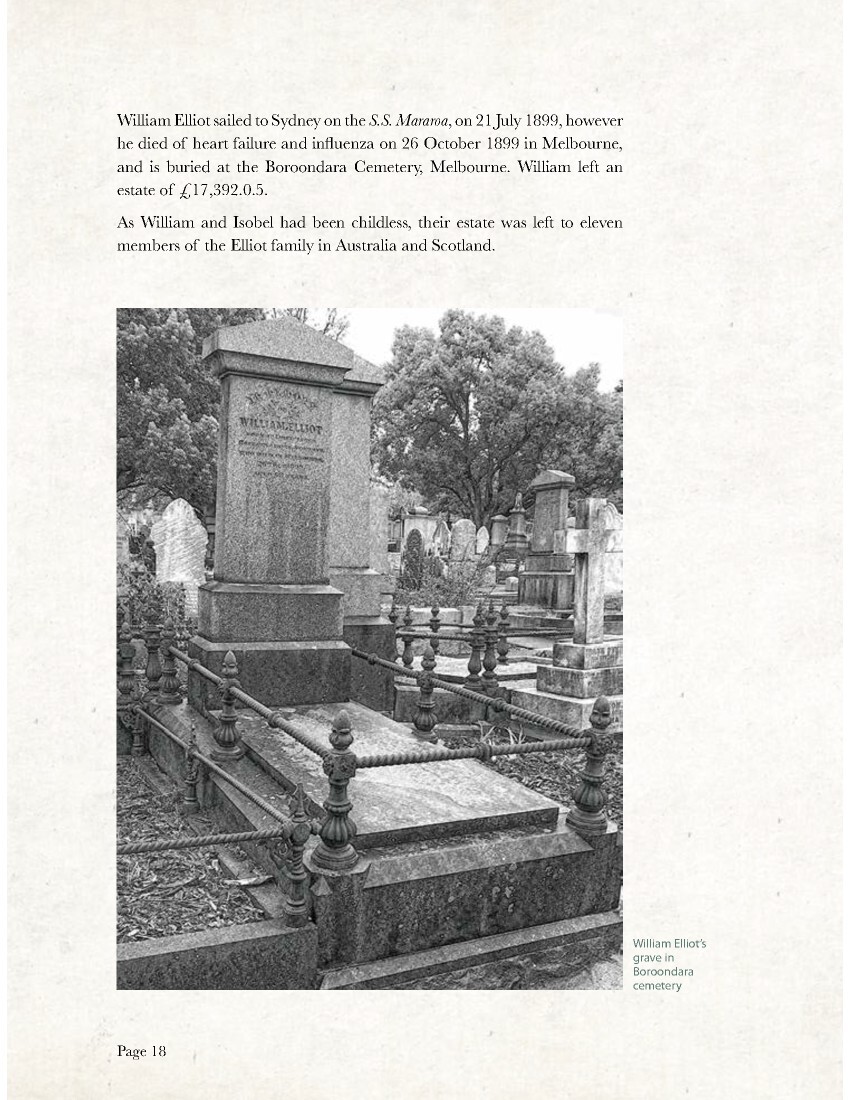
Page 19
A TRIP TO WAIKAREMOANA
Published Poverty Bay Herald 20th February 1896
A YOUNG lady writes from Wairoa to her parents in Gisborne an account of a trip to Lake Waikaremoana, which will no doubt be read with interest. The story runs: On Wednesday, February 5th, we rose at 4 a.m. and made an early start, crossing the lovely bridge that spans the Wairoa river at 7 a.m. Having a splendid pair of horses and an excellent driver we soon leave behind us the Awatere Creek, Maori cemetery, and Maori flour mills, and reach Frasertown at 7.30 a.m. The Maoris, being early risers, were busy in their fields harvesting, and as we passed by the usual greeting – “Tenakoe” – was exchanged. After passing Mr Cooper’s Junction House we had to cross the ferry, and here we lost about half an hour, for when you want the punt it is sure to be on the other side of the river. The next place of any note is the Runuimanga pah, then Mr Tunk’s woolshed on the lover station, Ehine-te-wai Creek, Whakatiniroa settlement, Matai Gorge, Papa cutting, Arahi, Mr Goldstone’s upper station, and Mangatino Creek. As the road was hot and dusty, and there were some peach trees a little way off we pulled up, and the “General” went to get us some. Mr Hallett came along and offered us some fine ripe ones. We next came to some lovely apples, which were very refreshing after our long drive. The next station we passed was owned by Mr Phillips, then Mr Mawe’s house and Mr O’Neil’s station, where we came to a creek and the horses were refreshed with a drink. We stopped a little further on at the Tarapatiki bridge to boil the billy, and found our appetite had risen. When Nature’s demands were assuaged and the horses had had a good rest we started off again at 1.30 p.m. After passing the homesteads of Messrs Beecham, Lambert, and Bertram we arrived at Mr Mills’ and found we had to resign our places in the buggy and take to shanks’ pony, packing Gladiator and leading Manager. We were told it was four miles, but we found it to be six, and uphill on newly-made road all the way. Up to here the scenery was beautiful. On one side was the river rushing and dashing along, sometimes clear and sparkling, at other places all white foam as it went surging over the stones, and the bank on the other side sometimes flat and sometimes hilly, with ferns and shrubs growing on it. In one place the bush was on fire, and pieces of burning wood were lying on the cutting so we had fire on one side and water on the other we began to feel very thirsty walking, and though we could see the little lakes here and there they were at the bottom of the hill and we were at the top, so it was water, water everywhere, and not a drop to drink, but presently we came upon a spring, the water being just like ice. When we had a good drink we felt as if we had fresh energy to go forward. After walking for two hours we came in sight of the lake, its water sparkling like crystal in the sun and little bays all round it. We went along the lake a short distance and pitched our camp. We were glad to get the billy and potatoes on, only we were too hungry to give the potatoes long enough to cook, but as hunger is the best sauce, we ate everything with a relish when we would have turned up our noses another time. It was very cold at night, but being worn out we slept till morning. Thursday morning dawned, and we thought we were going to have rain, but it proved to be only the pride of the morning, and when we had finished breakfast we went to Oringi bluff (940 ft) and carved our names in the stone. Mr Gallagher, who lives up there, showed us the utmost kindness. He took us for a row on the Lake to Rosy Bell inlet, and we went along the new road. We were the first white ladies on it. Then we came back and two of us went for a bathe. It was a wee bit cold, but we thoroughly enjoyed it. The water was so clear that we could find even a piece of soap at the bottom of the Lake. After dinner Mr Gallagher took us round to the outlet where the water flows out of the Lake, and from one place you can see the Mahia and Portland, and at night, he said, you can see the revolving light of the lighthouse. If it had not been so misty we would have had a glimpse of the sea. Then he took us along to the cave, where we carved our names. The Lake is 2700ft above sea level. It is 840ft deep, and discharges 80,000,000 gallons of water daily. Then we came back to Mr Mills’, very hot, sunburnt, tired, and footsore in 1 ¼ hours. We came home on the Friday, leaving at 6.30 and reaching home at 10 o’clock. I forgot to tell you that the Maoris were so excited at seeing us. They jumped, shouted and laughed, talking away all the time, and we had to shake hands with many of them.
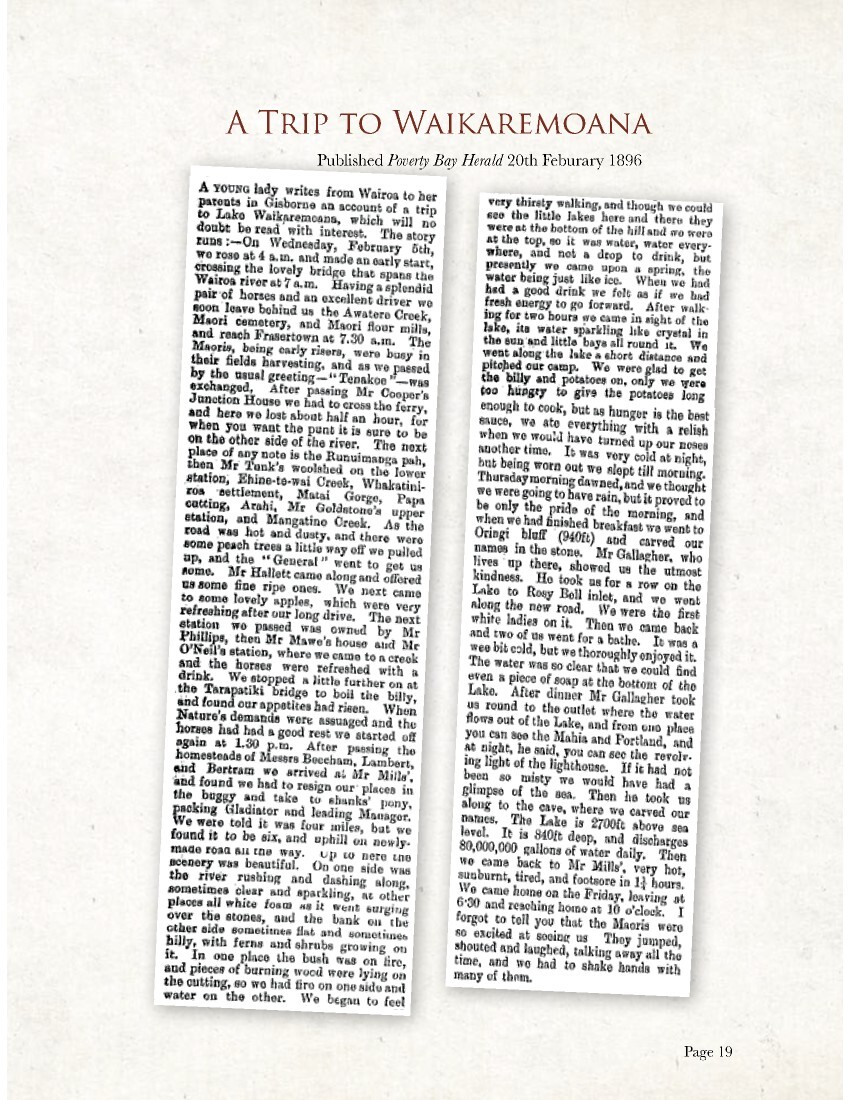
Page 20
The O’Neil Brothers
David Edward O’Neil born 1861 and brother Henry James O’Neil born 1862 in Emerald Hill, Australia had both been successful miners from Bendigo, Victoria. David had married Mary Eliza McFarlane in 1892. Henry did not marry. The O’Neils bought Ohuka Station in 1893 and Manutawhiorangi in 1899. They borrowed nearly all the money from Mr Elliot to buy the Manutawhiorangi. At the time of sale, Manutawhiorangi was carrying 9,577 sheep. 10
The O’Neil brothers renamed Manutawhiorangi Ardkeen in 1900.
Harry Steele a one-time resident of ‘Cricklewood Station’, then of Auckland was on a cycling holiday and visited Ardkeen in the late summer of 1900, and described the home as ‘a ‘pretty domicile and luxurious quarters’.
In 1901 the O’Neil brothers returned 16,700 sheep for both Ardkeen and Ohuka stations. There had been strong economic growth with full employment and rising wages throughout the O’Neil tenure, however the burden of debt may have compelled William Elliot’s Trustees to apply pressure on the O’Neils to repay the Elliot mortgage and settle the Elliot Estate.
In 1905 Henry O’Neil sold ‘Ardkeen’ to Magnus Nilsson and sons Martin and Oscar. Henry O’Neill died at a private hospital in St Kilda, Victoria, Australia, on 19 June 1913. He died intestate, leaving an estate valued at £795.15. He had invested in mining shares that had become valueless.
10 Author’s note: Land that had been sown in pasture at the time carried one sheep to the acre, indicating Ardkeen was close to being cleared of bush and fenced.

Page 21
The Nilsson Family
The Nilsson family, Jens Nielsen and Elina Ekberg, his wife and brother Magnus landed at Wellington on 6 March 1873; the three young Swedes arrived as immigrants; unlike British fare-paying settlers, they were not entitled to 40 acres of farm land. Jens and Magnus took up bush land at Alfreton [Alfredton], Eketahuna, cutting down trees to make space for a tent.
Magnus married Kjersti one year after arrival. They lived in a slab, ponga and fern whare for several years while Magnus worked on roads during the week, and cleared their land at weekends. They had 6 children: Martin, Oscar, George, Ann, Jack and Olive.
In 1905 Magnus and Kjersti visited Sweden. While they were away, their house burnt down. That year Magnus, in partnership with his two eldest sons, Martin and Oscar, bought Ardkeen from the O’Neil Brothers. To help finance the purchase, Oscar sold his farm at Tinui and Martin sold his farm at Mount Baker, Eketahuna.
The NZ Herald reported on November 21, 1905, that Nilsson and Sons were erecting a woolshed powered by a seven horsepower Gardner engine with 10 shearing machines.
The Nilssons set aside three acres at Ruapapa for a school.
On 18 June 1917 an application was also made to build a school at Ardkeen, to be named Korokoro.
At the time of the sale, a number of men had worked for the Nilsson family for ten years or more; the family were regarded as hard working and kind and respected loyalty.
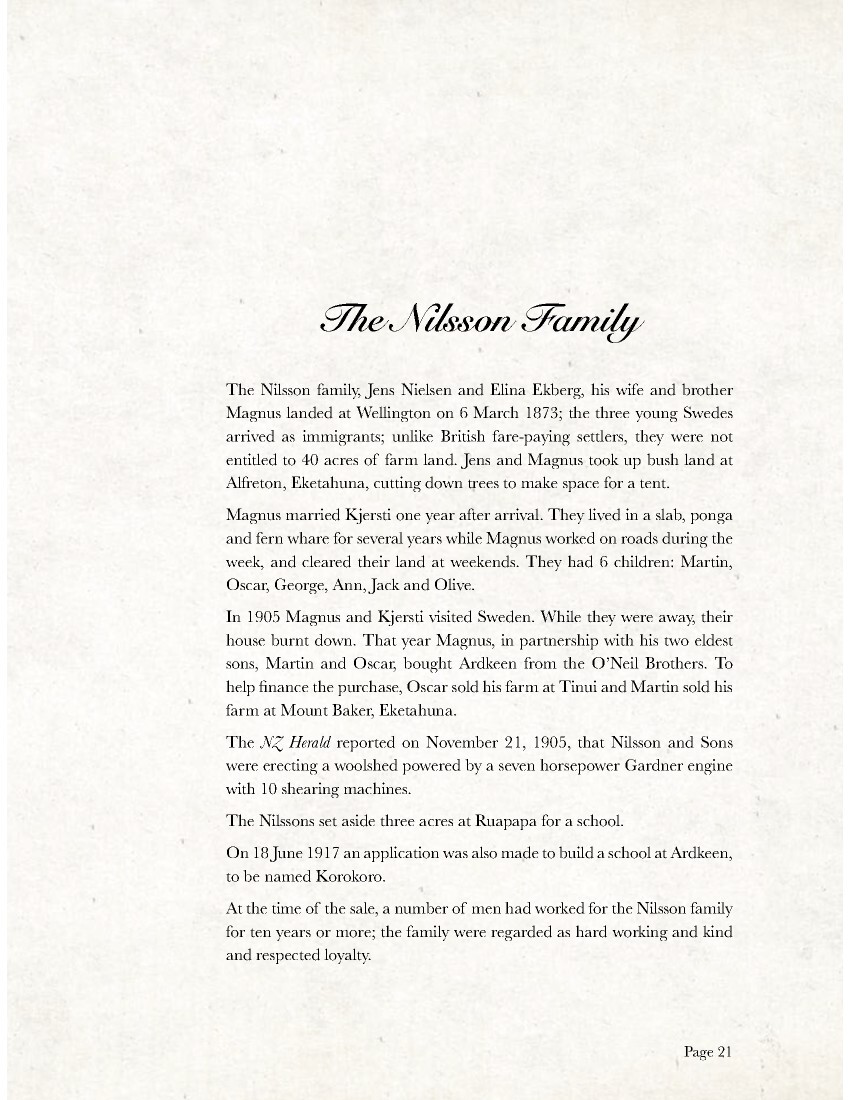
Page 22
The Nilsson Partnership farmed Ardkeen until 19 November 1919 when the Government bought the station, paying £121,900 under the Soldiers’ Settlement Act 1915. Ardkeen was paid for with £20,000 cash, the balance in war bonds or inscribed stock with delivery set for February 1920. The Ardkeen settlement balance sheet showed £138,130 as the full cost to the government. The value of Ardkeen was initially written down to £93,000 before, the ‘Court of Review’ finally set the value of Ardkeen at £33,000.
Obituary: MR WI HEMA
On Sunday, September 20, there passed away at the residence of his son, Pana, of Tahaenui, Mr Wi Hema, who was considered to be at least 100 years of age.
The late Mr Hema had experienced failing health for the past few months and, more recently had been confined to his bed.
Since 1931, he had lived and worked at Cricklewood Station, also owned by Mr Bayly at the time.
Not much is known about his younger days except that he worked on the first bridge across the Wairoa river. Later he had a very long association at Ardkeen Station with the late Mr Magnus Nilsson and his sons. When that station was sold to the Government for rehabilitation after World War I, Mr Nilsson showed his appreciation of Mr Hema’s work as a teamster and waggoner by presenting him with a waggon and a team of horses and by building a house for him at Rangiahua.
Whilst he was employed at Tahaenui he proved himself an industrious, diligent worker. He lacked patience with anyone who did not pull his weight and trained many of the Rangiahua people in the art of ploughing and fencing of which he was particularly skilled. He also excelled at growing kumaras, and like all of the older generation of Maoris, he always made provision for food for the winter.
He was a first-class horseman and until about eighteen months ago he was a well known figure riding along the main highway at Tahaenui.
His wife pre-deceased him many years ago. He is survived by three daughters Mesdames N. Cotter, T. Clark and T Te Kooti and by five sons. Messrs Heare, Pana, Huatahi (Jim), Kingi and Wano Hemi. Two daughters Lily and Emma died some years ago. One son, the eldest member of the family, Kingi senior, also pre-deceased his father. There are a large number of grand-children and great grand-children.
The tangi was held at Rangiahua, where a funeral service was conducted by Canon Rangiihu on Tuesday afternoon. The interment took place at the Rangiahua cemetery.
Photo captions –
Mr Wi Hema, was considered to be at least 100 years old.
The obituary above illustrates the high regard in which the Nilsson family were held.

Page 23
THE SOLDIER-SETTLER SCHEME
The Soldiers’ Settlement Act allowed returned servicemen to be granted farmland on generous terms, offering cheap finance in order to develop it.
After the armistice a large number of soldiers with venereal infections (an offence under army discipline) returned to New Zealand. 11
The Government emphasised that, like all the repatriation schemes offered, success in the soldier-settler scheme would ultimately depend on the hard work and initiative of the men themselves in converting initial benefits into long-term success.
More than 12,000 people applied for land during the three years after the Armistice of 1918. Potential applicants visited a Lands and Survey office to be apprised of the relevant regulations and given information about the land available.
Each application was forwarded to the district’s Commissioner of Crown Lands, a senior departmental official, who decided whether the applicant had the ability to succeed as a farmer.
He forwarded the approved applications to the local Land Board, which either allotted land or held a ballot where there was more than one suitable applicant. Of the 15,060 applicants between 1915 and 1930, only 4,018 were allotted land under the scheme. The scheme also placed new demands on the Valuation Department, which set the values of the properties. The Public Works Department built the roads to them and the Department of Agriculture provided support and advice to the farmers. The greatest burden fell on the Lands and Survey Department, which, like the rest of the public service, was under-staffed after four years of war. Returning staff were rapidly posted to departmental offices, and many junior employees of other departments were drafted in to assist. The work of the Crown Land commissioners expanded dramatically as they took on wide new responsibilities for managing securities, mortgages, title registrations and a myriad of other legal and financial tasks associated with the scheme. The department appointed supervisors of soldier settlements in each district to visit the purchase and other practical matters. Other district officials managed the scheme’s financial aspects. 12
7,000 soldiers were settled on farms up to May 1920. 13
The Reform Party’s intention to provide small farms that offered rural lifestyles for recuperative purposes, while also being close to centres of employment. 14
11 Gould, A. N. (1992) Proof of Gratitude, p. 163.
12 [https]://nzhistory.govt.nz/war/public-service-at-war/repatriation-of-returned-servicemen
13 Gould, A. N. (1992) Proof of Gratitude, p. 38.
14 Ibid, p. 19.
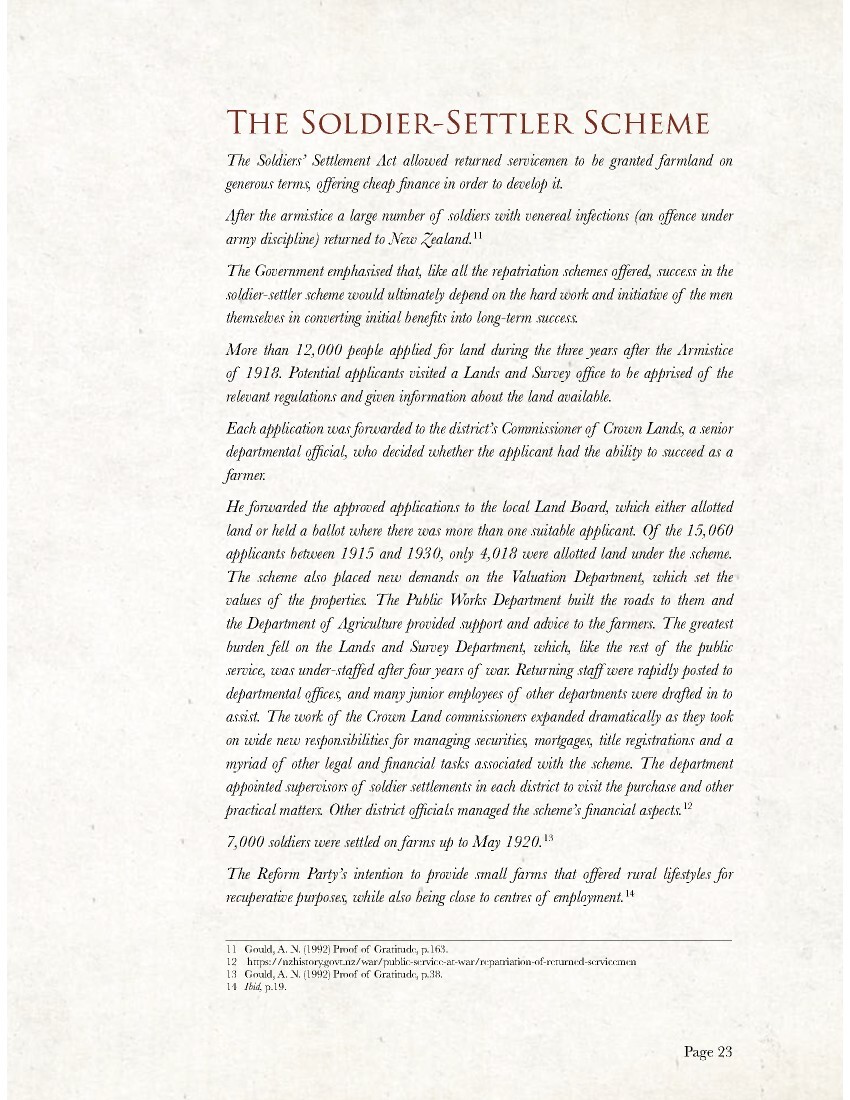
Page 26
Reform’s Childish Denial
Soldiers’ Land Charges are Specific
And Could be Greatly Supplemented if Official Pigeon Holes were not Sealed
Denials that fly in the face of facts are childish. And these are the only kind of denials that the Reform Ministers and their apologists are able to put up against the charge that they bought land for soldiers at an absurd over-value.
A common form of denial is to say that your enemy’s charge is vague, general, does not get down to tin-tacks.
This form of denial is an excellent defence IF TRUE, because a charge that is not specific is greatly discounted.
But if there is one charge, in the whole range of political charges, that is entirely specific, it is the charge of purchasing soldier-settlers’ land at absurd over-values – values at which the Government’s own valuations were crying derision. So when a Mr. Carter, in trying to excuse Reform, says that the charge is based on “vague generalities,” he is raising a defence that could not possibly be more out of place or out of tune with plain facts.
The childishness of the Carter comment is shown by Mr. Hall-Skelton, who gets right down to the point:
“I have given case after case of bad land bargains, and Mr. Carter must have read them, unless, like Rip Van Winkle he has just awakened. For his information I repeat two examples (1) Tatua West was bought for £27,500, when a year before it had been sold for £4300. (2) The Ardkeen Estate, of 11,000 acres, at Gisborne was bought for soldier settlement. From 1912 to 1919 it was taxed on a Government valuation of £15,000. The Government purchased it for £130,000.
“I ask why the Government on every occasion refused point blank to give the House a list of these purchases, showing the date, the Government valuation, and the price at the time of purchase. Why? They dare not!”
The fact that the Government paid £85,000 more for a block of land than it had valued it at and taxed the owner on is a big enough scandal to go on with. If it can explain this it may be able to explain the rest. But this will do for a start. Can Reform explain?
As to giving Parliament and the country details of these purchases, that is the last thing that the Government will do. But if a Labor Government were to rummage in the official pigeon-holes – ! ! !
When Reformers were trying to oust charges of scandal, they shouted: “Wait till we get hold of the archives!”
They got hold of the archives. Nothing happened.
But a fearless report on the soldiers land settlement archives would make the finest political reading of the day.
Prefers England’s Fogs
“I am writing to you on behalf of my wife and myself to ask if there is such a thing in Wellington as a fund which might assist in sending us back to England,” writes “F.P.”
“My wife arrived here as a nominated passenger two years ago and has been in very bad health ever since with internal trouble, and I have at present got her under a specialist, who says the climate does not suit her or me.
“I am lying in bed now with bronchitis and asthma, which I’ve never had in my life before we came to New Zealand. Really I’m scared of the winter coming with me like this. So I would be very much obliged if you know or could put me on some relief fund which would at least assist me in getting her Home soon, as I, being a seaman, can work my own way back.”
“There is no such institution existing in New Zealand,” says “Interpreter” tersely.
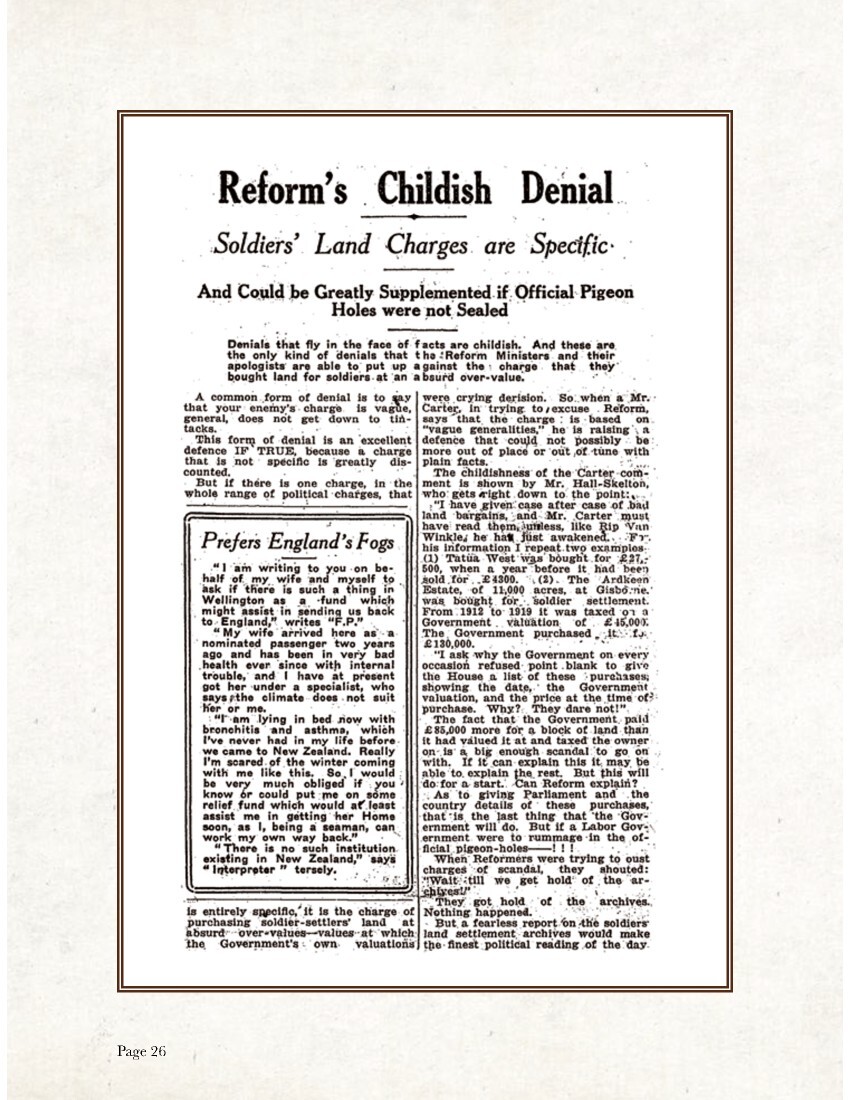
Page 27
LAND FOR SALE OR LEASE TO DISCHARGED SOLDIERS.
General Description of The Land
Situated about 12 miles inland from the port and township of Wairoa, Ardkeen was reached by a good well-metalled road which was also the main road to Waikaremoana.
The homestead site for each allotment was along the main road with stock tracks to the back portions of the allotment.
The country was composed of mainly undulating to hilly ground. Steep in places, good flat land ran beside the main road. It appeared all in good heart and well-grassed.
The quality of the soil is good, resting on papa and clay formation and it is watered by permanent streams replenished by good annual rainfall. Altitude varies from 100 feet to about 1,200 feet above sea level.
Description of Sections
Section 1s. About 87 acres is good flat land, mostly ploughable, in fair pasture and well watered; balance hilly country, light soil, all in English grass.
Section 2s. About 30 acres practically all ploughable, good flat land; balance broken hilly country, good soil, well-grassed.
Section 3s. About 30 acres of flat land, good soil, well-grassed; balance hilly country; light soil along western boundary.
Section 4s. About 27 acres good flat land, balance hilly broken country; good clay soil generally, well-grassed.
Section 5s. About 31 acres of good level land in good English grasses, balance undulating and hilly country well-grassed.
Section 6s. About 46 acres of good ploughable land, well-grassed; balance undulating and hilly country well-grassed.
Section 7s. About 31 acres of good level ground, well-grassed; country broken by gullies, good black loam on clay formation, well-grassed.
Section 8s. About 30 acres of good land, mostly ploughable, all well-grassed; balance hilly country, good black loam on clay formation, well-grassed.
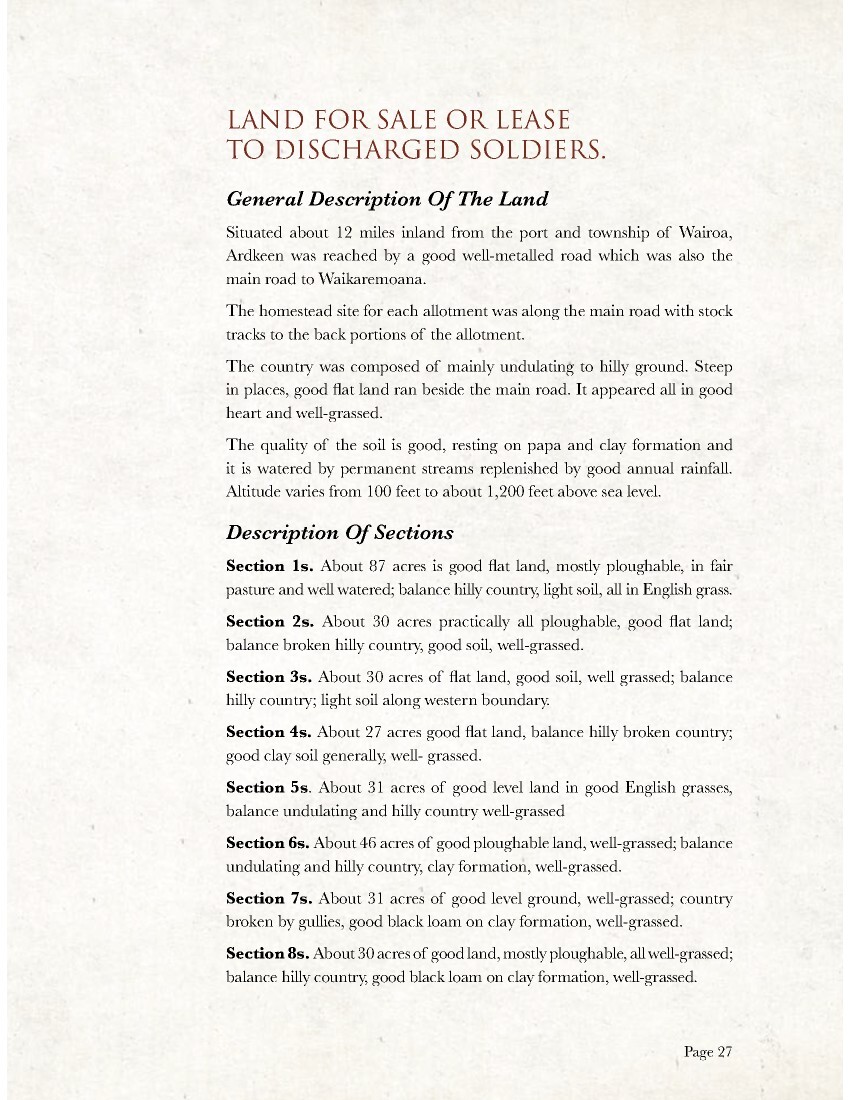
Page 28
Section 9s. About 27 acres of good well-grassed land, all ploughable; balance hilly, good clay soil, warm sunny slopes.
Section 10s. About 15 acres of good flat land and 73 acres of easy hills, good soil, well-grassed; balance mostly broken hilly country, light soil, but good flat ridges in good grass; little Totara in gullies.
Section 11s. About 43 acres of good ploughable land; balance hilly clay formation soil; there are a number of Totara trees on the section.
Section 12s. About 29 acres of good grassland nearly all ploughable; balance mostly hilly country in good grass, black loam on clay pumice formation.
Section 13s. About 32 acres of good level land in good pasture; balance hilly country, fair soil in good English and native of grass.
Section 14s. About 33 acres of good flat, well-grassed; balance hilly and undulating good soil and well-watered.
Section 15s. Area 628 acres. 41 acres, good flat terrace and river flat land; balance hilly undulating, fair soil, well-grassed and watered.
Section 16. About 15 acres flat terraced land, good soil and in good pasture; balance hilly undulating, well-grassed.
Section 17. About 25 acres of good ploughable land; balance mostly hilly undulating country; fair to good soil, well-grassed.
Section 18. About 31 acres of good flat land, mostly ploughable; balance hilly and undulating; fair soil and fairly well-grassed.
Instructions To Applicants
Applications may be made at the District Lands and Survey Office, Napier and at the local Lands and Survey Office, Gisborne.
Applications must be made on proper forms, to be obtained at the District and Land Survey Office, Napier, and the principal post-offices in the locality of lands to be opened.
The lands are described for the general information of intending selectors, who are recommended nevertheless, to make personal inspection as the Department is not responsible for the absolute accuracy of any description.
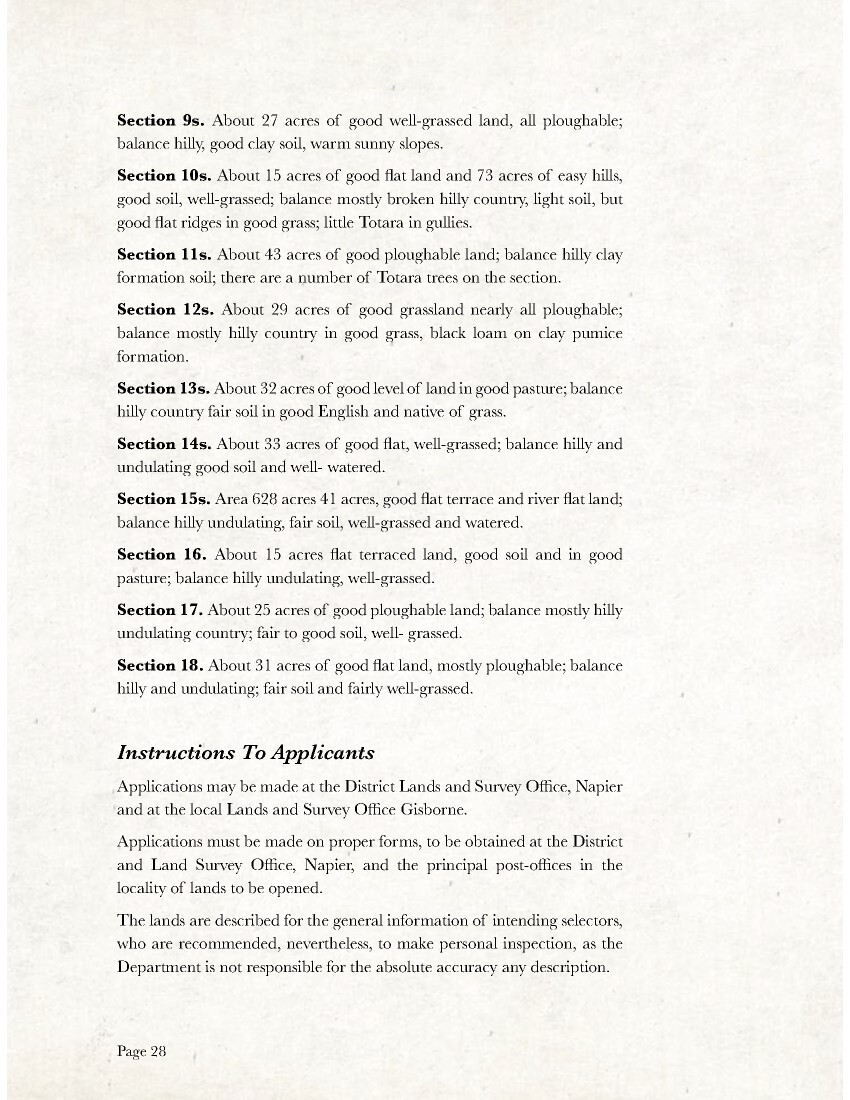
Page 29
In order that the Land Board may be in a position to judge the general ability of applicants to properly work and cultivate the land and fulfil the conditions, each applicant is required to produce for inspection when examined by the Board documentary evidence of his financial position, such as bank pass-books, certificates or letters of credit from managers of banks, financial institutions, or mercantile firms, or from private persons or parents undertaking to give financial assistance. Persons undertaking to assist financially should state to what extent they are prepared to do so, and supply guarantees of their own financial position.
Applicants who might not find it convenient to appear personally at the ballot should appoint an agent to act for them, or they may send with their application a post-office order, or a draft or cheque marked by the bank on which it is drawn as “Correct for twenty-one days”, in favour the Receiver of Land Revenue, for the required deposit, which will be returned in cases of non-success. A separate deposit must be sent by each applicant who does not intend to be present or represented by an agent at the ballot. Bank-notes, gold, or coin should not be forwarded by post. Should the application not be present or represented by an agent to make the necessary payments on being declared successful, another ballot will be drawn immediately for the right to select.
Applicants must also produce their Discharge, for inspection by the Land Board.
Advances up to £500 may be made to selectors on current account, but this may be increased by £250 in special cases.
The majority of estates purchased were settled by less than four soldiers. 17
In no case shall the amount advanced for erecting a dwelling house and other buildings exceed £350, the amount in ordinary cases allowed for this purpose being £250.
17 Gould, A.N. (1992) Proof of Gratitude, p. 114.
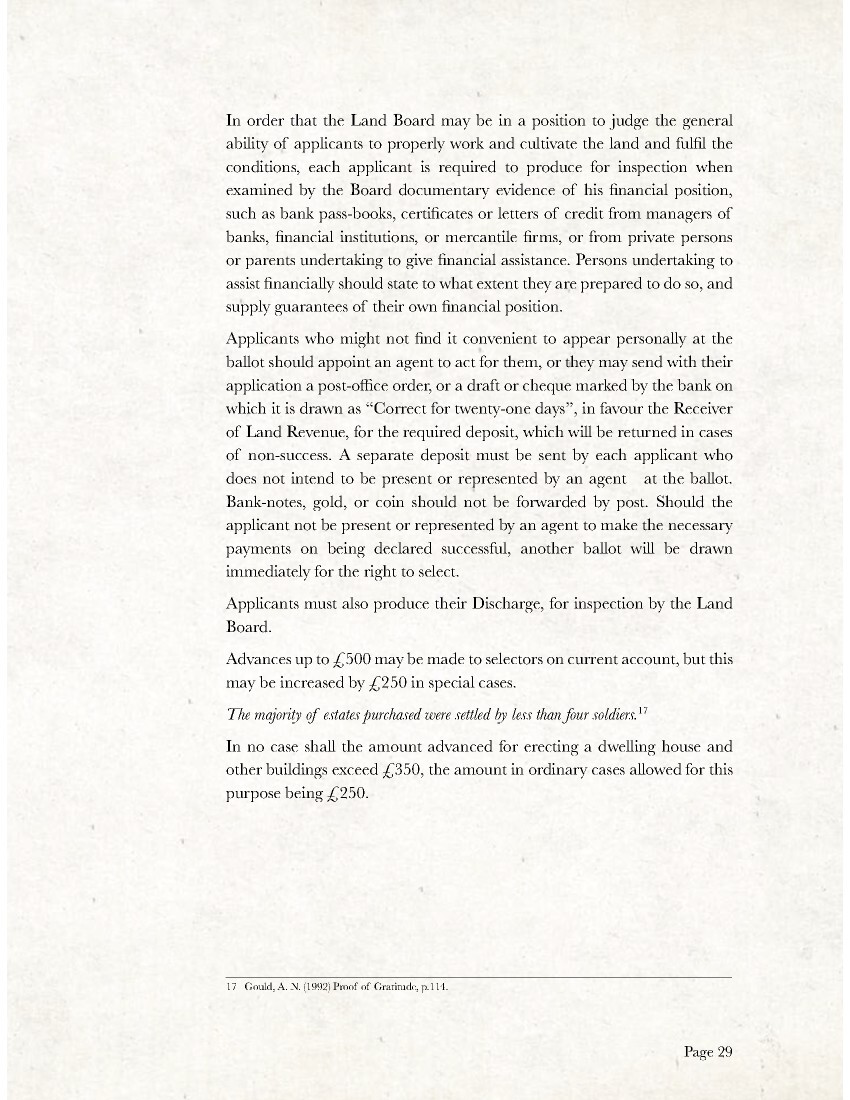
Page 30
CAUTION
The attention of applicants is drawn to sections 101 and 102 of the Land Act, 1908, which provided that any person wilfully making a false declaration or obtaining land not exclusively for their own use or benefit, or anyone aiding and abetting in such a break of the Land Act, shall be liable to a term of imprisonment in addition to the forfeiture of any land obtained by such false declaration.
Settlers and others are notified that the forest growing on river-bank reserved is not to be cut or destroyed in any manner.
Any person convicted of doing so is liable to a penalty of £50.
W.F. MARSH,
COMMISSIONER OF ROYAL LANDS.
District Lands and Survey Office, Napier 26 April 1920.
ABSTRACT OF CONDITIONS LANDS IN FIRST SCHEDULE
CASH SYSTEM
Applicants to furnish statutory declarations, and, on being declared successful, deposit one-fifth of purchase-money; the balance, with Crown-grant fee, is payable within thirty days.
The Crown-grant fee is £1 for the first 100 acres or less, and ¼d for each additional acre. Purchaser may not transfer within 10 years from date of sale, except with consent.
DEFERRED PAYMENTS
On approval of application a deposit equal to 5 percent of the price of the land and £1.1s. License fee be paid, the balance of 95 percent of the price to be paid by equal annual installments extending over nineteen years.
The whole or any portion of the unpaid purchase-money may be paid at any time. Interest at the rate of 5 percent to be paid half-yearly on unpaid purchase-money. Licensee may not transfer within 10 years from date of license except with consent.
Residence is to commence within four years on bush land or swamp land, and within one year on open or partly open land, and to be continuous until the expiration of the license.
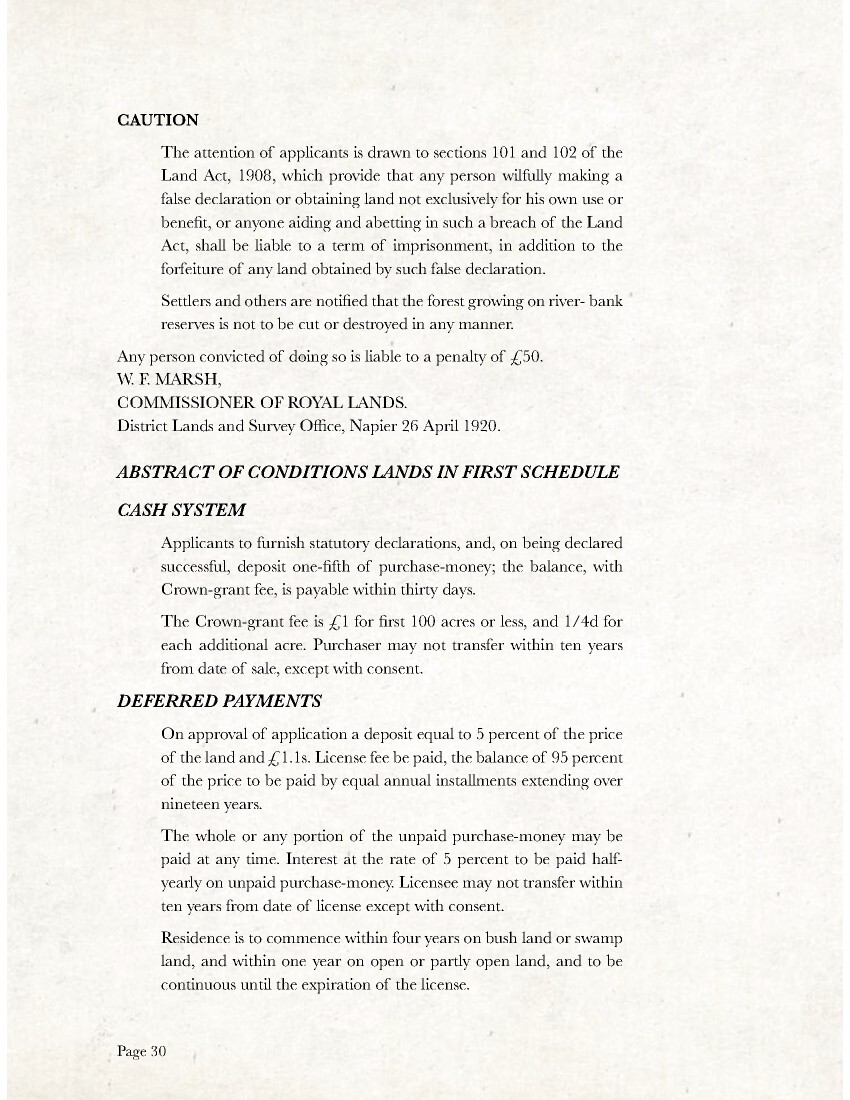
Page 31
LEASE WITH RIGHT TO PURCHASE
Applicants to furnish statutory declaration with applications, and, on being declared successful deposit a half-year’s rent and £1.1s lease fee. Rent for the broken period between the date of the lease and 1 January or 1 July is also payable.
Terms of lease: Thirty-three years, with perpetual right of renewal for further successive terms of thirty-three years. Land comprised in lease may, with consent be purchased for cash or on deferred payment at capital value mentioned in lease.
Rent to be paid 1st January and 1st July in each year. Successful applicant to execute lease within thirty days after being notified that it is ready for signature.
Residence is compulsory, and must be continuous. Improvements. – The value of the improvements affected by the lessee will be determined by the Land Board, and for the purpose of fixing such value the Land Board will take into consideration the purpose for which the lessee intends to use the land.
Lessee to pay all rates, taxes, and assessments.
Lessee may not transfer within ten years from the date of lease except with consent.
Lease is liable to forfeiture if conditions are violated.
ABSTRACT OF CONDITIONS LAND IN SECOND SCHEDULE
RENEWABLE LEASE – EDUCATION RESERVE
Term of lease: Thirty-three years, with perpetual right of renewal for further successive terms of thirty-three years; without right of purchase.
Rent: 4 percent per annum on the capital value, payable on 1st January and 1st July in each year. Applicants to be seventeen years of age and upwards. Applicants to furnish statutory declaration with applications, and, on being declared successful, deposit £2 2s. (lease fee), and a half-year’s rent. Rent for the broken period between the date of lease and 1st January or 1st July following is also payable. Applications made on the same day are deemed to be simultaneous.
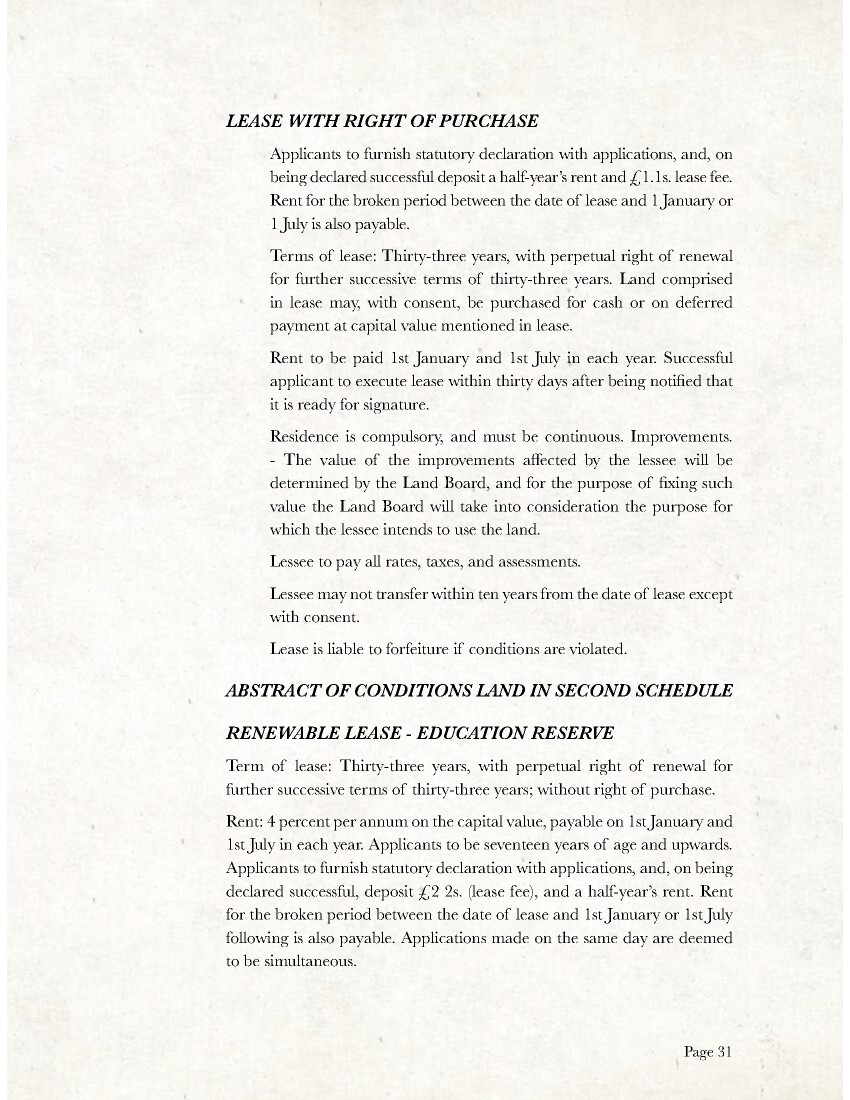
Page 32
Order of selection is decided by ballot.
Successful applicant to execute lease within thirty days after being notified that it is ready for signature.
Residence is to commence within four years on bush land or swamp land, and within one year on open or partly open land, and to be continuous for ten years. Under certain conditions personal residence may be dispensed with.
Improvements. Lessee is required to improve the land within one year to the value of 10 percent of the price; within two years, to the value of another 10 percent of the price; and thereafter, but within six years, to the value of another 10 percent of the price. In addition to the foregoing, and within six years, improvements are also to be affected to the value of £1 for every acre first-class land, 10s for every acre of second-class land, and 2s 6d for every acre of third-class land.
Lessee to pay all rates, taxes and assessments.
Transfer not allowed until completion of two years’ continuous residence except under extraordinary circumstances, and then only with permission.
Roads may be taken through the lands at any time within seven years; twice the original value to be allowed for area taken for such roads.
Lease is liable to forfeiture if conditions are violated.
Sites of Trigonometrical Stations and rights-of-way therefore reserved. Interference with any survey peg or marks a misdemeanour under the Land Act.
MAY 1919
A report for the agriculture minister described Ardkeen: with easy hills having clay on papa, with pumice here and there; being exceptionally farmed with good swag of grass.
W.F. Marsh the commissioner for the Hawke’s Bay Land District from March 1916 until 1923, was a pragmatic realist who, unlike some politicians and community groups, harboured no idealistic expectations as to the ability of soldiers to make successful settlers.
Marsh was consistent in his demand that soldier applications for Hawke’s Bay sheep country have substantial backing. His proposals for the Ardkeen Settlement near Wairoa indicate both the character of the man and, political pressure for closer settlement.

Page 33
The land was purchased in 1919 £11.10 per acre.
In October 1918 Marsh observed: some of the settlers will fail. Despite the argument of would-be critics that because men representing all walks and grades in life may, after a few months training at ‘Trentham’ and ‘Sling Camp’, be turned into the finest fighting force in the world. The evolution of these men into tillers of the soil is a natural corollary. The bayonet and the ploughshare is a sweet little belief, but experience is showing that only a small percentage of returned men, who were not engaged in farm or sheep work before their enlistment are anxious to go onto the land. These remarks owe their expression to the constant reiteration of the outside statement, that soldiers may be readily fashioned into farmers. 18
Approximately 69% of Hawke’s Bay settlers, but only 34% of Wellington settlers had more than £100 of capital. The land boards had the right to decline applications from soldiers for land not commensurate with their capital resources. 19
Dr Gould’s Thesis Note 34: (George) The Depression of 1921-22, claims that then owner of Ardkeen had recommended the subdivision of the property into sections of 900 to 1,100 acres. The District Revaluation Board claimed, in 1924 that this was an excellent property spoiled by overstocking with men. 20
Marsh’s second subdivision plan called for 19 holdings of smaller area, but more politically acceptable. The Minister accepted the second proposal, although Marsh remained adamant that any applicants must have £1,000 or more in personal capital as a large portion of the government in advance of £750 will go in buildings and necessary subdivision fences. To stock the farm moderately will cost upwards of £1,200 a farm. Of the 121 applicants for the 19 sections, 49 soldiers, all presumably with the required capital, were admitted to the ballot.
Marsh suggested, ‘could we be stiff-necked enough to earmark the settlement for the class of men with capital who are being forced into the open freehold market? Why not make this an officers block minimum capital £2000.
The surveyor general responded ‘if the block was offered to officers it would not be feasible for obvious reasons that many full privates are both financially and socially in better positions than mini officers’.
To be considered for an allotment of Crown land, soldiers had to present themselves at monthly meetings of boards even at a ballot of a block, which did not interest them.
18 Gould, A.N. (1992) Proof of Gratitude, p. 167.
19 Ibid, p. 166.
20 Ibid, (note attributed to: ‘1921 Depression’ J.D. George) p. 170.
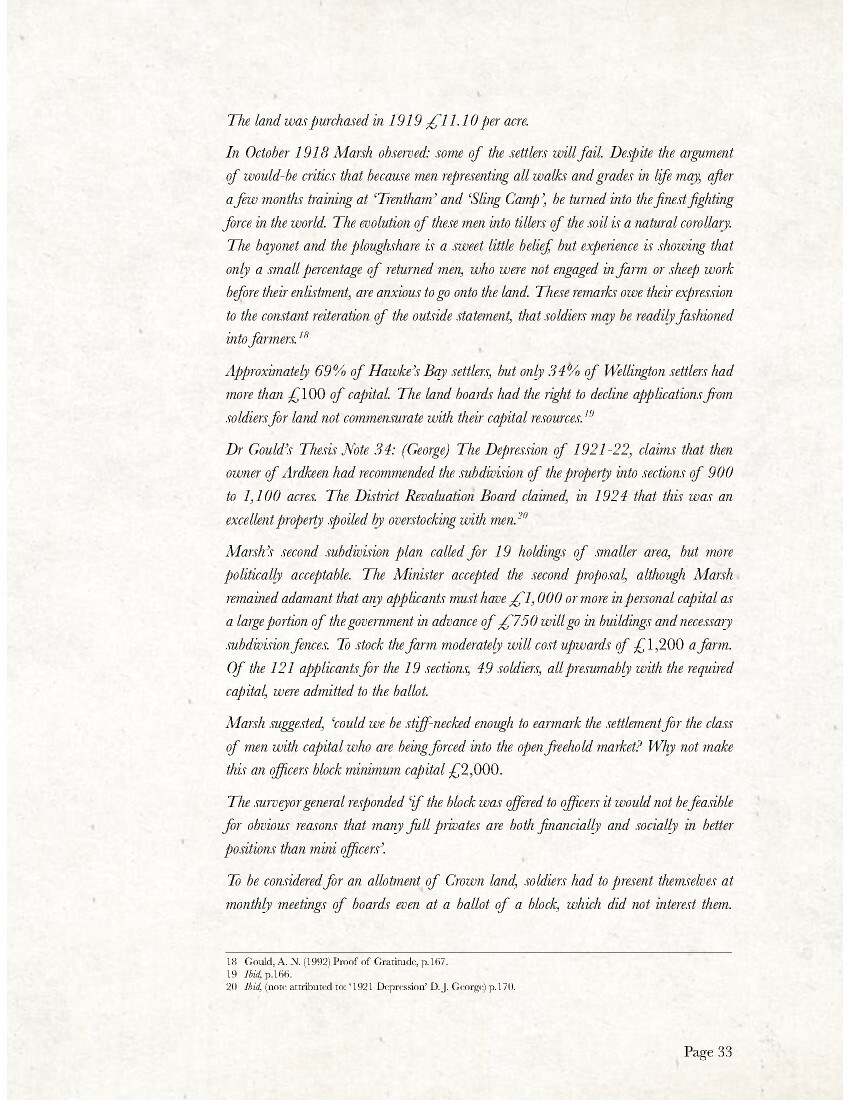
Page 34
Applicants were examined as to previous experience and general capacity, state of health, and the amount of capital they could command.
The board also required evidence that soldiers were of good character; a condition that could be met by soldiers’ army discharge papers.
Marsh treated the successful applicants leniently; he had a policy of automatically postponing the second half year’s rent for 2 to 3 years at 4% interest to assist settlers by stretching out their capital. 21
JUNE 1919
The purchase of the Ardkeen Estate: 10,600 acres at £11.10 per acre plus 620 acres of the Education Reserve at £4 an acre for the improvements plus £20,000 in cash and war bonds.
FEBRUARY 1920
Commissioner Marsh at Napier wrote to the Secretary of Lands that nearly all blocks were ring fenced, providing measure of both summer and winter country. The Homestead sections were large enough to grow turnips and cash crops for fattening.
Tracks for access and the movement of livestock required surveying and fencing. Noting they would not be formed into roads.
The Under-Secretary advised that all the Ardkeen sheep, except the full mouth sheep should be bought for the settlers. The advertisement stated there were 14,150 sheep on the Station, however the previous year 12,309 sheep were shorn.
Ardkeen wintered over 2,000 cattle plus sheep. These numbers equated to 100 sheep on each homestead section and 600 for the main block for each settler. £1,200 would be available for each settler, £750 for buildings and fencing the balance for the livestock.
21 Gould, A.N. (1992) Proof of Gratitude, p. 170.

Page 35
6 MARCH 1920
A.L. Gardiner who had been a shepherd on the Station for the previous 10 years was employed at £6 per week to look after the property and to guide those who wished to inspect the subdivisions.
The Ardkeen settlement balance sheet stood at £13813. From 1912 to 1919 the government valuation of Ardkeen was £45,000. The government paid £85,000 above the valuation for the Station. £2,500 had been set aside for roading, this money was not expected to be needed.
The Station had many Totara trees, both standing and fallen that were suitable for splitting into fence posts. The question of protecting the posts from fire and theft arose, the Land Board having previously experienced loss with tenants refusing to buy knowing they could not be sold to anyone else.
10 JUNE 1920
The Ballot for Ardkeen, Ohuka and Omana had been set down for the 10 June 1920 after the Land Board had examined the applicants. However, the car the Land Board members were travelling in from Gisborne broke down. The ballot was delayed until the following day, 11 June 1920 at ‘Everybody’s Theatre’.
PARCELS AREA APPLICANTS
Section 1 811 acres 12 applicants
Section 2 589 acres 19 applicants
Section 3 632 acres 18 applicants
Section 4 751 acres 24 applicants
Section 5 617 acres 22 applicants
Section 6 525 acres 10 applications
Section 7 581 acres 10 applications
Section 8 581 acres 19 applications
Section 9 629 acres 27 applications
Section 10 765 acres 13 applicants
Section 11 684 acres 24 applicants
Section 12 542 acres 27 applicants
Section 13 535 acres 23 applicants
Section 14 548 acres 14 applicants
Section 15 628 acres 17 applicants
Section 16 466 acres 9 applicants
Section 17 558 acres 27 applicants
Section 18 647 acres 17 applicants

Page 36
Poverty Bay Herald.
A ballot for Omana, Ardkeen and Ohuka solders’ settlements took place this morning in Everybody’s Theatre. There was a large attendance of soldiers present to witness the ballot, the marbles being drawn by Mr March, Crown Lands Commissioner. Mr Farquhar McRae acted as scrutineer on behalf of the soldiers.
The results were as follows:
Section 1s – Percy Jonas Matson
Section 2s – Raymond James Meagher
Section 3s – Dave Robertson
Section 5s – Paddy O’Kane
Section 6s – Cranworth Jackson
Section 7s – Jim McLean
Section 8s – Maurice Patrick Malone
Section 9s – Jim Tolme
Section 10s – William John McKay
Section 11s – Jack Owen
Section 12s – Bob Preston
Section 13s – William Carson
Section 14s – McKeegan* W.H. Nicol
Section 15s – Gerard Edmund Spooner
Section 16s – Earnest Clifton
Section 17s – Matthew Andrew
Section 18s – Ossie Birrell
[3 advertisements for Reardon Wright Ltd, The Tourist Motor Co. Ltd and Seigel’s Syrup]
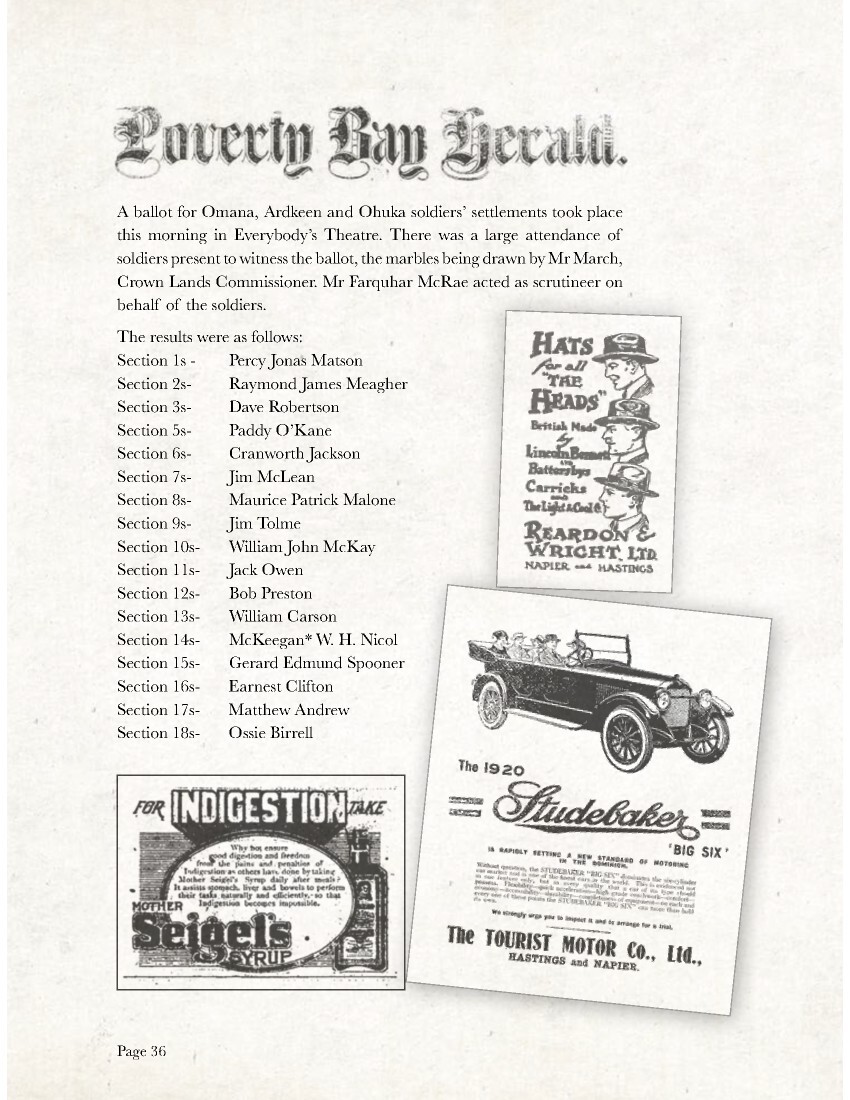
Page 38
PERCY JONAS MATSON
MILITARY SUMMARY
Date of Birth: 1st September 1892
Place of Birth: New Plymouth
Parents: Peter John and Clara Jane Matson
Next of Kin: Mr Peter Matson, father, Te Rehunga, Dannevirke
Last NZ Address: Alexandra Barracks, Wellington
Marital Status: Single
Occupation: Soldier
Employer: Defence Department Regimental No: 43533
Rank: Gunner
Death: 24 October 1973 Buried: Wairoa Cemetery
Awards: British War Medal, Victory Medal
1913
10 Nov: Te Rehunga, Dannevirke – letter To the Officer Commanding, at RNZA Depot, Wellington
“Dear Sir
Have you any vacancies for recruits in the RNZA as I wish to enlist in same. I would like to join the gunnery section if possible. My age is 21 years, my height 6ft, 1 inch and my weight 12½ stone and I have been in the Territorials for two years in A Company 2nd Battalion 9th Regiment. Hoping there is a vacancy.
I remain etc Percy Matson”
18 Dec: Applied for service with the Royal NZ Artillery.
1914
25 Mar: Enlisted with Royal NZ Artillery as Private 1384 P J Matson, Ex 17th Ruahine Regiment No. 13/877

Page 39
1915
08 Jan: 3 days confined to barracks
05 Jun: 3 days confined to barracks
4 Dec: Wellington – absent from parade 1.30pm – admonished
1916
22 Dec: Medical examination for service with NZ Expeditionary Force
1917
05 Feb: Seconded for duty with NZ Expeditionary Force
05 Feb: Posted to NZ Field Artillery 25th Reinforcements as a gunner
15 Feb: Promoted to Bombardier, One month later promoted to Corporal
26 Apr: Embarked from Wellington on board HMNZT84 Turakina as ship’s gunner
13 Aug: Turakina torpedoed and sunk by submarine en route London to New York in ballast, after she had safely landed her NZ Reinforcements in Britain.
01 Nov: Returned to NZ on board Mokoia ex Devonport as ships gunner
1918
06 Jan: Mokoia arrived NZ
13 Feb: Embarked on board RMS Niagara as ships gunner. Returned NZ 14 April 16 Apr: Embarked on board SS Hurunui from NZ. Returned NZ 30 May.
15 Jun: Chronic appendicitis
23 Jul: Transferred to 51st Field Artillery
05 Dec: Discharged from NZ Permanent Force by purchase
1919
03 Jan: Discharged on termination of period of engagement.
Total Service: 4 years 255 days
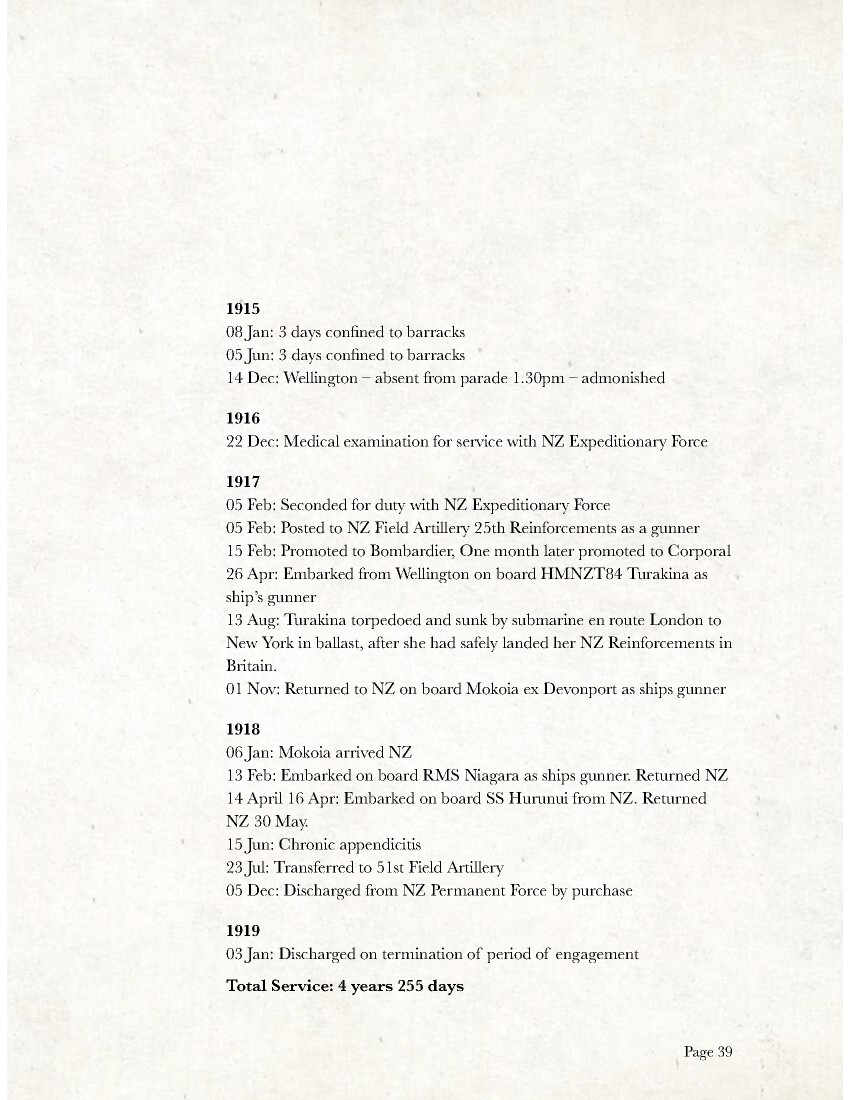
Page 40
LAND BALLOT
Ardkeen Section 1s, 811 acres
Land Ballot awarded to: P. J. Matson,
Te Rehunga [sic].
Section 1 was 724 acres of paddock with medium to easy hill country facing the south-east at the farthest north-west corner of Ardkeen Station. The only access being a three-hour horse ride from the homestead section, adjacent to the Waikaremoana Road.
Matson’s 87 acre homestead section was one of the biggest in the ballot, however the access was up a steep bridle track above the main Waikaremoana Road opposite the Matai swing bridge, or alternatively it was necessary to cross through three neighbours’ homestead sections in order to reach his own.
During his first year Percy asked the Commissioner of Crown Lands for an advance to build a small whare on the back farm. Up until this time he had lived in an army tent.
August 1922
Percy wrote to the Commissioner of Crown Lands, expressing his sense of injustice at having interest deducted from advances that were to pay for capital improvements describing these as; “hampering a soldier settler’s progress”.
By November 1922 Percy had built a small cottage and erected 60 chains of subdivision fence, a set of sheep yards on the homestead section.
Field Ranger Robertson visited the property that month and reported seeing 611 acres in good pasture, however 200 acres were in a worn-out state. He noted the property had not paid its way, because the capital value of the land was too high. This was compounded by the property’s difficult access and the high cost of livestock at the time of settling.
March 1924
Percy wrote to the Land Board asking to take over Section 6s, – Cranworth Jackson’s farm.
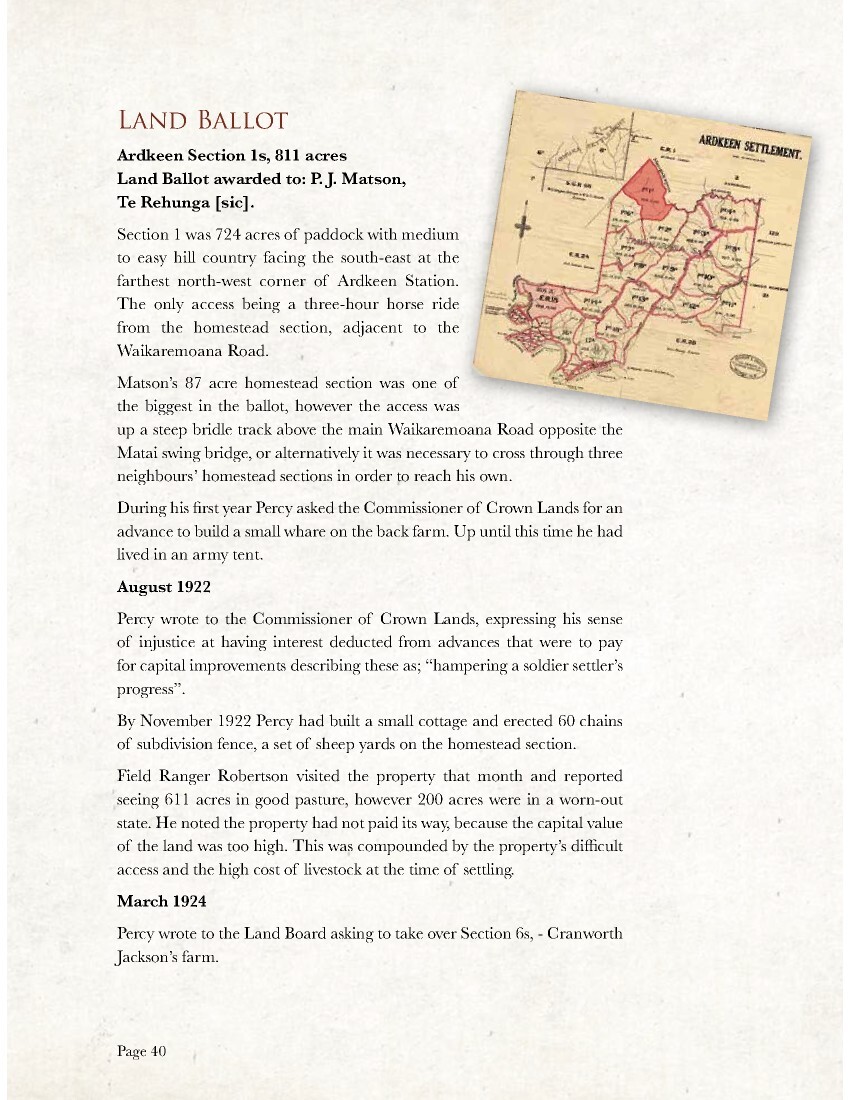
Page 41
April 1924
The Commissioner of Crown Lands wrote to Percy that he ‘had not the slightest intention of allowing anyone to remain a tenant of Crown Land without paying rent, or at least a portion of it. Percy replied agreeing to the demand but, in return wanted payments spread across several years. By return Percy was advised he must pay one half year’s rent, and was offered just 30 days to appeal or forfeit his lease.
In July the same year the Wairoa County Council sought an ‘Instant Judgement’, for the non-payment of County Rates.
Soldiers were demanding more from the system than the Government was prepared, or indeed able to offer. The dependent position of the soldiers, primarily caused by their lack of capital and previous experience, fostered an attitude contrary to the yeoman ideal and notions of economic individualism that were underpinning the attitude of the Department of Lands and many of its officers. 22
October 1924
A Land Board Minute noted the board had considered and refused the transfer of Jackson’s farm to Matson; suggesting he only needed an additional 150 acres. The Board suggested it would be preferable to allow Jackson to retain his holding and give him part of McLean’s section; the board believed Jim McLean would surrender his lease.
19 November 1924
An office memo records Matson’s wool from 1,065 sheep, noting he had produced more than the average number of lambs on Ardkeen. This was good going given the constraints of the light pumice country. The board allowed him extra wages to clear the land to make up for the distance from his homestead section. The property was described as; “some great country but with an area of very light pumice land, though the manuka required attention.” The tenant was regarded as: “A hard worker and the stock looked well, noting the wool yield spoke for the stock.” Note: Percy Matson had recently married.
22 Gould, A. N. (1992) Proof of Gratitude, p. 208.
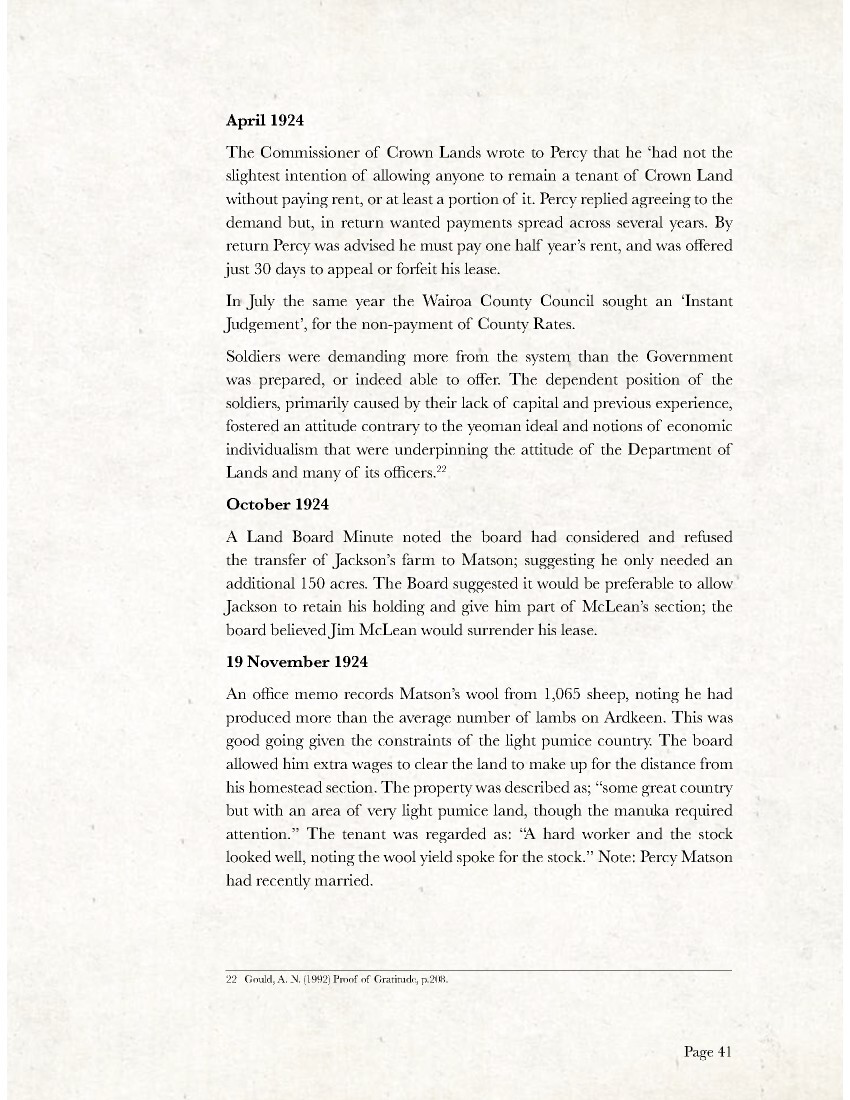
Page 42
January 1925
The Board was once again becoming anxious about the rent arrears, and non-payment of rates, suggesting ‘the sooner this man is brought to his senses the better’.
Ranger Robertson wrote that Matson, ‘was one of the laziest settlers on Ardkeen. He had a good farm but, saw himself as a gentleman farmer, who spends most of his time at the homestead, leaving a boy to look after the farm stocked with 1,000 sheep & 100 cattle.
He had paid no rent since 1920.
Percy Matson frequently experienced the threat of forfeiture which had been recommended previously for non-payment of rent and, once for the non-payment of rates.
January 1925
The Matson file was stamped ‘FORFEITED’. Matson was also notified forfeiture would not relieve him of the obligation to pay outstanding rent and interest owing to the Department. The Land Board advised they would allow the seizure to stand over if he paid the rates.
March 1925
Matson told the Land Board that he did not want to be faced with, ‘absurd and unjust, conditions imposed by the board’. Pointing out that as long as his financial position with the stock firm was sound, they would continue to make payments as they fell due; provided there was sufficient security remaining in the livestock.
The Under-Secretary noted that usually a company doing business with a settler, whose property was subject to encumbrances, indicated those interests and liabilities and discouraged extravagance that may prejudice all concerned. He admitted the position was a delicate one. However, stock companies would, where possible, arrange business matters, so other interested parties are not prejudiced. 23
June 1925
There is evidence that Percy Matson continued to battle on and completed a further 70 chains of new fencing
23 Gould, A.N. (1992) Proof of Gratitude, p. 255.
Photo caption – Percy Matson with his successful catch
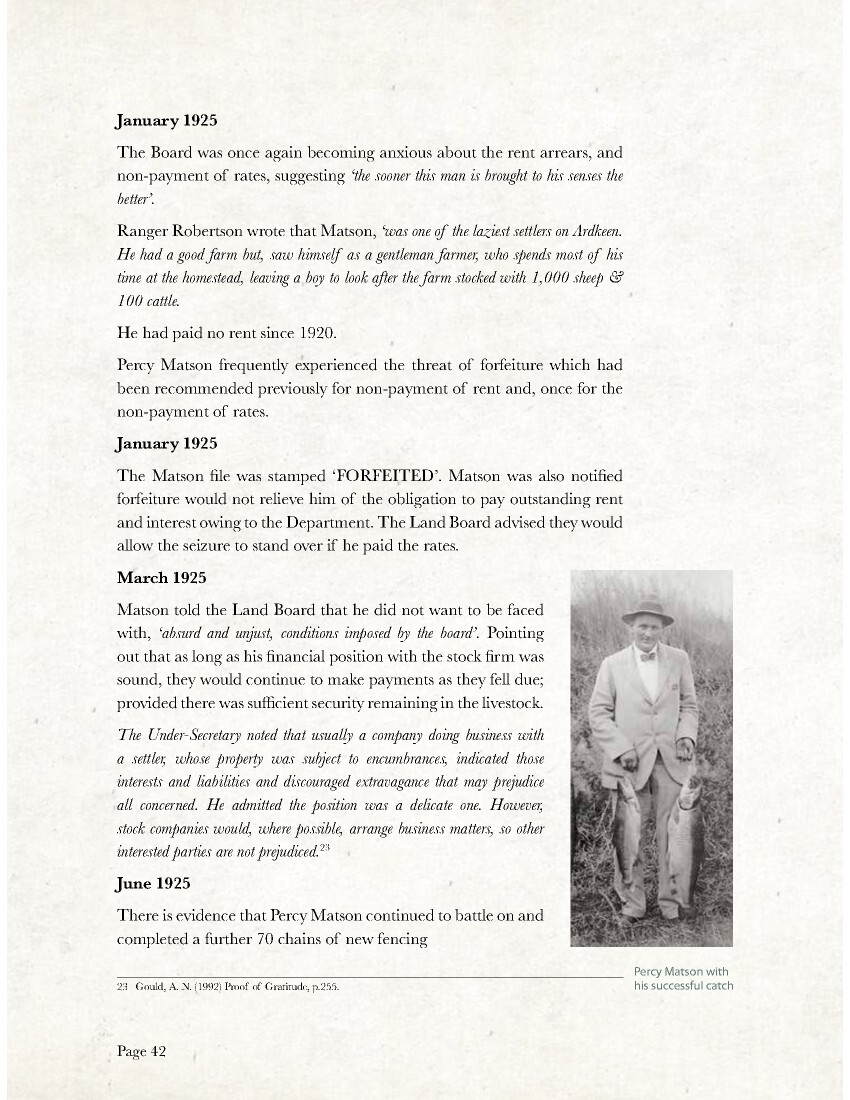
Page 44
RECENT HISTORY
Tom Dever bought the farm from the Jackson Estate circa 1964. Tom sold to Barry Simmons, owner of Makapua about 1969.
Colin and Marg Baynes bought the farm in February 1993 both Lot 1 along with part of Lot 6.
The Land Board amalgamated the Matson homestead section with Jack Owen’s homestead section to create a dairy farm that was settled on Sam Christie in 1931.
Sam Christie sold to Hugh Lyall in 1942, who passed the farm to son Bert; the Lyalls left Ardkeen in 1981.
The original Matson homestead section was bought by Peter Clifton. The Wallace family now own this section.
The section that had been Jack Owen’s homestead was bought by William Little in 1981. William sold to the Taylor family the current owners in 2004.

Page 46
FRANK PATRICK MEAGHER
MILITARY SUMMARY
Date of Birth: 29 October 1894
Place of Birth: Koputaroa, Hawke’s Bay
Parents: James Francis and Catherine Meagher née Foley
Next of Kin: J F Meagher, Te Rehunga, Dannevirke
Last NZ Address: Akitio
Marital Status: Single
Occupation: Jockey
Employer: F Armstrong
Regimental No: 24/1114 Rank: Rifleman
Death: 5 February 1922 Ardkeen
Buried: Mangatera Cemetery, Dannevirke
Awards: 1914-15 Star, British War Medal, Victory Medal
1915
28 Aug: Enlisted and posted to 2nd NZ Rifle Brigade D Company
09 Oct: Embarked from NZ
18 Nov: Disembarked Suez
21 Nov: Joined Western Frontier Force with 3rd NZ Rifle Brigade
1916
17 Jan: Proceeded to Ismailia
06 Apr: Embarked for France from Alexandria
13 May: NZ Rifle Brigade entered the line east of Armentierés
06 Jul: Admitted 30th General Hospital – inflammation connecting tissue, thigh
13 Jul: Transferred to England and admitted on 14 July to 2nd London General Hospital, Chelsea

Page 47
26 Jul: Admitted 1st NZ Convalescent Hospital, Brokenhurst [Brockenhurst]
09 Sep: Reported at Codford Camp, Wiltshire from hospital and taken on strength
21 Oct: Admitted NZ Convalescent Hospital, Hornchurch
09 Nov: Discharged NZ Convalescent Hospital
14 Nov: Taken on strength at Codford from Hornchurch
1917
29 Mar: Court of Enquiry – Codford – while on active service absent without leave when under orders to report to NZ Command Depot at 11.45pm 24 January 1917 and remaining absent until reporting at Codford at 4.30pm 3 March 1917.
Finding guilty – sentenced to detention for 60 days [later remitted to 30 days]. Forfeit 70 days’ pay and 30 days’ net pay.
07 Oct: Admitted Rugeley Military Hospital, Cannock Chase, Brocton, Staffordshire – diphtheria
26 Oct: Discharged to Brocton Prisoner of War Camp – taken on strength posted to 5th Battalion NZ Rifle Brigade
15 Nov: Transferred from unit at Brocton to detachment attached to Headquarters
1918
27 May: Classified unfit by Medical Board and placed on NZ Roll – old fracture of the right clavicle
02 Dec: Embarked on board S.S. Maunganui for NZ from Liverpool
1919
09 Jan: Disembarked Auckland
08 Feb: Discharged no longer physically fit for war service (dislocated clavicle)
Total Service: 3 years 257 days (including 3 years 93 days overseas)
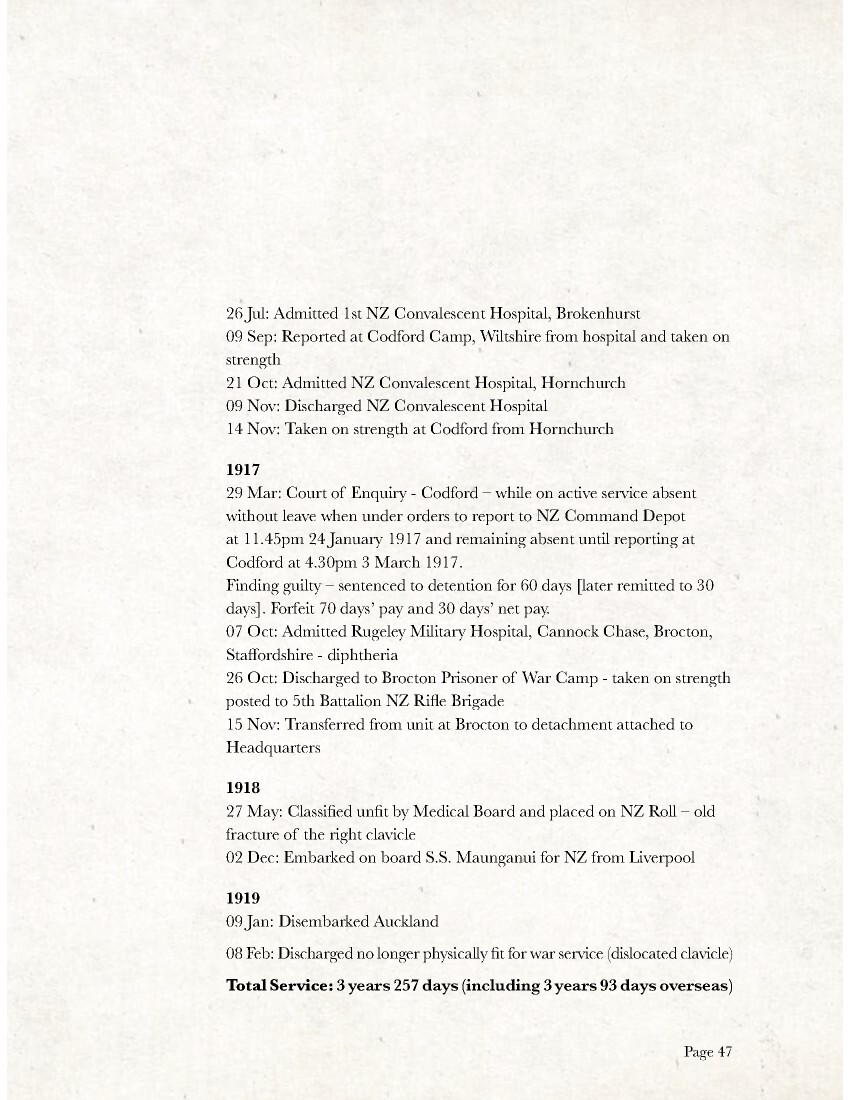
Page 48
LAND BALLOT
Ardkeen Section 2s, 559 acres
Ballot awarded to: Raymond James / Frank Patrick Meagher
Brothers Frank and Jim Meagher drew Sections 2s and 3s of the Ardkeen Settlement. Frank’s section was 559 acres and Jim’s 602 acres. The only access to their farms was a seven-mile ride through five other farms on the settlement from their homestead sections situated along the Waikaremoana Road.
Within six months of settling, Frank, who was unmarried, sought a £45 advance to build a whare on his farm. Mr Mullany, a builder, charged £20 to complete the building which was regarded as expensive until it was pointed out that access to the site was a seven-mile horse ride.
4 February 1922
Frank Meagher and Bill Nicol had been making a social call to the Hall family who farmed “Matai”, across the Waiau River. Access was either by a cage suspended from a wire cable or horse, which could be difficult if the river level was elevated.
Tragedy struck the Meagher family.
At 2pm on this day, Sergeant Wade of Wairoa Police received advice that Francis Patrick Meagher, had drowned at Ardkeen. It appeared that Frank and his companion Bill Nicol, both returned soldiers and farming at Ardkeen, were crossing the river in a cage en-route to visit Mr T. Hall, when the post supporting the rope gave away, plunging both men into the flooded river. After a great struggle Bill Nicol, who could only swim a little, managed to reach the bank in an exhausted state. Sadly Frank Meagher failed to appear. A short time later Mr Arthur Martin, who was crossing the river on horseback, noticed a body lying face down in still water near a small island in the middle of the river.
He and another settler lifted the body onto the horse, bringing it ashore where artificial resuscitation was attempted for over 2 hours. Dr Somerville
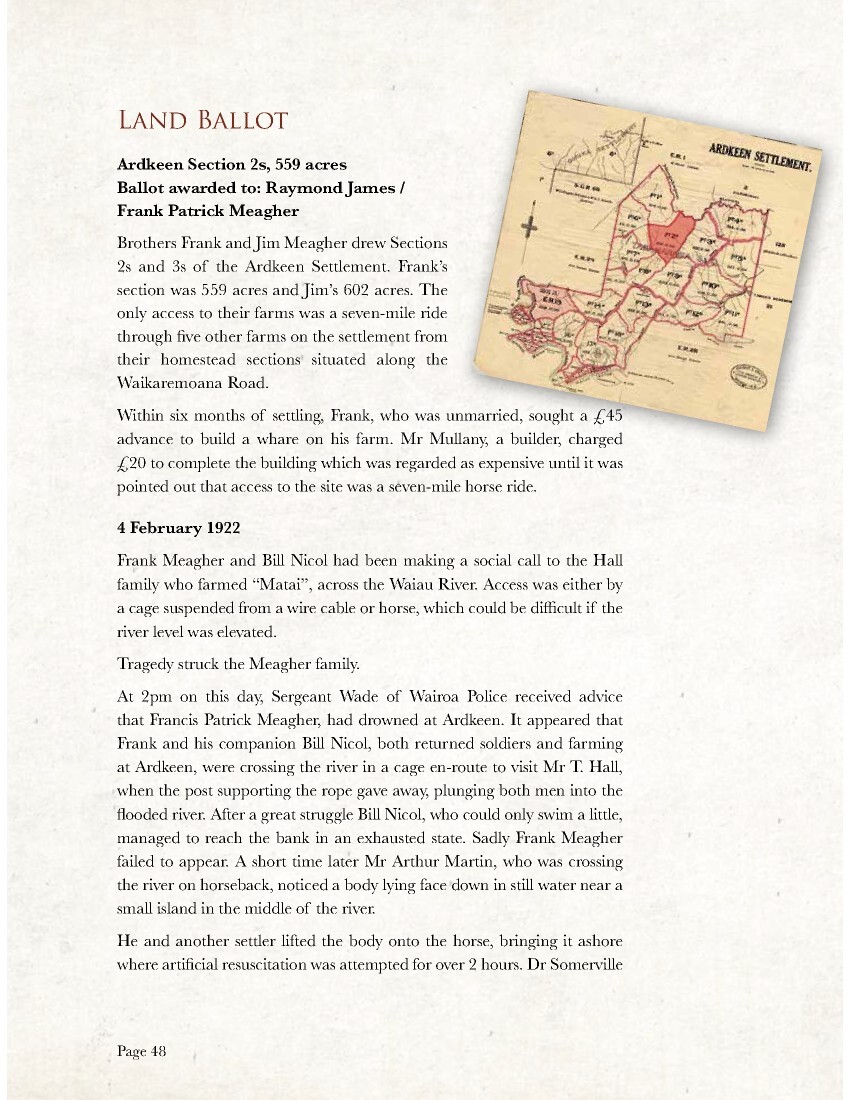
Page 49
on arrival, pronounced life to be extinct. From a casual examination, he thought the unfortunate man’s neck had broken in the fall.
Evidence indicated the cage had appeared fine and was used by school children every day. The Wairoa County Council was urged to pass a bylaw providing that an engineer inspect all privately erected cages used by the public.
Six ex-soldiers carried the body, covered with the Union Jack to St Peter’s Church for a short service, performed by Father Lacroix before being sent to Dannevirke for internment.
Photo caption – Matai footbridge
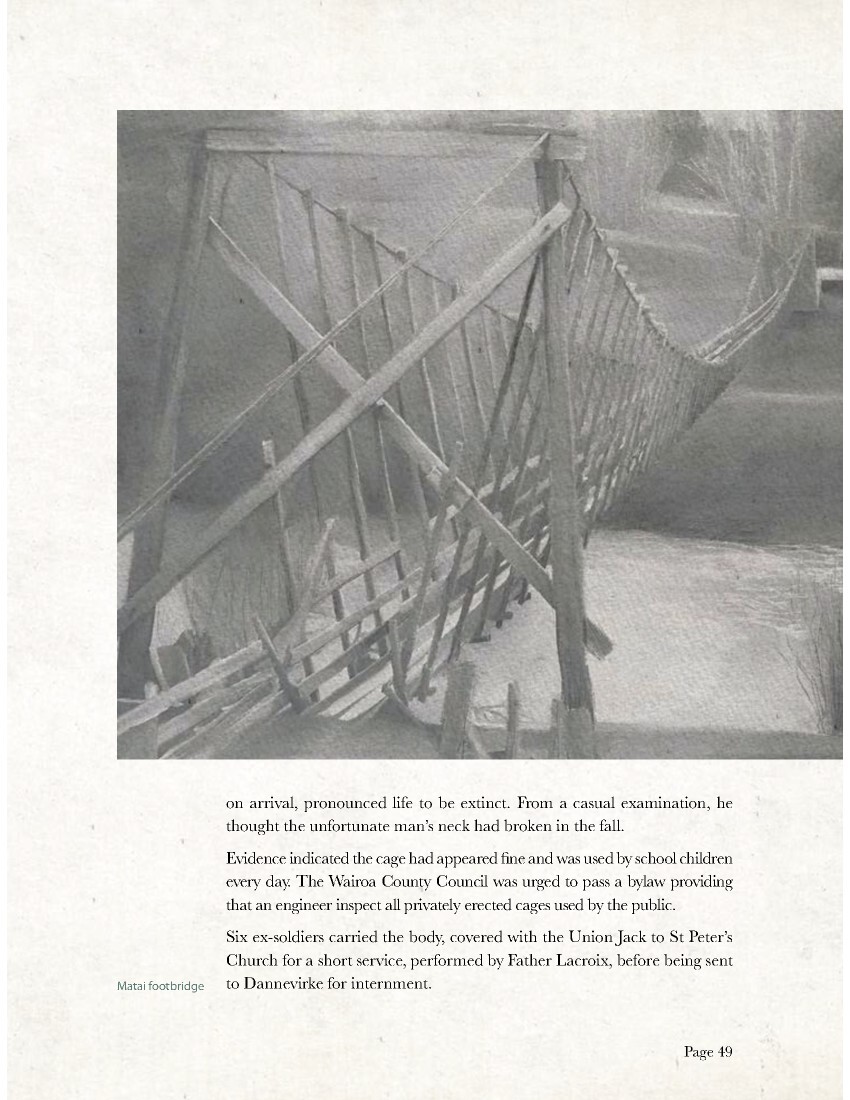
Page 50
Frank died intestate at the age of 28; his father, Mr J. F. Meagher, a farmer near Rununga [Runanga], Dannevirke, was his next of kin. Mr Meagher senior wrote to the Commissioner asking if he and his two other sons could continue farming the section.
Quote:
“Me and Mrs Meagher is milking a good number of cows, they have helped to buy the soldier over the bad times as you are aware, and we are heavily involved in Ardkeen just now. Yours obedient J.F. Meagher”
Meagher senior advised the Commissioner in May 1924 that while mustering for docking, he had fallen from his horse and broken a kneecap. He told the Commissioner he had placed a man on the property in his absence and, his other son Jim, the owner of section 3s, was looking after both farms.
The Field Ranger noted after a recent visit, the sections were being worked together and observed the farm was one of the better ones and had the best ewes on Ardkeen Settlement.
August 1924
The Commissioner of Crown Lands was pressing Mr J. F. Meagher senior, who was then 70 years of age in failing health, to take up residence on his son’s property and work the farm himself. The Commissioner subsequently learned that although Mr Meagher senior had put a good deal of money into the land and even mortgaged his Rununga farm for the purpose, he had recently been in hospital and was too infirm to take up the responsibility.
November 1925
Mr Meagher senior wrote to the Commissioner saying he had built a new set of sheep yards and asked for an advance to erect subdivision fencing and build a sheep-dip; saying it would save the cost of driving sheep down to the Ardkeen woolshed, a distance of seven miles and the steep return without water for sheep or dogs, through six other farms in the heat of summer.
Mr Meagher estimated the cost of materials for the dip would be £35 – £40.
A Lands & Survey office note disputed this request and asked; ‘Why another dip was needed when there was one at the Ardkeen Woolshed for the use of all the settlers?’
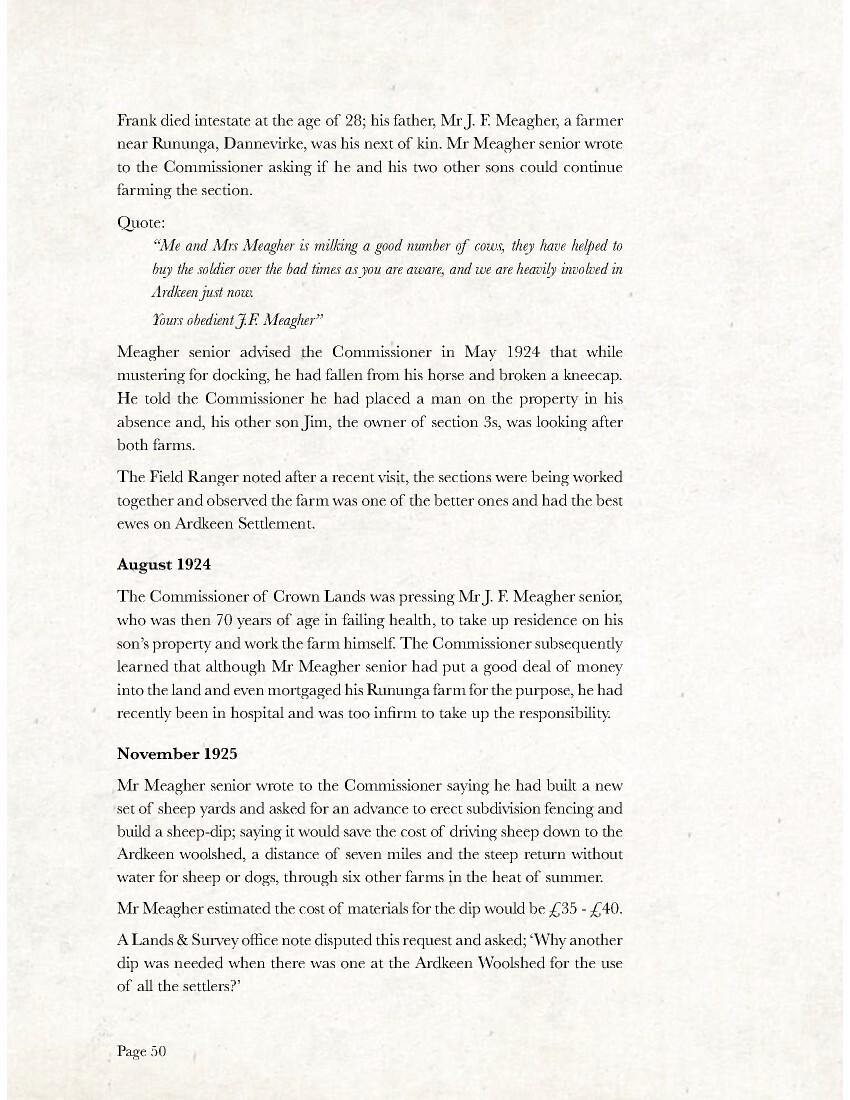
Page 51
Field Ranger Mr Robertson supported Mr Meagher’s request, emphasising that two dips at the back of the Ardkeen Settlement would save a great deal of time and expense for those settlers who had to work so far from the woolshed, on the Waikaremoana Road. The argument continued;
‘I must say that I cannot see the building of a sheep-dip is either necessary or desirable. The Meaghers are by no means the worst off of the Ardkeen Settlers in point of distance, and if we advance money to them to erect a dip we may expect to receive similar applications from Matson, Jackson, Robertson and O’Kane and perhaps others’.
Signed Chief Clerk
The Commissioner eventually agreed with Field Ranger Mr Robertson recommending an advance of £40 be made available in December 1927
Site of the sheep dip, February 2020

Page 52
RAYMOND JAMES MEAGHER (JIM)
MILITARY SUMMARY
Date of Birth: 17 April 1891
Place of Birth: Timaru
Parents: James Francis and Catherine Meagher née Foley
Next of Kin: Mrs Meagher, mother, Te Rehunga, Dannevirke
Last NZ Address: Te Rehunga, Dannevirke
Marital Status: Single – Married 1925 Isabel Margaret Logan
Occupation: Self-employed farmer
Embarkation Unit: 36th Reinforcements
Regimental No: 69418
Rank: Trooper
Death: 11 January 1987 Auckland
Buried: Waiuku Cemetery, Waiuku
Awards: British War Medal. Victoria Medal
Other Service: 17th Regiment Territorials A Company, WWII 2/20b/71
1916
Rejected after enlisting at Dannevirke – underage
1917
10 Sept: Attestation signed at Woodville
17 Oct: Enlisted and posted to 34th Reinforcements C Company
31 Oct: Transferred to NZ Mounted Rifles 36th Reinforcements
1918
21 Feb: Embarked from Wellington on board Moeraki. Transhipped at Sydney to RMS Ormonde
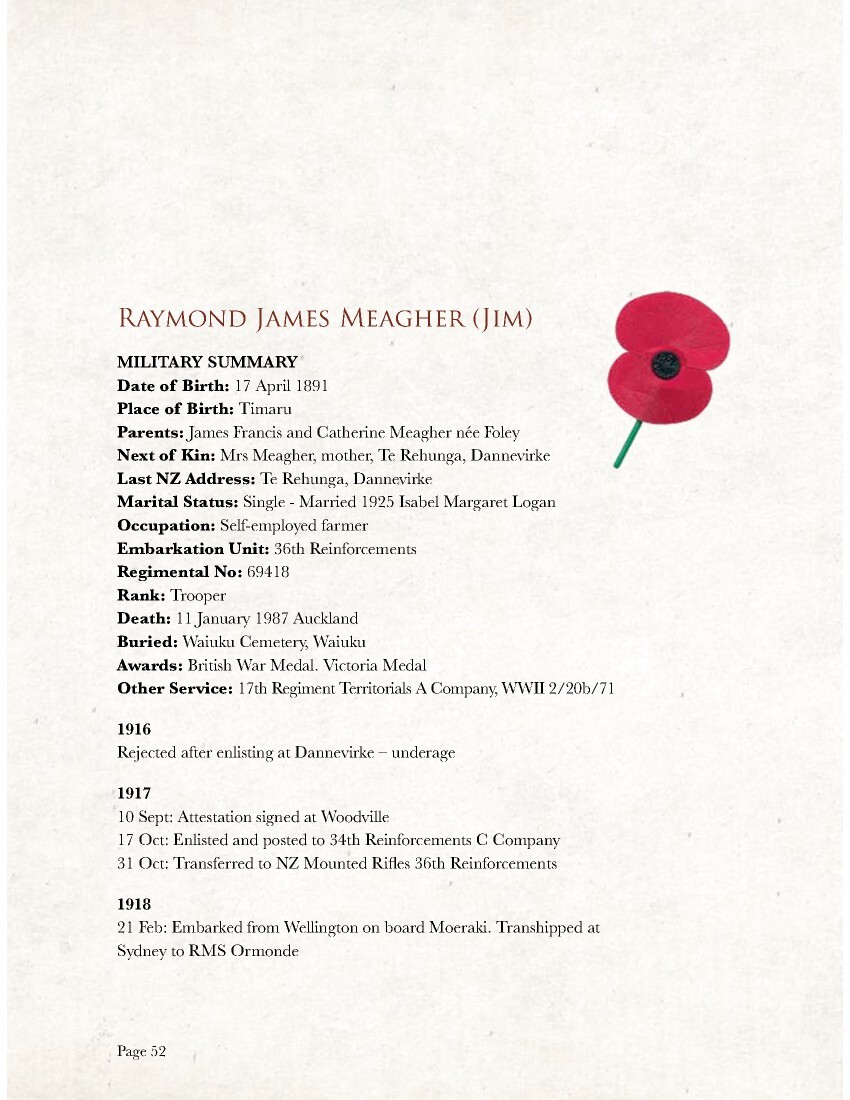
Page 53
04 Apr: Disembarked at Suez, marched in to Moascar – posted to NZ Mounted Rifle Training Regiment
20 Apr: Sick to hospital. Admitted 2nd Australian Stationary Hospital at Moascar – measles
15 May: Re-joined from hospital ex rest camp 31 May: Posted from Training Regiment to Wellington Mounted Rifle 9th Squadron in the field
04 Jun – 14 Jun: Admitted to NZ Mounted Field Ambulance – gastritis: admitted 24th Stationary Hospital, Kantara, Egypt, and 27th General Hospital, Abbassia
19 Jun: Admitted Aotea Convalescent Home, Heliopolis
17 Jul: Discharged to duty at Ismailia
29 Jul: Posted from Training Regiment to Wellington Mounted Rifles in the field
04 Oct: Admitted to NZ Mounted Field Ambulance [Jordan Valley] – pyrexia of unknown origin
10 Oct – 17 Oct: Admitted 36th Stationary Hospital, Gaza – malaria, admitted
24th Stationary Hospital, Kantara, Egypt and admitted 27th General Hospital, Abbassia
30 Oct: Admitted Aotea Convalescent Home, Heliopolis
11 Nov: Admitted to 27th General Hospital
13 Dec: Admitted Aotea Convalescent Home, Heliopolis
21 Dec: Discharged to duty
1919
06 Mar: Embarked for NZ on board HMT Kaikoura from Suez 1
9 Apr: Disembarked NZ
01 Aug: Discharged on termination of period of engagement
Total Service: 1 year 289 days (including 1 year 58 days overseas)
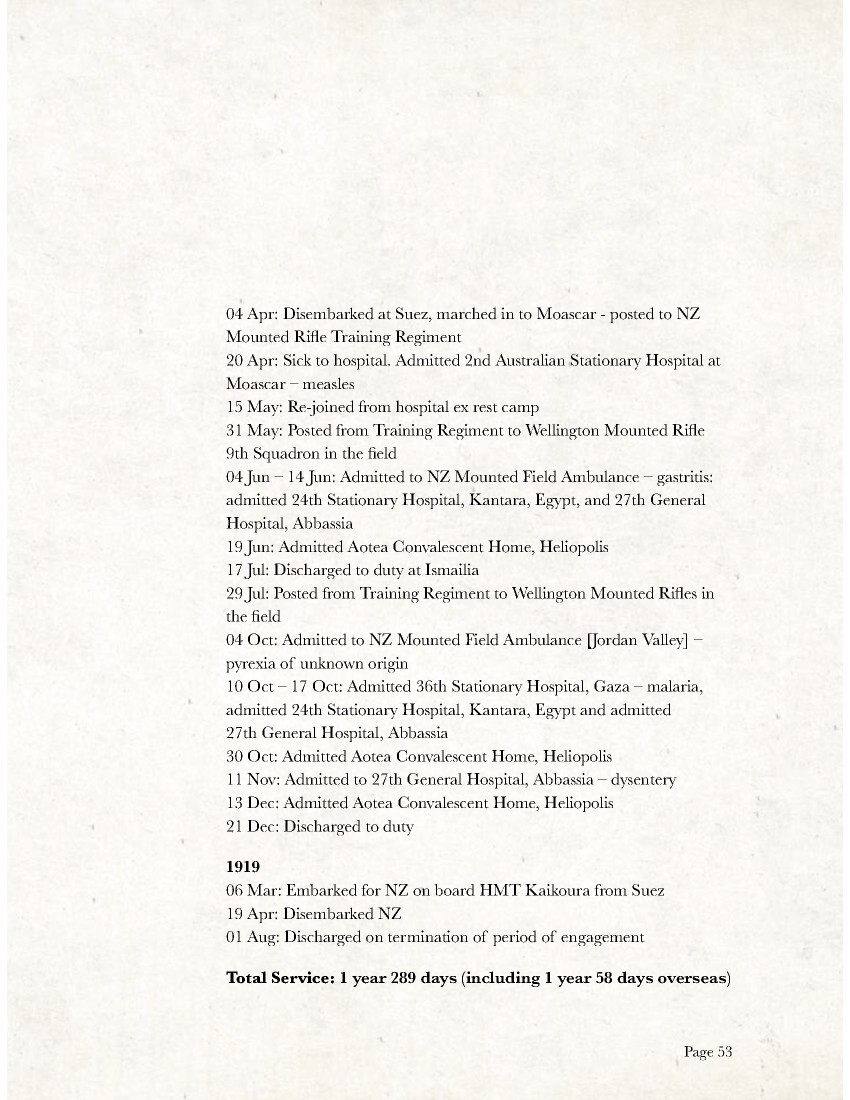
Page 54
LAND BALLOT
Ardkeen Section 3s, 602 acres
Jim approached the Commissioner of Crown Lands about transferring his brother’s homestead section to Ernie Clifton. No transfer was made at this time.
August 1930
The slump in wool and livestock returns left Jim Meagher unable to pay his rent or interest. Dalgety & Co, the stock firm, refused financial assistance; Jim asked for a postponement of arrears and rent until 1932. Field Inspector Robertson reported the farm was capably managed, and fully stocked.
February 1931
Jim wrote about the effect of the earthquake at the freezing works and wool stores in Napier, saying he was unable to get information about his meat, and wool. The wool had been offered for sale and passed in at three pennies a pound, Jim pointed out that this price would not pay the cost of shearing, cartage and brokerage. He opined, if he had made one half year’s rent, and interest above living, he would have been able to pay and, asked if in the event of the Commissioner seizing the livestock; would the family be provided with food and clothing during the next six months?
Dalgety’s had given an assurance that if the Land Board did not seize or distrain the livestock, they would provide a limited amount of credit for food and pay working expenses.
A week or two later, Mr Robertson, the Field Inspector, reported that Jim Meagher was a capable farmer, managing the farm well, and the property was fully stocked with a projected income of £377, against expenses of £604 for the season.
April 1932
The Commissioner wrote he was not satisfied with the unpaid rent and interest, noting Dalgety’s had control of all the revenue from the farm. Advising he would write to Dalgety’s about an arrangement where the

Page 55
Department would share any surplus revenue over and above ordinary living and running expenses in the future.
Dalgety’s replied they were willing to share the farm profits with the Department of Crown Lands over and above reasonable living and working expenses. The Commissioner wanted to know who would pay the living and working expenses, observing that wool in the Napier wool store was unsaleable.
November 1932
Dalgety’s advised they were prepared to enter into a profit-sharing scheme with both Mr Meagher and his son Jim Meagher for a year, and they would pay necessary living and working costs.
June 1936
The lease or Section 2s was transferred to Jim Meagher.
Frank Meagher’s Homestead Section 2s was allotted to Ernie Clifton, 1929.
Section 2s and Section 3s, Frank and Jim Meagher’s farms were farmed together after the death of Frank in February 1922
Settlers in car at Waikaremoana
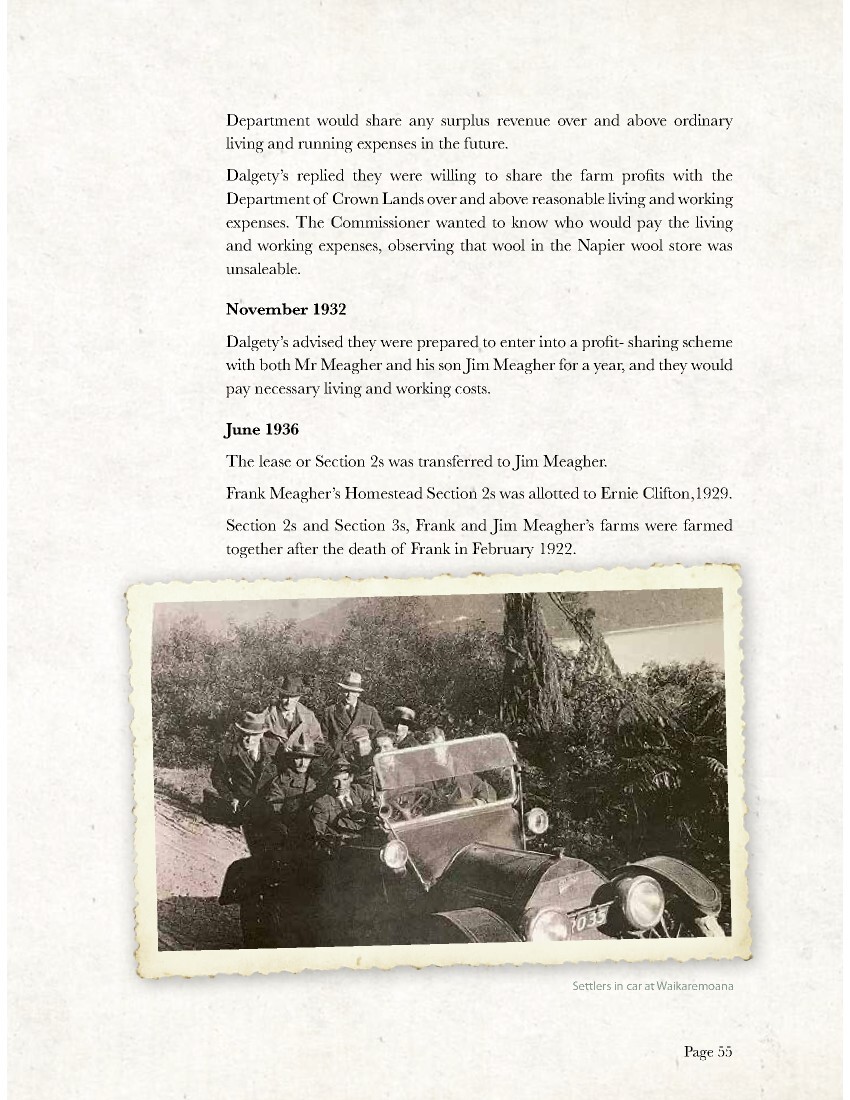
Page 57
RECENT HISTORY
Jim Meagher sold sections 2s and 3s to Murray McLagan in 1952. Murray was a WW2 returned soldier who served with distinction on Crete, his wife Sheena being Bob Preston’s daughter.
Murray sold both farm Sections 2s and 3s to Brian and Lynn Jones in 1969.
In 2007 Brian and Lynn bought 280 acres of Section 4s formerly Dave Robertson’s farm from Terry Corney.
Brian and Lynn retired to Wairoa in 2012, selling to Ivan Swann.
Mr Swann sold the farm to Conrad Smith in 2013, who sold to Grant and Sue Crawshaw in 2019. The Crawshaws own sections 2s, 3s and 4s of Ardkeen.
Jim Meagher’s Homestead Section 3s was sold to Murray McLagan in 1952.
Murray sold to John Bostock in 1981. A tree fell into the house, and John rebuilt it before selling to Tony and Jenny Kemp in 1983.
The Kemps sold to Peter Beddingfield in 1984.
The Beddingfield estate sold to Ray Westcott in 2001 who sold to current owners John and Heather Logan in 2016.
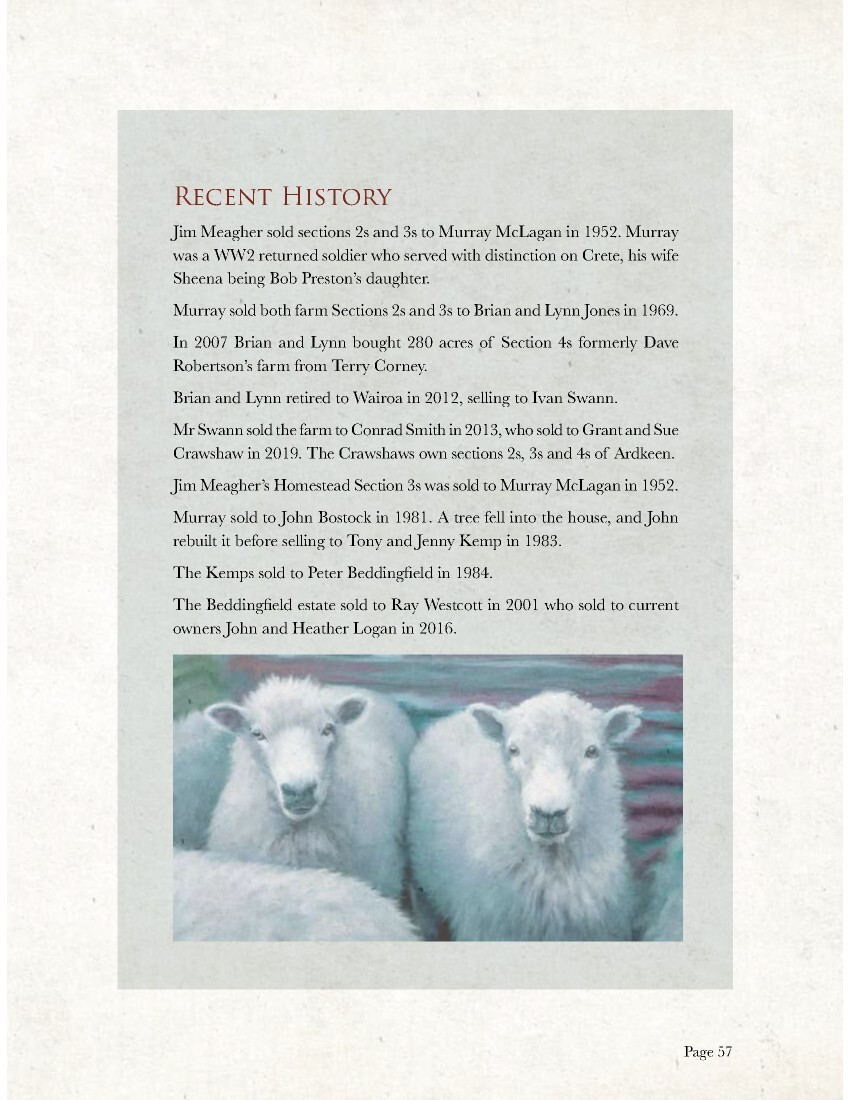
Page 58
DAVE ROBERTSON
MILITARY SUMMARY
Date of Birth: 16 September 1894 24
Place of Birth: Gisborne
Next of Kin: J Robertson, father,
Last NZ Address: Waerenga-a-hika
Marital Status: Single
Occupation: Sheep farmer
Employer: J Robertson
Regimental No: 12639 (9/2220)
Rank: Lance Corporal
Death: 7 April 1960 25
Buried: Cremated
Awards: British War Medal, Victory Medal
Other Service: WWII 805248 ‘T Force’ – Tonga
1915
22 Dec: Enlisted – posted Wellington Mounted Rifles D Company
11th Squadron as Private
1916
28 Jan: Promoted Lance Corporal
11 Mar: Transferred to 2nd Reserve Squadron, then to D Squadron 12th Reinforcements
04 Apr: Transferred to Machine Gun Section and on
26 Apr: Transferred to 12th Mounted Rifles
06 May: Departed NZ
24 Birth not registered. Gives his date of birth as 16 September 1894 in WWI papers and 16 September 1895 in WWII papers
25 Death recorded on file incorrect
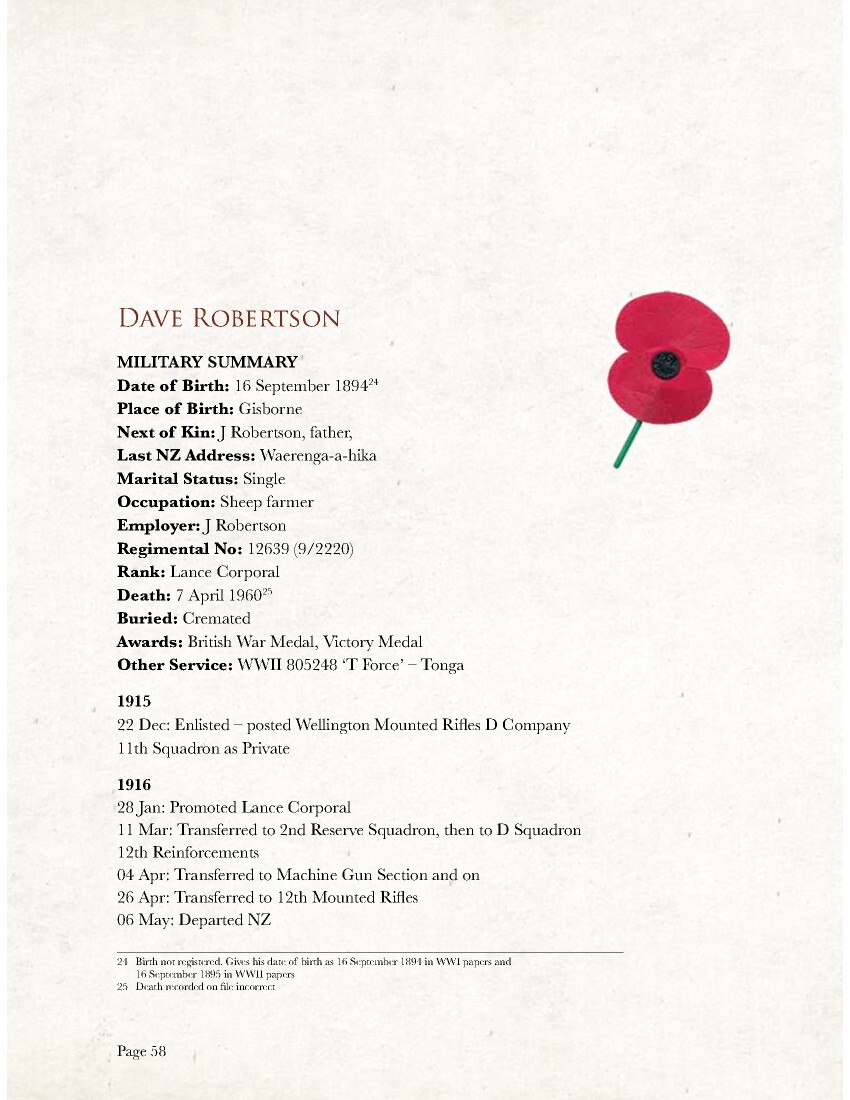
Page 59
4 Jul: Transferred to NZ Mounted Rifle Brigade
29 Oct: In Egypt
1917
06 Mar: Attended 24th Course at School of Instruction at Zeitoun – classed as gunner
27 Apr: Admitted to Hospital – Alexandria
16 Oct: Detached to ANZAC Rest Camp
20 Oct: Re-joined Unit from Rest Camp
1918
20 Jan: Detach to Rest Camp at Port Said and later posted to Ayun Kara
01 April: Appointed Lance Corporal – Wellington Mounted Rifles Regiment (6th)
20 Apr: Sick to hospital – Cairo. Returned to duty 23 April.
30 Jun: Sick to hospital – admitted 69th General Hospital. On 5 July admitted 46th Casualty Clearing Station – transferred to 47th Stationary Hospital Gaza – Malaria
13 Jul: Admitted 69th General Hospital and 7 days later, on 22 July admitted 27th General Hospital at Abbassia, Cairo – progress satisfactory
23 Jul: Admitted Aotea New Zealand Convalescent Hospital at Heliopolis. Returned to duty 09 August
15 Aug: Transferred to NZ Mounted Rifle Brigade then to Wellington Mounted Rifles (WMR) (6th)
14 Sep: Detached to WMR Rest Station – re-joined unit 10 October
20 Nov: Promoted twice in October but reverted to ranks at own request. Recommended soldier return to NZ
13 Dec: Embarked for NZ on board Malta ex Suez
1919
27 Jan: Arrived NZ on board Malta
26 Feb: Discharged on termination of period of engagement
Total Service: 3 years 67 days (including 2 years 269 days overseas)
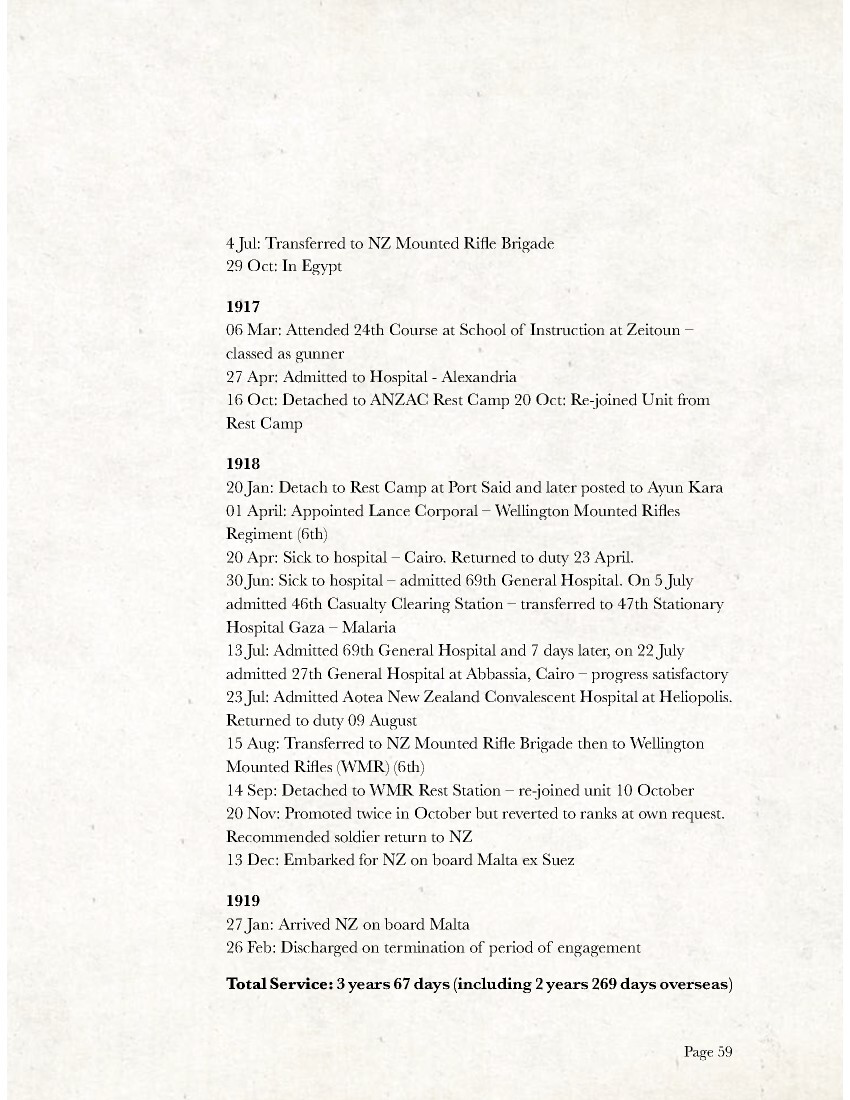
Page 60
LAND BALLOT
Ardkeen Section 4s, 751 acres
Awarded to Dave Robertson
Capital Value: £5,630.
Rent £253.07
The back of Dave Robertson’s farm was accessed by a six-mile stock track from his homestead section on the Waikaremoana Road.
Shortly after taking possession, Dave wrote advising the Commissioner he had been unable to inspect the 463 totara fence posts and 15 strainers he had bought, noting “rotten and dozy posts” were often in the middle of the heaps. Dave offered that half a dozen good pack horses would be more use than a ton of wire at the time.
When Dave settled on Ardkeen he thought prospects were good; wool and meat were fetching good prices under the ‘Commandeer’. He had hoped prices would be even better when the ‘Commandeer’ was lifted.
The wartime and immediate WW1 post-war business environment was characterised by a booming land market and related activities of stock dealing, and sales of modern equipment and plant that all progressive farmers had to have. The stock and station companies encouraged speculation in farms and helped many soldier settlers with development finance, beyond that provided by the Government. When prices for primary commodities slumped after the determination of the wartime Commandeer, the soldiers along with many other recent land purchasers were left with outgoings for rent, debt servicing, and loan repayments that could not be made from farm income. Meat, and wool farmers were struck first, by declining returns, followed a season later by dairy producers. By 1921 the economic position for most soldier settlers was particularly perilous, few had enjoyed the benefit of the good returns during, and immediately after the war. A moratorium protected the stock companies from a run on their deposit funds, so that they would be in a position to carry on servicing the farming community until prices, and land values stabilised. 26
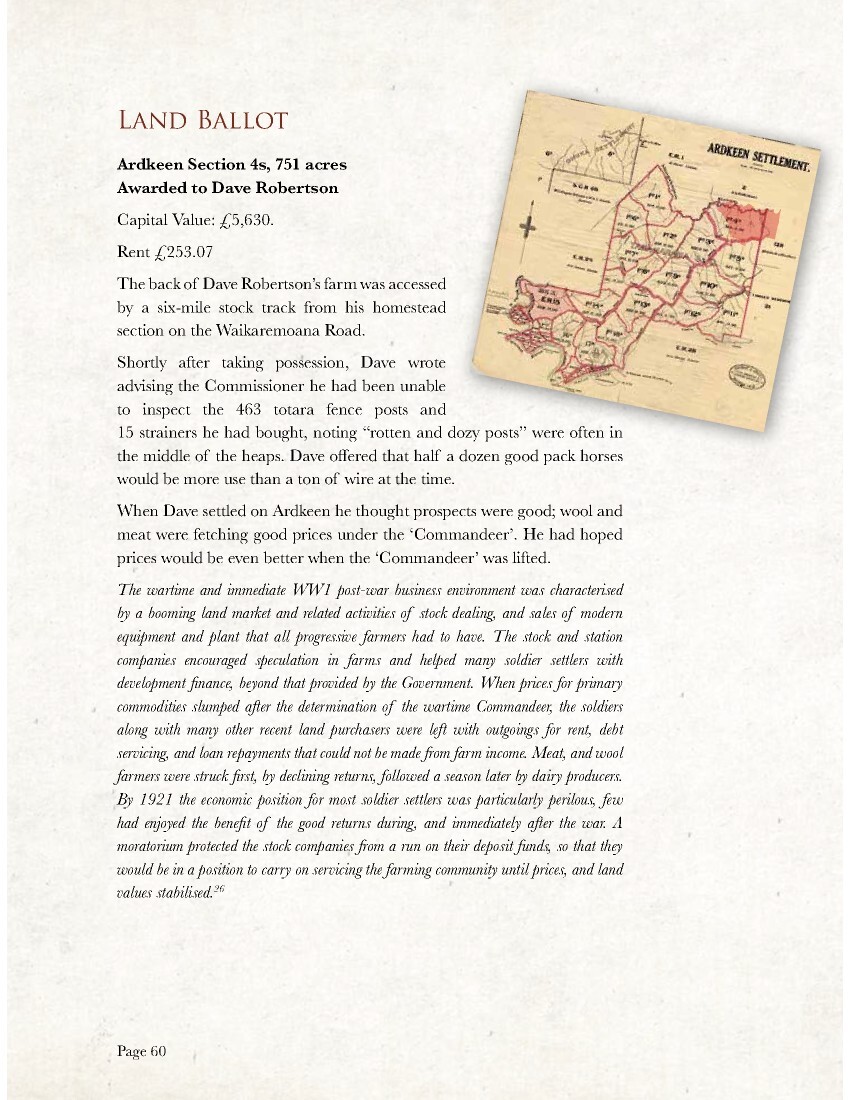
Page 61
June 1920
Dave had stocked his farm with livestock bought from the Government in March or thereabouts and reserved for the settlers. The prices were high, the newly settled soldiers needed 20,000 – 25,000 sheep for their Ardkeen and Ohuka Settlements exacerbating the situation. Outside markets were out of reach because of the distance and poor roads of the time. There would be no rail service until July 1939.
The Government entry into the land market, directly to purchase estates and, indirectly through mortgage assistance under section 2 of the 1917 Discharged Soldier Settlement Amendment Act saw land prices rise dramatically. 27
Dave had wool in the woolshed at Ardkeen; fat stock was not worth as much as they had been six months previously as ‘store stock’. Dave speculated his lambs might help keep the ‘wolf from the door’. Writing: “With a half-yearly rent instalment due, plus County Rates, Harbour Board Rates, Hospital Rates, Bank Rates and the Death Rate. In view of the foregoing, it is hardly necessary to say my financial state is not so good, despite having had a good growing season”.
Dave’s father provided a guarantee of £1,000. The Crown Land Ranger reported Dave as satisfactory farmer and a good settler.
October 1921
Dave wrote to the Commissioner saying he had not spent money on improvements because of the high price of materials. He added that when the price of wire dropped, he would begin erecting two and a half miles of subdivision fencing.
January 1922
Dave asked the Commissioner if he could exchange his Ardkeen farm for a farm beside his brother at Tiniroto, pointing out the advantages to both his brother and himself, especially because his brother was deaf.
March 1924
Dave wrote; “except by some miracle of finance”, he would be unable to pay 25% of rent arrears, and continue farming observing; ‘It seems I am in
27 Gould, A. N. (1992) Proof of Gratitude, p. 101.
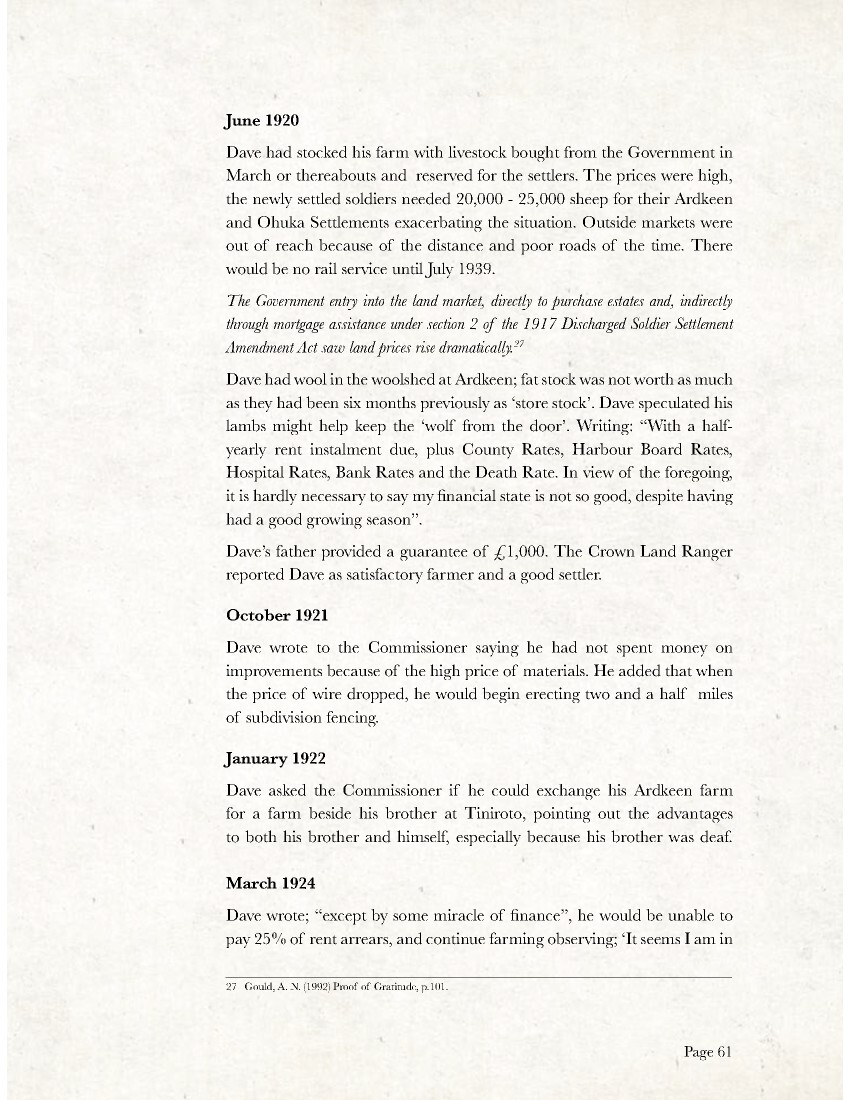
Page 62
the soup either way’. Dave wanted the Valuation Board to recognise that the farm was grossly overvalued; with expenses exceeding costs every year and livestock values having halved since settlement.
April 1924
The Land Board advised the Honourable Minister of Lands to forfeit Dave’s farm for non-payment of rent.
Williams & Kettle Stock Firm had told the Crown Land Ranger Robertson they were willing to pay the rent however, Dave would not allow them to.
The Minister had declined to forfeit several holdings on Ardkeen and Ohuka Settlements. The Gisborne Land Board felt it would be useless to recommend forfeiture for non-payment of council rates. The Field Ranger noted the property was in fair condition albeit overstretched and too highly valued. The farmer was a good type but handicapped by distance from his homestead section.
Dave wrote to the Chairman of the Gisborne Land Board expressing the wish to transfer his farm, including liabilities to two other settlers on Ardkeen.
February 1925
The Ranger inspected Ardkeen and reported with a few exceptions the sections had wintered more stock than was estimated except in a few cases of overstocking; the condition of the stock was satisfactory. Saying that a number of settlers expressed satisfaction with their valuations, but complained the farms were too small.
Several said they would have preferred a larger area, rather than a rent reduction. This bears out the contention that the size of the farm was a bigger factor than value. The board feared some settlers would abandon their holdings unless they were given further concessions. They did not think there was much chance of this happening. If it did there would not be the least danger of the sections being left on the department hands. It probably would be the best solution to the problem because it would enable a redistribution of the areas to the remaining settlers.’
A high degree of paternalism is evident in the actions of the various commissioners and their boards in their dealings with soldier settlers. This is also reflected in the attitudes of the crown land rangers and the Supervisors of Soldier Settlements. A central question
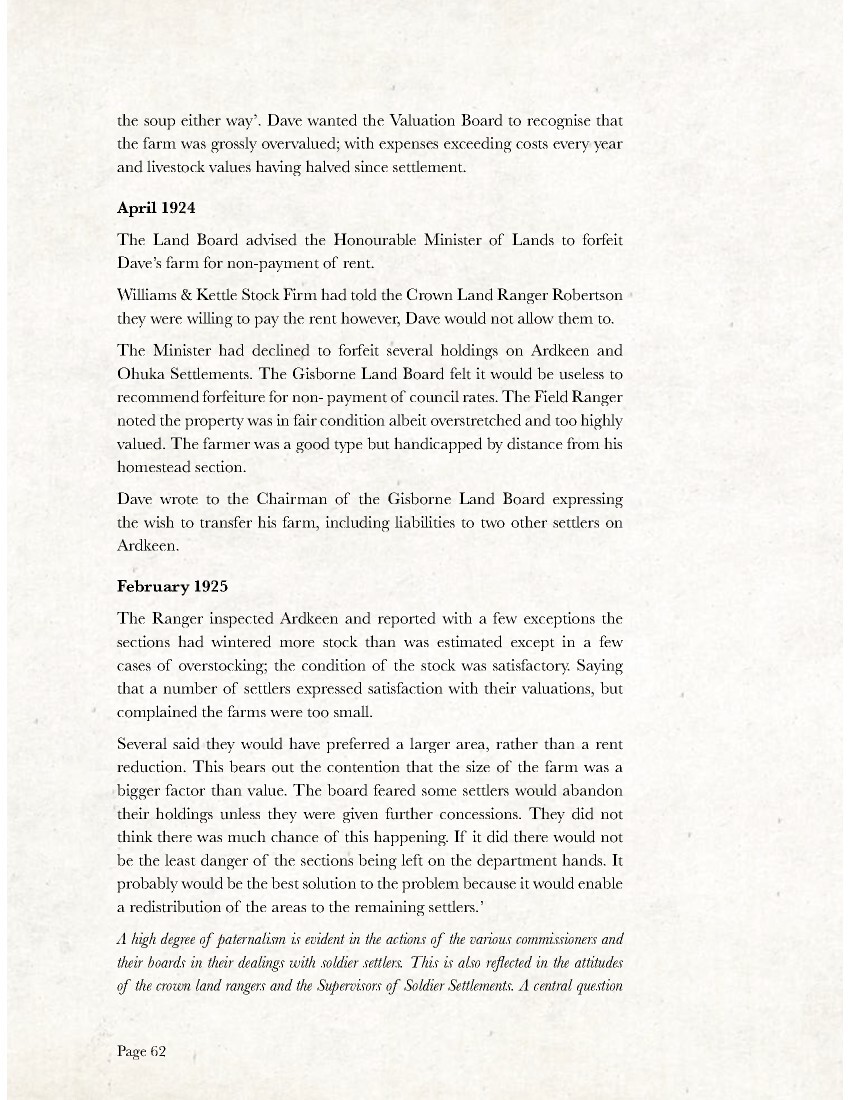
Page 63
to an understanding of the settlement scheme, and its eventual outcome, is why were the soldiers seen in a different light to civilian Crown settlers? There are two reasons: first, the position of the soldier was unique, with unprecedented interest from a variety of community groups. A successful scheme was seen as a political, and social necessity secondly. The appeal of the farming lifestyle after the experience of army life and the trenches was obvious, particularly the autonomy that a farmer was seen to experience in forging his own economic destiny.
Boards and the men at the cutting edge of the scheme were well aware of the shortcomings of a scheme that allowed men with little experience and capital to become farmers, and so responded with an increased degree of supervisory interest.
This was necessary to protect the Crown’s investment, as the normal responses to errant or defaulting tenants could not easily be invoked because of the public outcry. 28
Commissioners’ memo:
‘There are several inexperienced men, at least one who is in indolent, and several good men with insufficient area; if we were to reduce values in these cases, it would be unfair to the others.
We have not hesitated to reduce values unofficially when necessary. But in the case of Ardkeen we cannot make further reductions. We recommend the deduction of 10% which the board added to our values, and in conclusion draw the board’s attention to the final paragraph in our letter 21 July.
About the Ardkeen settlers and the Land Board, the situation has now reached crisis point, either the settlers are in control or the Land Board. The board has twice recommended forfeiture in several cases, without results and decided once more to recommend forfeiture. The settlers on every other settlement in the district are making a reasonable effort to pay. A large proportion of the settlers on Ardkeen and Ohuka defy the board and continue to live rent-free. This is intolerable, the land board cannot put up with it. In the case of D. M. Robertson, the lessee has been using the proceeds from his farm to pay off the stock mortgage, he has not paid one penny’s rent to this department since his first half year. He is one of five settlers on Ardkeen who refuses to pay anything. Robertson has sold his stock, providing equity of £800 plus his wool for £300 and it is understood he is leaving the district.’
28 Gould, A. N. (1992) Proof of Gratitude, p. 19.
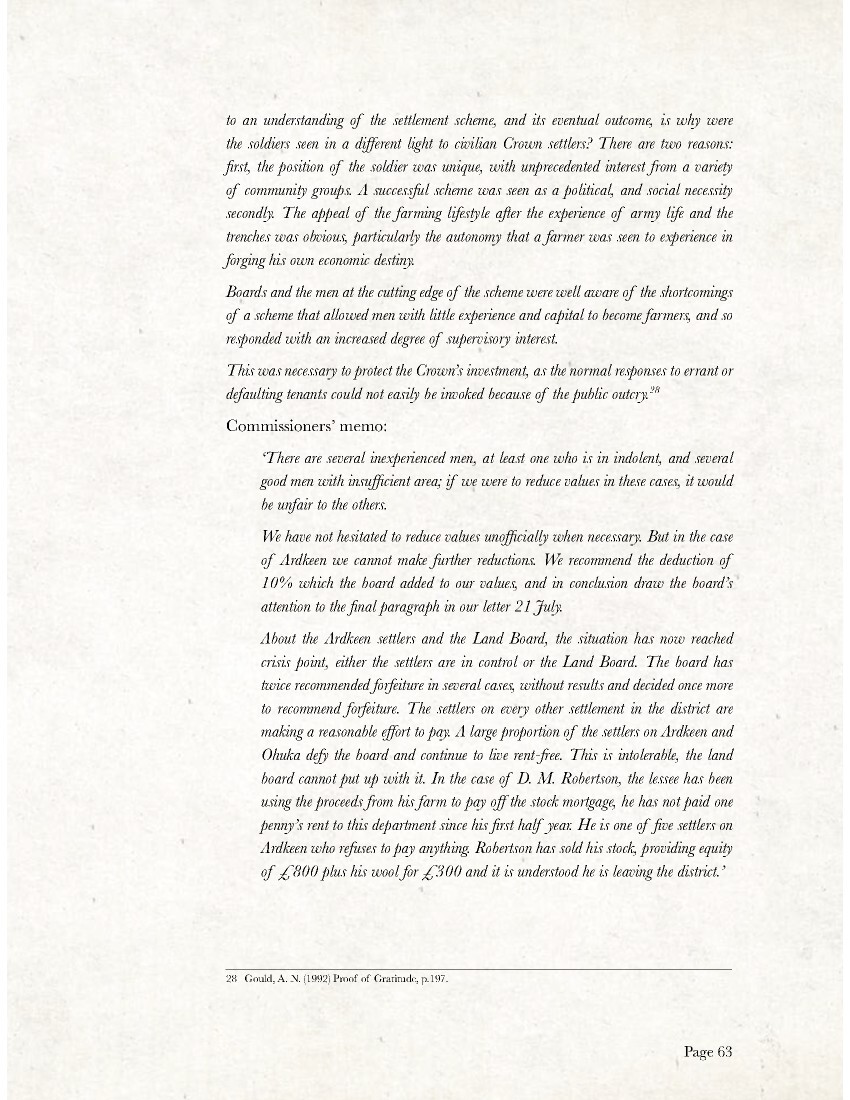
Page 64
A note on the Robertson file:
Shortly after writing, Robertson visited and explained if Dave left the settlement he would be liable for the arrears of rent and interest, plus amounts which have been postponed. He immediately paid £4 and all the outstanding rent and intends remaining on Ardkeen. With two exceptions the settlers on the settlements have now paid their rent’.
The Discharged Soldiers’ Settlement Bill contained 12 clauses covering matters of definition of returned soldiers’ tenures available; the setting apart of Crown Land or the acquisition of private land, authority to make regulations, the raising of funds, and other administrative matters. The most significant clauses, and ones which came to have prominence in later years, related to the provision of financial assistance to the soldier settler for development purposes, the option for Land Boards to remit rent, the restriction of a 10 year moratorium on transfer of a soldier’s farm, and the provision for revaluation of properties, should this become necessary. The debate on the Bill was essentially laudatory of the Government’s initiative, with a universal recognition of the need to reward New Zealand soldiers. 29
May 1926
Dave wrote to the Commissioner about leasing W. J. McKay’s farm, if the section became available.
The Department had become aware Dave was not residing on his farm but looking after his father’s farm close to Gisborne. Mr. Nolan, a board member suggested that Robertson may not return to Ardkeen. On the other hand, one of the proposals to be put to head office will be that part of McKay’s forfeited holding, will be added to Robertson’s.
The matter of McKay’s farm was again raised in December 1928 when Dave asked about the subdivision section 10s. Making a point of emphasising that his farm was the most inaccessible on Ardkeen and he would like an additional small area closer to his homestead section.
Dave made application for 187 acres of MacKay’s Section 10s in April 1930 pointing out the block was very rough and required a lot of cattle to clean it up.
29 Gould, A. N. (1992) Proof of Gratitude, p. 90.

Page 65
A Summary of David Henry Robertson’s position:
Present condition of Land: all in grass-second growth scrub in places.
Ability of Settler: satisfactory
Manner in which farm is being handled: satisfactory
Stock carried: 176 head of cattle / 1,250 sheep
What stock might be carried if property was worked efficiently: 225 head of cattle /1,300 sheep
The Commissioner regarded Dave as a first-class settler and recognised he needed assistance to break-in his farm and, work the additional 187 acres of McKay’s section 10s granted him.
September 1930
Dave took a lease of Matson’s vacated homestead section, pointing out the poor condition of the 87 acres despite the spring grass growth. The grazing cost 3p per head per week; ordinary grazing for sheep scarcely exceeded 2p. Dave asked for a £14 advance to buy two tons of manure.
November 1930
Dave explained the cost of his totara fence posts bought from Bob Preston:
Royalty £5 per hundred Splitting £3 per hundred Packing £3 per hundred Total £11 per hundred
The Department had paid £37 6.6 for the splitting, including posts and battens for another 40 chains of fencing; 600 posts had been cut on Preston’s, of which 250 were on Dave’s farm, and 350 still at Preston’s. Another 124 posts were cut on his own section costing 1 shilling a post.
The Department paid the following accounts:
Wire: £25 16.9
Splitting: £37
Erecting 42 chains:
Material on-hand: £21
8 hundred-weight of wire
1½ hundred-weight of staples
350 posts at Preston’s
150 posts on farm
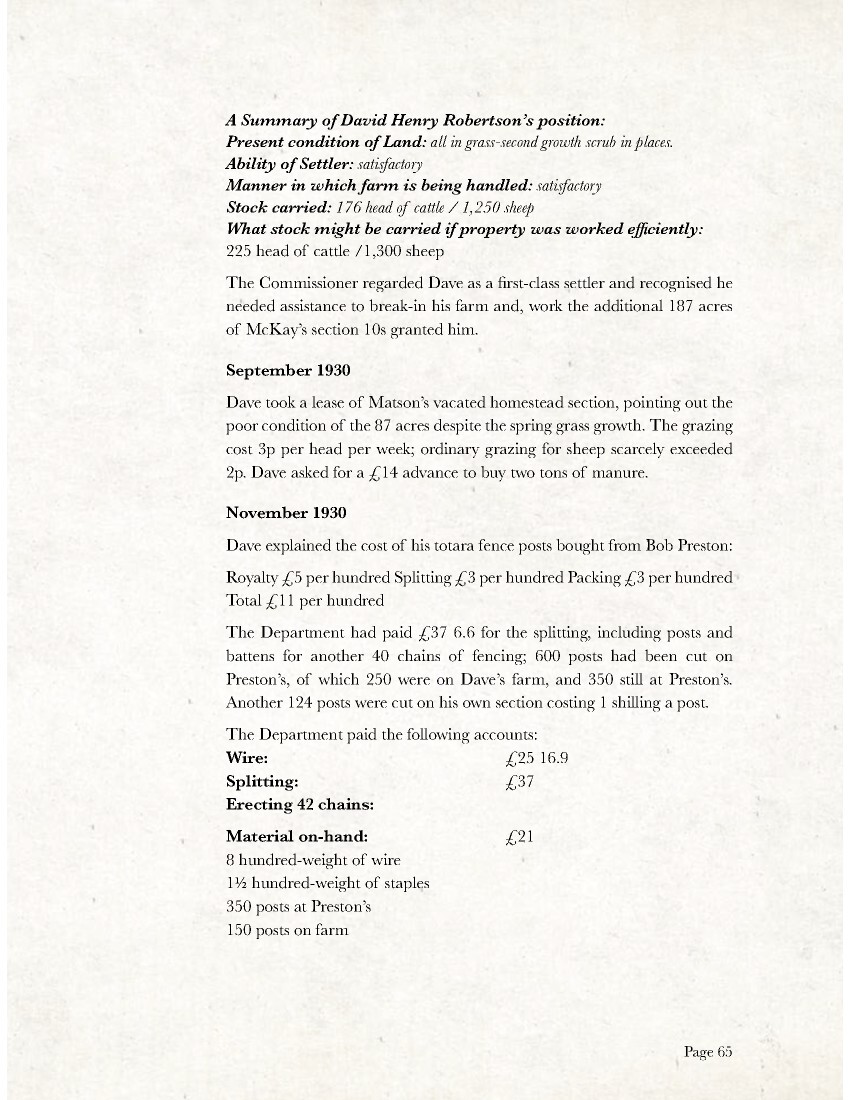
Page 66
400 battens-total value of Included:
500 posts
400 battens
11 strainers
900 hundred weight wire
1 & 1/2 hundred-weight staples.
£57.10
This includes the cost of packing out by horse and the royalty.
The completed fence cost: 35 shillings per chain.
The total cost of material and labour, less material on hand represents: £22.6 per chain plus two shillings per chain for gateways, floodgates and further 2 shillings per chain for gates hinges
December 1930
Dave wrote to the Commissioner advising he could no longer afford the rent for the former Matson house, and asked for the lowest price the Department would accept for the grazing of the 87 acres, without the house.
February 1931
Dave asked the Commissioner for another application form for postponement of rent; the one he had spoiled through a bottle of ink being spilled over it during the big earthquake.
April 1931
Dave advised the Commissioner he would be at Waikaremoana for some weeks grazing his cattle, saying he needed to be with them to stop them from disappearing into the bush.
May 1931
A memorandum noted the Commissioner’s refusal to allow Dalgety’s to take the proceeds from Dave’s wool clip next season. Dave believed if the Mercantile Firms and Banks had so little faith in the future, 50% of the farmers nationwide would have no credit facilities. A Mercantile Firm Manager told Dave that at present prices there was no margin of security with 70% of his clients, and many farmers were unable to pay interest.
The refusal to allow Dalgety’s to take first dibs from the next season’s wool
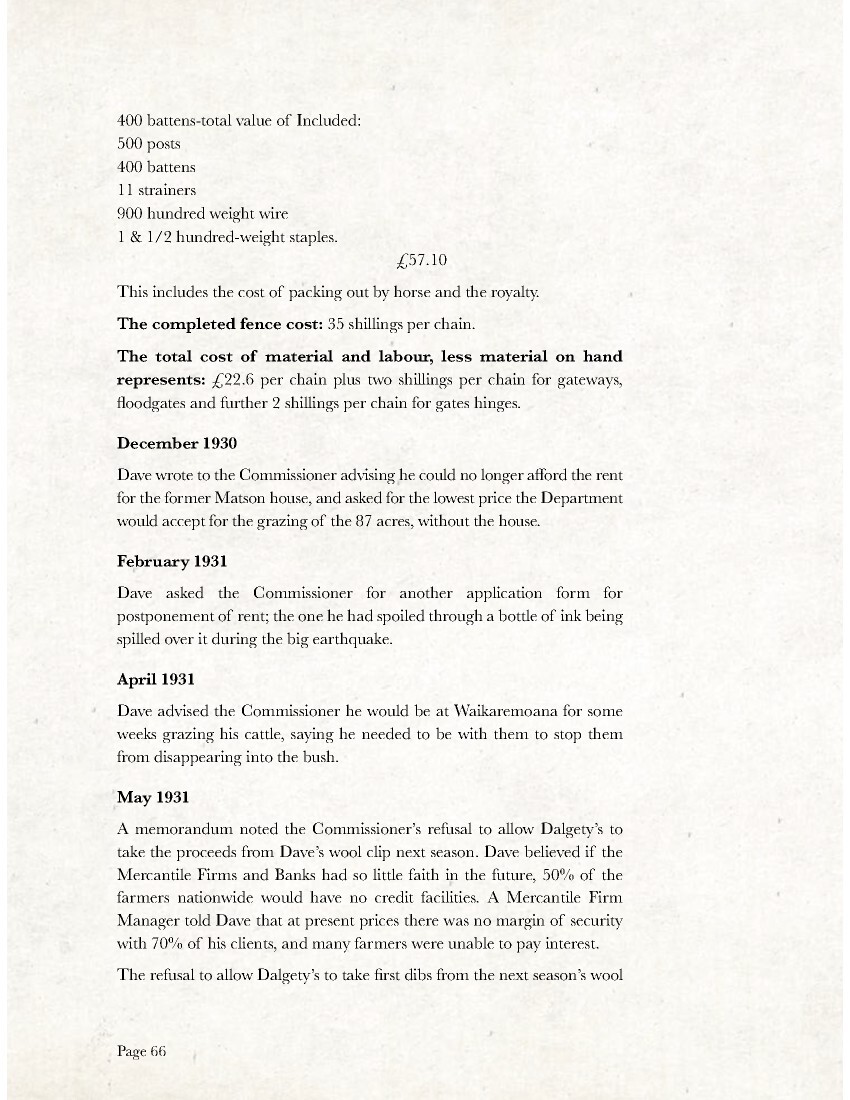
Page 67
clip, and the department’s refusal to grant a refund for current expenses put him in an awkward position. Dave explained he had no money, and would not ask for unsecured credit. In view of the abnormal conditions caused by the depression, and aggravated by a prolonged drought, Dave urged his case be reconsidered, asking for help with the present year’s rent, mindful of £1,500 of capital invested and 11 years of hard work on Ardkeen.
The Commissioner suggested a better plan would be for Dalgety’s to submit particulars of the accounts he wanted to pay. The Department would grant them permission to retain sufficient money.
The Commissioner empathised with Dave’s position, however pointed out there was no margin of security over advances made by the department, and Dave’s rent account was in a decidedly bad way.
Dave submitted the expenses below as essential to operating his farm:
Shearing: £35
Living expenses: £25
Wages: docking and mustering: £7
Stock requirements medicines and car expenses: £5
Horse shoeing: £3
Horse feed: £3
Offering that these expenses were unavoidable and often overlooked; he suggested Dalgety’s retain £50 from next season’s wool proceeds to pay small amounts to the storekeeper and blacksmith.
July 1931
Dave asked for £60 to build an addition to his house and buy a shed in Wairoa; he planned to use some material for the additions and the balance to build a woolshed on the farm at Titirangi.
The Department advised Dave to earn part of his living off the farm. Dave responded that with so many men out of work, and few jobs, it was difficult to find employment. He said he had frequently earned money away from the farm, and would not neglect that possibility should the opportunity arise.
The settlers were offered work on roads but often refused because of health problems and the 10 shillings day wages, were less than contract navvies would get. 30
30 Gould, A. N. (1992) Proof of Gratitude, p. 190.
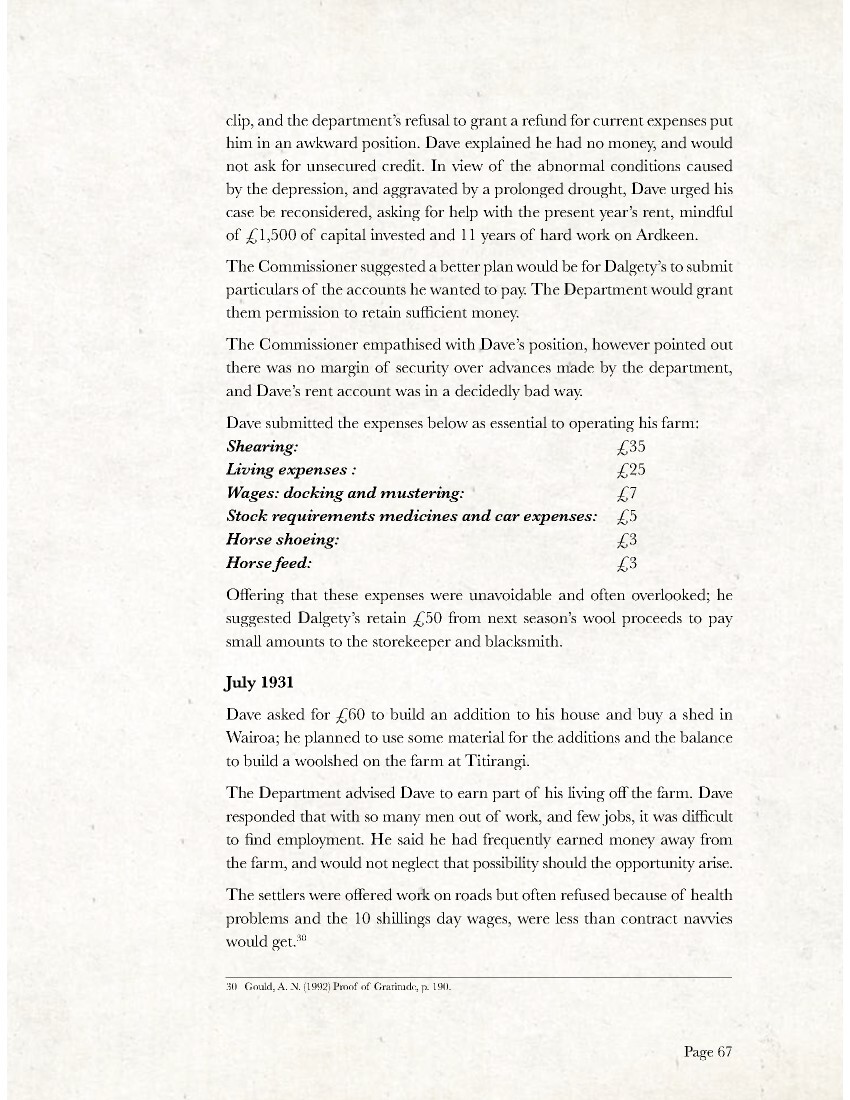
Page 68
July 1931
The Wairoa Farmers’ Cooperative Meat Co.
Meat Freezers and Exporters of Frozen Meat, Wool, Pelts, Tallow, etc.
Credit note:
Gross proceeds: 177 lambs
Shipped per SS Port Wellington
140 7C/S Grade to WG 4069 lbs at 7p £118.13.07
1“ 8 41 lbs @ 61/2p £1.02.02
29“ Y 741”@ 6p £18.10.06
£138.06.03
Debited
To London charges 4851 lb @ 894b. lb: £18.01.05 “ “
Commission £138.6.3 @ 1.1/2% £2.01.06 “
Slaughtering, bagging, freezing, shipping and home freight: £70.15.9
Surplus: £67.10.6
Credit note:
The Wairoa Farmers’ Cooperative Meat Co.
Meat Freezers and Exporters of Frozen Meat, Wool, Pelts, Tallow, etc. By London exchange on proceeds of lambs sold X SS Port Wellington
9.5/8% of £118 3.4: £11 7.05
Our commission: 2% of £138.6.3: £2.15.04
Surplus: £8.12.0

Page 69
September 1931
The Commissioner of Crown Lands Ref: D. H. Robertson
Dear Sir,
We acknowledge receipt of yours of the 1st instant, now have pleasure in enclosing here with our invoice showing how the charges of £50.12.10 were made up. With regard to the London exchange we would like to mention that with this particular shipment of pooled meat, we had a very large number lots, and in most cases the London Exchange amounted to less than 10 shillings. Owing to the additional amount of work, and stationery used in connection with the shipment, we decided to hold the London Exchange (instead of charging the usual commission) to cover the additional expense and interest, due for charges outstanding, which were all paid by us at the time of shipment. We quite agree however, that exchange should be paid on account of your client as in this case, the exchange amounts to considerably more than other clients in the shipment. We regret omitting this credit and now have pleasure in enclosing our cheque amounting to £8.12.1 being London Exchange, less commission.
Yours faithfully, Secretary
October 1931
Dave sent the Commissioner of Crown Lands a receipt for sales of fat lambs shipped home last season and a statement of claim for pelts and the wool burnt in the Wairoa Freezing Works earthquake fire. Pointing out the difference between the gross, and the net return, stressing the cost of raising the lambs, and processing them at the freezing works needed to be added.
Dave advised the Commissioner in October he had docked 650 lambs, after the main rush there had been a snowstorm early in September. During that week Dave counted 87 dead lambs, further estimating losses could be more than one hundred.
November 1931
Expenses for the month of October are:
Wages: Docking £2.05
1,000 Carbon Tetrachloride tablets (for sheep fluke) £2.10
1 bag seed potatoes: 15 shillings
Stores: £2.3.6
Total: £7.13.6
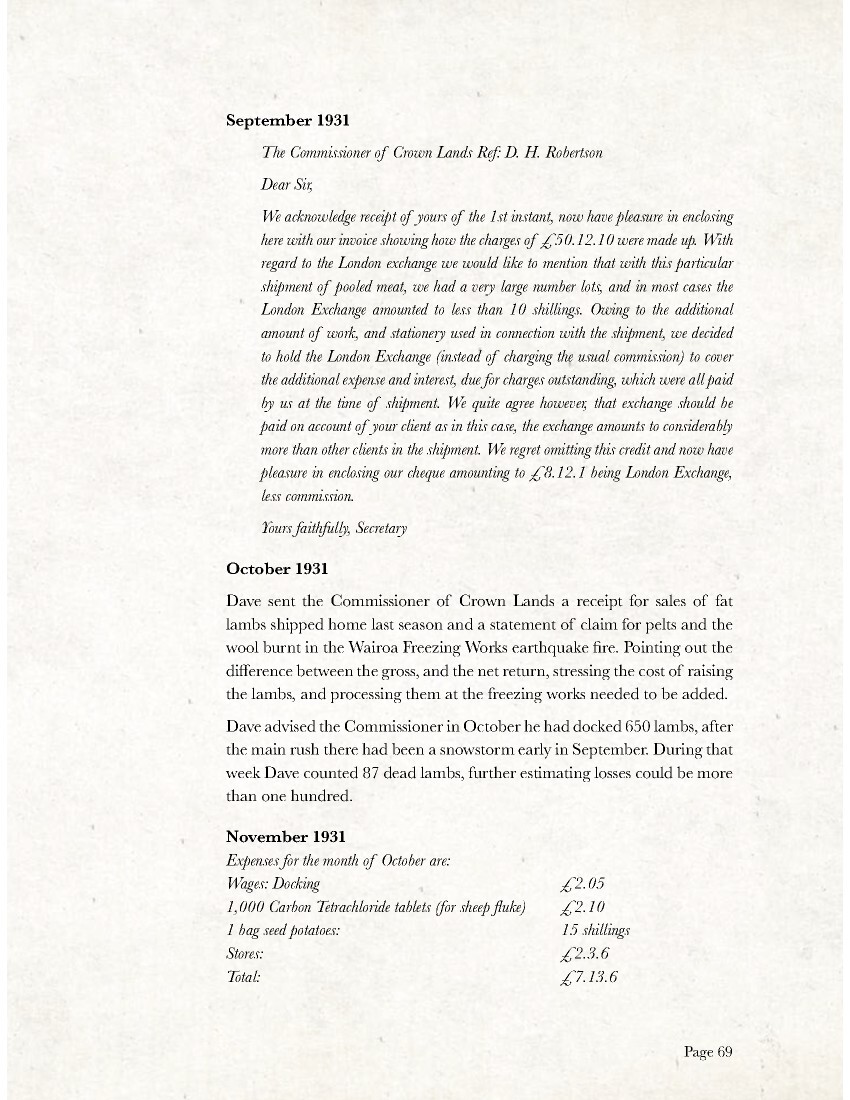
Page 71
RECENT HISTORY
Dave Robertson passed his farm to son Jock and wife Alice in 1963. Jock sold to Doctor Tait before 1973.
Ray and Iris Aires managed the farm until 1981.
Reece and Jackie Clark managed the farm from 1981 to 1983 followed by Mike and Lynda Scott who were managers from 1983 to 1993.
In 1993 Jason McConnachie and Nicky Reid bought the farm from Dr Tait. They sold to Terry Corney in 2005. In 2007, Brian and Lynn Jones bought 280 acres from Corney and Andrew and Caroline Holden bought the remaining 494 acres.
In 2010 Graham and Fiona Owen bought the 494 acres from the Holdens. In 2019 the Owens sold to Grant and Sue Crawshaw.
The Crawshaws currently own Sections 2s, 3s and 4s, totalling 1,885 acres of Ardkeen.
Roger Allott bought Pt 2 Section 10s, 187 acres from Terry Corney in 2005, selling to the Swann family in 2018.
Dave Robertson’s records, along with most of the Ardkeen Settlers cease in 1936 when the State Advances Corporation take rural lending from the Commissioner of Crown Lands.
The Robertson Homestead section of 4s is owned by Robert and Fiona Beale, relations of Jock’s wife Alice Robertson.
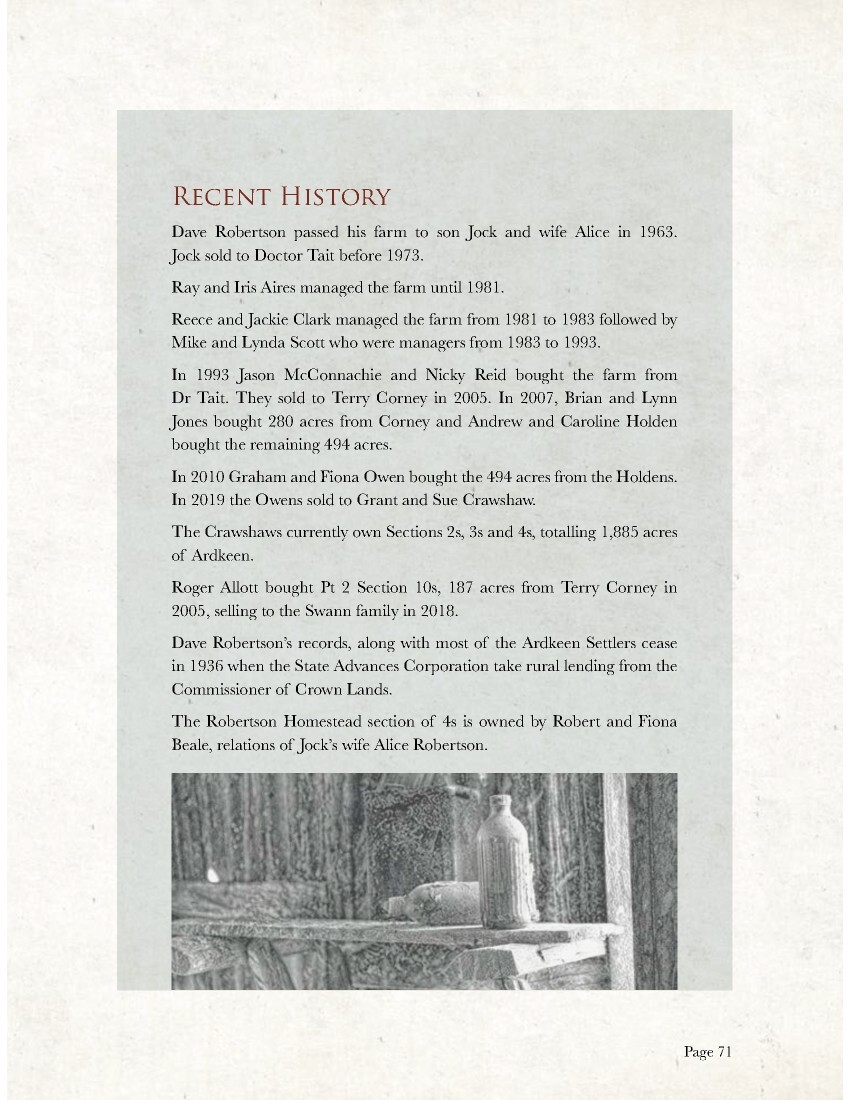
Page 72
PATRICK JOSEPH O’KANE (PADDY)
MILITARY SUMMARY
Date of Birth: 16 March 1884
Place of Birth: Londonderry, Ireland
Parents: Thomas and Rose O’Kane
Next of Kin: Mrs G O’Kane, wife, Paki Paki.
Married: 1916 Genevieve Moroney
Last NZ Address: Papanui, Christchurch
Marital Status: Married
Occupation: Foreman
Employer: Thomas Borthwick & Sons, Christchurch
Regimental No: 68744
Rank: Private
Death: 21 March 1970 Hastings
Buried: Hastings Cemetery
Awards: British War Medal, Victory Medal 1917 1
1917
05 Sep: Enlisted at Christchurch
15 Oct: Posted to 33rd Reinforcements F Company 31 Dec: Embarked from NZ on board HMNZT99 Athenic
1918
Jan: Transferred to 33rd Reinforcements D Company
25 Feb: Disembarked Glasgow
26 Feb: Marched into No. 4 Camp, Larkhill, Durrington, Wiltshire
Apr: Marched out to Sling Camp, Bulford, Wiltshire
10 Sep: Marched out to France
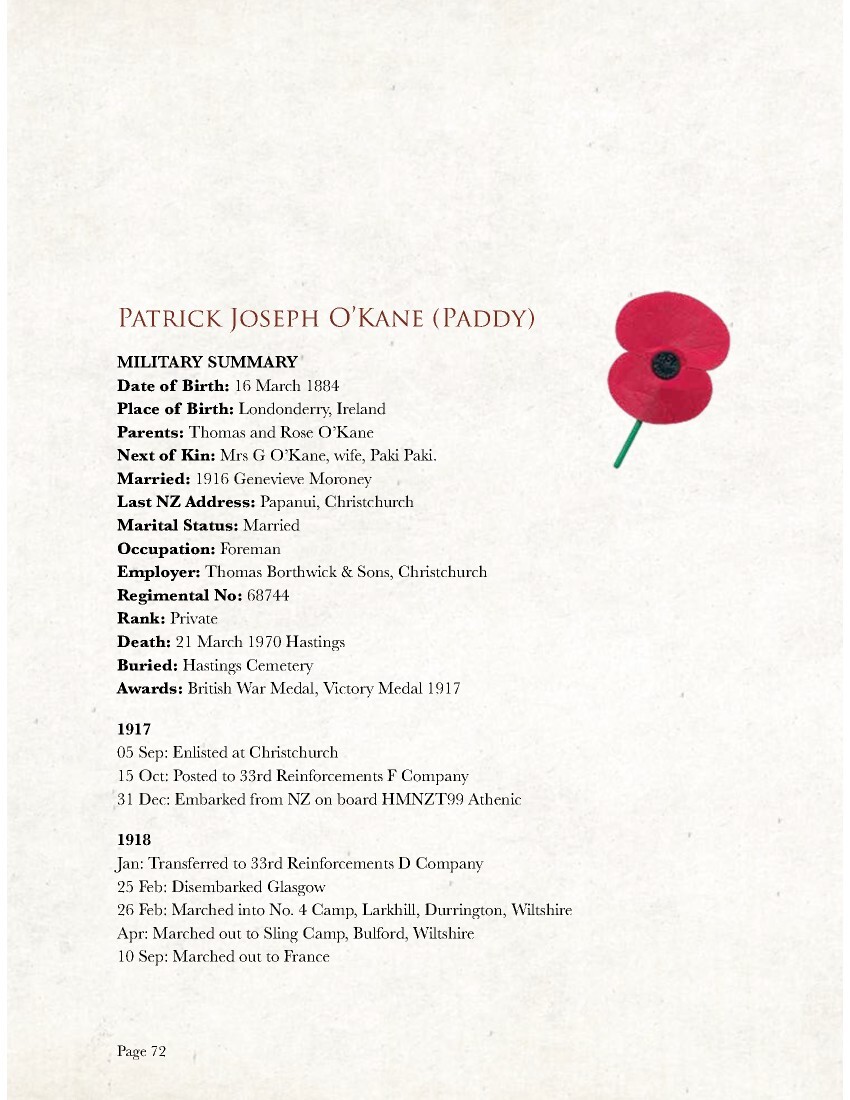
Page 73
16 Sep: Marched in to Etaples and posted to 2nd Battalion Otago Regiment 10th Company
30 Sep: Wounded in action – gunshot wound to right hand, face and forearm
03 Oct: Admitted 47th General Hospital at Le Treport
04 Nov: Transferred to Convalescent Depot, France
11 Nov: Discharged to base at Etaples. Armistice for the cessation of hostilities on the Western Front took effect at 11am
17 Nov: Attached NZ Infantry and General Base Depot at Etaples ex hospital
17 Nov: Re-joined battalion in the field
1919
14 Jan: Promoted to Corporal
18 Feb: Appointed Temporary Sergeant
03 Mar: Relinquished appointment of Temporary Sergeant
12 Apr: Embarked for NZ on board SS Pakeha from Tilbury, London
31 May: Disembarked Wellington
28 Jun: Discharged on termination of period of engagement
Total Service: 1 year 297 days (including 1 year 152 days overseas

Page 74
LAND BALLOT
Ardkeen Section 5s, 757 acres
Ballot awarded to: Paddy O’Kane
September 1920
Paddy ‘packed’ 100 fence posts and eight strainer posts allotted him, by horse and erected a fence. Paddy thanked the Commissioner for securing the fencing material for the settlement. Though noting the posts were not cheap when the cost of securing horses, pack saddles (the latter being prohibitively expensive) and pack-men were included.
Paddy asked for another allotment of wire in November, hoping the price may have dropped.
February 1921
An internal memo notes the settler as being embarrassed by the slump in the wool price.
Paddy thanked the Commissioner for securing the fencing material for the settlement. Though noting the posts were not cheap when the cost of securing horses, pack saddles (the latter being prohibitively expensive) and pack-men were included.
Paddy asked for another allotment of wire in November, hoping the price may have dropped.
January 1922
Paddy wrote to Commissioner Marsh in Napier asking for remission of his rent. He set out the following argument
As you are well aware the government paid a high price for the stock that we in turn purchased farms. Because the government prices were open knowledge, this set a bench mark price for all local livestock. To complete the stocking of my farm I bought 700 wethers at 34/-. Livestock values have gradually fallen and now the wool price is unstable; those same wethers have lost 10/- per head. I had the misfortune to strike a cold snap at shearing, resulting in the loss of 30 sheep.
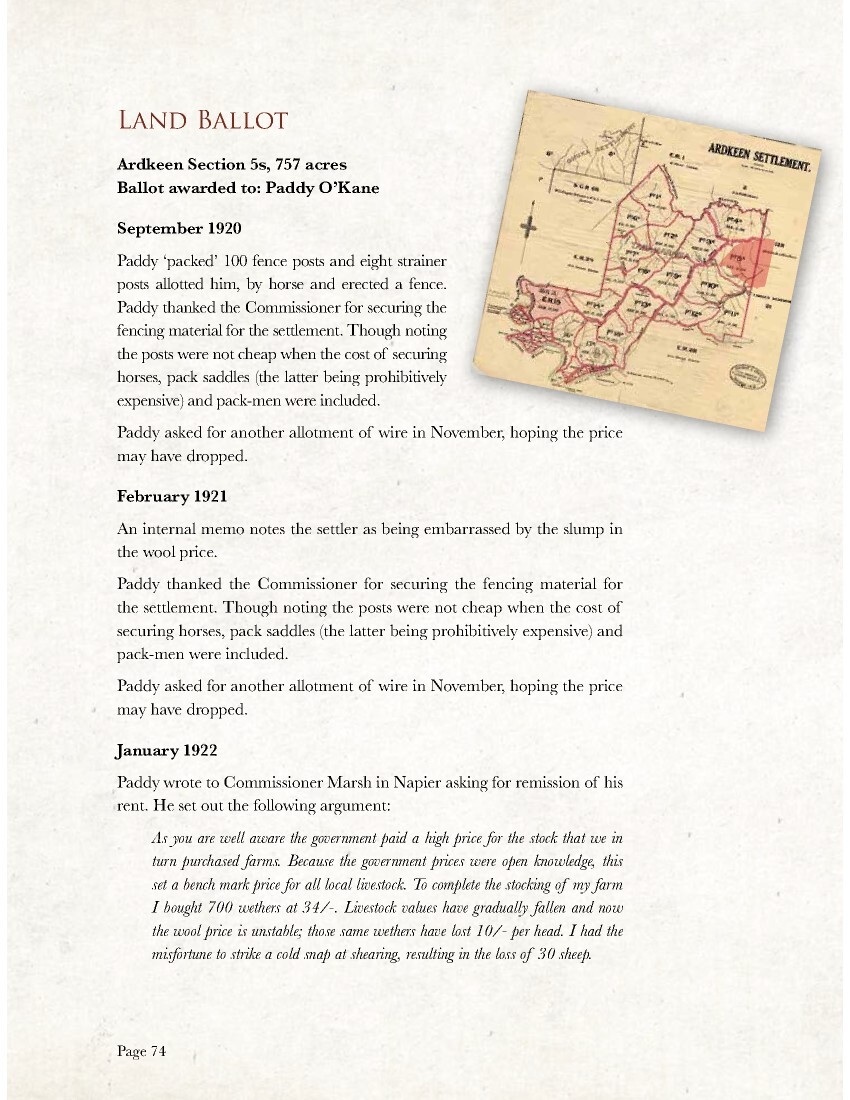
Page 75
February 1921
An internal memo notes the settler as being embarrassed by the slump in the wool price.
June 1921
The O’Kanes erected a cottage consisting of 2 large rooms, a scullery with brick chimney, with hot and cold water costing: £425
They bought:
Table legs and tabletop: £2.16.4.
Furniture: 14/-
Groceries: £0.17.9
Cartage: £11.10
July 1921
An office memo classified Paddy’s farm as first class land that was fully developed prior to purchase, with estimated income of £500, less estimated expenditure of £866.
Paddy did not think the property would be profitable at the present rental, even at 1917-18 prices. At best it would carry one sheep per acre and one cattle beast for every 10 acres. A six-month-old lamb sold for 11/-, good lambs realised 20/-, poor lambs 5/-.
June 1922
Paddy wrote to Commissioner Marsh about his overdue rent, advising the rape crop he planned to fatten lambs on had rotted. He was forced to sell the lambs as ‘stores’ rather than ‘fats’ and buy 500 replacement ewes.
Paddy referred to a conversation earlier in January, about a different method of managing under the present farming conditions; this has been done and forwarded to the Land Board through Mr. Ross; he wanted to hear what had been decided.
July 1922
The Field Ranger reported that the O’Kane farm was being worked satisfactorily by an experienced man who worked well and was in good heart. He had received very little from his farm, though should make a success of it.
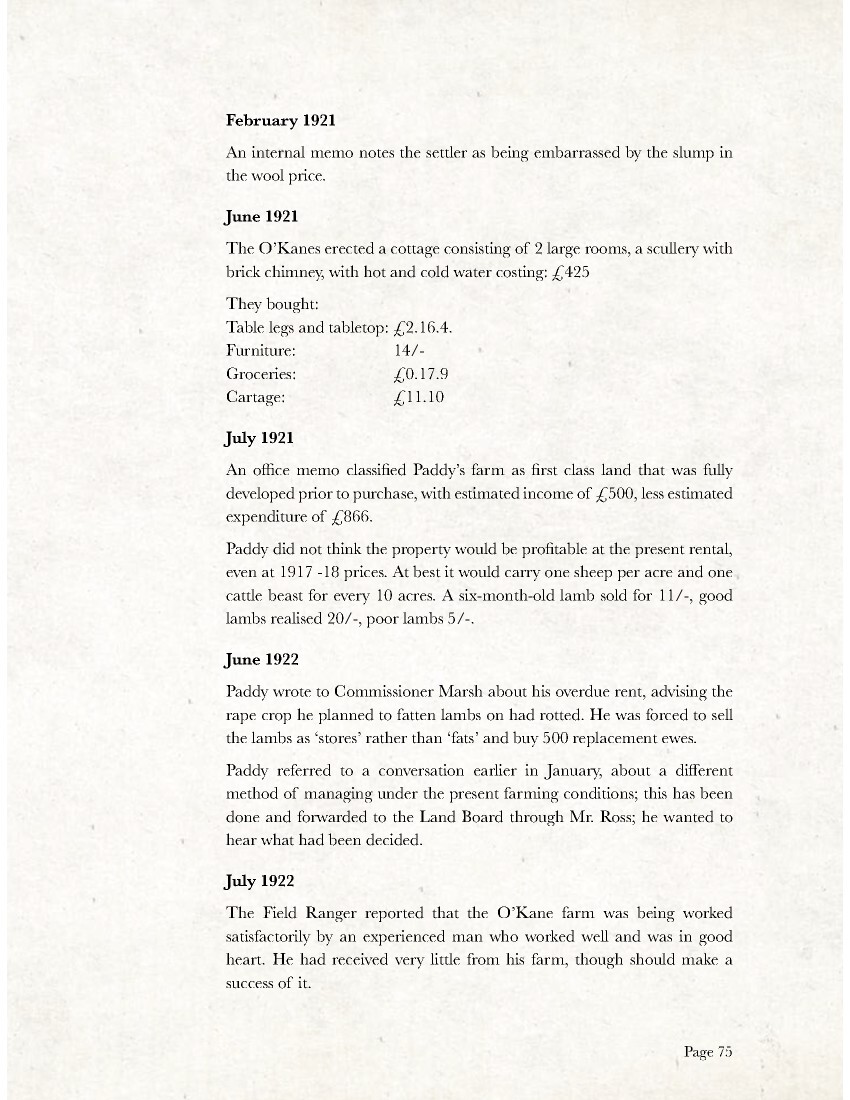
Page 77
July 1922
Mrs. Genevieve O’Kane wrote to Commissioner Marsh, asking for a ton of plain number 8 American fencing wire to be sent to her son at Wairoa. If none were available, could he get a ton from the native merchants; a saving of £5 per ton.
October 1922
Paddy advised the Commissioner, he was erecting 55 chains of subdivision fencing and had intended to do more fencing, but his figures suggested this was unaffordable.
October 1924
Paddy began negotiations with the Commissioner to lease half the Harbour Board Timber Reserve. The thousand acres of standing native bush lay on the eastern boundary of Ardkeen between Mahanga and Riverina Stations; the block had many Totara trees that could be split into fence posts and rails.
Paddy received a memo, advising him that the disposal of the timber reserve was under consideration and he would be advised as soon as a decision was made.
June 1925
Paddy was allotted 387 acres of the Harbour Board Timber Reserve that was all standing bush and scrub. The timber reserve was never part of Ardkeen Station or Mahanga however, it was considered part of Manutawhiorangi by local Maori.
April 1927
Paddy was farming:
1,050 ewes
400 lambs
34 rams
50 wethers
67 cows
35 steers – 4 years
26 calves
Estimated gross income: £1,037.7.6
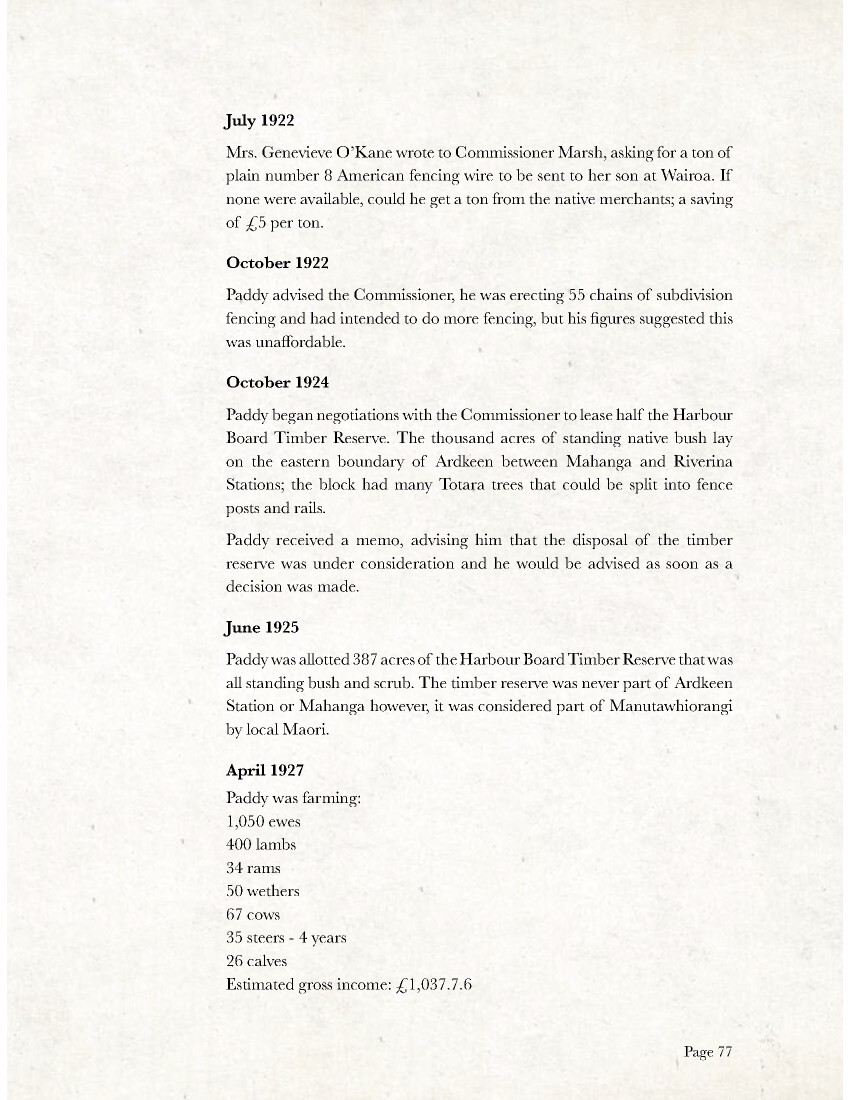
Page 78
Paddy wrote that the season had been dry, and he had begun clearing the timber reserve land but had been unable to buy livestock for this new country however, the farm was well stocked. Future fencing that was required would be done from income.
The Minister instructed Commissioners of Crown Lands that soldiers should be discouraged from purchasing stock at the sale-yards because they were bidding against one another and were not necessarily a good judge of livestock. Just as the land market provided for the accumulation of profits by speculators, so too did the stock sales; there were reports of farmers establishing cartels. 31
April 1928
Paddy wrote to the Commissioner about an increase in the power board rate for electricity. Two years previously the board had reticulated electricity to his homestead site. The chairman and engineer of the power board approached Messrs. Andrew, Birrell and O’Kane, asking for a guarantee of £6 per year, and they would connect the electricity. They agreed to provide a guarantee and got an electric light and one socket each. They paid the installation charges, and 9 pence per unit for the electricity used. The previous year Paddy paid a £10 rate, the current year the rate was £5, both collected by the Wairoa County Council.
“Now the chairman and secretary of the board tell us that because our farms have a rate able value of £4,000 our power board rate will increase to £30 a year. On top of the £30, they have increased the guarantee to £10 a year.’ Because the homestead sections are only 30 acres and in Paddy’s case, five miles from the farm, that was not serviced. Both sections are under one lease and the 30-acre homestead section is within 10 chains of the reticulated line but the entire farm becomes rateable.”
This charge represented £1.6.8 per acre on the area served which he argued was not just.
Paddy offered to meet the extra charge, if the land board granted separate leases for each section, allowing for the levy to be applied to the area served only.
31 Gould, A. N. (1992) Proof of Gratitude, p. 20.
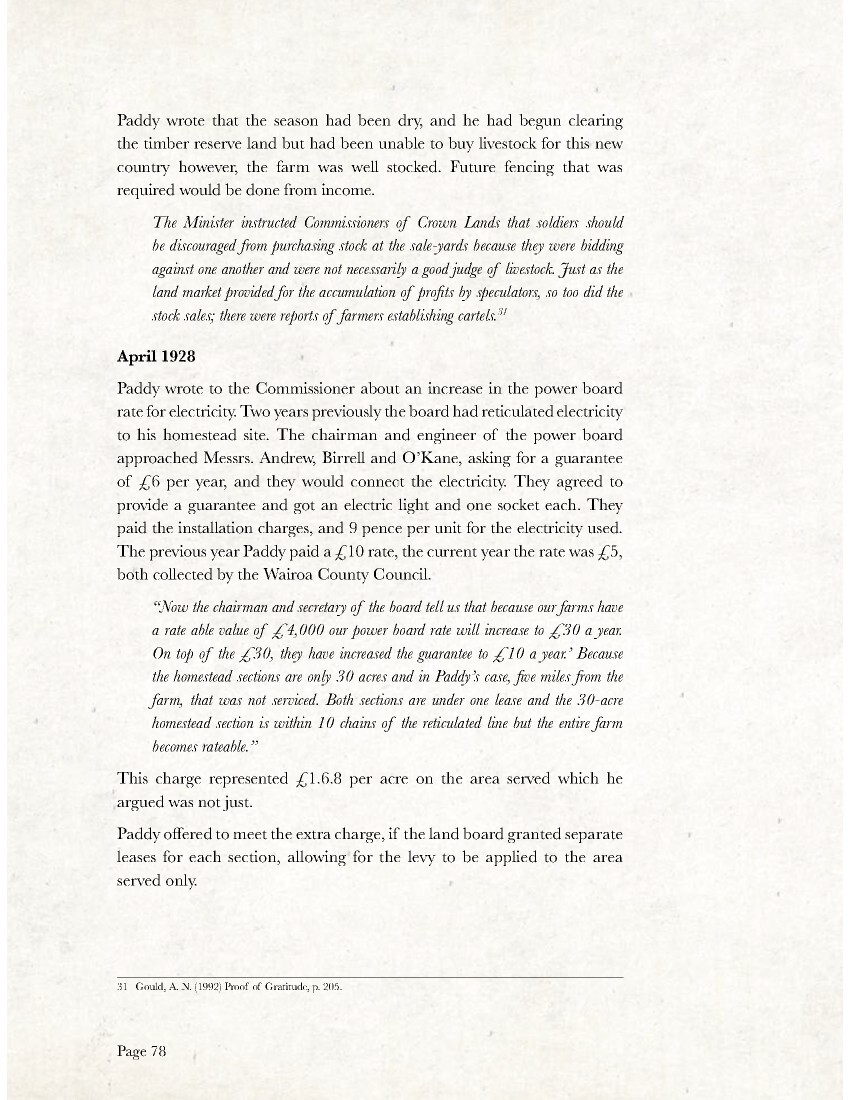
Page 79
October 1928
Paddy asked the Commissioner if he might lease the portion of Section 10s adjoining his farm for two months. This was because of a particularly dry spell, exacerbated by strong westerly winds which left him with no grass. He wanted to use the area for his dry sheep, enabling him to spread out the ewes and lambs.
October 1928
Paddy telegraphed the Commissioner:
“Will lease ‘Section 10’ £10 monthly until re-allotted urgently needed”. O’Kane October
The Commissioner advised Paddy that Mr. Tom Davey was leasing section 10s; he had been unable to speak with Davey on the telephone but, Mr. Nolan had spoken with Davey who indicated he would give up half the section. He had bought 600 sheep and would have to sell them first. Paddy was offered the eastern part of section 10s and it was left to him to make arrangements with Davey, offering that he understood there had been a good bit of rain and hoped Paddy would be able to manage.
November 1928
The Under-Secretary for Land wrote to the Commissioner about approving the adjustment to P. J. O’Kane’s current account saying there were two leases, and it is neither possible or advisable to unite the holdings under one lease. The timber reserve held by O’Kane was ordinary Crown Land but the rent received, less administration charges was paid to the Wairoa Harbour Board.
November 1928
Paddy wrote to the Commissioner about Section 19s – The Reserve. The Reserve was a nine-acre holding paddock with sheep yards attached, a day’s drove up from the Ardkeen woolshed, and two day’s drove from the back corners of Ardkeen Station. When Ardkeen was subdivided the area had been set aside with its own title as a holding paddock for the benefit of the settlers to hold their sheep overnight when droving to and from the woolshed at shearing and dipping times.

Page 80
The sheep yards had been maintained by Bill Carson of Section 13s, who was particularly well liked. Bill had packed willow and poplar poles by horse, planting them for shade and shelter in the yards. Someone had allowed their horses and cattle into the yards, breaking rails and gates and ring barking the trees. Bill asked the Commissioner if he might take possession of the yards as no other settler used them; this would allow him to close them off from abuse.
The Commissioner had received a complaint that the facility was in a poor state; he wrote to all the settlers advising he wished to offer a lease of the yards to Bill Carson, and that Bill’s livestock could graze the reserve and Bill would maintain the fences. He advised that any objection must be submitted within 30 days.
Paddy took it upon himself to address the matter on behalf of the settlers, writing to the Commissioner:
In reply, we beg to state that your interviewer must have misled you about the use of the above area. All the settlers are interested. This area was created as a reserve for all to use when necessary, and not any particular settler and left absolutely for the use of those who drive their stock that way; any complaints voiced to you were groundless, as no disinterested person used the area.
Mr. Carson’s request to take over the yards is reasonable. To my knowledge he has maintained the fences of the reserve and kept the yards in good repair for the past six years. He has paid for, and packed material for repairs, planted willows and poplar trees. Allowing Mr. Carson to graze this area will not inconvenience anyone; he will not refuse a request from anyone who wishes to use the yards. I believe Mr Carson’s request is a reasonable one and should satisfy everyone.
Mr Carson is one of your best and commands the respect of his fellow settlers. As you are no doubt aware there is petty jealousy; I humbly suggest this is the basis of the complaint you received.
We agree with your suggestion.
Signed
P.J. O’Kane
July 1929
Paddy wrote to Mr E. H. Farney, Commissioner of Lands reminding him when he was visiting with Messrs Hamilton and Bartram, he had agreed
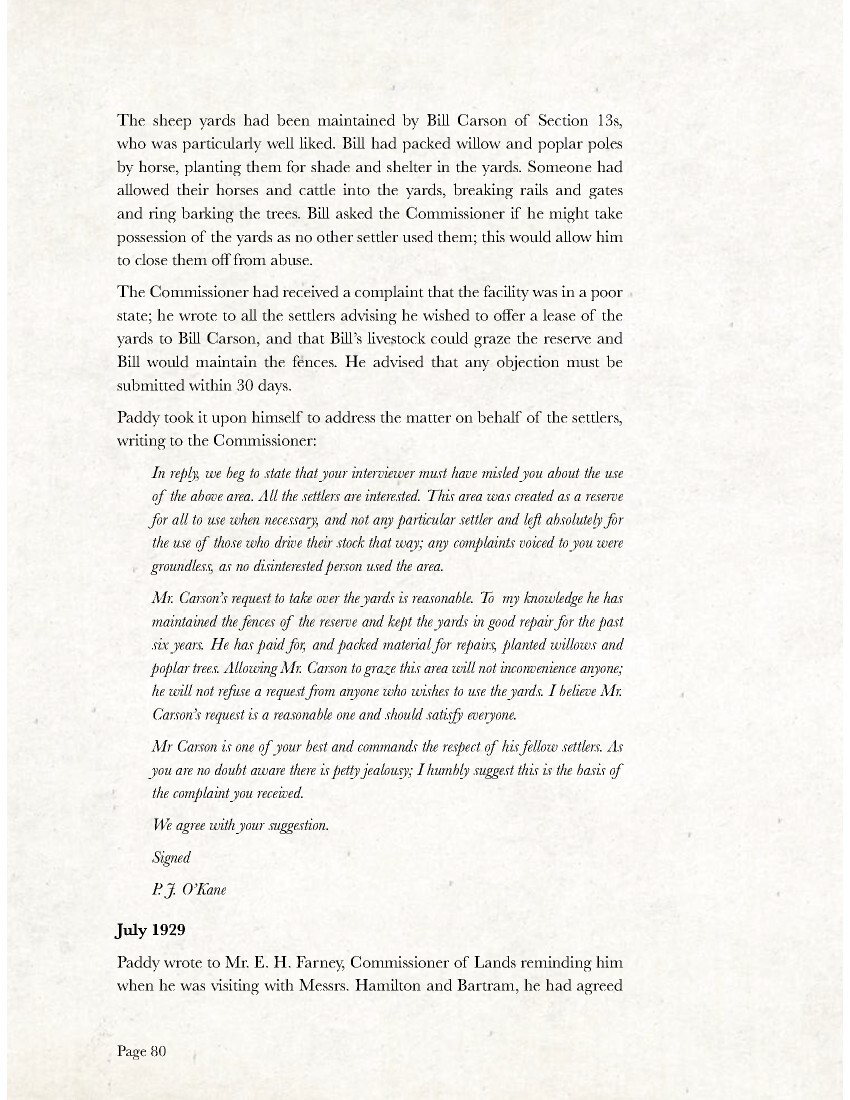
Page 81
to placing the homestead section under a separate lease to alleviate the excessive Power Board Rate for electricity supply.
October 1929
Paddy again wrote to the Commissioner advising he had applied to the Wairoa Power Board for an exclusion from the Special Rating for his 727 acres, Section 5s, and the 380 acres of the Timber Reserve which is four and five miles respectively from the Board’s facility. Paddy had offered to pay the power board rate, on his 30-acre homestead section based on the most recent valuation.
The Power Board refused his request, pointing out that if the property was under two titles on the ‘Valuation Role’, the Board would have calculated rate on the portion immediately adjoining the electric supply line.
January 1931
Paddy wrote to the Commissioner to say he was unable to meet his commitments to the department because of the unprecedented fall in prices for all livestock. He pointed out that two years previously, acting on the advice from the Commissioner and Messrs. Bartram and Hamilton that he needed cattle, he had bought cattle to clean up his farm as suggested.
“This the cattle had done, but in addition just about cleaned him up too”. Paddy advised he had over 100 cattle grazing on Mr. F. Norris’s farm whilst waiting for rain, and that it was impossible to quit at any price owing to the lack of feed everywhere.
He had lamb carcasses at the freezing works that no-one wanted. His wool would be in the next Napier sale, however price indications were not encouraging.
17 February 1931
Paddy wrote about the earthquake and subsequent damage saying that all the water tanks and brick chimneys on the settlement were severely damaged. Paddy asked about insurance, and if the department would make good the losses. Paddy said his chimney came down, breaking rafters and the ceiling in his lean-to, and it would be necessary to pull down most of the building to gain access to rebuild the chimney.
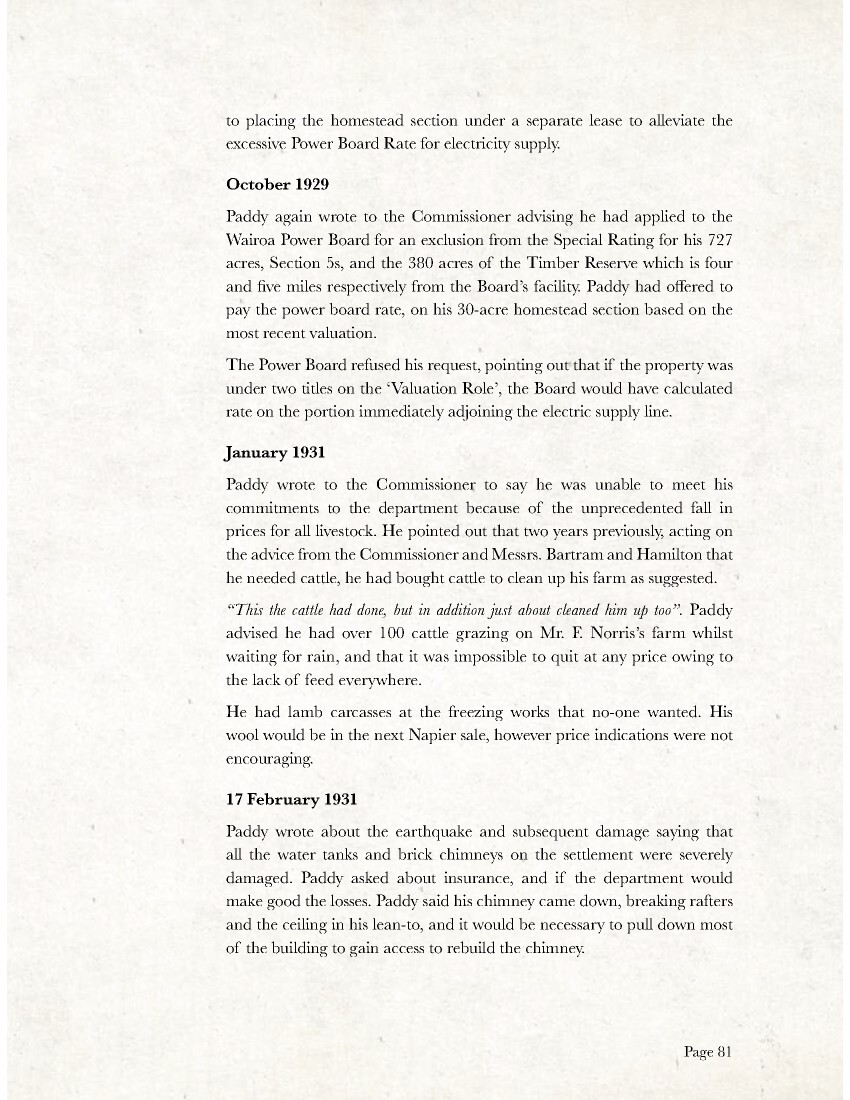
Page 82
Paddy went on to say that the settlers were particularly hard-hit with the loss of the local freezing works; saying nearly all the settlers had sheep and lamb carcasses in the freezers. About half of the Ardkeen settlers owned shares in the works, and it is possible they had lost heavily.
Paddy speculated that some settlers were contemplating turning their surplus store-stock out onto the road as the cheapest means of getting rid of them. They needed to save grass to feed their breeding ewes over the winter. 32
Paddy O’Kane was appointed to the Land Board in the 1930s. The first Labour government appointed Patrick O’Kane to the New Zealand Legislative Council where he served until the council was disbanded in 1951.
Paddy O’Kane sold both his farm, 1,107 acres and the 30 acres homestead section to John Allenby (Jack) Little, a WW2 returned serviceman, and his wife Joan in 1951.
O’Kane Ware [Whare]
32 Paddy became the unofficial spokesperson for the settlers.
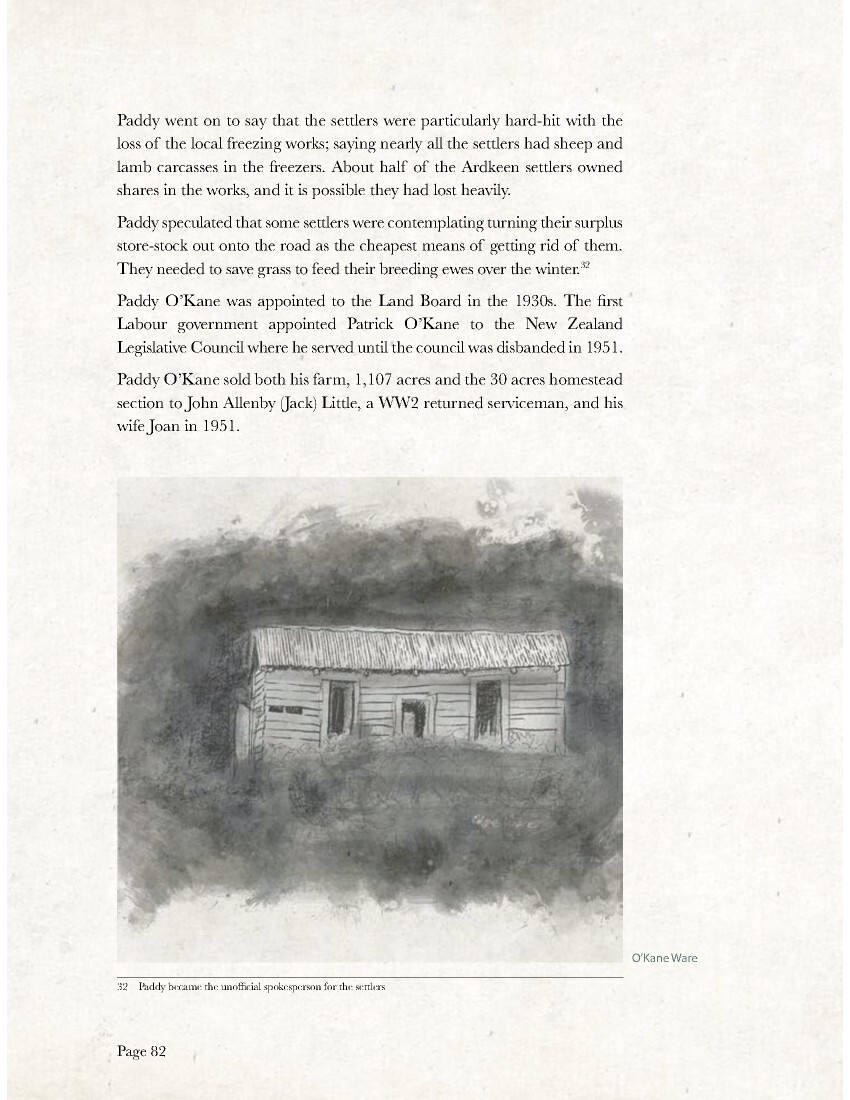
Page 83
RECENT HISTORY
Jack’s son Robert Little and his wife Wendy bought the neighbouring 340 acres; (Pt. Section 10s MacKay), that Ossie Birrell was allotted in 1928, from Chris and Tabby Thomsen in 1987 and Rob Little purchased a half share of his parents’ farm forming a partnership.
In 1992, Rob and Wendy Little sold the MacKay block to David and Julie Collier. Then bought a half share of parents Jack and Joan’s Section 5s. Jack and Joan retained the homestead section on Lake Road.
In 1995, Rob and Wendy bought the McKay block back from David and Julie Collier. They sold the Bush Block to Riverina Station, this being the Harbour Board Lease Block of 380 acres that had been granted to Paddy O’Kane in 1928; the land had not been part of Ardkeen Station.
In 2002, Rob and Wendy sold the combined blocks (1,062 acres) to Neil Lunt. Lunt leased the farm to Bill Jerram, before selling to Andrew and Caroline Holden in 2005.
In 2016 Andrew and Caroline sold to the Swann family.
In 2015 Joan Little, Jack’s widow sold the Homestead Section of 5s to Martin Wolters and his partner Sonya Smith.
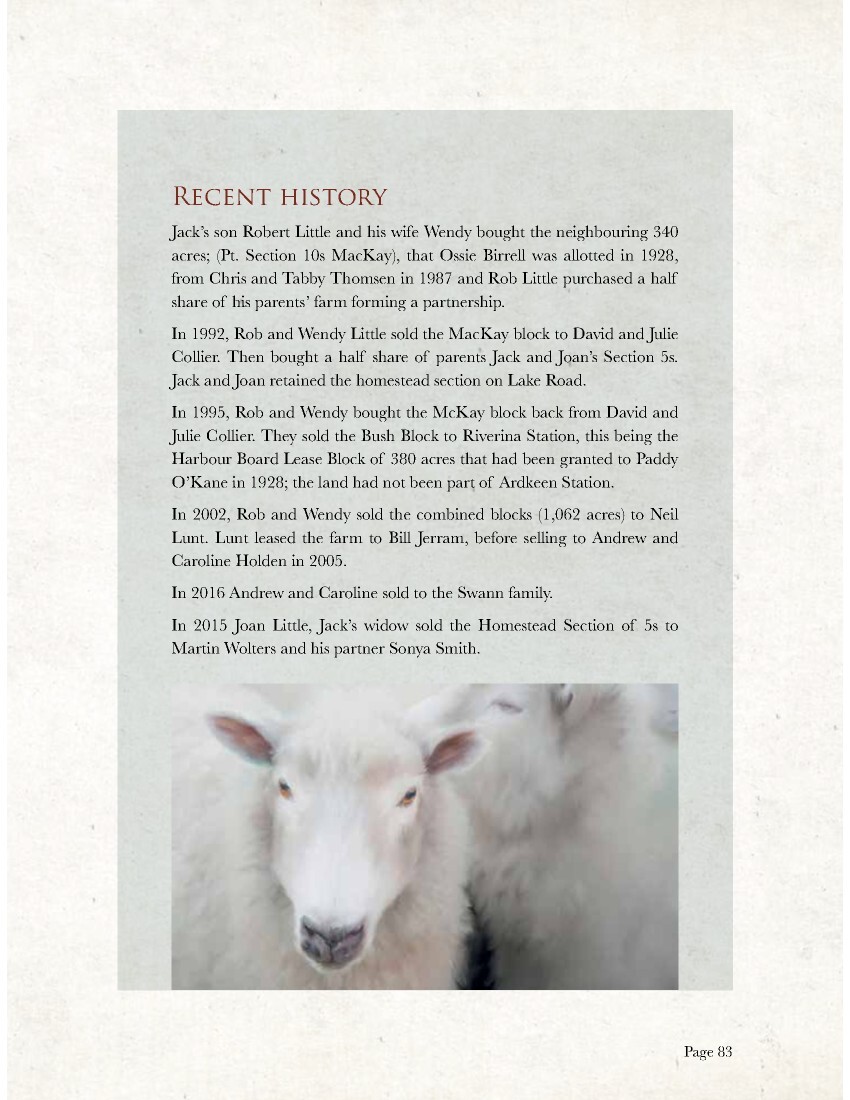
Page 84
CRANWORTH FRANKLYN JACKSON
MILITARY SUMMARY
Date of Birth: 11 November 1878
Place of Birth: Christchurch
Parents: Goddard and Penelope Jackson née Franklin
Last NZ Address: Wairoa
Marital Status: Single
Occupation: Manager
Employer: Hislop’s Waihi sheep station, Wairoa
Death: 28 December 1933
Buried: Wairoa Cemetery
Awards: British War Medal, Victory Medal and twice mentioned in dispatches. (mid) Service Boer War 1900-1902
1900
14 Mar: Enlisted at Wellington for service in Boer [South African] War with 4th Contingent as Private No. 1336.
1901
11 Aug: Discharged on completion of service
Service abroad: 1 year 19 days
1902
06 Jan: Enlisted at Wellington for service in Boer War – Regiment as Sergeant No.5019 01 Feb: Departed from Auckland on board SS Surrey
15 Mar: Disembarked Durban
05 Jul: Embarked from South Africa 02 Aug: Arrived at Wellington
Awards Boer War: Queen South Africa, Cape Colony clasp, Transvaal clasp, Rhodesia clasp. Service World War One 1917 – 1919
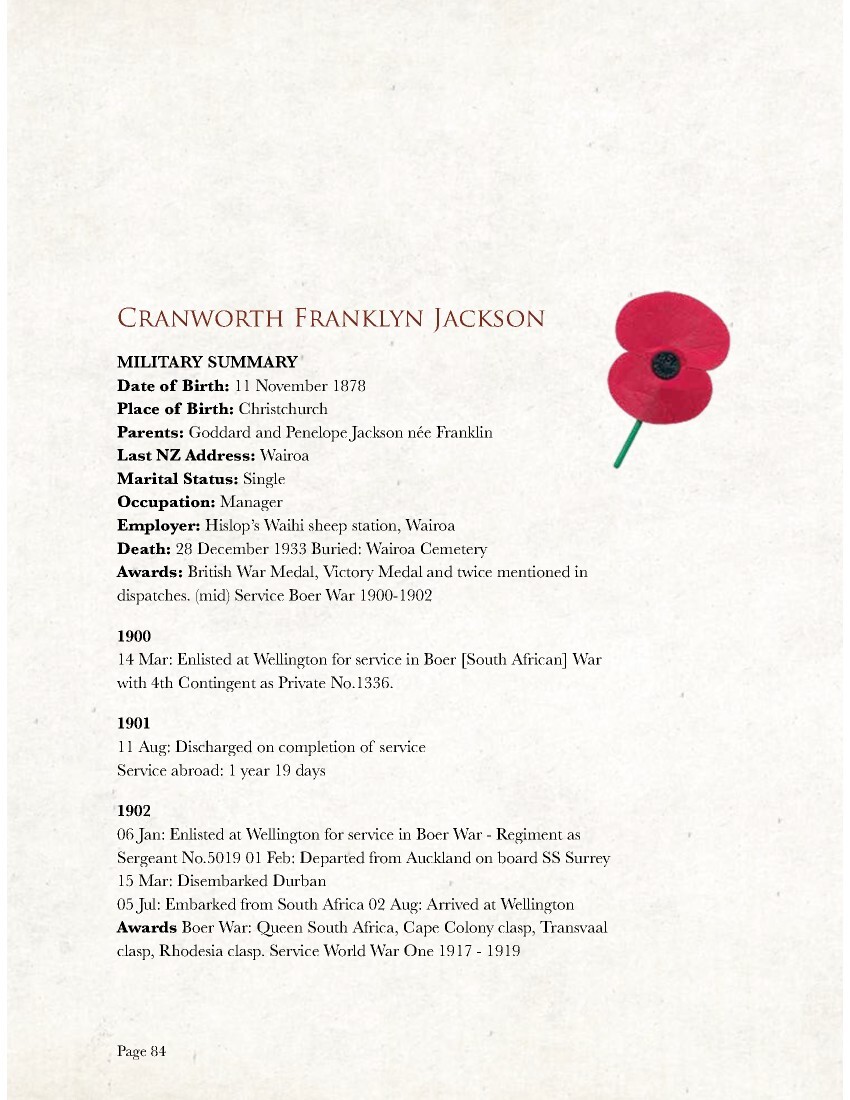
Page 85
1915
October – sailed for London privately.
1916
24 Jan: Entered Inns of Court Officers Training Corps (Territorial Force) 03 Mar: Franklin Cranworth Jackson of 39 Inverness Terrace, Hyde Park in the County of Middlesex and Private No. 1019 in the Inns of Court Officers Training Corps do solemnly and sincerely declare as follows: I am the first child of the marriage of Goddard Jackson and Penelope Jackson (formerly Franklin) his wife. I was born in the eleventh day of November one thousand eight hundred and eighty-one at North Belt, Christchurch, NZ. And I make this solemn declaration conscientiously believing the same to be true. Declared at 9 New Square, Lincoln’s Inn in the County of London this 3rd day of March 1916.
Signed C F Jackson
Jul: Promoted to 2nd Lieutenant Royal 1st Devon Yeomanry (Territorial Force) 18 Aug: Transferred to 11th Battalion, London Regiment (Territorial Force)
1917
24 Dec: Mentioned in Dispatches London Gazette 24 December 1917 page 13476
1918
01 Jan: Promoted to Lieutenant
08 Mar: Promoted to Captain until 2 February 1919
30 Dec: Mentioned in Dispatches London Gazette 30 December 1918
1919
28 June: Discharged
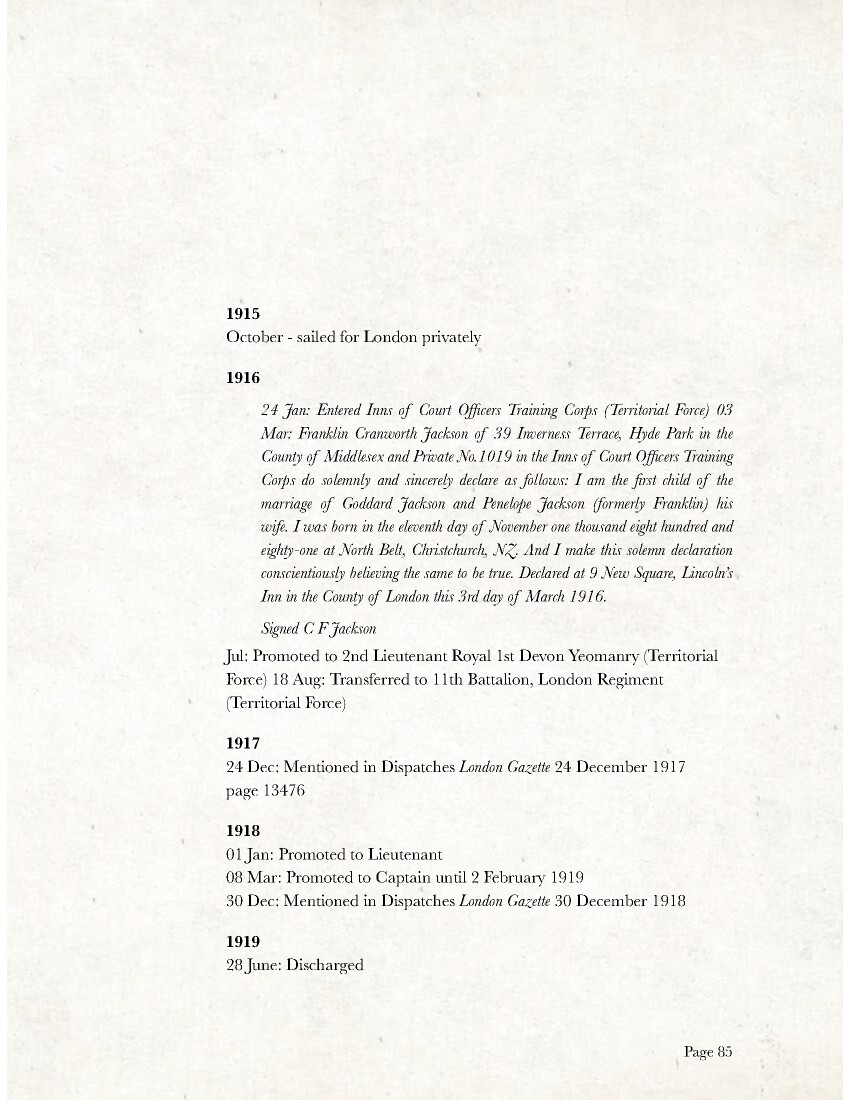
Page 86
1921
30 Sep: Relinquished commission under AO 166/21 as amended by AO332/21 and granted the rank of Captain Cranworth Franklyn Jackson, farm manager Waihi Station, Wairoa paid his own way to England to serve with the imperial forces.
Having had considerable fighting experience in the South African Boer War, he was promoted to Captain of the 11th Battalion, London Regiment – and served on the Western Front.
Sometime during the war, Cranworth souvenired the prestigious ceremonial drum major’s mace of The Queen’s (Royal West Surrey) Regiment, apparently ‘lost’ during the first battles of the Somme, 1916.
Back in Wairoa this “good fighting man” farmed at Ardkeen Soldiers Settlement. His precious war trophy was returned to its rightful regiment after his in 1933 death.
In 1900 Cranworth Jackson had enlisted at Wellington for service in the South African War with the 4th Contingent as Private No. 1336.
The 19-year-old was then farming near Johnsonville, he had eight months’ training with the Wellington Guards.
Cranworth served in Cape Colony, Transvaal and Rhodesia with these mounted men, The Rough Riders. They had several very successful engagements with the enemy; the Boers.
In August 1901 he was discharged on the completion of one year nineteen days’ service before returning to New Zealand.
T: 8th Contingent on S.S. Surrey to South Africa. 1902. (Internet)
Early 1902, Cranworth enlisted again with the 8th Contingent as Sergeant No. 5019.
More than 4,000 men had applied to join this contingent, one thousand were selected. He impressed as “a good fighting man.”
Cranworth Jackson treasured this solid-silver match lighter souvenir of his voyage on RMS Medina. In December 1915 Cranworth and his relative Charles Bayly arrived in London, determined to obtain officers’ commissions. They’d paid their own way on the Peninsular and Oriental Steam Navigation Company ship, Medina.
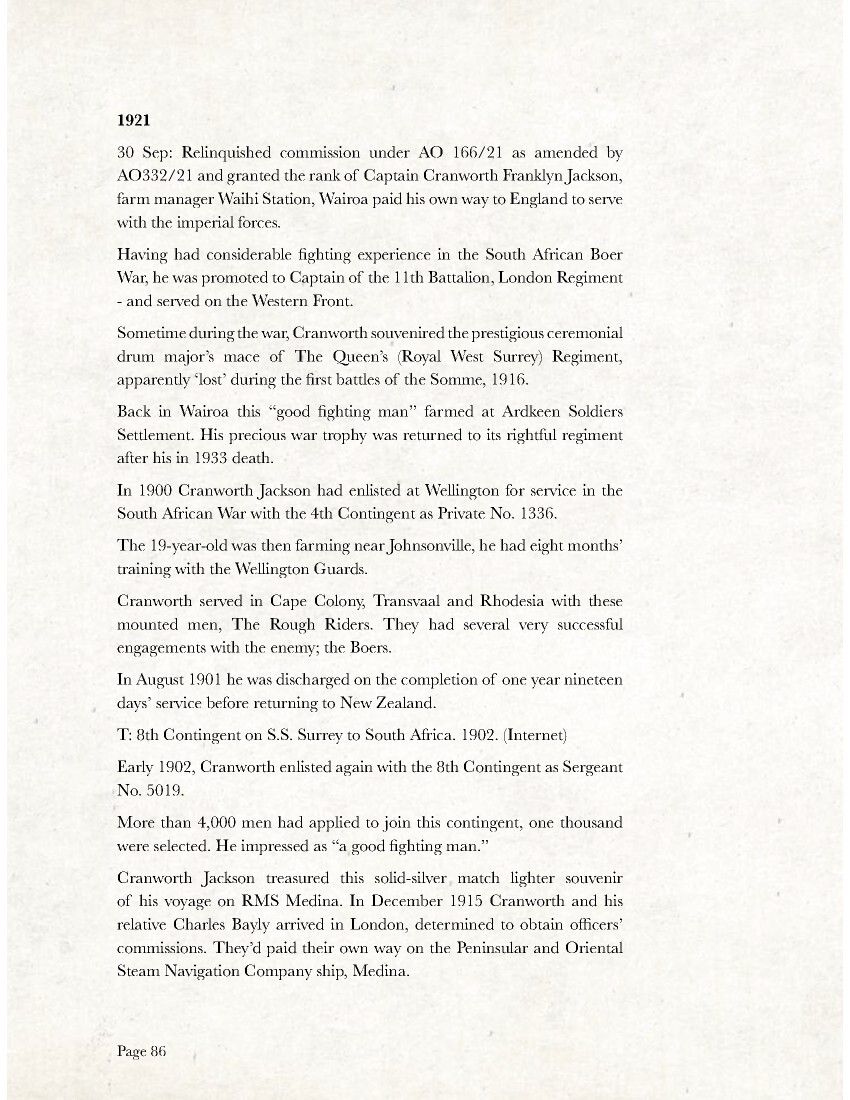
Page 87
Along with 245 passengers from New Zealand, Australia, India and China, they had sailed through the Suez Canal and across the Mediterranean Sea, with no warship accompaniment.
The Medina was a four-year-old Royal Yacht. Two years later she was torpedoed by a German U-Boat (submarine) and sunk off the coast of Devon, England.
24 January 1916, Cranworth entered The Inns of Court Officers Training Corps (Territorial Force) 6th Squadron (as Cadet No. 9109) London. He had known Finsbury Rifle Volunteers during his two stints in South African War. He was 37 years old, 6 feet tall, brave and ambitious – with a colourful family.
Cranworth honed skills at map reading, drill, musketry and entrenching field exercises in open warfare and lectures.
He was posted as 2nd Lieutenant of the Royal 1st Devon Yeomanry (Territorial Force) soon transferring to the 2/11th (County of London) Battalion, The London Regiment (Finsbury Rifles) in August 1916.
Members of the ‘Inns of Court’, the association for barristers in London, have been fighting wars since the 1300s. In 1908, The Inns of Court Officers Training Corps (Territorial Force) was formed after the outbreak of war in 1914, became responsible for training 13,800 men as officers. Around 12,000 were then commissioned to regiments – 5,000 of these were wounded and 2,100 were killed, a casualty rate far higher than for the army as a whole.
The Evening Post 1919 wrote that Cranworth was “one of the few members of this regiment who survived particularly hard fighting. He was next attached to the 10th London Regiment with which unit he served until the armistice.”
Cranworth was promoted in the field March 1918 by Lieutenant Colonel Symons, Commander of the 47th Division, later killed at Villers Bretonneux. Except for six weeks’ leave, Cranworth was with his unit for three years “being fortunate in suffering only a slight wound in the head, and a gas attack.” (Evening Post, Wellington 30 June 1919).
Cranworth Jackson was Mentioned in Dispatches twice for work in the field, receiving a certificate and a bronze spray of oak leaves on his Victory medal ribbon. (24 12.1917, 30.12.1918 London Gazette)
Cranworth’s division was composed of men specially selected for carrying

Page 88
out counter-attacks. The gains made were decisive. His many engagements in France and Flanders included Arras, Lagnicourt, Bullecourt, Havrincourt, Ypres, St. Quentin, defense of Amiens, Albert, Somme, Peronne, Lens, Annay, Nomain, Fort Maulde, and the advance on Mons. (Evening Post 30 June 1919).
The 100 Days Offensive he took part in was an impressive feat leading to the Allied victory. He held his rank of Captain until March 1919.
He relinquished his commission and was granted the rank of Captain in the London Gazette April 1921. This meant as a civilian, he could use the rank if he wished.
Left and right: Image of Cranworth Jackson’s homestead

Page 90
LAND BALLOT
Ardkeen Section 6s, 617 acres
Ballot awarded to: Cranworth Jackson
Captain Jackson, a souvenir collector, is remembered for the German Imperial War Helmet that he often wore. It’s not known what happened to this WW1 pickelhaube. It’s a mystery how or why Cranworth possessed this item. After his death the drum major’s staff of The Queen’s (Royal West Surrey) Regiment was handed to the British High Commission in Wellington by Jackson’s brother-in-law Mr Watson. The Mace was placed on board H. M. Yacht Britannia during the Queen Mother’s visit in 1966. It is now displayed in the Queen’s (Royal West Surrey) Regiment Museum in Clandon, Surrey. 33
His second wife’s family remember him for his persuasive personality and ability to talk anybody into anything.
Cranworth Jackson had a life-long experience of farming around Wairoa, when not fighting wars. He was aged 42 years when he arrived at Ardkeen. His section was a four-mile horse ride but nine miles by road from the homestead block on the Waikaremoana Road. It was to be 26 years before the property gained road access.
August 1921
Cranworth applied for £1,000 to build a house, only to be advised the maximum funds available were £350. However, he built a bungalow cottage containing four bedrooms, bathroom, portico, a double brick chimney with a wood-range, hot and cold water included, and he insured it for £600 and called it Clandon.
October 1922
Cranworth’s first wife Florence Orbell died after a year of marriage in this new home, the first built on the new settlement.
33 Clandon was largely destroyed by fire in April 2015 ref: Sarah Millard
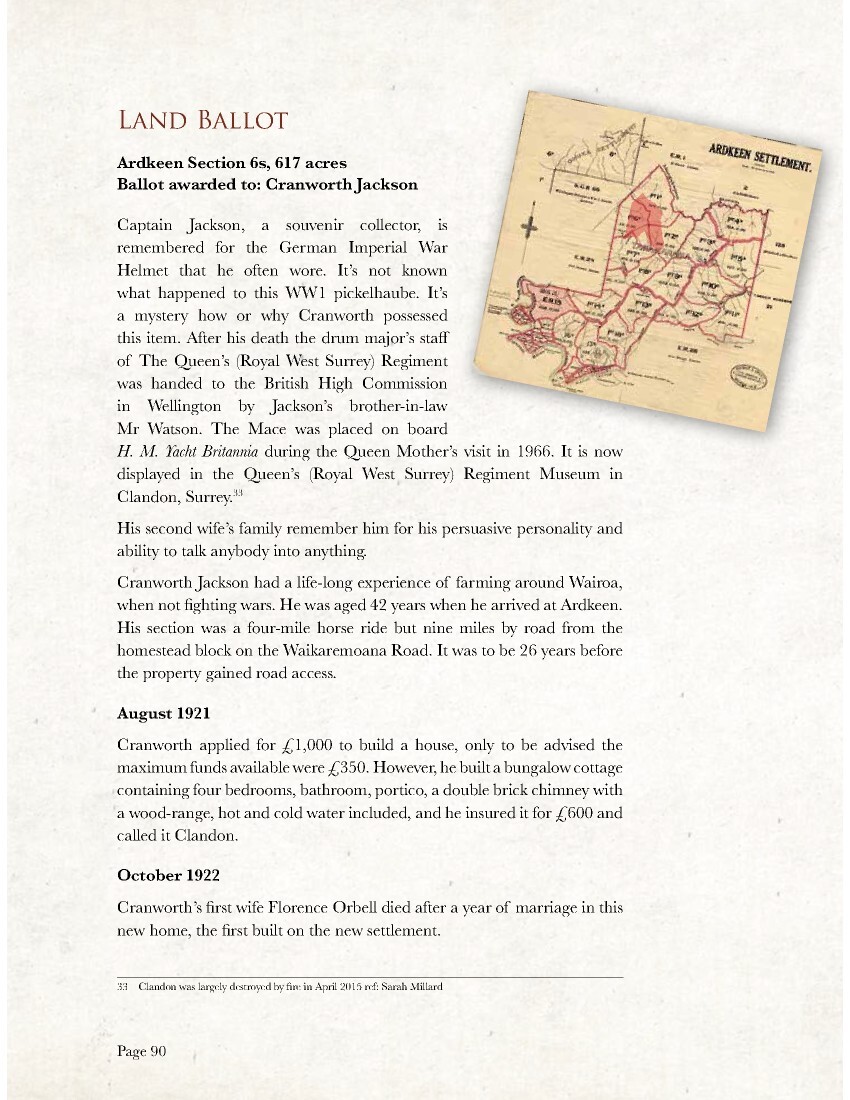
Page 91
February 1924
The Land Board advised Cranworth they were concerned about the rent he owed. Jackson replied that expenses relating to his wife’s death and the cost of marrying again had been considerable. He said, if he had to surrender the section, the government would get back an improved farm.
May 1924
The Commissioner advised Jackson; the Board would recommend forfeiture. A memo described the farm as average, the farmer as a capable man and the stock in good order.
Jackson wrote to the Revaluation Board, Wellington that he could not understand the high value placed on his farm, saying the property was the second poorest on the settlement.
June 1924
Percy Matson, Cranworth’s neighbour, offered £1,000 for the farm. The Board thought Matson had enough land. Matson had married and was living in Jackson’s house at the time.
Matson said his farm would not provide a living without more land.
Jackson wished to leave the farm because it was too small, and the loss of his wife coupled with £1,000 of medical expenses relating to her illness.
An internal memo noted Jackson and Matson were the two most unsatisfactory settlers on the settlement. Both were using farm income to reduce their overdrafts with Dalgety’s, who held the stock mortgage, and they were not paying the rent.
Jackson owed Dalgety’s £1,500, more than the value of the stock they held as security, making it unlikely Dalgety’s would pay rental arrears.
Jackson always struggled to pay his rent; the Board had recommended forfeiture. Mr. Robertson the Ranger indicated Jackson was not carrying the stock he claimed.
September 1927
Jackson wrote to the Commissioner of his dismay at having read in the Poverty Bay Herald that his farm had been forfeited. He pointed out he had worked for seven years on Ardkeen, and spent seven years fighting for his
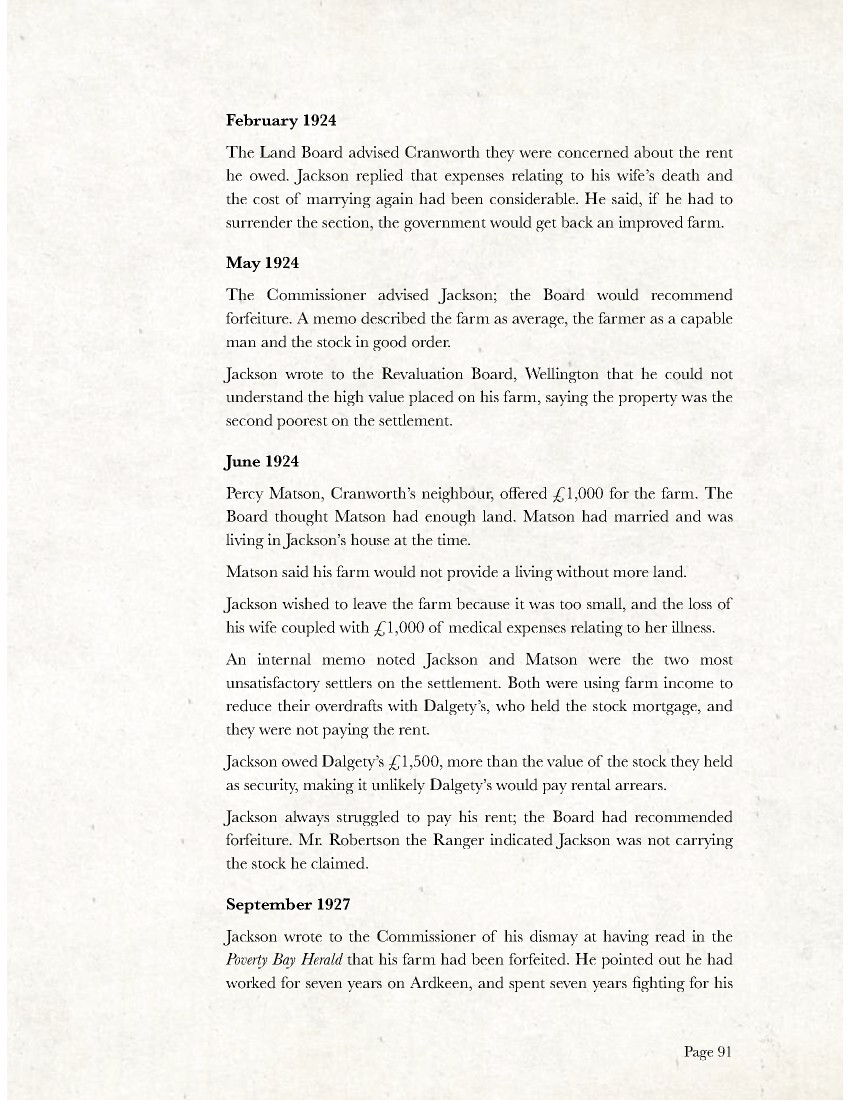
Page 92
country, and felt distressed with the situation.
Jackson wrote then to the Hon. Hawkins that he had read in the Gisborne newspaper his farm had been forfeited and appealed for help. Hon. Hawkins replied that the Commissioner of Crown Lands had received instruction there would be no forfeiture of Mr Jackson’s or any other settler farms on Ardkeen.
November 1928
The Government and Land & Survey saw their relationship with the settlers on an individual basis; the RSA considered that the soldier settlers, particularly those on larger settlements should be treated as a group irrespective of capital, experience, or the land quality. This made effective administration difficult and placed the land boards in a quandary as to how to deal with individuals on settlements.
Marsh noted that increased current-account finance worked in assisting soldiers who had shown promise, but who were temporarily struggling. But he warned, if those who were well on their feet received assistance there would be an outcry from the struggling and until the settler had shown great determination to set type, and battle through, it would be unwise to listen to their first cries. Marsh claimed that to increase the material comfort of a soldier would reduce the amount available to purchase stock, and so undermine the capacity to meet his commitments to the Crown. Marsh claimed that the man with the minimum house and the maximum stock would come out on top. 34
Jackson learned Matson’s back section 1s was available, if he surrendered 135 acres of terrace country that fitted into to his neighbour, Jim McLean’s farm, section 7s.
February 1930
Jackson wrote to the Commissioner that Mr. Humphry Bayly, an established farmer would finance the stocking of the recently acquired Matson’s farm. However, after the earthquake, Jackson was no longer sure.
Jackson told the Commissioner Dalgety’s would not provide money to buy livestock for the land allotted him. Mr Tom Davey had been grazing 1,000 wethers on the section. However, he was experiencing hardship through the depression and earthquake, and he had taken the sheep away. 34
34 Gould, A. N. (1992) Proof of Gratitude, p. 237.
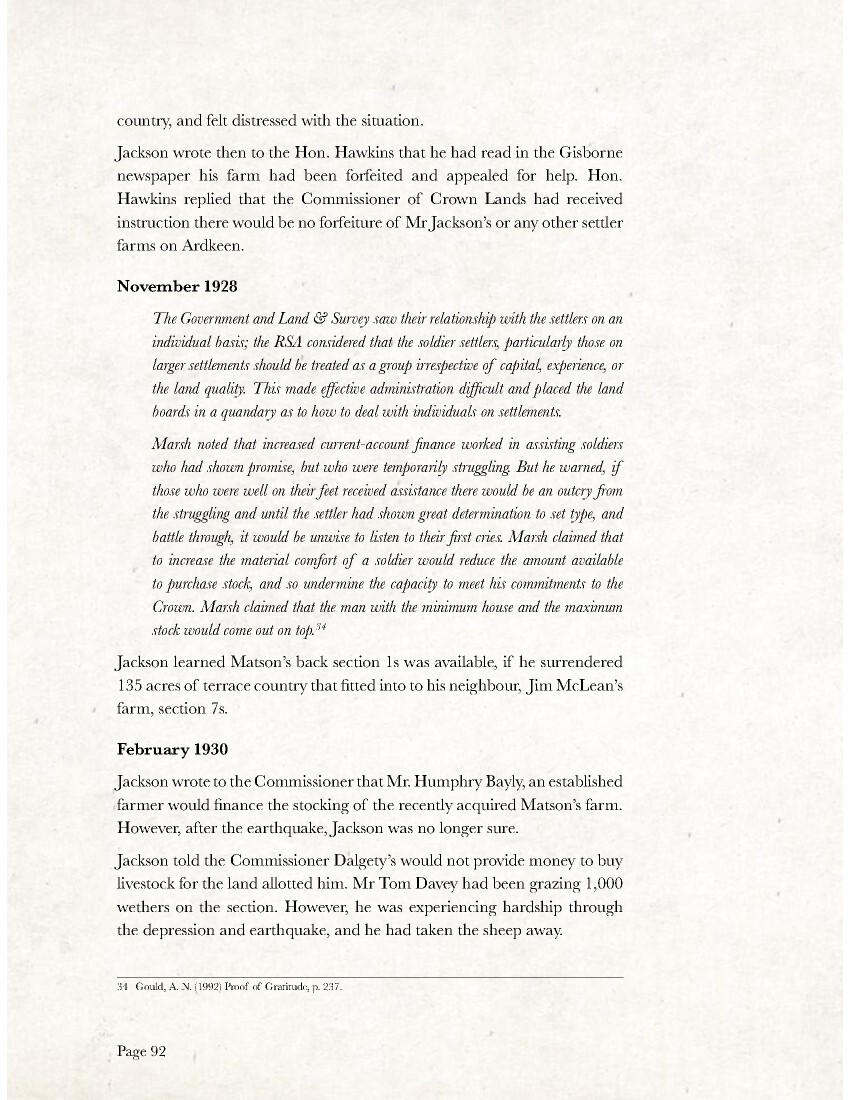
Page 93
Jackson felt Joe Anderson, manager at Dalgety’s had been against him after the allotment of Matson’s farm. His farm was carrying only 900 ewes, 800 dry sheep and 200 cattle. Field Officer Robertson believed the farm could carry 1,200 ewes, 800 dry sheep and 200 cattle, however Jackson disagreed, arguing that on 1,206 acres, including 46 acres of the homestead section, he could carry 1,600 sheep total plus 200 cattle, and fatten the lambs, saying the land was too light for a higher stocking rate. He pointed out that when Ardkeen was surveyed for resettlement, the previous owner, Magnus Nilsson, advised ‘the country would carry one sheep to the acre’. Furthermore, expressing the view it was best not to kill off the English grasses with overgrazing.
An alternative view in support of the role of the stock firms during this period was provided by A. W. Jameson, the retiring chairman of the Canterbury District Repatriation Board. He observed that the firms were a crucial agent in the soldier settlement scheme because of the limited amount of government capital available to the soldiers. He noted that when the depression arrived and things got tough, ‘the firms stuck to the men and avoided untold loss to the Government, men, and themselves’. 35
November 1931
Margaret Jackson wrote about an unsatisfactory discussion with Mr. Anderson of Dalgety’s relating to a ‘Pooling Scheme’ that shared the revenue from the farm with the Land Board, stressing the rent was too expensive at 8/- per acre.
Office note; the farm being so far from the Homestead was a handicap; requiring a week to drove the sheep to the woolshed for shearing and return them. There were no holding paddocks at the woolshed, the sheep had nothing to eat for the duration, and the drove was long and up a steep, dusty track with little water. This was a great hardship on man, dogs and hungry sheep.
Margaret wrote to H. M. Campbell Esq. January 1932 enclosing a copy of a letter ‘Of Forfeiture’, received the previous week appealing for help. The previous month, the Commissioner had threatened forfeiture unless a satisfactory proposal for the payment of overdue rent was offered.
35 Gould, A. N. (1992) Proof of Gratitude, p. 237.
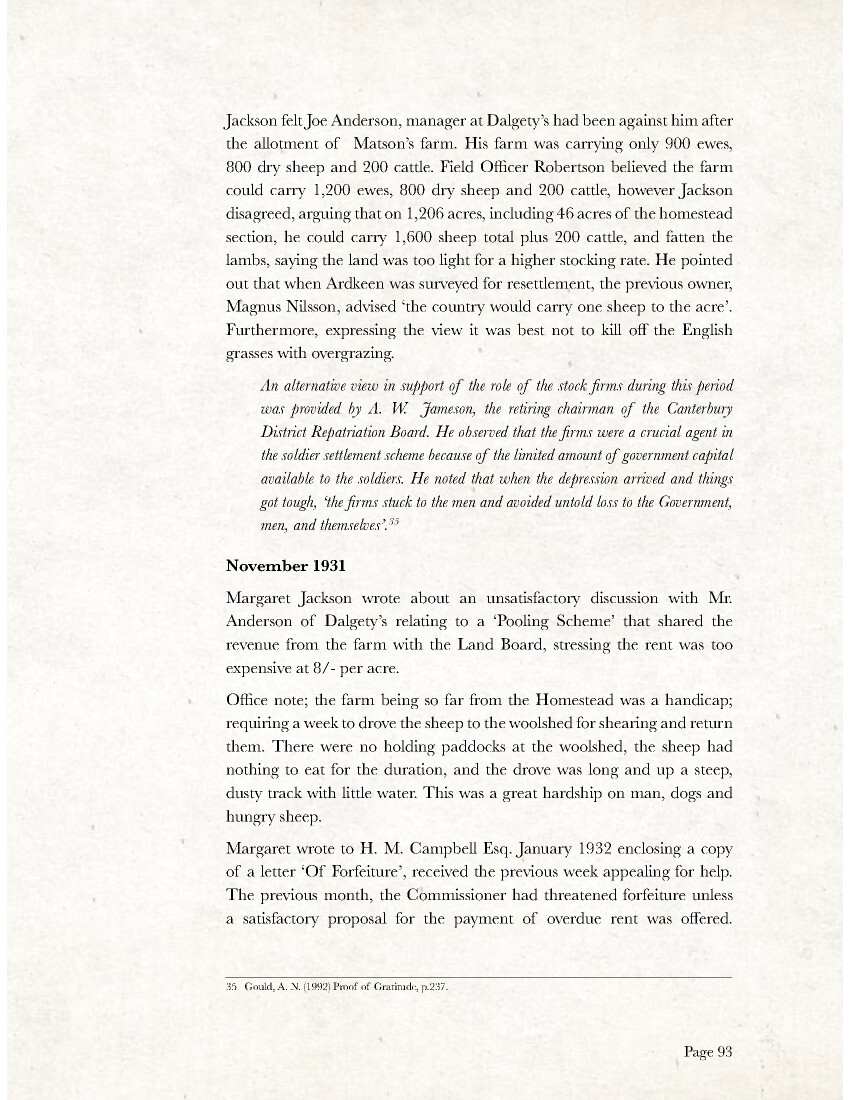
Page 94
At a meeting with the Land Board in Gisborne, she told the Commissioner about an offer of 1,000 good breeding ewes. If she could buy these sheep, this would enable the Jacksons to sell the surplus stock as fats. However, with the market being in such a depressed state, she was unable to sell and could not promise any rent payments at the time.
The Jacksons had taken up the Matson section 1s in 1930; since then, stock values had fallen further. The Land Board had granted them 724 acres; three hundred acres had reverted to scrub, growing above the horses’ back. This had been cleared and re-grassed. The rest of the farm had scattered scrub that was now cleared. Fences were down and they were still repairing them. On top of all this, there had been two dry seasons.
Before taking over the Matson property, Jackson had surrendered the best portion of the farm. The Commissioner promised compensation through a rent reduction for this portion but this had not happened. When taking up the additional area in March 1930, he paid arrears to the Land Board of £538.
The Jacksons argued the Crown had 2,000 acres adjoining, now vacant land and reverted to scrub. Mr. Somerville of Ohuka had held a temporary lease. The Commissioner of Crown Lands, and Mr. Nolan from the Land Board, had offered to lease the land to him. Mr. Somerville had offered £5 a year for the entire block of land. The Commissioner said he would submit the offer to Wellington.
Another section known as Cooper and Smith, had been forfeited, some 1,800 acres. The Land Board tried to dispose of this property at a small cost without success. This section also adjoins their property.
Jackson told the Board that part of the Matson’s Section was similar to these properties when he took possession. Today the land is in ‘apple pie order’. Jackson argued the rent was too high and deserved consideration and, there was no possibility of road access to his farm despite a two-hour horse ride to the farm in summer, and three hours in the winter.
Jackson suggested that if he were to leave, he would lose everything. Saying:
“I have put 12 years in here. I enclose references for your information; I have done my best on the land and at war.”
The Honourable H. M. Campbell wrote to the Under-Secretary for Lands expressing the view that displacing Jackson meant the department would
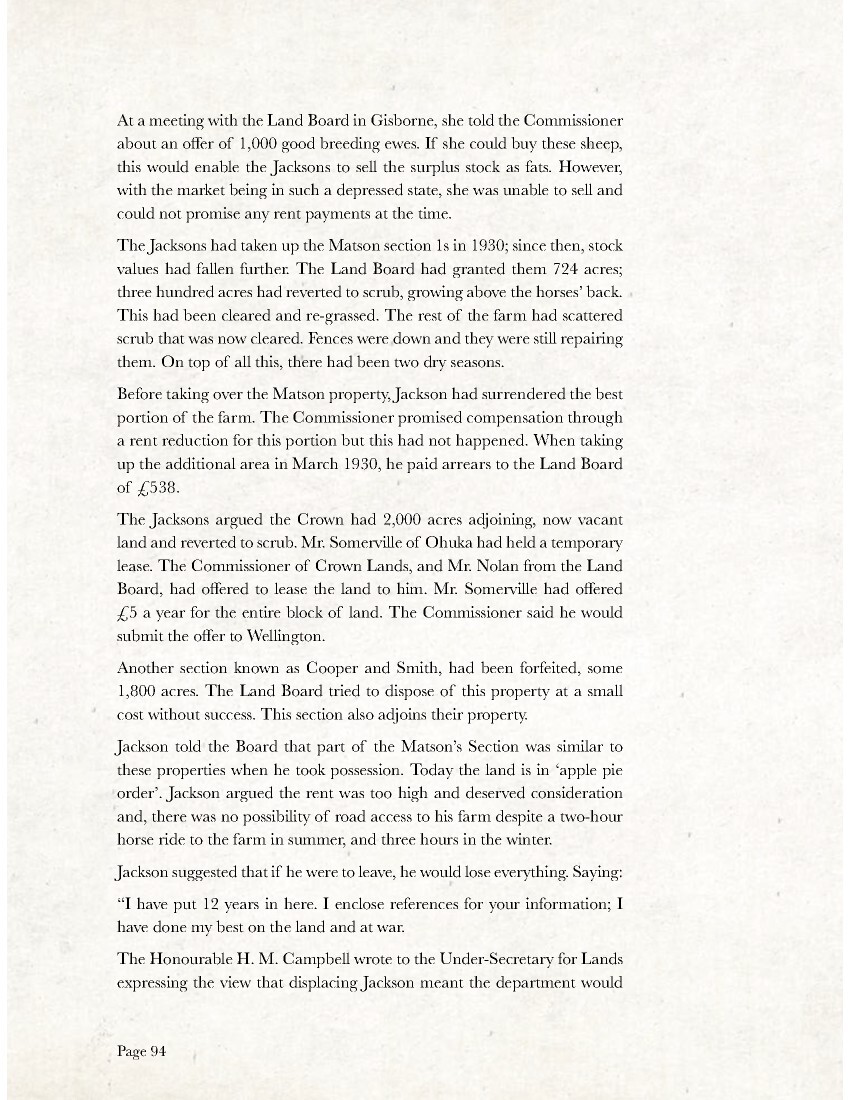
Page 95
have to write off the arrears. Campbell also said a new lessee would be offered concessions, and suggesting those concessions be offered to Jackson.
Since writing, Humphry Bayly had indicated he would not re-stock Jackson’s property at the current rental, however if Jackson got a rent reduction, he might reconsider.
Any question of reduction of rent would impact on values for the whole Ardkeen settlement.
April 1932
A letter from the Commissioner to Dalgety’s Head Office, Wellington, prompted the Under-Secretary for Lands to re-consider non-payment of rent in cases where settlers’ livestock was under security to stock firms.
Jackson owed £700 rent in arrears; the Board recommended the lease be forfeited because Dalgety’s Wairoa would not pay the rent arrears. The Under-Secretary responded it would be in the firm’s best interest to allow Jackson to remain on his property. Mr. Jackson advised Dalgety’s Wairoa he had contacted the Minister for Lands through the local Member of Parliament.
The Superintendent advised that Jackson’s affairs were in a deplorable state through current market conditions, compounded by an adverse season resulting in livestock losses. However, they continued providing Mr. Jackson with money for working and personal expenditure.
28 December 1933
Obituary Captain C. F. Jackson
After having been ill for some considerable time there passed away a well known Settler of Ardkeen Settlement, in the person of Capt. Cranworth Franklyn Jackson whose demise occurred at the Wairoa Hospital today morning, aged 54 years.
Deceased was born at Wellington and was the eldest son of late Mr and Mrs Jackson of Wellington. He spent his early life farming in Taranaki. On the outbreak of the Boer War, he joined the 4th and 8th contingents and saw a fair amount of service in Africa. On Capt. Jackson’s return to New Zealand, he resumed farming pursuits in Wairoa and Gisborne districts, acting as manager for Mr Hyslop on his Waihi Station.
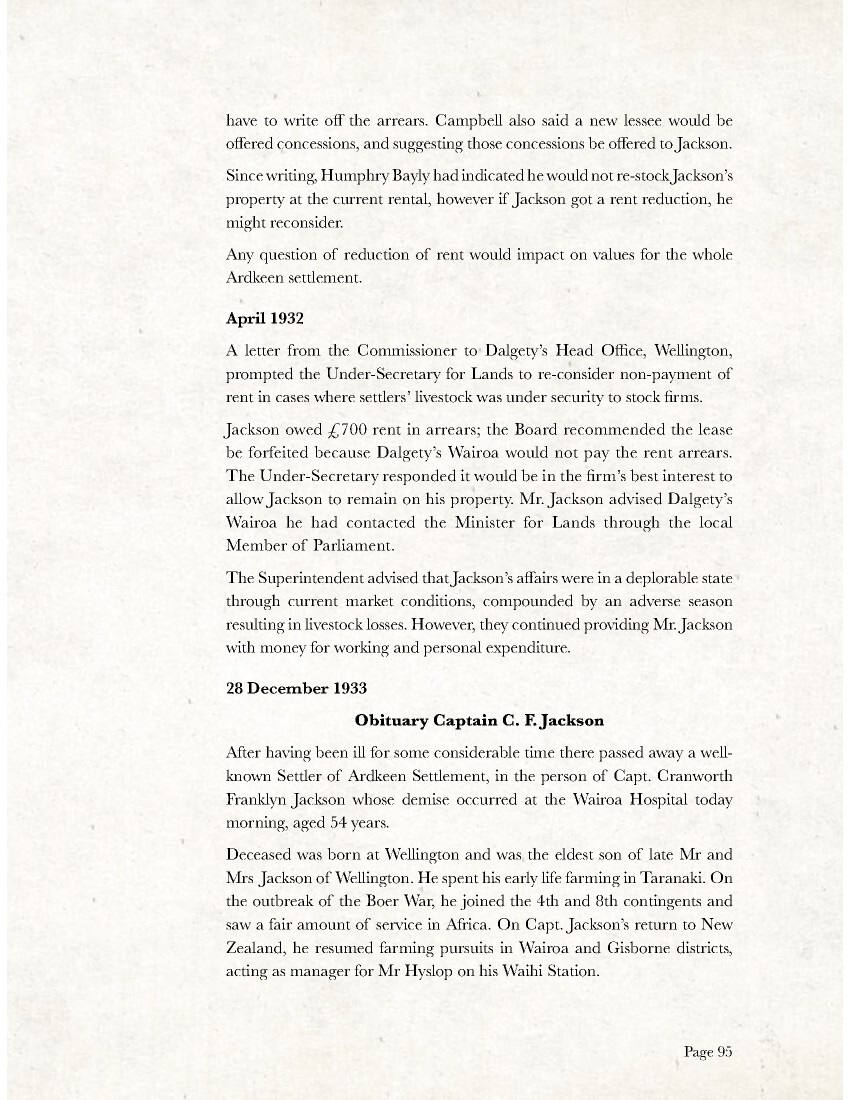
Page 96
The late Capt. Jackson had an excellent War service record and one which few New Zealanders could rival. 1915, in Company with Mr Charles Bayly the well-known representative footballer Cran Jackson proceeded to England in their enlisted, After a term in the officers training course, he was granted a Commission and drafted to the Royal Devon Yeomanry. He later transferred to the 11th London Regiment and one of the few survivors with whom he served until the Armistice of that region. Capt. Jackson was next attached to the 10th London Regiment; He received promotion on the field from Lt. Col. Symons.
Capt. Jackson was mentioned in dispatches on 3 occasions for exemplary work on the field, and except for 6 weeks on leave saw continuous service. During the war, he was once wounded and gassed, and there is no doubt that his excellent war experience must have hastened his end.
The division to which he was attached was composed of men especially for the carrying out of counter-attacks.
Capt. Jackson fought at Arras, Lagnicourt, Bullecourt, Havringcourt, Ypres, St. Quentin, Amiens, Albert, the Somme, Peronne, Lens, Arthnay, Nomain, Fort Mould and on the final advance on Mons.
When demobilisation took place, Captain Jackson took up a section of land in the Ardkeen settlement which he farmed right up to the time of his death.
Deceased was a keen sportsman and particularly interested in boxing and horses. He won quite several events in jumping and the show ring.
He leaves a widow. Mrs Margaret Jackson two sisters (Mrs Fortune of Paraparaumu and Miss Jackson at present in England), and one brother Mr Gothard Jackson of Hamilton, to whom he tended the sympathy of a large circle of friends in the district in their bereavement.
The funeral takes place tomorrow afternoon at the local cemetery. Returned Soldiers are invited to be at St Paul’s Church at 2.30 to participate in the funeral arrangements.

Page 97
4 March 1934
Margaret Jackson writes:
Mr Jackson passed away on 28 December in Wairoa Hospital after two months of illness. He had an operation in February 1933 and did not recover. Cran picked up for a while before going slowly downhill with a long-standing granular kidney complaint that caused high blood pressure and heart troubles.
I have been trying to hold on with a Stock Firm that made things as difficult as possible for my late husband while he was ill.
They had made my life difficult as well; they are doing their best to get me to sell up by refusing to pay rent and debts. Mr Anderson of Dalgety’s advises I must take between £900 and £1,000 off the place this year.
The farm was under-stocked until this year. It is not to their credit that we are now fully stocked; prices are reasonable, and we are in a position to clear ourselves. However, Dalgety’s refuse to pay rent on my behalf, therefore, compelling the Land Board to forfeit my lease.
They refused to pay expenses relating to Cran’s illness, namely hospital and funeral expenses. I am allowed food only.
How should I deal with this predicament? Should I walk off, leaving my home, where for the past 8 years my husband and I have lived and worked?
I cleared the manuka, fences are in good order, the farm is stocked with 1800 young sheep and has 150 cattle. The young fellow looking after the place has been with us for 3 years, he is trustworthy, capable and intelligent. He has looked after the property for the past 12 months on his own. Cran did manage to go out for 2 days docking; however, that proved too much in the end.
March 1934
Solicitors O’Malley and Jones acting for Mrs. M. J. Jackson, Administrator of the Will for the late Mr. Cranworth [sic] Jackson wrote to the Commissioner of Crown Lands and advised that Mrs. Jackson wished to assume the tenancy of the farm, and that Mrs. Jackson would not have a home if compelled to sell, and she believed the farm would succeed.
The Under-Secretary for Lands wrote that he had called on Mrs. Jackson and found her eager to continue with the property, although she was unable pay the rent due. Noting that Dalgety’s held a stock mortgage and were not prepared to guarantee payment of rent.
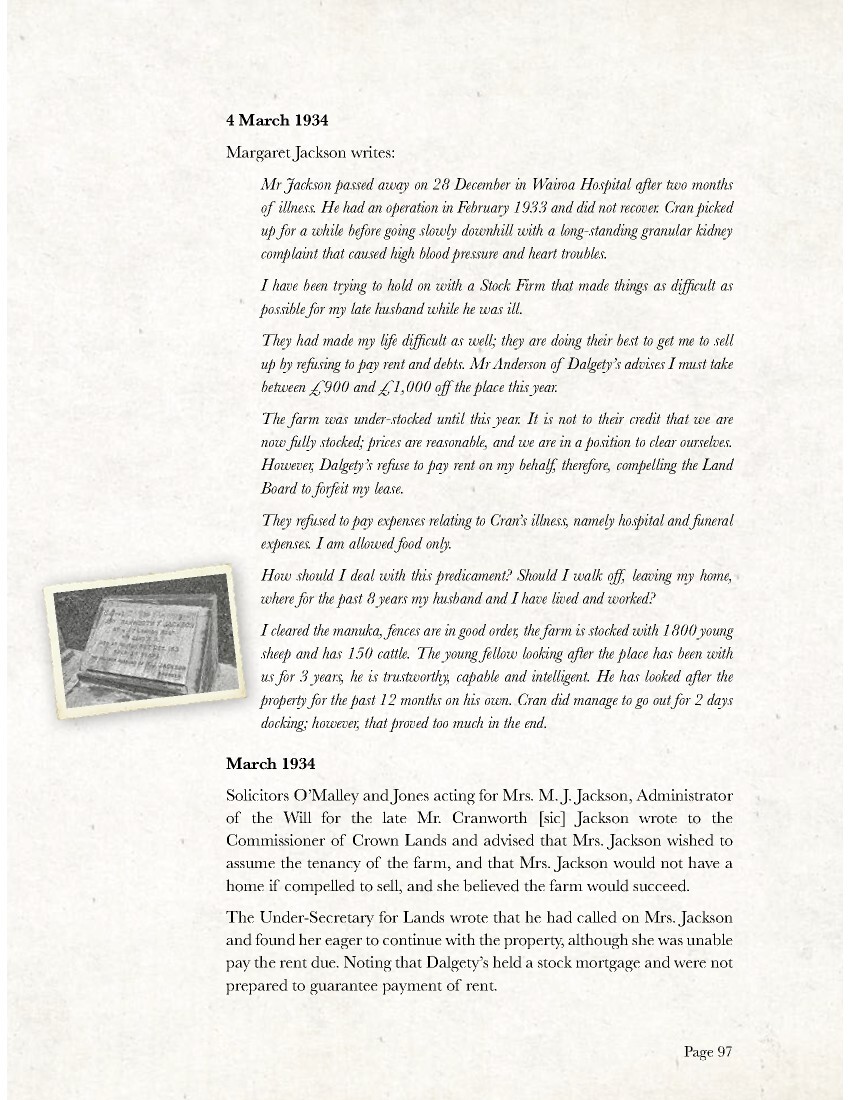
Page 98
May 1934
Dalgety’s Manager wrote to the Under-Secretary for the Department of Lands and Survey of his surprise to learn that Mrs. Jackson had been in touch with The Honourable J. G. Coates regarding her difficulties with his firm, saying he had recently approved a programme for her to continue exclusive of interest, rent and rates, the account under an ‘Income Sharing Scheme’. However Dalgety’s had refused to pay a £25 Hospital Board account, and legal costs in connection with the administration of her late husband’s estate. They had paid the funeral expenses.
May 1934
A Memorandum to Right Honourable J. G. Coates regarding Mrs. M. Jackson, from Mr. E. A. Ranson, Under-Secretary for Lands wrote about a conversation with Mr. Rogers regarding the Jackson Estate being insolvent; Mr. Roger agreed Mrs. Jackson must pay the arrears.
The Wairoa Dalgety’s manager, wrote:
Mrs Jackson is inclined to be vindictive and would go to almost any extent to retain possession of the property noting she had little prospect of making a success of the farm. Mrs. Jackson sought advice from people who agree with her, rather than explain how impossible the present position is.
“I cannot understand why Mrs. Jackson should be so contrary, we provided everything except for a £25 Wairoa Hospital Board account”.
Yours faithfully,
Superintendent Dalgety’s New Zealand
March 1935
Mrs. Jackson wrote to the Commissioner about a 1,600-gallon water tank situated in the ceiling of the wash house that had been leaking since the 1931 earthquake. Saying she needed to “wear gumboots, rainproof coat and a hat when entering the wash house.” Dalgety’s refused to pay for two new eight hundred gallon replacement tanks.
The estimated cost of a tank was £6.10; Mrs Jackson had asked Mr Anderson at Dalgety’s for money to replace the tanks repeatedly; Anderson said he would ask the plumber about the cost of a new tank.
The following Friday it rained heavily, the tank sprung several more leaks
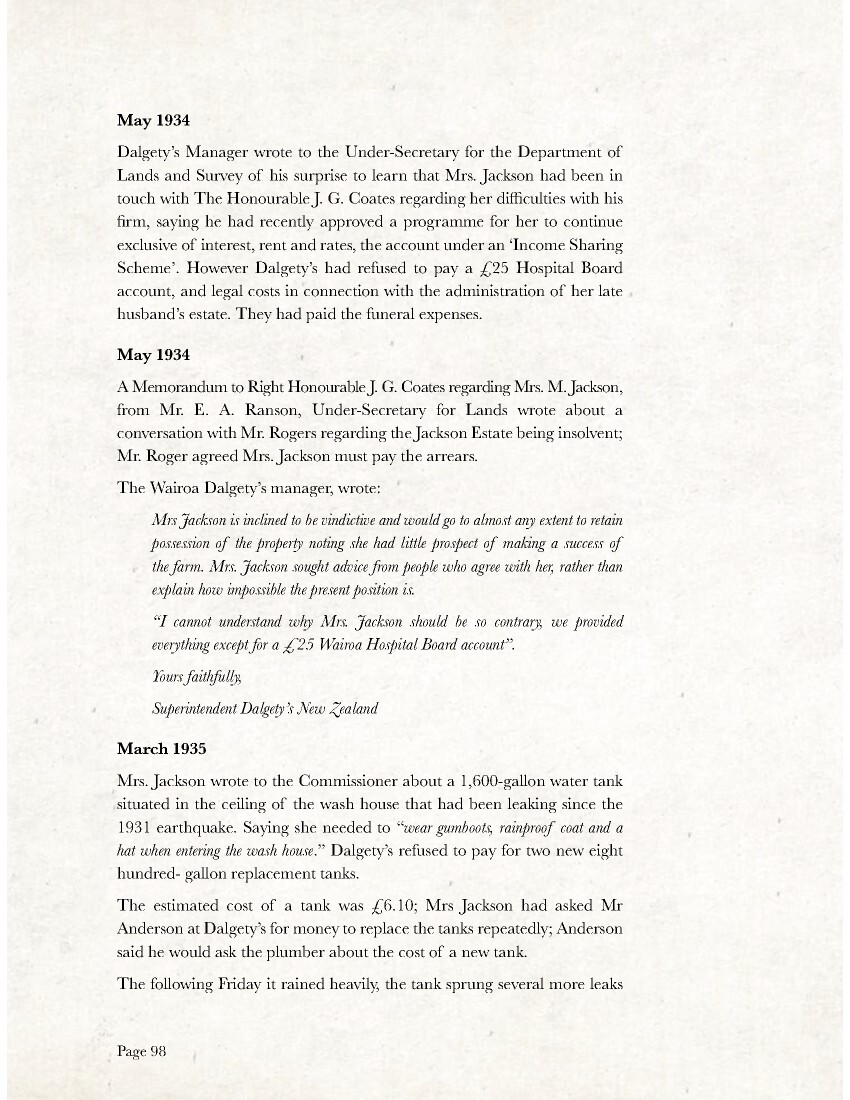
Page 99
flooding the washhouse; she had caught what water she could because they had no other supply. She again telephoned Mr. Anderson about a new tank; he refused having been at a loss for words when asked why he would not help, and he did not know what the Land Board were doing about the arrears of rent. Mrs. Jackson said she felt embarrassed and distressed; saying she was compelled to live under conditions enforced by Mr. Joe Anderson of Dalgety’s, Wairoa.
Commissioner Crown Lands internal memo noted: Tank Necessary – instruct Dalgety’s to supply a new tank.
March 1935
A memorandum for the Commissioner to Dalgety’s expressed regret to hear Dalgety’s refused to supply so necessary an item as a water tank; pointing out Dalgety’s allowed their ‘stock’, to graze on Crown Land without paying rent.
The Commissioner considered distraining against Dalgety’s livestock on the Jackson farm.
June 1935
Margaret Jackson wrote a heartfelt thank you to the Commissioner for the new tank
Pigs at Jacksons
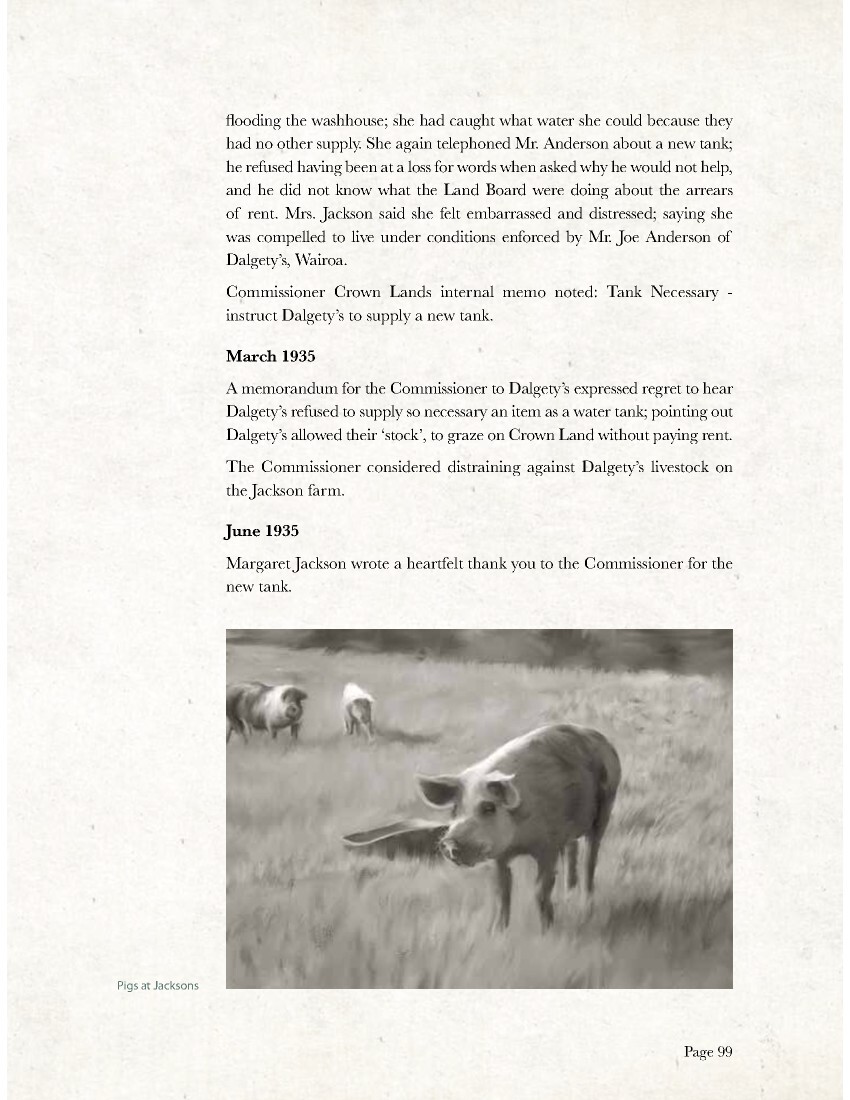
Page 100
July 1935
A Mortgage Adjustment Commission met at Wairoa. The Jackson farm rental came up for review.
The property suffered from poor access, with two portions approximately seven miles apart. The land was capable of feeding only one sheep to the acre, and one cattle beast to 5 acres. The lessee is unable to pay arrears.
Mrs Jackson asked for a rent reduction, arrears to be written off and offered an income-sharing scheme. A further request was made for an allowance of £100 per annum for Mrs Jackson, over and above living and running expenses. Several accounts were outstanding for probate and funeral expenses.
Dalgety’s counsel agreed the farm had been well-run, however, the difficulty with ‘pooling’ was the overvalued nature of the land, providing no equity for the Crown’s mortgage. Mr. Anderson, acting for the Crown stated the Crown had not had a fair turn with payment of rent.
Dalgety’s admitted returns were unsatisfactory and the lambing percentage was terrible. Mr. Anderson stated;
If the farm had been stocked to capacity, stock sales would have been commensurate, and the current position would not be so adverse. The previous year had been fair as the extra stock and wool sales had provided a surplus after expenses.
The current season, being the first year the property had been fully stocked was now paying its way.
The Commissioner noted:
Dalgety’s had been charging 8% interest on the current account; this had been where the profits were going. Dalgety’s had allowed Mrs Jackson to keep the young livestock for the future flock, at the cost of sales. Most farms on Ardkeen had done better; Jackson’s rent was slightly below the average for settlement.
September 1935
Mortgage or Tenants Relief Act
The farm had a tale of misfortune.
Mr Jackson died in 1933; his widow continued to farm the property.
There was no family; her sister lives with her; she had an excellent worker running the farm. The rent had been 10.9p per acre, now 7.9p per acre.
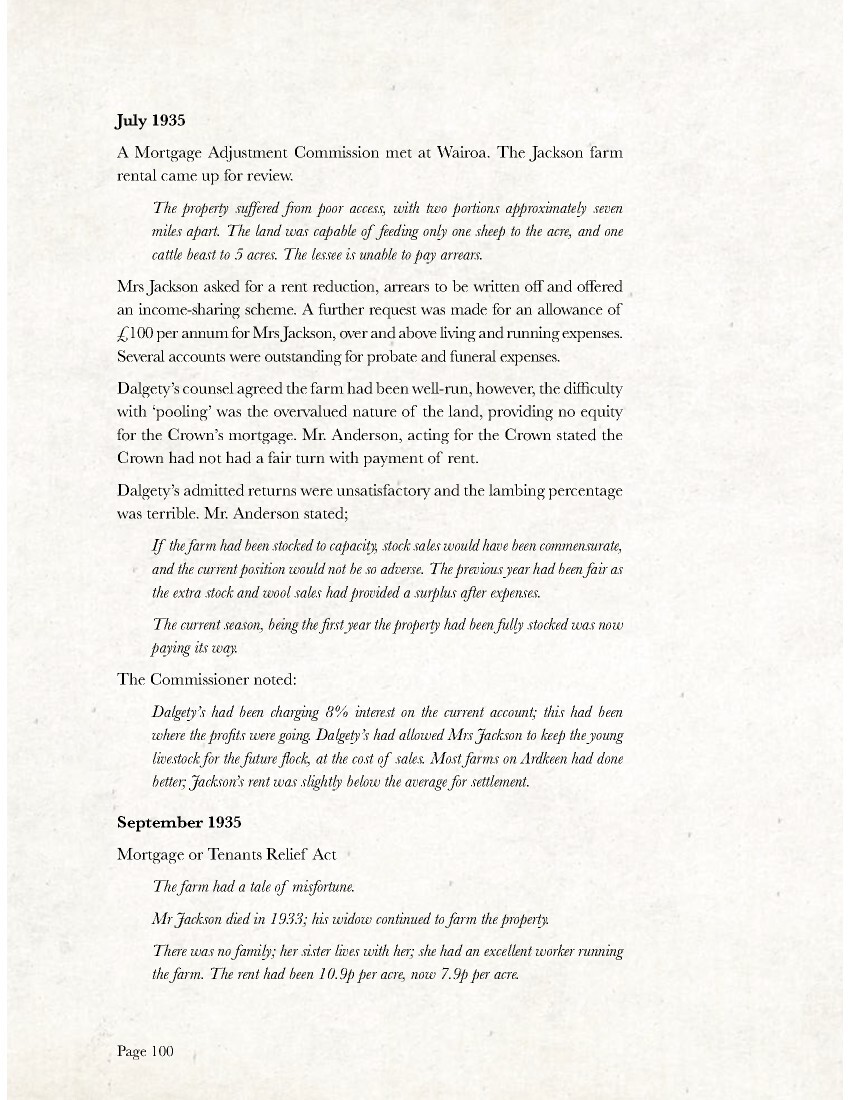
Page 101
The dwelling is on 46 acres with the balance of the land seven miles away.
Access is a clay track over hills seven miles through neighbours’ properties. The stocking capacity is little more than one sheep to the acre.
There were too many sheep and not enough cattle on the property. The applicant could continue, if arrears were remitted and rent reduced to 3.6p per acre.
Mrs. Jackson had little money for personal and living costs, she owed about £100 to the hospital, and funeral and testimony expenses from her husband’s death.
Mr. Sainsbury for Dalgety, his client agreed the property was well farmed, rent was too high, and there was no equity for the Crown’s mortgage. Interest charge on stock account last year was 6%.
Mr Anderson for the Commissioner of Crown Lands submitted: Mrs Jackson’s trouble was due to the farm being under a Dalgety’s Stock Mortgage, and sheep had to be driven eight miles through neighbouring farms for shearing, along with poor lambing percentages, and only an average wool clip.
A statement submitted by Dalgety’s claimed there was an adequate allowance for living expenses, repairs and maintenance.
The Commission inspected the property which involved two-and-a-half hours in the saddle from the homestead section through steep country to the farm where the only accommodation for a man was a very small unlined, galvanised iron hut.
The land described as fair sheep country, with a pasture of native grasses and 300 to 400 acres of poor manuka-covered land.
With no prospect of the applicant being able to pay arrears of rent and interest.
The Commission recommended remission of all arrears up to 30 June 1935. Postponement of arrears of interest on Crown mortgage until 30 June 1936; a rental of 4 shillings per acre for 12 months ending June 1936.
October 1935
Court of Review recommendation of Gisborne Adjustment Commission Rent reduced 4/- per acre.
Mr Anderson stated that while the Department was sympathetic toward
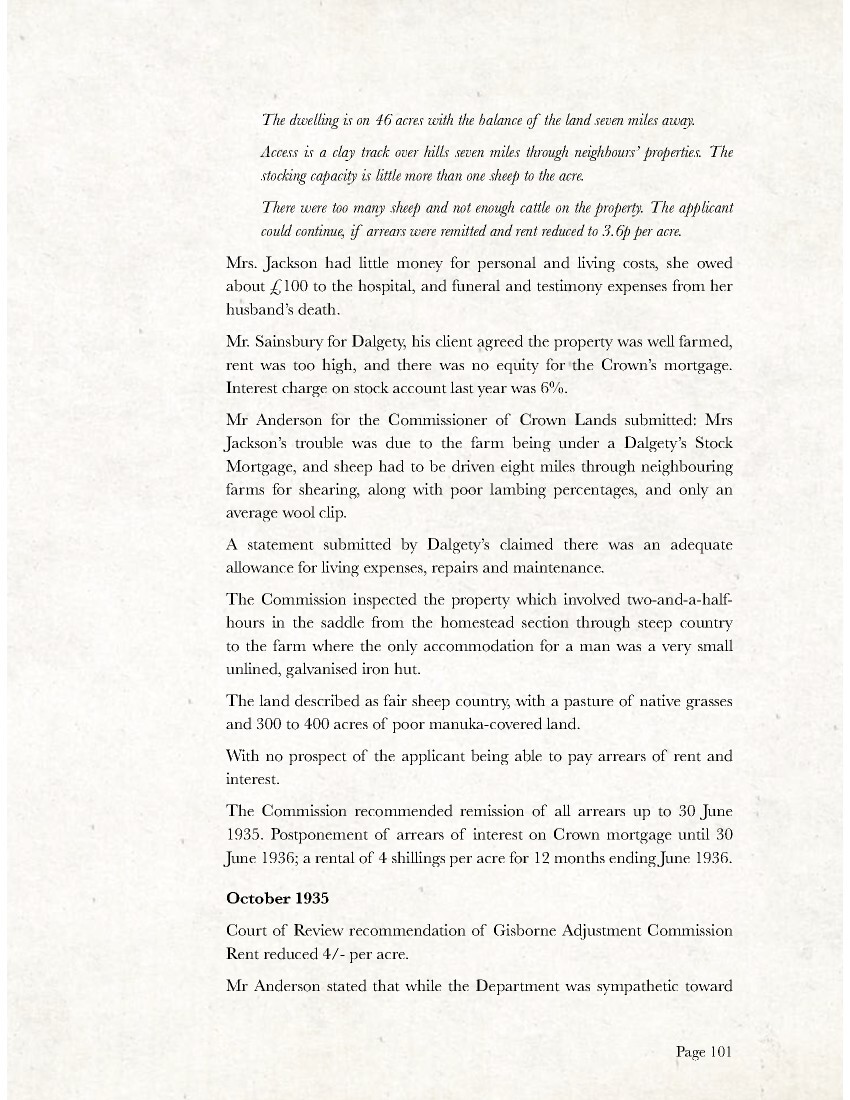
Page 102
Mrs Jackson, and wished to assist, the Department had granted a 40% reduction for three years from July 1931. The property had been understocked, and the department had been compelled to forfeit the lease to get Dalgety’s Co-op to stock the property. The Commissioners’ position was prejudiced by the stock firms 8% interest charge, until last year when they reduced the rate to 6%; still higher than necessary.
Court of review orders:
1. Arrears not to be remitted.
2. Amount of £636 carried forward and postponed.
April 1936
Margaret again sought help from Mr. J. G. Coates, writing:
Dear Sir,
I wrote to Mr Campbell M.P. about my difficulties; the stock firm advises me to walk off. I worked hard with my late husband to keep the farm. I want your help.
Dalgety’s have been unhelpful; they had been against us.
The Land Board has been helpful, for which I am grateful. Unless the Crown helps, my position is hopeless. I am writing in the hope you can help the Widow of a Returned Soldier.
Margaret Jackson
Mr. Watson, an accountant and Mrs. Jackson’s brother, stated he had gone through various accounts; saying wool figures seemed high, property clipped 10,869 lbs. from 1,448 sheep last year, and the farm was overstocked by 400 sheep.
The farm was supervised by Mr. Harrison.
Ninety chains of stock-fence need realigning and a 40% increase for gullies and contours.
1936/37:
During this season there was a surplus of £709.10.7 plus £69.11.6 for capital expenditure. The account showed a surplus.
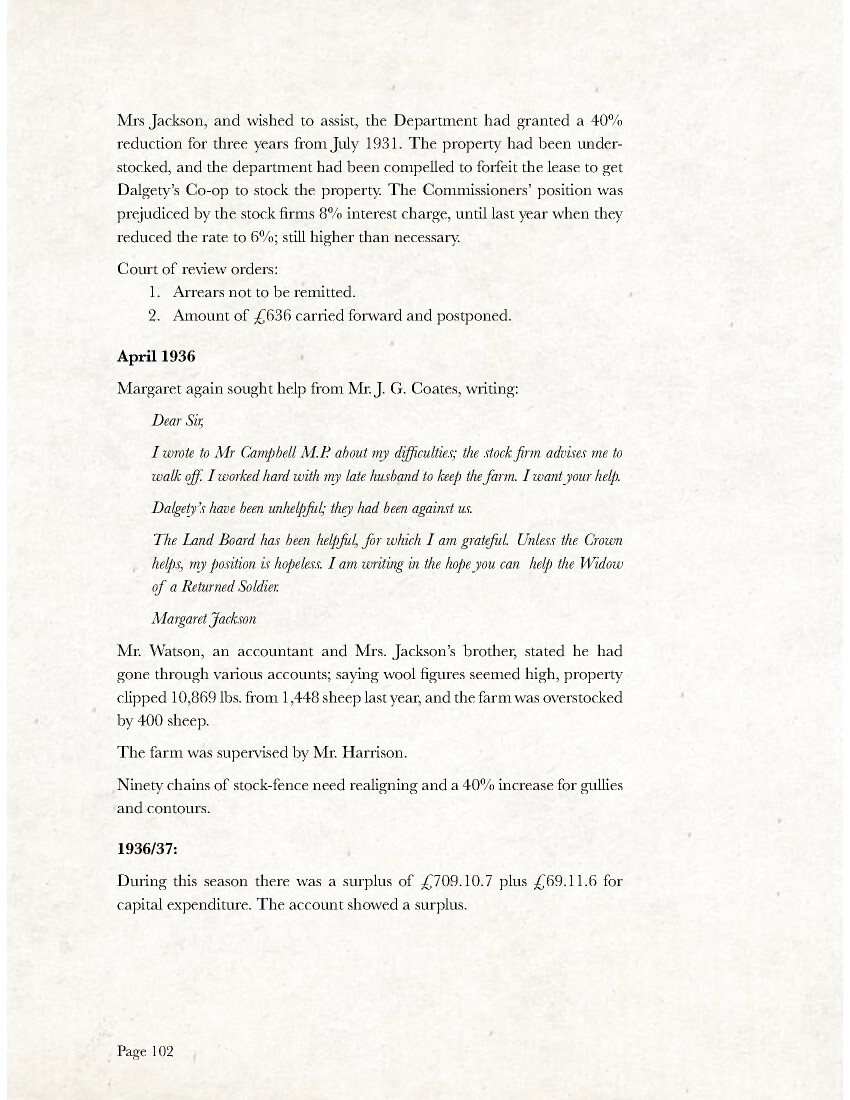
Page 103
1936 Mortgage and Lessee Rehabilitation Act Statement
Margaret Jane Jackson:
In the matter of an application by Executrix for the estate of Cranworth Franklin Jackson.
I am the Widow of Cranworth Franklin Jackson deceased and the Executrix of his estate. I am the sole beneficiary, have no other means of support other than farm property. I have no children, and my sister lives with me to help.
Cranworth Jackson won the Section 6s in a ballot of Ardkeen Settlements 1920. He was a returned soldier. The area was too small, and the slump of 1922 cost him owing to a fall in livestock prices. In 1926 there was a severe drought, he lost two-thirds of the cattle, and sheep sold for one-quarter of the cost.
Postponed rent remained unpaid: Land Board forfeited the farm.
1927: Position reviewed by Land Board, Farm too small. Rent reduction promised or, an increased area.
1930: Offered additional area. Extra land was conditional on payment of arrears; Mr Jackson was forced to sell 33 cattle and 373 sheep to raise money to clear back rent. Conditions of the transfer; he surrender 135 acres to Jim McLean Section 7s.
He would have a total area of 1,206 acres, however because of the slump and Dalgety’s refusal to finance the purchase of livestock for the increased area, Jackson took on grazers.
To help through the slump Mrs Jackson boarded the three Davey children during the school week.
1931: land forfeited, later rescinded
1932/33: understocked
1933: Mr Jackson died
1934: rent paid in full
Mrs Jackson struggled under debt; farm in good shape.
Has a good man, needs a man’s whare and woolshed, house requires repainting. Has one 400-acre paddock that needs subdividing into three.
There are no other assets.
Mr Watson Accountant, Mrs Jackson’s brother, stated he had gone through various accounts; wool figures seemed high, property clipped £10,869 from 1,448 sheep last year.
Property overstocked by 400 sheep.

Page 104
March 1937
Homestead section: on Waikaremoana Road
Main farm eight miles distant by way of unfenced stock route through neighbouring farms.
House and buildings in good order; house needs painting. 46 acres of flats, broken by creek, covered in a light black loam on pumice, poorly grassed unsuitable for ploughing, adequate water.
Hill country, 660 acres, medium quality on papa, pasture; English and native grasses. 500 acres of terrace country covered with light black loam on pumice and clay formation.
Poor quality native grass, no noxious weeds, liable to revert to manuka and fern if not correctly managed. Climate pleasant, no flood danger, water sufficient, no gorse, scattered manuka, tauhine.
Woolshed and dip required.
Water-supply sufficient.
Fencing; good
Applicant, a Widow in good health, no children; requires a man to manage the farming operation. Farm showing efficient stock management. Revenue controlled by Dalgety & Co.
Slump conditions; rent too high. Farm too far from homestead.
Sheep sheared at old Ardkeen woolshed, 10 miles from the farm.
A report stated the need for a road running west from Ardkeen Road, adjoining part of Jim Tolme, Bill Carson and Jim McLean’s to the Jackson property boundary; a distance of 220 chains. The disadvantages settlers had endured for the past seventeen years was pointed out. The formation of a road with small deviations from the present survey line.
February 1938
A severe flood, followed by another disastrous one two months later, left trails of damage to the Jackson property. There was about 220 chains of fencing lost; the flood had cut the Wairoa district off from outside markets.
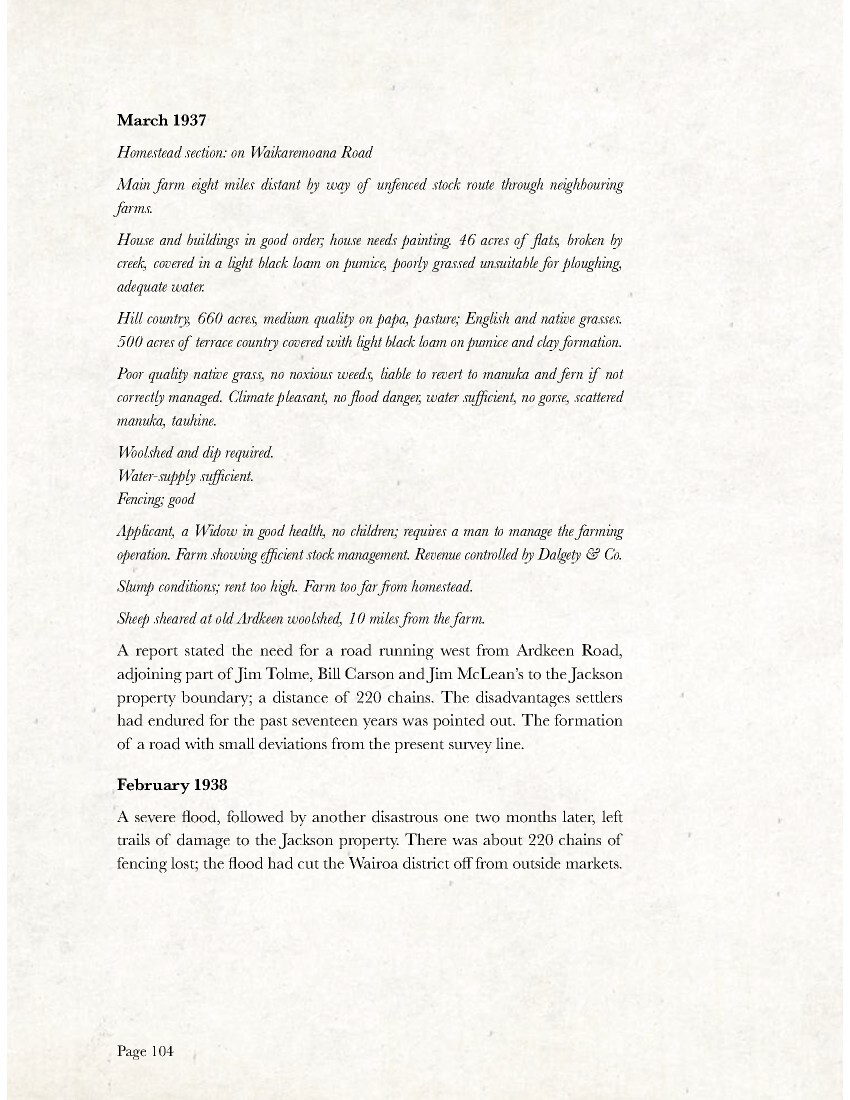
Page 105
May 1939
Internal memo Land Board observed:
Dalgety’s refused to pay rent until returns were in hand. ‘Stock firms are getting back to the old pro-rata arrangements which were supposed to have been done away with under the relief legislation’.
Resolved to recommend distraint. Chief Clerk
17 May 1939
The Commissioner of Crown Lands wrote to Dalgety’s advising they were being unduly cautious in not allowing settlers to meet the rents fixed by the adjustment commission. The department would not allow the position to continue and had no intention of letting the pro-rata arrangements of old to come back into force. The Commissioner advised stock firms they should regard charges as similar to the payment of commissions on stock transactions and asked what restrictions and procedures Dalgety’s proposed to adopt. The Board resolved to recommend distraint; seeking the Honourable Minister’s approval. The firms were not playing the game with the department. The new Land Board member; Mr P. J. O’Kane, who is a settler on Ardkeen, concurred with the action recommended. The Commissioner reiterated he was not prepared to enter a ‘pro-rata’ agreement, but was of the opinion the department should not hesitate to distrain the livestock.
November 1945
Margaret Jackson to the Commissioner;
Dear Sir,
I wish to appeal to you for further and urgent consideration of access to our properties on Ardkeen Settlement
A previous request was made in 1939, but on account of the war, we decided to leave the matter in abeyance for obvious reasons.
Both our main properties adjoin; from our nearest Homestead to the main area, the distance is 7 miles. The route is poor, in winter almost an impossible track, no supplies can be taken out, except by pack horse and then owing to the distance, only small lots. The nature and size of the Homestead blocks do not permit carrying large numbers of pack horses, owing to the cost of feeding which would be involved.

Page 106
The most serious matter arises annually. The sheep are shorn and dipped at the Ardkeen woolshed. The sheep have to be mustered into holding paddocks at the nearest point to the existing road (some 3 miles away) on, say Monday. They are then driven to the 9-acre accommodation paddock ( Reserve at the top of Carson’s) and the woolshed Wednesday, two days for shearing, Thursday – Friday. Then plus two days to return to own all paddocks, making a week in all, providing no rain intervenes.
There is no accommodation paddock at the Ardkeen woolshed; you may imagine the position if it rains. There is no water on the route, and what this means to stock will be apparent to you. Ewes go off in milk, lambs are mis-mothered and of necessity become with a resultant loss in revenue. The same process has to be repeated for dipping. We want to point out to you that we are the only settlers on Ardkeen not served by a road. We therefore urgently appeal to you to have the road completed 2 our properties on the following grounds:
1. To allow us to bring our repairs and maintenance up to a reasonable standard.
2. To allow accommodation to be provided on the property so that men will not waste four hours daily travelling.
3. To enable scrub to be dealt with
4. To allow livestock to be economically handled.
5. To enable artificial manures to be applied and greatly increase the carrying capacity.
6. Allow us to erect essential equipment, such as a dip and woolshed. Awaiting your further reply and thanking you for the interest already taken.
We are, Yours faithfully M. J. Jackson
J. C. McLean
July 1948
Mr. Cunningham the Manager of Dalgety’s advised the Commissioner of Crown Lands that Mrs. Margaret Jackson had paid both the rent and interest. Saying:
“The lady had experienced a much better year, however with a variety of managers, her farming fortunes had been difficult.
She had not prospered as well as she might have expected.”
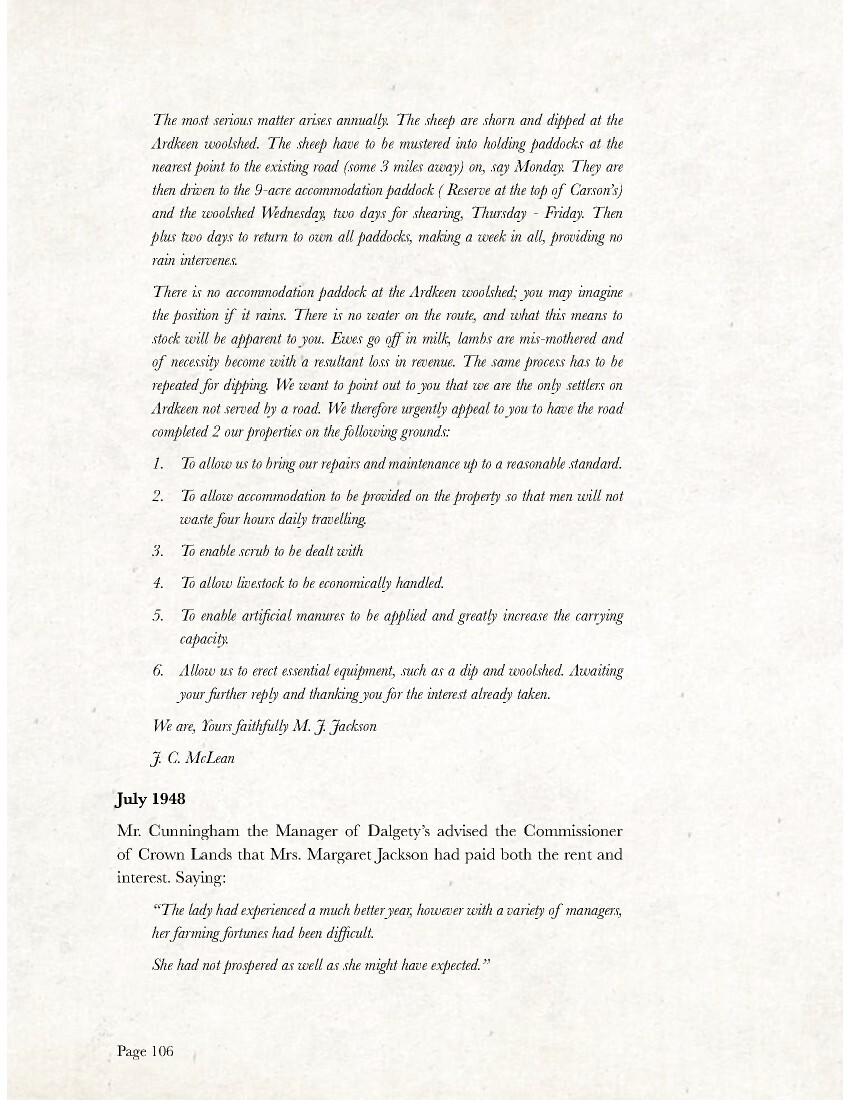
Page 107
RECENT HISTORY
Margaret Jackson’s estate sold to Tom Dever of Frasertown in 1964. Tom mustered many wild cattle from the farm before selling circa 1967 to Barry Simmonds who owned the neighbouring Makapua Station.
Colin and Margaret Baynes bought Makapua along with the Jackson farm in 2003. They now own Matson’s Section 1s and part of Jackson’s Section 6s, a total of 1,160 acres of Ardkeen, plus Makapua Station.
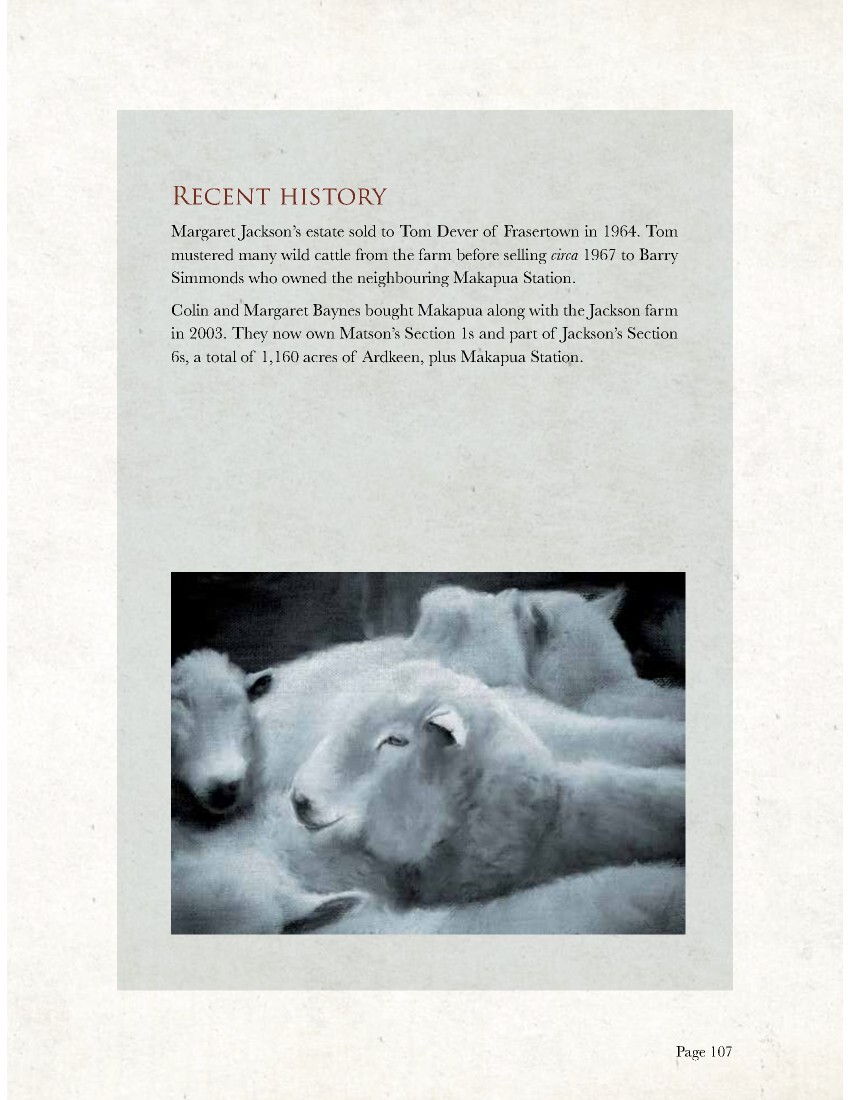
Page 108
JAMES CHRISTOPHER McLEAN (JIM)
MILITARY SUMMARY
Date of Birth: 15 April 1898
Place of Birth: Perth, Scotland
Parents: Alexander and Jean McLean (née McLeod)
Next of Kin: Mrs Jeannie McLean, mother, Racecourse Road, Dannevirke
Last NZ Address: Racecourse Road, Dannevirke
Marital Status: Single
Occupation: Farmhand
Employer: A D McLean
Regimental No: 82651
Rank: Private
Death: 14 Jan 1978 Wairoa
Age: 79 years
Buried: Wairoa Cemetery Awards: British War Medal
Other Service: 17th Ruahine Regiment B Company; World War Two 2/20B/79 Home Service
1918
22 May: Attestation signed at Woodville
19 Jun: Enlisted at Trentham – Posted to B Company 42nd Reinforcements
01 Jul: Transferred to B Company 43rd Reinforcements 1
9 – 23 Sep: Influenza – Trentham Hospital
25 Sep: Absent without leave [AWL] – forfeited 2 days’ pay
02 Oct: Departed New Zealand HMNZT111 Matatua for London
05 Dec: Posted to strength ex 43rd Reinforcements to 3rd Reserve Battalion Wellington Regiment
15 Dec: Disembarked London – marched into Sling Camp, Salisbury Plain, Wiltshire
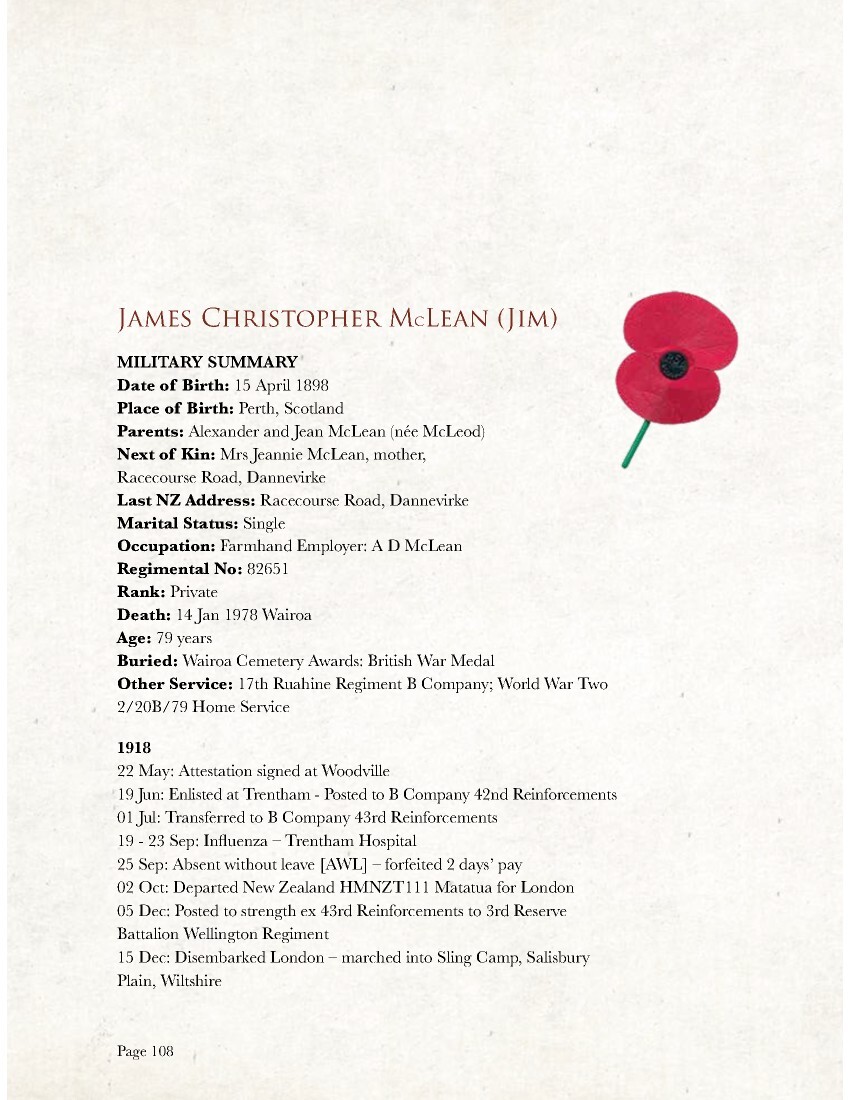
Page 109
1919
22 Jan: Marched in NZ Field Artillery Reserve Depot at Ewshott
24 May: Marched out on leave – to report at Codford on 06 June 1919
06 Jun: Absent from Codford
30 Jun: Codford – Declared by Court of Enquiry held at B Group Codford 30 June 1919 – to have illegally absented himself 06 June 1919 and is still so absent 30 June 1919 and deficient of kit to the total value when new of £13 10 7d.
Stated not absent – leave was granted 25 June to 08 July 1919. No action taken at WPD. Stated joined WPD ex Sutton Coldfield and that he had lost his pack. Sutton Coldfield closed so impossible to verify statement 28 Jul: Returned to New Zealand SS Hororata ex Plymouth
20 Sep: Arrived New Zealand
18 Oct: Discharged on termination of period of engagement
Total Service: 1 year, 122 days (including 354 days overseas)
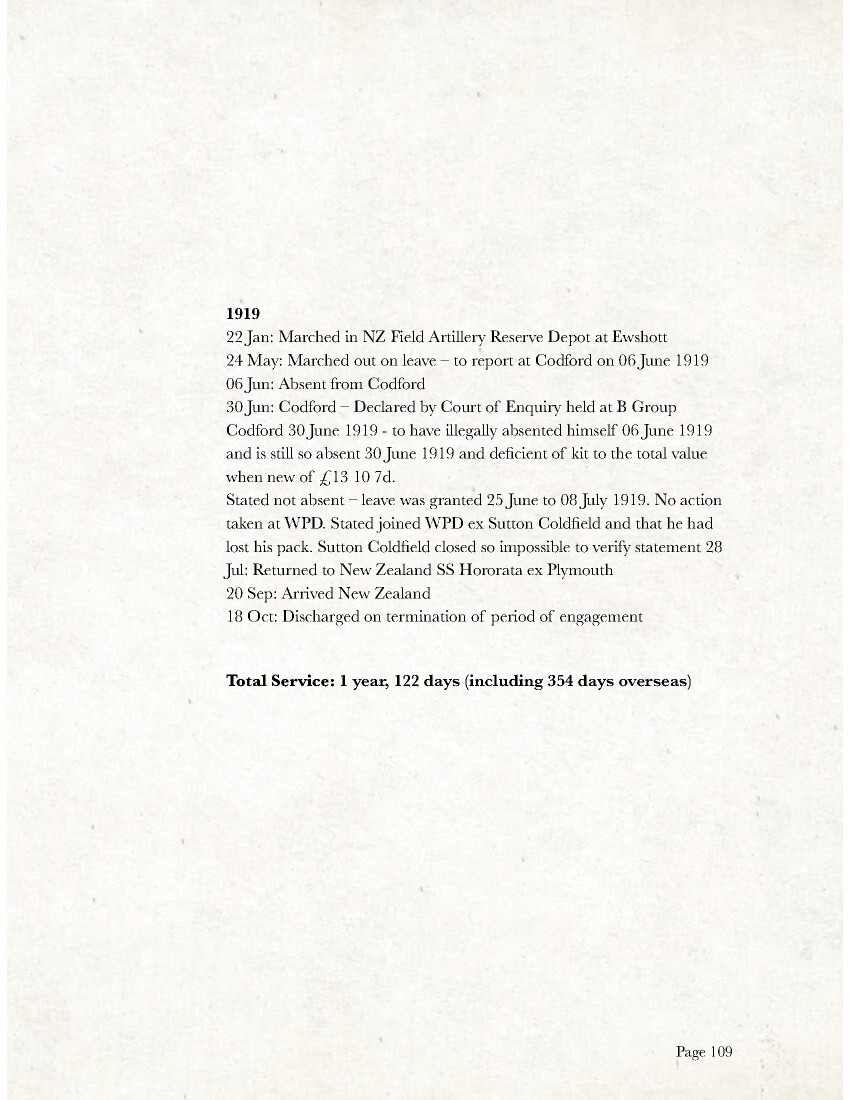
Page 110
LAND BALLOTT
Section 7s, 494 acres
Ballot awarded to: Jim McLean
Jim McLean drew a remote 494-acre paddock of undulating terrace country and steep hillsides. To get to his farm, Jim had a two-and-a-half hour horse ride from his 30-acre homestead section at the Ruapapa at the Waikaremoana Road Junction. His family would frequently walk in to the farm to help.
Section 1s. Percy Matson; Section 6s Cranworth Jackson and, Jim McLean’s section 7s, were adjoined. Up to the time of writing, these properties do not have all-weather vehicle access.
The Department of Lands allotted Jim McLean a further one hundred and thirty-five 41 acres making the total area of 629 acres.
1921
A memo expressed the view that Jim McLean was not expected to remain on the property, being too small and the ‘worst section except for section 15s – Gerry Spooner’s, on the settlement’. Jim McLean was to prove that he would not only survive but flourish.
Jim McLean’s homestead
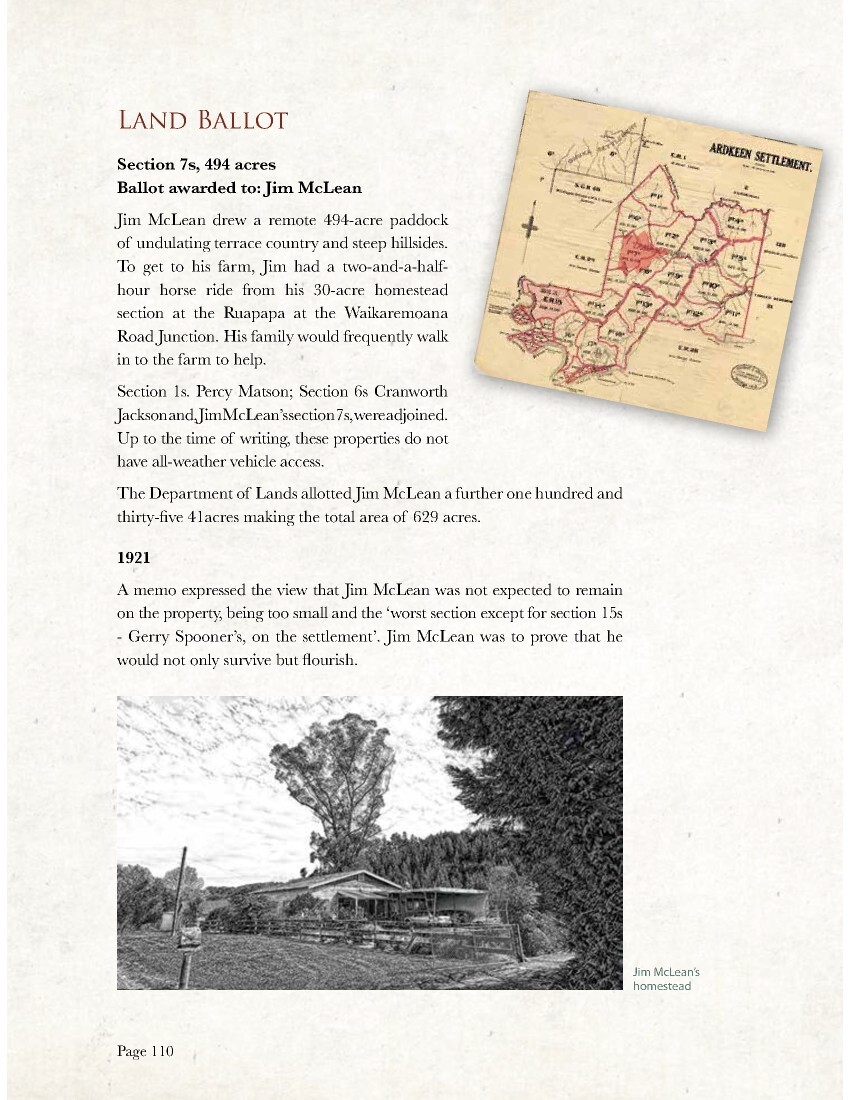
Page 111
July 1921
The Commissioner of Crown Lands received an urgent request from the Public Works Department Wellington. They wanted to haul metal from the Waiau River over the summer for use on the Waikaremoana Road, securing access for the hydro-electric scheme through the winter months. The Board was asked to overlook the informality of the request because of the urgency, saying consent may be required.
The Commissioner asked Jim McLean if he would agree to the Public Works using three acres of his land for access, and offering £10 per annum, payable half-yearly, enclosing the plan below.
February 1922
Jim McLean built a small house costing £350.
April 1924
Jim was having difficulty paying his rent and asked the Commissioner if he might spread the payment over a few years. He said would need to borrow money to pay the rent, which was due in six months, as he had not made any money to date; explaining he came to Ardkeen with £1,200 and
Photo caption – Right: Public Works sought access through Jim McLean’s farm for gravel to maintain the road for the building of the power station at Tuai.
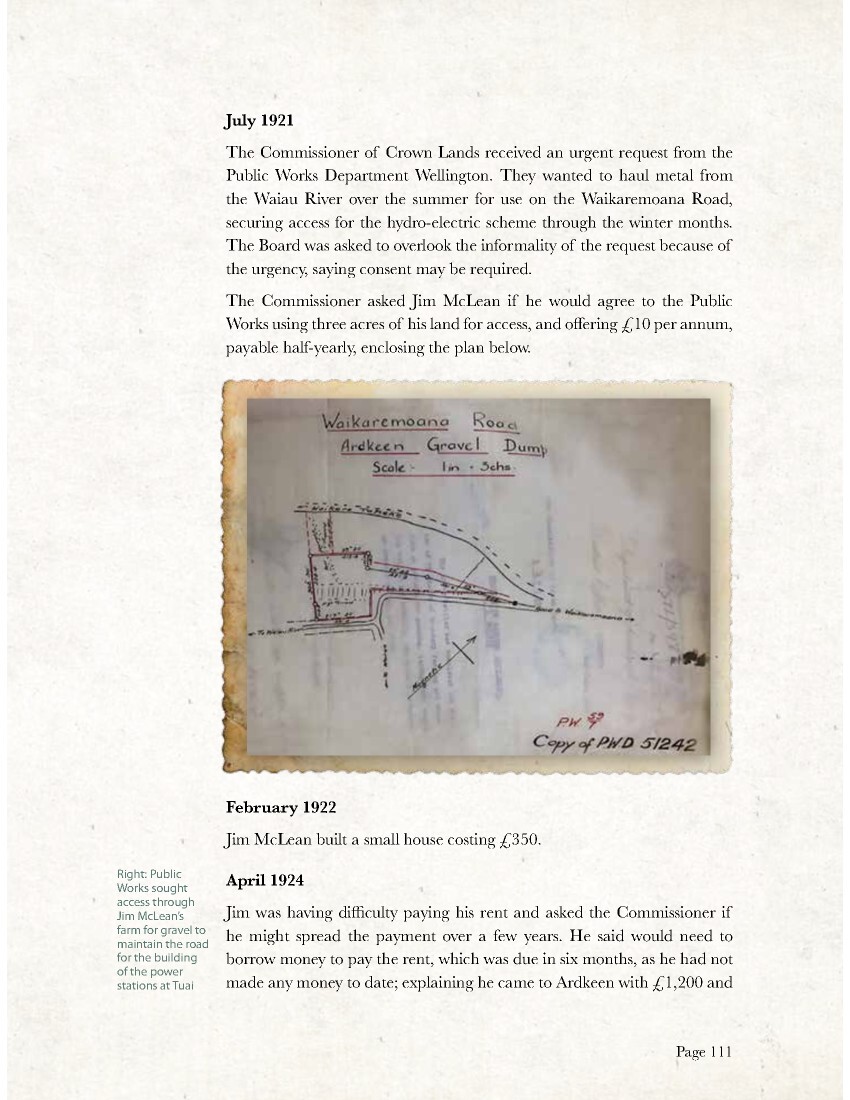
Page 112
£1,000 of that was a loan from his father. Hawke’s Bay Farmers Co-op, a stock firm, held a mortgage secured over his livestock; Jim was doubtful there was sufficient equity in his livestock to clear the mortgage.
Jim advised saying another farmer on Ardkeen was prepared to take over his section, at a reduced rental, if the Board would agree. Jim asked if the Board would compensate him for work to date, saying he and his wife would need to start afresh.
July 1924
He then advised the Board and Commissioner he had paid the rent to date, and asked for his farm to be revalued.
November 1925
Jim advised the Commissioner of the improvements including how he had completed one mile and a half of the subdivision fencing and built a set of sheep yards.
February 1926
Jim wrote to the Commissioner that he was unable to get his wool into the sale because of wet weather, and even though the rent was due, it would be February or March before he could pay.
April 1927
Jim was still struggling with meeting his interest payments saying:
“I had not the heart to write, and I had been putting it off night after night telling myself I would write the next night’.
His wool should be sold, and Hawke’s Bay Farmers Co-op had promised to pay the interest on payment for the wool. However, he had discovered that his interest remained unpaid, and the matter had been referred to head office because his overdraft was so high.
The Commissioner lost patience with Jim accusing him of not keeping his promise and wondering if Jim had not written so as to avoid further action. Asking if the stock firm would meet the payment or not?
He reminded McLean he had the power to take action for recovery of the amount without waiting for authority from the Land Board.

Page 113
May 1927
Jim finding himself between his financier and the Commissioner of Crown Lands, replied, saying he was not to blame for the delay. He had asked Hawke’s Bay Farmers Co-op on several occasions to square the account. They again referred the matter to head office; Jim suggested the Commissioner write to the firm directly.
Hawke’s Bay Farmers Co-op advised the Commissioner payment was authorised, and a cheque was on its way. This same pattern was replayed throughout the years; stock firms received all revenue from the settlers’ farms. The stock firm typically held the livestock as security by way of a stock mortgage and operated a trading account. Should a settler’s account acquire too much debt, the stock firm would retain income and stop outgoings until they reached a level of comfort. The relationship between the manager of the stock firm and the farmer was often fraught and influenced by personality.
June 1928
Jim asked the Commissioner for £80 to enlarge his house which at the time was little more than a bach. Crown Land Ranger Mr Robertson reported the matter as deserving and recommended £100 be made available for additions. The money would enable the McLean family to have two small rooms 8’ x 8’ (kitchenette with a brick chimney, a bedroom and 18’ x 8’ sleeping porch).
Costs
Timber: £45
Bricks: £8
Iron: £1
Cement: £2
Bricklayer: £3
Cartage: £9
Paint: £5
Total: £75
The loan was approved by the Minister of Lands. Jim and a friend did the building.
Jim sent the final accounts for the building totalling £62 19.9 and asked if he could use the remaining £17.0.5 for construction of a small wash-house.
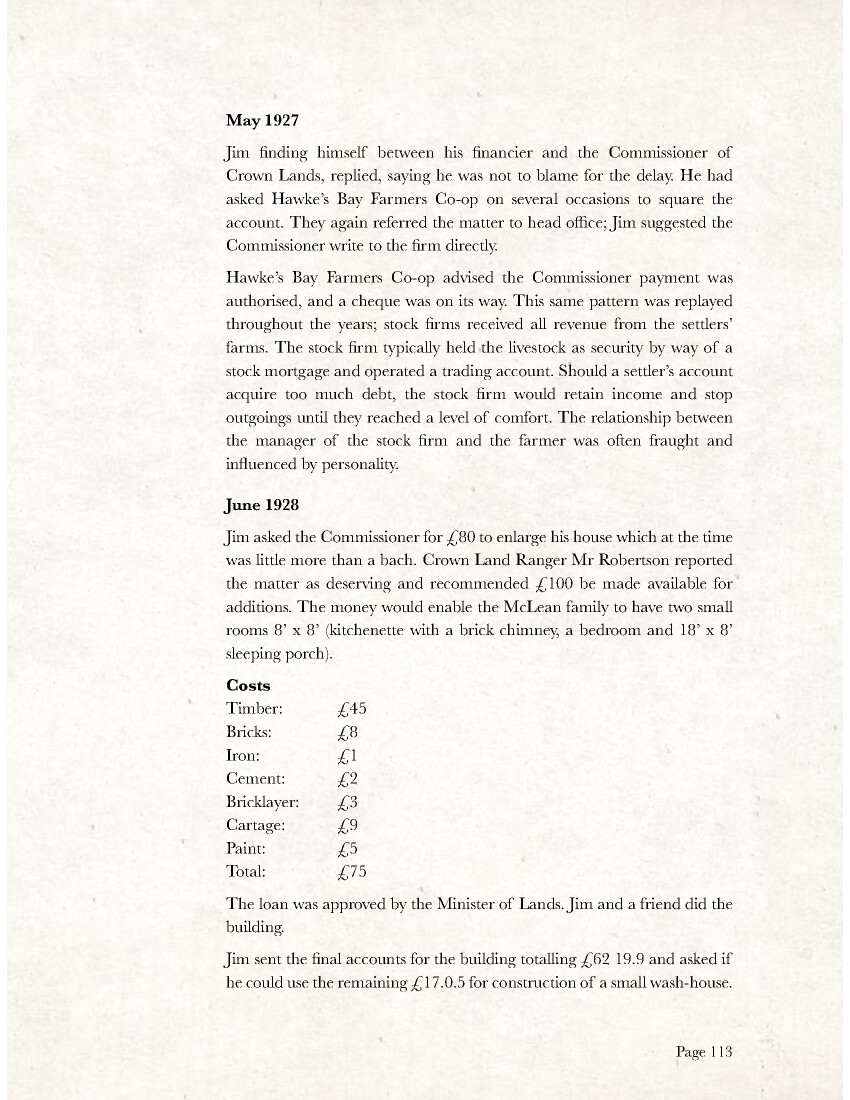
Page 114
* Note: Airlie remembers her father Jim tethering the horse to the ‘koneke’ (sledge) and taking her mother to the Waikaretaheke River on Monday mornings to do the washing. He would return to the house to sit with the children for a couple of hours. Then go back to the river and collect her mother and the clean laundry.
A booklet produced by the New Zealand Army Education department in the United Kingdom highlighted the fact that the farmer’s wife should not be a serf on the farm, neither should the welfare of the children be prejudiced by the labour. 36
July 1928
Percy Matson was put off his farm. That farm, situated in the north-west corner of the settlement between section 2s, the estate of Frank Meagher and Cran Jackson’s section 6s.
Because both Jackson’s farm and the McLean farm were too small, the Ministry offered Jackson all of Matson’s land, if he gave up 135 acres of section 6s, arguably, his best land to McLean. This 135-acres required little fencing and would make McLean’s farm a more commercial unit.
November 1928
Jim was advised the 135 acres belonging to Jackson on his north-eastern boundary would be available to him at the cost of £9 an acre. Jim objected believing he should have 300 acres at this rental and said he was as good a settler as Mr Jackson.
The Board argued the 135 acres of Jackson’s was the best part of the section 6s, as it was the mostly open-terrace land.
December 1928
The next month Jim Tolme and Jim McLean discussed the possibility of McLean taking over Tolme’s homestead section that adjoined Jim’s section on the Waikaremoana Road. Jim wrote to the Commissioner saying he was milking cows and would like the extra area and asked for completion of the transfer to enable him to have the paddock for the season.
36 Gould, A. N. (1992) Proof of Gratitude, p. 204.
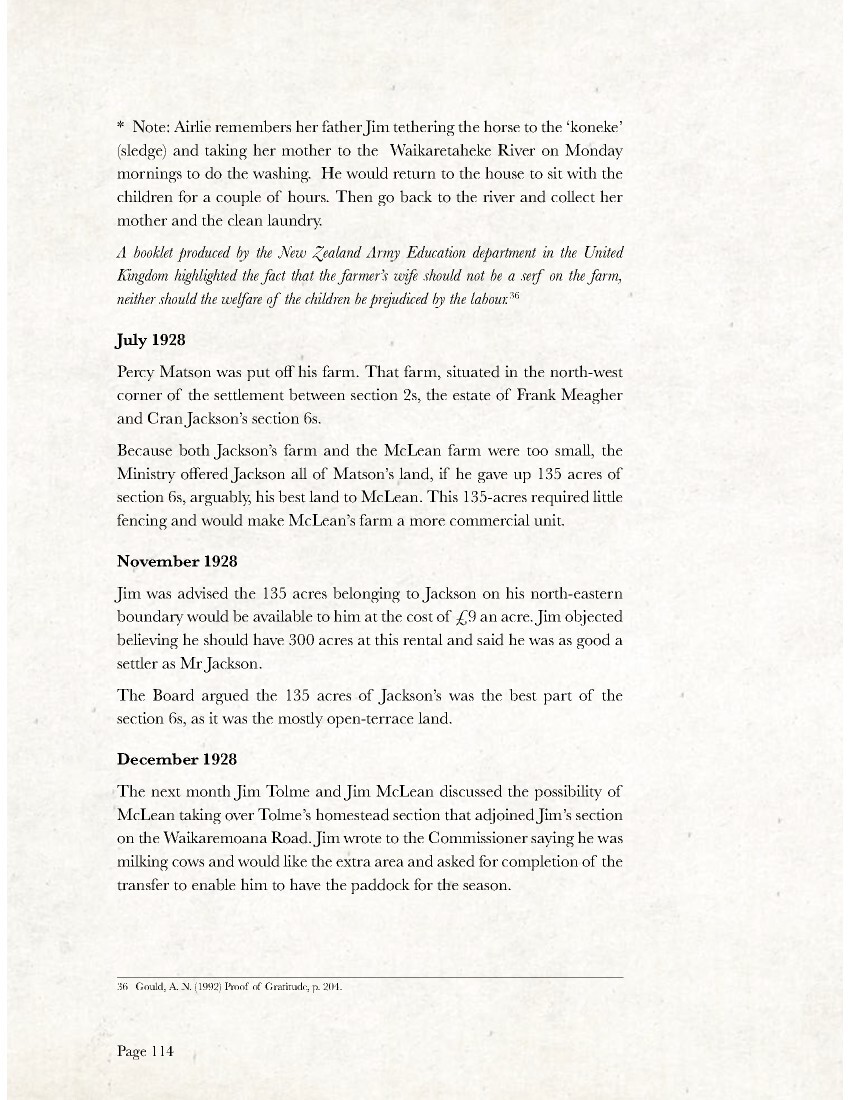
Page 115
August 1929
Jim McLean asked the Commissioner if the subdivision with Jackson was to take place because he was holding sheep back.
December 1929
The Commissioner advised Jim there were areas on Ardkeen coming up for revaluation and there was no decision yet. He told Jim it might be possible to grant him a temporary lease after Matson’s stock had gone, saying the board had terminated the Matson lease.
It was not until February 1930 that Jim learned the transfer of 135 acres belonging to Cranworth Jackson would be made at the cost of £1,180 and that Mr Tolme would surrender his homestead section to Jim.
March 1930
Jim wrote to the Land Board complaining about the smallness of his farm and the cost of working between sections. He believed an additional 400 acres of section 1s would enable him to carry an extra 400 sheep.
The Board responded that the new area offered would give him a compact holding and enable him to carry 170 more sheep.
He was also getting 28 acres of Tolme’s homestead section to help his dairying operation, the Board added.
April 1930
Jim wrote to the Commissioner accepting Jackson’s piece of section 6s and advised he was paying 8% interest on account at Hawke’s Bay Farmers Co-op.
August 1930
Jim again wrote to the Commissioner saying Hawke’s Bay Farmers Co-op had become very hard on his account.
He advised he had built a cowshed, installed a milking machine and topdressed the dairy paddocks. Jim asked if he could postpone payments for three months until after the cream money came to hand.

Page 116
November 1930
By this time Jim had become concerned about the slump in farm prices and wrote to the Commissioner saying he would not take Jackson’s 135 acre section 6s because it would be difficult to pay rent and interest; he apologised for the trouble he had caused the Board.
The Commissioner asked him to reconsider the matter, offering that the Board would allow further time to make rent and interest payments.
February 1931
The Commissioner acknowledged Jim’s reluctance to assume more land and offered a temporary tenancy at a low rental.
October 1931
Jim wrote apologising for not returning the transfer document relating to the Tolme section. He explained he had suffered a severe attack of influenza and been ‘laid aside for several weeks unable to put his mind to the matter’.
November 1931
After a visit Field Inspector Robertson wrote. “This man is a good farmer who fully appreciates his responsibilities to the department”, noting Jim McLean had shown a profit of £29. A remarkable feat considering New Zealand was in the middle of a depression and the farm was the smallest on the settlement and regarded as the second to worst farm after Section 15s on the settlement.
November 1932
A year later the Commissioner of Crown Lands wrote to the manager of Hawke’s Bay Farmers Co-Op expressing his concern with the lack of payments for rent and interest. He added that Jim McLean was milking cows enabling him to meet ordinary living expenses from the cream cheques. The Commissioner advised that unless the firm shared surplus revenue with the department, he would have no alternative but to charge grazing fees for the firm’s stock on Crown property, demanding an immediate response.
An internal memo notes that no payment or satisfaction could be obtained from either the firm or the settler. McLean’s returns were £383.8 against the expenditure of £150; therefore, he could make a substantial payment to the department.
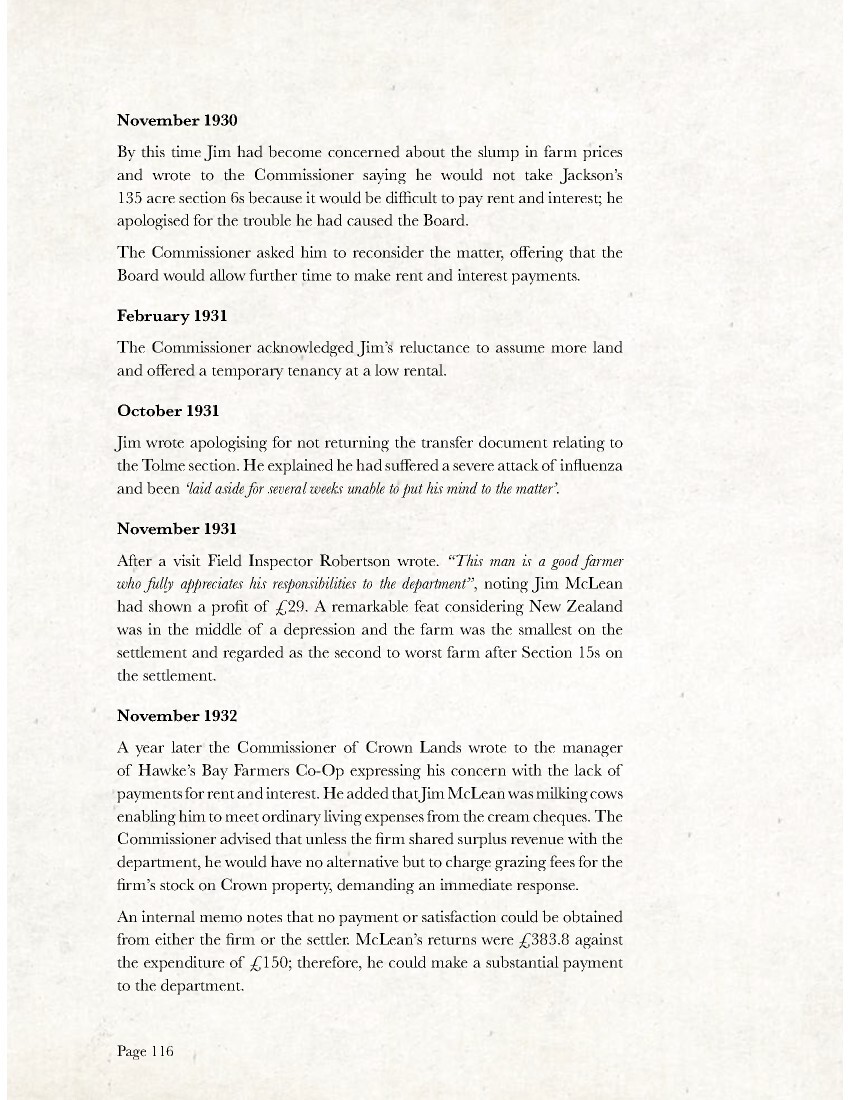
Page 117
January 1933
Jim McLean wrote expressing regret at not attending to correspondence saying he had been ill; he had also met with the Manager of Hawke’s Bay Farmers Co-op without satisfaction.
Jim had become deeply frustrated with the attitude of Hawke’s Bay Farmers Co-op toward him, and to this end, began looking for an alternative source of finance.
April 1934
The manager of the Union Bank of Australia Ltd wrote to the Commissioner of Crown Lands enquiring about Jim McLean’s lease.
Some of his queries included: the present arrears of rent, the amount owing under the mortgage to the Crown, terms of mortgage and rate of interest, amount of interest in arrears and arrangements for payment of postponed arrears.
May 1934
Jim McLean wrote to the Commissioner discussing how he had expected Hawke’s Bay Farmers Co-op would make a payment of £130. His solicitor Mr Chamberlain had said that he did not think there was much chance. McLean had tried to get a bank to take over his account but was unsuccessful.
June 1934
At an Adjustment Commission sitting, Jim McLean’s solicitor, a Mr Chamberlain, advised the Crown had taken steps to distrain for one year’s rent. Hawke’s Bay Farmers Cooperative had declined to pay a portion of the lease and arrears after realisation of the wool clip. However, this action prompted Hawke’s Bay Farmers to pay £100 with a promise to pay a further £100.
The Crown noted that the average carrying capacity of McLean’s property was about 800 sheep. However, he was carrying: 1,070 sheep, 25 dairy cows, 80 breeding cows, 35 other cattle plus 25 dairy calves.
This was enough to clear the Hawke’s Bay Farmers Co-op account outright.
There was an exception to the suggestion that arrears should be remitted
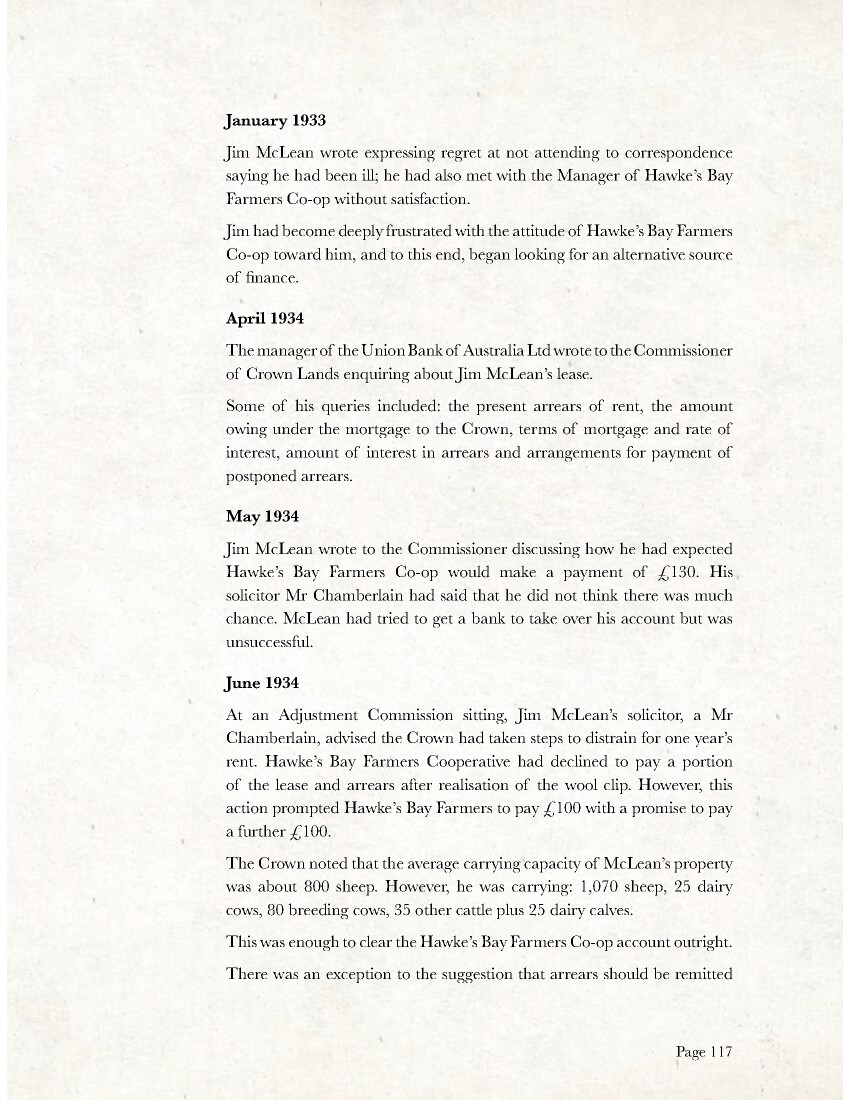
Page 118
and reduced while a stock firm was taking all the revenue from the property.
The Chairman of the Commission stated it was one of the worst cases he had come across relating to a stock firm’s management of a farm account.
The Under-Secretary for Land was surprised the matter had come to the minister’s notice.
He added the department had no intention of making an example of McLean, but said he was unfortunate to have his stock secured to Hawke’s Bay Farmers Cooperative and noted McLean could make no progress with the firm controlling his finances.
The firm refused to meet rent payments yet they got all the revenue from the farm and held security over the livestock.
Surprisingly the Chairman suggested that the department take over Jim McLean’s stock account from Hawke’s Bay Farmers Cooperative.
July 1934
A concise statement from the Adjustment Court recommended:
Arrears of interest be wiped out. Annual charges reduced for two years.
Approval for the suspension of principal installments for three years, starting July 1932 A reduction of rent and interest charges by 40%, for two years from 30 June 1933.
The account with Hawke’s Bay Farmers Co-op closed and the Crown Lands Department assume Jim McLean’s affairs.
Mr. McLean to be advised to find another stock firm.
Signed
Under-Secretary for Agriculture.
In a letter to Messrs. Chamberlain Solicitors, the Commissioner asked for the matter to be kept quiet.
The Department did not want this case to be considered in any way a precedent for action by other settlers on Ardkeen, pointing out the case was a special one.
The following year Jim McLean justified the efforts the Commissioner made on his behalf by producing a surplus; sufficient to clear his overdraft with the department, plus his stock values had appreciated.
Jim McLean asked the Commissioner for £10 saying his cows had dried off for the winter and he had no method of paying for groceries.
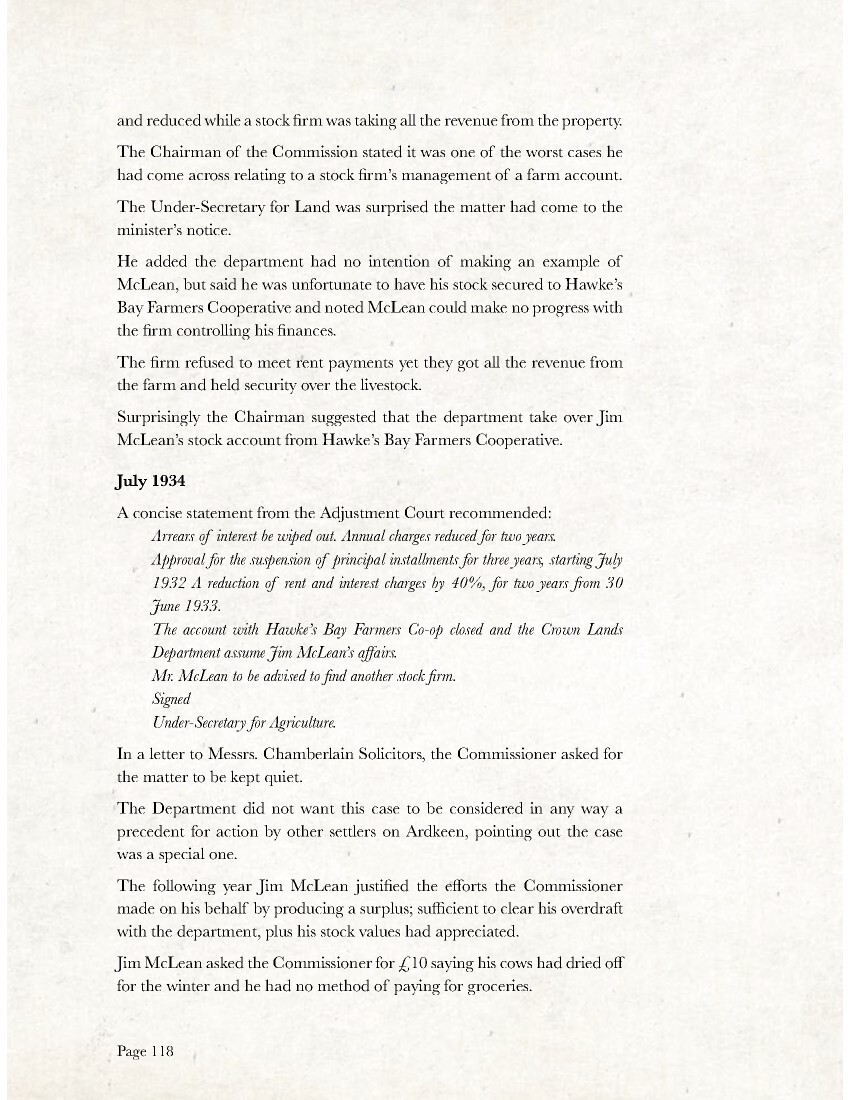
Page 119
April 1936
Jim’s family had outgrown their home; he had plans drawn up for additions and alterations to the house that he sent to the Commissioners for approval, explaining the existing home had two bedrooms, and there were seven inhabitants.
The Crown Building Adviser wrote that everything was in order except for the Matai Slipper Plates “don’t last long when close to the ground” and recommending Totara as the better material.
June 1936
The Under-Secretary for Land wrote, congratulating Jim on his success, saying he recognised him as “the hardest working man on the Ardkeen Settlement” and that he would no longer need a budget supervisor. He also took pleasure in advising Jim his application for enlarging the family house was approved. The dining room was widened by three feet, a new ceiling installed. Everything was painted and papered; three bedrooms, bathroom, a porch and the house re-plumbed, along with a new tank-stand.
It was noted by State Advances Corporation that the previous year’s operations had resulted in a very substantial surplus over and above the year’s charges; the department retained all the money.
July 1936
The Manager ‘State Advances Corporation NZ,’ gave the formal approval for the advance to enlarge the dwelling.
The following July, Jim wrote to the Commissioner asking for £7 to buy a horse.
There was a variation in estimates applied for by the men on Ardkeen as to their woolshed requirements; some had estimated their sheds would cost up to £450-£550. Jim asked for a £75 loan to build a woolshed.
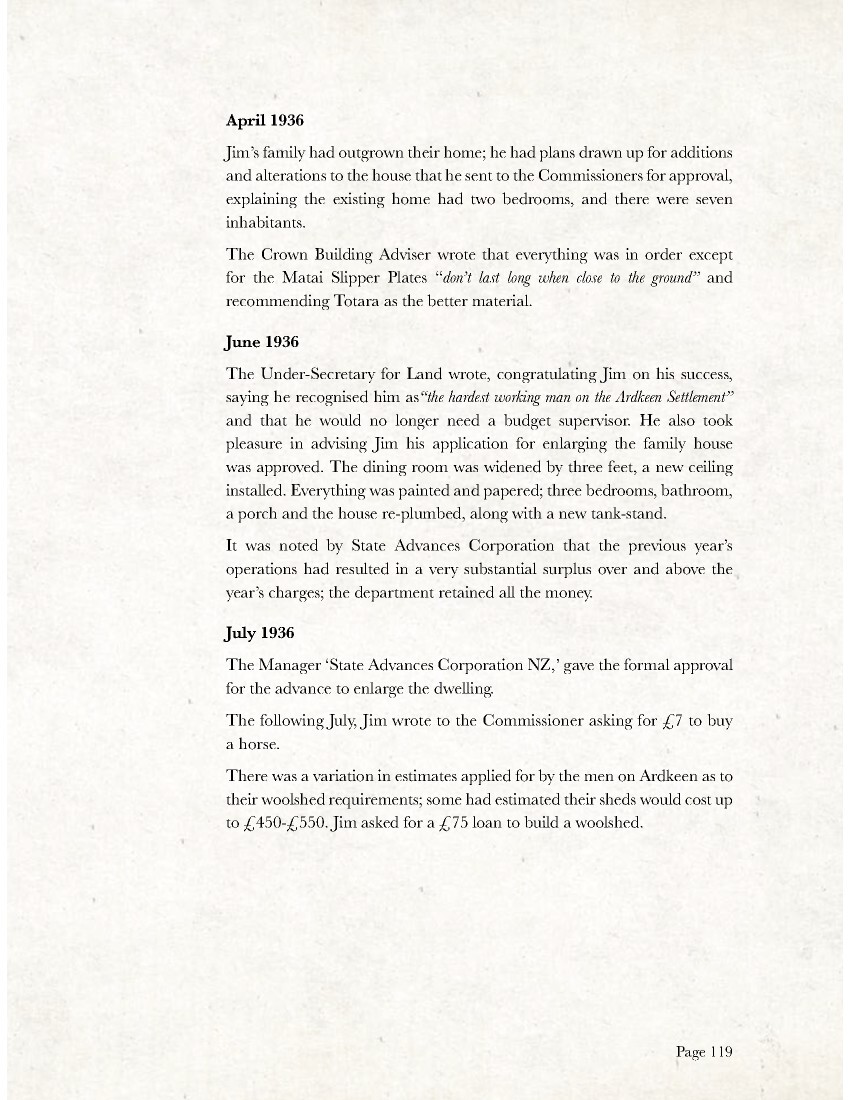
Page 120
August 1937
Returned livestock figures to the department:
700 ewes
230 hoggets
20 rams
70 cows
12 two-year heifers
40 M. S. yearlings
5 dairy cows
10 two-year-old dairy heifers
3 bulls
The trading account was in credit £529
Calves were of no value and fed to the dogs.
Jim McLean was considered to be a conservative planner.
Little woolshed picture

Page 121
The Court of Review held at Wairoa
McLean’s Statement:
A married man with three boys and two girls of school-age. Returned soldier.
No pension.
My property is situated 16 miles from Wairoa on the Waikaremoana Road; the farm is 5 ½ miles from the homestead. I took up 553 acres in the Ardkeen ballot June 1920. After revaluation in 1923, the rent reduced to approximately 6 shillings per acre.
When I took up the block, there were one and a half miles of valley fencing in bad repair. I did two miles of boundary and three miles of subdivision fencing at the cost of £800.
I erected a two-bedroom house, since enlarged. I built a cowshed and another shed, a set of cattle yards, and a shed; cost of £40. I constructed a dip; £80.
I borrowed from State Advances Corporation to alter my house. House value £800
The balance used for fencing and other improvements; my labour only. I re-grassed 20 acres.
£1,100 of my own money was used to buy stock and pay the first six months’ rent. I took possession of 135 acres in 1928 at a rental of £0.08 per acre.
The property consists of 57 acres of pumice flats, balance medium to steep hills.
There is a fair amount of second growth manuka on southern faces that requires cutting every year. The community woolshed, and dip is an eight-mile drove through neighbouring farms.
I shear my sheep in my neighbour’s woolshed.
The distance from the homestead is a disadvantage.
The stock route, I fenced myself, runs on one side through the middle of the property; is a disadvantage. Even with the highest care, I lose and mix my stock.
Fences, and yards are in good order.
1 ½ mile of boundary fence needs repair, estimated cost £18. I estimate £70 for cutting regrown manuka this year.
Property is well watered.
I work the property without help. However, if I am to continue milking, I must employ a man full-time.
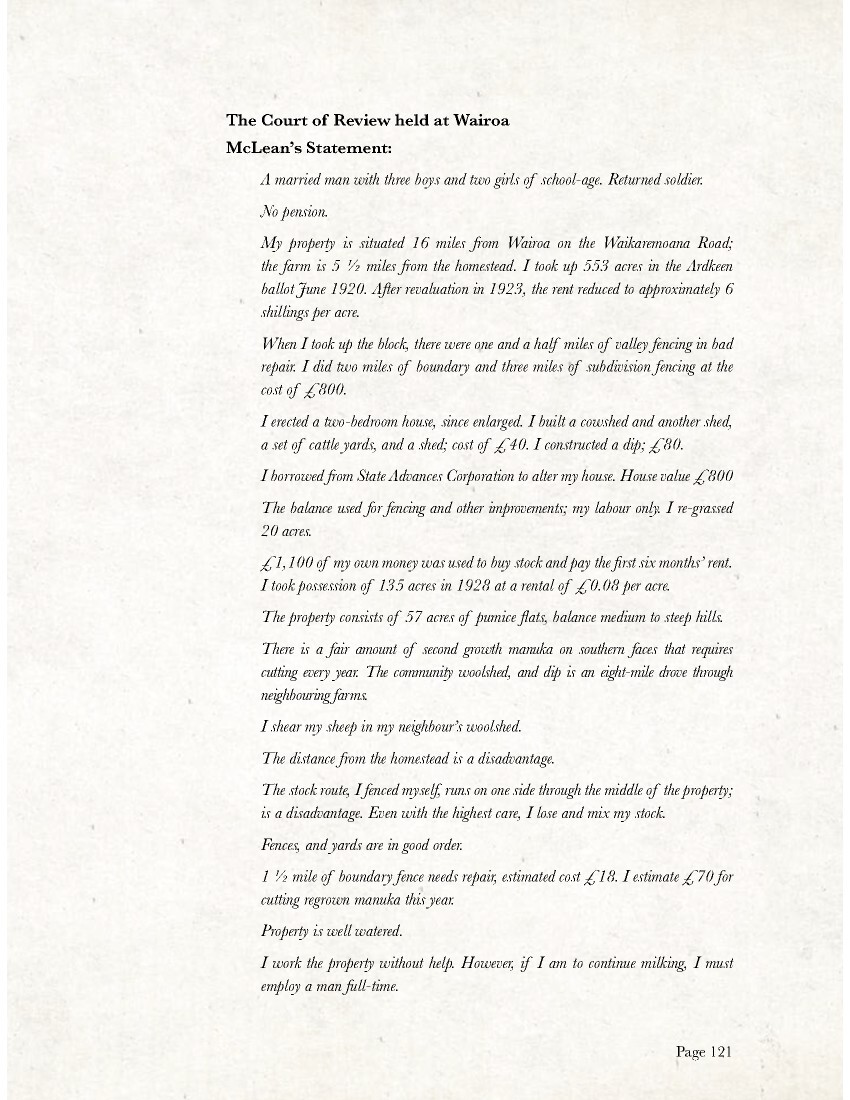
Page 122
Summary:
The applicant has been running a mixed farm without permanent labour.
He is entitled to employ labour however, had he done so, there would have been no trading surplus but considerable debt. Do not penalise the applicant for his efforts
23 January 1939
Jim McLean expressed a wish to have his stock security released; his account was in credit
Mr and Mrs McLean
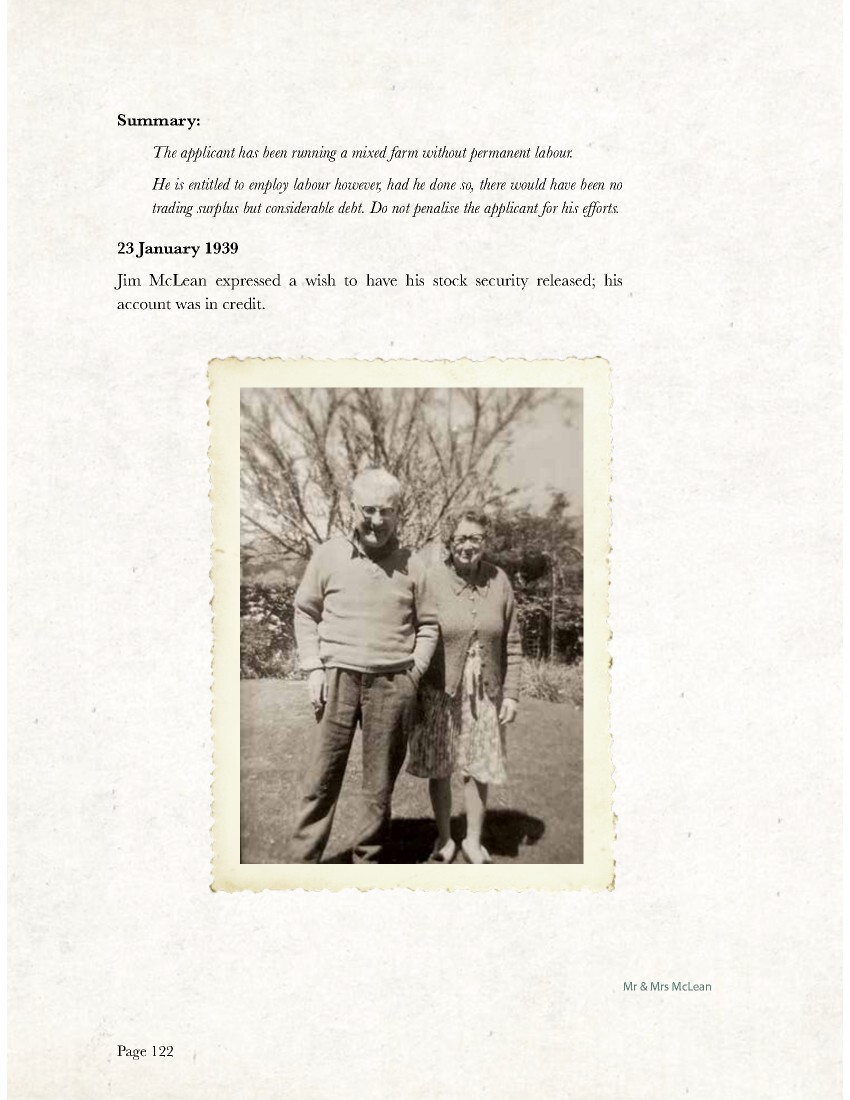
Page 123
RECENT HISTORY
The McLean farm Section 7s is the only Ardkeen Soldier-Settlement farm that remains in the family today; Airlie, Jim’s daughter and husband Doug Maxwell bought the farm from Jim McLean in 1968, moving into the homestead. Airlie and Doug Maxwell raised five children.
Doug died in 2016.
29 April 2021; Airlie sold the farm to David Hayward and Kate Standring. Airlie continues to live in the original homestead.
The Carson farm, Lot 13s is owned by their son, and farmed together with Lot 7s by Douglas.
Mr and Mrs McLean bought Jim Tolme’s homestead section on Lake Road as their retirement home.
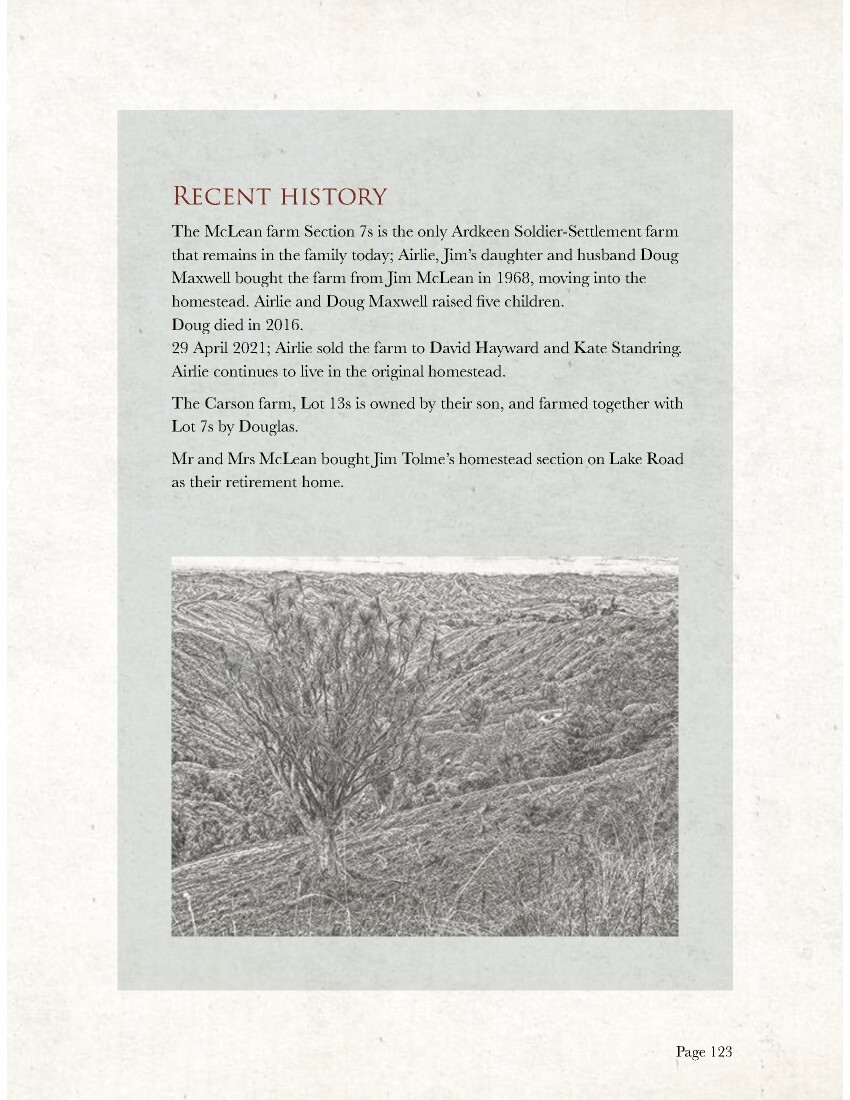
Page 124
MAURICE PATRICK MALONE (D. C. M.)
MILITARY SUMMARY
Date of Birth: 25 May 1895 37
Place of Birth: Stratford
Parents: William George and Elinor Lucy Malone née Penn
Next of Kin: Brian Malone, brother, Stratford
Last NZ Address: Stratford
Marital Status: Single
Occupation: Farmer
Employer: W G Malone, Stratford
Regimental No: 11/1338 Rank: Lance Corporal
Death: 16 January 1926 Hastings
Buried: Hastings Cemetery
Awards: Distinguished Conduct Medal (D.C.M), 1914-15 Star, British War Medal, Victory Medal
Other service: 13th Canterbury Territorials and Wellington Mounted Rifle Territorials
1915
19 Apr: Enlisted at Trentham with Wellington Mounted Rifles 6th Reinforcements B Squad as Trooper
26 May: Promoted to Lance Corporal
29 May: Admitted Trentham Hospital – measles
10 Jun: Discharged from hospital
14 Aug: Embarked from NZ on board HMNZT28 Tofua 1
9 Sep: Disembarked Suez, Egypt
37 Date of birth on military file is given as 25 May 1894
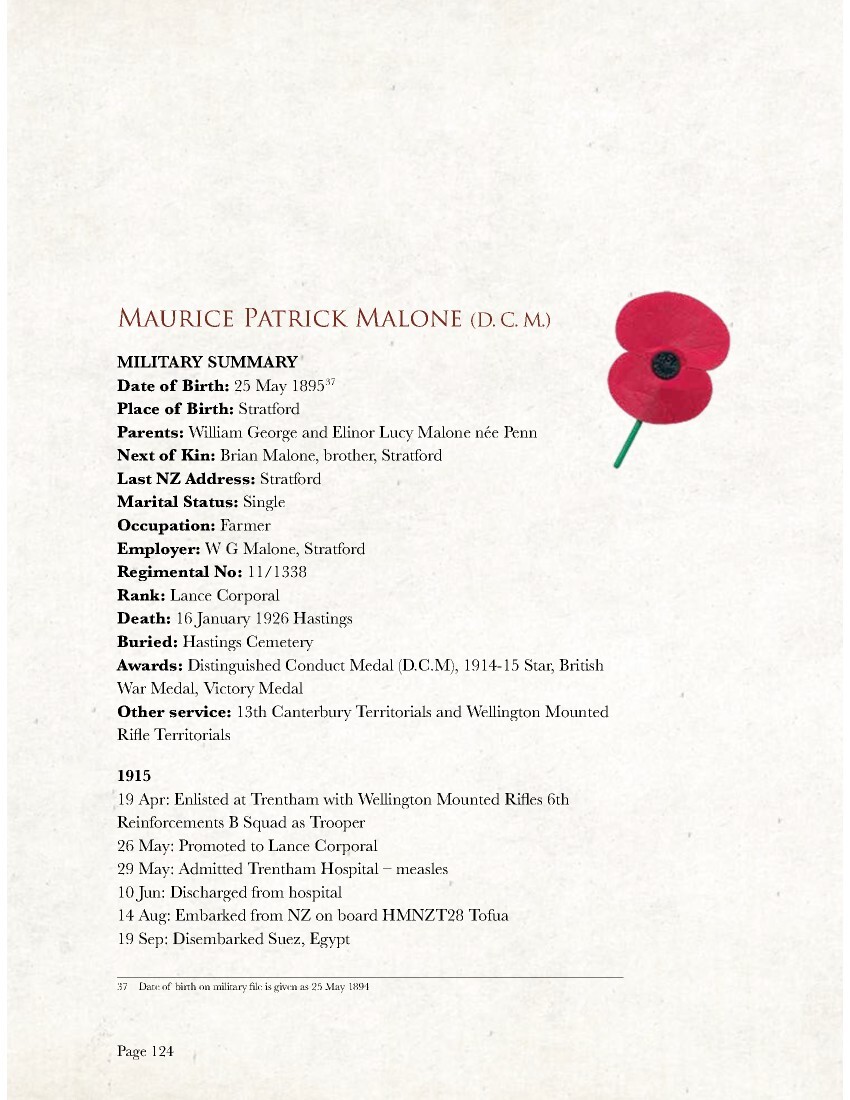
Page 125
21 Dec: Promoted to Sergeant at Zeitoun
1916
10 Jan: Reverted to Lance Corporal
23 Jan: Left Zeitoun for Suez Canal
15 Jul: Transferred to NZ Mounted Rifle Brigade Machine Gun Squadron at Bir et Maler.
1917
28 Jul: Appointed Temporary Corporal
15 Nov: Promoted to Sergeant
25 Nov: Wounded in action at Auja, Palestine [Battle of Jaffa]. Admitted NZ Mounted Division Field. Ambulance – gunshot wound right foot – slight
27 Nov: Awarded Distinguished Conduct Medal (DCM)
28 Nov: Admitted 45th Stationary Hospital at El Arish,
30 Nov admitted 44th Stationary Hospital at Kantara, Egypt,
01 Dec admitted 27th General Hospital at Abbassia
1918
19 Feb: Transferred to Aotea Convalescent Home at Heliopolis
19 Mar: Classified C Class by Medical Board – sent for change in NZ. Patient is very lame. Metatarsal-Phalangeal joint of big toe (right foot) is stiff due to injury. Complains of considerable pain on walking
11 Jul: Embarked for NZ on board Hospital Ship Port Darwin from Suez 27 Aug: Disembarked Wellington from S.S. Moeraki
1919
03 Jan: Discharged no longer physically fit for war service on account of wounds received in action
Total Service: 3 years 260 days (including 3 years 15 days overseas)
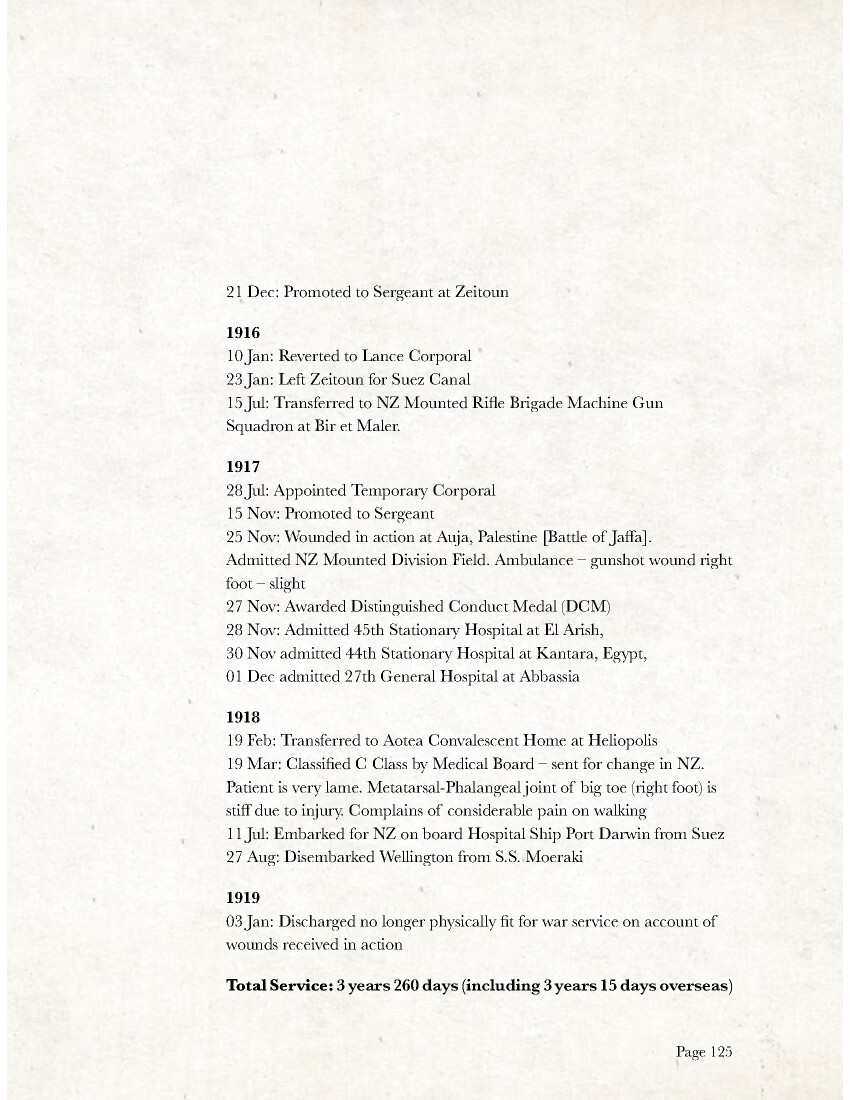
Page 126
LAND BALLOT
Ardkeen Section 8s, 581 acres
Ballot awarded to: Maurice Malone
December 1920
Maurice Malone wrote to the Commissioner about building a house on his Ardkeen Homestead section. He told the Commissioner the cost would exceed the advance of £350 allowed. Maurice said he would pay the extra cost himself and provide a security over the entire amount and expressed his hope the Board would approve his application.
December 1920
The Commissioner replied he had received plans from the Public Works Department saying an advance of £350 would be made when the building had been completed, and that progress payments could be made if required. He further advised it would be necessary for Malone to insure the building in the name of the Commissioner of Crown Lands.
“I approve plans and specifications in their present form. …Commissioner” September 1921
Maurice insured the dwelling for £800 and asked that Dr Paget of Palmerston North, his father-in-law be sent copies of expenses relating to the new house.
November 1923
Maurice wrote to the Commissioner that he had incurred considerable expense having to send his wife away for an operation; now he was short of money to carry on with essential fencing.
February 1924
Maurice was three years behind with his rent and awaiting a revaluation of his farm; the department had become impatient, advising a revaluation would have no bearing on the amount owed. The Commissioner suggested, “for the sake of argument: “if the farm is overvalued by 50%, Maurice should have paid 50% of the outstanding rent”.
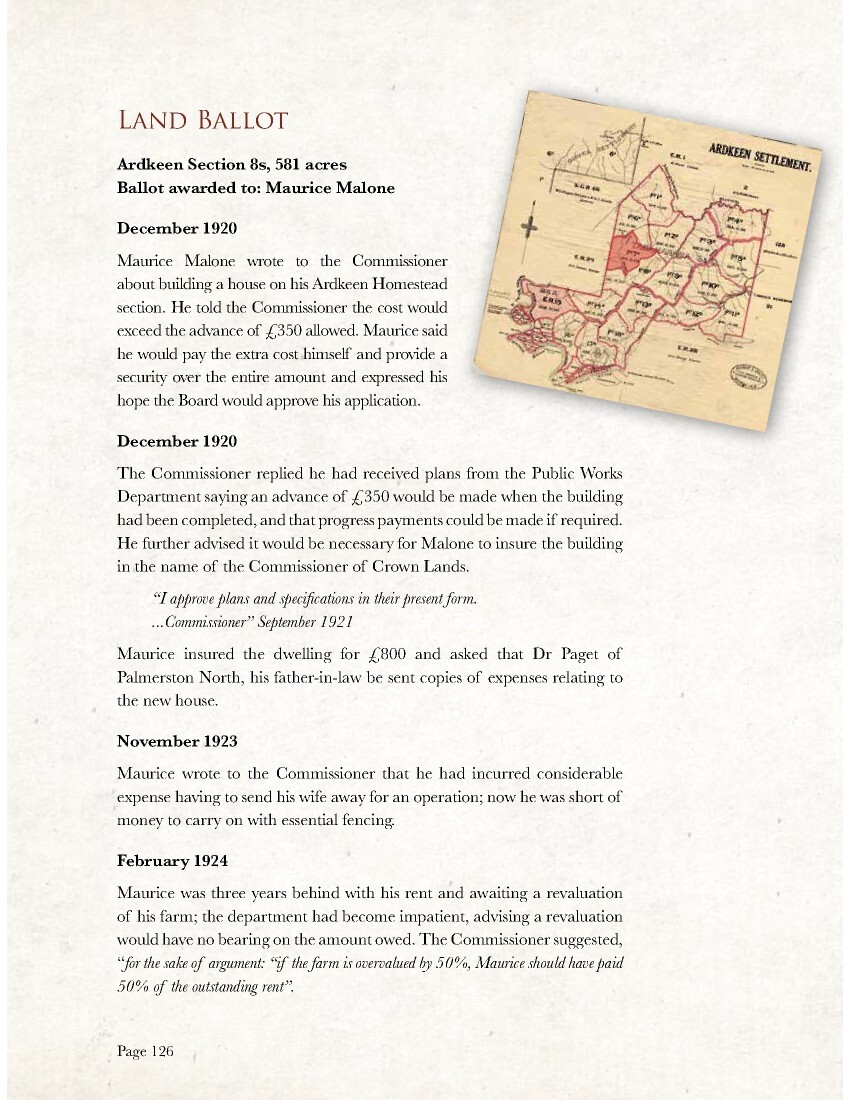
Page 127
A revaluation would date back to 1 July 1921, and the Board proposed allowing a margin beyond the imaginable limit of a reduction in capital value requiring 25% of arrears to be paid on or before the date of the next board meeting in March.
Maurice’s lease was at risk of forfeiture if it was not paid. The department would not allow anyone to retain possession of Crown Land without paying rent, or such portion of rent to be considered reasonable according to time and circumstance.
April 1924
Maurice again wrote to the Commissioner about the overdue rent due up to June 1921, asking if the Board would accept instalment payments, with one paid immediately and the next on January 30, 1925. He wrote:
“It is extremely difficult to borrow such a large amount of cash at present owing to the heavy expenses incurred by both my wife and myself having to go undergo operations for appendicitis within the last five months.”
Maurice Malone homestead
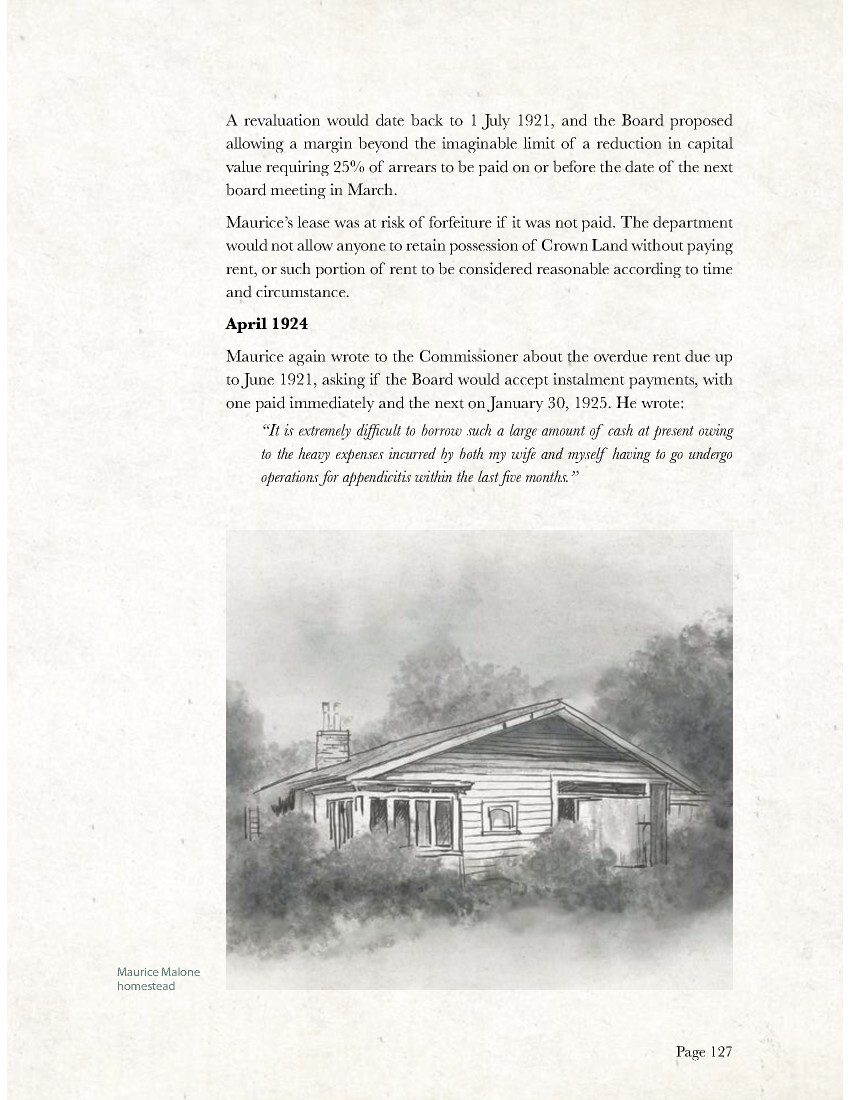
Page 128
May 1924
Crown Lands Ranger notes:
Insufficient area
Tenant overstocked by 300 sheep
Good worker-has gained some useful experience.
Board had recommended forfeiture for non-payment of rent:
Malone’s improvements were value; £1,042
Land exclusive of settler’s improvements; £5,610
Reduce capital value by; £1,540
Postpone arrears of rent; 30 June 1920 for 7 years. 16 July 1925
Dwelling and out buildings value £1,000
Fencing 150 chains at 45/-; £337.10
Original fencing; £165
44 chain of new fence; work in progress: at 45/- per chain.
Stock:
600 ewes
200 hoggets
40 killers
50 breeding cows
16 weaners
40 mixed sex 18-month cattle
3 horses
Maurice Malone had two years at agricultural college.
Prof T. A. Hunter observing in 1919 that the existing settlement programme did not provide proper training; farming was still looked upon as an unskilled occupation. Ambivalence summed up the attitude of all parties involved in the training of soldiers for postwar vocations and it was clearly seen in the farm training that in no way matched the effort of the Government to provide land or discharge soldier settlers. 38
38 Gould, A.N (1992) Proof of Gratitude, p. 65.
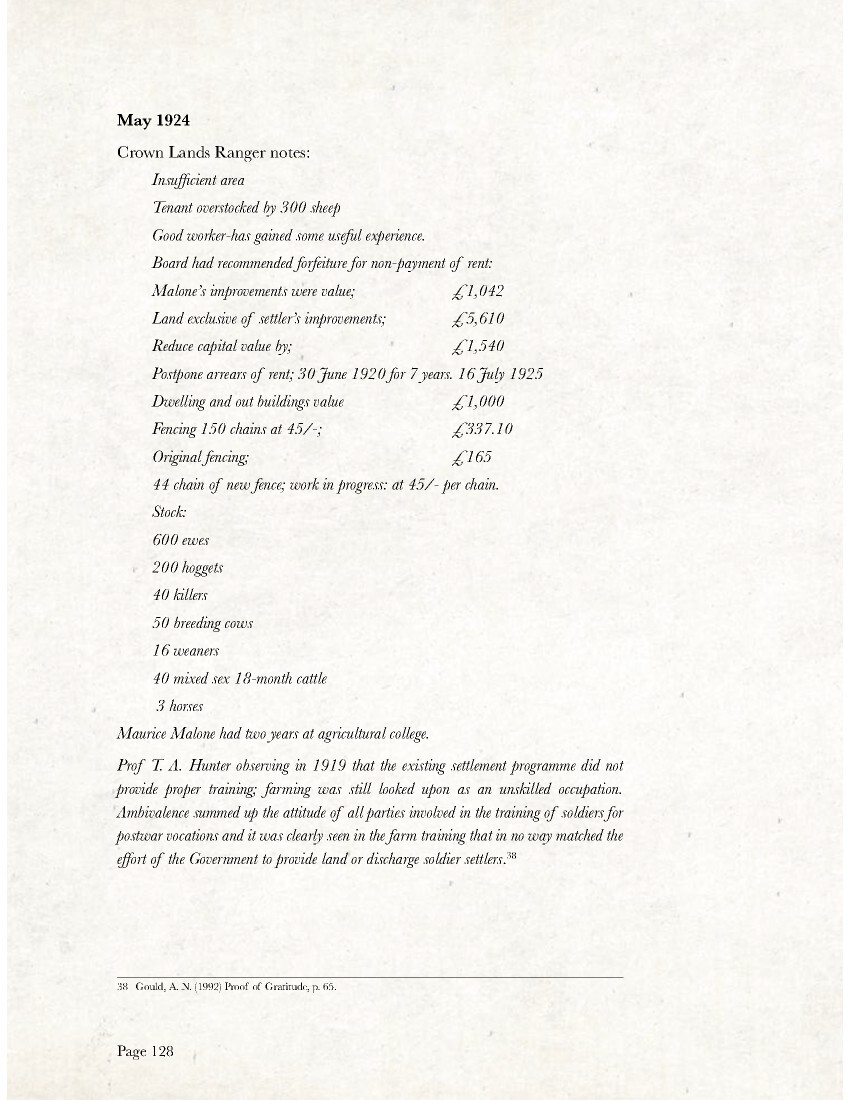
Page 129
25 February 1926
… Headlines in NZ Truth
SHOULD MEDICAL DIRECTIONS BE MORE SPECIFIC? SETTLER’S TRAGIC MISTAKE
Maurice died on 16 January 1926 while visiting Hastings with his wife. He was suffering from haemorrhoids (piles). Dr Jardine another highly decorated World War One veteran of Wairoa had prescribed an ointment containing morphine, stramonium and belladonna, to be used externally. Verbal instructions had been given by the doctor but in 1926 full and explicit directions were not placed on medical containers. Sadly Maurice had taken the ointment, in a collapsible tube, orally. The inquest found that he had died from morphine and belladonna poisoning.
Maurice, then aged 30 was buried in the Hastings Cemetery. In 1928 Moana married Leonard Jack Harley and died in 1985 in Auckland.
July 1926
Mr R. Davies Accountant replied to a letter from Doctor Paget, father of Maurice Malone’s wife Moana. Mr. Davies expressed his sadness at seeing the “little house empty”, and the circumstances surrounding it, agreeing the farm was too small, and too distant from the homestead whilst noting that Malone had invested a £1,647.4.11 legacy from his father’s estate in the property. Now, with the estate being insolvent, this money would revert to the Crown when the lease is forfeited in lieu of unpaid rent and interest.
Mr Davies recommended the principal liabilities to the Crown be disposed of and arrangements made with creditors from the remaining assets, failing this Mrs Malone should disclaim all responsibility.
OBITUARY.
MR MAURICE PATRICK MALONE.
A resident of Frasertown, Mr Maurice Patrick Malone who, with his wife, was on a visit to Hastings, died there suddenly on Saturday.
The late Mr Malone was a soldier settler, and was 30 years of age. He was one of a family which bore a splendid war record. His father, a prominent solicitor in Taranaki, left with the Main Body, and as Colonel Malone, Brigadier of the Wellington Regiment, was killed at Chunak Bair on the day of the famous landing at Suvla Bay. His eldest brother left with the Main Body, and was later killed in France; the second brother was with the first land contingent at Samoa; he and his remaining brother were wounded in Palestine and France respectively, while his only sister drove a motor ambulance in London. After being invalided home he was under treatment for some time and on demobilisation drew an allotment at Ardkeen, Frasertown, Wairoa. About five years ago he married the second daughter of Dr Paget, of Stratford. He is survived by his wife and one little girl. The funeral took place at Hastings, the pall-bearers being his fellow-settlers from Ardkeen.
New Zealand Herald,
Volume LXIII,
Issue 19230,
20 January 1926,
Page 10
[https:]//paperspast.natlib.govt.nz
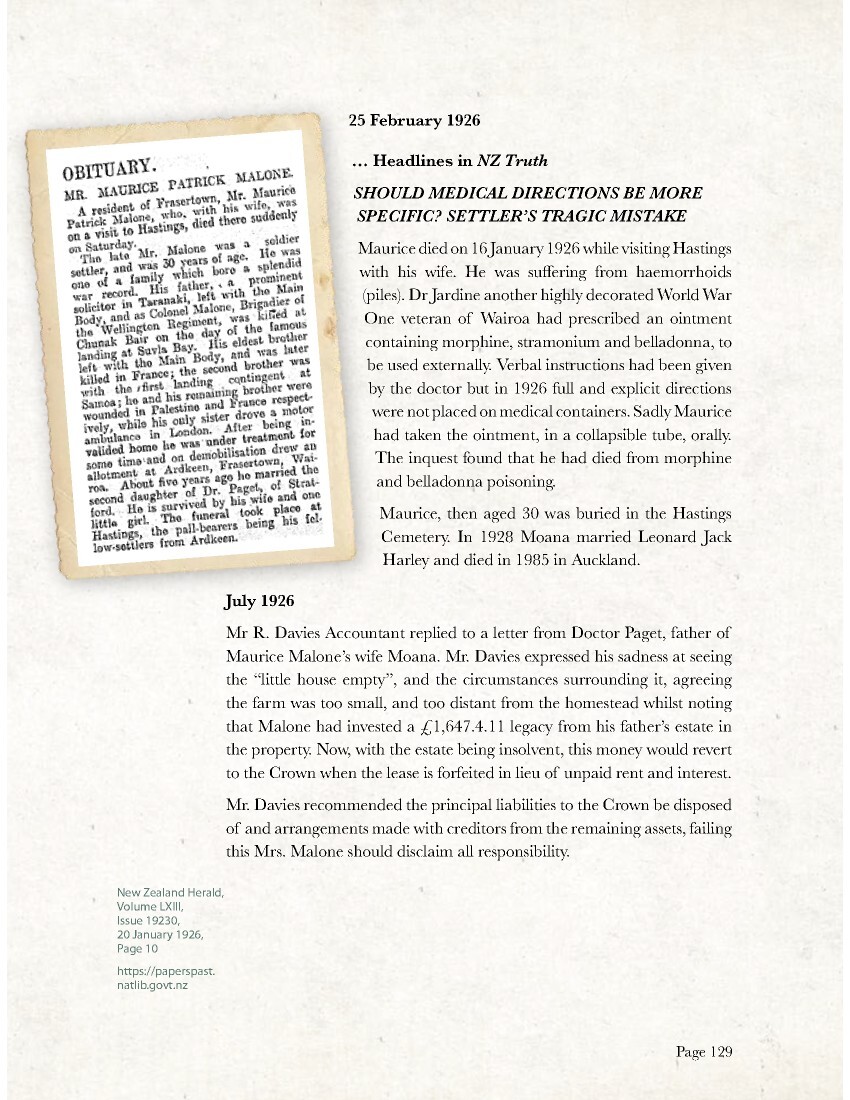
Page 130
July 1926
Cowper Rapley and Rutherford Solicitors Dr Paget
Health Department Wellington Estate: M.P. Malone deceased.
We are enclosing a rough statement prepared by Mr. R. Davis, Public Accountant of this town, which we think correctly sets out the financial position of the estate.
From this you will note Mrs. Malone, widow of the deceased, will find it difficult to carry on especially with regard to the unsecured debts and arrears due to the Crown for rental and interest.
We think if the unsecured creditors were prepared to give reasonable time for payment of their accounts and if the Crown was prepared to write off arrears of rent and interest owing under the lease and mortgage, having regard to past workings of the property, there would be a reasonable prospect of Mrs Malone both saving the capital that has been invested by her husband and herself in the venture, and of paying debts she has been left with.
We think it will be conceded and certainly can be proved that the late Mr. Malone made every effort not to spare himself in any way to make good.
The statements furnished to us and the accountant show that Mr. Malone and his family cut the living expenses to a minimum.
Had Mr. Malone lived, there would have been every prospect of his eventually meeting his liabilities and making the place pay.
His sudden death has saddled his widow and child with a heavy burden, without assistance from the Crown and various creditors, they could find themselves destitute.
Having regard to the circumstances, and the fact that Mr. Malone served in the war, along with his father, the late Col Malone, killed at Chunuk Bair, Gallipoli, we suggest asking the Minister of Lands to write off all arrears of rent and interest.
If this was done, we would advise that the possession of the estate be placed before the creditors with a view to time being given for payment of their various accounts.
In the meantime, we advise that the matter of the administration of the estate be held over.
Yours faithfully
Cooper Rapley and Rutherford
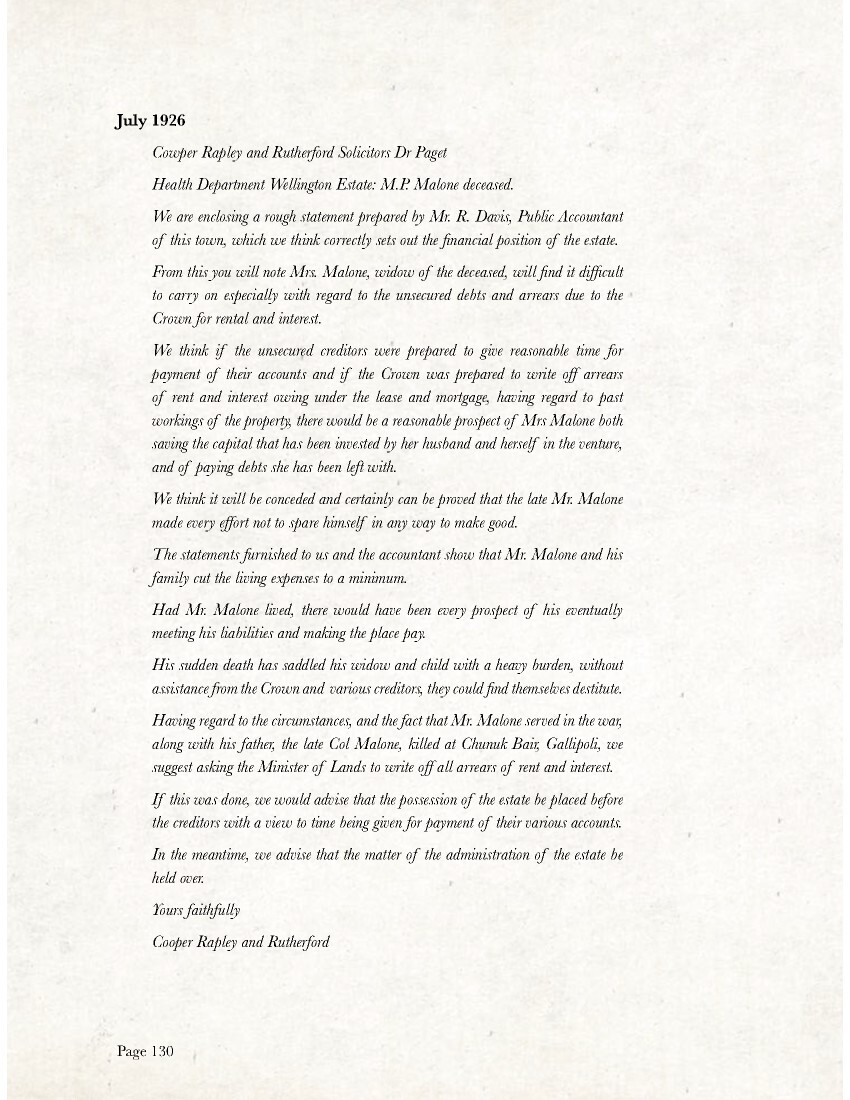
Page 131
4 August 1926
I have been asked to look into the estate of Mr. Maurice Malone, Ardkeen, Wairoa.
You will perhaps remember he died very suddenly; the estate has been left considerably in debt, it is suggested if the Crown write off the amount owing for interest, Mrs. Malone would carry on, failing this she will have to leave the place.
The sad circumstances surrounding the death of Mr. Malone will be remembered, it would be a great act of kindness if something could be done for the widow.
Mr. Malone invested over £2,000 on the property, if Mrs. Malone has to leave, she will leave penniless. I trust you will give the matter your consideration and provide the assistance asked for.
Yours faithfully Minister Parliament
P.S. Mr. Malone gave service at the war, his father the late Col. Malone gave his life for our Country.
1926
A Memo notes:
Sharing the Estate of Maurice Malone between three good men; Spooner, who did not have a house, and would get a bargain as will be seen from Mr. Robertson’s report; Value of Improvements of Malone’s Homestead, with Bill Carson and Jim Tolme sharing section 8s.
E. N. Faure
Commissioner of Crown Lands
October 1926
Moana Malone advised she was unable to remain on the farm.
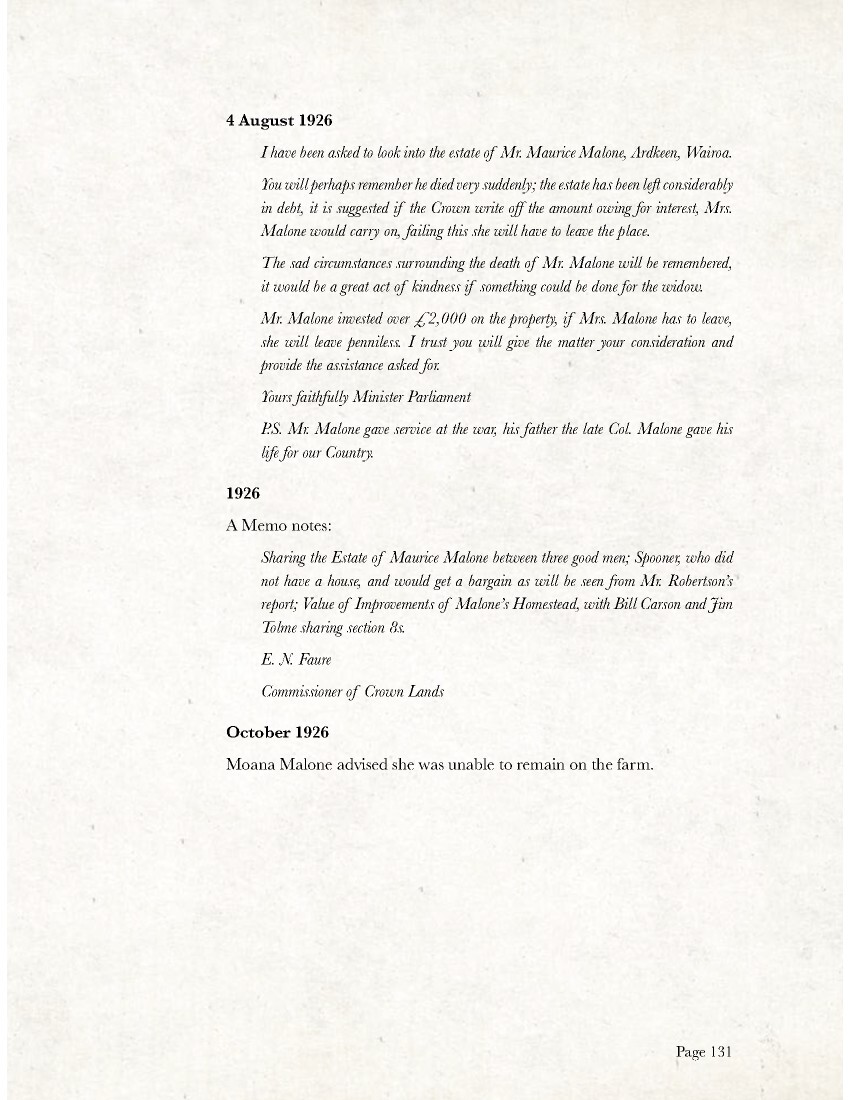
Page 132
December 1926
Under-Secretary for Lands Late Malone’s Estate
With reference to your letter 13 August, Mrs. Malone has made arrangements to dispose of her interest in the lease to three existing Ardkeen settlers.
I enclose the necessary recommendations for subdivision and transfers of Malone’s holding.
The matter has been carefully looked at by the Inspector and the Chief Clerk; it is an admirable solution for Mrs. Malone and the three settlers.
As far as making further advances to these men for taking over Malone’s interest is concerned I would advise that if the proposed subdivisions and transfers are approved the Land Board will make separate recommendations. The existing mortgage to Malone will be discharged and fresh mortgages registered against the three new leases. Each of the areas proposed to be Tolme, Carson & Spooner adjoins their respective holdings. In Tolme’s and Carson’s cases there will be an immediate increase in revenue without further capital charges.
Maurice Malone had a three-year-old daughter at the time of his death.
Photo caption – Maurice Malone mail box and entrance

Page 134
JAMES TOLME (JIM)
MILITARY SUMMARY
Date of Birth: 24 August 1886
Place of Birth: Clinton
Parents: Donald Allan and Isabella McArthur Tolme née Cameron
Next of Kin: Mrs. Isabella Tolme, mother, New Plymouth
Last NZ Address: Frasertown
Marital Status: Single
Occupation: Shepherd
Employer: F McRae, Frasertown
Regimental No: 25649
Rank: Private
Death: 13 July 1966 Wairoa
Buried: Wairoa Cemetery
Awards: British War Medal, Victory Medal
1916
26 May: Enlisted at Trentham and posted to 17th Reinforcements G Company as Private
30 May: Attestation signed at Trentham Camp
30 Jul: Admitted Featherston Military Hospital – measles
07 Aug: Discharged from hospital
25 Sep: Embarked from Wellington
21 Nov: Disembarked at Devonport, England. Marched into Sling Camp, Bulford, Wiltshire
1917
07 Jan: Marched out for France with 3rd NZ Rifle Brigade as Rifleman 09 Jan: Marched in to Etaples
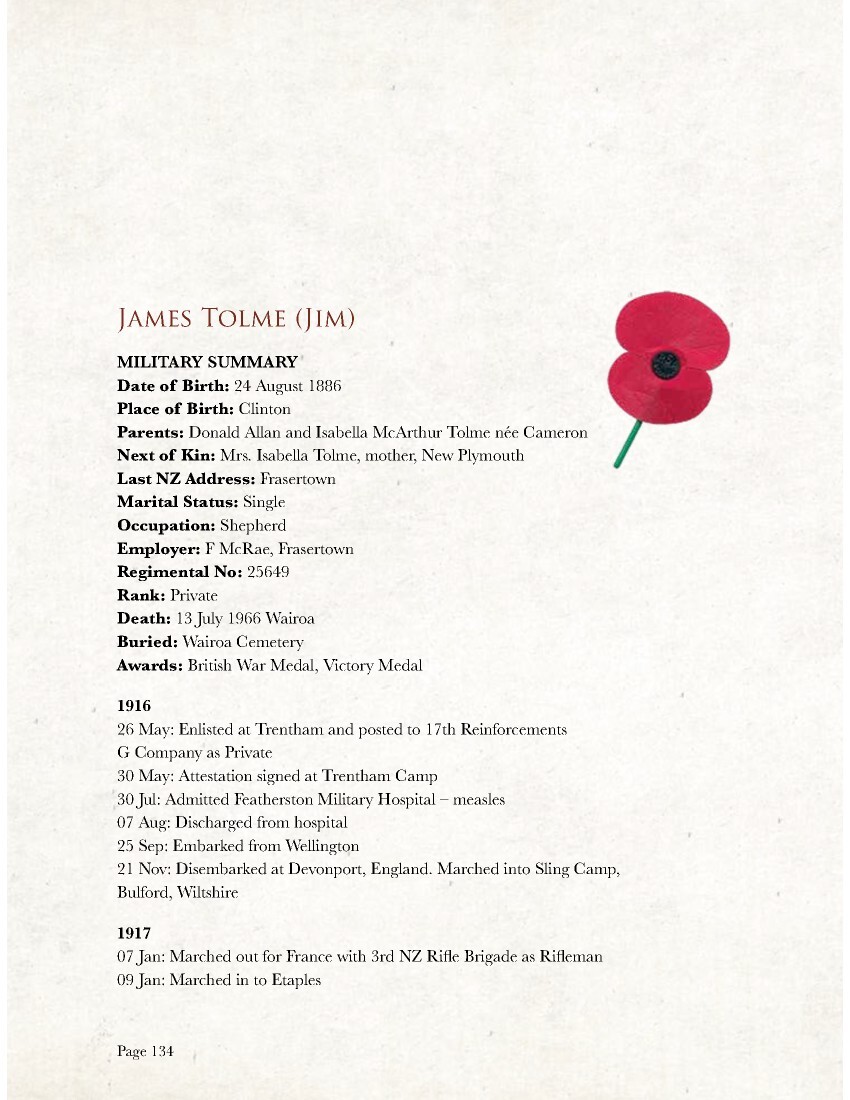
Page 135
05 Feb: Joined 2nd Battalion 3rd NZ Rifle Brigade and posted to C Company
12 Mar: Attached for duty with NZ Working Battalion
07 Jun: Wounded in action – gunshot wound to right heel. Admitted 9th Australian Field Ambulance. Admitted 2nd Australian Casualty Clearing Station
09 Jun: Admitted 26th General Hospital in the field
1 Jun: Transported to England. Admitted 1st NZ General Hospital, Brockenhurst
26 Jun: Admitted NZ Convalescent Hospital, Hornchurch 18 Aug: Marched into NZ Command Depot, Codford, Wiltshire
29 Sep: Admitted 1st NZ General Hospital, Brockenhurst – nasal obstruction
17 Oct: Marched into NZ Command Depot, Codford, Wiltshire
1918
1 Jan: Marched into NZ Rifle Brigade Reserve Depot at Brocton, Cannock Chase, Staffordshire
20 Jan: Admitted Military Hospital, Cannock Chase Rugeley Camp – deafness
18 Feb: Discharged from Cannock Chase
20 Feb: Admitted 3rd NZ General Hospital, Codford
28 Feb: Admitted 1st NZ General Hospital, Brockenhurst – myringitis right ear
17 Apr: Classified unfit by Medical Board and placed on NZ Roll – defective hearing. Five years ago noticed that hearing was getting dull. Had medical advice, throat treated but made no improvement in hearing.
Has gradually diminished since then, but he noticed greatest change after arrival in England – from cold. Aggravated by service during the present war.
Classified C2 PB on account of hearing. General health excellent
30 May: Embarked for NZ on board Mokoia from Plymouth
12 Jun: Mokoia – detailed to shift coal from hold to bunkers – entitled to extra duty pay for two days
16 Jul: Disembarked NZ. Issued sick leave certificate until 22 July
12 Aug: Discharged no longer physically fit for war service (defective hearing)
Total Service: 2 years 79 days (including 1 year 294 days overseas)

Page 136
LAND BALLOT
Ardkeen Section 9s, 629 acres
Ballot awarded to: Jim Summer Tolme
Prior to enlisting Jim Tolme worked on Spring Hill Station for Mr. Farquhar McRae; Mr. McRae loaned Jim £1,000, plus Jim had £1,000 of his own. Jim never missed a payment throughout his tenure.
1920 – 21
Jim advised the Commissioner he planned to build a 12’ x 16’ whare on his back section
When Jim took possession of the farm, he was allotted 400 fence posts that were stacked near a creek, however 200 were swept away by a flood in January 1922. Ranger Robertson was asked to investigate; he was satisfied Mr. Tolme had not taken the posts, saying there had been great care taken with the supervision of fence post-splitting, and the allotment of the 22,145 fence posts, over the past two years. Fence posts were split and stacked in heaps that were numbered by the splitting contractors. The Crown Lands Ranger would inspect and allot the fence posts to the settlers.
30 March 1918 there were 30 Crown Land Rangers spread over the country, responsible for 34,000 Crown tenants. Supervisors were given cars, enabling them to travel more quickly around. 39
October 1923
Jim wrote to the Commissioner that he was having trouble getting replacement livestock. Saying his section was too small to enable him to keep his replacement ewe lambs and his rent was too high, drawing attention to the fact that his two sections were seven miles apart. He said there had been no grass growth from the end of May until the first week of October and he had to reduce livestock numbers each month to get through. He could have planted mangles or turnips to see him through the winter, perhaps even carrying another hundred sheep, if the homestead section had been attached to his hill block.
39 Gould, A. N. (1992) Proof of Gratitude, p. 198 /200.

Page 137
The Commissioner noted Jim Tolme had one of the best farms on the Ardkeen settlement and he was one of the better farmers.
November 1924
Jim wrote to the Chairman of the Dominion Revaluation Board, saying he was satisfied with the valuation of his farm, however he was dissatisfied with the remission of arrears. Jim pointed out that he was one of two settlers who was current with their rent. The remaining sixteen settlers had received a four-year remission. He said he had worked for other farmers to make ends meet.
He had read in the newspaper that a member of the Land Board was quoted as saying; ‘nothing would be done to make the man who had done his best in the field, to be seen as a fool’. Jim said he felt he had been the fool; that he had spent 20 years farming in the district and failures were due to overstocking and bad management, not the high value of the land.
Jim did not want a remission of rent, however because the settlers had asked for relief in November 1924 the Under-Secretary wrote seeking an application from Jim Tolme to have his rent postponed. This was not because it was outstanding, but because he believed it was right and just and he should be granted the same concessions extended to other settlers on Ardkeen.
The Board considered the application along with the others and resolved to recommend that the Minister grant Mr Tolme a remission of rent for a total of two years including the postponement offered by the Land Board.
The Minister approved.
Tolme’s case was similar to Andrew, whom the Commissioner recommended be treated similarly. The Board was of the opinion that Mr Tolme should enjoy the same concessions as the other settlers on Ardkeen.
December 1924
The Commissioner wrote of his appreciation for Tolme’s diligence and hard work.
December 1925
Jim Tolme wrote to the Commissioner about building a house.

Page 138
May 1926
Jim Tolme wrote to the Commissioner about fellow settler William McKay leaving his section, asking if he could graze his stock on the land.
October 1926
Jim wrote to the Commissioner regarding a conversation he had had with William McKay about taking over his land; Jim asked for a statement of McKay’s affairs saying he had some figures, but wanted the Commissioner’s figures for comparison. He also asked, if a transfer was granted, who would the liabilities be transferred to?
At about the same time, Jim learned that Moana Malone, the widow of the late Maurice Malone was leaving Ardkeen. Jim had previously made a provisional agreement with Moana’s father, Dr Paget, about taking over part of the Malone Section 8s and was asked to sign an Application for Consent to Transfer.
October 1926
The Commissioner wrote to Jim Tolme that he would provide a statement showing Mr McKay’s liabilities provided Mr McKay agreed in writing. As far as the question of a transfer was concerned, he was told it was for the Land Board to approve all transfers, along with the Minister’s consent. The Commissioner did not think the Board would agree to the entire section being transferred to one settler, as Mr Jackson had tried to transfer his section to Mr Matson and the Board had refused that request.
As to the transfer of liabilities, the Commissioner said the Board would need to consider the matter first, recalling when the forfeiture of McKay’s lease was considered some months previously, he had received inquiries from Messrs Andrew, Robertson and Tolme about the section. He said the Board could not sanction the transfer of the whole of a section to one man.
The Commissioner expressed his sadness that Mr McKay was thinking of giving up; he had been under the impression he would get on his feet eventually.
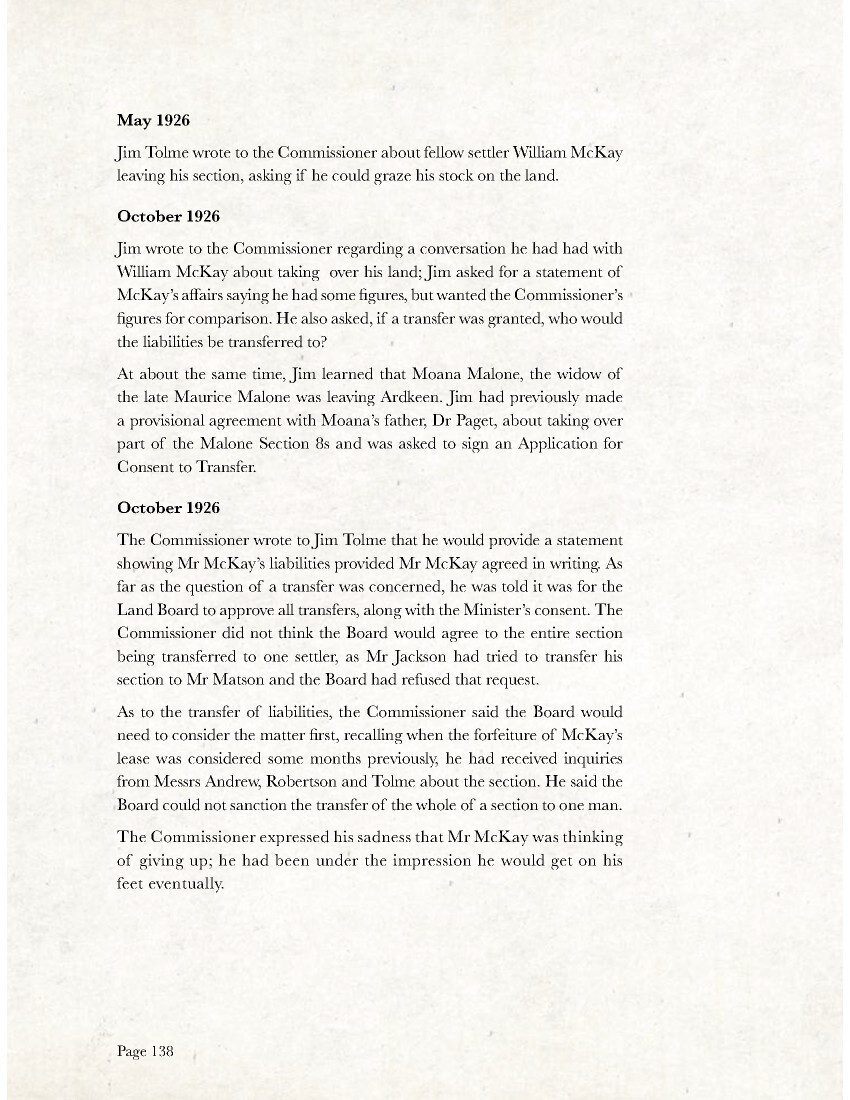
Page 139
For many soldiers the war experience and the trauma of combat had temporarily left them with little initiative; they required time before being able to make life direction decisions; soldiers had only scorn for those, in or out of uniform, whom they thought were shirkers. 40
December 1926
Jim advised that he and Bill Carson wished to divide the Malone farm between them; they would pay £1,100 for the improvements between them. This worked out at £2 per acre; Jim would take 314 acres and pay £800, this being sufficient to pay one year’s rent and to purchase the necessary stock. A new lease was drawn up showing 1 March 1927 as the takeover date.
February 1928
Jim wrote to the Commissioner that he would like to exchange his homestead section for McKay’s homestead section, if it became vacant.
October 1928
Jim learned the Land Board would agree to transfer 40 acres of McKay’s homestead section to Jim McLean for £350, including improvements.
November of 1928
Jim agreed to sell the homestead section to his neighbour Jim McLean and would take 40 acres of McKay’s homestead section, provided the exchange was of equal value.
August 1929
Jim Tolme wrote to the Commissioner about the Wairoa Electric Power Board charging rates over his entire farm. He understood the Board had gone some of the way towards separating the farm titles from the homestead titles to resolve the matter. But Jim bemoaned the fact he paid rates on his homestead section and received nothing in return.
February 1930
Jim advised the Commissioner he was grateful for the reduction in capital value of his farm, however he saw no need for further assistance from the state.
40 A.N. Gould (1992) Proof of Gratitude, p. 84.

Page 140
The prospect of revaluation did not find favour with two Commissioners. Marsh was concerned that public pressure for revaluation would push values below the level where the Crown could recover its investment, and he observed, ‘neither the Board nor the Commissioner could fairly be blamed for rental and rate arrears. “Goodness knows we tried in many cases to obtain payment, and we could not forfeit.” 41
The exchange of homestead sections was contentious, with much correspondence between Jim and the Commissioner; eventually the Commissioner conceded to Jim Tolme’s intransigence, and the transfer took place on Tolme’s terms.
41 Gould, A.N. (1992) Proof of Gratitude, p. 242.
Jim Tolme’s House

Page 141
May 1930
Just two months later, Jim wrote to the Commissioner, this time objecting to the £420 reduction of the capital value of his farm, emphasising that if he felt entitled to a revaluation, he would have signed the petition along with the rest of the settlers; he did not feel entitled, or want the value of his farm reduced.
All the farmers on the Ardkeen settlement with the exception of Jim Tolme had their capital values, and rents reduced. However, the rent charged for the Crown leases had been increased from 4½ % to 5%.
Jim refused to exchange sections at the increased rent. The matter went before the Minister, who approved the surrender of Tolme’s existing lease and grant him a fresh lease including the slightly increased area, at a rental of 4½ % of the capital value.
Jim was granted a remission of £160.13 giving him in effect the benefit of a reduction of capital value from July 1921. The amount represented the difference between the original rental of £288.18 and the amended rental of £270.
The Under-Secretary wrote to the Commissioner of Crown Lands Gisborne about the unusual situation that had arisen, suggesting the Commissioner meet with Mr Tolme, and explain the effect his refusal would have.
A memorandum noted that Jim Tolme had kept his payments up-to-date, noting it had not always been done from farm revenue, suggesting the settler had paid from capital. He was considered a good man and a regular payer.
Jim Tolme created further confusion for the Land Board because he had paid all charges; it had been difficult to understand his exact position. It was not until December 1934 that he and Mattie Andrew’s positions were fully understood by the Board.
Ardkeen was a problem for the Department following various adjustments and concessions, and it was necessary to look at further concessions, in the light of capital reductions.
When discussing Ardkeen with Field Inspector Robertson, in 1929, capital values did not require altering, although Jim Tolme was offered a £420 reduction, but declined. Mr Robertson thought a fair rental per sheep, for McLean, Tolme, Preston and Carson would be 6/-, the remaining settlers
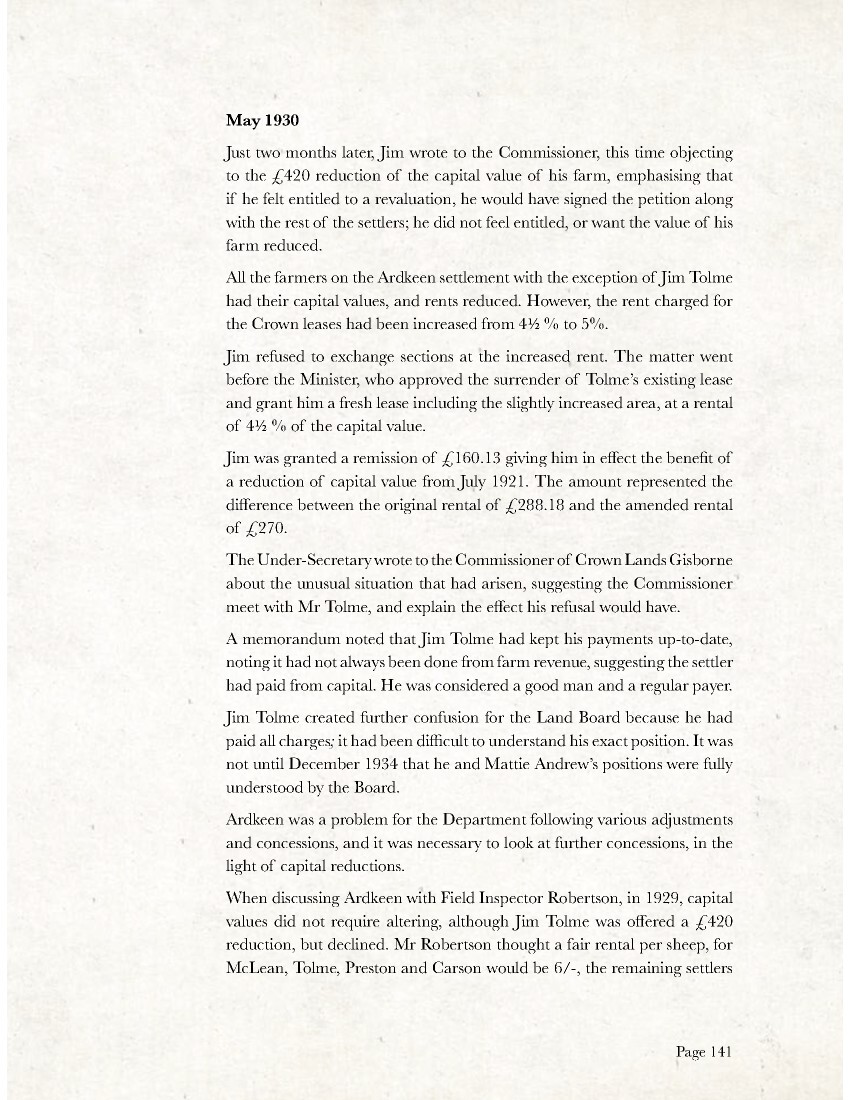
Page 142
would be set at 5/-, indicating the rentals were not in line.
With regard to a general remission, Tolme’s case was unusual; he had paid all charges to date. This posed the question; if one man could meet his commitments why couldn’t the others?
Tolme was entitled to the same consideration as the other settlers, like the other settlers, he too had suffered a loss of income as a result of the Great Depression.
Jim did not marry, but lived with his sister.

Page 143
1929-32
Throughout the depression, Jim dry-stocked his farm and went droving.
It was a life under canvas, and of relentless work, in all conditions for months at a time.
Jim was a perfectionist and arguably had the most fertile block on the settlement. He built the first house up the Titirangi, before the road was constructed, getting the material in by pack-horse.
February 1947
Jim wrote to the Deputy Commissioner asking for information about selling his farm, saying ‘Is there no-one in the Gisborne Land office capable of giving a prompt and straight answer to a civil inquiry?’, and accused the Commissioner of being “deliberately obstructive.”
A few days later Jim wrote thanking the Commissioner for his response and apologising, offering that he had no excuse for writing in such a manner, and admitting he was wrong.
1948
Jim offered his farm for sale by ballot, restricted to returned servicemen. Five WW2 servicemen entered the ballot; William Bryan Taylor from Clydebank was the successful applicant, settling on the farm in 1949.
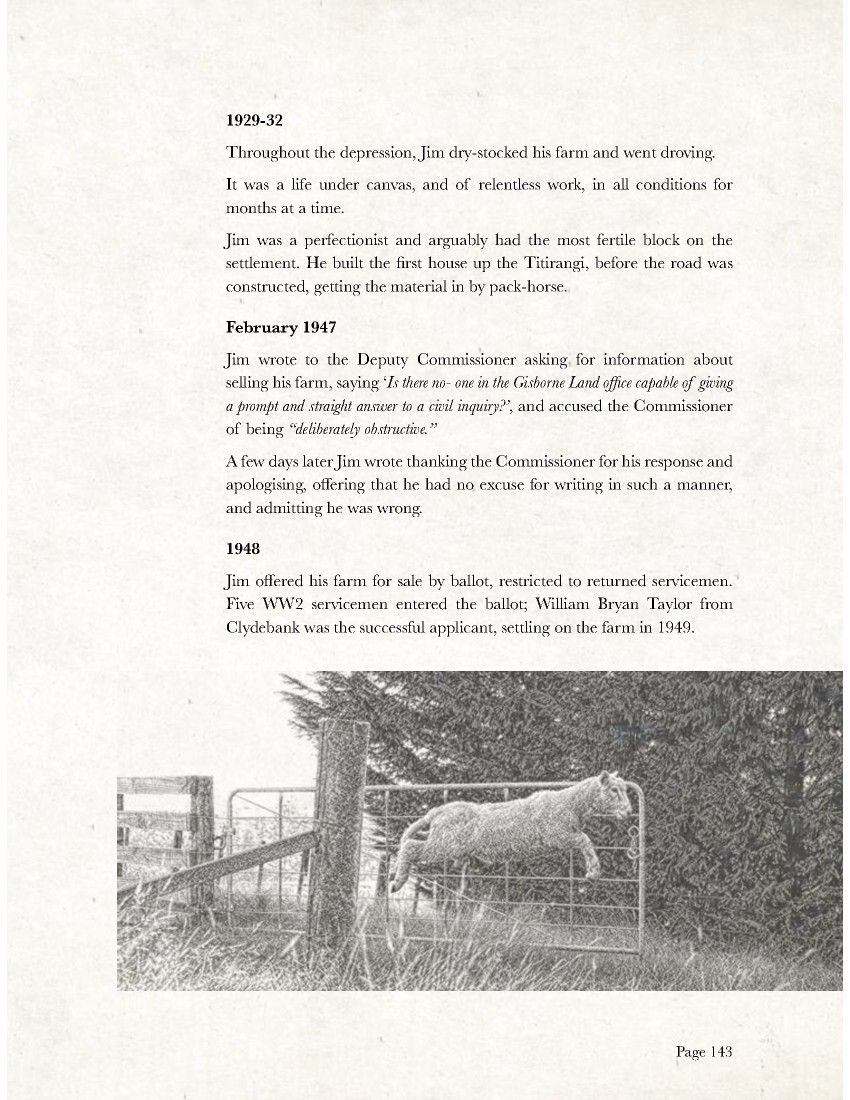
Page 144
RECENT HISTORY
After selling his farm, Jim retired to the homestead section on the Waikaremoana Road. Jim had become deaf by this time.
Bill Taylor’s Estate sold section 9s farm to Tom and Alison Carter in 1975. They sold to their son Bruce and Debbie Carter in 2005.
2017 The Bowens from Riverina Station bought the farm.
Jim Tolme sold his homestead section to Jim McLean in 1968. Airlie Maxwell, Jim McLean’s daughter, sold it to Frank Brown in 2007.
Jefferson and Amanda Powdrell bought the section in 2010 selling to Steve and Maree Aldridge in 2012, the current owners.

Page 146
WILLIAM JOHN McKAY
MILITARY SUMMARY
(M.M and Bar) aka John William McKay
Date of Birth: 1 October 1870 42
Place of Birth: Tongue, Sutherland, Scotland
Buried: Nelson
Parents: Hugh and Ann McKay née McKay
Next of Kin: Hugh Mackay, brother, Matawhero
Last NZ Address: Matawhero
Marital Status: Single
Occupation: Sheep farmer
Service No: 47911
Rank: Private
Awards: Military Medal and Bar; British War Medal; Victory Medal Service Boer War 1900-1902
1900
30 Mar: Enlisted at Wellington for service in the Boer War –
Regimental No.2625
Address: Rotherham, Amuri, North Canterbury
1901
22 Aug: Discharged at Christchurch – malaria
Service abroad: 1 year 115 days
1902
Jan: Enlisted at Addington for service in the Boer War as Trooper
Regimental No. 6014
42 His military file also gives his date of birth as 1 October 1872. However, his birth certificate shows 1870
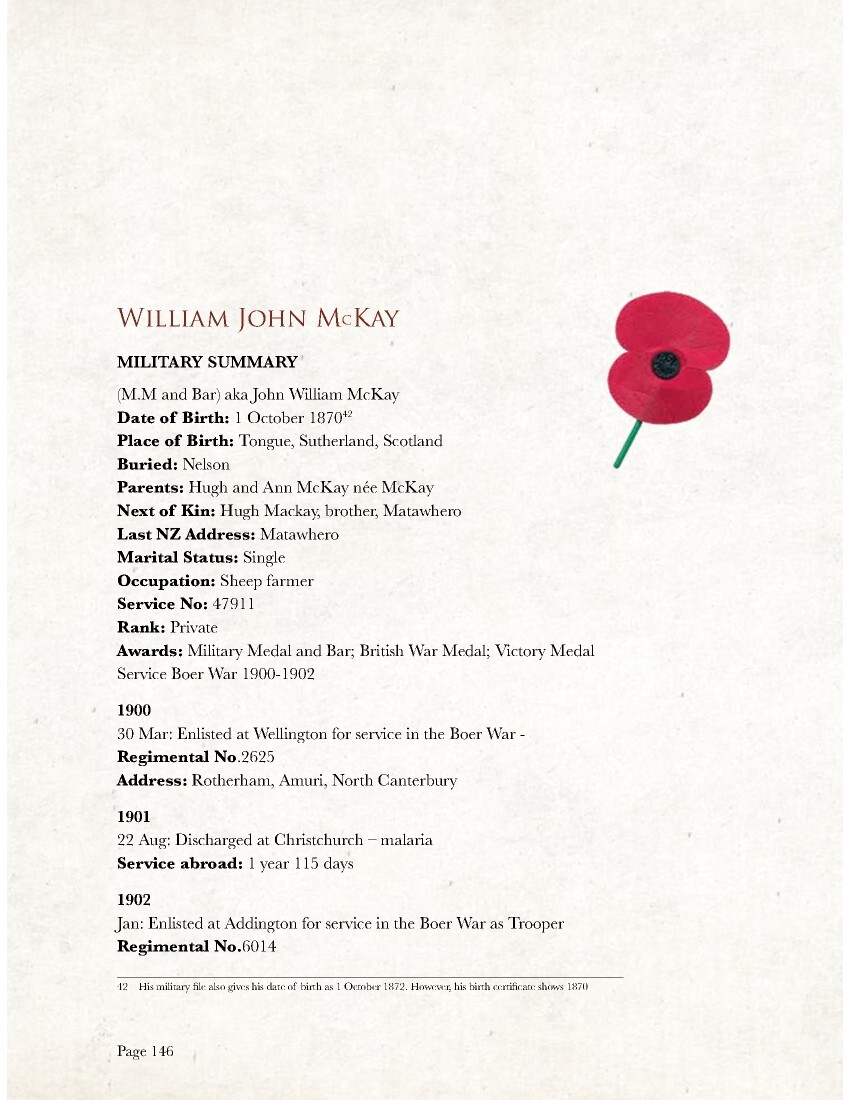
Page 147
01 Feb: Departed from Lyttelton on board SS Cornwall
15 Mar: Disembarked Durban
Awards Boer War: Queen South Africa medal and the following clasps, Cape Colony; Orange Free State; Transvaal; Rhodesia Service World War One 1917 – 1919
1915
Dec: Medically examined at Gisborne – discharged as over age
1917
02 Feb: Medical examination at Gisborne
03 Mar: Posted to Trentham Military Camp
12 Jun: Embarked from NZ on board HMNZT86 Maunganui
16 Aug: Disembarked at Devonport, England. Marched into Sling Camp, Bulford, Wiltshire
20 Oct: Left for France
1918
Served in France until 28 November then posted to UK on duty
15 Oct: Awarded the Military Medal (M.M) for gallantry during August/September and again on 1 October was awarded the Bar to this medal.
1919
08 Jan: Promoted to Sergeant and appointed 4th Grade Instructor
15 Feb – 19 Mar: Admitted 2nd NZ General Hospital Walton on Thames then NZ Convalescent Hospital at Hornchurch.
Notes: Medical Board Report at Hornchurch. Place and date of origin of disability: Gisborne 01 October 1915. Essential facts in the history of the disability: became over age at above time and place. Recommendation of Board: unfit for war service – permanently fit for home service
24 Mar – 17 June: Posted to the following camps Brocton, Larkhill and Sling Camp. 17 Jun: Embarked for NZ on board SS Briton from Plymouth
24 Jul: Disembarked Wellington
20 Aug: Discharged on termination of period of engagement
Total Service: 2 years 200 days (including 2 year 42 days
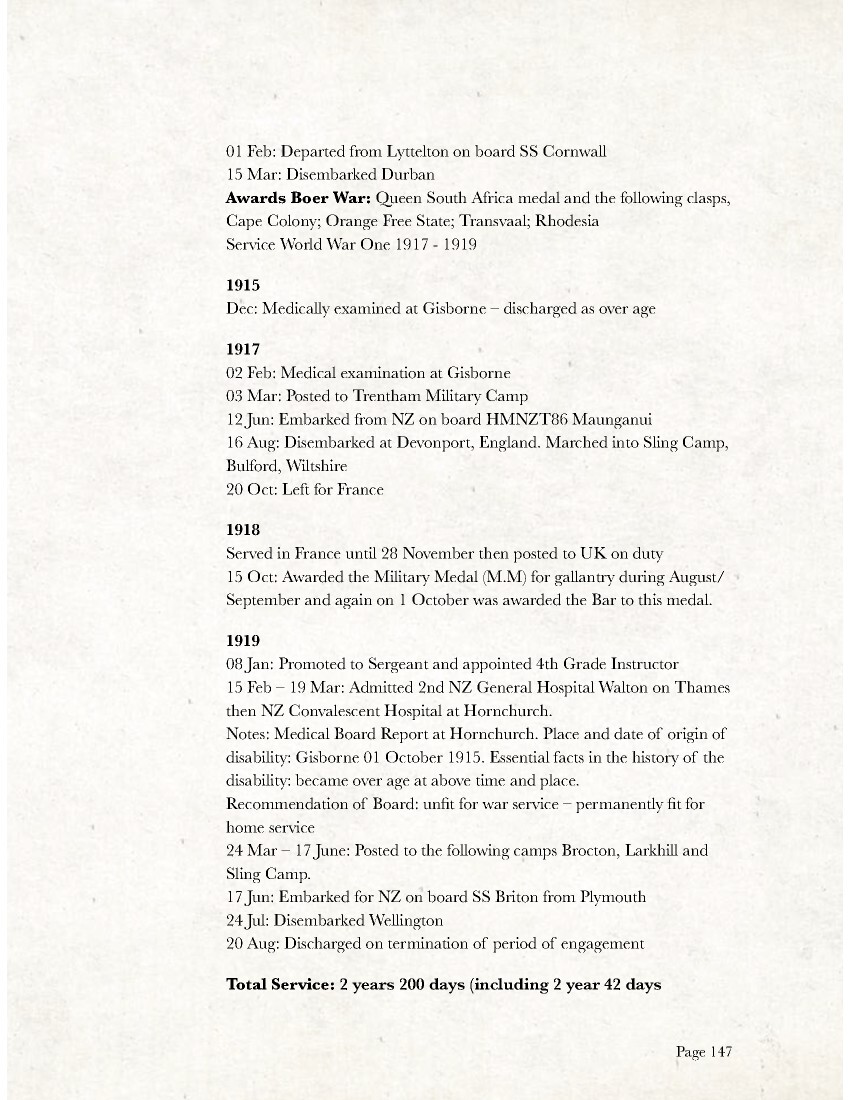
Page 148
overseas) Awards: Military Medal and Bar Victory Medal, British War Medal.
McKAY, William John 47911 MM. Private, 1st Bn, Auckland Regiment
L.G. 11 February 1919, p2144, Rec No. 2625
For continuous gallantry and devotion to duty in the field during operations extending from 21.8.18 to 14.9.18. This man is a Company stretcher bearer and did conspicuously gallant work in the evacuation of wounded under heavy fire. He was at all times ready and willing for work and exposed himself with an utter disregard for his personal safety in endeavours to quickly evacuate the wounded. Especially noticeable was his work on the 12th September when in front of Havrincourt Wood he continued his work under intense shellfire and succeeded in carrying a man out of a trench which was being continuously bombarded. He was undoubtedly the means of saving many lives.
Bar MM. Private, 1st Bn, Auckland Regiment L.G. 14 May 1919, p6010, Rec. No. 2938
For conspicuous gallantry and devotion to duty. On 1st October 1918, at Crevecouer, a sunken road was held by the Company to which Pte. McKay belongs. This road was enfiladed with immense H.E. fire of all calibres, so severe that casualties in the Company from shellfire alone mounted to 48 in two hours. Upon reaching the sunken road Pte. McKay ordered the men to distribute themselves on the roadside to avoid casualties. He next conveyed wounded to a deep dug-out, undoubtedly saving many lives by his forethought. The road was at this time an inferno of shellfire. Despite the heavy bombardment he conveyed the wounded to the R.A.P. Pte. McKay is 49 years of age, and, although worn our[t] before reaching the sunken road, he worked continuously all that day and night and the following day. His coolness under such harassing fire was a great inspiration to all, and undoubtedly steadied the men standing to arms on the roadside. Pte McKay worked continuously from the night of the 29th/30th September, and, so great was his devotion to duty that he denied himself proper feed. He was undoubtedly the means of saving many lives and showed a magnificent contempt for danger.

Page 149
London Gazette 11 February 1919 p2144
Rec No. 2625
William John McKay 47911 1st Battalion Auckland Regiment
M.M For continuous gallantry and devotion to duty in the field during operations extending from 21 August 1918 to 14 September 1918. This man is a Company stretcher bearer and did conspicuously gallant work in the evacuation of wounded under heavy fire. He was at all times, ready and willing for action and exposed himself with an utter disregard for his safety in endeavours to quickly evacuate the wounded.
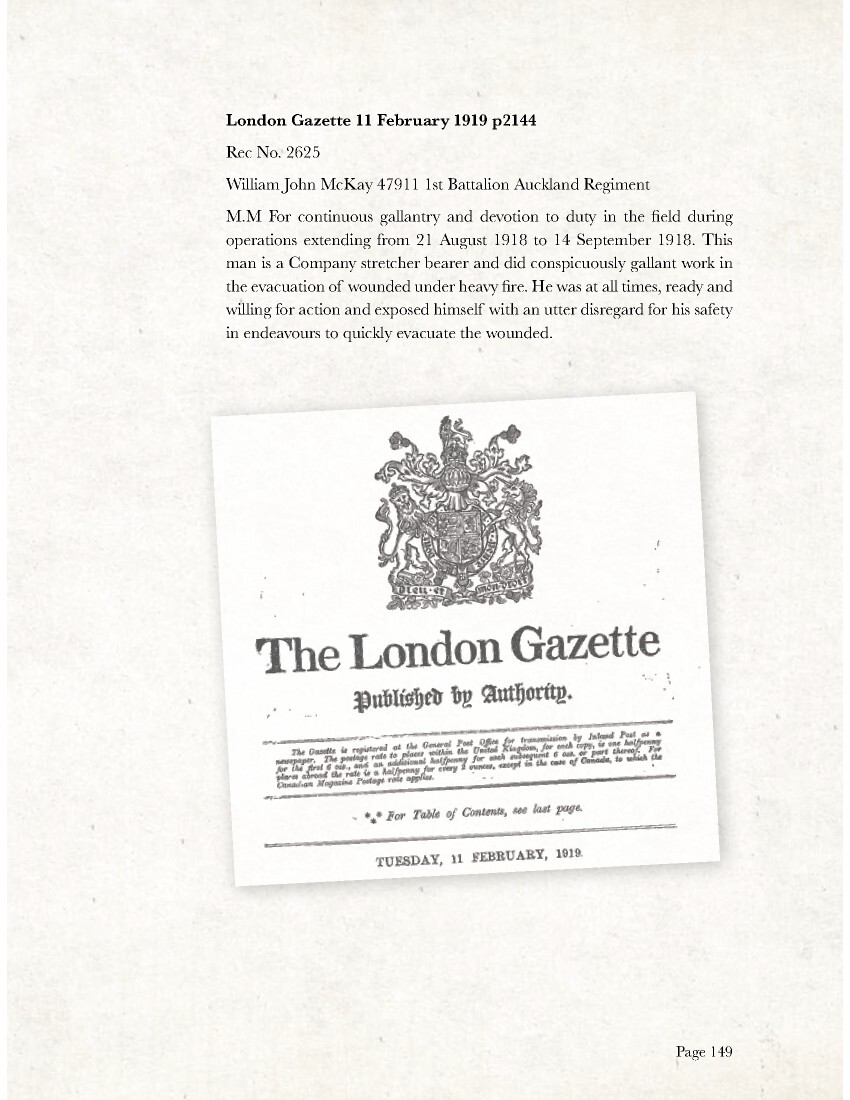
Page 150
LAND BALLOT
Ardkeen Section 10s 765 acres
Ballot awarded to: William McKay
William McKay was 50 years of age when he took up his ballot.
January 1921.
William wrote to the Commissioner of Crown Lands that after paying rent, he had £2,900 left, and was not tied to any stock firm. There had been a promissory note to Williams & Kettles Co. Ltd.
Gisborne, backed by brother Hugh McKay at Whatatutu, that was repaid in November 1920. There were 497 sheep carcasses in the freezing works, and 35 bales of wool awaiting sale in Napier.
Bill employed a man; he did not like working in the rough country by himself. Expenses had been adding up after buying horses and equipment for the farm.
Thirty chains of a new fence were laid while working on another fence-line, that would be complete next month. It was noted that building material was difficult to get. Bill planned to build a two-room hut but needed assistance.
November 1922
Bill sent a sketch of the building he had erected on the back section and insured with Victoria Insurances Office in the Government’s name, for £100.
23 September 1923
‘Ardkeen Soldier Settler Dog Worrying Dispute’. 43 Testimony:
A Mr Elwin a farm labourer, was mustering for Jack Owen; found 40 dead sheep, near a creek. A dog that Jim Tolme identified as McKay’s, and a pup were found in the vicinity. The pup belonged to Maurice Malone and, was on loan to Bill McKay. Mr Malone admitted the pup was his but blamed the other dog for leading it astray.
43 Wairoa Star, 23 September 1923
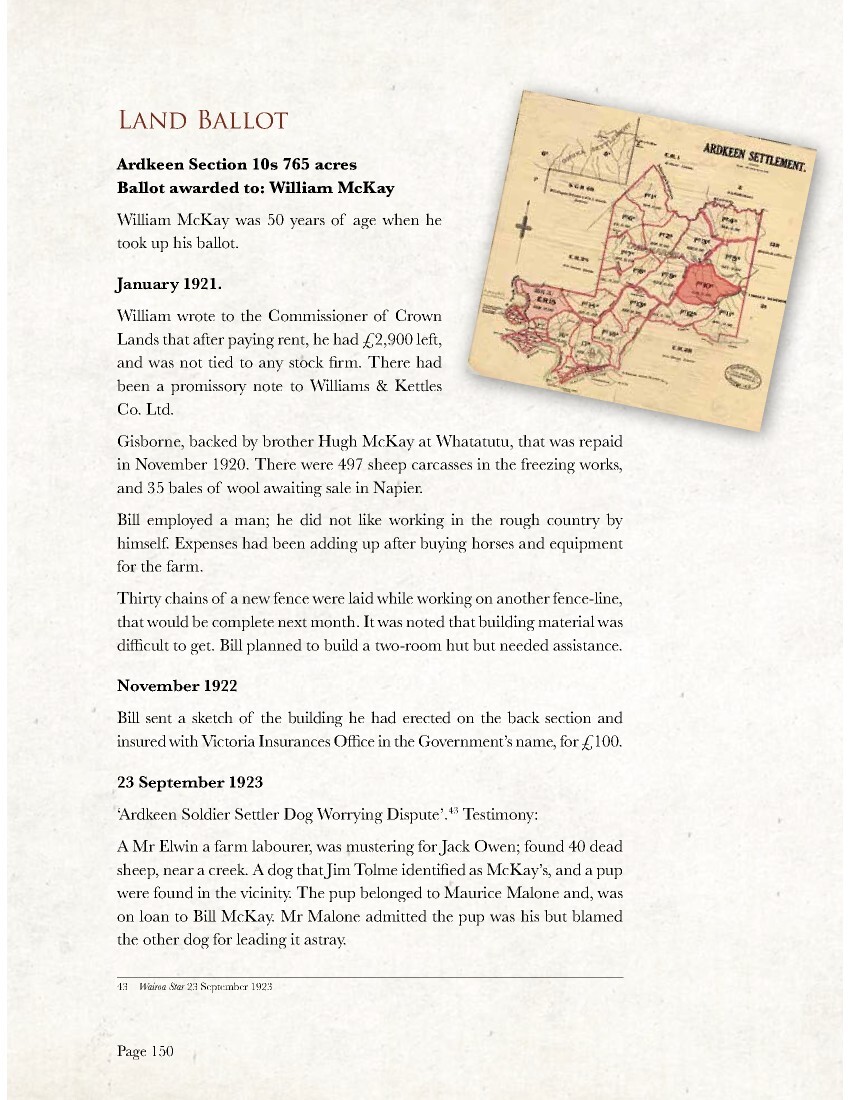
Page 151
Malone had seen the dogs at McKay’s whare. Afterwards he saw McKay at the Frasertown Hotel. McKay had expressed regret for the occurrence but blamed Malone for not looking after the dogs in his absence. McKay got very excited and refused to recognise any liability saying his dog had been tied up at Morere.
At the sale yards the next morning, McKay again expressed regret and offered to pay compensation. The plaintiff realising it was an accident, offered to share the loss.
Mackay did not inspect the dead sheep.
The following Sunday, Malone heard dogs barking and saw sheep running about the hill; he found McKay’s dog, which he had tied up, free. The dog had chased a sheep into the fence and torn its throat; the sheep died. Malone believed it was McKay’s dog and warned the neighbours. They searched the country the next morning seeing McKay at Dave Robinson’s whare; he agreed to help search but failed to turn up. Another 12 sheep were found to have been worried. Malone met McKay the next day with several dogs, including the black one responsible. McKay had seen the dog coming out of Davey’s gate that morning; he had previously told the plaintiff to kill the dog. McKay caught the dog; he and Owen killed it at the side of the road. Mr Ossie James arrived, on seeing the fracas, asked why they had killed the dog. McKay then expressed doubts as to whether the dog was responsible for killing any sheep because its stomach was empty at the time.
After a heated argument, McKay told Owen he had his remedy through the law and refused to pay damages.
Owen had taken a witness to see the evidence; they found 67 dead Romney sheep. Early the next morning the plaintiff found another 14 in an unexplored creek. Mr Simpson had valued the sheep, as set out in the statement of claim. The other sheep had been knocked about and had trouble at lambing. The sheep were all killed in the same manner, indicating the work of the same dog.
Mr O’Malley Solicitor suspected the dead pup was Malone’s. Tolme positively identified it as the latter’s dog.
He knew of no other dogs being about at the time. McKay’s dog fitted the description of the one that had run away. Mr Elwin was sure McKay owned the dog. The dogs had been worrying the sheep for several days.
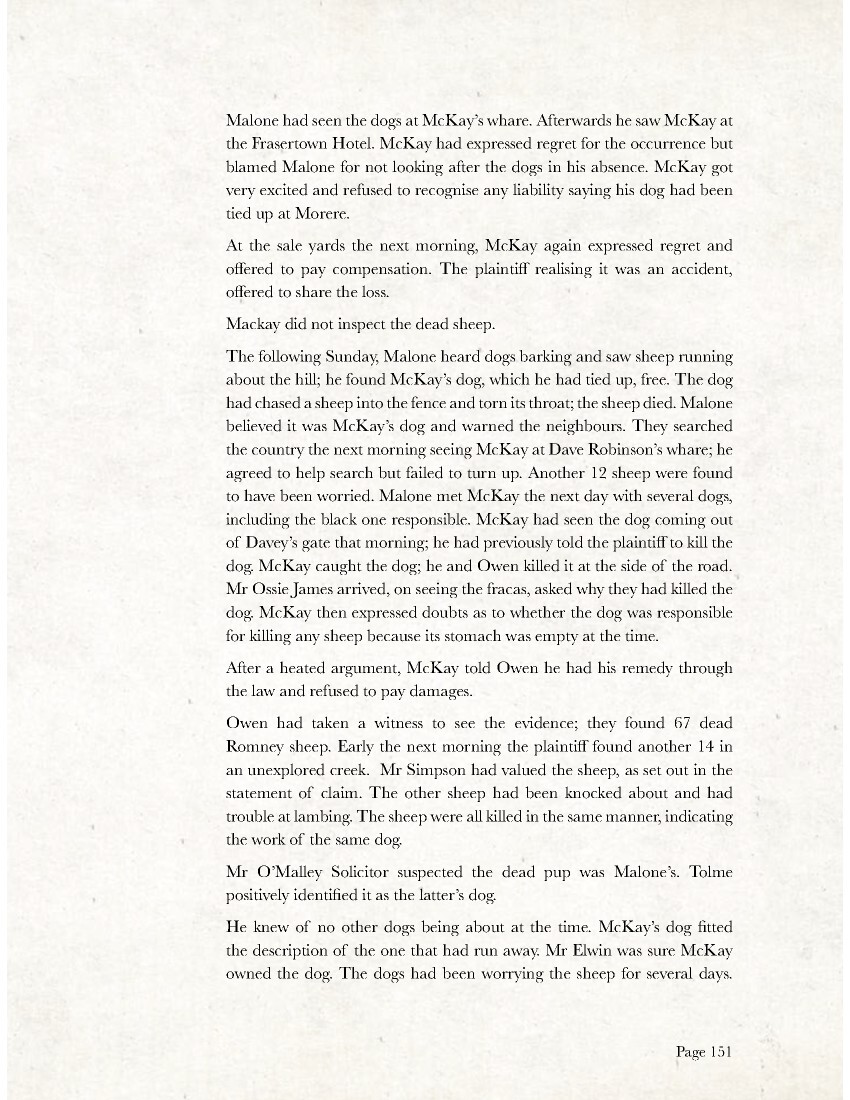
Page 152
He was prepared to say that all except one sheep had been killed before 10 June. He would not be surprised at anything that McKay said when excited.
The defendant stood up and took exception to the witness’s remark. The magistrate threatened to commit the defendant for contempt of court. The court’s atmosphere again became quiet.
Mr Green, a solicitor for McKay and Malone said Malone had never denied ownership of the pup and had not gone near the dead body. It was the same dog, now dead that did the worrying. McKay had offered a reasonable settlement.
William Elwin, farm labourer corroborated the plaintiff’s evidence. He heard the dogs barking when going out to muster on the morning of June 4. He discovered sheep bailed up in the creek by two dogs; he killed the pup with a stick as it came up the bank. The other dog got away; he was sure it was McKay’s. Twenty dead sheep were found.
There had been no more dead or injured sheep since the dog had been destroyed, and no other dog of similar description in the locality.
Paddy O’Kane, sheep farmer, Ardkeen knew the two dogs; he had seen them at McKay’s whare before the worrying. McKay had told him that from the evidence he had, it was his dog.
Fahey stated that one dog could not have killed all the sheep. He could not say whether a young pup would be capable of worrying sheep in the company with an older dog. Mr J. Tolme, sheep farmer, Ardkeen had seen the two dogs together. He identified the pup as Malone’s. He valued the sheep at approximately the same as set out in a statement of claim.
Mr O’Malley Solicitor offered, with an older dog, the pup would help kill. It generally took two or more dogs to worry. No-one who had seen the dogs could have mistaken them for others.
To his Worship: ‘each man knew his dogs, there was no doubt about the ownership of the dogs’.
O. G. James farmer of Ardkeen stated that he had bred McKay’s dog.
One dog would round up, the other dog kill. The pup would hardly do much damage on its own. Out in the open it would be easy to tell whether the sheep had been dead for four days or nearly a fortnight.
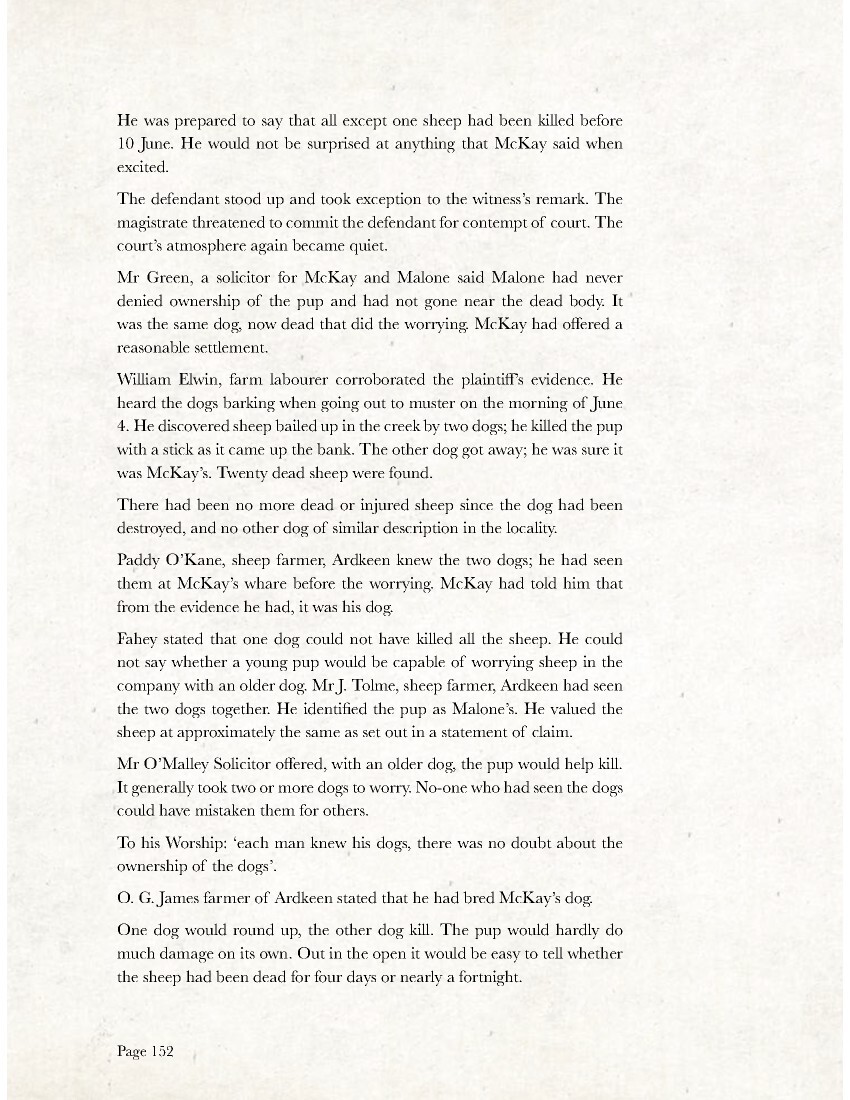
Page 153
A dog could do a lot of damage in half an hour.
He had shot several dogs last year, including one of the defendants’.
James Simpson, drover and dealer of Wairoa, gave evidence of finding 67 dead sheep which had been worried. A sheep-worrying dog would usually be wet and muddy after killing them.
W. J. McKay, one of the defendants, said that he was prepared to pay up when at first he understood that his dog had done the damage. He was away from the district for 10 or 11 days and knew nothing about the worrying until his return.
He left the dog tied up at Robertson’s while in Gisborne. Maurice Malone, the co-defendant, said that when told about the sheep worrying, he offered to pay half the loss, but his dog was sick and nearly dead with distemper; he could not see how he could worry the sheep; it was too young. He didn’t see the dog killed.
G. A. Fahey contractor formerly of Ardkeen knew the dog in question (McKay’s). When he saw it, the dog was quite clean and had not turned a hair. The plaintiff led him to believe that he was relying on Elwin’s evidence as to the dog’s identity. A dog caught worrying sheep would do so throughout its life. Mr O’Malley pointed to two discrepancies in the plaintiff’s evidence. Traversing the law and dealing with joint wrongdoers and quoting various authorities in support of his argument, the two defendants could not be joined together in the action. In assuming that judgment went against the two defendants, he substituted that it would be necessary for the Court to allocate the damages.
Counsel quoting authorities in support, noted that if the damage was to be allocated, the more significant share would have to be borne by McKay. But if the Court held that the pup was assisting the other dog, then Malone was also liable.
Two dogs killed eighty sheep; the plaintiff had taken responsibility with the first lot of killings. The dogs had done the damage, therefore, the plaintiff must succeed
The value of the sheep was not in dispute. It was open to doubt as to the general damages as the evidence did not go far enough in this respect.
He would allow £80 damages for the loss of the sheep and £10 general
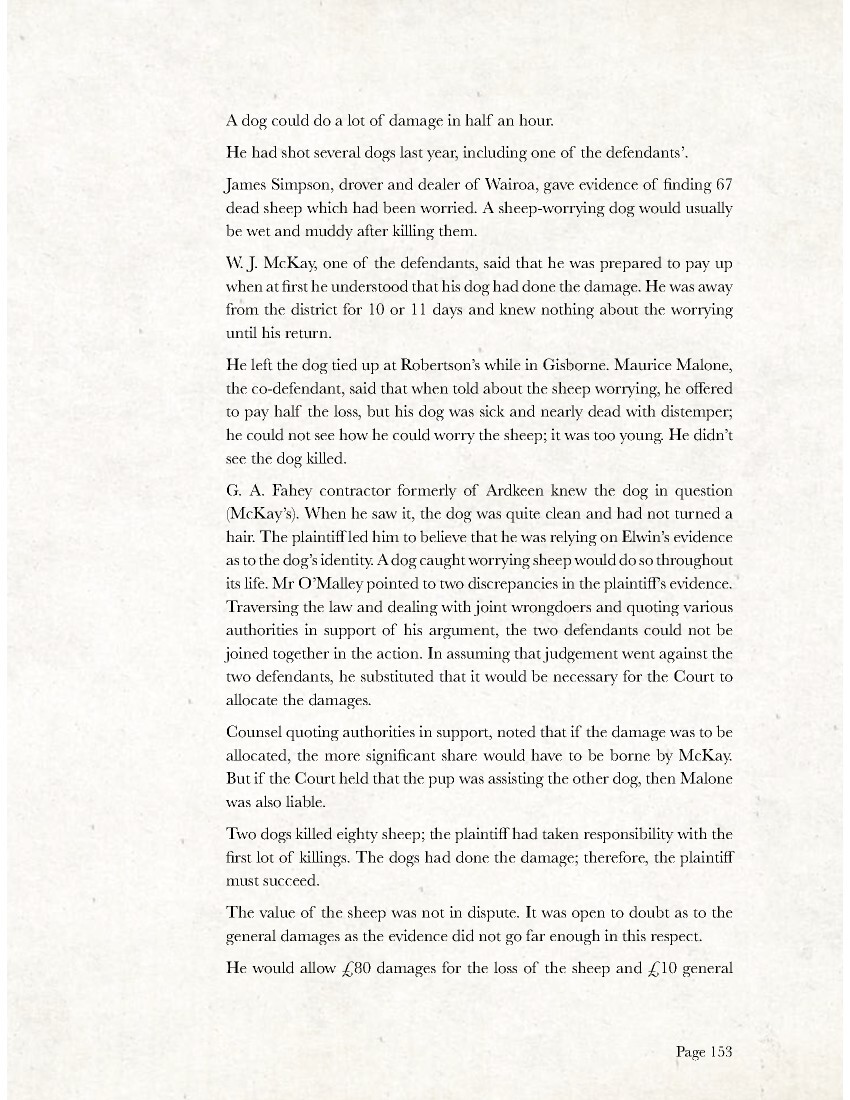
Page 154
damages. The counterclaim for the loss of McKay’s dog must fail, as the plaintiff at the time was quite satisfied as to the dog’s guilt. The allocation of damages caused him considerable thought; there was no doubt that McKay’s dog was a bad one. But how far Malone’s pup could be held responsible for any damages was challenging to decide. He would leave counsel to apply for an allocation of damages, if he thought fit, but he would suggest £90 divided in the proportion of 4/5 against McKay in 1/5 against Malone, with the cost amounting to £12.10 shillings.
The cost of an appeal fixed by the Magistrate was set at 20 guineas.
Jack Owen versus William McKay and Maurice Malone. Alleged sheep worrying by defendant’s dogs Mr E.J. Green appeared for the plaintiff and Mr G.M. O’Malley for the two defendants. The plaintiff, Jack Owen in his evidence stated that on June 4 he and W. M. Elwin went out mustering. The latter rode off after getting his instructions. A short time afterwards he came back and reported several sheep lying dead which had been worried by dogs. He investigated and found a pup recently killed by Mr Elwin.
In an editorial in 1922, Quick March deviated from the earlier RSA position, when it described the soldier settlers as belonging to four different categories, varying from those that were doing well, those doing well but needing some assistance, those suffering special hardships, and those soldiers ‘who are getting deeper and deeper into the mire and perhaps keeping better men out’. The magazine went on to say that ‘the present time is really a purifying period: The duds must go to make room for better men’. 44
April 1924
The Commissioner noted McKay was on schedule for the non-payment of rent and had until the current board meeting to pay one half year’s rent or, forfeit.
McKay did not reply or make a payment.
McKay’s farm was described as situated 16 miles from Wairoa, of 755 acres in common pasture, mostly native grasses with small patches of native bush in the gullies and light fern reverting to manuka, suitable for grazing only.
44 Gould, A.N. (1992) Proof of Gratitude, p. 230.

Page 155
February 1928
William John McKay Ardkeen farmer was adjudged bankrupt at the Wairoa Courthouse. Official Assignees in Bankruptcy Commissioner Crown Lands Gisborne.
William John McKay Bankrupt Stock Mortgaged to Crown ASSIGNEE.
William McKay was ‘sectioned’ to the Porirua Mental Hospital. 45
26 September 1928
Memo: Mr Tolme will repair the whare chimney with two pieces of corrugated iron for a cost of 10/-.
Tom Davey agreed to pay £8 a month to graze the McKay Block from the 19th March, until Jackson removes his hoggets; then pay £10 a month.
Note: Grazing approved.
William McKay’s farm was split into three sections:
Lot 3. 340 acres going to Ossie Birrell.
Lot 2. 187 acres allotted to Dave Robertson.
Lot 1. 152 acres went to Jack Owen in 1928
The site of McKay homestead and cattle yards
45 Anecdotal conversation
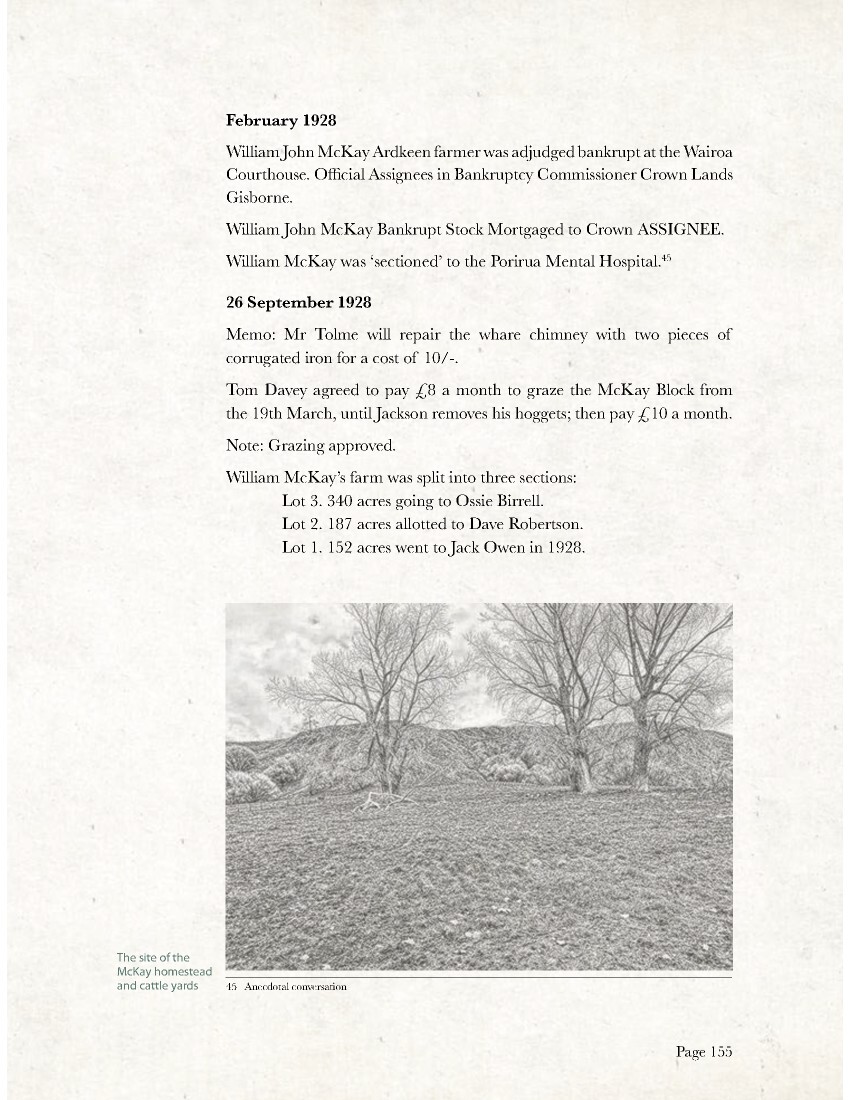
Page 156
RECENT HISTORY
Bill and Fiona Prestage bought the farm from the Owen estate in 2003 selling the 152 acres Lot 1 to the Swan family and section 11 to Roger Allott and Theresa Hoyle in 2018.
The Swann family put Section 10s together again.
The McKay Homestead Section was divided between Mattie Andrew and Jim Tolme in 1928, now part of Richard and Harmony Wallace’s farm.
The McKay Homestead Section of 87 acres that was divided between Mattie Andrew and Jim Tolme in 1928, is now owned by Jeanette – née Andrew and husband Alan Steed.
Jim Tolme sold the original part of Section 10s homestead section to Jim McLean in 1968. The McLean Estate sold to Frank Brown circa 1989. Bought by Jefferson & Amanda Powdrell 2010.
Sold to Steve and Maree Aldridge 2012
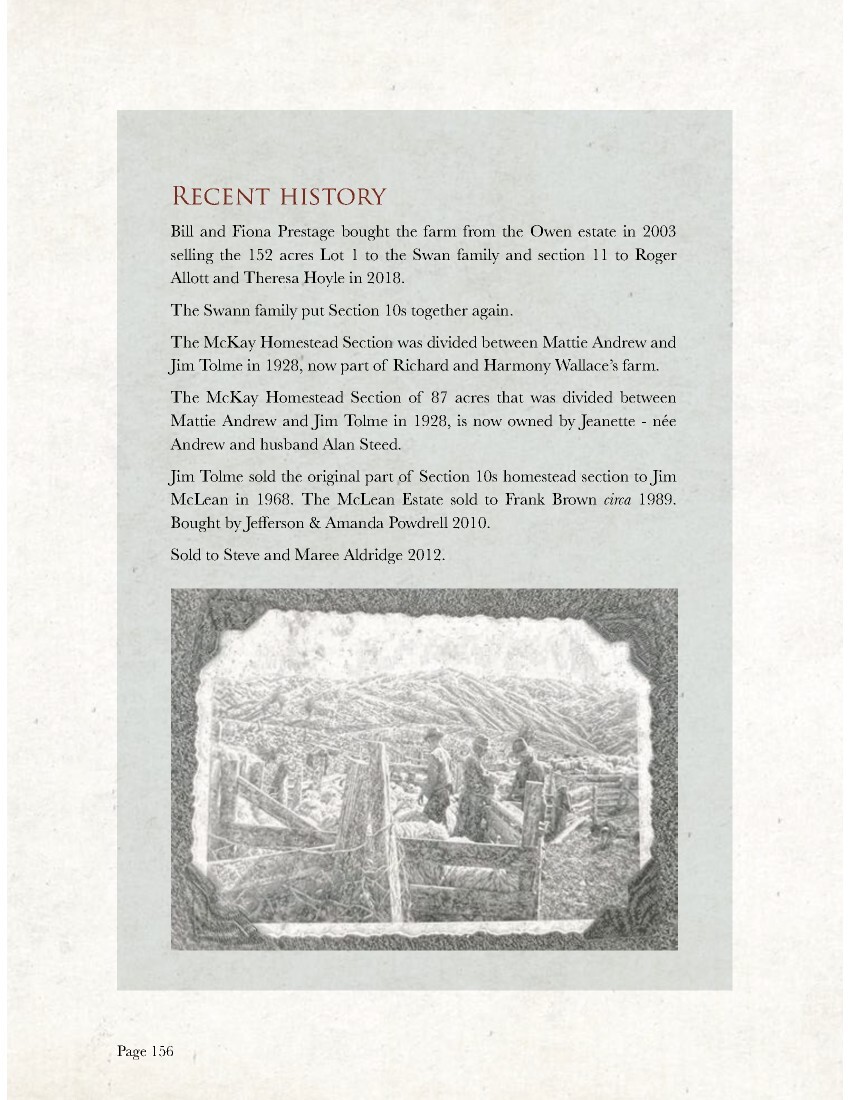
Page 158
JACK OWEN
MILITARY SUMMARY
Date of Birth: 27 November 1885
Place of Birth: Napier
Parents: Henry Wilson Cox and Jane Owen née Morgan
Next of Kin: H Owen, father, Riccarton, Christchurch
Last NZ Address: Arcadia Hotel, Gisborne
Marital Status: Single
Occupation: Station fencer
Employer: J M Arundel, Tolaga Bay
Regimental No: 10/2266 Rank: Private
Death: 1 November 1960 Wairoa
Buried: Wairoa Cemetery
Awards: 1914-15 Star, Gallipoli Medallion, British War Medal, Victory Medal
1915
14 Feb: Enlisted at Trentham. Posted to Wellington Infantry Battalion as Private.
17 Apr: Embarked from NZ
25 May: Disembarked Egypt
25 Jul: Joined Battalion at ANZAC Cove
01 Aug: Wounded in action – gunshot wound face and shoulder. Was hit at Loophole at Gallipoli. Bullet struck back sight of rifle and fragment penetrated the eye. Carried to dressing station and transferred to Hospital Ship to Alexandria. Lost right eye
06 Aug: Disembarked Hospital Ship Rewa at Alexandria. Admitted NZ General Hospital Abbassia
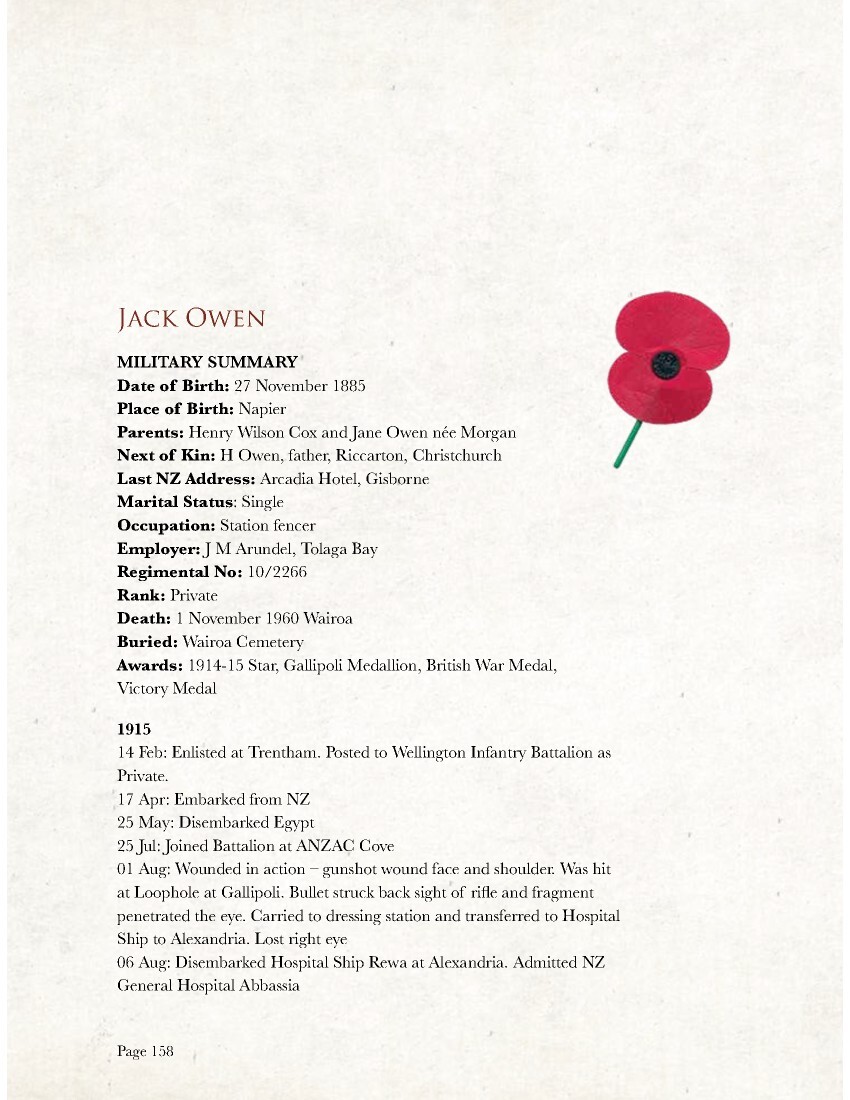
Page 159
31 Aug: Transferred to Special Camp at Suez awaiting transport to NZ
25 Sep: Embarked for NZ on board Hospital Ship Willochra
30 Oct: Disembarked Port Chalmers
1916
25 Feb: Discharged no longer medically fit
Total Service: 1 year 12 days (including 197 days overseas)
Address for Medals: Frasertown, Wairoa, Hawke’s Bay
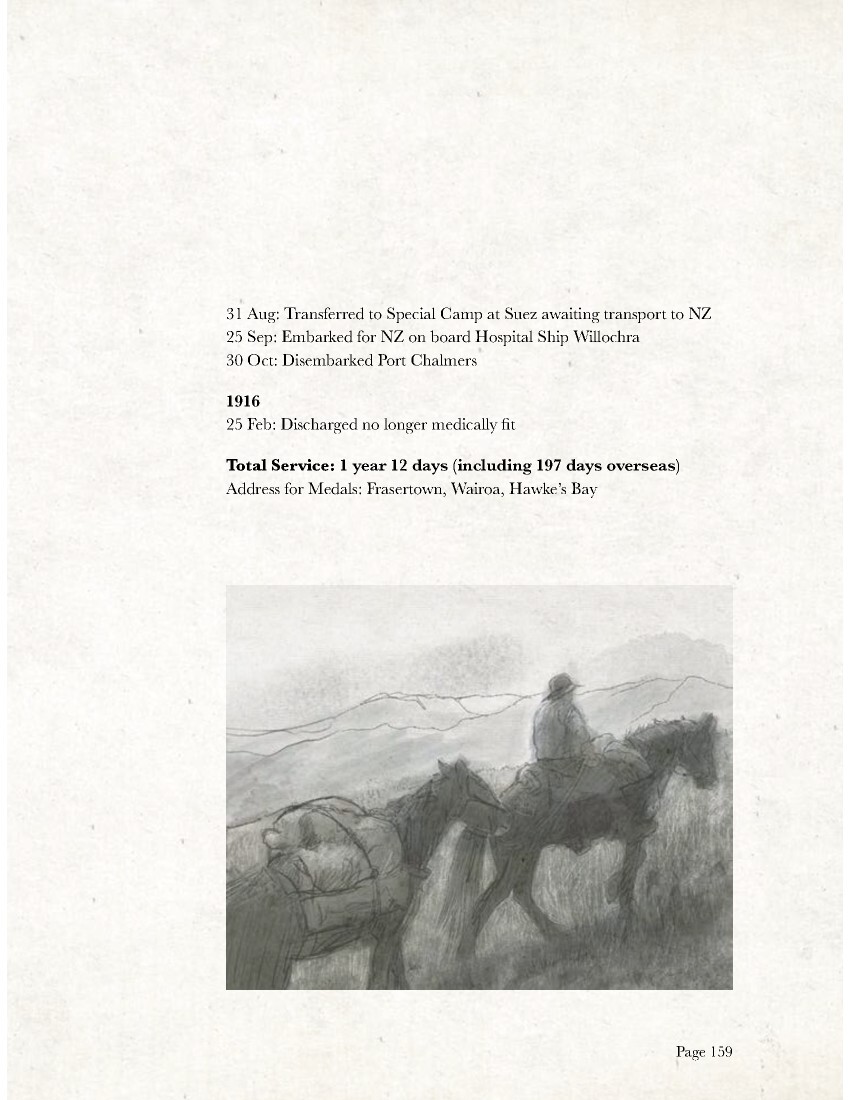
Page 160
LAND BALLOT
Ardkeen Section 11s, 684 acres
Ballot awarded to: J. J. Owen – Tolaga Bay
Jack Owen won section 11s of the Ardkeen Settlement situated at the south-east corner of Ardkeen on the boundary of Riverina and Mahanga stations. The section access through the Birrell farm, section 18s, Carson 13s Preston 12s and Mahanga Station was steep, unfenced and without water.
Jack’s section was steep and lying to the north and west.
At the time of the ballot, Jack’s deposit money was invested, he was unable to access the funds. The Commissioner financed Jack until the investment was released; Jack owned his livestock. 46
Jack’s first task was to erect a boundary fence between himself and Mahanga Station; the Ranger insisted Jack dismantle an old fence and use the wire for the new boundary fence. Had the Land Ranger been prepared to grant an advance for wire, Jack would have gained a 70-acre paddock.
By December 1921
Jack had subdivided his farm into five paddocks; three main paddocks and two smaller ones for rams and horses. The boundary with the Harbour Board Timber Reserve had not been fenced and he was losing livestock into the bush; he hoped to complete the fence by the following winter, however it was a matter of money. 47
February 1922
Jack advised Mr Marshall, the Commissioner, he had sent 167 lambs to the meat works, had a further 113 sheep plus 580 lambs to go before the first week of March and he had set aside £250 to purchase 400 ewes. Jack thanked the Commissioner for his considerate treatment over his stock account, promising to do his best to justify the show of confidence.
46 At the time of the ballot Jack Owen was fencing around Tolaga Bay, north of Gisborne; he owned 5 pack horses and an extensive range of fencing equipment.
47 Jack had 90 acres of bush with many Totara trees
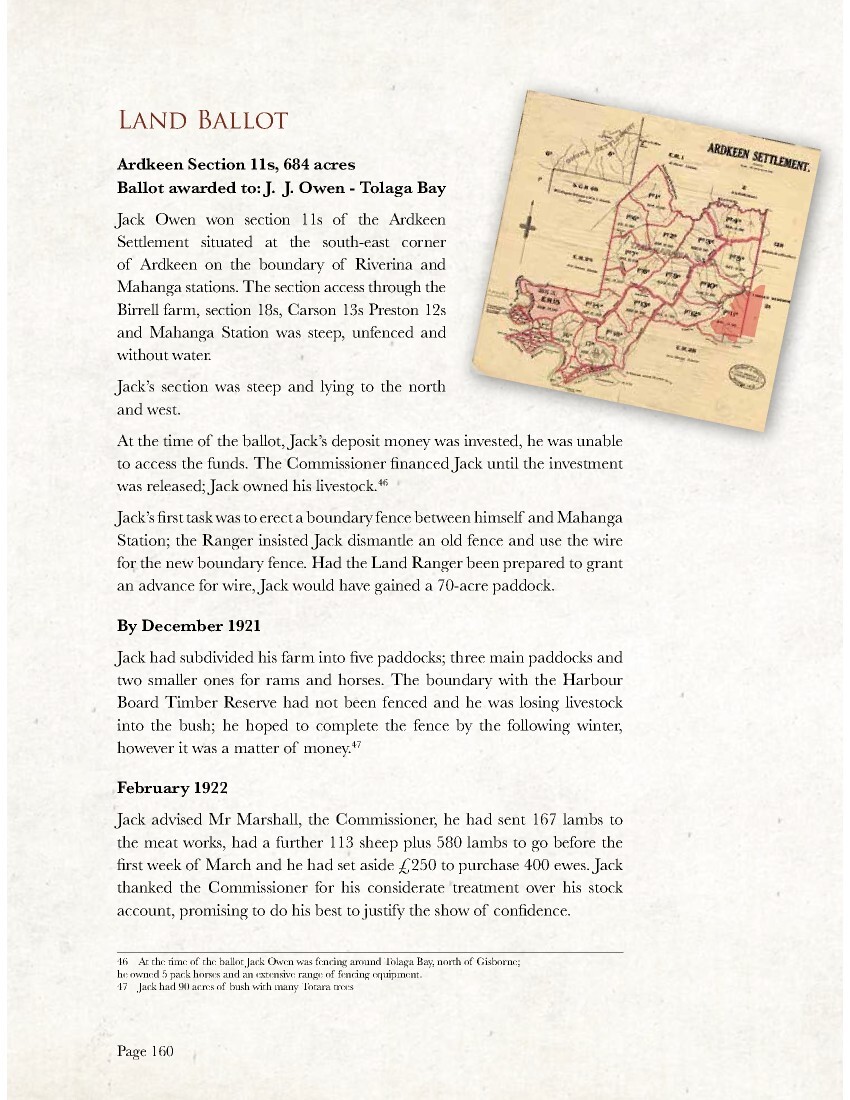
Page 161
Jack expressed his pleasure with the sharp rise in lamb and mutton prices saying that if meat and wool continue to rise, and hold firm, that the settlers could look forward to getting out of debt eventually. He added some of the more reckless spirits among them may contemplate matrimony.
August 1922
Jack was budgeting on sheep realising a conservative 15 shillings per head. He sought the Commissioner’s consent to sell 80 in-lamb ewes for 13 shillings per head. Jack expressed concern about the weak state of the markets in England.
April 1923
Jack sought permission for Hawke’s Bay Farmers Co-op to retain the proceeds from the next year’s wool clip, an estimate of 25 bales valued at £286.1.3 to offset:
3 tons of number 8 wire £81
5 CWT 6 barbed wire £7.15
3 CWT staples £5.2
60 bushels grass seeds £45
Stores £50
Wairoa County Rates £30.18.3
Harbour Board Rates £30.18.3
Shearing expenses and wool cartages £35
Crutching expenses £3
Dipping expenses £5
Incidental expenses, Droving, insurances £10
Total: £286.1.3
June 1923
Jack leased 73 acres of bush from the Harbour Board Timber Reserve; he had cleared the land and now grazed 400 hoggets there.
Jack recapped his efforts, advising he had erected 5 ½ miles of new fencing, repaired 1 ½ miles of boundary fence, built a set of sheep yards measuring 100’ x 110’ with timber he split from Totara logs, on-site, constructed a corrugated-iron whare 10’ x 21’, and was presently building a set of cattle yards.
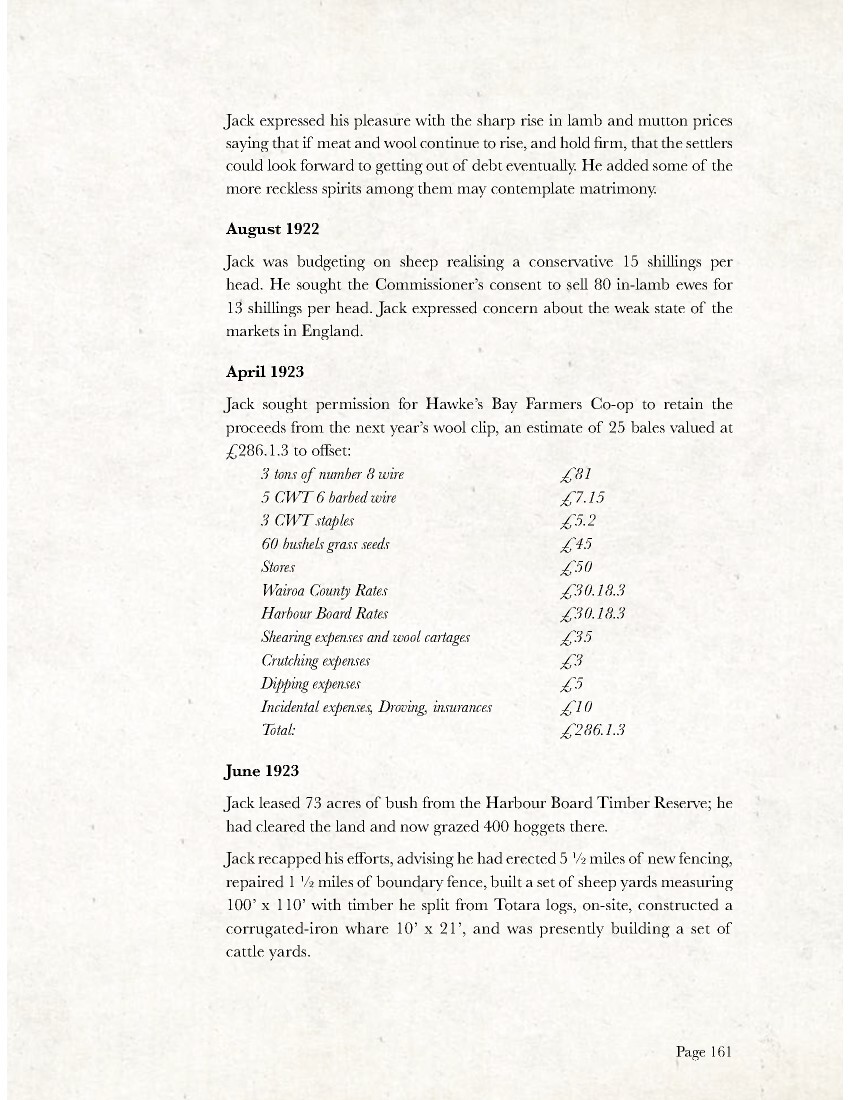
Page 162
With the exception of felling 98 acres of bush, he had done the work.
Hawke’s Bay Farmers Co-op wanted to share the farm income because of Jack’s high debt.
21 September 1923
Press, Volume LIX, Issue 17874, page 7
SHEEP WORRYING. DAMAGES AWARDED. (BY TELEGRAPH-PRESS ASSOCIATION) WAIROA, Sept 20.
The Magistrate’s Court has been occupied for the past two days in hearing considerable evidence in a sheep-worrying case at Ardkeen. A soldier settler, Jack Owen is suing William McKay and Sydney Malone, a claim for eighty-one sheep killed and general damages to his flock. The Magistrate, Mr. Levy, to-day awarded plaintiff £90 damages and costs.
March 1924
Jack wrote to the Commissioner of his frustration with the Board requiring 25% of his arrears, in addition to the rent for the current year. He complained that his position would become hopeless pointing out that the commissioner decided where the farm proceeds are applied, because all receipts were paid to the Crown.
April 1924
The Land Board noted the [that] Jack Owen had made improvements to his farm, leased a further 90 acres and his stock account was showing excellent security.
January 1925
Jack wrote to the Commissioner about having his stock mortgage released; the Commissioner agreed that he was in a position to carry on without further help from the Crown.
July 1926
Jack asked the Commissioner to postpone his rent because the season had been one of poor prices exacerbated by the loss of a hundred cattle, through a shortage of feed; noting the coming season looked very dismal.
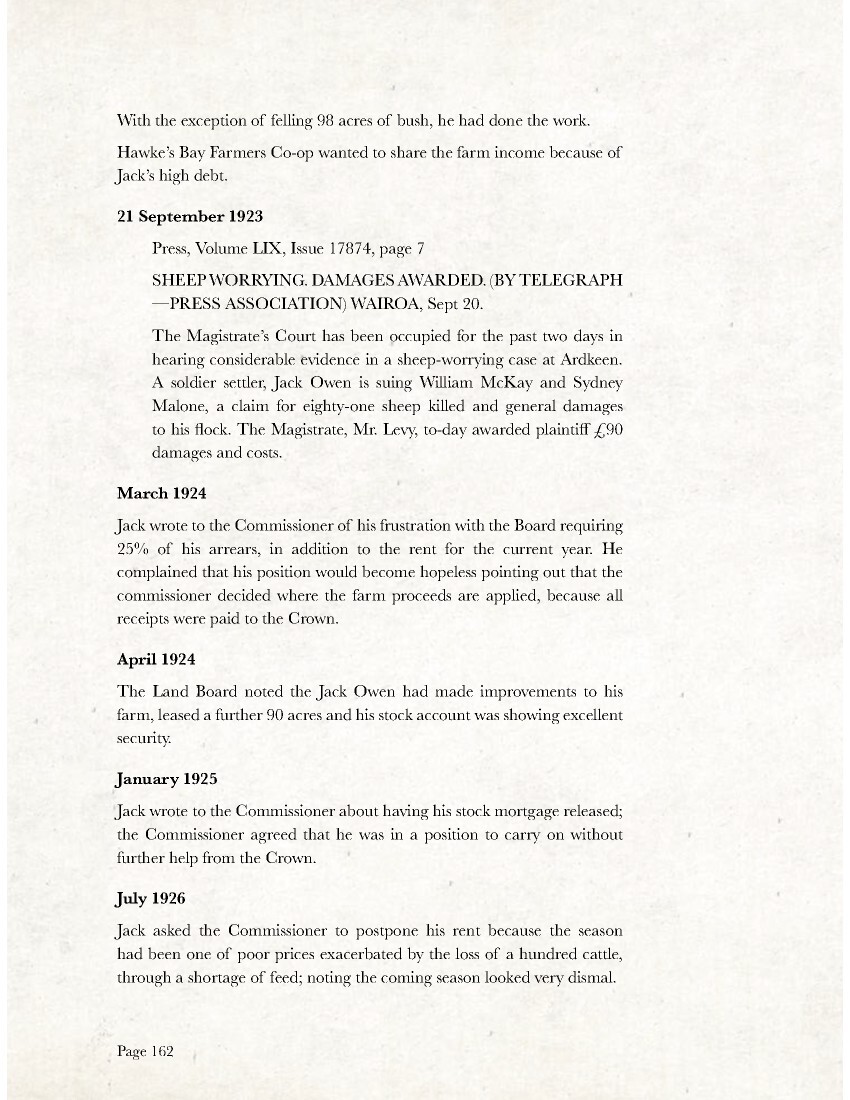
Page 163
January 1927
Jack wrote to the Commissioner asking for a remission of rent on 80 acres of waste land with a deep gorge that had cost him dozens of cattle.
It was noted that Jack was “carrying more sheep than the other settlers, and doing better but he was a difficult man to get rent from.”
April 1928
Mr D. G. Robertson, Crown Lands Ranger discussed the proposed subdivision and allotment of section 10s (McKay’s). It was noted that a gorge separated the proposed section. It was possible to cross, leading a pack horse in fine weather but it was not a safe crossing.
Jack argued his farm was not paying because of the high land value, and the difficulty of working such steep, broken country. He said when mustering, all stock had to be driven down steep sidings, across streams and up steep faces to the yards.
July 1928
Jack wrote to the Commissioner about the McKay section, accepting the area offered but he took the liberty of changing a section of the boundary saying he would have better riding access to his section 11s. He offered to undertake the fencing and maintain the boundary between himself and Birrell.
November 1928
Jack wrote to the Commissioner about surrendering his homestead section at Ardkeen, if he got half the McKay section, however, he had only been allotted a smaller portion. As things stood, he said he would not surrender the homestead section. At the time Jack was farming 800 ewes, 600 hoggets, and 210 cattle.
December 1930
Jack was offered an advance to move his cottage from the homestead section, to his farm section. However, he had not anticipated the fall in stock prices and regarded the expense of moving the house unwise. Jack advised the Commissioner he was holding his wool but he did have 600 sheep at the freezing works awaiting shipment.

Page 164
April 19th – 20.
To
Mr D.G. Robertson
Crown Lands Ranger Gisborne
Dear Sir
I have been thinking over our conversation last night re the proposed subdivision of McKay’s section on Ardkeen. We covered so much ground during that conversation both relevant and irrelevant that I have decided to avoid any chance of misunderstanding to send you this note confirming my attitude.
That to be of any use to me I would want half or approximately half the section and the half nearest to me via the Stock route. One point that we both missed last night while discussing the feasibility of my crossing stock over the gorge was that while it would be possible to cross sheep and cattle in dry weather it is quite impossible to cross a mob of ewes with lambs at foot under any conditions and as they would have to be crossed in shearing that definitely cuts me out as an applicant for that portion.
Yours sincerely
Jack Owen
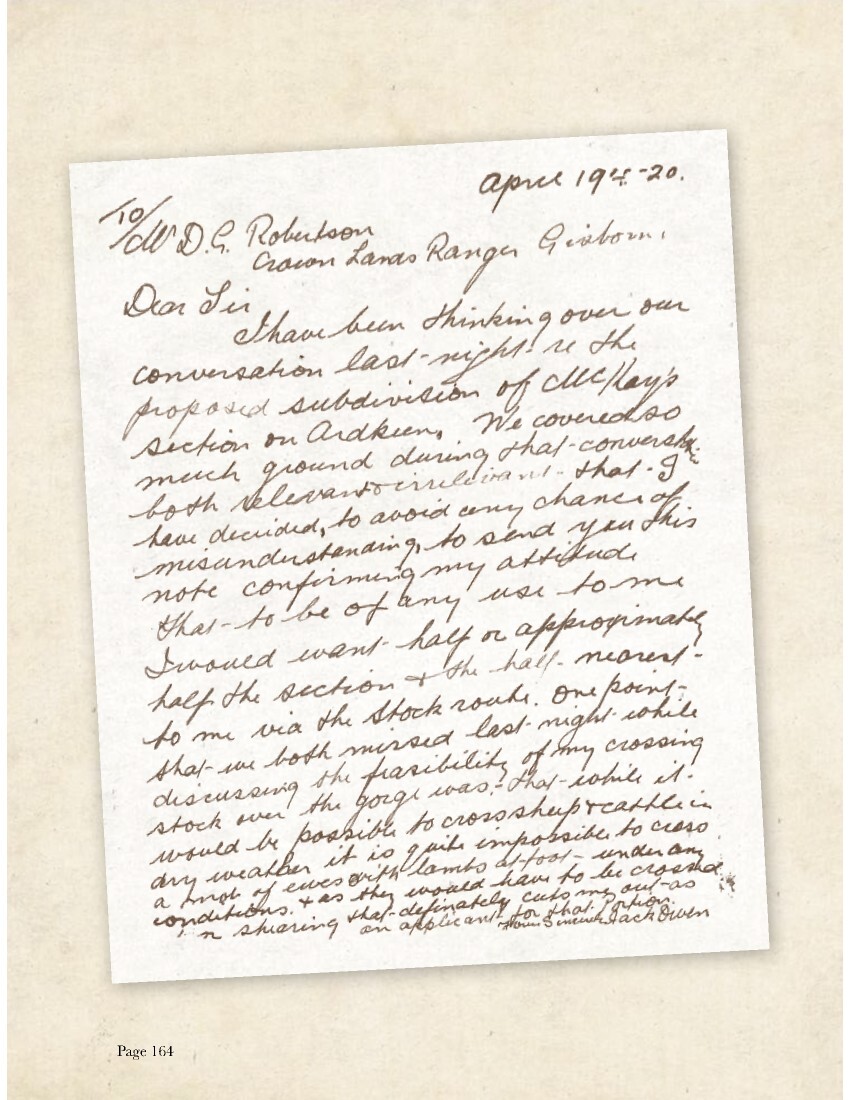
Page 165
January 1931
At the start of the new year, Jack wrote to the Commissioner of the advantage of living on his farm with the Ardkeen Road formed. Jack described the situation on Ardkeen with the homestead sites being some miles from the farms. He had 43 acres, nine miles from his farm with a two-room cottage on the 43 acres, and a corrugated-iron whare on the back farm. He found looking after his livestock was too difficult, unless he camped out on the farm. Camping-out entailed taking his wife and youngster with him, and at other times living half the time apart. The solution Jack reasoned, would be to build a house on the farm at Titirangi, now there was a road but he was mindful of the expense of building during the depression.
Ardkeen
Oct 30th – 28
To Commissioner Crown Lands Gisborne
Dear Sir
I am in receipt of your letter of Oct 3rd re our conversation of my current account to instalment mortgage.
Failing an application for a renewal of the current account on the existing terms for a period which will give me the use of the money for the full term of seven years I choose as a means of repayment the table of 24 ½ years involving a payment of £37-10/- less a £2-10/- rebate as set out in your letter.
Re your request for an assurance from me that I expect to meet the instalments as they fall due. That of course will depend entirely on circumstances. I have endeavoured some farming on Ardkeen to pay twenty shillings in the pound and will endeavour to do in the future.
Yours sincerely
Jack Owen
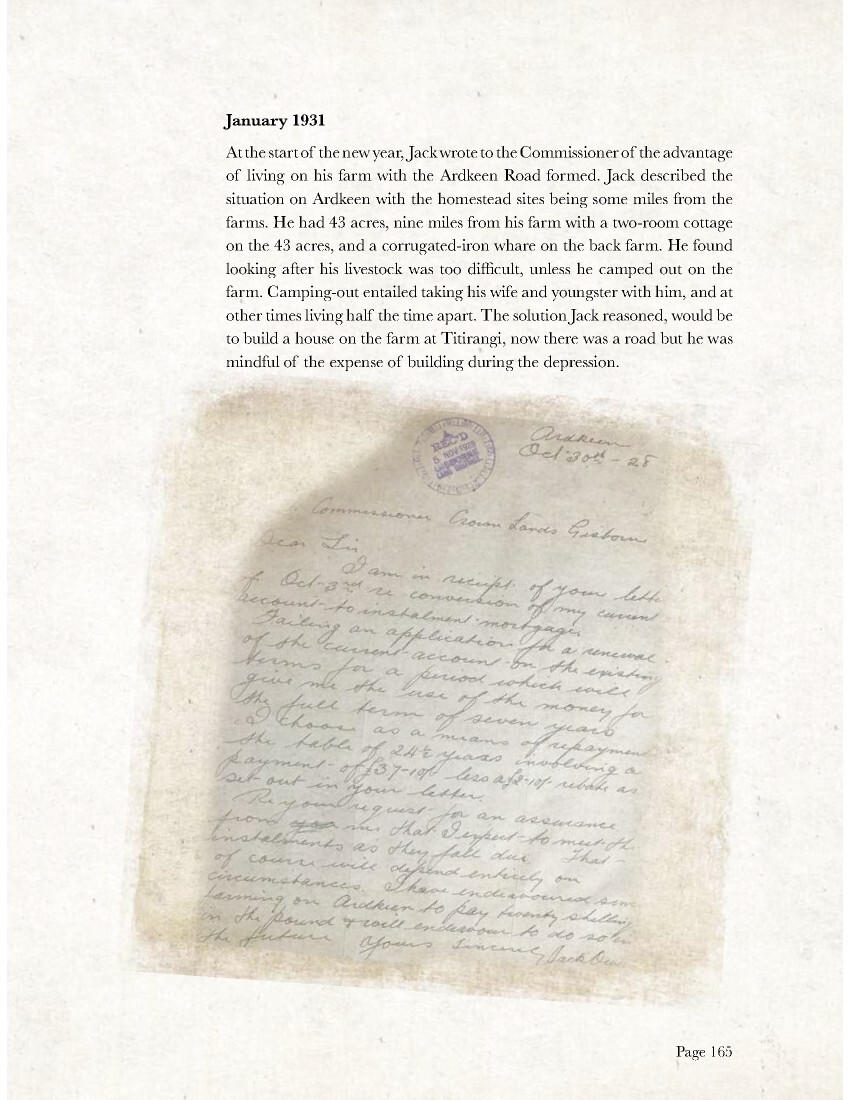
Page 166
Nevertheless Jack submitted plans; the Commissioner regarded them as primitive and advised that the roof needed to be gabled, noting the need for a lot of cork flashing around the chimney. In return, he sent a plan of what the roof should be, offering that the improvement would facilitate future additions.
Jack told the Commissioner he was living in his whare on the farm and was able to receive mail and his stores once a week. Jack noted time was passing, and it would soon be too late in the year for traffic to use the new Ardkeen Road as the first heavy rain would make the road impassable. He added the earthquake had wrecked the road and caused a temporary abandonment of building. There had been considerable damage with land slips on the farm.
Jack wrote how, half-an-hour before the earthquake, he had poured a mix of concrete into the form-work for a sheep dip; now he believed the dip foundation would be ruined.
[See bottom of next page.] Left: What was once Jack Owen’s sheep dip
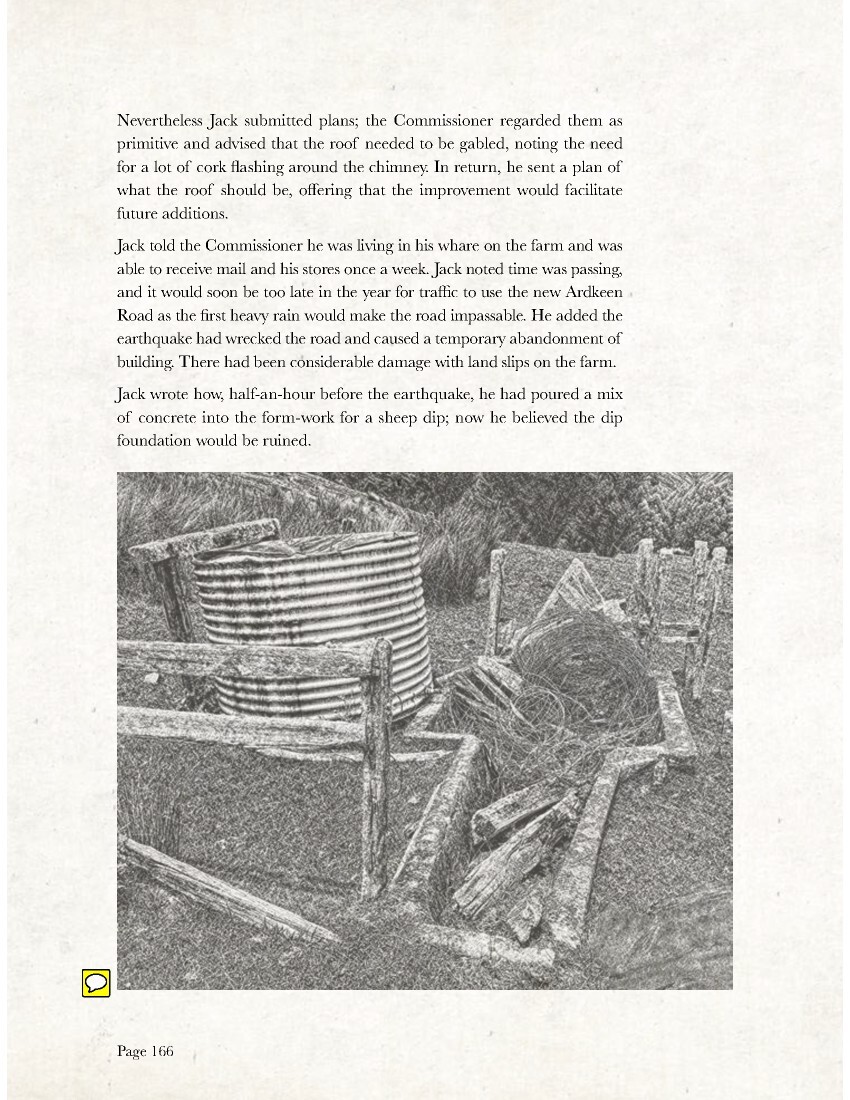
Page 167
July 1931
Jack noted the new road through Ardkeen, which 18 months previously had been disowned by both the ‘County Council’, and the ‘Public Works Department’, had become impassable because of the earthquake.
Jack wrote, he may not survive the Depression, being unable to pay the rent, rates and interest. If he survived, he would like to make a fresh application to move the house, which was now on hold.
Jack was regarded as a good farmer and had:
900 breeding ewes
550 dry sheep
24 rams
4 dairy cows
85 run cows
122 mixed cattle
6 horses
September 1933
Field Ranger D. G. Robertson wrote that Jack Owen appeared to have sold all his lambs but stock figures when returned, showed the same lamb numbers as at the beginning of the year.
Robertson noted Jack’s war pension was not included in his income and, £1,180 for wool appeared incorrect. Robertson recommended the Board write to Owen about his unrealised wool. 48
September 1933
The Commissioner wrote to Jack Owen demanding dipping tallies and details of all sheep bought, or sold, details of freight, and how he arrived at the figures offered. He also wanted the rate of interest charged for his stock mortgage and the whereabouts of his wool and the number of bales. In his mind there had been three shearings that did not add up.
48 A pencil written note in Jack’s file: ‘I have an idea that Owen has two years of wool on hand or in England’.
Left: What was once Jack Owen’s sheep dip
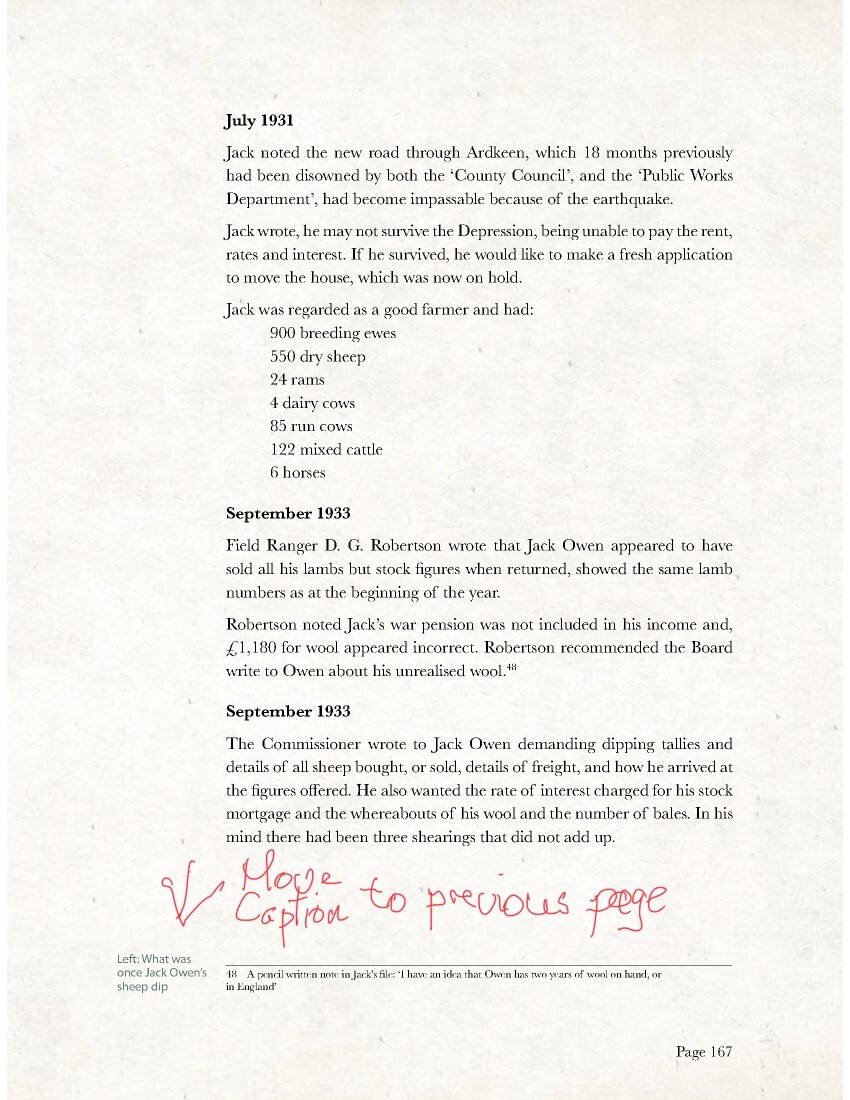
Page 168
Jack responded that all lambs were sold. The breeding flock was kept up to full strength by purchase of 250 breeding ewes replacing old ewes, died, killed for mutton and dog meat.
Dipping tally: 1,500
Sold after dipping:
213 ewes
307 lambs
Bought after dipping: 250 breeding ewes
Bought after dipping: 5 Southdown Rams
30 bales of wool at 8 shillings per bale: overlooked last statement £12 1932/33 approximately 92 bales of wool unrealised?
Jack advised he had been living and working on his back section and had not received his mail until the previous evening making it impossible to provide the information requested on time. Jack promised to forward a request to Hawke’s Bay Farmers Co-op for balance sheets covering the previous two years. Jack advised he would not be shearing until after the New Year and that his payments to the department over the past two years would have been greater, had it not been for medical expenses incurred by both himself and Mrs Owen. There was also the loss and damage sustained from the two earthquakes, necessitating the rebuilding of fences,
Photo caption – Correspondence over Jack Owen’s wool dispute
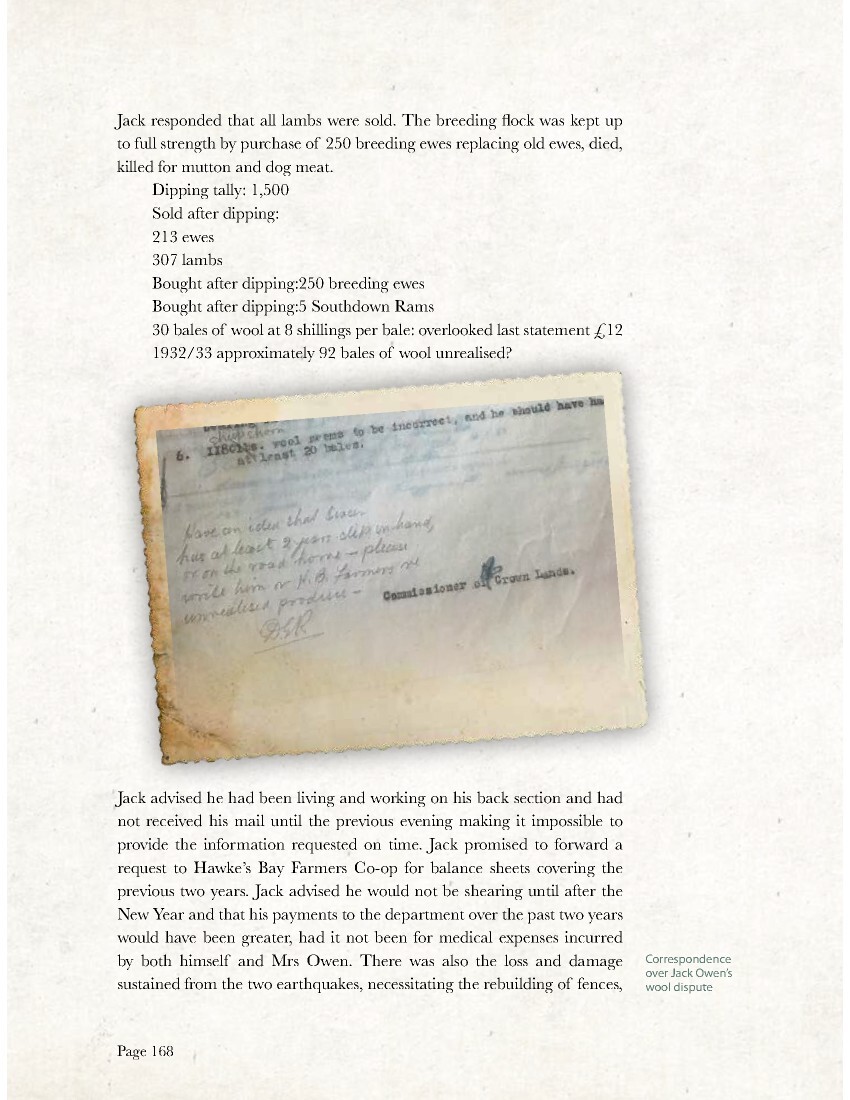
Page 169
and replacement of tanks, and household goods and the cost of having to employ labour because of his medical issues. 49
December 1933
A memo: noted 30 bales of scoured wool was shipped home (UK).
The Commissioner recommended the Minister declare Jack’s farm be forfeited.
December 1933
The Commissioner wrote to the Under-Secretary of Lands that he was convinced along with members of the Board, through confidential information and investigations carried out by Field Inspector Robertson indicating Jack Owen was not ‘playing the game and that he had no intention of making any payments, if he could avoid them. Furthermore, Jack Owen was one of the principal ringleaders of dissent on the settlement for what the department believed was a movement for ‘non-payment of rent’.
The Board knew Jack Owen was farming his property efficiently but regarded a £20 payment to the Board since July 1930 as ridiculous.
They noted two other settlers were in the same situation, and suggested action should be taken in respect of outstanding arrears.
The three leases being: Owen, Jackson and Birrell; the Board recommended the three leases be forfeited.
The Commissioner wrote to the three settlers advising them that the Crown required a full break down of all revenue of their farms.
January 1934
Jack Owen paid the board one year’s rent and explained that his war pension had been used to pay the doctor, and motorcar expenses.
January 1935
Jack Owen wrote to the Chairman of the Land Board asking if he could use the money set aside to pay rent and interest, for moving the house and outbuildings to Titirangi, suggesting that four rooms could be added to the cottage.
49 Local gossip of the time had it that Jack moved his family out to the back whare to avoid his creditors.
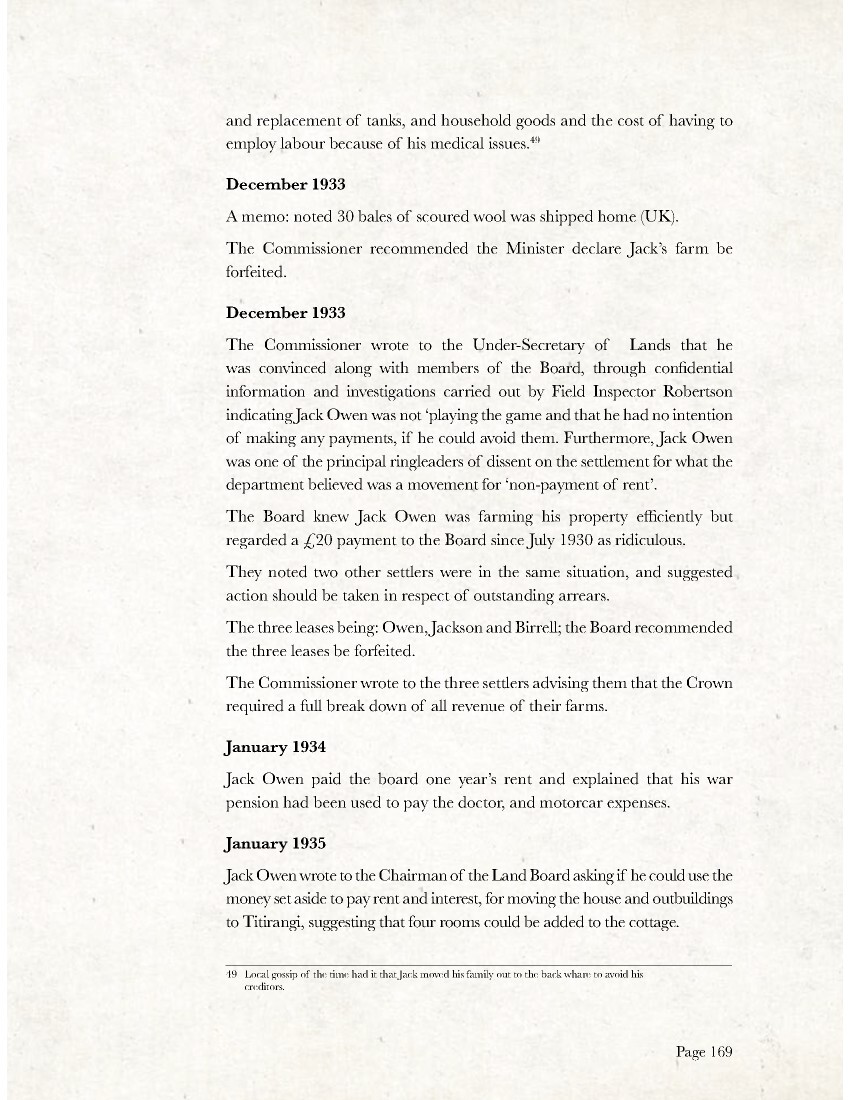
Page 170
The Ardkeen Road was now serviceable.
March 1935
Jack finally surrendered his homestead section at Ardkeen.
June 1936
Field Ranger Robertson inspected Jack’s house:
A 30’ x 30’ building with two brick chimneys, with six rooms: cost £550.
Man’s whare 10’ x 9’ – £30
Garage and manure shed at Titirangi.
APPLICATION UNDER THE MORTGAGE TENANTS RELIEF ACT February 1937
An application was considered by the Gisborne Mortgagors Adjustment Commission.
Mr Jones acting for Jack Owen stated that this man had lost about £900 in stock in 1926 and 1927. He had put £3,000 by way of improvements into the property. The Crown’s advance: £1,000, the balance his own. His main block was seven miles from his homestead section.
He leased 73 acres of Harbour Board endowment land adjoining, plus acquired 144 acres, 2 miles from his main farm, needing bush and scrub clearing.
He was a married man, 50 years of age with one child; until recently living in a two-roomed whare, requiring a homestead on the farm.
The application was made for, a year’s rent free to enable him to build a house, remission of arrears of rent and interest, a reduction of rent to 4/-, and a reduction of interest on mortgage.
Mr Anderson acting for the department, explained the constant difficulty
Jack Owen’s house plan
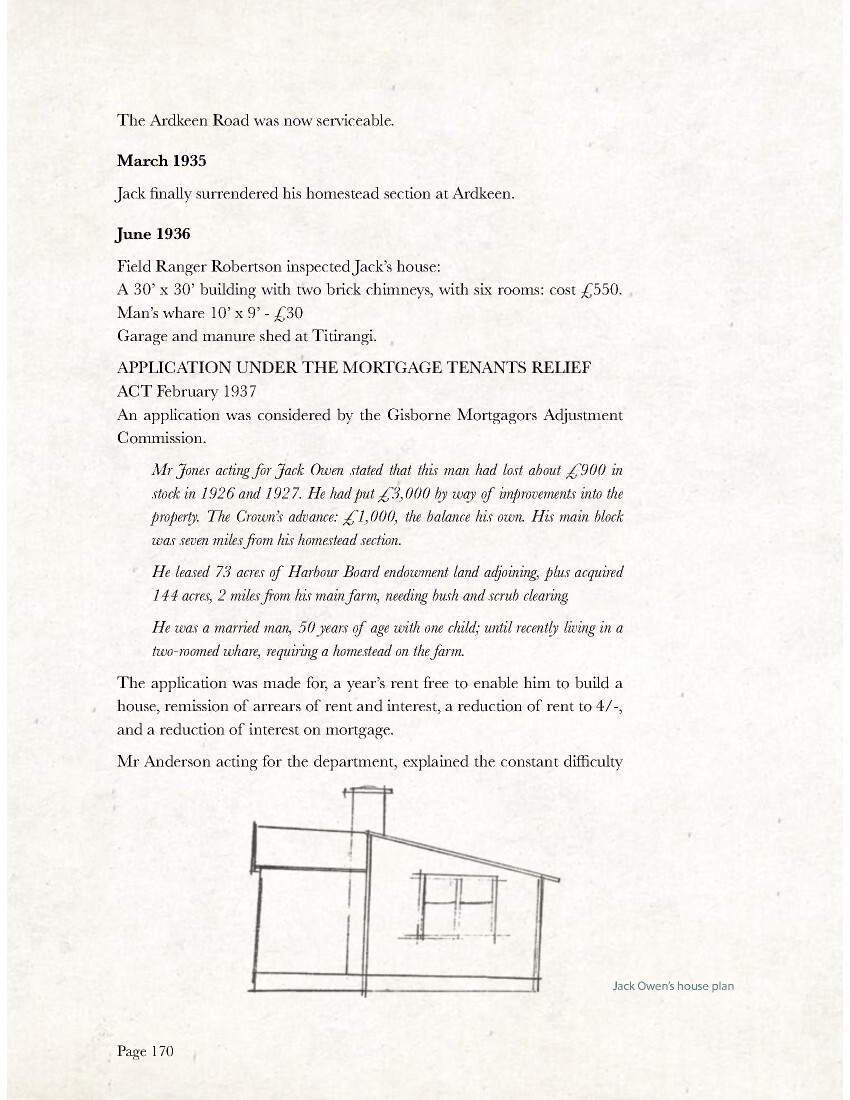
Page 171
of getting payment from Owen. Hawke’s Bay Farmers Co-op held a stock mortgage; the difficulty of getting rent was also noted.
Owen paid charges in 1936. However, nothing had been paid from 1930 to 1934, except £19.19.6. The firm would have refused to pay, until forfeiture was threatened. Then they only paid to protect their position.
Owen’s position had been investigated from time to time; it did not appear he was paying as much as he could.
The firm held security over the stock. They were reducing their exposure, and building up Owen’s equity in the stock, at the expense of paying rent.
It was noted the settler had full protection under his lease for improvements; it was unfair to allow him to effect improvements with the department’s rent money, then, for him to claim, as he could, compensation for those improvements, at the end of his lease.
Now an application had been lodged which gave the ‘Adjustment Commission’ the authority needed to order a distribution of the surplus.
The Commissioner held that the department had agreed to revalue the Ardkeen farms and reduce rents but they would not authorise distribution until all applications were presented, after revaluation.
At a special meeting of the Adjustment Commission, a request was made by the Government for distribution of any surplus revenue. Attention was drawn to non-payment by stock firms since 1934, who retained farm proceeds to reduce settler accounts, at the expense of the Department of Lands.
An application under the Rehabilitation Act was available for the Adjustment Commission, to exercise their authority and order distribution of any surplus held by stock firms.
The Commission instructed the Department to revalue the Ardkeen farms and reduce rents, however they would not authorise a distribution until all applications had been heard.
Jack Owen handed his homestead section back [to] the Crown in exchange for a piece of waste ground that linked Section 11s to Section 10s that was part of the McKay’s farm.
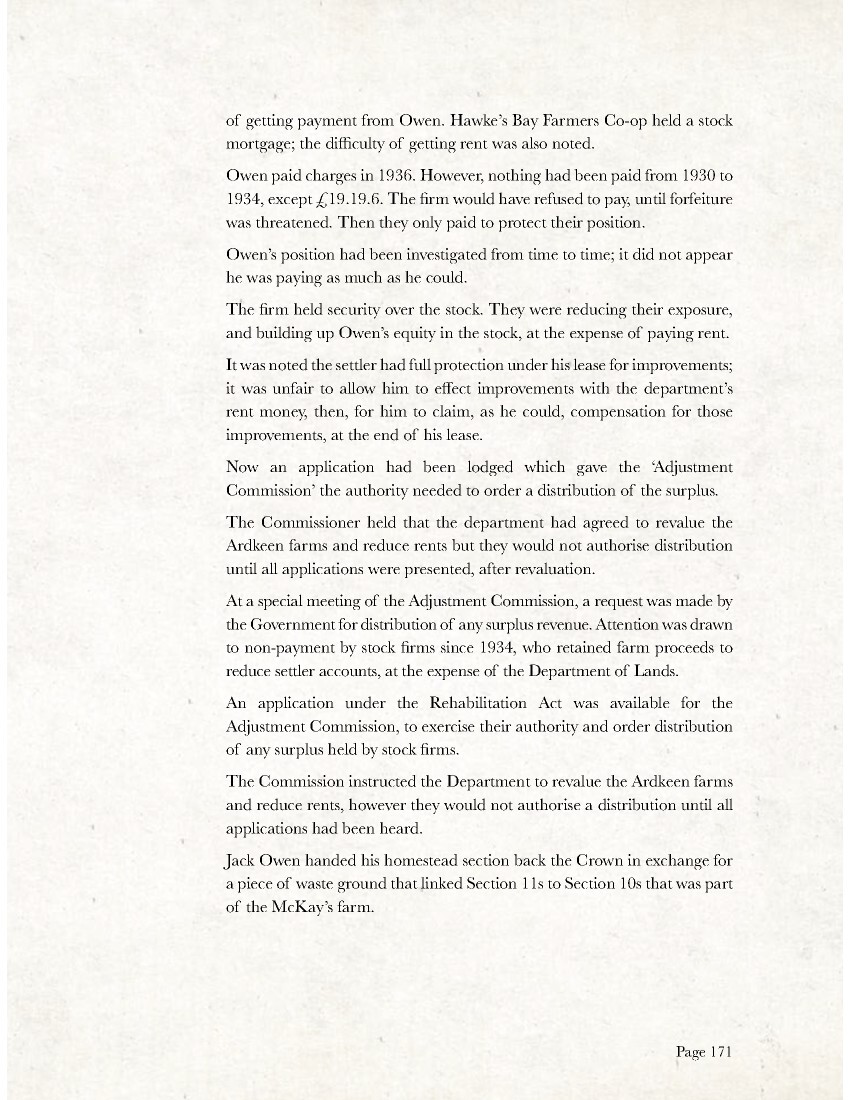
Page 172
RECENT HISTORY
Jack’s son Harry on leaving school in 1954 worked on Ardkeen under a manager. After his marriage in November 1957, he ran the farm for the family farming company (Owen’s Farms Limited). In 1961 after the death of his father on November 7, 1960, he took over ownership of the farm.
Harry died in England in July 1993 while on holiday. He is buried at Wairoa. After wife Leita’s death, the farm was sold to Bill and Fiona Prestage in 2003. In 2018 Bill and Fiona sold the part of Lot 1 of Section 10s to Ivan Swann. The Swanns now farm the whole of the original McKay Section 10s, plus all of O’Kane’s Section 5s at Titirangi.
Section 11s plus the 95 acres of the Harbour Board Reserve, Bill and Fiona Prestage sold to Roger Allott and Theresa Hoyle in 2018.
Owen Whare: Jack, Daphne & baby Cliff (the future mayor of Wairoa) lived here from 1929-31, a two-hour journey by horse to the main road.
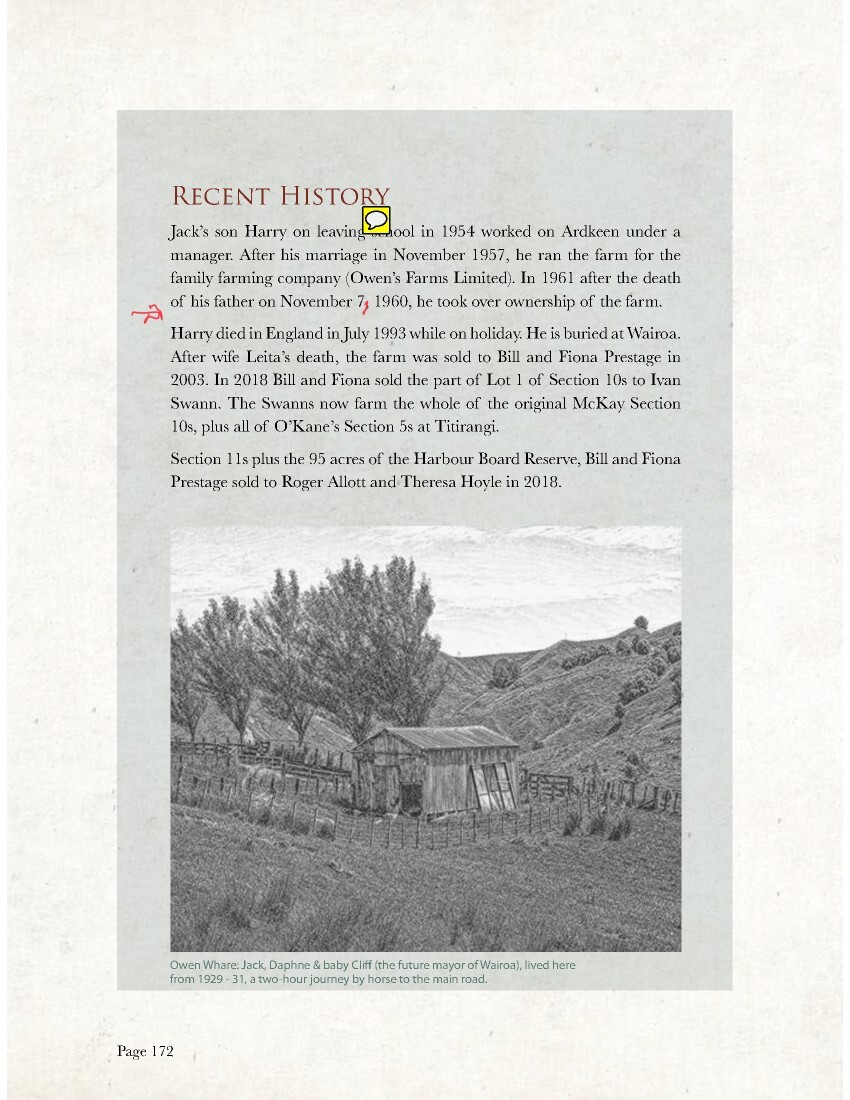
Page 174
ROBERT WILLSON PRESTON (BOB)
MILITARY SUMMARY
Date of Birth: 18 March 1897
Place of Birth: Manutuke
Parents: Tom and Edith Julia Preston née Willson
Next of Kin: T Preston, father, Manutuke
Last NZ Address: Manutuke
Marital Status: Single – Married 1923 Eva Maude Richardson
Occupation: Shepherd
Employer: E Steggal, Waipaoa, Whatututu
Regimental No: 65696
Rank: Trooper
Death: 13 January 1967 Wairoa
Buried: Wairoa Cemetery Awards: British War Medal, Victory Medal
Other service: WWII 2/20b/99 Home Defence 18 Sep: Posted to 33rd Reinforcements D Company as Private
1917
18 Jun: Attestation signed at Gisborne
04 Oct: Transferred to 35th Reinforcements NZ Mounted Rifles
21 Oct: Admitted Featherston Camp hospital – influenza
26 Oct: Discharged from hospital
1918
14 Feb: Date of commencement of active service reckoned
21 Feb: Embarked from Wellington on board Moeraki. Transhipped at Sydney to RMS Ormonde
01 Mar: Admitted to hospital on board Ormonde – bronchitis – discharged from hospital 7 March

Page 175
04 Apr: Disembarked Suez. Marched into Moascar – posted to NZ Mounted Rifle Training
11 May: Posted to Wellington Mounted Rifles 2nd Squadron
15 May: Transferred to NZ Mounted Rifle Brigade
24 May: Posted from Training Regiment
07 Jul: Detached to Brigade Transport
10 Jul: Sick to hospital – malaria. Admitted NZ Mounted Field Ambulance
15 Jul: Admitted 47th Stationary Hospital, Gaza
26 Jul: Admitted 24th Stationary Hospital, Kantara, Egypt
29 Jul: Admitted 27th General Hospital, Abbassia
26 Aug: Admitted Aotea Convalescent Hospital, Heliopolis
07 Oct: Discharged to duty, Ismailia 12 Oct: Marched out to NZ Mounted Rifle Brigade
24 Oct: Re-joined Wellington Mounted Rifles
1st Dec: Embarked for NZ per RL Malta from Suez
1919
29 Jan: Disembarked NZ
26 Feb: Discharged on termination of period of engagement
Total Service: 1 year 162 days (including 343 days overseas)
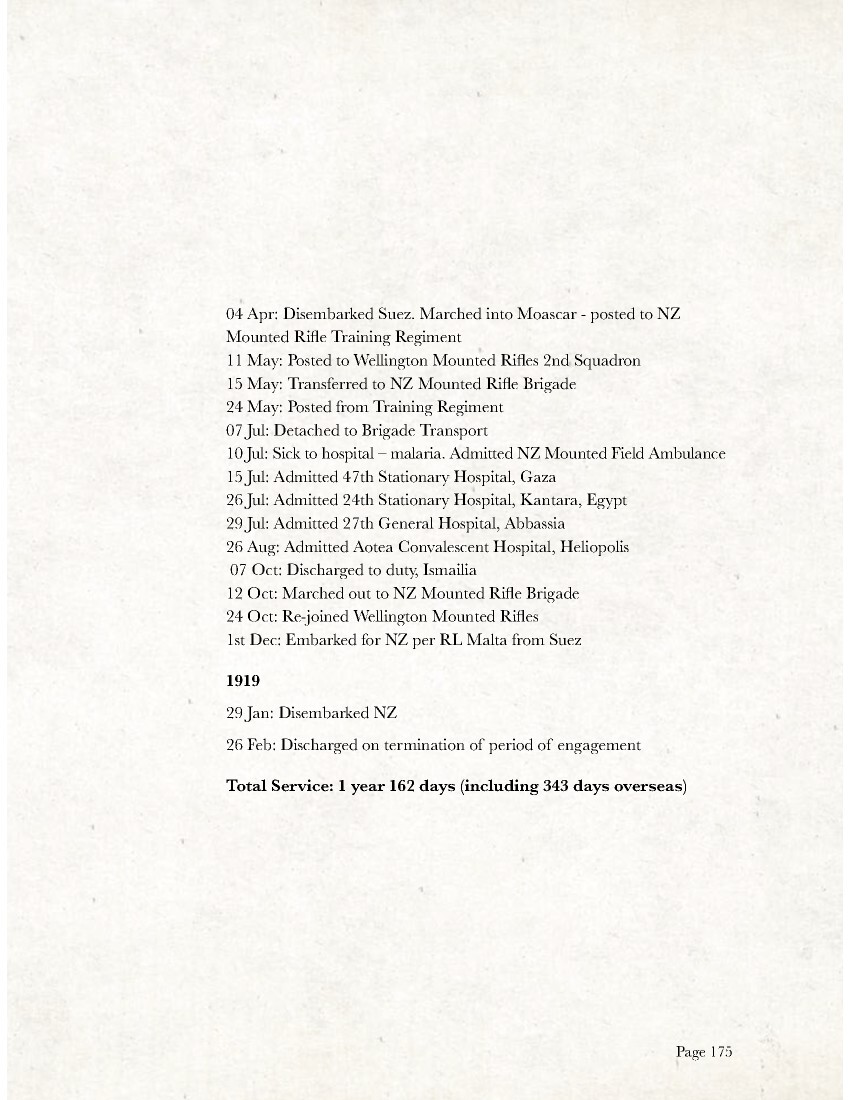
Page 176
LAND BALLOT
Ardkeen Section 12s, 513 acres
Ballot awarded to: Bob Preston
Bob Preston sought authority from the Commissioner to graze his cattle on Joe Henson’s farm at Ohuka. The Commissioner replied there was no grazing, as Joe would be returning the next month.
Field Ranger Robertson recognised Bob Preston was an experienced farmer, but like nearly all the settlers, he was struggling to meet his commitments.
April 1923
Bob advised the Commissioner he was building a small house on his homestead section at Ardkeen and had asked his father to drop in the plan, saying he had called tenders.
June 1923
The department replied that no advance could be made for building a house until he reduced his indebtedness.
June 1923
Bob Preston’s father guaranteed him a £2,100 overdraft at the bank. It was noted that over the past three years the section had produced £300 to £400 of wool; his overdraft stood at £1,000.
December 1923
Bob reported his section had two disadvantages; his homestead and farm were seven miles apart, requiring four hours in the saddle each way, which was a large expense especially at mustering times. Secondly he had stock tracks on two boundaries, with a third running through the centre of the farm. Thirteen settlers pass backwards and forwards with their stock at crutching, dipping and shearing times; Bob’s stock had to be cleared to allow each mob through; this meant continually chasing them to one side of the paddock. Weak animals were often left behind; they ate Bob’s grass, and he lost stock when they got themselves mixed into the mobs passing
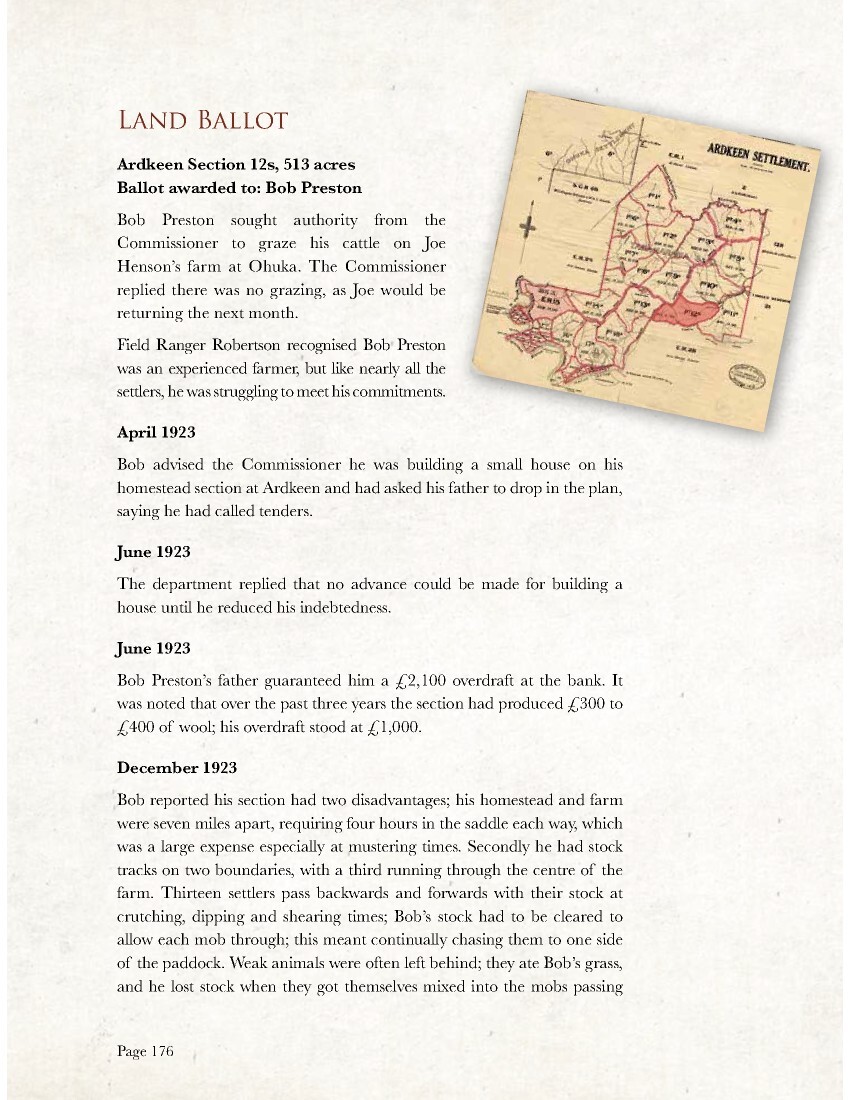
Page 177
through or when gates were occasionally left open. The farm was too small to pay for the two miles and six chains of fence needed to enclose the stock tracks.
March 1924
Bob struggled to meet his commitments; he’d had excess feed and bought cattle to eat the grass. Now stock prices had fallen sixty to seventy percent, and he was unable to pay the interest despite selling 720 sheep.
June 1925
Bob was granted a lease of Harbour Board bush land; the ‘Bush Block’ a three-mile ride from his main farm, accessed through Mahanga Station.
January 1926
By this time Bob had built a three-roomed house with bathroom, wash house, dairy, a double brick chimney, and hot and cold water costing £535.
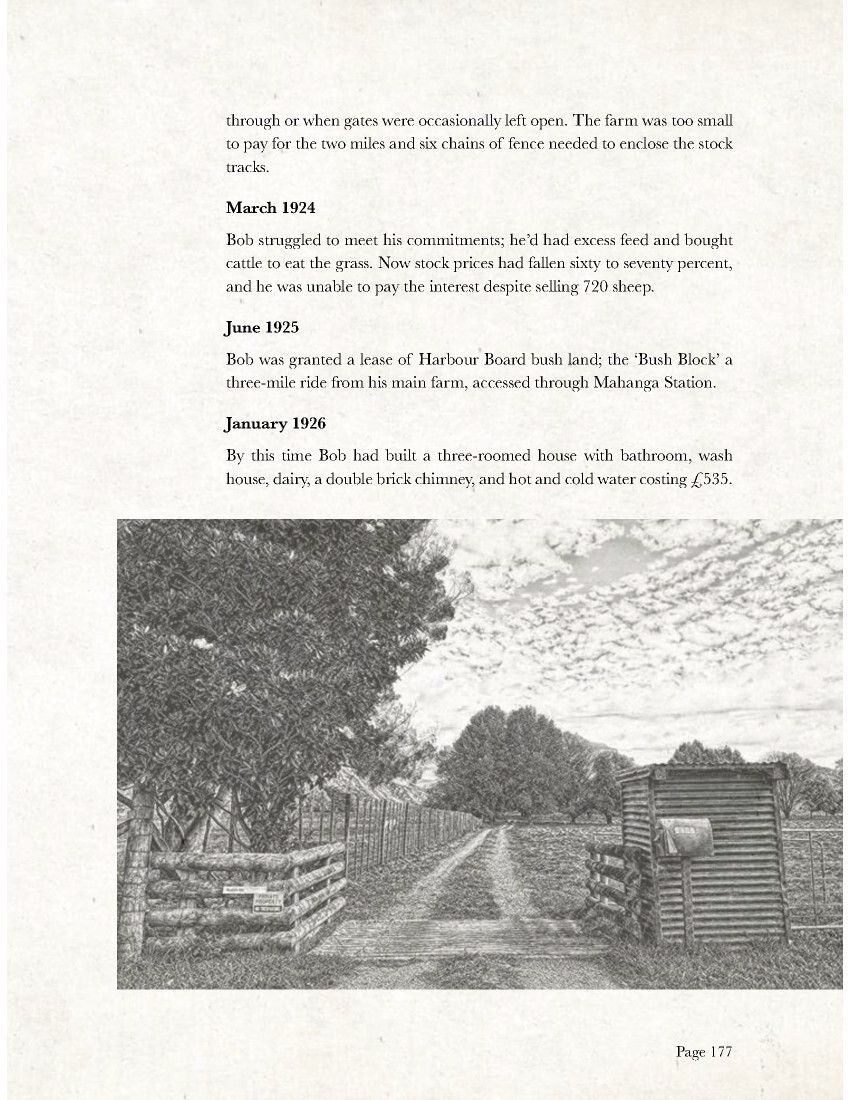
Page 178
September 1926
Bob split fence posts from the Totara logs on the recently acquired 429 acres of Harbour Board endowment lease. He packed the posts to Frasertown, about an hour and half journey through Mahanga and Pakowhai where he sold them for £6 per hundred. He had cleared some of the bush at a cost of £2 an acre and was farming a sheep per acre.
At an interview with the Land Board, Mr Wicksteed predicted that wool would be worth less than last year. Bob replied he would be finished, if that happened, reckoning 10p is the lowest he could produce it for. When asked what he got for the wool last year, Bob replied “10p”.
When the Commissioner visited Ardkeen, he promised Bob Preston and Paddy O’Kane they could have money to grass the newly cleared land known as the ‘Bush Block’. Bob had spent £400 on grass seed and sowing, only to discover no one would lend him the money to pay for it.
Mr Wicksteed asked if he could raise sufficient money from the sale of posts to pay for the grassing. Bob responded that money had already gone to Dalgety’s. Bob reckoned he had 1,200 ewes on the farm; the resulting income would clear Dalgety’s account, including money from the sale of fence posts.
Mr Wicksteed asked what he had to sell.
Bob: “Nothing; I’m splitting posts and selling them in Frasertown. Since arriving on Ardkeen and with the extra area, despite the dry season, the grass growth had been good.”
Mr Reed observed: “That is if you do not pay any rent”.
Bob: “Slinging a bit of sarcasm there!”
Mr Wicksteed: “What provision are you making for the rent?”
Bob: “Lend me £450 for the grass seed; there is the rent.”
Mr Donovan: “Dalgety’s want all the proceeds from the farm and ignore the Government’s rent.”
Mr Farnie observed: “Dalgety’s is who should be asked to pay half a year’s rent.”
The Commissioner wrote to Dalgety’s asking for half a year’s rent.

Page 180
Dalgety’s replied asking about the unpaid grass seed, arguing the Board had promised to pay, along with the cost of clearing and fencing for the ‘Harbour Board Endowment Lease Land’.
The Commissioner responded that at no time had he promised Mr Preston the Government would pay for clearing and fencing the land. He stressed that Bob Preston was told that the Commissioner would recommend the Board meet the cost, however the Board was unable to pay. The Board felt Mr Preston should finance the development himself, stating that unless half a year’s rent plus interest was paid, Mr Preston’s leases would be terminated.
The Commissioner added the department would not allow Dalgety’s, or any other stock firm, to retain all the proceeds from Bob Preston’s farm.
Joe Anderson, manager of Dalgety’s wrote that he had difficulty understanding whether Bob Preston had been advised by the Board to ask Dalgety’s for the grass seed. Dalgety’s had believed the money would be refunded by the Board, pointing out that Dalgety’s advances were temporary and secured against the livestock.
October 1926
The Commissioner replied that the department was not responsible for representations made by Mr Preston. He said he was never told the Board would pay for the grass seed.
The Commissioner said he would recommend the forfeiture of Bob’s leases at the next meeting.
October 1926
Bob wrote to the Commissioner saying Dalgety’s had refused to pay the rent and enclosed a money order for interest due. He said the cash came from the sale of fence posts; Bob asked if the Board would meet him in some way with regard to the balance.
A memo:
This man appeared before the Land Board about the forfeiture of his farm for the non-payment of rent; he had one year’s rent owing. He told the Board he would arrange to have Dalgety’s pay one half year’s rent, the Board asked Bob Preston to approach Dalgety’s and explain the position.

Page 181
The Commissioner wrote to Dalgety’s after the meeting advising that unless one half year’s rent and current-account interest was paid, Bob Preston’s tenancy would terminate.
October 1926
The Board wrote to Bob about the proceeds from the sale of fence posts going to Dalgety’s and pointed out the posts were a Crown asset, therefore the Board owned the proceeds, and would apply the fund to Bob’s rent account.
January 1927
Dalgety’s made a payment using the proceeds from fence posts as part payment of rent and interest.
February 1927
At an interview with the Land Board, Bob was asked if he was doing well from the sale of fence-posts?
Bob replied; “Oh yes, I have another 400 to sell and about a thousand to split ahead of me”.
Asked if he was paying for the packing, Bob replied that he was but he intended to do the packing himself now that he had built a whare on site. Stating: “A man cannot do everything”.
When asked if he was doing all this himself, he replied he had a boy who stays at the camp with him.
He was asked if he had a home, if he was married? Bob replied: “Yes, my wife is staying with her father.”
Bob was asked what he had done with his lambs, and what was for sale, and how he proposed to pay for replacement ewes.
Bob said he could only pay half a year’s rent because there was his debt with Dalgety’s still after paying rates, and the proceeds from wool and lambs were paid in, less this year’s rent and half of next year’s rent, plus the cost of more sheep. He would need help from the department.
Bob pointed out he was losing the 10% rebate on rent, because of late payment and observed, when rent was postponed by the Board, the rebate was not lost. Bob had been losing £30 rebate for the last two years. The Board conceded it was hard losing the rebate, and suggested he pay the

Page 182
rent, and apply for a postponement of the next payment when it fell due.
It was pointed out he had proceeds from lambs, and wool, plus the fence post sales.
The Board granted Bob’s postponement allowing him the rebate to help him through the winter months when there was no income.
Bob supposed that would be all right; suggesting he would scrape along, adding he would get another 3,000 fence posts out of the bush.
The Board told Bob Preston he had done well.
March 1927
Bob wrote to the Commissioner apologising that he had been unable to keep his side of the deal because the manager of Dalgety’s refused to pay the rent, claiming there was insufficient security in his livestock. Bob said he was fully stocked and had stock to sell that would enable him to pay at least some rent, promising to fix the matter as soon as possible.
The Board felt Dalgety’s were using Bob to penalise the Department and decided to bring the matter to a head. The Commissioners believed Bob had done particularly well from the additional area.
The department had cause for ‘Distraint’ for a year’s rent, but did not consider that advisable, noting that if the Board forfeited the lease, Dalgety’s would find the rent money.
April 1927
Bob paid the overdue rent from his pocket-book.
June 1927
Bob wrote to the Commissioner saying he had been unable to split more fence posts because Mrs Preston was in hospital.
August 1927
Bob’s affairs came before the Board; Bob’s overdraft with Dalgety’s had been increased because he had to pay for grass seed. Mr Robertson the Field Ranger reported a good margin after expenses, bringing into question the justification for postponing the rent, noting that the position would right itself by simply allowing the rent to stand over, only Bob would lose his 10% rebate.
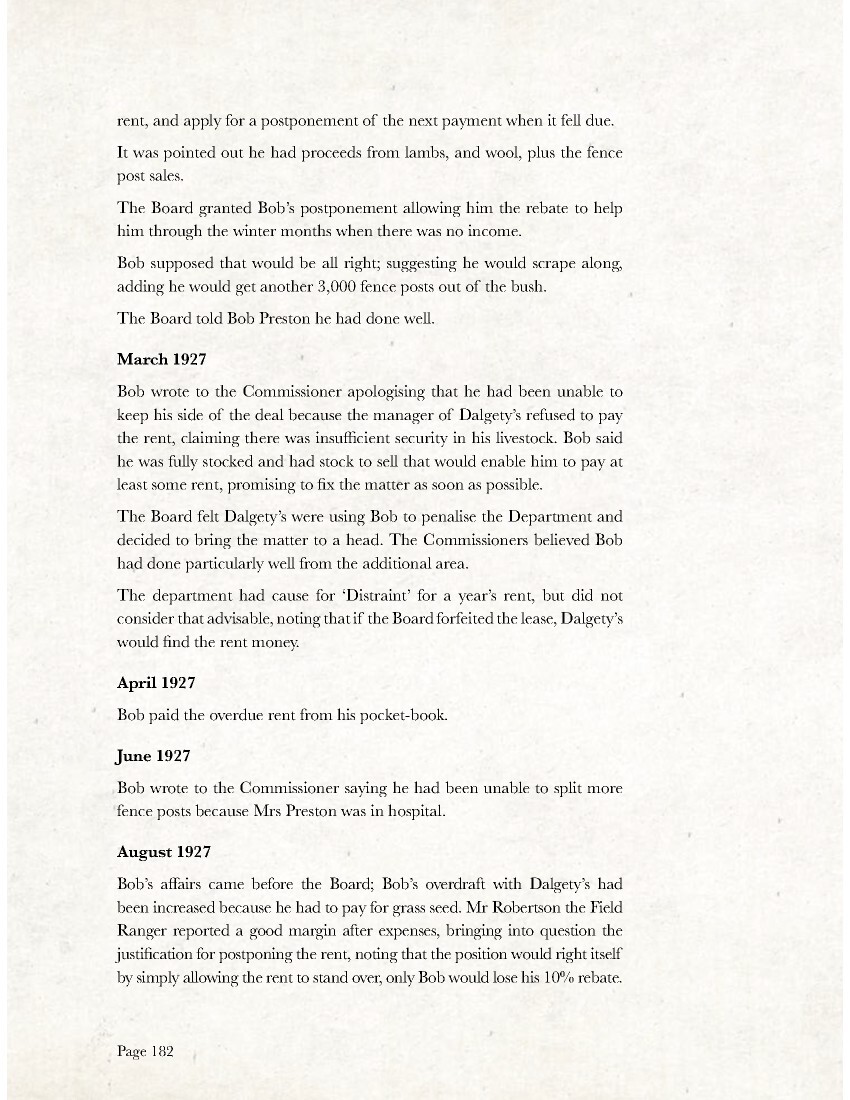
Page 183
The Board had to be careful when granting concessions because it is sure to be known by other settlers who would expect the same.
October 1940
Bob Preston was in difficulties; he had borrowed £700 from the department for clear-felling the bush, but had to pay for the grass seed himself, taking his overdraft with Dalgety’s above the limit. He had hoped to recover the seed cost from the Board, but they had refused, saying he was a good settler and was granted an extra 471 acres bush reserve, close to his original holding. However, the clearing, grassing, fencing and stocking of this area had cost more than expected. Bob had got behind, though he was recovering; with another good season he felt he would be on his feet. He managed his farm well, with good lambing percentages and all lambs going away fat.
Bob entered into a profit-sharing arrangement with Dalgety’s for the latter part of the Depression.
Bob wrote to the Commissioner advising he would no longer require the use of the Ardkeen community woolshed, as he had built a woolshed at a cost of £200.
Preston woolshed built October 1940
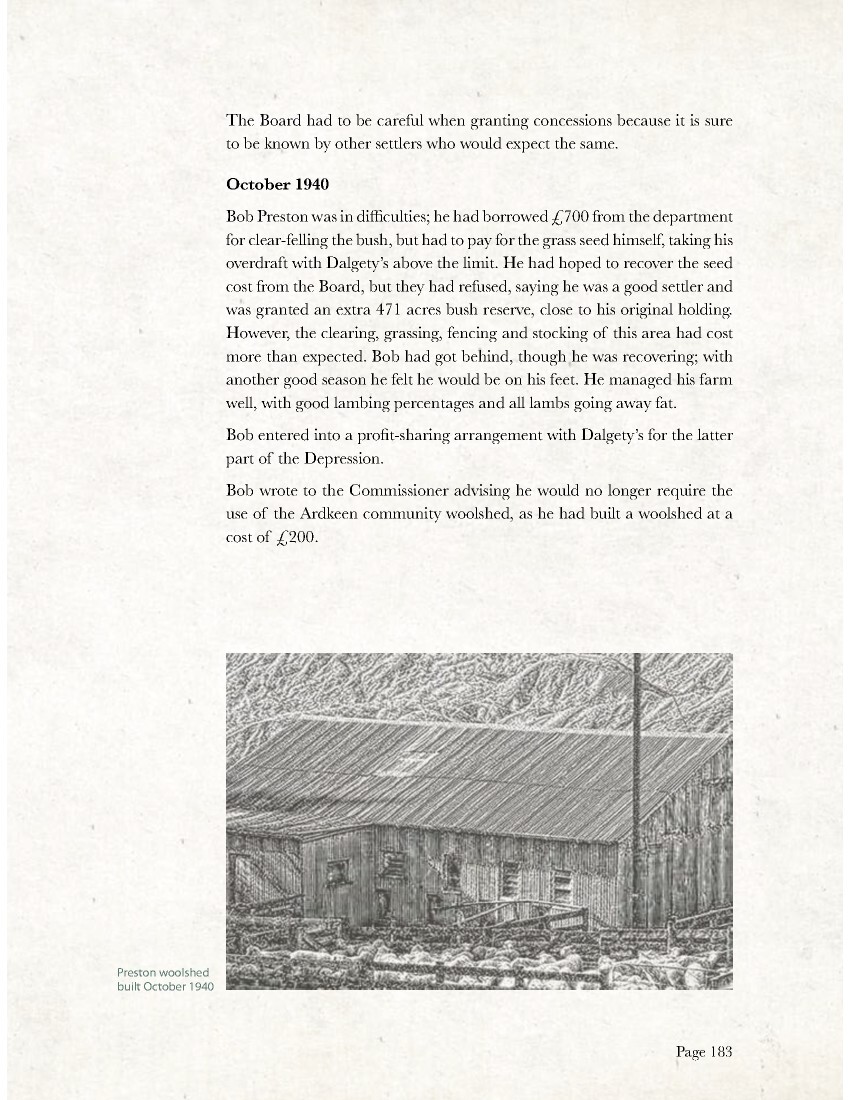
Page 185
RECENT HISTORY
Ray Aires managed the farm for Bob 1964 – 65.
Mark and Diane Burridge managed it for the Public Trust from 1969 to 1974.
John and Sue Kelt continued as managers through 1974 to 1979 followed by Ian Denton 1979 – 1990.
In the same year, Neville Rofe bought the farm. Neville sold to Roger Allott in 2001.
The Allotts farm the whole of Sections 11s, 12s at Titirangi Road including the original Harbour Board Bush Block: total area 1,633 acres.
The Preston Homestead Section 12s became the home of the McLagan family. Mrs McLagan was Bob Preston’s daughter.
Murray McLagan sold the homestead section to Martin Kerley in 1981.
Then in 1996 Craig and Jan Little bought the section and in 1989 they sold the section to Clinton Broad.
New neighbours Jean and John Martin bought the section of 12s in 2019. The Martins currently own the homestead sections of 12s, 13s and 14s, a total of 123 acres.
Photo caption – Mr and Mrs Preston

Page 186
WILLIAM CARSON (BILL)
MILITARY SUMMARY
Date of Birth: 3 May 1893
Place of Birth: Waipawa
Parents: Thomas and Mary Carson née Avison
Next of Kin: Thomas Carson, father, Waipawa
Last NZ Address: Ruataniwha St, Waipawa
Marital Status: Single – Married 1925 Grace Letitia Wedd
Occupation: Self-employed motor mechanic
Regimental No: 32125
Rank: Private
Death: 1 December 1966 Hastings
Buried: Wairoa Cemetery
Awards: British War Medal, Victory Medal
Other service: 17th Regiment Territorials
1916
24 Jul: Enlisted at Trentham. Posted to 19th Reinforcements F Company
15 Nov: Embarked from Wellington 1917
1917
29 Jan: Disembarked at Devonport, England. Marched into Sling Camp, Bulford, Wiltshire. Posted to 1st Canterbury Company 3rd Reserve Battalion
01 Mar: Left for France
03 Mar: Marched into camp at Etaples
12 Oct: Wounded in action [Passchendaele]
14 Oct: Admitted to 1st NZ Field Ambulance – gunshot wound to the scrotum and left thigh. Admitted 44th Casualty Clearing Station
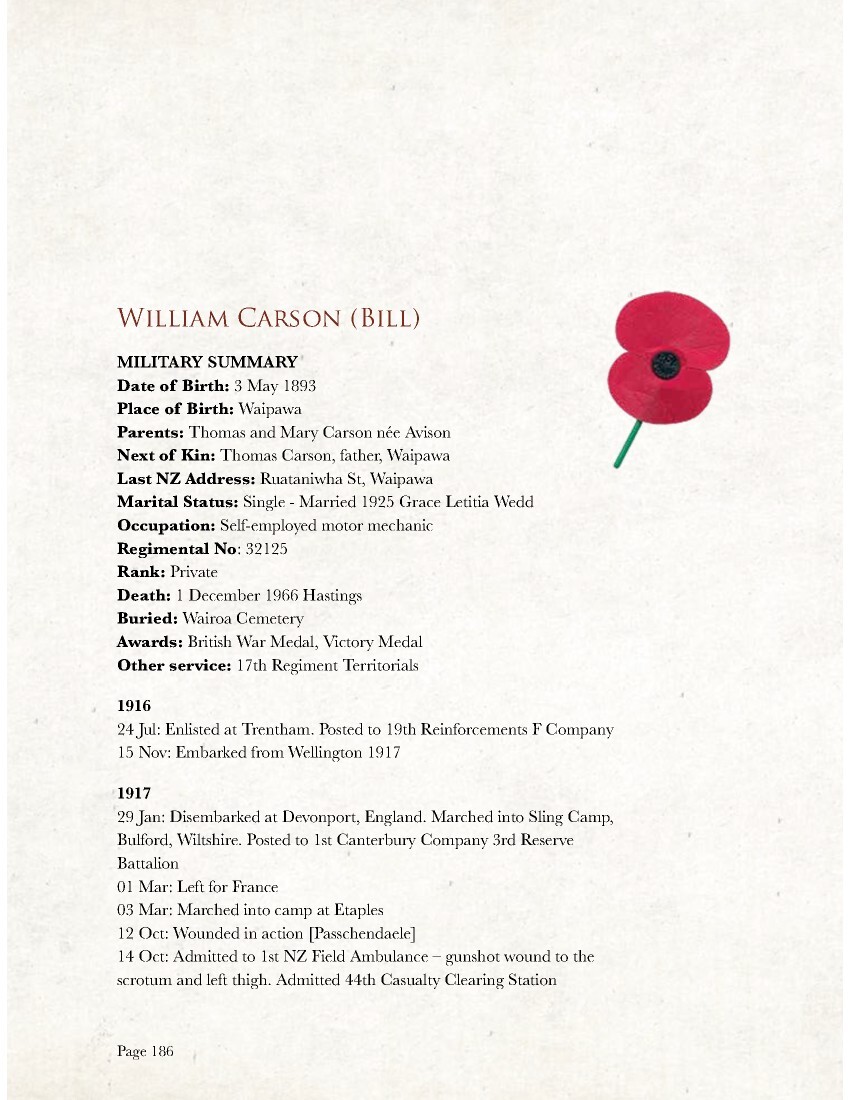
Page 187
01 Nov: Admitted 14th General Hospital at Wimereux
06 Nov: Embarked for England per Hospital Ship. Admitted Tooting Military Hospital, London
1918
05 Jan: Transferred to 1st NZ General Hospital at Brockenhurst
14 Jan: Brockenhurst – Medical Report – rifle bullet traversed lower 1/3 left buttock, upper part of thigh and damaged both testicles, which were extruded from the scrotum, much necrosis testicular tissue exposed from both, especially the right – testes returned to scrotum. Thin and anaemic, has lost one stone in weight. Atrophy and weakness of left thigh, no limitation of movement. Walking ¼ mile causes pain in the testicles and groin, with general feeling of faintness and weakness
28 Jan: Classified unfit by Medical Board and placed on NZ Roll
02 Feb: Embarked for NZ on board Maunganui ex Liverpool
03 Jul: Discharged no longer physically fit for war service on account of wounds received in action (gunshot wound left thigh and scrotum)
Total Service: 1 year 345 days (including 1 year 124 days overseas)
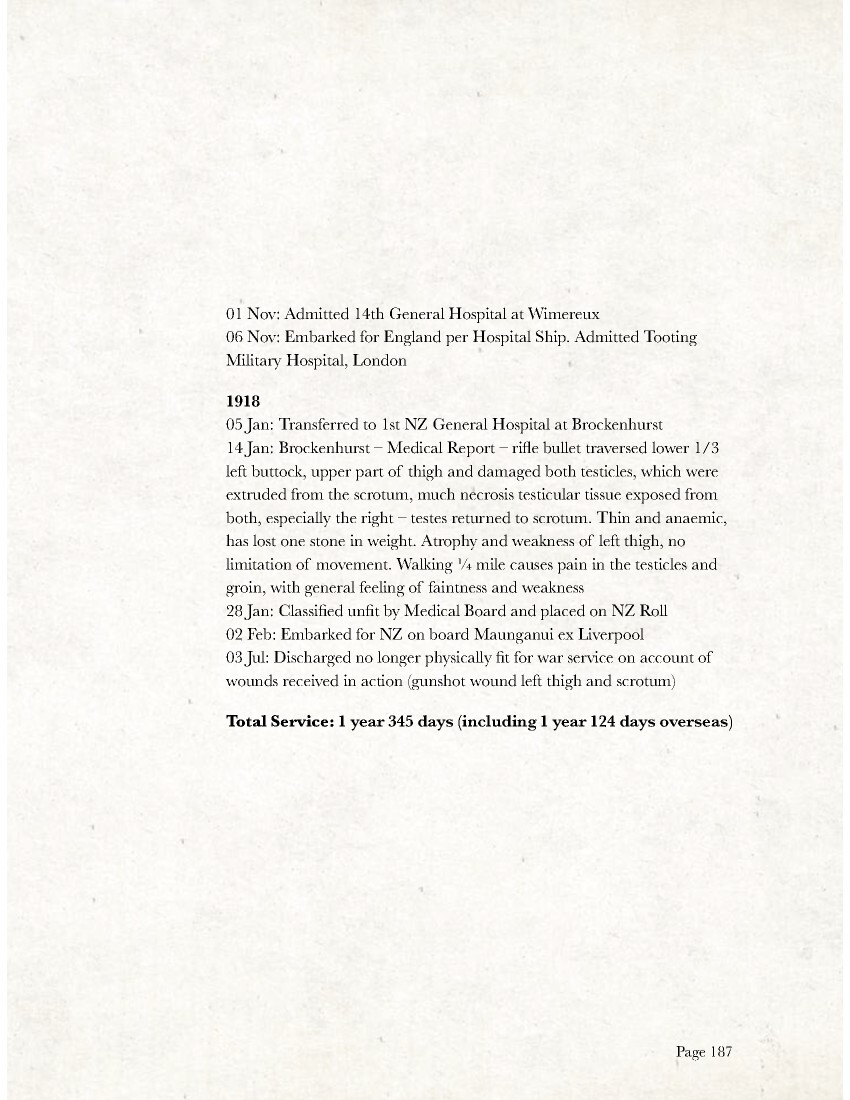
Page 188
LAND BALLOT
Ardkeen Section 13s, 555 Acres
Ballot awarded to: Bill Carson
Bill Carson wrote to the Commissioner asking for as many fence posts as possible because his farm has three stock tracks on its boundaries.
The Crown Land Ranger reported that Bill Carson was a reliable man, without farming experience; Bill had been a motor vehicle mechanic.
August 1924
Bill advised the Land Board he planned to marry and would like to build a house.
September 1924
Bill advised the Commissioner the cost of the house would be between £500 and £600 saying, unless he got an extra advance, he “would be a bit short”.
June 1925
Bill told the Commissioner his house would cost £650 and he would like another £250 for another building. He had erected 280 chains of boundary and subdivision fencing, hung thirteen new hardwood gates, planted 400 shelter trees and erected 25 chains of fencing to secure the trees from livestock. Other improvements included creating a garden, erecting a fowl house and shed and planting an orchard.
He reckoned the cost of the additional work to be in excess of £700.
July 1925
A memo was sent to the minister’s under-secretary about the advance, suggesting the settler’s price for the fencing at 45/- per chain was an ‘absurdly high price’ and the man should do his own fencing.
Plain wire: 1½ ton at 25/- £37
350 posts at £20 – £170
1000 battens at 25/- £25
Post and batten staples – £5
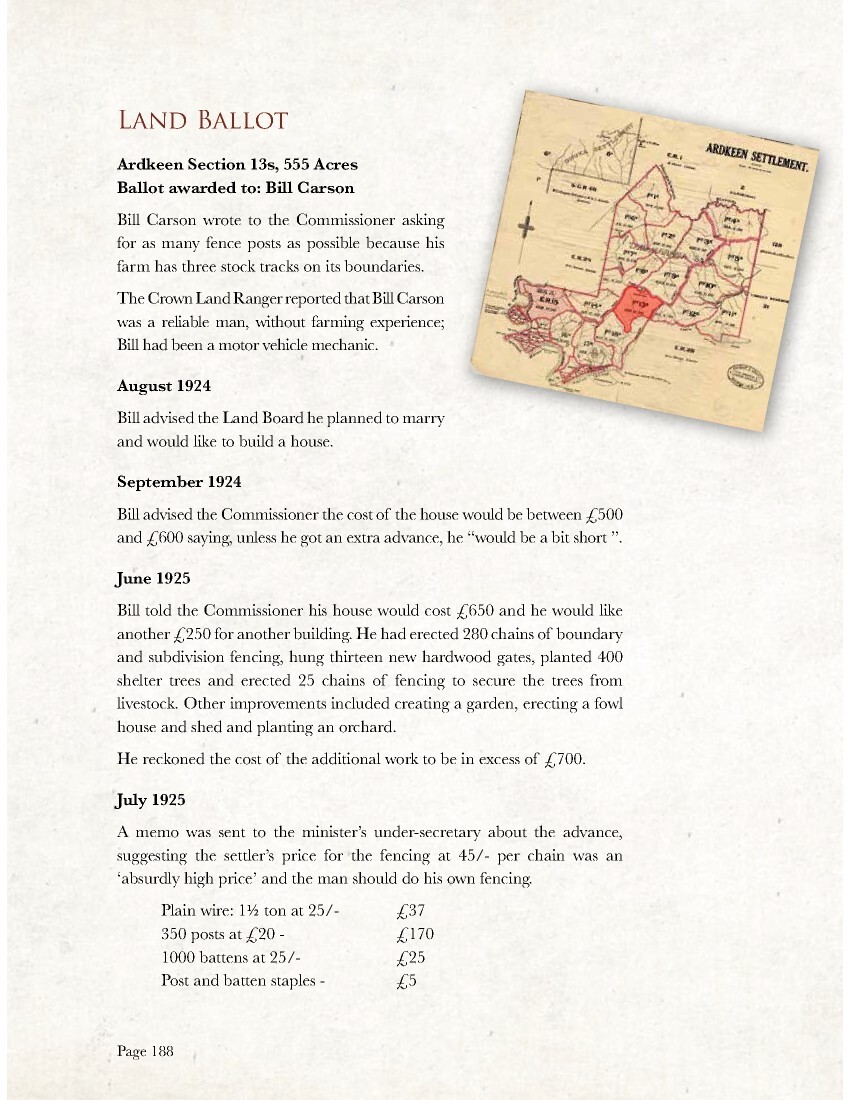
Page 189
Packing and laying timber 24/- (cost as high as wire)
Erection 10/- per chain £40 (usual price 12 and 6)
Gate £2.10
Cost per mile £192.10.0
The Under-Secretary for Lands, Wellington wrote about the cost per chain of new fence, saying that members of the Land Board were farmers who before making recommendations took every care to ascertain the applicant was not paying too much. He referred to the district revaluation committee, when calculating the value of improvements allowed, which was up to £3.10 per chain. Observing that the cost of fencing varied from district to district, he suggested perhaps the writer did not know the price of a regulation fence in the Wairoa district. In his mind the estimate supplied by the Crown Land Ranger, Mr Robertson would provide a more accurate estimate than official statisticians; adding that 55 shillings per chain in the Wairoa district is reasonable.
As to the suggestion this man should do some fencing himself, the Commissioner explained that not every farmer had the skills needed to erect a fence, adding Bill Carson was not an expert fencer. He said Bill Carson was an intelligent, capable farmer who has acquired the knowledge and experience to handle most work about the farm.
He went on to stress the office handles large loans, some to burnt-out, exhausted settlers in the district, despite ‘lending institutions’ controlling proceeds from the farms. However, regular conversations, with a little tact helped the firms’ work with the department by not allowing clients to over indulge in extravagant ideas, and farm management. The firms controlled clients’ spending on ordinary expenses plus living, and incidental expenses, in order that the Crown’s position was not prejudiced by profligacy.
August 1925
The Commissioner wrote that the implication his office failed to obtain guarantees through want of tact was uncalled for, and a slight on the way he conducted his duties.
November 1926
Bill Carson received the ‘Consent to Transfer’ a portion of Malone’s farm.
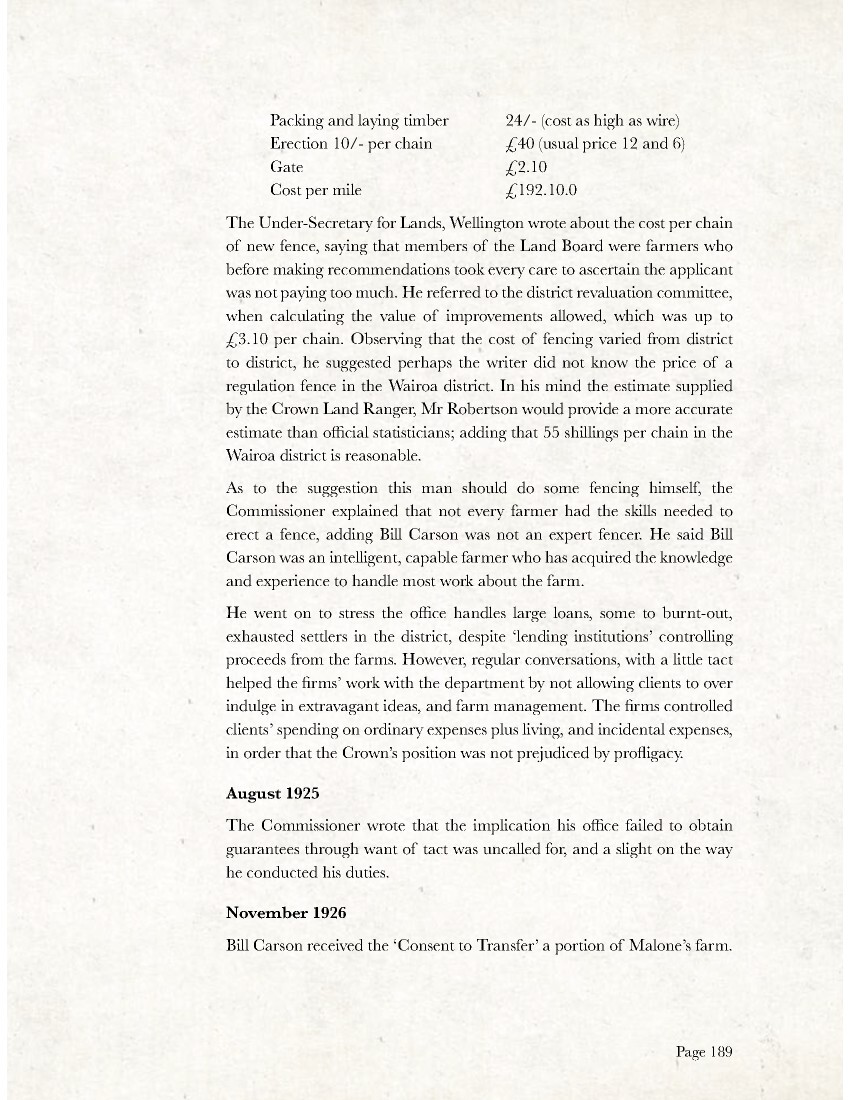
Page 190
December 1927
Bill Carson wrote to the Commissioner of Crown Lands that he wished to lease the homestead section of Mr W. H. Nicol, pointing out the sections adjoin. The Board agreed to divide Nicol’s homestead section of 33 acres equally between Bill Carson and Bob Preston.
October 1928
Bill was asked to terminate the lease he held on section 19s, ‘The ‘Reserve’, noting that all Bill wanted was a quarter-acre section to build a set of sheep yards. The Board agreed to finalise the transfer before the lease was forfeited.
Bill Carson advised the Commissioner that when he settled on Ardkeen, the yards were in a poor state, and it was impossible to work sheep in them; he had replaced gates, netting and yard posts from time to time, along with some wire. Bill considered the rent he was paying to be sufficient to cover all improvements and refused to pay more.
March 1931
Bill Carson lost 17 bales of wool in a fire caused by the Napier earthquake; the Commissioner advised the misfortunes that had befallen other settlers, and the Land Board would provide special consideration to those who suffered loss, and from the present drought.
The Board valued the old sheep yards at £10 saying Bill Carson need not pay more. The Field Inspector had been instructed to look into the matter for the Land Board.
April 1931
Bill wrote to the Commissioner that the yards at the Reserve were still workable when Ardkeen was farmed as a sheep station. However, a current valuation would be very different and the Crown now expected him to pay for his improvements.
February 1932
A letter from the Secretary of the Treasury noted that the wool held in Hawke’s Bay Farmers Wool Store was destroyed. The Minister recommended £65 compensation, and a further £25 for fencing.
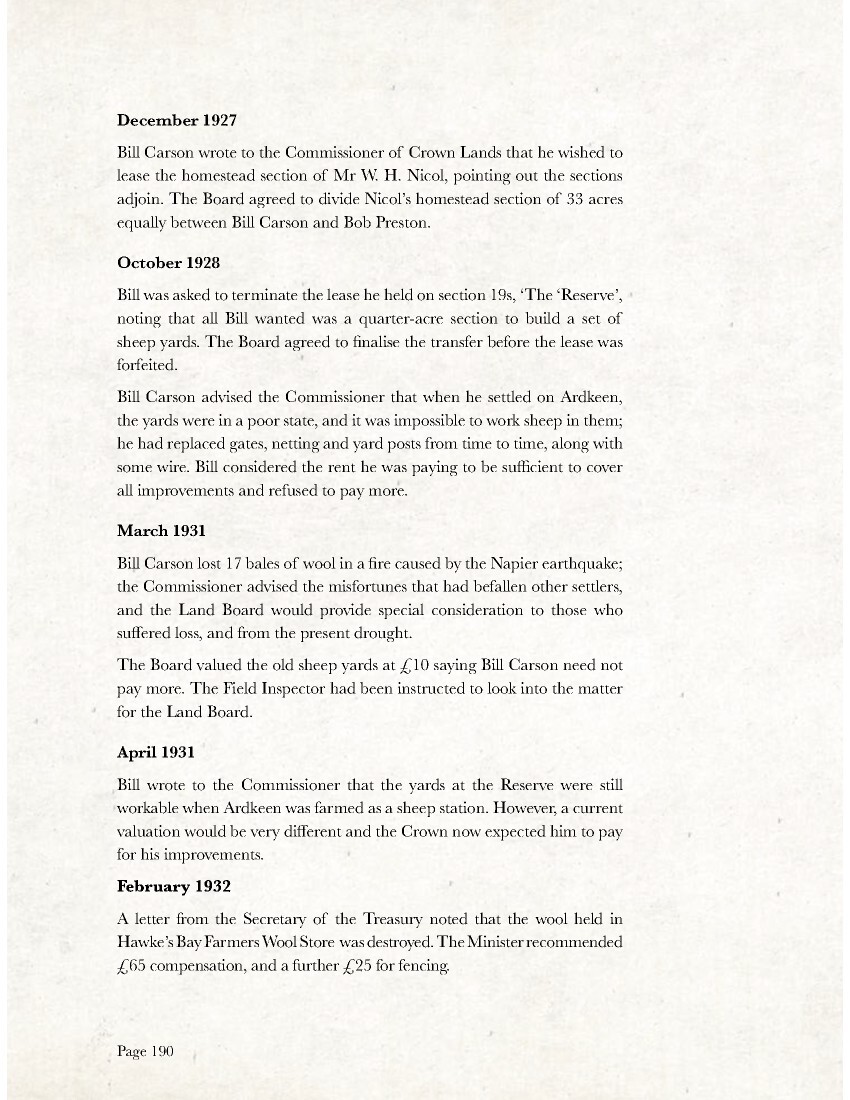
Page 191
July 1937
Report of Special Valuation Committee:
Carson was described as dependable, competent and of good husbandry: he controlled revenue well. The applicant’s health was good however, his wife suffered ill-health.
The property should winter seven dairy cows; surplus after expenses £357. Stock on hand
1935: 900 breeding ewes, 200 hoggets, 130 cattle
1936: 900 wethers, 180 hoggets, 144 cattle
He had carried these numbers in the past, but stated it was too many.
Mr Surgeon of the Valuation Committee was called and sworn as to the nature of the report.
Our production of previous stock figures upset the arguments in respect of budgets that were produced by Mr Jones. The men on Ardkeen did not think it good practice to farm blackface sheep, but wiser to run a standard flock. All admitted to changing and reducing flock numbers.
Photo caption – Grace Letitia Wedd married William Carson
At St Paul’s Presbyterian Church, Otane on August 19th. Grace Letitia, eldest daughter of Mr and Mrs A. C. Wedd, Otane to William, second son of Mr and Mrs T Carson, Waipawa. Bridesmaid Miss Anne Wedd, Bestman Mr Henry Limbrick.
Reception in Town Hall, wedding cake was a gift to the bride from her Aunt, Mrs W. Clark, Argyll
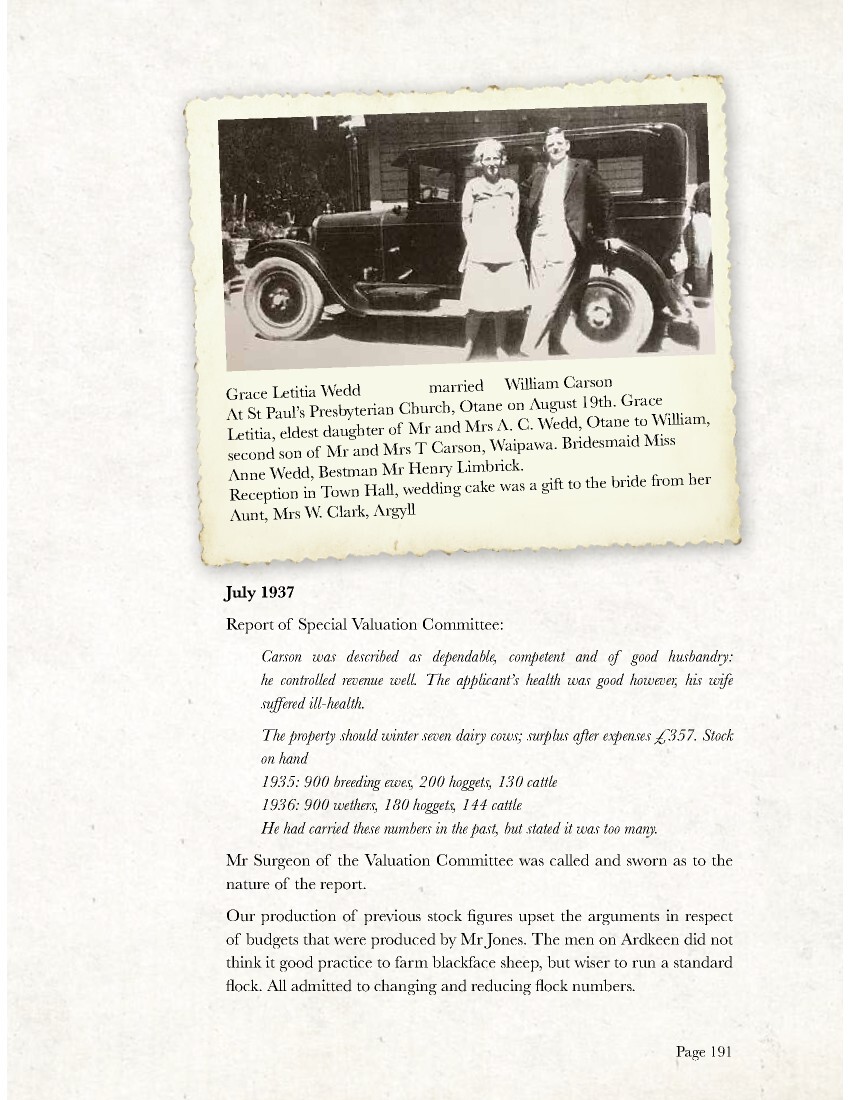
Page 192
They had been carrying the same number or more than the department had estimated. It was also pointed out that Carson had 40 acres of arable land.
An average farmer would be milking at least seven dairy cows. Milk cows tend to pay for employed labour.
Mr Tew offered that on worse country, he’d carried the same number of sheep, and milked 12 cows, with the aid of a boy.
Mr Carson valued his stock at £1,779. The stock credit: £219.
Estimated value of improvements: £600.
From an outlay of £300, Bill had accumulated £2,594 in assets. Although it was argued improvements were not realisable and were a problem at the end of the lease, for the department.
The rental was £363.11: he had created equity in the livestock.
Department’s budget price for lambs and ewes:
Wether lambs 12/-3d
Ewe lambs 15/-10d 5-year-olds 18/-6d
Mixed-age ewe 23/-6d
Weaner steers £2.10 Weaner heifers £2
State Advances Corporation spokesman Mr Anderson suggested the Ardkeen men had talked matters over and adopted a common ridiculous budget. Each stated his carrying capacity below estimate. All said they were unable to carry the stock they had previously carried. Some suggested that during the years of the slump when returns were poor, they had been forced to carry considerably more than they would have under ordinary circumstances.
It is also interesting to note the position regarding labour; Carson stated he needed a man for at least eight months of the year. He had not budgeted for scrub-cutting saying he and his man could do that. He budgeted £104 for wages plus £60 ‘keep’ against a budget of £60. Many settlers asked for a full-time man plus an additional allowance for scrub-cutting, saying neither they nor their labour could cope.
About farm stores, the £30 was estimated to include £8 for stock lick, £4 for drench, plus wool packs etc. And would normally be included in shearing and dipping costs. For crutching at £4.5; the Ardkeen farmers agreed to accept State Advances Corporation figure in this case.
Council Rates £75; last year; Carson allowed £55.
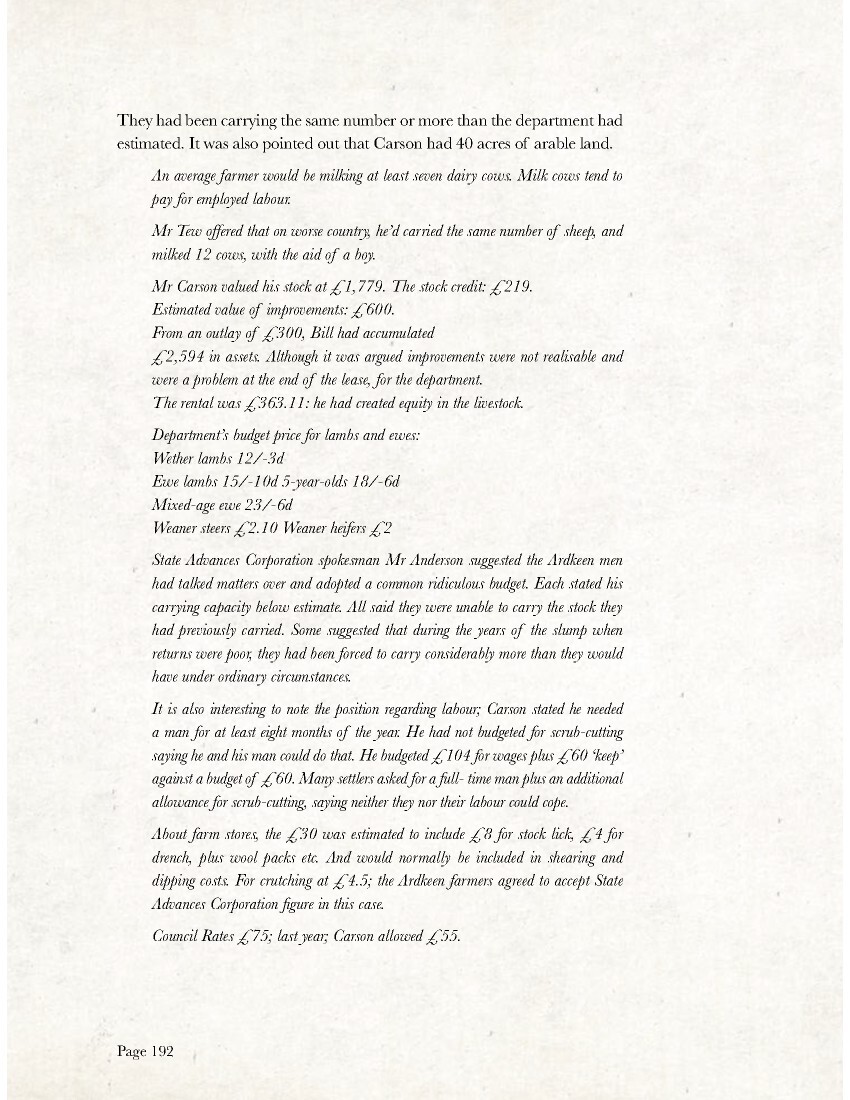
Page 193
Mr Carson pointed out that after paying rent and interest, his account for the past years was:
1931/32 a loss £253.2.9
1932/33 a loss £201.9.4
1933/34 a loss £33.8.2
1934/35 a loss £1.8.8
When the Commissioner asked for Carson’s budget, Mr Anderson asked how he had paid £1,522 off his stock account since 1935?
It was evident that he could have paid his rent in full, and still left surplus for himself.
It was pointed out this figure was of little use until a set of accounts were produced. The losses might have been caused by capital expenditure, excessive living expenses, et cetera.
Mr Anderson for the Department pointed out the following: Of his own admission, Carson had paid down his stock account, and rates – at the expense of rent.
He paid £300 of his own money into the property at the outset, plus £1 a week from his war pension totalling £850. Carson’s improvements were valued at £1,715, against the department’s value of £1,427.
The mortgage accounts totalled £829.
Carson holds reasonable equity in the improvements, which he is entitled to have valued at the end of his lease.
Mr Anderson closely questioned Mr Carson about his livestock carrying capacity and asked if he considered:
900 ewes, 190 hoggets, 20 rams plus whether 112 head of cattle was reasonable or whether it was on the low side.
The lessee’s interest in the property valued at £1,427, the Crown’s at £5,713.05. A fair return for the Crown’s interest would be a rental of £283.13.0.
Both Mr Jones and his client Mr Carson argued the rental offered was excessive and he would not accept the Crown’s offer.
The pair wanted the matter dealt with by the ‘Adjustment Commission’.
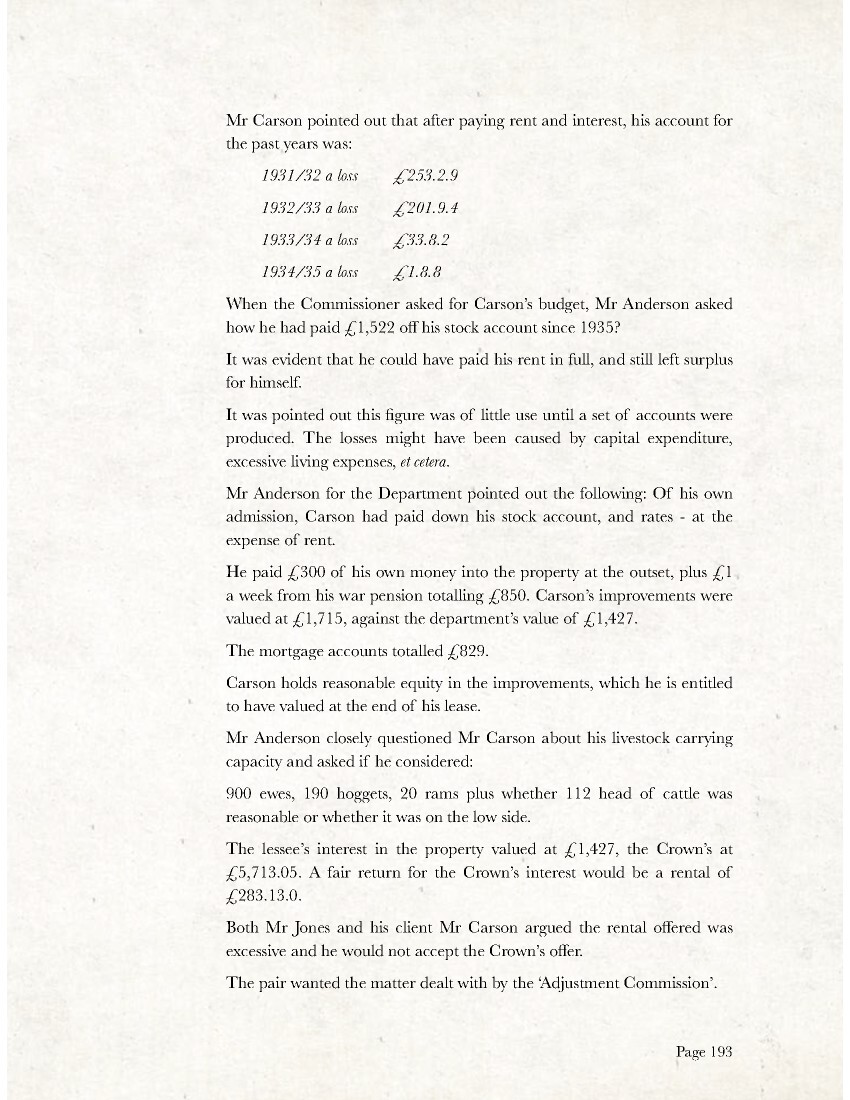
Page 194
‘About the budget; he says he carries 200 ewe hoggets; we show 300. Carson considered his present-carrying capacity correct and ours too high.
He cannot carry seven milking cows and do the work on the farm himself nor carry as many sheep. He works practically all day as it is and has no time for milking cows.’
Mr Anderson pointed out there had been more stock carried in previous years.
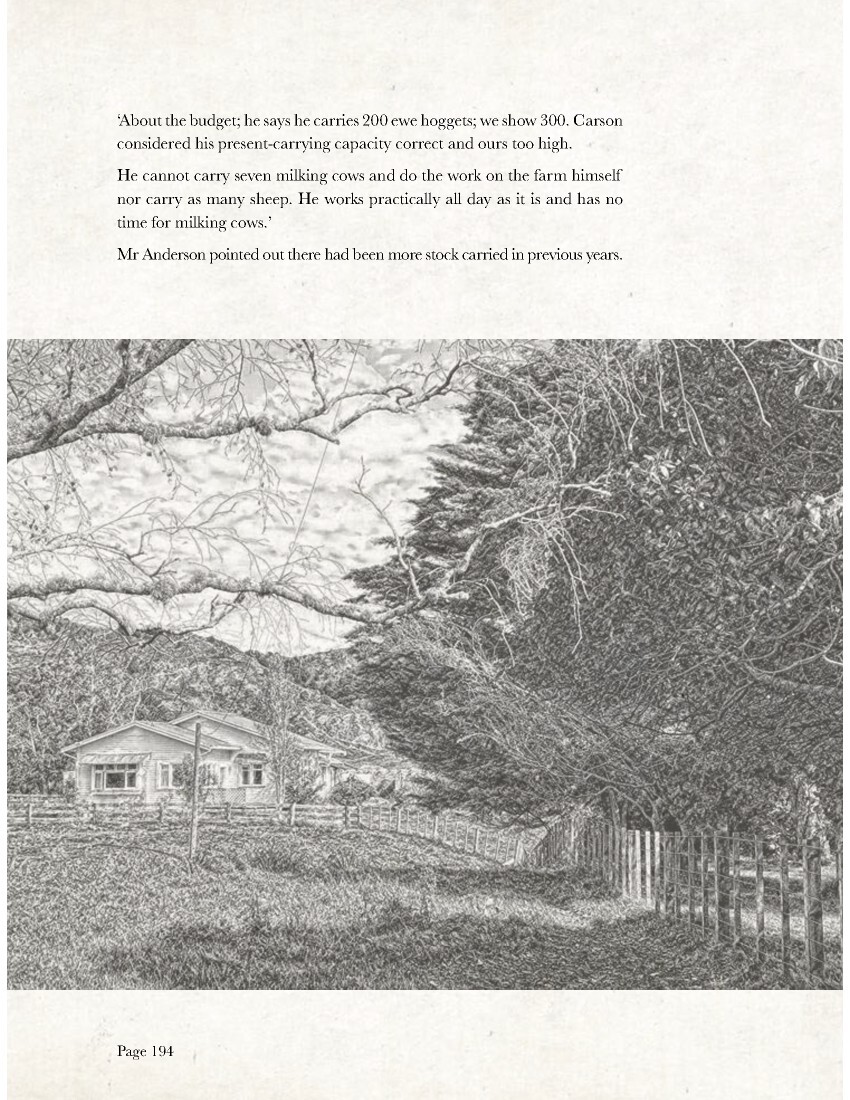
Page 195
RECENT HISTORY
Bill Carson sold to John and Yvonne McKinnon in 1969. The McKinnons sold to Doug Maxwell Snr. in 1980.
Bill Carson sold his homestead section of 13s to Bob Preston in about 1964.
Bob’s beneficiaries, Malcom and Stewart McLagan sold to the Wilson family in 1981, who sold to Kevin and Anne Vette in 1983.
The Vettes sold to Jean and John Martin in 2017 the current owners.
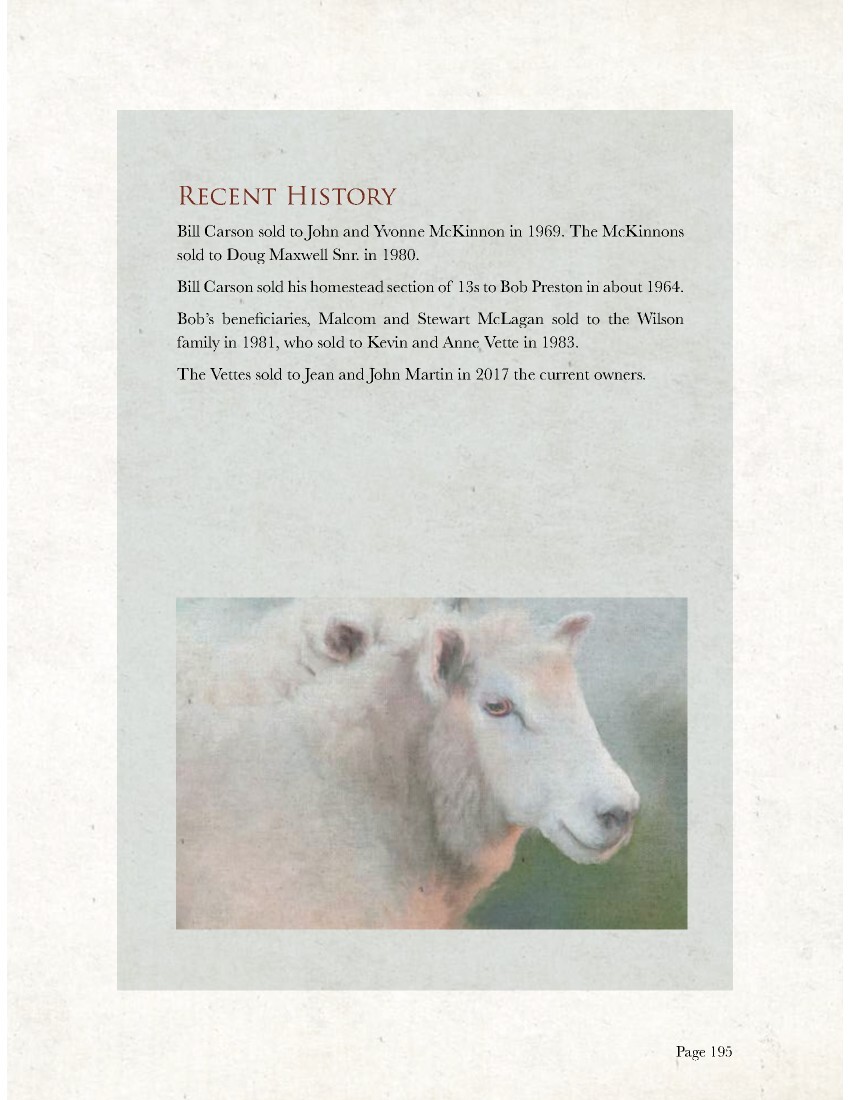
Page 196
WILLIAM NICOL (BILL)
MILITARY SUMMARY
Date of Birth: 16 May 1886 50
Place of Birth: Naseby, Otago
Parents: Robert and Elizabeth Erena Nicol née Andrews
Next of Kin: Robert Nicol, father, Waimate
Last NZ Address: Waimate
Marital Status: Single – Married 1931 Ethel Jean Johnston
Occupation: Clerk
Employer: National Mortgage & Agency Co. Ltd, Waimate
Regimental No: 7/97
Rank: Trooper
Death: 10 December 1952 Christchurch
Buried: Ruru Cemetery, Christchurch
Awards: 1914-15 Medal, British War Medal, Victory Medal
Other Service: WWII 819011 Hokitika Home Defence
1914
12 Aug: Enlisted at Timaru. Posted to Canterbury Mounted Rifles as Trooper.
16 Oct: Embarked from Lyttelton on board HMNZT11 Athenic
03 Dec: Disembarked Suez, Egypt
1915
09 May: Embarked for Dardanelles
21 Apr: Appointed Lance Corporal
26 Jul: Admitted 3rd Light Horse Ambulance – influenza
50 The WWII military file gives his date of birth as 16 May 1889
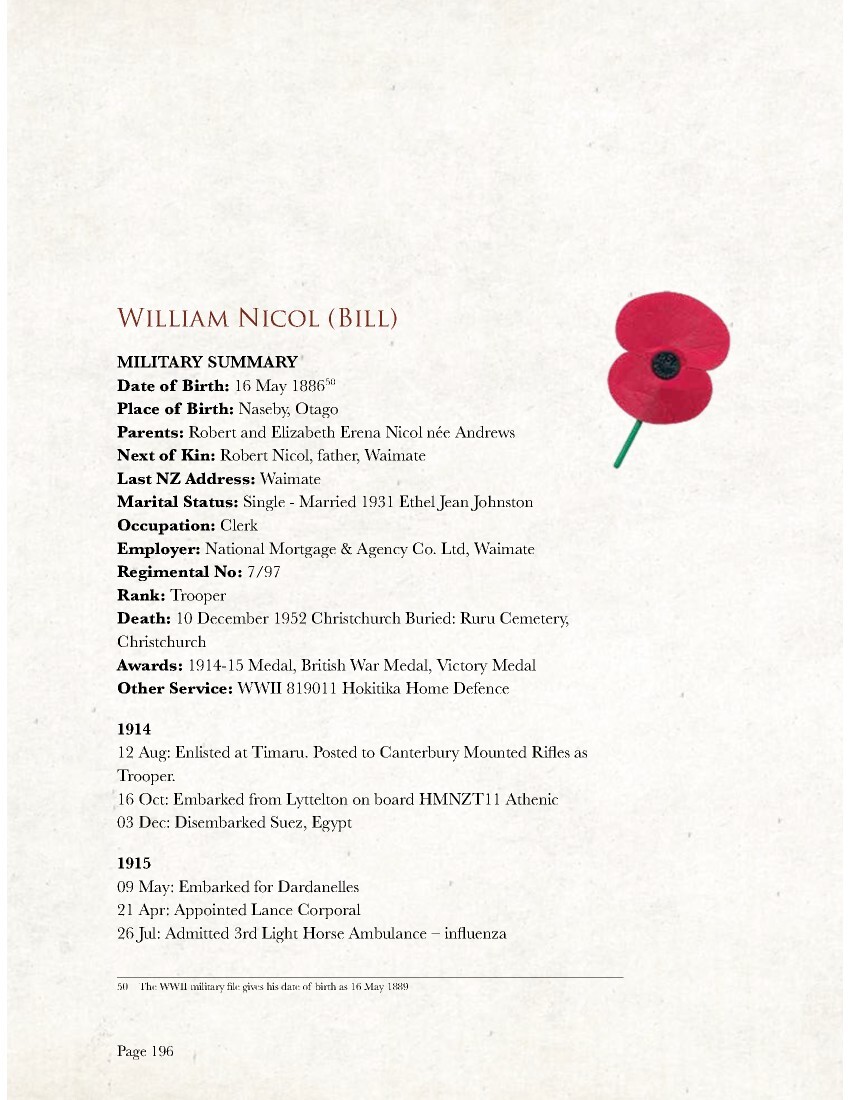
Page 197
03 Aug: Transferred to 15th Stationary Hospital at Mudros
08 Sep: Attached to 24th Casualty Clearing Station at Mudros West
15 Sep: Returned from hospital
14 Nov: ANZAC Cove – promoted to O/R Sergeant with unit
26 Dec: Disembarked at Alexandria
1916
23 Jan: Left for Suez Canal
29 Oct: On duty in Egypt
16 Jun: On detachment to Port Said
25 Jun: Re-joined from detachment
31 Jul: On duty in Egypt
13 Sep: Admitted 43rd Stationary Hospital at Kantara, Egypt – irritable heart [malaria]
15 Sep: Admitted 24th Stationary Hospital and on
17 Sep: Admitted 27th General Hospital Abassia [Abbassia]
29 Sep: Admitted Aotea Convalescent Hospital at Heliopolis
11 Nov: Returned NZ
24 Dec: Disembarked NZ 1918
20 Jan: Discharged no longer physically fit for war service on account of pre-enlistment disability aggravated by active service
Total Service: 3 years 161 days (including 3 years 69 days overseas)
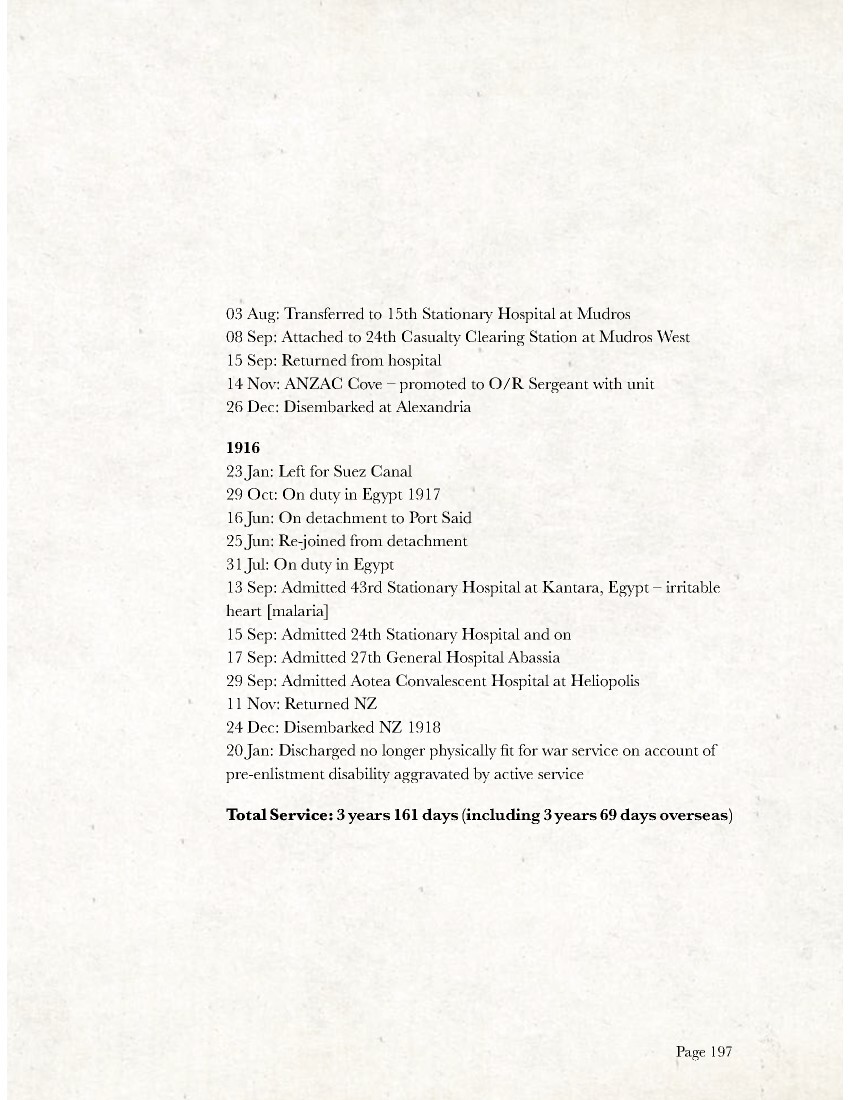
Page 198
LAND BALLOT
Ardkeen Section 14s, 600 acres
Ballot awarded to: William Harold Nicol
Mr W. H. Nicol, of the Ashburton branch of the National Mortgage and Agency Company Ltd, has been successful in his application for a 600 acre block in the Ardkeen soldier settlement, Wairoa, Hawke’s Bay. Section 14s drawn by Mr C. W. McKeegan, of Christchurch, who was successful at the Waitohi Peaks ballot.
20 July 1920
After a meeting of Ardkeen Settlers held at the Ardkeen woolshed settlers D. H. Robertson, M. P. Malone and J. R. Meagher wrote to the Crown Lands Ranger Mr D. G. Robertson. Nicol had put 100 18-month-old cattle that he had bought from the Government out to graze with Mr Taafe, at Frasertown. The settlers believed the livestock were expressly for the Ardkeen Settlers. Several settlers wanted more cattle and were aggrieved that Nicol had bought the animals only to put them out to graze. The writers asked that the cattle be returned and re-allotted.
Nicol countered that he had no grass; his section had been overgrazed before possession, and he needed to put them out to grazing until the pasture recovered. He reminded Ranger Robertson, that section 14s had no boundary fence between himself and Malone’s. The two farms were a 715-acre paddock with 300 ewes belonging to Malone and 450 ewes of his own, plus 134 cattle.
Many soldiers on the larger settlements of private repurchase land complained about the condition of the past years. Their claims were justified in that some of the land boards had a policy of letting grazing rights on estates between purchase and selection. This policy was defended on the grounds that pasture had to be kept from going rank, but it meant soldiers were often faced with bare paddocks. 51
51 Gould, A.N. (1992) Proof of Gratitude, p. 184.

Page 199
The most significant legacy of the 19th-century land practice applied to the soldier settlement scheme was the regime of closer settlement and the tendency based on political rather than economic needs, to subdivide land to settle the largest number of individuals. 52
December 1920
Nicol built a corrugated-iron two-room cottage that he match lined with a wood-range and store-room, an 800-gallon water tank plus a meat safe.
The cost:
Galvanised iron, nails, spouting – £35 14.7
Timber £58.10.8
Tank, range sundries – £34.13.3
Plumbing – £4
Carpenter 14 days – 140 hours at 3/- £21
House piles cartage, wages, painting and joinery £20
Total: £178.18.
January 1921
Nicol wrote to the Commissioner that he had lost lambs in a snow storm.
The Land Board believed Nicol was trading in partnership with Gustave Lane; Lane had leased grazing from the Crown on Ardkeen before the ballot. 53
March 1924
Nicol wrote to the Chairman of the Land Board asking if the Board would accept 25% of his rental arrears. Nicol admitted to having made mistakes. His section was in better heart, however he could not farm more than one sheep to the acre.
Farming, more than any other occupation demanded knowledge, experience, a degree of adaptability, it is only courting failure to undertake a new and intricate business without serving some apprenticeship. 54
52 Gould, A. N. (1992) Proof of Gratitude, p. 185.
53 Archive ref; BANF A 1272 6945.
54 Gould, A. N. (1992) Proof of Gratitude, p. 17.
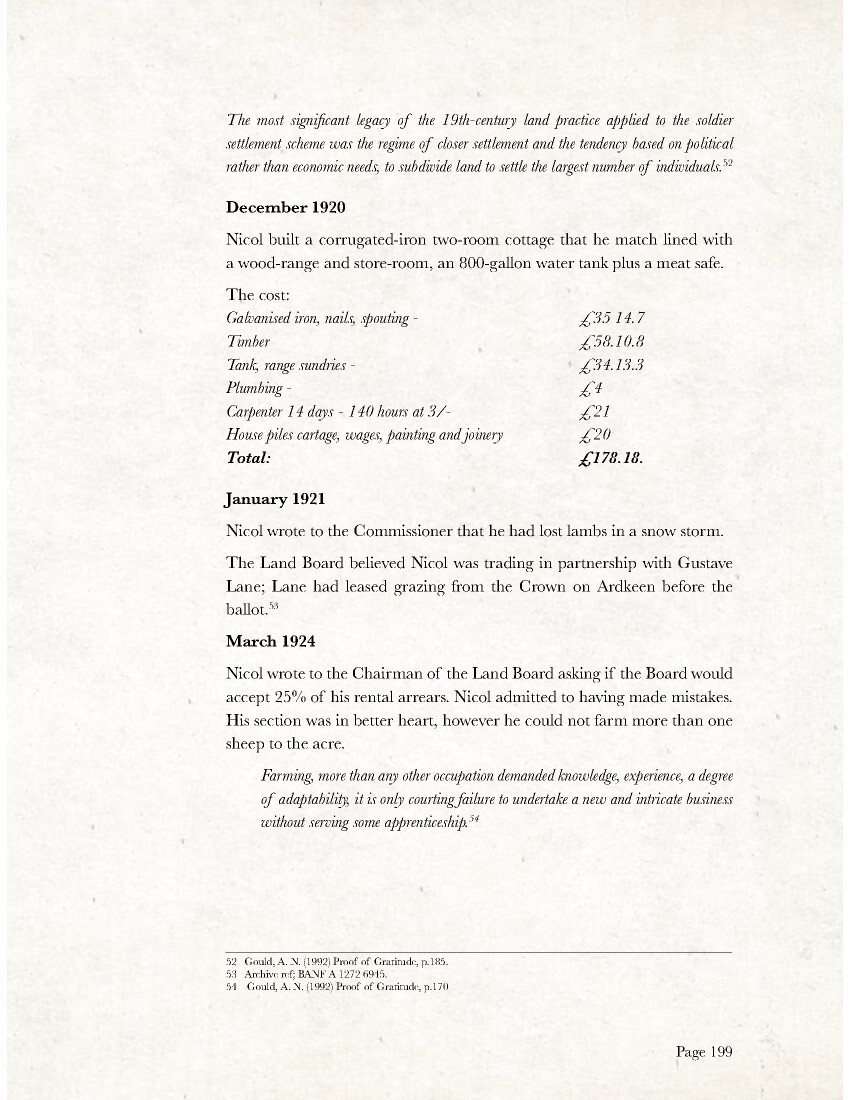
Page 200
July 1924
A departmental memo indicated Nicol was carrying the wrong class of stock; it had been recommended he change the breed of sheep. The Board indicated trouble ahead, writing it was not the land, but the man.
December 1924
Nicol appealed to the Dominion Revaluation Board, saying the section was too small to pay for improvements, meet overheads, and cover running costs.
Nicol suggested his farm be divided between neighbours, offering that to continue would result in ‘starving each other out’.
May 1925
Nicol offered to vacate his farm on the condition he receive compensation for his labour and the offer of another farm, enquiring about a vacant Ballot Farm at Putere.
May 1927
Nicol wrote to the Commissioner advising that he had been working off the farm, stock droving, saying he only had 950 store sheep on the farm.
September 1927
A Land Board minute: noted from copies of correspondence that Nicol would be prepared to give up a section, if given clearance, enabling the farm to be divided between two or three neighbouring settlers.
September 1927
Nicol offered to surrender his farm provided all arrears were written off. The farm bordered five other settlers’ farms, making it suitable for subdivision.
He was one of the only unmarried settlers on the settlement at the time.
Nicol asked the Board to consider what share of responsibility the Government should bear and asked for a recommendation from the Under Secretary for a fresh start and fair compensation. He added he could have carried on, ‘only to see some poor beggar out’
Another memo questioned the Board what responsibility the Government should share, considering the equity in Nicol’s stock account at Williams
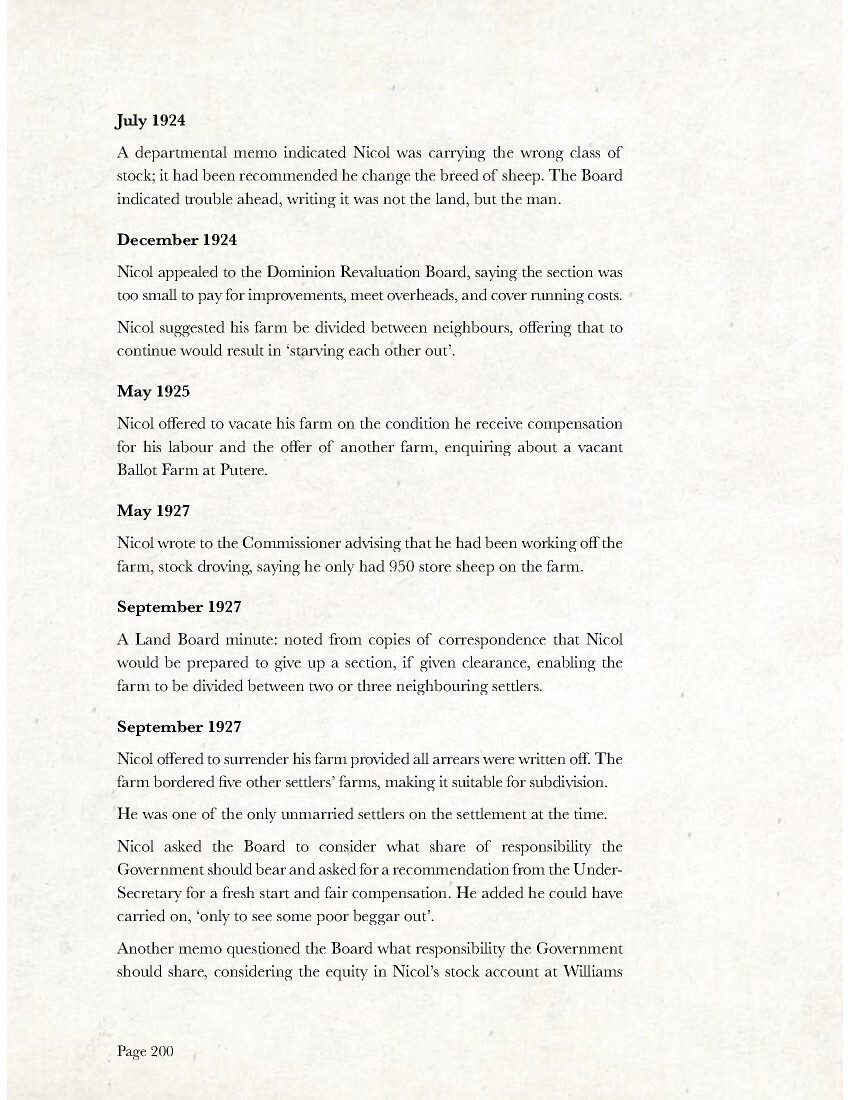
Page 201
and Kettles had accumulated at the expense of the rent account. In 1923 and 1924, Nicol had repaid loans amounting to £300 and £83.17.6. The rent being the first charge on the land should have been settled before the loans were repaid. The apparent equity in the livestock secured by Williams and Kettles raised the question should the department accept surrender, without attacking this equity?
Taking the circumstances into consideration and bearing in mind the advantage of having Nicol’s farm available to apportion to adjoining settlers, the writer sought a recommendation.
The Honourable Minister of Lands estimated that Nicol had approximately £300 equity. Under normal circumstances, the department would have taken unpaid rent from this money.
The Dominion Revaluation Board would have had to reduce the capital value of a forfeited farm. However, if the land could be incorporated into neighbouring farms, this would increase the values of those farms offsetting any loss of value.
The department chose to accept the voluntary surrender, free of liability rather than make adjustments with corresponding stocking capacity of the bigger farms. This action created a moot point as to whether it would be necessary to compensate some settlers to gain possession of their land to increase the holdings of remaining farmers. It was noted this may prove costly to the Crown. The department felt justified in allowing the rent owed by Nicol to be written off; the surrender of the lease was accepted.
April 1928
Nicol wrote to the Minister of Lands, Wellington to say he had vacated his farm thanking him for the opportunity and the help but he pointed out that he had occupied Section 14s for seven years, nine months, a slice of his most useful years ‘now gone’ adding ‘the farm was in good order through hard work, however, it was too small’. Nicol expressed the wish to start again; volunteering he was a worker and knew his job. He had about £1,000 and was living in town doing temporary work.
The Under-Secretary of Lands replied, expressing regret it had been necessary for the Land Board to take his farm. Asking where he would like to settle, offering to speak with the Commissioner of the chosen area of any available sheep country.

Page 202
July 1929
William Nicol was released of all liabilities.
After World War II, it took ten years to settle a similar number of soldiers as World War 1 had done in a little over two years. 55
In 1930 the farm section of 14s was split.
Two hundred acres were allotted to Ernie Clifton, 200 acres to Mattie Andrew and 115 going to Gerry Spooner
Nicol’s homestead section was divided between Bob Preston and Bill Carson in 1929.
55 Gould, A.N. (1992) Proof of Gratitude p. 24.
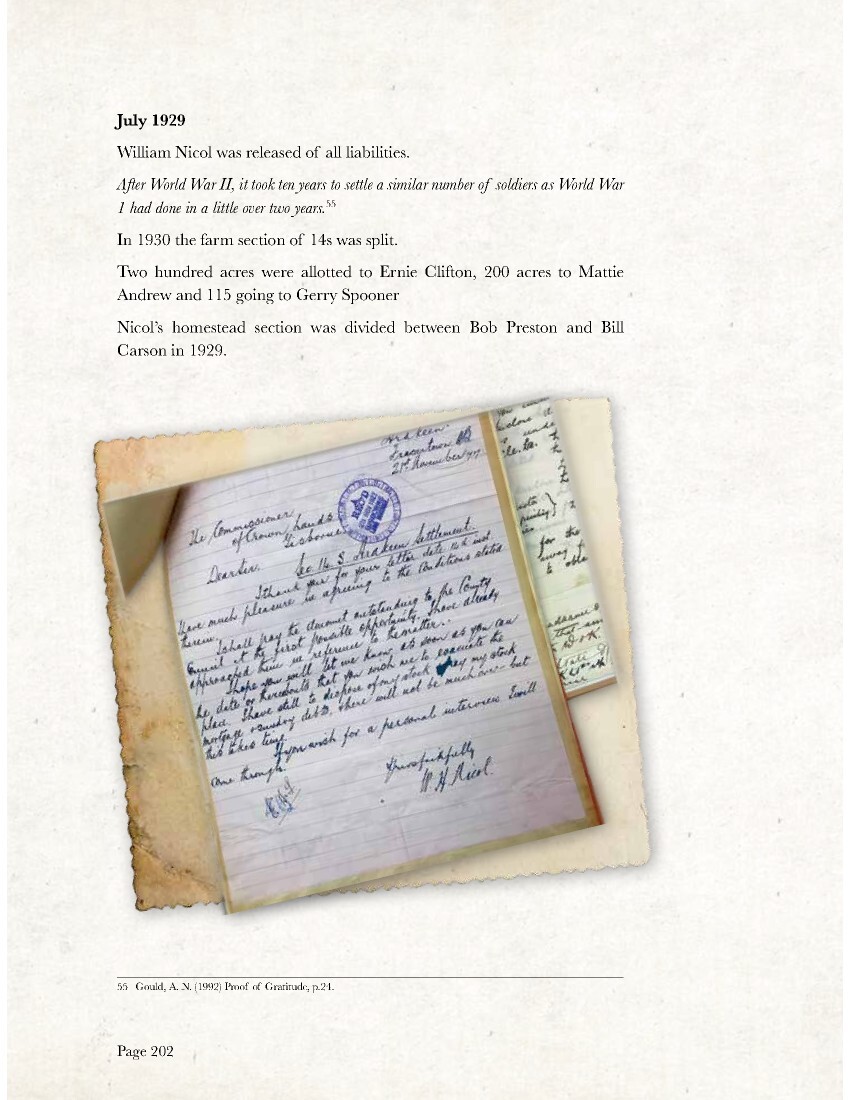
Page 204
GERARD EDMUND SPOONER (GERRY)
MILITARY SUMMARY
Date of Birth: 11 September 1888
Place of Birth: Macetown, Otago
Parents: Gerard William and Louisa Anne Spooner née Elliott
Next of Kin: Miss A Spooner, sister, Lower Riccarton, Christchurch
Last NZ Address: Gisborne
Marital Status: Single
Occupation: Shepherd
Employer: J B Spence, Waipoa [Waipaoa] Station, Whatatutu
Regimental No: 11/1060
Rank: Trooper
Death: 2 January 1956 Wairoa
Buried: Wairoa Cemetery
Awards: 1914-15 Star, British War Medal, Victory Medal Other Service: WWII 2/206/114 Home Defence
1914
15 Dec: Enlisted with Wellington Mounted Rifles B Squadron as Trooper
1915
14 Feb: Embarked on board HMNZT19 Aparima
26 Mar: Disembarked at Egypt
16 Aug: Sailed as reinforcements for Dardanelles
28 Aug: Admitted Hospital Ship Gascon – gunshot wound right forearm
01 Sep: Admitted NZ General Hospital, Cairo.
18 Oct: Admitted NZ Convalescent Home
09 Nov: Re-joined unit at ANZAC Cove
25 Dec: Disembarked at Alexandria from on board Hororata
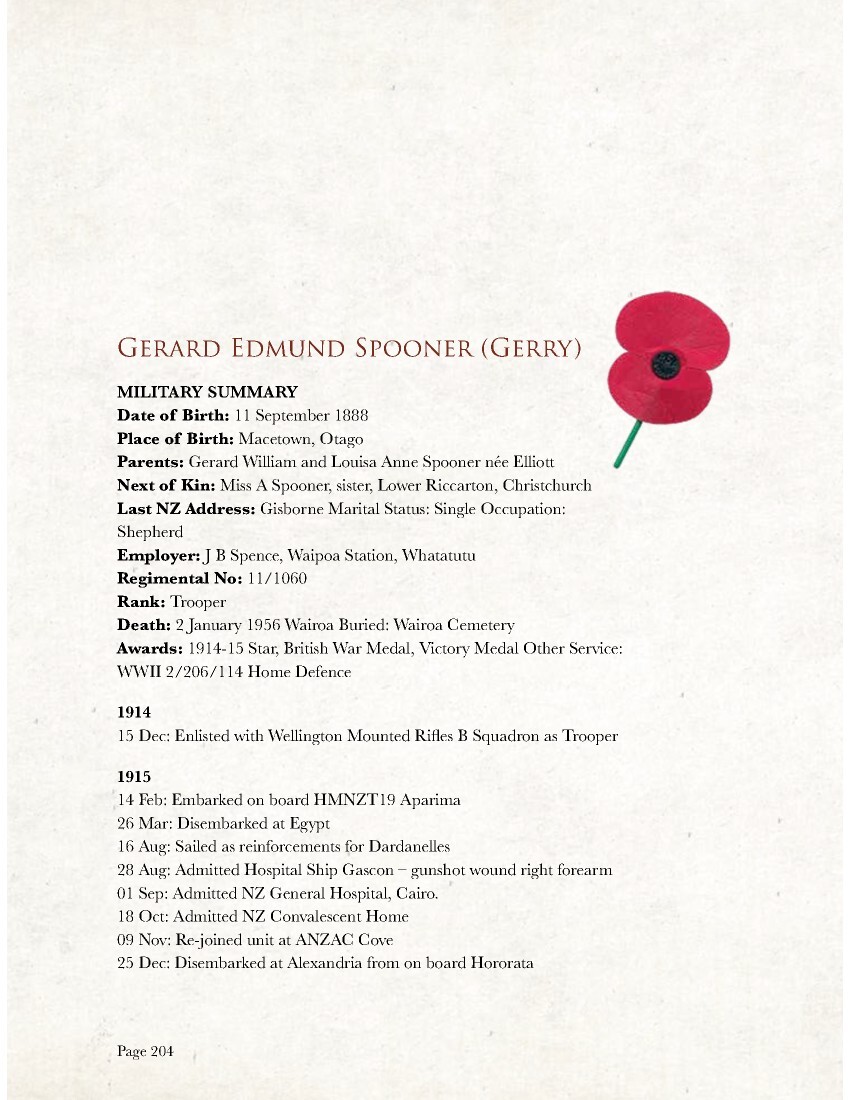
Page 205
1916
23 Jan: Left for Suez Canal from Zeitoun
18 Jun: Admitted 31st General Hospital, Port Said – debility.
22 Jun: Transferred to Convalescent Depot, Cairo.
18 July: Discharged to duty at Kantara. 26 Jul: Admitted 31st General Hospital, Port Said – heat stroke
02 Aug: Re-joined Wellington Mounted Rifles at Bir et Maler
1917
09 Jan: Wounded in action – gunshot wound to right scapula. Battle of Rafa, Sinai-Palestine border
12 Jan: Admitted 24th Stationary Hospital, Kantara, two days later admitted 27th General Hospital, Abbassia
25 Jan: Reported dangerously ill – gunshot wound to back, pneumonia and empyema
02 Feb: Medical report – during the fight a bullet struck a clip of cartridges in patient’s bandolier and exploded some of the cartridges, causing a large wound over his right scapula baring the bone and causing much destruction of muscles – later bacterial infection occurred.
12 Feb: No improvement
06 Mar: Invalided to NZ from Suez per Hospital Ship Willochra and struck off the strength of NZEF
01 May: Disembarked at Port Chalmers
22 Jun: Sick leave certificate issued until 28 June 1917
28 Jun: Christchurch Hospital Medical Board – cartridge in his own bandolier exploded on being hit by every bullet – empyema – has had three operations
19 Jul: Discharged in consequence of being no longer physically fit for war service on account of wounds received in action
Total Service: 2 years 203 days (including 2 year 78 days overseas)
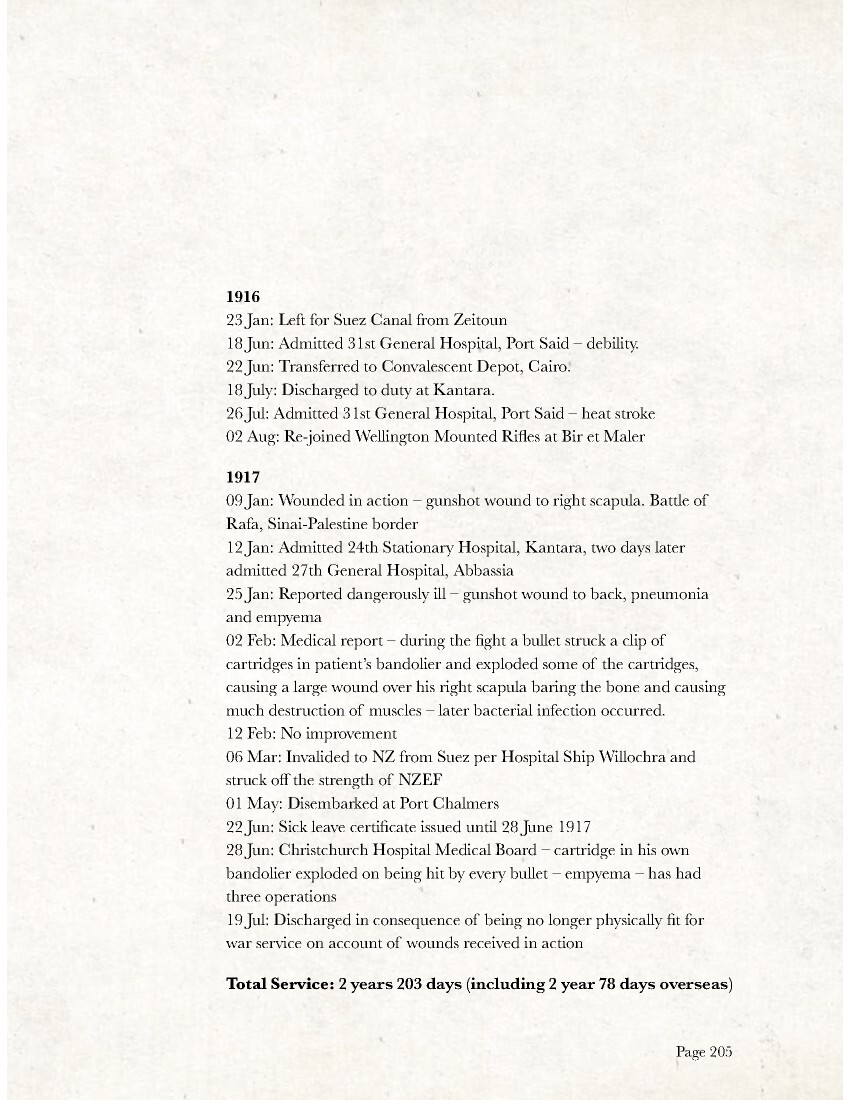
Page 206
September 1918
Gerald Spooner wrote:
The Commissioner of Crown Lands
Napier
Dear Sir,
On 27 August I received from your office a poster of the lands open for selection by discharge soldiers; Three sections of the Kaiwaka Settlement and one near Napier. Send any information available.
I request because of the short time between the arrival of poster and details of the sections and dates on which applications must be in that time being 12 days only; sufficient time if I live in or nearby Gisborne. But situated as I am, 45 miles from Gisborne and 35 miles from Tolaga Bay with a mail once a week does not leave me much time to fill in an application correctly and have it witnessed by a Justice of the Peace which I believe is necessary. The nearest Justice of the Peace to my knowledge is at Te Karaka, 25 miles distant and with the season having just commenced it will be more difficult to take leave from the Station for the time necessary to have an application filled in, and on the way to Napier. You knowing the irregularity of the Steamer service to Gisborne will realise the difficulty. Araparanui (Aropoanui) [Aropaoanui] Ballot interests me. Can I look at the farms during Show Week or Christmas?
Is there a preference available to applicants who satisfy the Land Board financially with the ability to manage the farm, and been unsuccessful in previous ballots? In sending the information at your earliest convenience will oblige.
Yours truly Gerald E. Spooner
The conservative New Zealand Farmers Union suggested that when wounded soldiers had recovered, they could be employed on farms. This is one way in which we can show our appreciation of the men who have gone to fight for our country. The soldiers were not to be owners under this proposal, but rather rural workers. 56
56 Gould, A. N. (1992) Proof of Gratitude, p. 45.
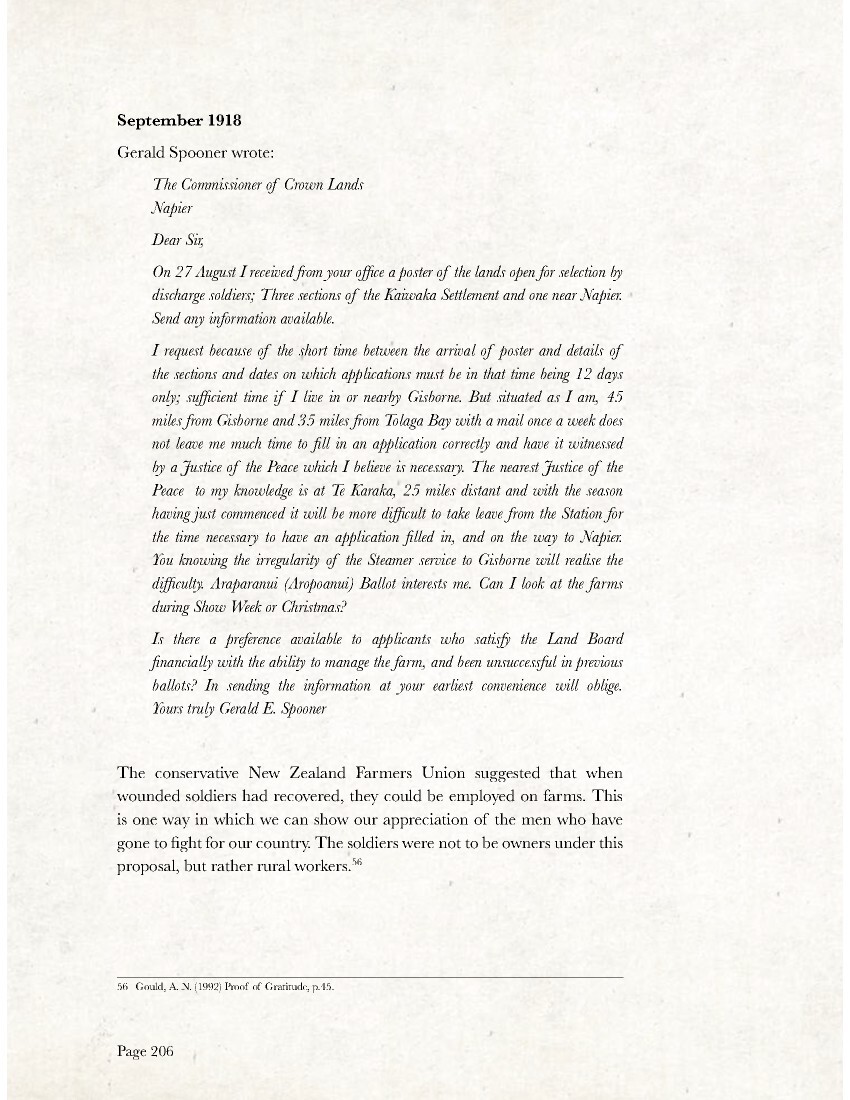
Page 207
LAND BALLOT
Ardkeen Section 15s, 628 acres
Ballot awarded to:
G. E. Spooner
September 1920
Gerry Spooner wrote to the Commissioner that he had 2.2 miles of road frontage with a short fence needing replacement, advising he had recently bought a two-furrow plough, horse-collar, buggy, and a horse.
March 1921
Gerry wrote to Land Ranger Robertson enclosing a receipt for the buggy and harness, noting that it gave carrying capacity of up to 17 hundred weight.
He had bought a double-furrow plough from Tom Davey and paid for it by grazing Davey’s cattle the previous winter; value £25.
August 1921
He had bought:
One set block and chains £5.12.6
Two 19-inch horse collars £7.6
One buggy and harness £25
One double-furrow plough £25
The Crown Lands Ranger advised the Commissioner that high winds had destroyed Spooner’s tent and he wished to buy a whare from O. G. Birrell.
September 1921.
Gerry Spooner wrote to the Commissioner that owing to the high cost of fencing wire and building material he had not made any improvements, and would wait until things were cheaper; he was able to get along without fencing wire.
Fencing wire the previous year cost between £50 and £60 a ton; down to £22 A TON BY 1921.
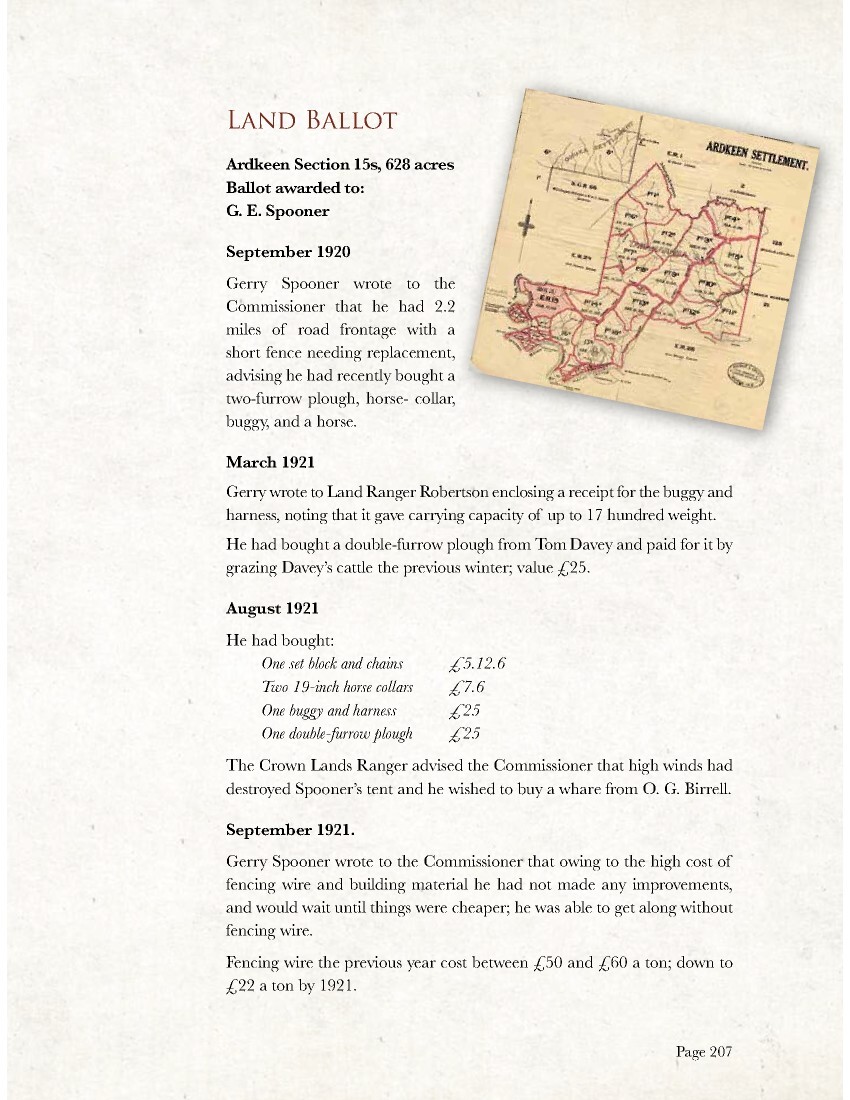
Page 208
Spooner was pleased with the progress he had made packing fence posts; saying the journey from the heaps to the fence line was too far for the pack-horses in one haul. However, he had finished packing over the worst tracks, landslips and steep country, onto safe ground closer to his farm. Now he had to quit because the ‘horses were done in’, and he hoped to start again in a fortnight.
In the interim he grubbed sweet briars or blackberry stacking it in heaps to burn along with manuka. He said some areas needed grubbing twice.
The Under-Secretary noted Gerry Spooner had paid a higher price for wire than the Wellington price of £21 per ton. He advised that if soldiers wanted fencing wire, the department could provide it from departmental stocks.
It was noted that in spite of high returns for primary products up to 1921, costs had risen, with timber and wire being hard to buy. The inability to fence the newly settled farms restricted farming operations. The United States government ban on the export of iron and steel products that were not associated with the war effort contributed to the shortage. The New Zealand government attempted to buy wire at cost without much success. 57
August 1922
Gerry Spooner wrote to Commissioner that he had found work, however, he felt he was neglecting his farm. He had bought 700 fence posts at £3 per hundred from Jack Owen and moved them from a flood-prone area and insured them against fire.
When Gerry took possession of the farm, there was 80 acres of burnt-off manuka country that needed sowing with grass seed.
The settlement period for the first few years was, for most soldiers, that time when land was clear, fenced, and generally developed, while buildings were erected and stock purchased.
Government advice focused on these areas. As the soldiers’ farms progressed, the concerns of the Crown Land Rangers and land boards move toward productive farming practices and the attempts to ensure that the settlers met their financial obligations.
57 Gould, A.N. (1992) Proof of Gratitude, p. 187.
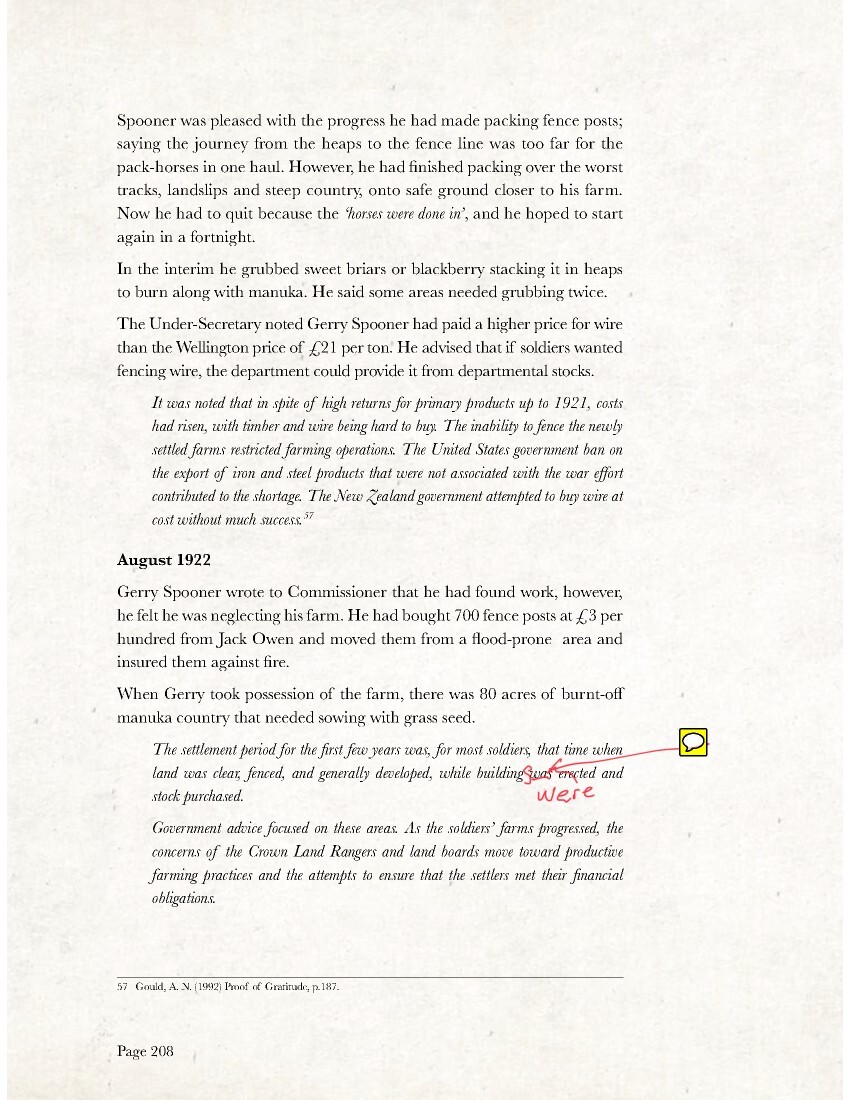
Page 209
A high degree of paternalism is evident in the actions of various commissioners and their boards when dealing with soldier settlements.
The boards and the men at the cutting edge of the scheme were aware of the shortcomings of a system that allowed men with little experience and capital to become farmers and responded with an increased degree of the supervisory interest. 58
October 1923
Gerry assumed the Board would forfeit his lease; “why hurry, I may go willingly?” The Mercantile Firm who held the mortgage on his livestock took the farm proceeds after allowing for groceries only. The Field Ranger regarded Gerry Spooner’s farm as the worst on Ardkeen.
June 1927
Gerry Spooner was allotted the Malone Homestead 30-acre section for £700. The Land Board believed Gerry got the best of the Malone Estate, moving from a tin whare to the most well-appointed new house on the settlement.
Photo caption – The tin whare purchased from Ossie Birrell
58 Gould, A.N. (1992) Proof of Gratitude, p. 197.
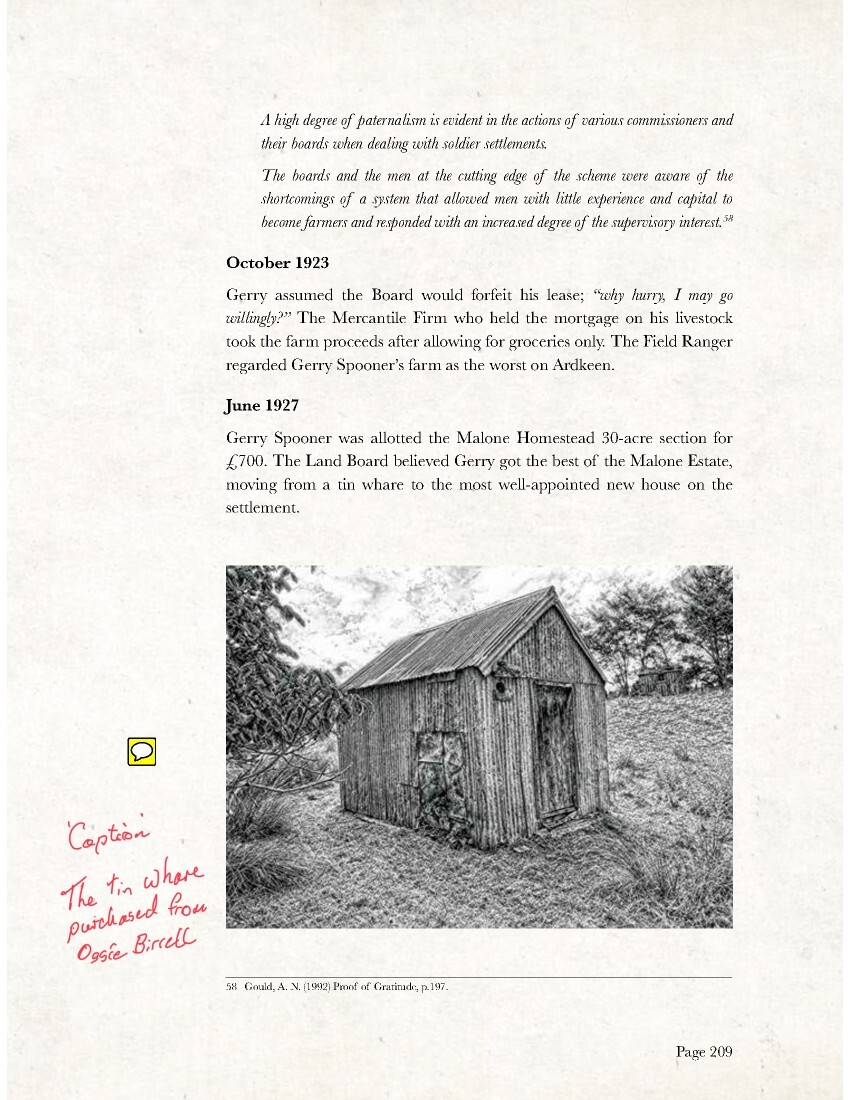
Page 210
Commissioner Marsh commented that the soldier who had put all his surplus money into building improvements should have got a good wife first. The Wellington board expressed similar views so that the soldiers should exercise the most careful economy in the direction of buildings. 59
June 1930
Gerry built a woolshed; Ranger Robertson believed Gerry’s farm was paying its way, reporting Gerry was a capable farmer, utilising land to best advantage. The farm was fully stocked with sheep and cattle bringing in an income of about £821, and expenditure of £720.
December 1931
Gerry Spooner notified the Commissioner that he had arrived at ‘a dead end,’ saying all he could do was keep the land, fences and stock in order, and wait out the depression.
59 Gould, A.N. (1992) Proof of Gratitude, p. 203.
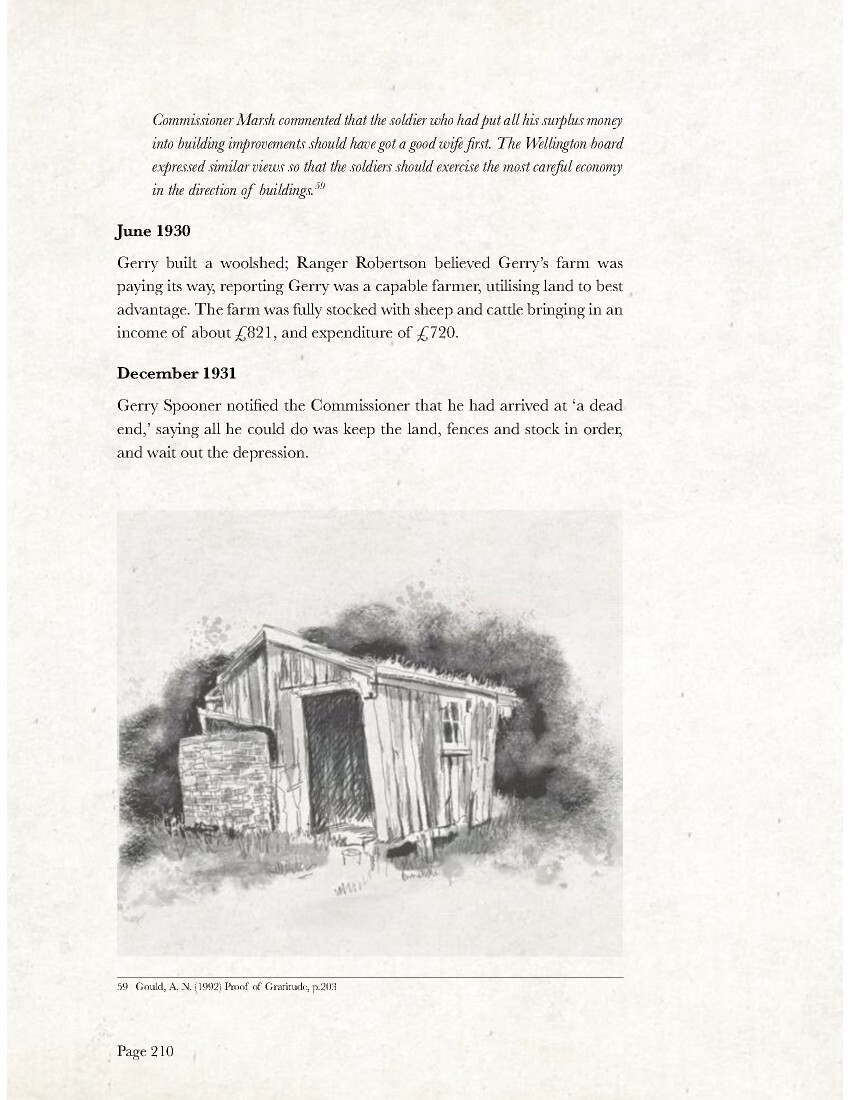
Page 211
May 1932
The Under-Secretary received a statement of Spooner’s account with Dalgety’s. He suggested a profit- sharing scheme that enabled the Crown to get its share of any surplus income over the ordinary living and operating expenses. In the event of a loss, the mortgagee / landlord, and local body, shared any deficiency on a pro-rata basis. Dalgety’s indicated they will accept this approach with a profit-sharing agreement, as would the banks. The Department of Lands alone would not take sole responsibility for a deficient account.
May 1932
Gerry Spooner entered an income-sharing arrangement with Dalgety’s. The Under-Secretary for Lands observed that few accounts would show sufficient equity to permit capitalisation of arrears; suggesting there remained a need for postponement or remission of arrears of rent and interest. In a typical season a settler paid off accumulated arrears at the Board’s discretion. Often the arrears were placed in a suspense account for five years when there was no prospect of clearing accumulated charges. Those arrears accounts may have to be remitted.
The stock firms and banks governed the situation; neither would consider profit-sharing agreements unless there was an agreement to share losses. The Department had taken a lenient approach, setting a precedent to avoid payment. The Board required policy as a guide when the firm or bank refused to meet the department.
October 1933
There had been no surplus to distribute and arrears were written off eventually.
July 1937
This application was considered by the Gisborne Adjustment Commission at a sitting at Wairoa on Tuesday 27 July 1937.
The State Advances Corporation holds the 1st and 2nd mortgages on the property – amount outstanding: £968.5.11.
Dalgety Co-op holds the stock account which at October 1 1936 stood at: £415.17.1 and at July £114.7.7

Page 212
Today’s value of the stock was approximately £2586 comprising of:
787 breeding ewes
390 mixed hoggets
23 rams
15 killers
2 hacks
60 breeding cows
Rates were paid to date.
There were arrears of Harbour Board and water rates of £69.3 including penalty and costs. Arrears of County Rates, £175.0.7 including penalty and related expenses.
Spooner received notice from the Crown of the reduced rental on the Education Board lease to £110 per annum as from 30 June 1936, and a reduction of rent on his farm to £55.12 from 30 June 1936.
He did not consider the offer went far enough.
The arrears at 30 June 1936 amounted to £945.4.3, with a payment of £500 that was asked for.
Spooner pointed out he had been on the property since the ballot, living on about £1 per week, and he was a single man. The land was covered in scrub and cost about 1/6 per acre to clear. He produced a statement of receipts and expenditure showing an estimated surplus of £136.10; if capitalised at 5% it made a productive value of £2,730 with improvements added.
A budget of the Valuation Committee indicated the department was prepared to consider a voluntary adjustment of rentals mentioned. It recognised the account had been under a profit-sharing agreement with Dalgety Co-op and they were entitled to a distribution at 30 June 1936 and 30 June 1937.
Free assets were valued at £2,586 and until recently there was a credit balance of £260 with Dalgety Co-op. Spooner had bought a motorcar for £300, which placed Dalgety’s account slightly in debt again.
No payment for years: 1931, 1932, 1935 and 1936, yet he cleared the debt at Dalgety’s, at the expense of the department’s rent.
The department would reduce the rent to £160.12 from £247.5 from 30 June 1936; about 4/- per acre. The mortgage per acre would be one shilling. A mortgage of about £800 would equate to five shillings in rent.
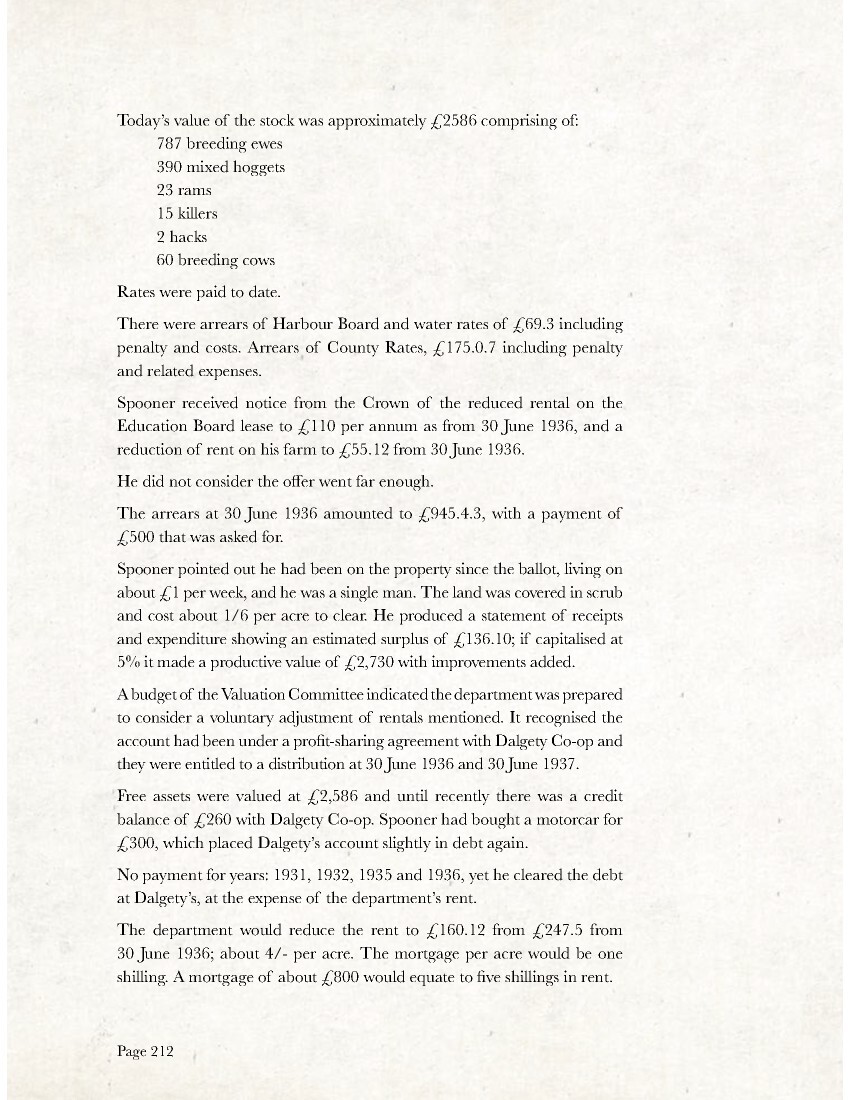
Page 213
Spooner thought this was fair, however his solicitor asked for slightly more without success. The department required a £500 payment on arrears of the £985, equivalent to £80 per annum. A spokesman said in asking for the remission of arrears, the department had disregarded the fact he had made no payments for four years and cleared his stock mortgage. This put a premium on non-payment, and it was unfair to the settlers who had paid.
Mr Spooner had only £1,000 cash at the start, he now had £2,586 worth of stock, a motorcar valued at £300, improvements valued at £1,548, less a mortgage of £986.
He had done well, even if he paid the full amount of arrears owing. Looked at another way he had done well paying at the reduced rate.
His lambing percentages were about 80% nearly all the way through and calving at 70% with deaths at 3%.
The Commission would not decide about a remission of rent until all the Ardkeen settlers’ applications for remission of rent and interest was complete.
Rates have gone up from £54-£71. Some stock prices are lower.
Initialled: D. R. (Crown Land Ranger)
1. Three leases; Harbour Board, Education Board and Crown: 803 acres all rented at £247.5
2. The department offered a reduction to £165.12
3. The commission determined the value at £3,200 apportioning £1,600 each to the leases and the lessor.
4. Unimproved value plus the Crown’s interest: 803 acres including clearing and grassing valued: £2.10 per acre Fencing valued: £434.5. Value of improvements: £2,441.15 Rental based on £1,600, including improvements. Value of land: £1 per acre.
5. The value fixed at: £3,200 representing a 5% return: £160 charge for the land equates to: 4p per sheep, without counting cattle.
6. A fair rental and interest service would be equivalent to 4/6 pence per sheep (75% ewes (cattle not counted). 1,110 sheep at 4/6 equated to: £249.15 rent payable. Deduct 5% from £1,600 for improvements equalled: £80 left for rent: £169.15 The additional stock makes the general expenses less per head, with a higher land charge.
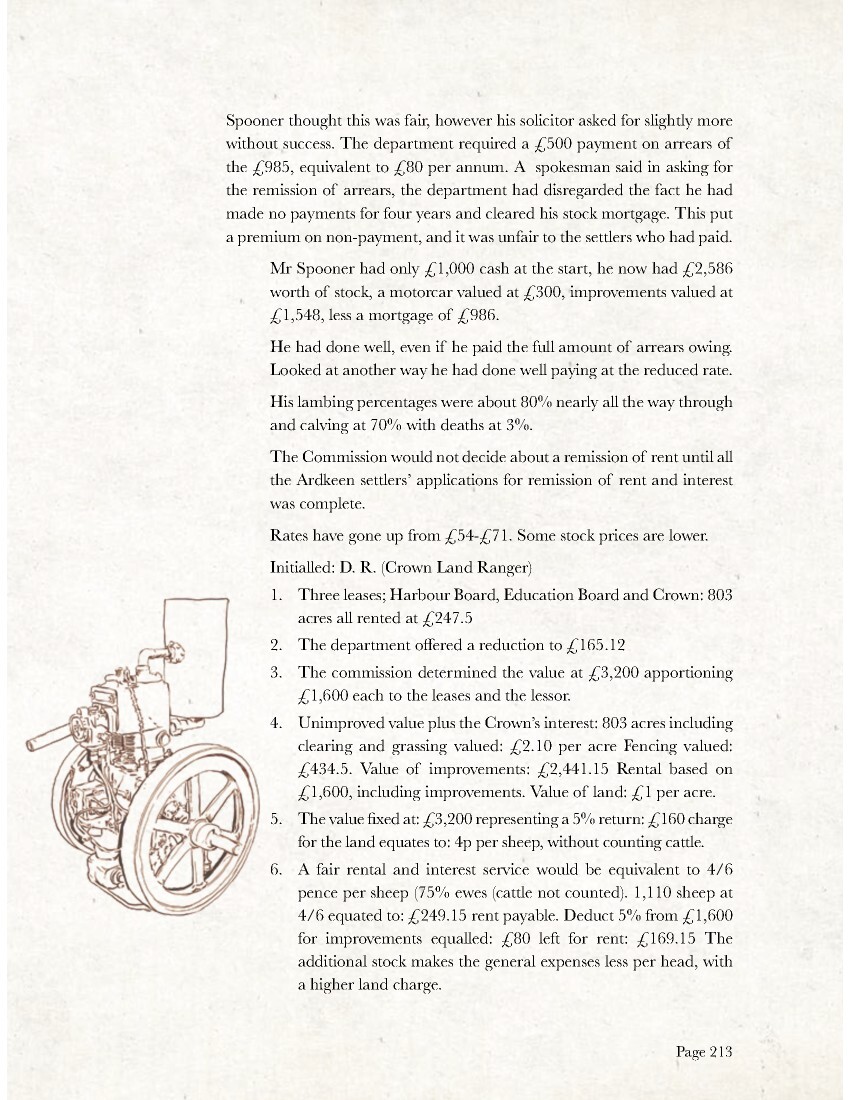
Page 214
7. The evidence submitted to the commission supported valuation committee budgeted stock capacity of 1,110 sheep and 120 cattle; at the time of the hearing the sheep numbers were: 1,215 (787 being ewes)
8. Value of the property: £4,860
The rental arrears amounting to: £1,232.9.3
The Crown is entitled to: £319.1.6 provided for in the order. For purposes of adjustment under the Act when antecedent values are depreciated, it is equitable, when divided between the lessee and lessor, and shared pro-rata.
RECENT HISTORY
Gerry Spooner did marry; he sold his farm to William and Judy Little in 1958 who in turn sold the hill country to forestry. At the time of writing son Scott occupies the homestead section.

Page 216
ERNEST CHARLES CLIFTON (ERNIE)
MILITARY SUMMARY
Date of Birth: 9 May 1893 60
Place of Birth: Napier
Parents: William Henry and Amy Isabel Davies née Burley
Next of Kin: C E Clifton, Pahiatua
Last NZ Address: Pahiatua
Marital Status: Single
Occupation: Plumber
Employer: C E Clifton
Regimental No: 10/1210 Wellington Infantry 1914. Changed – 4/1210A NZ Engineers 1st Field Coy 1915
Rank: Corporal
Death: 9 April 1975 Hastings
Buried: Hastings Cemetery
Awards: 1914-15 Star, British War Medal, Victory Medal
Other Service: A Company 17th Ruahine Regiment; WWII 2/20B/2 Home Guard and Home Defence
1914
21 Oct: Enlisted at Trentham. Posted to Wellington Infantry Regiment No.10/1210
13 Dec: Embarked from NZ
1915
28 Jan: Arrived Egypt and on 01 Feb, transferred to 1st Field Company NZ Engineers as a Sapper Regimental number replaced, No. 4/1210A
12 Apr: Embarked for Dardanelles
26 Dec: Disembarked at Alexandria, Egypt on board Ionian
1916
18 Jan: At Moascar, Egypt
10 Mar: Transferred to NZ Pioneer Battalion and 10 days later promoted to Corporal
09 Apr: Embarked for France from Port Said
60 Birth registered as Ernest Charles DAVIES, son of William Henry and Amy Isabel. He later adopted the surname CLIFTON. Date of birth on WW1 file 9 May 1891. On WWII file date of birth given as 9 May 1893
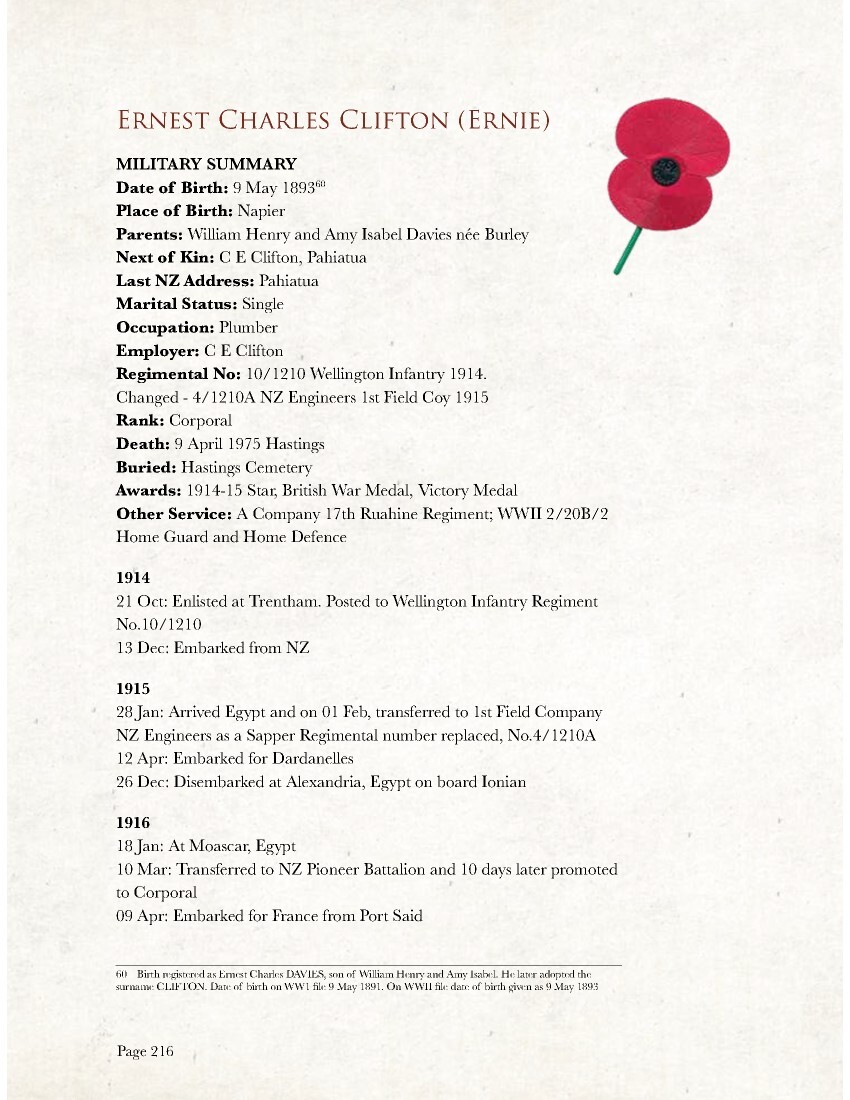
Page 217
15 Apr: Admitted No. 2 Australian General Hospital, Marseilles ex HMT Canada – pneumonia 15 May: Discharged to NZ Base at Etaples
30 Jul: Appointed Company Bomber – in the field and on 1 August promoted to Sergeant
1917
13 Apr: Selected for training as an officer. Detached to England for training.
02 Jun: Training completed. Posted to Pioneer Details Sling as 2nd Lieutenant- Ordered to France.
31 Jul: Wounded in action – France. Gunshot wound right leg – mild.
10 Aug: Embarked for England on board Hospital Ship St Denis. Admitted to NZ General Hospital at Walton on Thames
02 Nov: Left for France
03 Nov marched into camp at Etaples
1918
27 Mar: Wounded in action – gunshot wound in chest – mild
28 Mar to 28 May: Admitted 1st NZ Field Ambulance: 56th Casualty Clearing Station, 8th Red Cross Hospital; Embarked for England per Ambulance Transport Jan Breydel.
2nd August: Admitted London General Hospital at Chelsea. April admitted to 1 NZ General Hospital at Brockenhurst. Convalesced NZ Officers Convalescent Home at Brighton and 25 days later discharged to NZ Headquarters, London
24 Jun: Detailed for course of instruction at Hayling Island where he qualified IA Grade Lewis Gun Course.
On 31 July Platoon Commander, 3rd Reserve Battalion vice G H Davey
26 Aug: With Reserve Battalion, Wellington Regiment at Sling and 3 months later made Lieutenant Wellington Regiment
1919
01 Feb: Embarked for NZ on board Hororata 15 Mar: Disembarked NZ
Total Service: 4 years 175 days (including 4 years and 92 days overseas)
Ernest (Ernie) Charles Clifton saw action at Gallipoli and the Western Front. His diaries/memoirs provide a detailed insight into the realities of World War One.
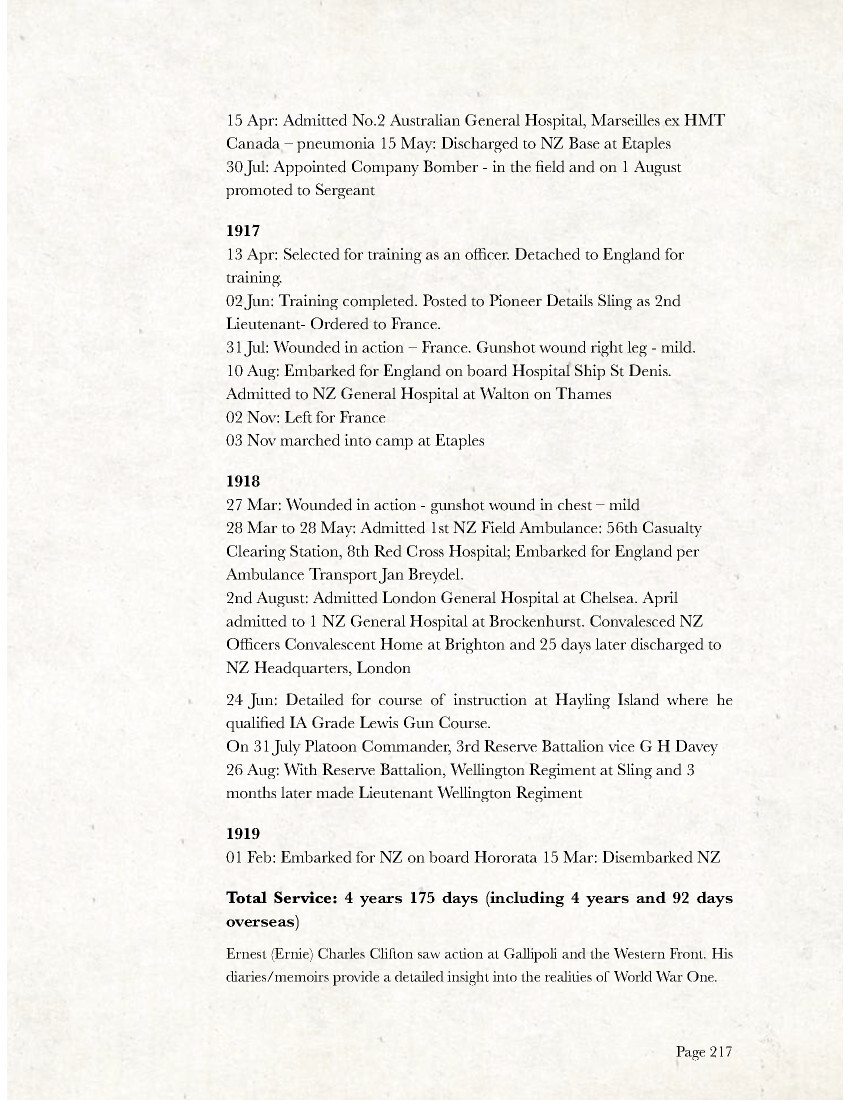
Page 218
LAND BALLOT
Ardkeen Section 16s, 466 acres
Ballot awarded to: Ernest Charles Clifton
January 1921
Ernie needed a horse, dogs, saddle, and equipment.
The Commissioner advised him to pay for everything himself, and he would receive an advance of £750.
Ernie wrote to Mr Marsh, Chairman of Hawke’s Bay Land Board, Napier, asking on behalf of the Ardkeen settlers for assistance with the payment of their first rent payment due; the Commissioner replied, saying each settler must make application separately.
May 1921
Ernie asked to have ninety-three chains of new fencing inspected; saying he was working on a council roading contract.
August 1921
Ernie provided the following declaration:
466 acres,
Cash £400
Credit £800
The whole first payment rent: £147
Unpaid sale of lambs: £189
Personal expenses: £100
Balance of livestock, council rates and interest, unpaid
15 Romney Rams
290 ewes
400 other sheep 12 acres of turnips 5 acres of oats
Owing to a dry spring and summer, the crops had failed.
Oats were ploughed in and turnips valued at about £20 (cost £70). There was no income before January / February and then only lambs (if any).
The farm will carry about 500 breeding ewes.
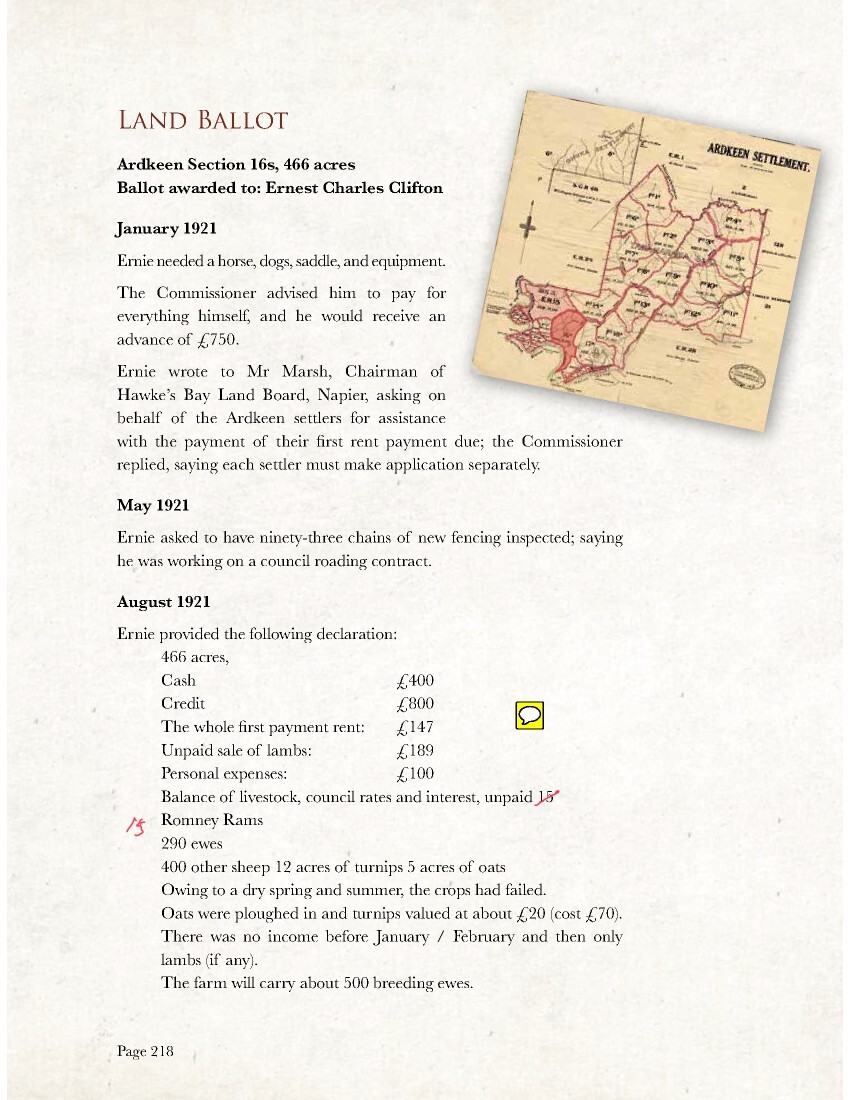
Page 219
It was difficult to say what returns 500 ewes will provide. Ewes were expensive at the time of settlement; present value £1.14.9d The high cost of stock and costly rent prevents any profit.
The Department Ranger described Ernie as a ‘suitable type of man, noting all his capital is invested in the farm.”
October 1921
Ernie advised the Commissioner that Henry Williams and Son builders, Napier were buying half a ton of corrugated iron to build a lean-to whare. The Commissioner replied, offering to pay for the corrugated iron, after the building is insured.
January 1922
Ernie was unable to pay the rent and asked the department to postpone payment for twelve months.
April 1922
The Commissioner asked for a report of Mr Clifton’s livestock. The branch manager expressed a favourable impression of Clifton, noting he required more sheep.
May 1922
Ernie advised the Commissioner he was match-lining his dwelling with tongue and groove and wanted the department to pay for 400 feet of timber.
June 1922
Ernie provided the Commissioner with a list of livestock:
285 ewes – bought from Ardkeen Station in 1st class order.
265 two-tooth ewes – bought from Pokopoko Station
8 full-mouth Romney rams
24 three-year-old Hereford cows – bought from Ardkeen.
10 mixed-sex eighteen-month-old cattle
1 four-year-old Hereford bull
1 grey mare (hack)
1 bay gelding (packhorse)
Ernie was unclear as to the extent of chattels; he had a saddle, bridle, fencing tools, a spring mattress, and no implements.
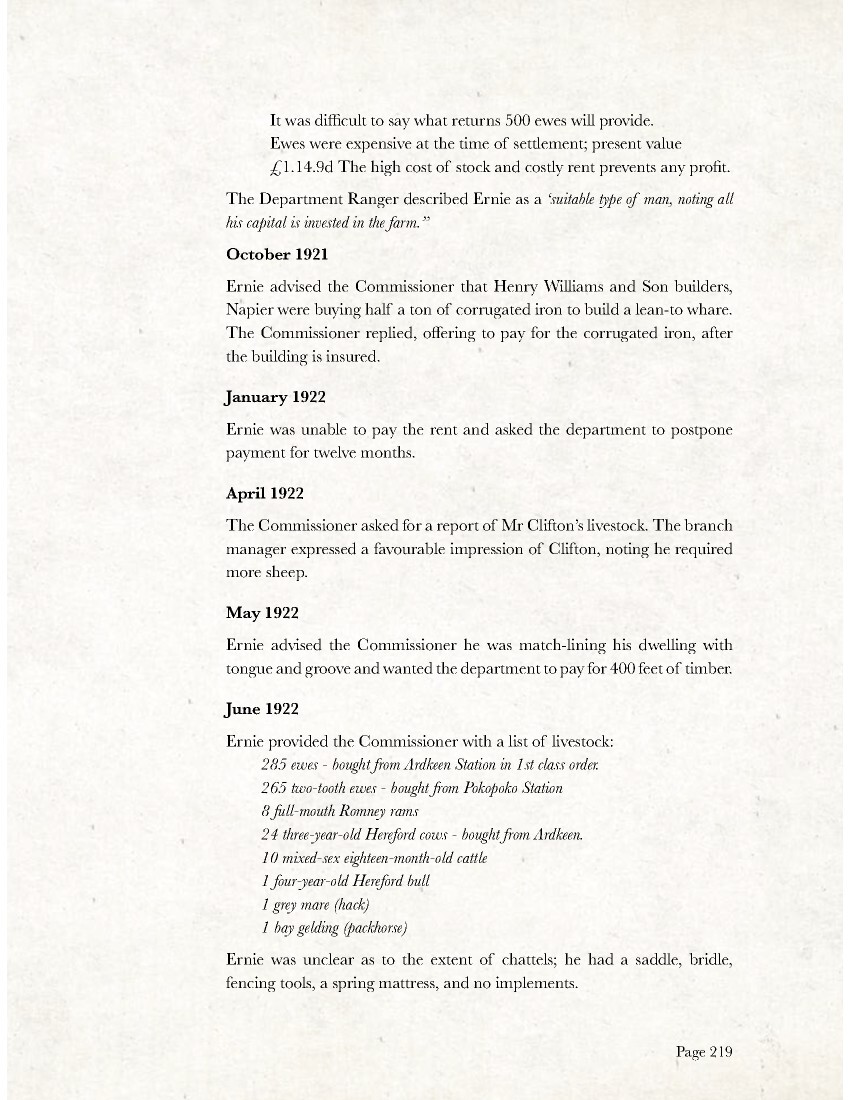
Page 220
August 1922
Ardkeen Settlement
The Under-Secretary for Lands
At the time of surveying Ardkeen Station for subdivision, several 40-acre homesteads sections along the Waikaremoana Road were set out. The sections were included as homestead sections because the associated farms were three to seven miles away.
There was a necessity to survey a livestock driving road through the settlement. Much of this stock route was against the boundaries of other sections. But in the case of Ernie Clifton’s lease, it was necessary to survey a driving road through the middle of his farm. Initially, it was not thought necessary to fence the track, however experience had shown otherwise. Settlers used sheepdogs to move livestock through Ernie’s farm, often causing considerable losses to his sheep. At times when darkness intervened, the sheep were abandoned, getting mixed with Ernie’s flock and eating his grass. He pointed out that if the road were fenced, sheep would be confined, making it easier for all concerned, but that would entail a cost beyond his means.
Field Officer D. G. Robertson observed Ernie Clifton was a good settler, suggesting he would make good with assistance and felt Ernie deserved support.
November 1922
Ernie wrote to the Commissioner about the stock route through his farm, expressing pleasure that he was to receive £200 towards the cost of fencing the track.
He was concerned however that proposed boundary changes to farms the track was to service might render the stock track unnecessary.
March 1924
Ernie wrote to the Commissioner that representations on his behalf were unfair; emphasising his farm was the smallest, with the least head of livestock of any on Ardkeen. He felt they did not illustrate his determination to make a living from the farm before pointing out that he had wasted the years from 1914 to 1919 at the war and had no wish to sacrifice another four or five years.
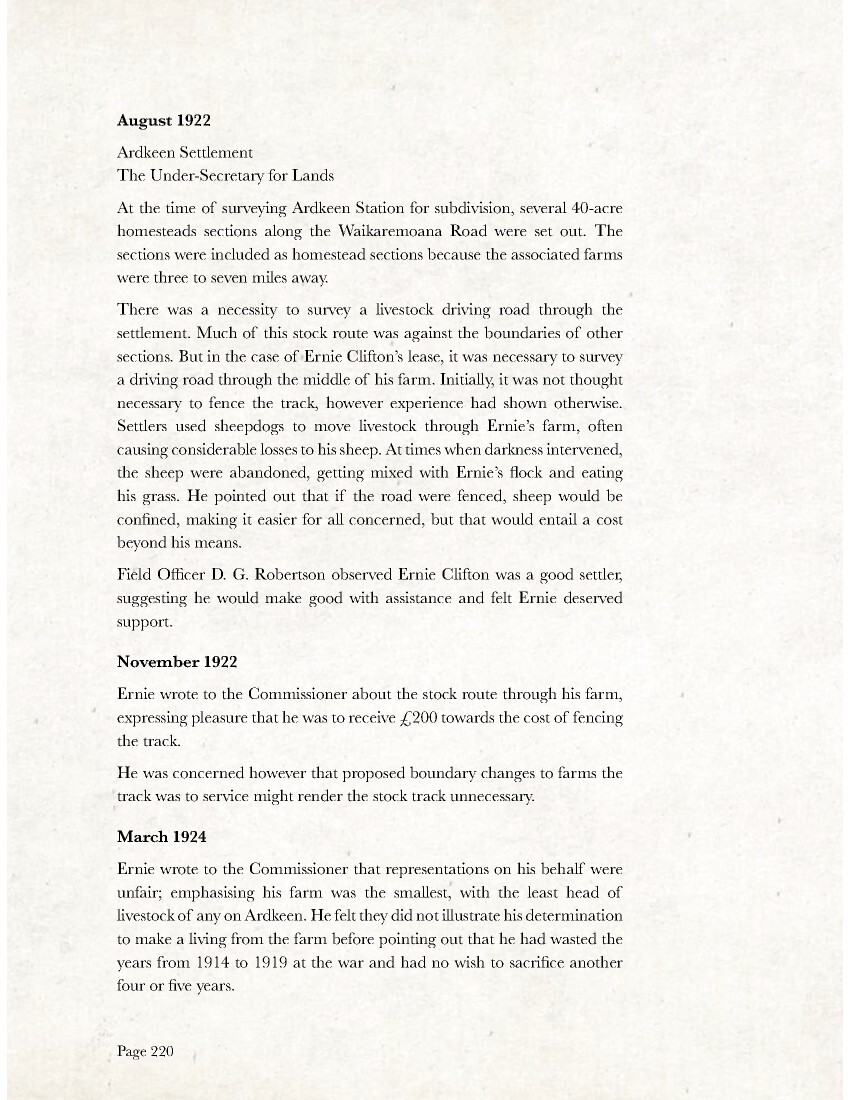
Page 221
Ernie advised the Commissioner he had sold his wool and wished to use the proceeds to repay £100 of a £200 interest-free loan from the ‘Pahiatua War Relief Association,’ already postponed for a year. He was of the view he had everything to gain from an investigation of his accounts, saying his stock mortgage with the Hawke’s Bay Farmers Co-op was limited to £600 and several times during 1921 and 1922 he had worked for the ‘Public Works Department’ on the roads earning money for groceries.
The settlers were offered work on roads but often refused because of health problems and the 10 shillings day wages were less than contract navvies would get. 61
Ernie sold lambs and wool as follows:
236 lambs at £194.14
230 at £79.19
407 at £258.17
400 at £220.10
Total income from lamb sales £754
Wool clip sold for £453.10,
Less shearing expenses and cartage
From a total of £1207 for four years,
Ernie notes: “I had to sustain losses on both cropping and cattle plus pay living expenses.”
The stock firm account interest (Over £200)
Current-account interest, Harbour board rates, shearing expenses and cartage etc. Reducing indebtedness by £100 and increasing sheep numbers by 200.
61 Gould, A.N. (1992) Proof of Gratitude, p. 190.
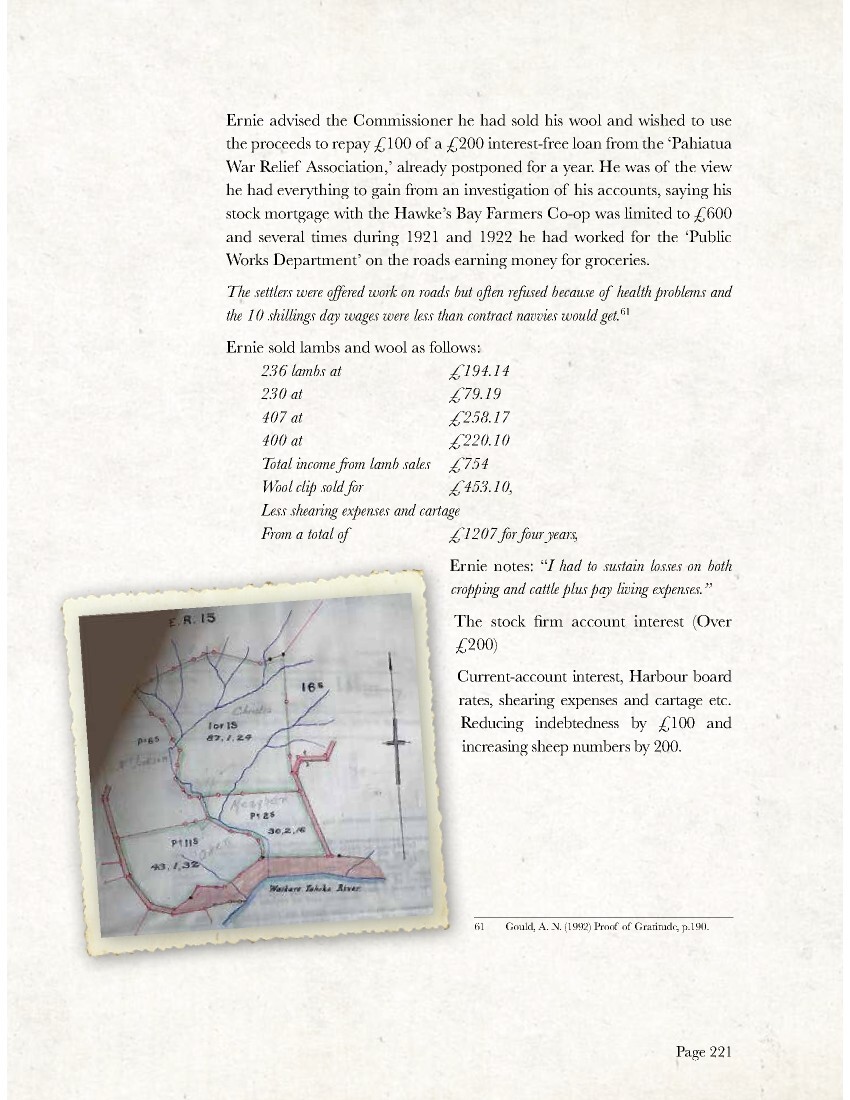
Page 222
April 1924
Land Board Minute
Non-payment of rent: E. C. Clifton 466 acres.
Capital value: £5,700
Annual rent: £256.10
3½ years arrears: £913.0.7.
The Board issued a notice of ‘Intent to Forfeit’.
Ernie replied he had not made any payment because the past four years’ earnings were £1,207.
Half the income covered recent losses, living expenses, and paid interest on his account with Hawke’s Bay farmers Co-op. The net result has been to reduce his trading account by £100 but he had increased sheep numbers by 200.
April 1924
Ernie learned the Land Board required half a year’s rent before they met with the Minister or he would face forfeiture of his farm. He had 30 days to appeal but must pay six months’ rent first. In the event of no appeal, forfeiture would be absolute. Ernie was told forfeiting his farm would not relieve him of any outstanding rent.
NB. The Land Board recommended this section be forfeited should the Minister approve. The committee wanted Ernie’s farm to divide between neighbouring settlers.
Inquiry Boards suggested the use of categories to determine the number of temporary and permanent failures. These being: the unsuitability of the subdivision; too small or, too large sections; the wrong configurations for the country; excessive rent, too high a price paid for the land. The experience of the settler – improper use methods of farming – suitability of stock – the amount of working capital albeit, undeveloped or neglected state of the property. The price of the stock, at the time of purchase – subsequent slump resulting in low prices for produce and stock.
The high cost of building, fencing material, implements, seeds and manure, at the time of purchase, or selection or other reason.
The boards were also asked to establish the percentage of farms which were presently unprofitably occupied, which might have been successful under normal conditions and proper management. They were required to advise the type of action
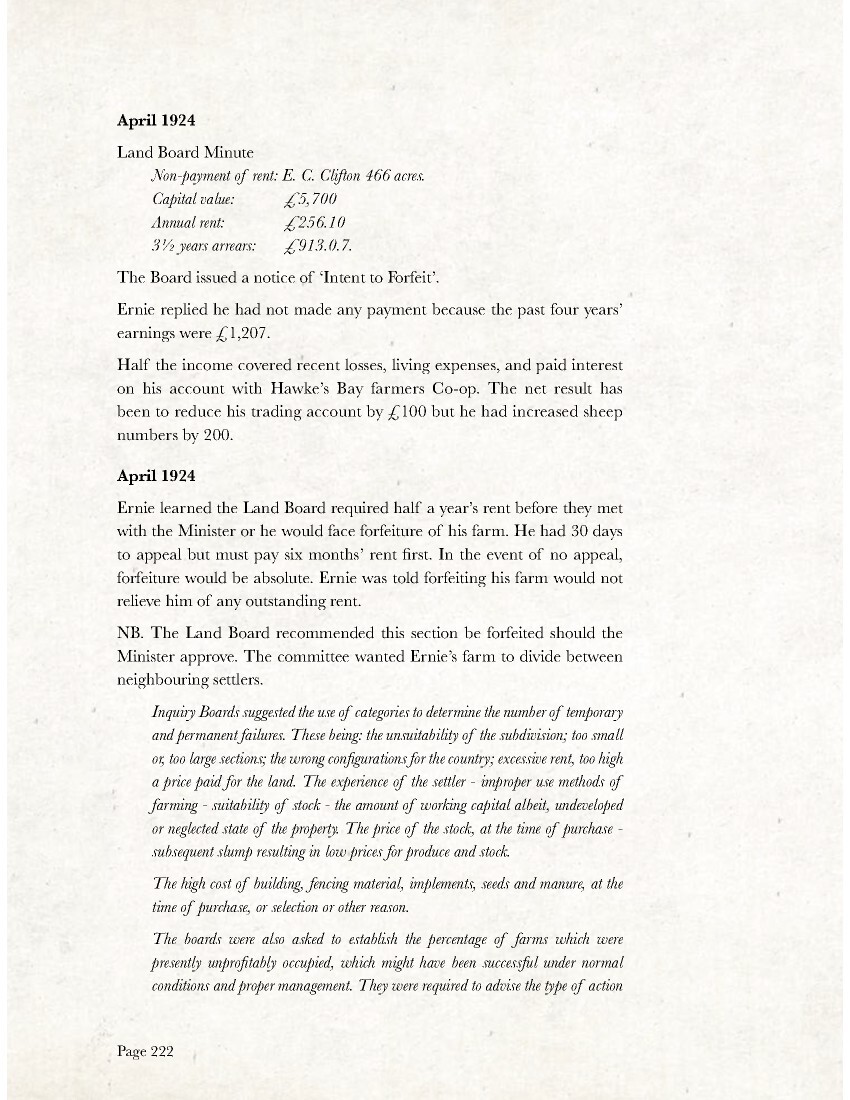
Page 223
for two categories of settlers. Capable, industrious men, faithful to their obligations, so far as their resources permitted. And those settlers who failed to make the most of their opportunities. 62
April 1924
Ernie wrote to the Commissioner of his surprise that such action should be taken so soon after his interview. He believed the farm could provide the necessary income; the Revaluation Board agreed. He was determined to continue.
May 1924
Ernie learned his case had not come before the meeting, however, he was advised his appeal would come before the Board at the June meeting and he must pay three months of rent. Skip to toolbar
- About WordPress
- Hawke’s Bay Knowledge Bank
- 00 Comments in moderation
- New
- Edit Post
- Kia ora, Denise
June 1924
Ernie replied, asking not whether he might find the £128 required, but if he could continue, saying he could not find £300 this year. The firm was charging 8% interest on his account which when set against revenue from 700 sheep made it impossible.
Inquiry Boards suggested the use of categories to determine the number of temporary and permanent failures. These being: the unsuitability of the subdivision; too small or, too large sections; the wrong configurations for the country; excessive rent, too high a price paid for the land. The experience of the settler – improper use methods of farming – suitability of stock – the amount of working capital albeit, undeveloped or neglected state of the property. The price of the stock, at the time of purchase – subsequent slump resulting in low prices for produce and stock. The high cost of building, fencing material, implements, seeds and manure, at the time of purchase, or selection or other reason. 63
The boards were also asked to establish the percentage of farms which were presently unprofitably occupied, that might have been successful under normal conditions and proper management. They were required to advise the type of action for two categories of settlers. Capable, industrious men, faithful to their obligations, so far as their resources permitted. And those settlers who failed to make the most of their opportunities.
62 Gould, A. N. (1992) Proof of Gratitude, p. 242.
63 Gould, A. N. (1992) Proof of Gratitude, p. 242.
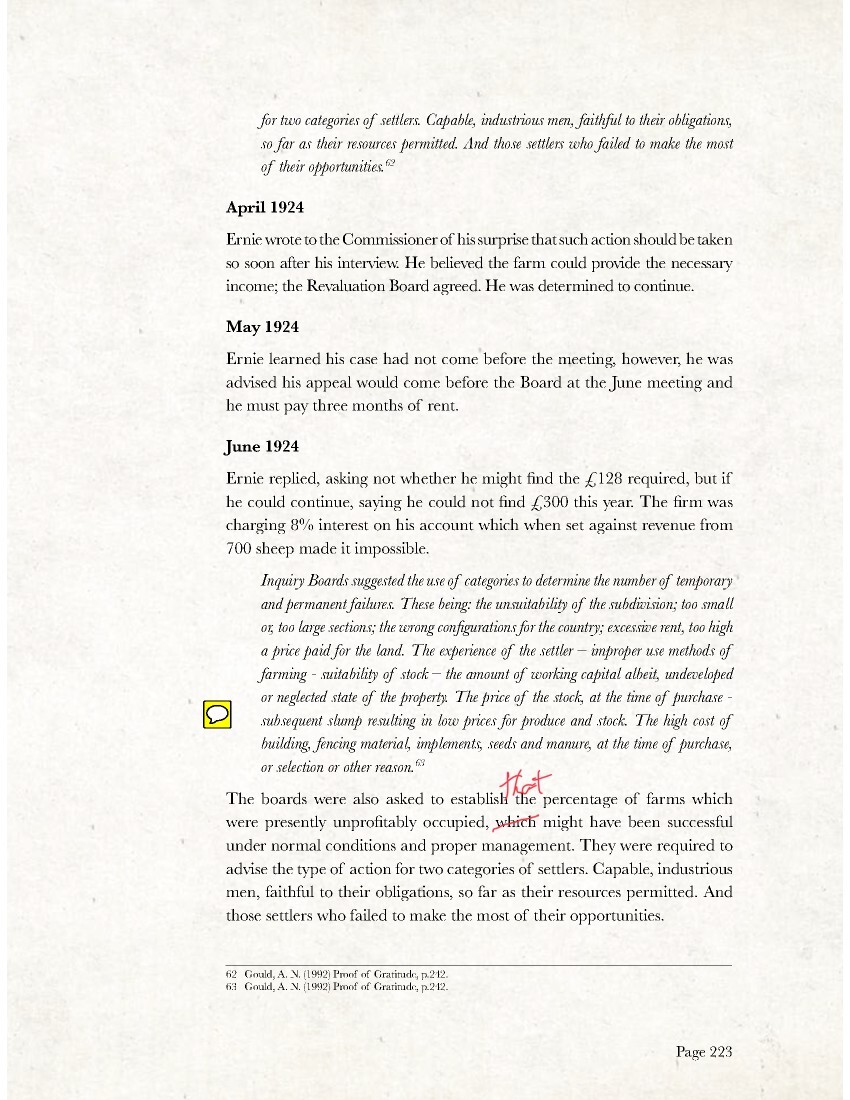
Page 224
If half a year’s rent remained unpaid, the Board would recommend forfeiture, the matter could go before the Minister for approval. However, the Minister refused to approve confiscation, the rent remained unpaid.
The Board’s description was:
A good little farm, too small, tenant very dissatisfied, seems likely to quit; if he does, they recommend dividing the section between neighbours, Spooner and Andrew.
They could not support further advances; the farm was too small and the tenant not a practical farmer. Estimated gross returns are £492.10.
Figures provided are correct.
He is a plumber by trade; ‘he would do better if he returned to plumbing’.
August 1924
Wairoa County Council obtained a judgement for £67.13.2 to recover County Rates on land occupied by E. Clifton.
Ernie asked the Commissioner for an advance against a set of sheep yards he had built.
The Commissioner responded: “I am not prepared to make any further advance to you” and returned the account.
1925
The Commissioner wrote to the Minister about the men who had signed a petition to the Minister; saying he had visited Clifton last April, advising him that it would be in his best interest to give up his section; saying he had explained what his position would be, and left him to think the matter over; Ernie gave no indication of his thinking; two months later the proposal was withdrawn. He had made application for further advances.
The Commissioner described Ernie as one of the problem men left on Ardkeen, and not the type to succeed, ‘if he would only get out’. The farm could be divided between three or four of the remaining settlers, this would put beyond argument the shortage of area on Ardkeen.
Soldiers were demanding more from the system than the Government could offer – the dependent situation of the soldiers was primarily about a shortage of capital and experience. 64
64 Gould, A.N. (1992) Proof of Gratitude, p. 208.
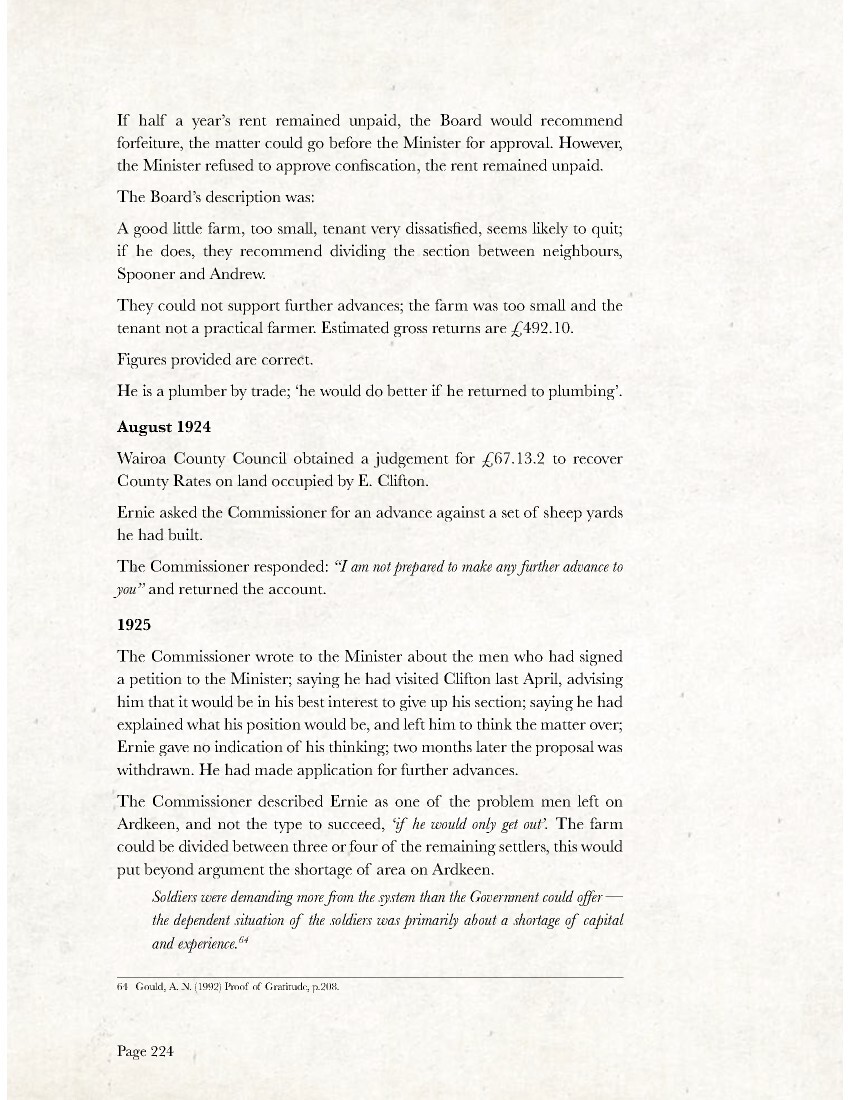
Page 225
November 1924
The Board recommended the Minister postpone the current half year’s rent subject to the payment of all rent to the end of June. The board wanted £252.9.0 in full.
January 1925
Ernie wrote to the Commissioner that he had instructed Hawke’s Bay Coop to pay the £268.4.1 outstanding rent and asked the Board to postpone the half-year rent still owing to enable him to settle over-due accounts.
October 1926
The Wairoa Council complained that settlers on Ardkeen were well behind with their rates and were objecting to paying rating role values.
April 1925
Ernie wrote to the Commissioner saying that to continue, he needed the half year’s rent postponed, and asked the department to pay for the material he had bought to build sheep yards. He reminded the Commissioner that two years previously he had asked for £200 to fence the stock route. He pointed out a ‘Public Works Department Engineer’, from Gisborne (Mr Horne) inspected the ‘right of way’ and wrote a report on forming and grading of a track for livestock. But Ernie later learned an alternative route had been settled on, and now wanted to know if he needed to fence the ‘Right of Way’?
April 1925
Ernie wrote to the Commissioner about a conversation he and Mr Nicol had about their respective farms; both felt the need for more acreage.
Ernie offered to leave the settlement, if he could sell his livestock at a favourable price, and the department would make a more suitable farm available.
Again Ernie enclosed the account for the sheep yard materials.
June 1925
After meeting with both Mr Nicol and Ernie at Ardkeen, the Commissioner wrote asking for a decision within seven days, or he would take no further action.

Page 226
October 1925
The Commissioner wrote to Ernie that unless fencing of the ‘right of way’ were completed on one side before the end of the year, the department would cancel the offer to subsidise the cost.
November 1925
Ernie had the opportunity of getting a team of pack-horses from Waihi Station and wrote to the Commissioner about 1,300 posts he’d bought from Jack Owen, saying he wanted to pack 5 miles to his farm at a cost of £4 per hundred.
The Minister approved £200 for fencing the stock track through Ernie’s farm. The fencing had to be completed by Ernie and payment would follow the Crown Land Ranger’s inspection.
December 1925
Ernie advised the Commissioner he needed more time to complete the fencing, saying he had split 2,500 battens and laid them on the line. Now he needed to harvest and had livestock work. The Commissioner extended the date of completion to: 31 March 1926.
Ernie wrote to the Commissioner about increasing his loan to £900, to enable him to build a small cottage; he planned to marry.
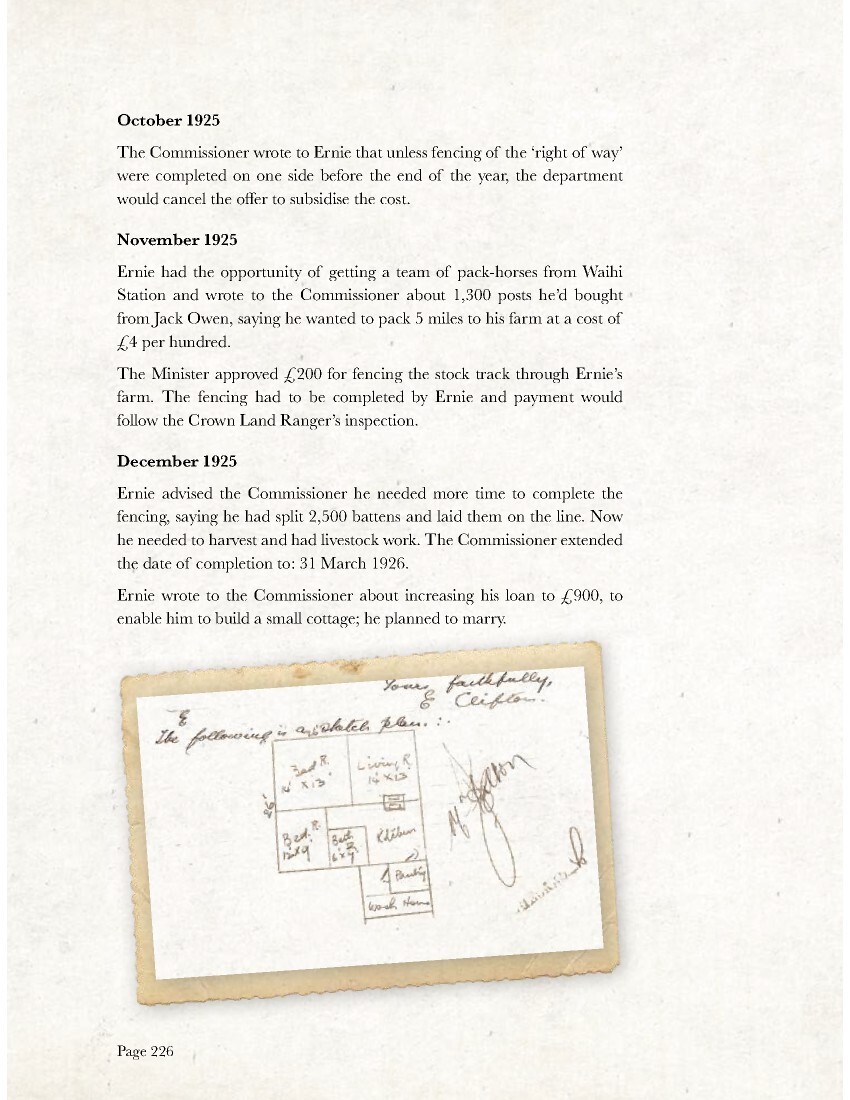
Page 227
Ernie explained he had drawn £500 for living and required £150 to buy material, to enable him to complete the house. He also advised he had no money for fencing or other improvements; adding that an old boundary fence of 108 chains needed replacing.
Sheep yards incomplete: £20
Wire and staples: £14.10
Battens: £20
Plantation fencing: £5
Yards to complete: £10
Wire / one tone: £24
Staples: £4
Battens: £10
Hen coop and gate timbers: £12
Hinge bolts: £10
Water pipe and a trough: £10
Total: £159
March 1926
Ernie advised the Commissioner that one side of the livestock track fence was complete. Total cost: £190.10. The Commissioner replied that Mr Robertson reported 78 chains was complete. The total value of the fence was estimated at £186, of which £60 was owing to the department for five Totara strainers and 450 fence posts. He advised payment of the balance would be made after seeing evidence of payment for wire, staples, five gates and labour.
June 1926
Ernie then advised the Commissioner he had made improvements without seeking advances and would like a valuation. He had erected 230 chains of new fencing, apart from the stock track, sheep yards and plantation etc. He asked for the value of the improvements to be credited to his account before July 31 to offset the rent due and to get the rebate.
July 1926
Ernie again asked the Commissioner if he could build a small cottage.
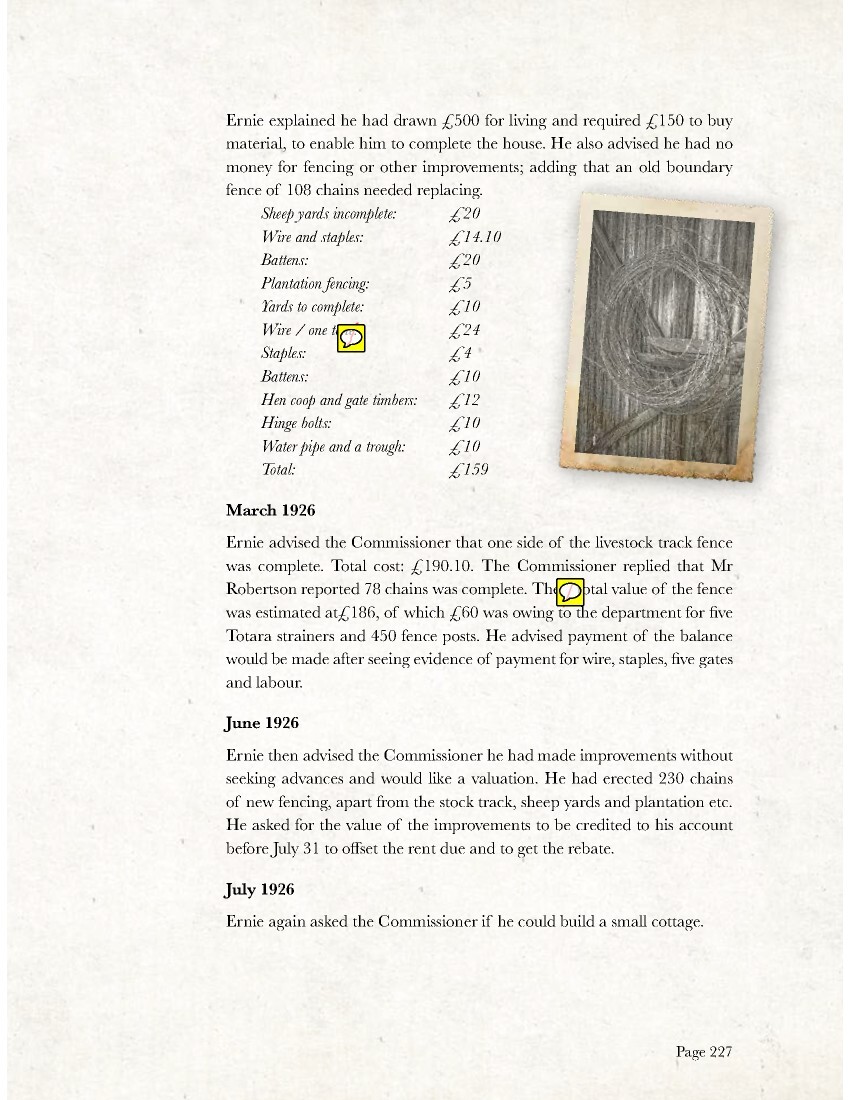
Page 228
October 1926
Ernie told the Commissioner the dwelling was complete and that his whare was now part of the new house and insured for £400.
February 1927
Ernie wrote to the Commissioner saying that weak prices for lamb and mutton, and the high cost of wire, made it impossible to pay arrears of rent and rates.
The Commissioner replied that it would be quite useless to ask the Board to allow the rent to stand over, pointing out that if a problematic season justified not paying rent, the Board might ask him to pay extra rent in a good season. The Commissioner did suggest however the Board might postpone payment.
January 1928
In the new year Ernie told the Commissioner that the Hawke’s Bay Farmers Co-op had closed his account.
January 1928
In the same month a memo for Mr Robertson, the Crown Lands Ranger, from the Chief Clerk expressed the view that no good would come from looking into Clifton’s affairs. The memo advised that the entire settlement was to be reviewed by the Dominion Board and to leave it until the next time the Ranger was in the district. Nevertheless, Crown Lands Ranger Robertson called on Clifton and impressed on him the necessity of paying as much of his arrears as possible.
February 1928
The Commissioner wrote again to Ernie about his unpaid rent: saying he required 75% of the outstanding rental immediately, and the matter of revaluation was under review.
April 1928
Ernie replied that he would welcome an inspection of his account with Hawke’s Bay Farmers Co-op. He added of the 466 acres, 336 acres was hill-country with a southerly aspect covered in mainly native grass with 20

Page 229
acres of light pumice flats. One hundred and ten acres of foothills were of very light pumice soil. There was some ploughable land but it was inclined to manuka, fern and tutu (poisonous to livestock), and with grassland in the bottoms of the gullies. He described this area which was a quarter of the farm as infertile. He was carrying a small number of sheep only.
Ernie wrote to the Chairman of the Dominion Valuation Board, Wellington about the re-allotment of Nicol’s farm, Section 14s. He noted the vacant land adjoined his farm. He had not made an application for any part of Section 14s because he assumed these areas would be part of the Chairman’s investigation and said he could make arrangements to finance the livestock and pay the rent but wanted the matter of the additional land settled before paying his rent arrears.
Since January 1925, he had paid £640 rent plus interest on the current account and a further £177.8.9 Council rates including two years of arrears. It had been impossible to meet payments from his returns and provide a living.
The wool weights and number of sheep shorn for the past three years
1925 – 4,385 lbs. – 556 sheep
1926 – 4,140 lbs. – 616 sheep
1927 – 3,840 lbs. – 618 sheep
This was an average of 4,100 pounds per year.
Wool in the December sale returned £213 from 350 lambs, 64 fat lambs netted 15/- 1p.
127 wether lambs at 13/- 6p
43 wethers at the 23/- less commission. Gross returns were £391.
After paying rates and interest, there was enough to buy replacement stock.
Dairying was considered as an option, but with only 20 acres of flat pumice land needing fertiliser twice a year, the cost of labour, and other expenses, Ernie did not think it would be a profitable option.
April 1928
The Commissioner advised Ernie that Dalgety & Co. were prepared to pay some rental arrears; the Board would defer forfeiture, adding the Board hoped to offer Ernie more land.
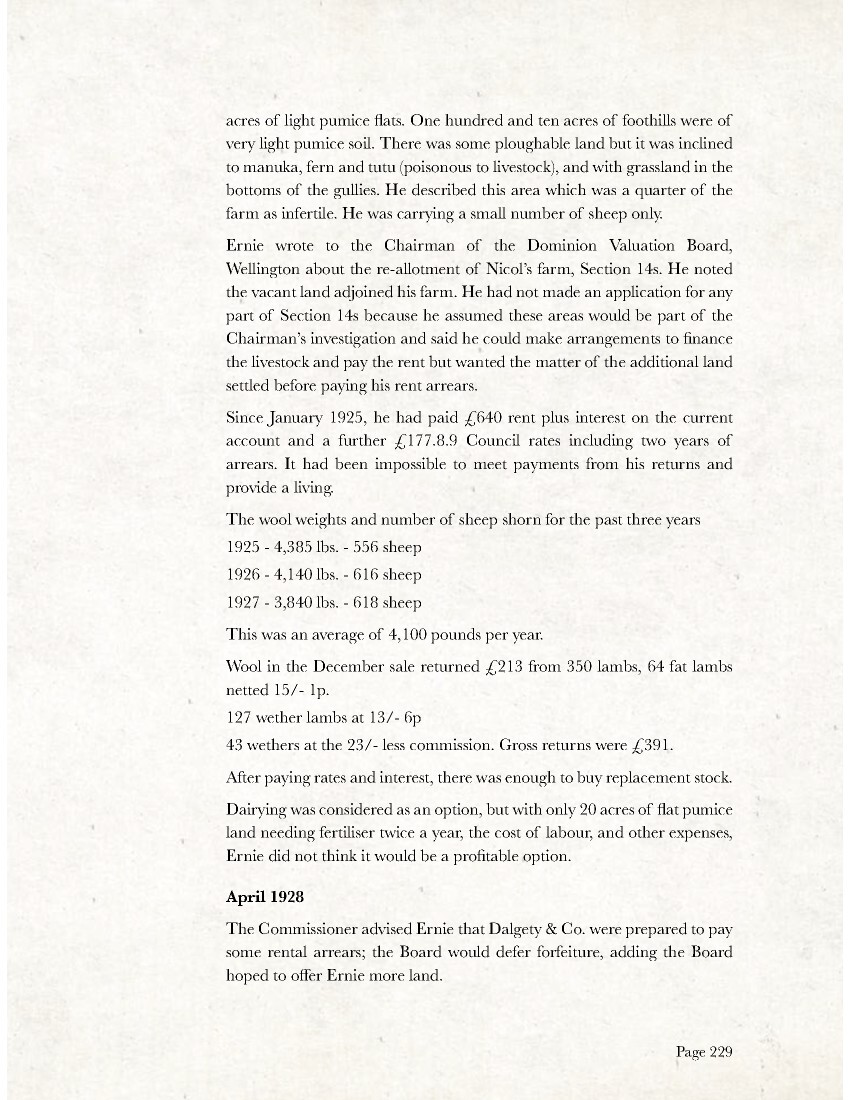
Page 230
May 1928
Ernie Clifton appeared before the Land Board saying his farm was too small but he believed he would have no extra expense and would have a reasonable chance of making good with more area. His affairs had gone from bad to worse because his section was so small. Wool returned £213 for the season, and livestock prices were disappointing. In three years he paid £800 in rent and rates; this had crippled him.
It was Mr Donovan’s view ‘this was a good season’, and it would not be wise to count on better prices than last season.
Ernie hoped for a better year, however Dalgety’s had withdrawn support. There was £45 of county rates outstanding; he would arrange to pay these. He had applied for a revaluation of the farm and asked the Land Board to hold the matter over until the Dominion Board reached a decision about the rent.
Mr Cunning suggested, with £356 expenses, he would need his rent wiped out if he was to do any good at all. Clifton paid no rent for 12 months.
Mr Dick Steven argued that the settler would be no better off with additional area, because the cost of the livestock would increase his debt.
In reply to a question from Mr Reed, as to whether he would prefer a reduction in the rental or taking over more area, Clifton stated he could not pay more than £210 a year for rent together with interest on advances. If he got a fair reduction he would prefer to continue with a small place and make it pay rather than take over more ground. He asked the Land Board to hold forfeiture until the Dominion Board had settled the revaluation matter and made an adjustment of the land areas.
February 1929
The Commissioner wrote to Hawke’s Bay Farmers Co-op about Ernie’s rent arrears, asking why the firm refused payment? Pointing out the firm had ample security over the livestock and the Land Board had no wish to forfeit Ernie’s lease, particularly now he had more area, giving the firm seven days to reply.
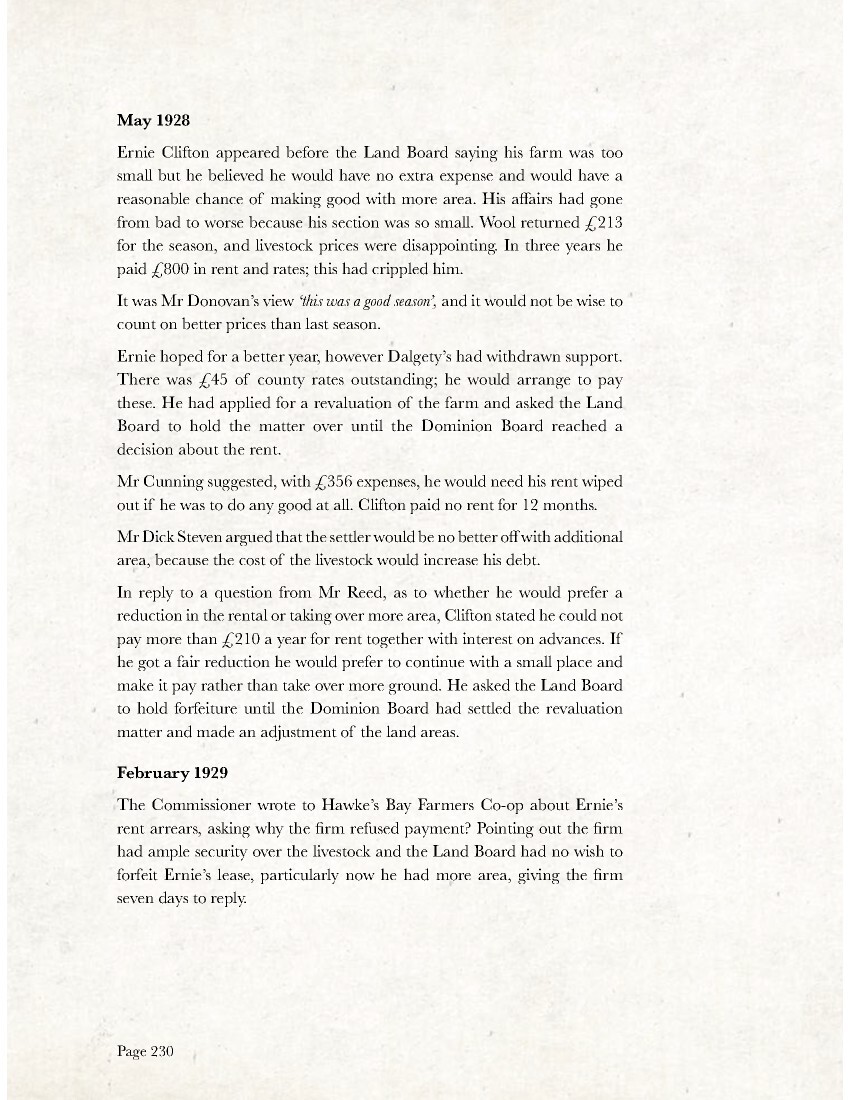
Page 231
July 1929
The Commissioner wrote to Hawke’s Bay Farmers Co-op about previous correspondence concerning Mr Clifton who had been before the Board the previous Friday. He advised the Co-op he had £329.6.5 in arrears and the Board did not mind one half-yearly payment to stand over for a while, but would take steps when arrears exceeded that, saying the Board had put off forfeiture so long as £129.6.5 was paid before the next Board meeting.
Ernie wrote to the Commissioner saying he was asked by Hawke’s Bay Farmers Co-op to supply particulars of his livestock and an estimate of expenditure up to January 1930. He had included £100 for rent and £18 interest for July and £60 to buy dairy cows, purchasing six cows at £9 each. However, the firm wanted the rent reduced, before paying for the cattle. At present, they would pay £50 rent and interest (£18).
‘I will pay the amount you ask if possible. But the Firm won’t pay more than £68.’
Ernie wrote to the Dominion Board, Wellington about being unable to pay the past two years’ rent; asking for relief. He said the Revaluation Board visited last March; he had paid £100 toward rent and interest and was still awaiting an answer. Now a further period of rent was due and the Land Board was demanding £129 before the next meeting in August, or forfeiture would take place.
Ernie expressed the wish to pay however, Hawke’s Bay Farmers Co-op held security over the livestock. Having settled half the rent and reduced the arrears of council rates, he was unable to clear the arrears.
The Board spread the arrears over the next four years but Ernie advised he could not pay these arrears. He had recently married and could no longer live as cheaply, with medical and other expenses to meet. He told the Dominion Board it was not just because the farm was small but having 110 acres of unproductive pumice country did not justify the rent expected.
December 1929
Ernie asked for £250 to erect 70 chains of subdivisional fencing and half the boundary fence between Andrew and himself on the recently acquired Nicol block. He needed a shed: £30-£40, plus £25 for a water supply for dairying purposes.
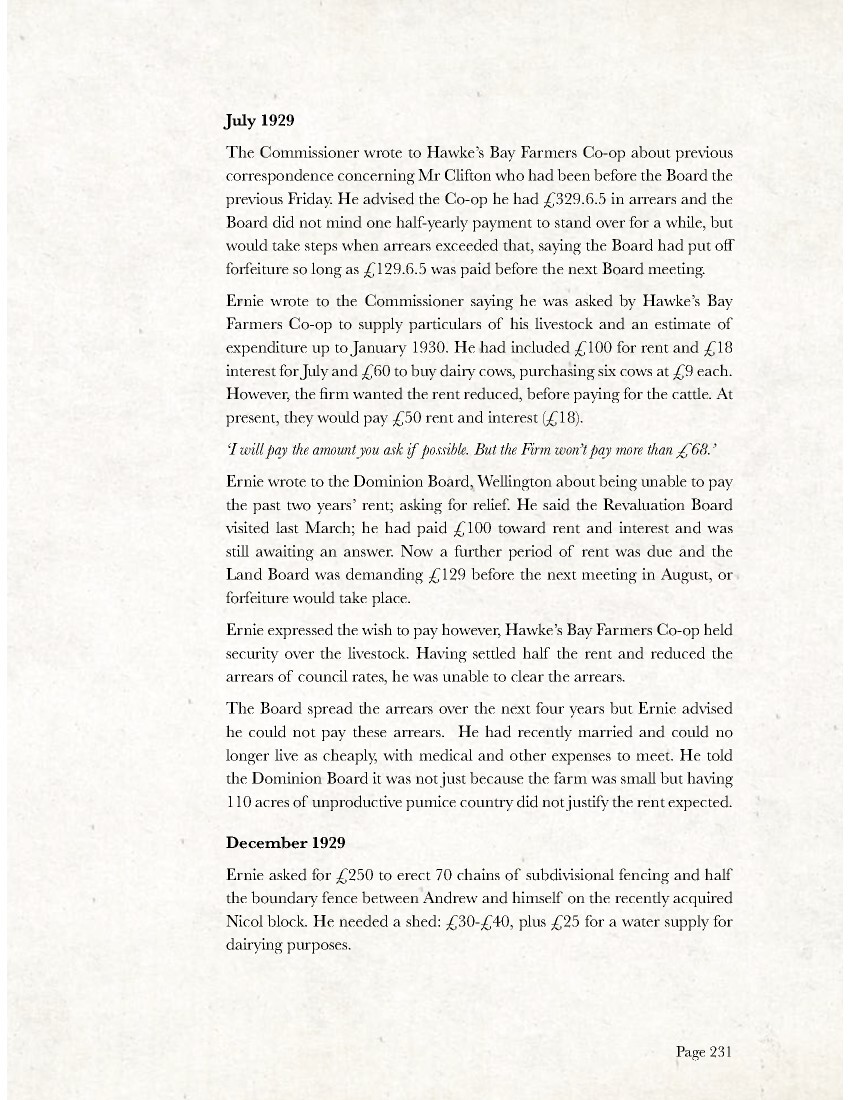
Page 232
February 1930
Land Board minute:
The Dominion Board reduced Ernie’s capital value by £500 and offered a remission equivalent of £191.5 rent.
May 1930
Ernie advised the Commissioner that he wished to surrender 28 acres to Mattie Andrew and asked for £45 to build a hay barn and a cowshed with a concrete yard.
December 1930
Memorandum for Commissioner:
Section 16s Ardkeen: Settler E. C. Clifton
The above settler’s application for postponement; unless Clifton surrenders part of section 14s, he cannot continue. He lost 300 hoggets last year and has no surplus sheep for sale, on top of a bad lambing. He leased one paddock of section 16s to Mr Preston until after shearing and is trying to sub-lease a portion of 14s to another settler.
If the sublease pays the rent and rates, he will increase his dairying operation for a few years while he re-builds livestock numbers.
If he sublets, he will have 100 two-tooth wethers for sale, this money will buy more dairy cows.
D. G. Robertson Field Inspector
March 1931
Ernie advised the Commissioner he was unable to pay rent or interest on his current account, saying he had a £1,100 overdraft at the Bank of New South Wales, plus interest. There were 11 bales of wool in store at Napier that had been salvaged from the earthquake ruins and shipped to London. Small cream payments were outstanding.
The bank’s interest at 7.5%, plus charges requires more than farm earnings and is debited against the account regardless of slump or drought.
Eighty-eight fat lambs had gone to the freezing works realising 7 shillings each. There were no further sheep to sell.
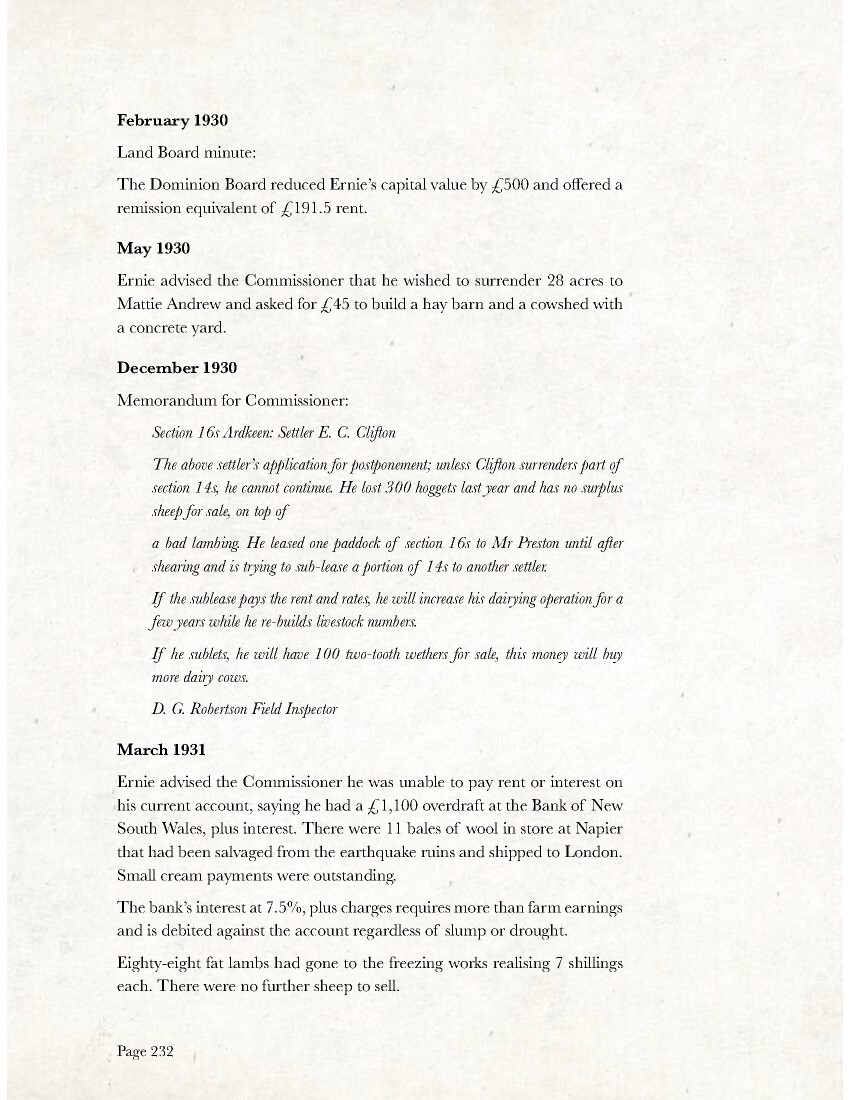
Page 233
Ernie’s father guarantees the account; “He is up against it also.”
The Commissioner said he would bring the matter before the Land Board, expressing his pleasure that Ernie’s wool has been salvaged and was en route to London. He advised that several settlers lost wool in the recent fires at Port Ahuriri and thought the Land Board would give Ernie’s case a sympathetic hearing.
April 1931
The Field Inspector believed Ernie had too much land and should surrender part of the Nicol Block. He advised that Clifton, after having lost 300 hoggets the previous winter and a poor lambing, had no sheep for sale this year.
Field Inspector Robertson described Ernie as:
A steady, industrious settler with: 10 dairy cows
510 ewes
250 dry sheep 40 head of cattle
Unable to make the best of his property. Not brought up to farming.
No livestock sales.
Reduced prices for butterfat and wool. Farm expenses exceed estimated revenue.
Field Inspector Robertson believed the property could pay if fully stocked and properly managed.
July 1931
Clifton’s application for postponement was adjourned until proceeds were received.
The claimant has an £1,100 overdraft at Bank of New South Wales, and no money in hand, but anticipated a small return from 11 bales of wool salvaged from the Napier earthquake and shipped to London.
The Board recommended postponement of arrears and payment due, July 1931 for two years.
Ernie thanked the Commissioner and Board, pointing out the bank required an undertaking the department would not distrain. Ernie asked the Commissioner to provide this through to January 1932.
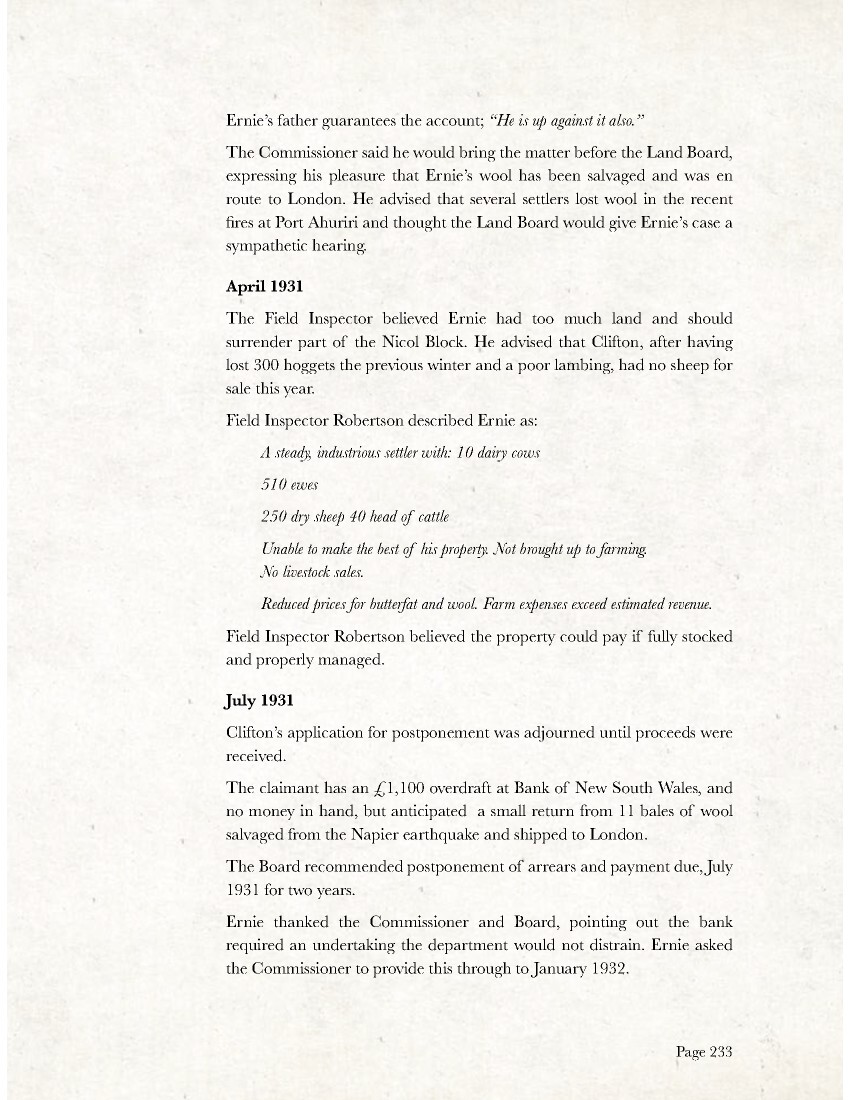
Page 234
July 1931
The bank held security over Ernie’s livestock and therefore controlled all the farm revenue.
The Crown’s arrears of £221.16.5 remained unpaid plus there were charges of £141.0.11, previously postponed.
The Commissioner advised he would not forego any rights to the Crown unless Ernie made arrangements with the Bank to pay a portion of the rent. It was made clear to Clifton that holding title to the property was dependent on the payment of rent.
March 1932
The Commissioner asked for an ‘Income Sharing Agreement’ of the season’s revenue after deductions for living and working expenses and stated that if the bank did not agree, the department reserved the right to distrain.
March 1932
The manager of the Bank of New South Wales wrote to the Commissioner of Crown Lands that after deductions for living and working expenses, there was no surplus left to pay rent.
He pointed out that Clifton’s expenses were minimal, the half-yearly debits for bank’s interest merely increased his indebtedness, adding that to distrain for rent would cripple Clifton.
March 1932
Expenditure:
Bank interest and charges £84
Living expenses £106
Shearing £22.15.1
Dipping £3 14.1
Crutching £3
Shipping wool £9.18.3
Cartage £10.17.8
Insurance £15.2
Power Board £8.1.10
Telephone £9.10
Manure £5.10
Rams £10
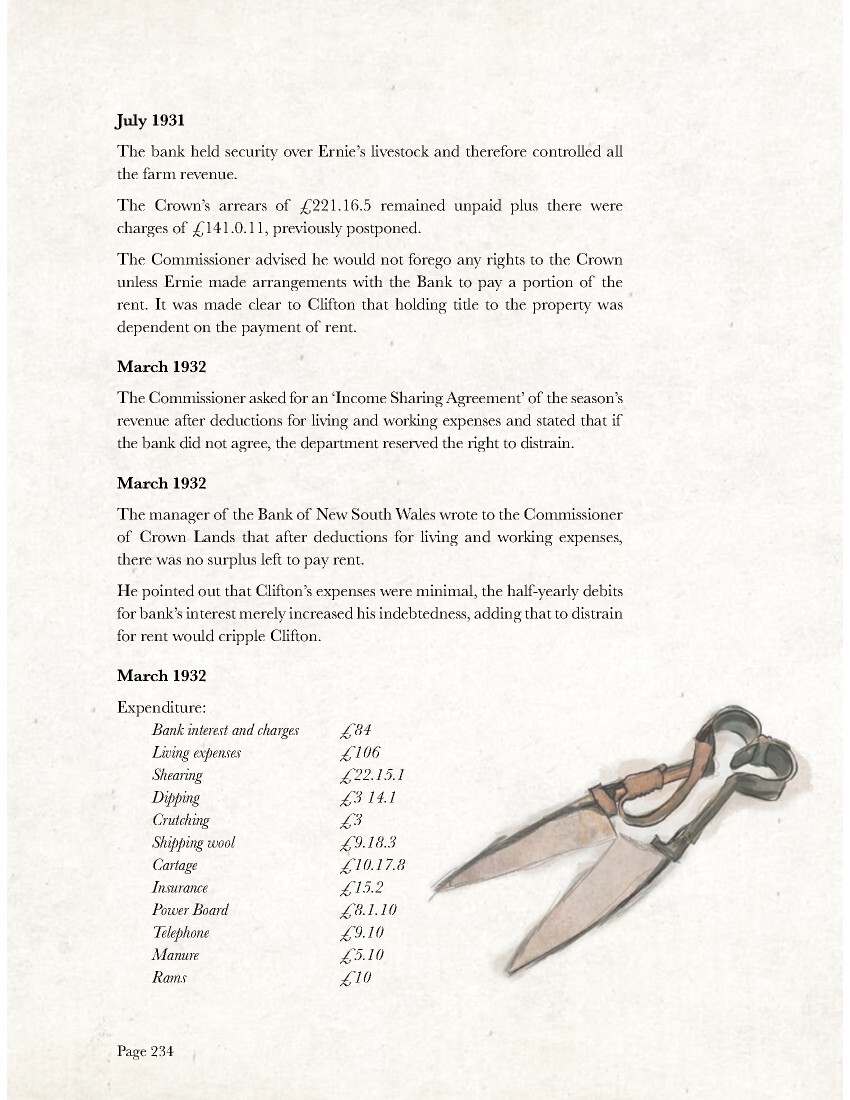
Page 235
Cream separator £5.05
Total: £293.8.11
Receipts: Butterfat £59.2.1
Wool 22 bales £107.10.5
207 lambs £58.14.7
14 lambs £6
85 wethers £38.17.9
8 wethers £3.11.8
Total: £274.9.6
Profit: £18.11.5
May 1932
The manager of the Bank of New South Wales advised the Commissioner they would allow Mr Clifton £40 to meet the department’s rent on the understanding the department would not issue a Distraining Order for at least 12 months.
June 1932
Ernie asked the Commissioner for money to increase his dairy herd.
He added he had been milking 11 cows by hand, and it would be impossible to milk 30 to 40 cows. He wished to buy:
18 heifers £160
Water supply £30
Extend milk shed £20
4 tons manure £24
Milking machine £70
Total: £304
Ernie said the dairy factory would finance milking machines and manure from future returns, however, if the department funded the venture, they could have half the butterfat cheque, therefore sharing the revenue from the farm.
Ernie told the Commissioner the Bank of New South Wales would allow him to buy ‘beef cattle’, providing the department would not distrain the livestock before April 1933. Ernie said he had 51 ‘in calf cows’ on offer but he wanted the matter settled before paying for the cattle
There is no further record of Ernie Clifton’s affairs; Ernie kept diaries that are deposited with the National Library that have not been used here.
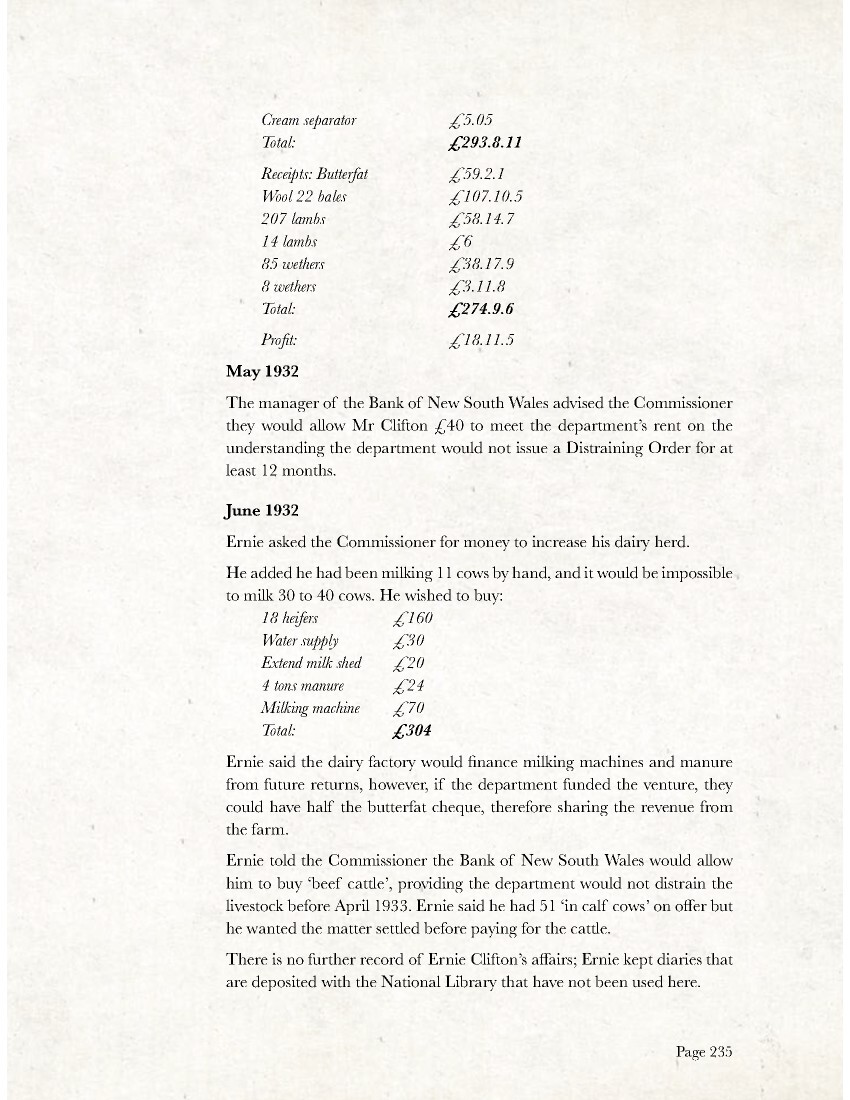
Page 238
MATTHEW ANDREW
MILITARY SUMMARY
Date of Birth: 19 November 1885
Place of Birth: Tikokino
Parents: Matthew and Frances Andrew née Austin
Next of Kin: Robert Murray McPhail, stepfather, Wairoa
Last NZ Address: Wairoa
Marital Status: Single -married 1922 Violet Wilson
Occupation: Farmhand
Employer: Robert McPhail
Regimental No: 41463
Rank: Private
Death: 22 April 1954 Porirua
Buried: Wairoa Cemetery
Awards: British War Medal, Victory Medal
1916
06 Dec: Attestation signed at Garrison Hall, Gisborne 1917
02 Jan: Posted to 24th Reinforcements F Company at Trentham
26 Apr: Embarked from Wellington
02 May: Disembarked at Sydney re-embarked 09 May
28 Jul: Disembarked Plymouth. Marched into Sling Camp, Bulford, Wiltshire
05 Sep: Proceeded to France
09 Sep: Marched into camp at Etaples
20 Nov: Detached to 3rd NZ Field Company, NZ Engineers in the field
1918
14 Jan: Otago Camp near Ypres – about 10am whilst working on a hut damaged by shell fire, the roof gave way and he fell and damaged his leg. He was on duty and was not to blame nor was anyone else to blame.
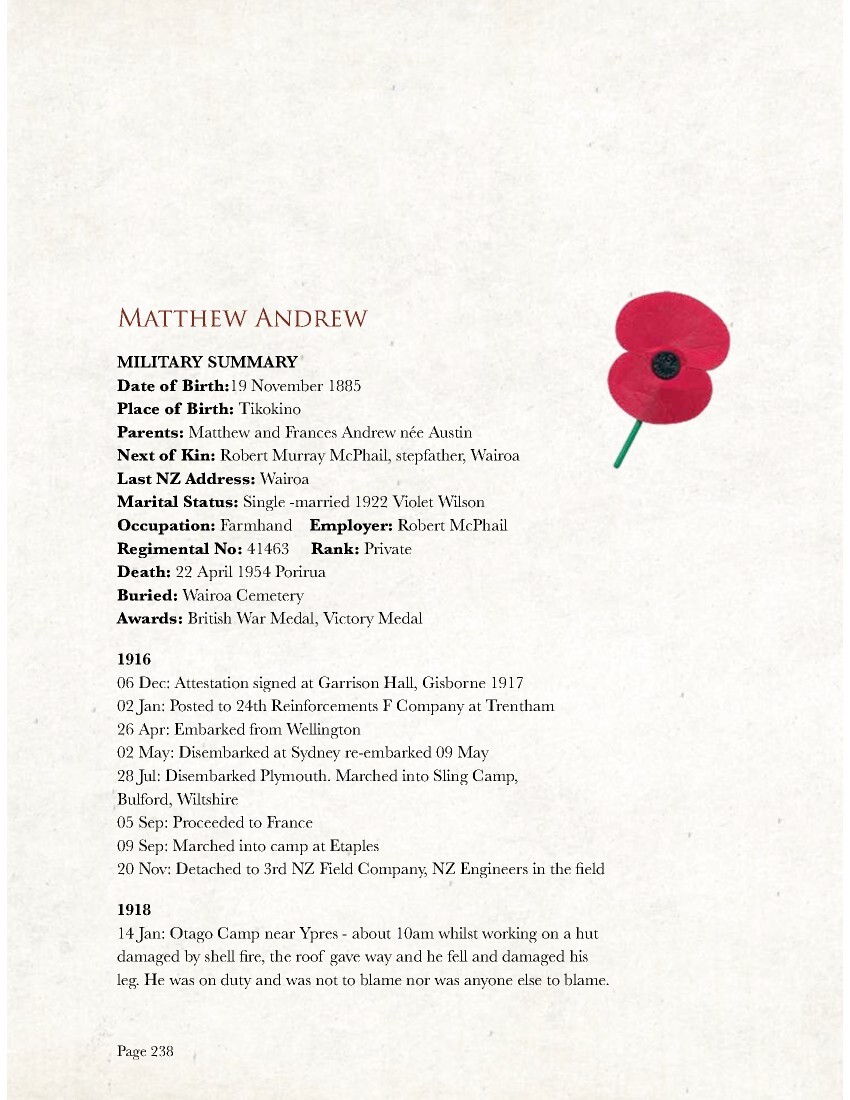
Page 239
Admitted 4th NZ Field Ambulance – fractured right tibia. Admitted 3rd Canadian Casualty Clearing Station
17 Jan : Admitted St John’s Ambulance Brigade Hospital at Etaples
19 Jan: Transferred to England per Hospital Ship Stad Antwerpen. Admitted 4th London General Hospital, Denmark Hill, London
16 Apr: Transferred to NZ Convalescent Hospital at Hornchurch
14 Aug: Classified unfit and placed on NZ Roll
19 Aug: Discharged Hornchurch – report at NZ Discharge Depot, Torquay on 03 September
07 Nov: Embarked for NZ on board Ulimaroa from Plymouth
20 Dec: Disembarked NZ
1919
25 Nov: Discharged no longer physically fit for war service on account of illness contracted on active service (fractured tibia)
Total Service: 2 years 330 days (including 1 year 238 days overseas)
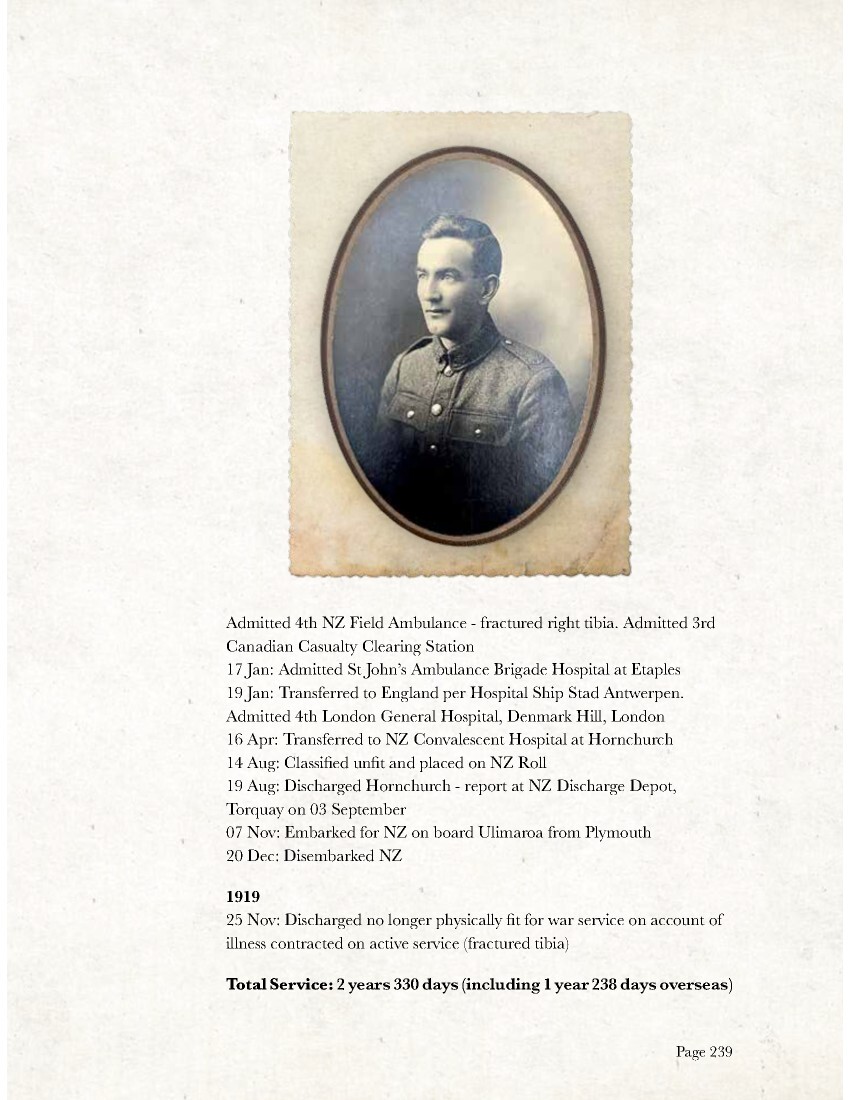
Page 240
LAND BALLOT
Ardkeen Section 17s, 558 acres
Ballot awarded to: Matthew Andrew
December 1921
Mattie wrote to the Commissioner that he had learned five Ardkeen settlers wanted a stock track through his farm. And they want 10 acres of his flat land for a holding paddock near the woolshed. If this happened, Mattie said he would walk off his farm.
The Commissioner replied that he was unaware of any such plan.
September 1923
The Board noted Mattie Andrew was one of two settlers who paid rent. Mattie’s farm was described as 300 acres in good pasture, 200 acres worn-out pasture, 50 acres of bush, an average section lying to the south which was cold in the winter.
October 1924
Mattie Andrew wrote to the Commissioner that he was satisfied with his valuation, but not however with the remitted rent. He questioned why other settlers on Ardkeen had not tried to meet their obligations, but still received a year’s remission. It was clear he felt harshly treated because those settlers earned the same as he did and he wrote they had boasted about clearing their debts.
Mattie offered to pass on information, but complained about being penalised for meeting his obligations, adding he’d borrowed £500 for five years at 8% from a relative and could have repaid this debt and let the Government sweat, as others had; pointing out the Commissioner had postponed half the rent for all except himself and one other.
November 1924
Mattie wrote to the Commissioner, ‘as a duty to his family’, that he was satisfied with the valuation, however, dissatisfied the more substantial settlers had not enjoyed the remission of rent others had. Mattie pointed out that
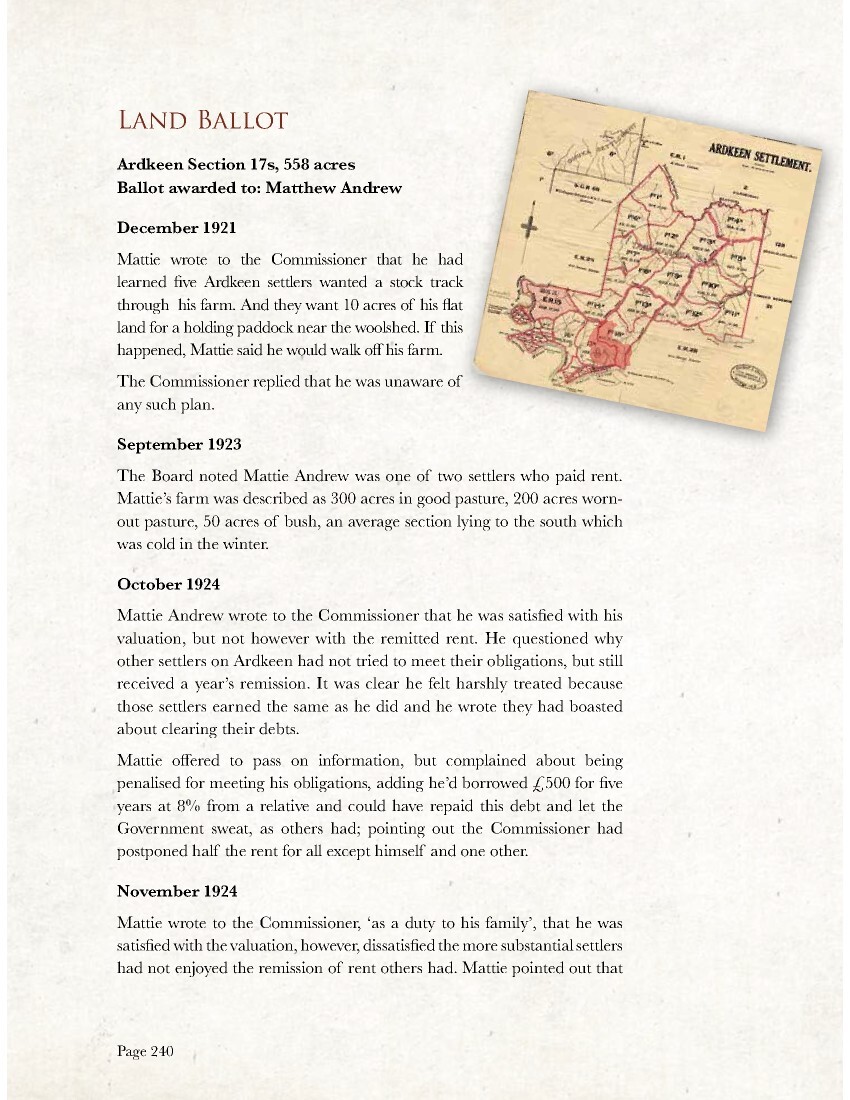
Page 241
he and Tolme always paid their rent. Now they were being penalised for their honesty, as well as being the ‘laughingstock’ of the settlement.
December 1924
The Commissioner advised Mattie his rent had been remitted for two years bringing him in line with the other settlers on Ardkeen and thanking him for keeping his rent up-to-date.
Mattie replied, saying the letter gave him great encouragement.
December 1925
Mattie wrote to the Commissioner that he’d had few advances whereas others on the settlement had drawn their full amount; he felt disadvantaged now these advances were no longer available. He felt it was unwise to burden his farm with loans, without the capacity to service debt.
May 1926
Mattie wrote to the Commissioner about Section 10s being vacant and asking for a portion; pointing out he did not owe the department anything.
September 1926
Mattie wrote to the Commissioner about reading in the Gisborne newspaper that his farm was forfeited and saying he may owe £4 interest only?
The Commissioner replied apologising for the mistake. The matter related to Section 17 at Ohuka.
April 1928
The Crown allotted Mattie 145 acres of Nicol’s section 14s with access through Ernie Clifton’s back paddock, formerly also part of section 14s.
October 1928
The Commissioner offered Mattie part of McKay’s homestead section 10s that bounded his farm.
Mattie objected, when he discovered he would only get 47 acres while Jim Tolme was to get the remaining 40 acres of McKay’s homestead section 10s.
November 1928
Mattie told the Commissioner he had overheard unsavoury remarks from

Page 242
settlers about the Gisborne Land Board when the Honourable Minister for the Land Board visited the Ardkeen woolshed. He wanted the Board to know he was in no way responsible, saying the Land Ranger had a contract, to please some of the settlers.
September 1929
Matti wrote to the Commissioner about a piece of land that Mr Birrell wanted, for access to his farm. Mattie wanted 4 acres of Birrell’s flats. However, Ossie Birrell was offering 1½ acres.
Mattie said that Birrell wanted 12 – 15 acres.
Land Ranger Robertson estimated the area at 6 1/2 acres. However, Mattie wanted more land around his house to keep a milk cow, so that he need not ‘cross the road for every mortal thing with the children following’. He further stipulated that if Birrell would not offer 4 acres, the matter was to end.
He would have liked to visit the Commissioner; ‘unfortunately, he was one of the unlucky settlers whose place won’t run a car, to go tripping to Gisborne’.
February 1930
A memo indicated that Andrew and Birrell had an agreement; Andrew would take 1 acre 3 roods 10 perches from Birrell’s homestead section valued at £78.
Photo caption – Mattie Andrew’s house, originally built for Oscar Nilsson
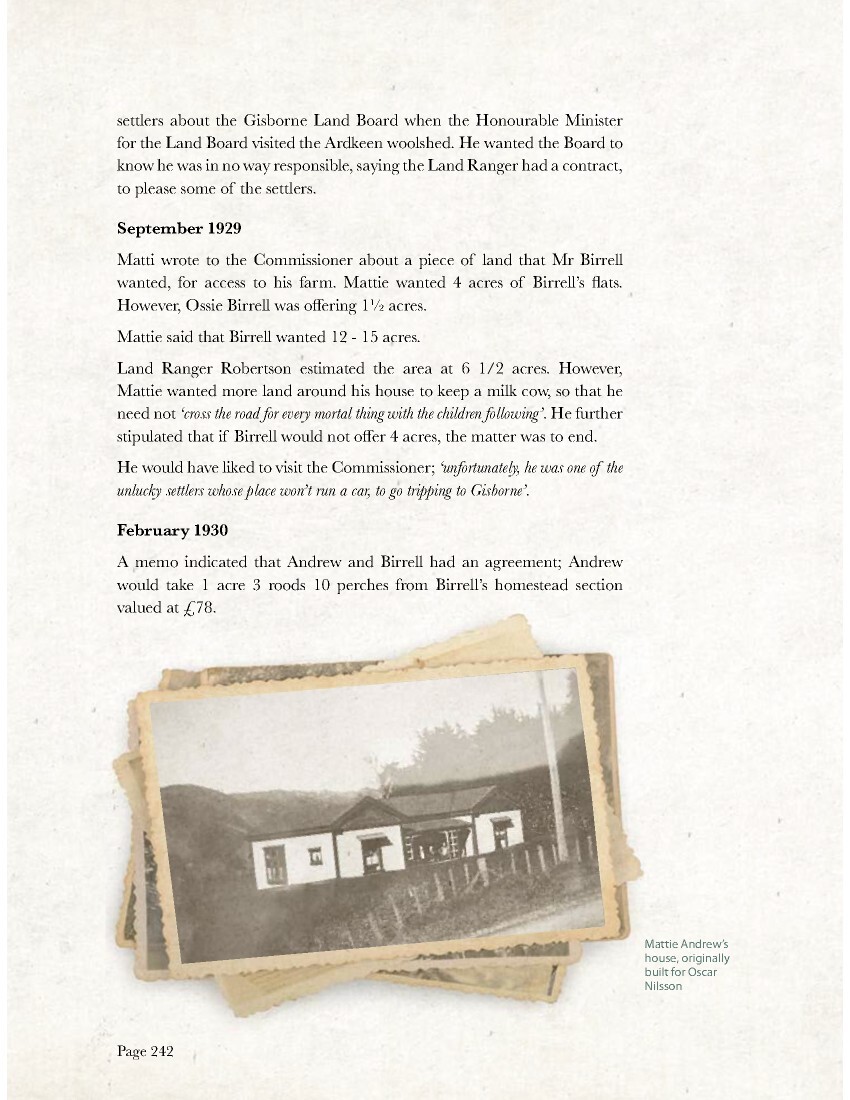
Page 243
August 1931
Mattie advised the Commissioner he had spent £400 adding three rooms to his house.
September 1931
Land Board Minute: Field Inspector notes Mattie Andrew; a good farmer, the farm will pay its way with fair prices, is in first class order. He recommended postponement of arrears of rent for two years.
November 1931
Mattie wrote to the Commissioner, thanking the Board for postponing his rent saying he was sorry he could not say the same for other settlers. Writing;
“the man who slaves 14 hours a day, is told by other settlers that one is a fool, to pay rent and rates during these hard times is of little encouragement for the trier.”
“The sooner one or two who try to rule the settlement, receive a severe check the better for everyone concerned. Some are quibbling about the £3 charge for the woolshed.”
Mattie in conclusion wanted the woolshed settled, offering that the current rental is a gift, but he objected to paying, when other settlers did not.
July 1931
Mattie wrote asking for a postponement of rent, saying he was only one of two settlers on Ardkeen who was up-to-date, including his council rates.
June 1933 Mattie wrote to the Commissioner advising he was unable to pay the postponed rent, due next July, and asked for a further three years’ postponement. He reminded the Commissioner that his record on Ardkeen was a good one compared with others. The Commissioner advised Mattie the matter was in hand.
July 1933
Mattie wrote that because of the low prices for livestock over the past two years, he was at the end of his resources, and if things did not improve he could not carry on, noting that his rent alone exceeded the total income for the year.

Page 244
October 1933
A Land Board memo noted:
The property, apart from 196 acres, being part of the Nicol block 14s that is detached by half a mile from the main farm, adjoins the Waikaremoana Wairoa highway, and is adjacent to the Ardkeen woolshed.
The property is easy to work with the homestead being on the property.
This man’s health is ‘broken down’. In the past, he could pay his way by doing the work himself. He milked a herd of cows without assistance.
Now requires labour.
We recommend reducing the annual rental to £250, based on 5%. Remit £73.19 of postponed rent.
The committee recommends offering a decrease in rent, and remission, comparative with other cases on the settlement. No top dressing;
Fences 22 chains £30
Allowance £27
Labour £30
Scrub cutting £5
Car £12
Compared with his neighbour Birrell; Manure £15
Fences 69 chain £51
Scrub cutting £60
Allowance £25
Car £26
Credit offered in Birrell’s case for butterfat from 10 cows; Andrew has revenue from three cows.
The budgets are inconsistent; unless a voluntary settlement is agreed, one or the other should revisit their budget before sending to the Commissioner.
If the committee recommendations are not acceptable to Andrew, and on further consideration is not equitable to allow additional expenditure, thus reducing the surplus revenue, there will be no objection.
Agree to a rental of slightly less than £250.
I suggest that the ratio of expenditure to revenue in Andrew’s case is £65.40 against £68.90 for Birrell. The Under-Secretary
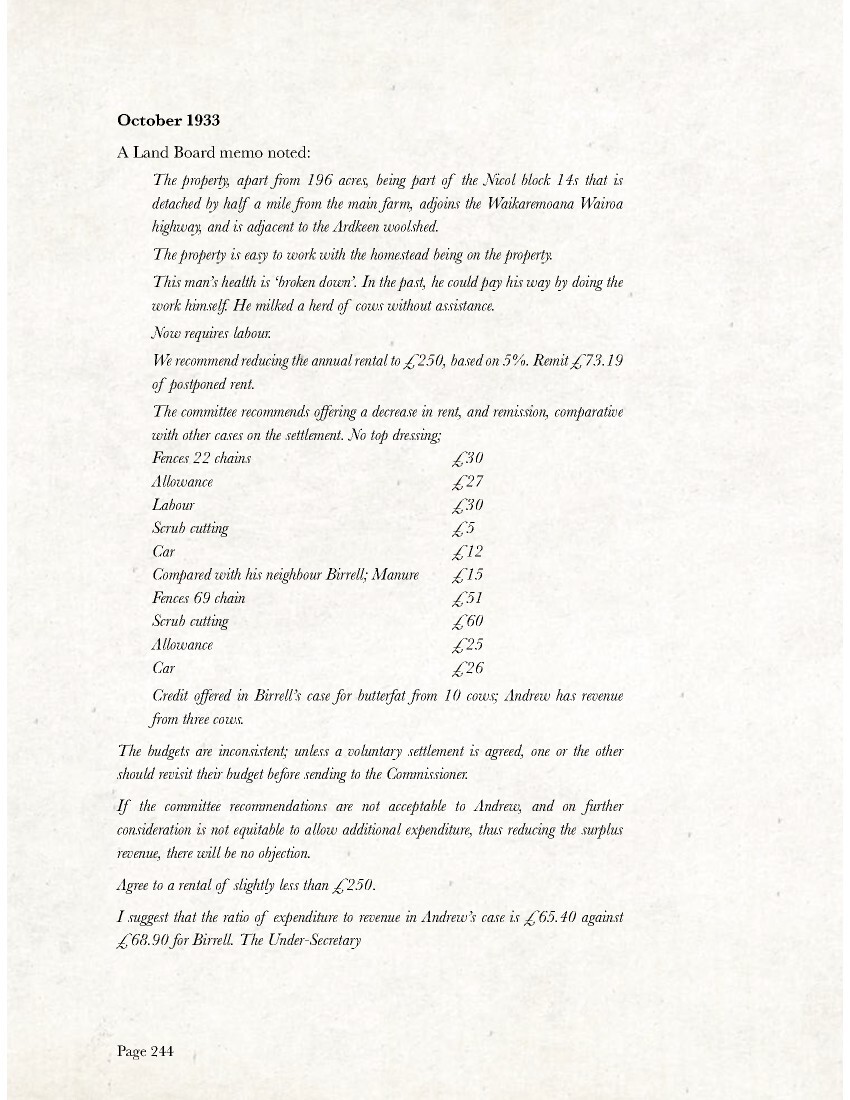
Page 246
OSWALD GEORGE BIRRELL (OSSIE)
MILITARY SUMMARY
Date of Birth: 24 November 1892 65
Place of Birth: Gisborne
Parents: Robert McDuff and Jessie Birrell née Oswald
Next of Kin: Robert McDuff Birrell, father, Gisborne c/o T A Coleman Gisborne
Last NZ Address: Tahunga, Gisborne
Marital Status: Single – Married 1926 Louisa Keziah Helen Goldstone
Occupation: Self-employed sheep farmer
Regimental No: 11/974
Rank: Trooper/2nd Lieutenant
Death: 31 March 1976
Buried: Wairoa Cemetery
Awards: 1914-15 Star, British War Medal, Victory Medal Other Service: Gisborne Senior Cadets and WW2 2/20B/3 Home Guard
1914
15 Dec: Enlisted at Gisborne
17 Dec: Arrived at Trentham Camp, Wellington
1915
14 Feb: Departed Wellington
26 Mar: Arrived at Egypt
14 Jul: Joined unit – ANZAC Cove
24 Aug: Wounded in action – gunshot wound – left arm and back
65 He also gives his date of birth as 25 Dec 1893, 28 Nov 1892, 28 Nov 1894 and 24 Nov 1896
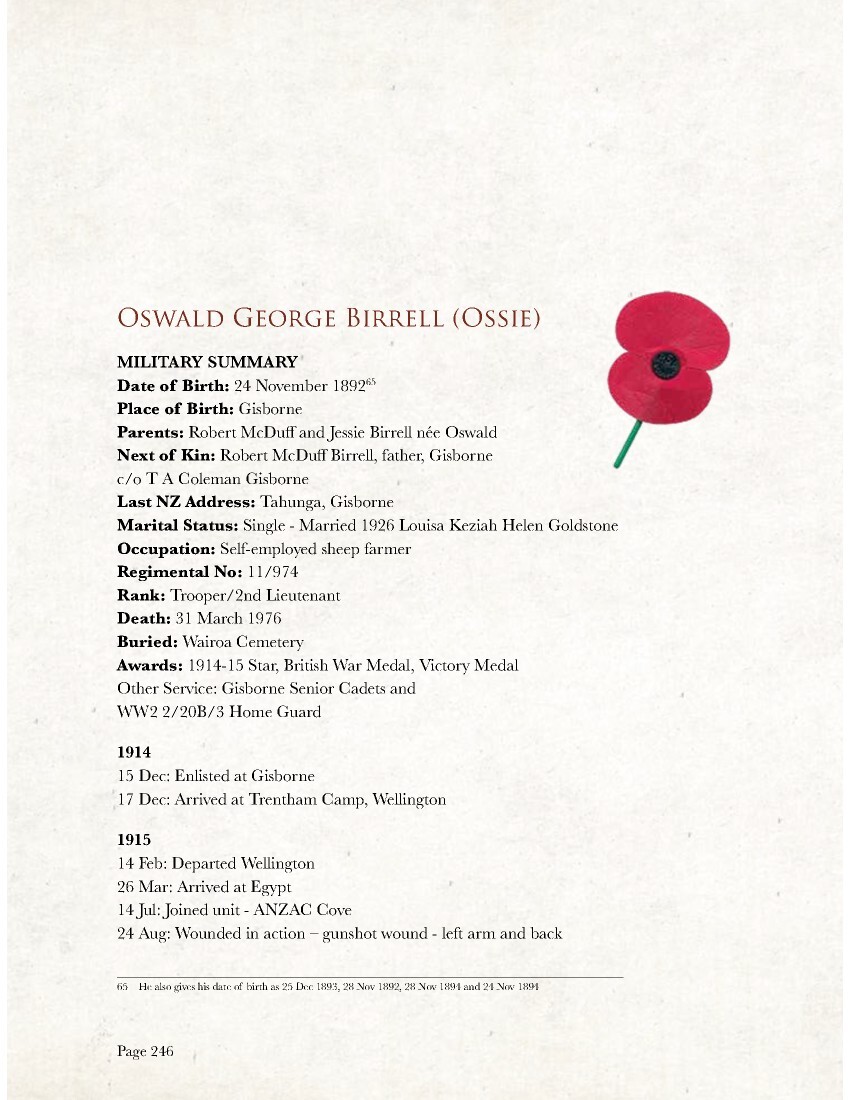
Page 247
28 Aug: Admitted Hospital Ship HMHS Gascon to Alexandria transferred to NZ General Hospital Cairo
20 Sep: Transferred to Lady Godley’s Convalescent Hospital, Zeitoun, Cairo
10 Nov: Sick – now recovered – leaving Alexandria for the Front
15 Dec: Evacuated Gallipoli
25 Dec: Disembarked Alexandria from TS Hororata
1916
23 Jan: Left for Suez Canal from Zeitoun
15 Mar: Promoted Corporal:
04 Aug: Lance Sergeant and on 28 Nov: Temporary Sergeant
1917
09 Jan: Promoted Sergeant – El Arish
21 Jun: Nominated by General Officer Commanding NZ Expeditionary Force (Sir Alexander Godley) for commission in Egypt
05 Aug: Completed promotion course – promoted to 2nd Lieutenant.
27 Oct: Returned to NZ to Training Regiment
1918
02 Jan: Arrived NZ on board SS Riverina from Australia
05 Feb: Reported for duty – Training Regiment
10 Oct: Embarked Wellington for Suez – NZ Mounted Rifles 40th Reinforcements
22 Nov: Disembarked Suez ex HMAT17 Malta and marched into Isolation Camp, Moascar
1919
07 Jan: Marched out from NZ Mounted Rifles Training Regiment to Wellington Mounted Rifles
26 Jan: Detached to Jewish Agricultural College, Jaffa where he remained until 11 May
05 Feb: Promoted to Lieutenant
26 Jun: Marched out to NZ Mounted Rifles Brigade – Ismailia
23 Jul: Marched out to Suez and embarked for NZ on S.S. Ellenga.
11 Sep: Disembarked NZ
Total Service: 4 years 285 days (including 3 years 295 days overseas)
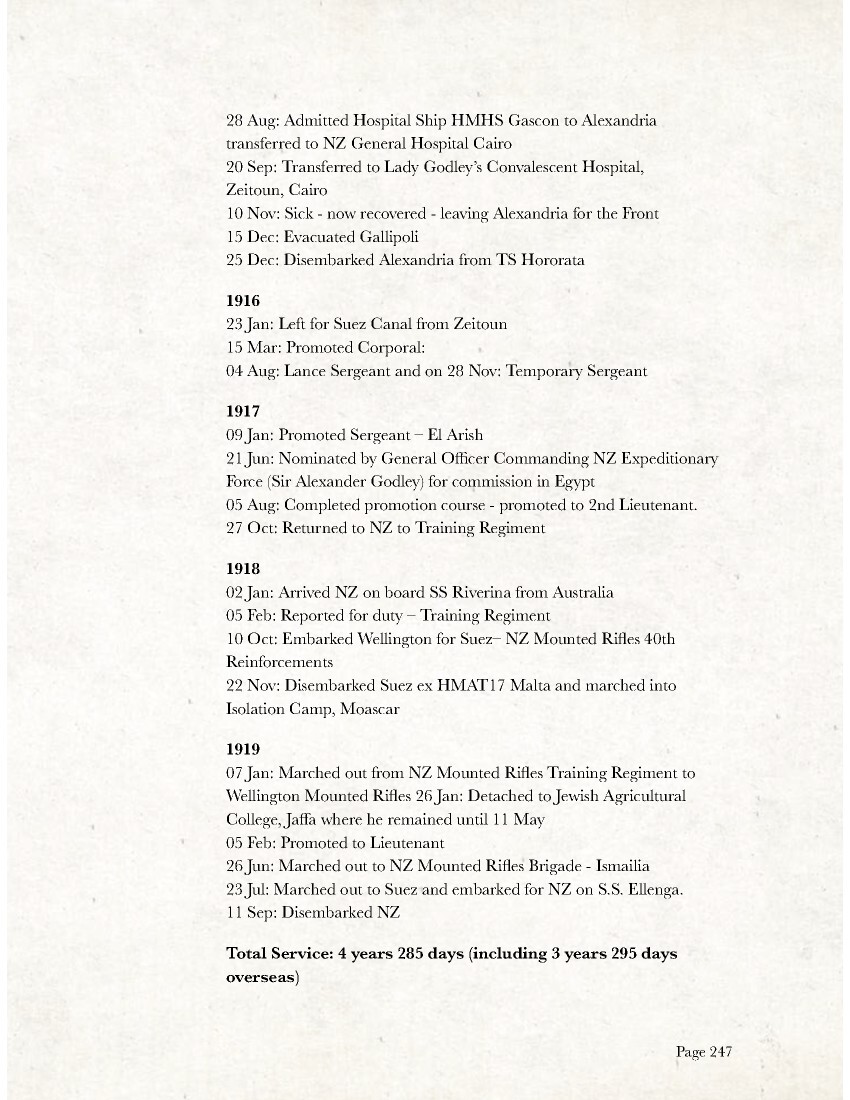
Page 248
Poverty Bay Herald, Volume XLI, Issue 13564,
16 December 1914, Page 3
GISBORNE’S RESPONSE. INFANTRY SECTION LEAVING TO-NIGHT.
The local Defence authorities have had no difficulty in obtaining sufficient men to make up the number of reinforcements required from Gisborne. In fact, their difficulty has been in the opposite direction. There are so many men offering, all of splendid physique, that the officers have had difficulty in making their selections. Tonight 54 infantry will leave for South.
These men fall in at the Garrison Hall at 6.30, and any not there at that hour will be replaced, as there are plenty of others waiting to go. Headed by the City Band the men will march to the wharf and go on board the Tuatea and the Mayor will say a few words of farewell to them on behalf of the citizens. The names of this draft are as follows: O. G. Birrell, Tahunga, 18 months Senior Cadets.
Poverty Bay Herald, Volume XLII, Issue 13787,
13 September 1915, Page 4
HOSPITAL AND PROGRESS REPORTS.
Both O. G. and R. Birrell are at the front, the former being a trooper and the latter a private, in the third reinforcements. The cable does not state which of the two has been wounded. They are sons of Mr and Mrs R. M. Birrell, now of Auckland, but old Gisborne residents and they were working at Tahunga when they enlisted.
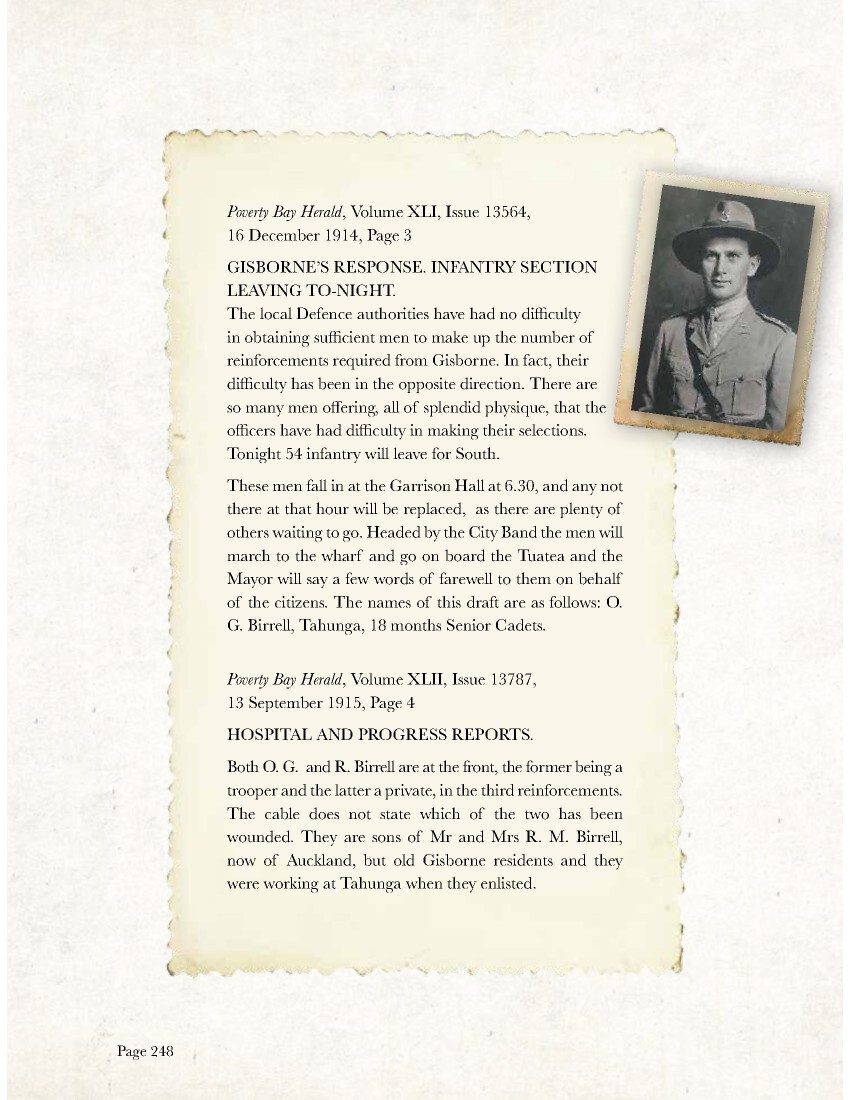
Page 249
Poverty Bay Herald, Volume XLII, Issue 13827,
29 October 1915, Page 2
A dozen more recruits were registered yesterday at the recruiting depot, under Mr R. M. Birrell, making 85 since the office was opened last Saturday afternoon. There are still a number of these men to be medically examined. Of those who have been before the doctor, about 50 per cent have been passed as medically fit.
Poverty Bay Herald, Volume XLIV, Issue 14452,
12 November 1917, Page 2
Mr. R. McDuff Birrell has been advised that his youngest son, Second Lieut. Oswald G. Birrell, is returning to New Zealand on duty. Leaving Gisborne as a trooper in the Mounted with the Third Reinforcements, Lieut. Birrell has seen no less than three years of active service, and advice of his promotion from the ranks in the field will doubtless be received with pleasure by his many local friends. Lieut. Birrell was wounded at Gallipoli and has served with the Mounted through the Egyptian Campaign until the recent fighting.
Poverty Bay Herald, Volume XLV, Issue 14497,
8 January 1918, Page 2
Arahura, S.S. (8.5 am), 1596 tons, Dryden from Napier. Passengers: Birrell (2), Lieut. Birrell.
[https:]//paperspast.natlib.govt.nz
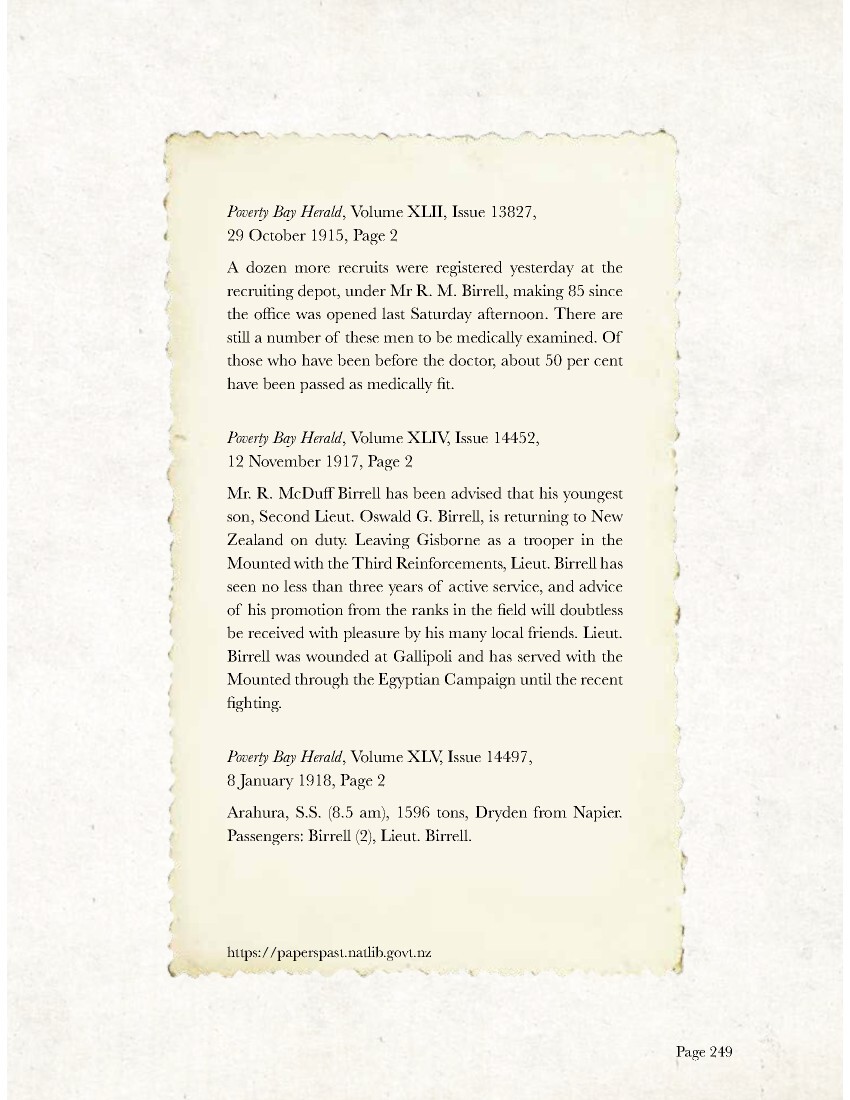
Page 250
LAND BALLOT
Ardkeen Section 18s, 647 acres
Ballot awarded to: Oswald Birrell
Capital value £5,690 with an annual rent £256.10
Livestock purchased from the Government at time of possession:
900 hoggets
230 two-tooth to five-year ewes
67 breeding cows
10 dry cows
3 bulls
7 weaners
3 horses
To be eligible to enter the ballot each applicant required a deposit, surety or assets of £800 – £1,000; Ossie had £735 cash, one horse, saddle, bridal and four dogs, valued at £60.
He had five years’ experience as a shepherd.
September 1921
Ossie received a £500 grant for buildings, fencing and other improvements.
The homestead section of 35 acres was adjacent but separated from the main section by the Frasertown – Waikaremoana Road, however because of a steep face there was no accessible road frontage to two thirds of the farm.
The Ardkeen Station’s ten-shearing-stand woolshed and sheep yards were across the road from the homestead.
Section 18s was divided by a gorge with 380 acres to the west and 270 acres to the east. There was a stock route extending along Ossie’s eastern boundary with Mahanga Station. The farm rose from 200 feet to 930 feet above sea-level with steep sidings, and easy terraces, pastured in native grasses with pockets of native bush in the steep gullies with many scattered Totara logs in the gullies.
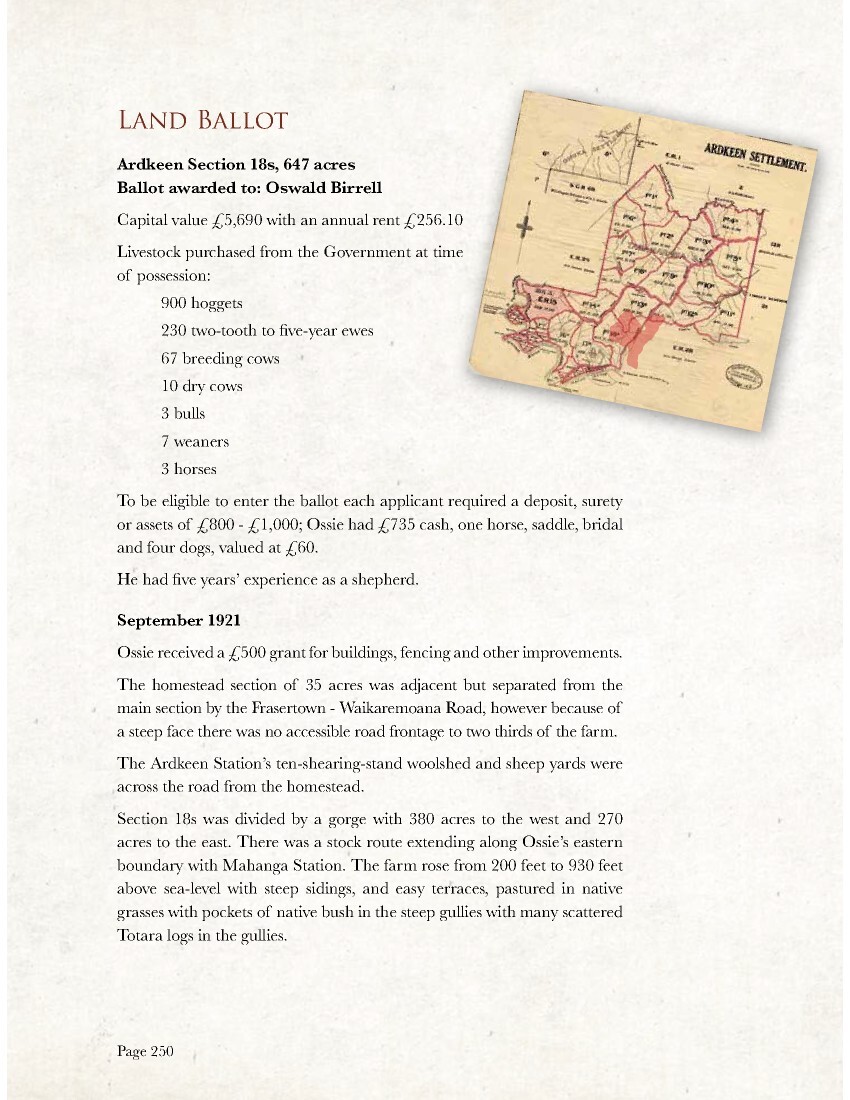
Page 251
25 June 1921
A Statutory Declaration signed by Ossie states:
£1,500 was expended on livestock
£79 on fencing and ploughing
£88 personal expenditure and furniture
£150 shearing and crutching
£45 dipping expenses
£28 for implements.
Livestock:
500 ewes
300 wethers
40 lambs
63 cattle
Estimated income: £100
August 1921
Ossie wrote to the Commissioner about payment for wire to erect 84 chains of fence along the stock route.
It was not until 1930 that a 12-foot-wide cart track was open to the present junction with Preston Road. Up to this time the settlers: Bill Carson, Bob Preston, Jack Owen, Bill Mackay, Jim Tolme, Paddy O’Kane, Meagher brothers Frank and Jim and Dave Robertson used a bridal track for access to their farms. The stock route was a steep track along the boundary with Mahanga Station. This was a two-and- a-half-mile climb to 1,100 feet with nowhere to rest livestock, dogs or men and without water. The track was the main route to and from the Woolshed and dip. When Ardkeen Settlement was open for selection, it was thought that the stock track would not require fencing. However, this did not apply to section that fronted onto the main road through which passed most of the livestock on the settlement. To protect himself Ossie had to erect one and a half miles of boundary fence.
Before the stock route was fenced, it required two or three men to clear Ossie’s stock from the route and drove the mobs through. This often resulted in Ossie’s stock getting picked up and scattered all over the settlement. Added to this, Ossie was losing grazing and his stock became distressed with the drovers’ dogs pushing his sheep down the gullies to clear the way for the passing mobs. Weak and distressed sheep were often left behind, the settlers knowing they could collect them up later at the woodshed.
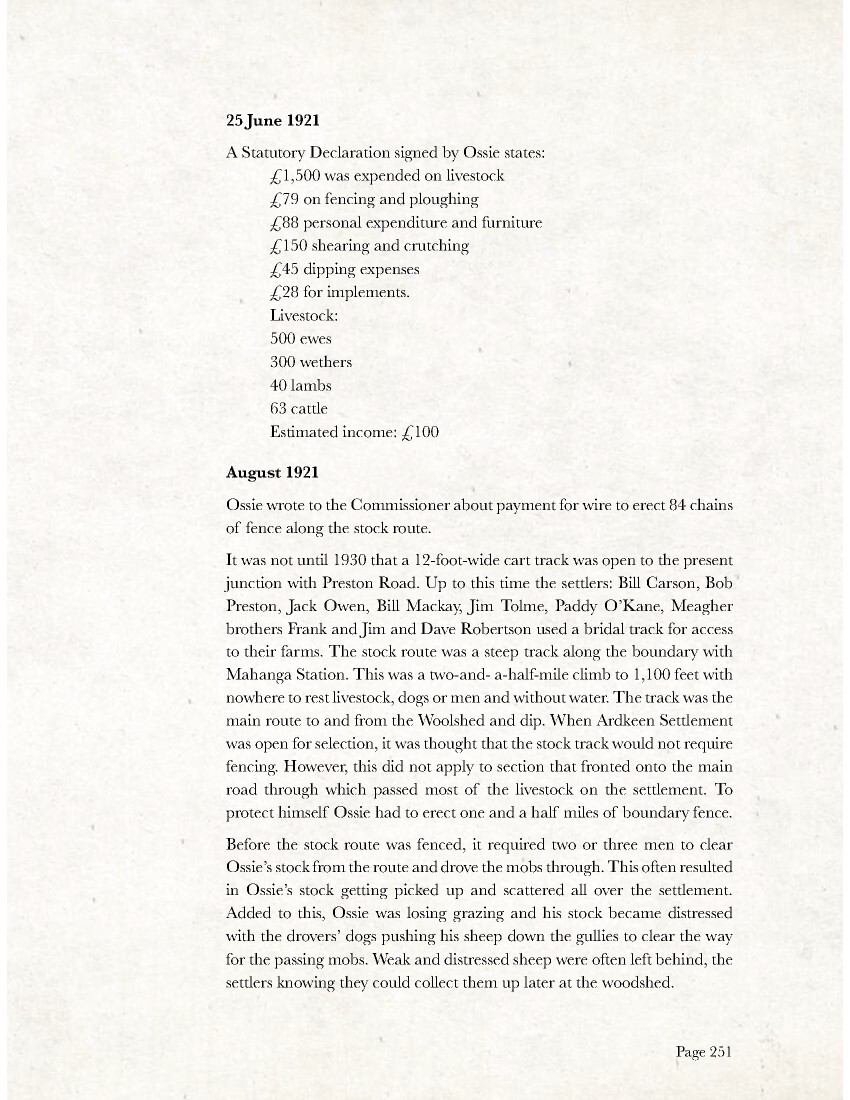
Page 252
Field Ranger Robertson recommend assistance be granted to Ossie Birrell for fencing the stock track, because it would benefit all the settlers, saving time and labour.
May 1923
Ossie wrote to the Chairman, Gisborne Land Board asking for an advance to paint the homestead, adding that one of the double chimneys had been damaged with the last earthquake some months ago, and needed repairing from the roof up, plus two new chimney pots, while the roof had leaks and spouting issues. Johansson’s estimated the cost of painting the house at £53, plus repairs to the chimneys £8, the plumbing £3.
The Commissioner’s reply pointed out Ossie had paid no rent to date and that he had rent due January 1923 totalling £850.09.4.
In addition there was £210.13.1 of rent postponed until January 1924.
“So at present you are owing over £1,000 and have a further payment of £210.13.1 falling due on 1 July. Terms of both your lease and mortgage require you, the settler to keep buildings in good order and repair.”
June 1923
Ossie sent a statement from Hawke’s Bay Farmers Co-op.
Statement of position:
725 ewes: £1
25 wethers: 15/-
16 hoggets: 16/-
1 dairy cow: £10
37 breeding cows: £3
10 bullocks: £5.10
2 bulls: £5.10
3 horses: £6.10
Plant: £5
Total: £1,147.09
In return Birrell received a letter from the Department of Lands and Survey advising him the Land Board had discussed the rent he owed, saying the department had run out of patience.

Page 253
Despite Ossie’s application for a revaluation, this had no bearing on the matter. However, the Board would accept a payment of 25% of the total outstanding if it was paid before the next meeting. Failing payment, the Board would consider the forfeiture of the lease.
July 1923
Ossie wrote to the Commissioner that he was not indebted to Hawke’s Bay Farmers Co-op, advising he had been working on an overdraft with a limit of £500 at the Bank of New Zealand; his father provided a personal guarantee. The farm was described as having some excellent land, however it was very light in parts, especially at the southern end. Noting the tenant as a hard worker; it was feared he has a ‘hard row to hoe’, with his chances of pulling through as ‘not very bright.’
Ossie grumbled that owing to his section having unnecessary buildings, and such a small acreage with limited livestock-carrying capacity, annual returns would not cover expenditure and provide a living. The cost of erecting 130 chains of subdivision fencing was disproportionately high.
Then there was the isolation of the district, and the charges for handling produce further reducing returns.
May 1924
Ossie wrote to the Commissioner seeking financial assistance to complete the remaining 50 chains of the 140-chain fence, enclosing the stock route. He emphasised the need to complete the fence before stock began moving forward for shearing and dipping and reminded the Commissioner of the difficulty of stressed sheep that had been without water and feed for days up the three-mile 1,000 foot climb through his farm.
Ossie’s homestead section had required a lot of new fencing in addition to the 140 chains of stock route, and 76 chains of boundary fence.
October 1924
Mr Birrell had a lucky escape last night when his house caught alight.
The Ardkeen homestead was destroyed by fire at midnight. The house was described as a fine, substantial dwelling of nine rooms.
The previous home of Frank O’Neill and latterly Magnus Nilsson.
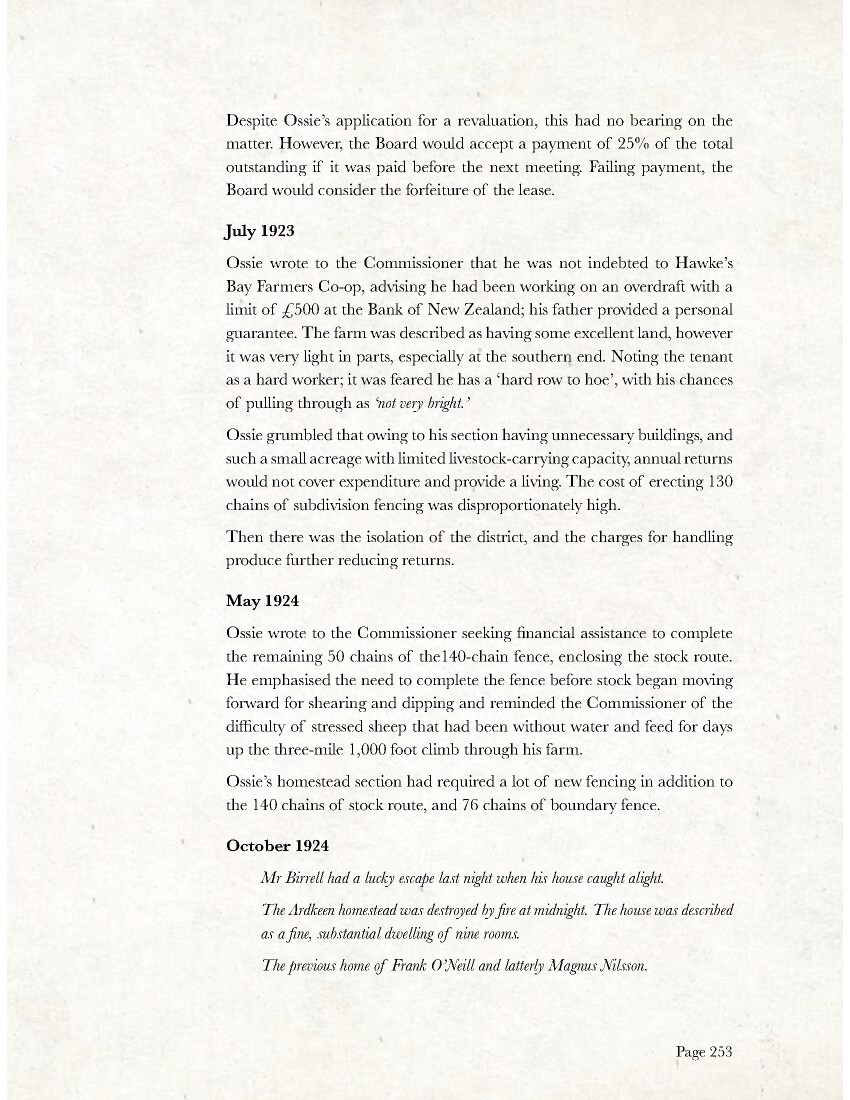
Page 254
Ossie had been living alone in the house, his bedroom being in the front of the house.
About midnight, Mr Birrell was woken by suffocating smoke; he found the whole house ablaze and had only just time to get out. He was in his pyjamas. He managed to save a few small pieces of furniture from one room. The men’s whare some 30 yards away, was for a time endangered, however, survived.
Neighbours were awoken by the noise but the flames were too great to allow any salvage. 66
Ossie received £1,070 insurance.
July 1925
Ossie sought permission to turn the old Ardkeen two-storey stable into a hay barn. He had seven acres of Lucerne hay to store.
August 1925
Ossie wrote to the Commissioner asking for £300 to pay Mr J. Webster the builder of his new house. Insurance received for dwelling was paid, and £134.08 credited to Ossie’s current account.
April 1927
Ossie again reminded the Commissioner about 50 chains of fencing required to complete the stock route. The Commissioner said he would take the matter up with headquarters in Wellington.
January 1928
The Board noted that Birrell deserved to be treated in the same way as those who had had their rent further postponed, noting Ossie was one of the best settlers on Ardkeen and gave no trouble.
The Board recommended the honourable ministers allow £50 of the rent due July 1927 be postponed. It was noted that Mr Birrell was prepared to pay the £50, though it would be with difficulty.
The Commissioner asked for an immediate response because Mr Birrell wished to retain the rebate.
66 Papers.past [https:]//paperspast.natlib.govt.nz/newspaper
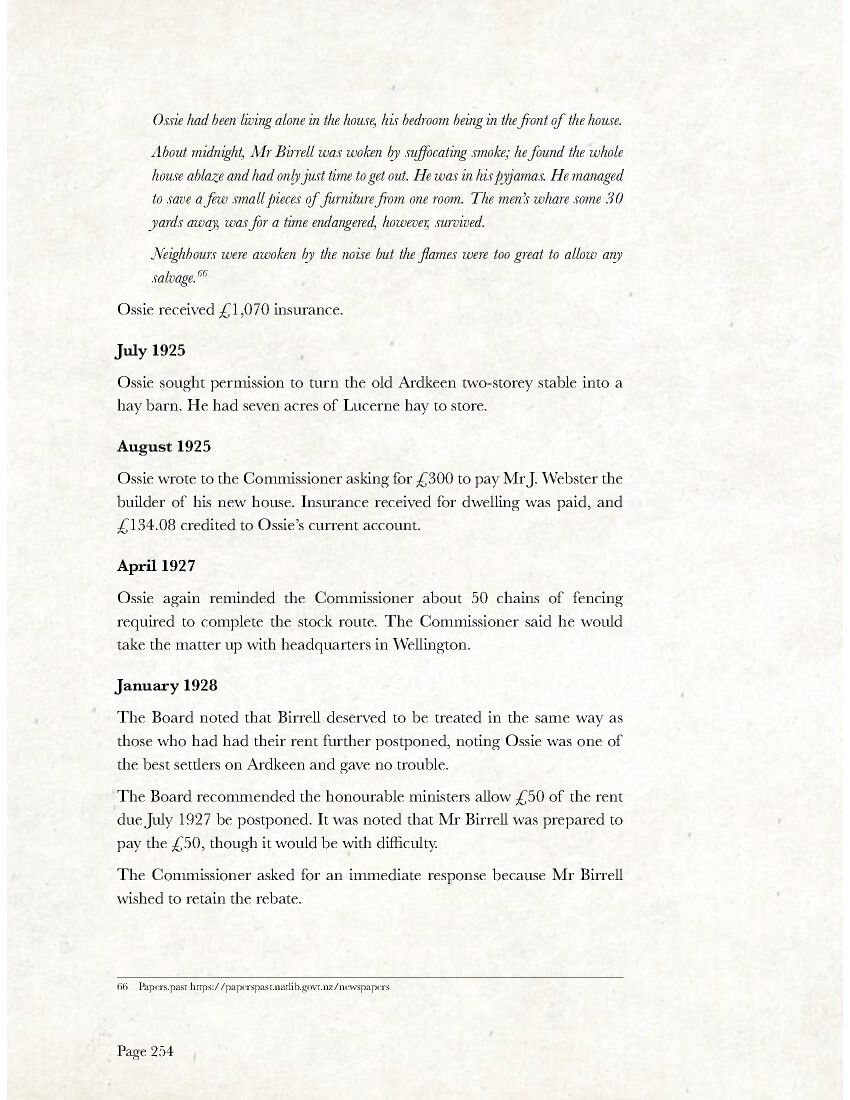
Page 256
Hawke’s Bay settlers, in contrast to their complaints during the settlement phase, consistently praised the treatment they had received from Marsh and the Land Board. 67
January 1928
Ossie advised the Commissioner he had forwarded one half year’s rent and would ask Dalgety & Co-op to forward the balance of £38.06 due on 27 July, the next day. He also asked the Dominion Revaluation Board to make his farm a payable proposition.
April 1928
Ossie wrote to the Chairman of the Dominion Revaluation Board saying the valuer only rode along the top boundary, missing the waste ground and the access issue completely. Pointing out the only way into the western side of a gorge, representing more than half the farm was through Mr Andrew’s farm and the impossibility of crossing livestock over the gorge. Furthermore, his farm had been at the front of the part of the original station since 1878, and subsequently more heavily grazed now requiring cattle to keep it in order. But with the gorge being the death trap it was made management of the country difficult. In addition, he had the added cost of having the stock route along the entire eastern boundary.
December 1928
Ossie wrote to the Under-Secretary of Lands on behalf of the settlers who were awaiting results of the revaluation, asking why nothing further had been heard. Now there was the prospect of extra land being available. Noting the rental on the land available for reallocation was set at pre-existing values; and asking if the Land Board had not factored in the cost of additional fencing Ossie was to be allotted Lot 3, 340 acres of Section 10s, the ‘McKay Block’. Eighty chains of new boundary fence were required, however an adjusted plan indicated another 90 chains of boundary fence was needed, and Birrell told the Commissioner the cost of this fencing will amount to 10 shillings per acre, yet values remained the same, which made for expensive land.
67 Gould, A. N. (1992) Proof of Gratitude, p. 238.
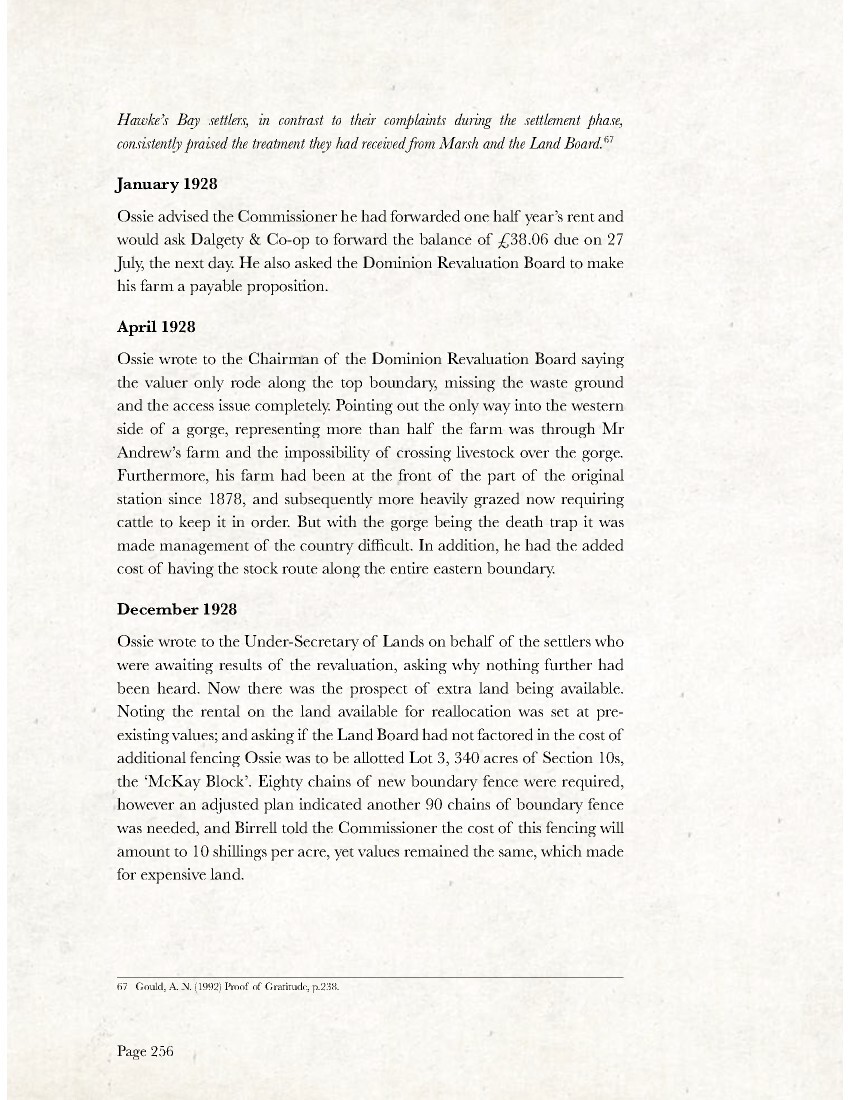
Page 257
The Crown Land Ranger told Ossie the cost of fencing was not a consideration when re-allotting sections, and suggested he delay his decision before deciding. Ossie suggested that Mr Rogers, a practical fellow, look into the best way to separate the McKay Block.
Ossie held little hope the Board would alter its decision, pointing out the land had deteriorated since Bill McKay had left Ardkeen.
Ossie needed the area but, carrying barely one sheep to the acre, the proposition could become a liability.
A letter to the Under-Secretary of Lands, Wellington indicated that Mr Andrew and Mr Birrell had agreed to an exchange.
Mr Andrew’s house stood on a quarter-acre section on the opposite side of the Waikaremoana Road to his farm. Mr Birrell agreed to exchange one acre of the flat paddock adjoining the Andrew house section at a value of £30 for nine acres of partly bush-clad, steep, hillside, that would provide road access to 400 acres of Ossie’s farm at a value of £80.
March 1930
Ossie wrote to the Commissioner he thought the matter was finalised, however now Andrews wanted the whole of his paddock adjoining his house. He explained that when the Crown Lands Ranger was organising the re-allotment, all the forfeited sections on Ardkeen were discussed with Andrew and he was promised compensation for ceding the land.
Ranger Robertson told Ossie that Andrew would also get Bill McKay’s flats, plus a good portion of the hill country from Nicol’s farm 14s. However, Andrew was insistent on having the two acres; Birrell agreed to get the matter finalised, now Andrew[s] wanted six and half acres of his flats.
“Can you induce Andrew to the exchange as it stood? If not, how about I keep all my homestead land as it is, and I pay Andrew £1 per acre for the 9 1/2 acres. Alternatively he can have the equivalent area of my hill country at any reasonable place along our boundary.”
Ossie apologised to the Commissioner that such a small matter had caused so much trouble but, without legal access to more than half his farm, the small corner required would not be missed by Mr Andrew.
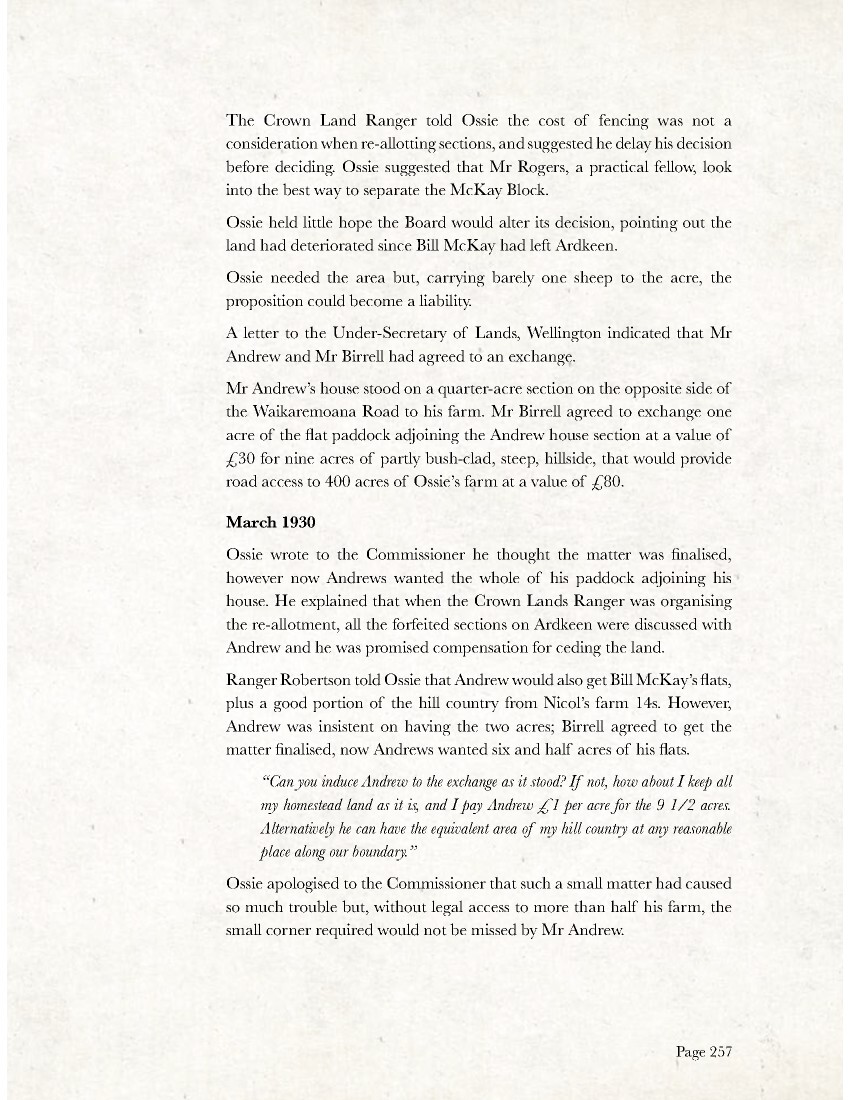
Page 258
Ossie’s flat section along the Waiau River was described in March 1930 as:
30.5 acres, practically all flat in good English and native grasses with the exception of about 2 to 3 acres of plantation and buildings. Varying from light black loam or pumice to river silt. Approximately 10 acres were liable to flooding, with good water and 20 acres ploughable.
Lot 3 of 10s: ‘McKay Block’ was described as:
Easy to medium, hill country with mostly native grasses, light scrub and fern, with a weak, light coating of black loam on pumice, to medium quality clay on papa formation. No noxious weeds, climate good.
Standard flock
Value of stock and chattels, reasonable.
Buildings in good order, fencing medium, water supply sufficient.
Future development should be done from revenue. Man: Dependable competent; applying good husbandry.
Health poor; three boys, two girls ranging from one year to eight years of age. Wife in hospital
Value of services enjoyed by applicant:
Living accommodation: £39
Meat, poultry, dairy products: £26
Other farm products: £5
Total: £70
Applicant’s situation is stressed because of slump conditions and exorbitant rent. Holds a temporary lease over of 340 acres, formerly part of Section 10s. Works both sections together as an economic unit.
May 1930
Ossie wrote to the Commissioner about the exchange of land with Andrew. He reported he had discussed the matter with Andrew without a result.
Andrew said he understood “negotiations were in train whereby Mr Clifton was ceding to Mr Andrew 28 acres of section 14s. This piece of land was originally intended to compensate Mr Andrew for the land Ossie required. At present Mr Andrew appears to be scoring both ways”.
Ossie wrote to the Commissioner the following week, after having an amicable discussion with Andrew about the exchange and concluded there was no hope of an exchange unless the Commissioner exercised his authority.
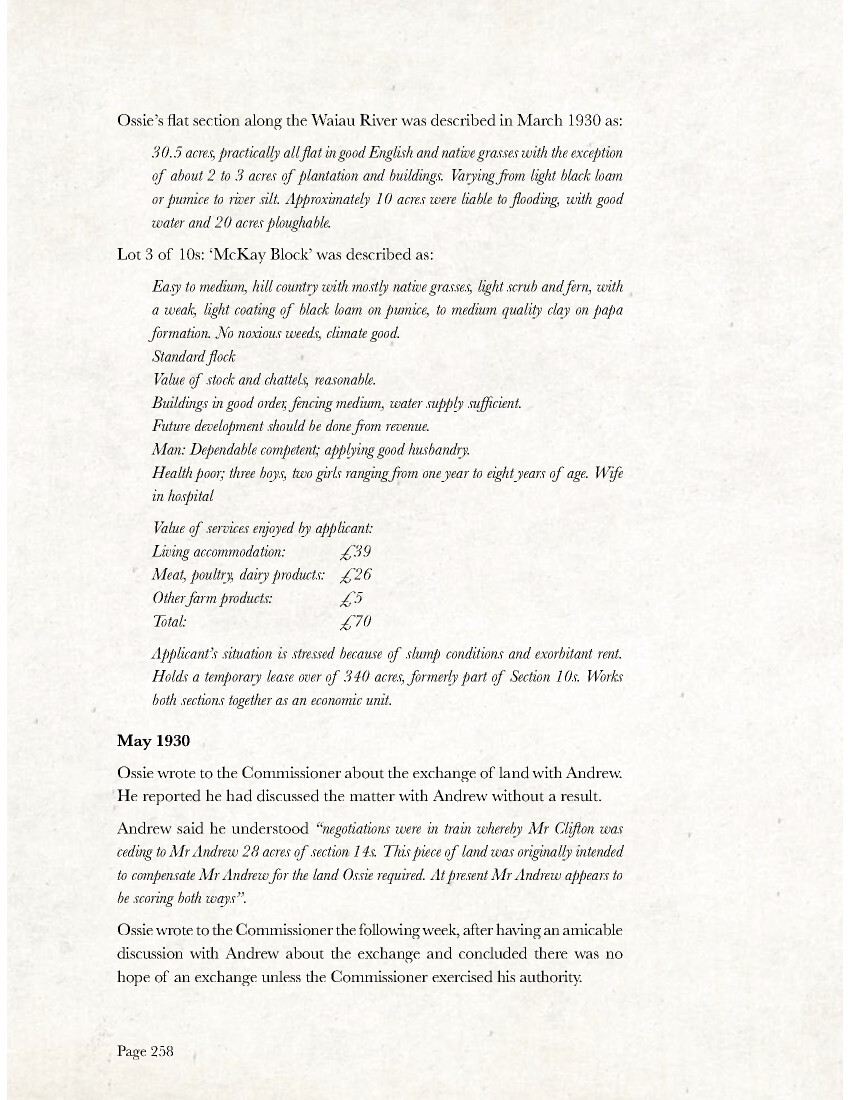
Page 259
June 1930
The Commissioner sent a memorandum acknowledging receipt of Ossie’s letter saying he had nothing to add, pointing out that if Andrew was not prepared to entertain Ossie’s request, the matter must end. He advised that Ossie may apply for a graded riding / droving track through Andrew’s property but as the matter had previously come before the Board, it was unlikely to result in a favourable outcome for Ossie.
June 1930
Ossie again met with the Land Board Ranger about his access. Ossie explained his farm frontage was an 80-foot papa rock face, up from the road and that Ranger Mr Robertson had got Andrew to accept two acres in exchange from Birrell however, when the surveyors arrived he demanded 6½ acres
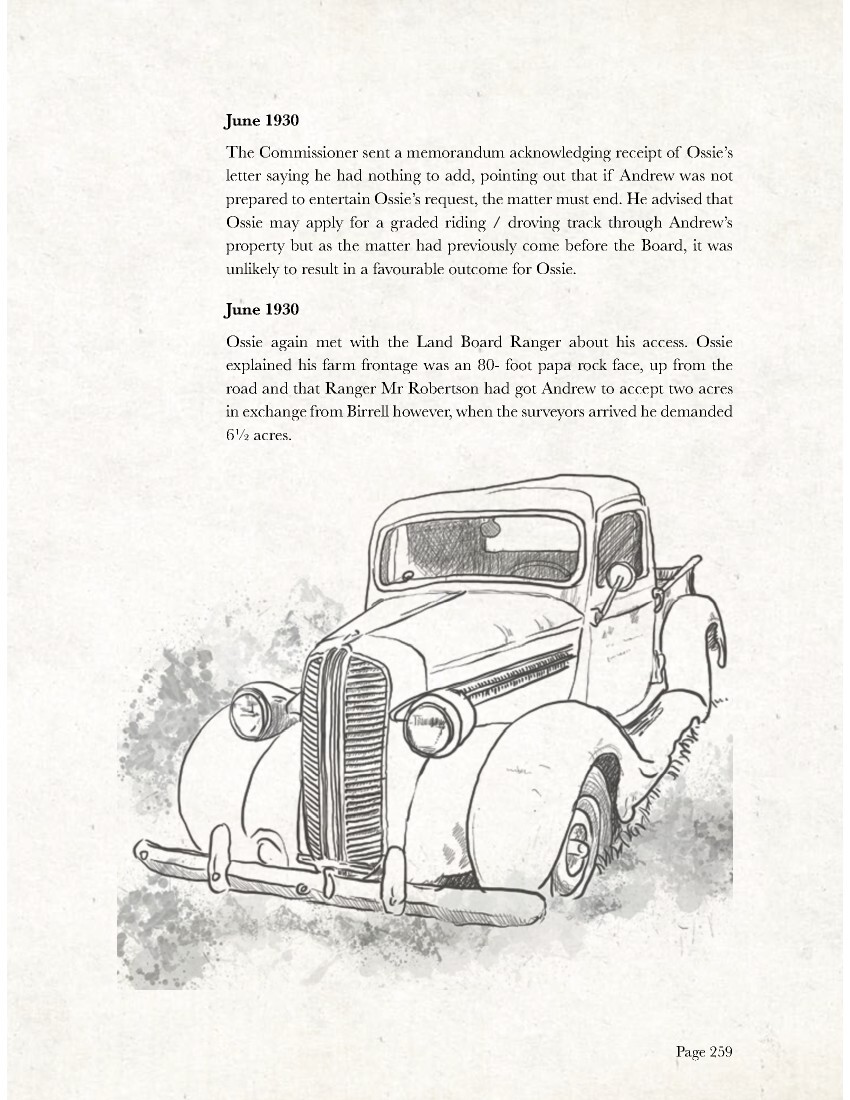
Page 260
Mr Birrell had been advised nothing further could be done about the matter, but the Commissioner would endeavour to speak with Andrew at the first available opportunity.
July 1930
Ossie wrote to the Receiver of the Land Revenue seeking compensation for land taken for the Ardkeen Road.
September 1930
Ossie wrote to the Commissioner Crown Lands about compensation for his work building 60 chains of road fence, saying he was eager to complete the fence before stock began moving forward for shearing.
August 1937
Report of Special Valuation Committee:
The department treated the property as a whole, noting that Birrell would be on permanent tenure. Birrell stated that the farm was going back which was refuted by Mr Harrison.
Improvements; two miles of subdivision fencing needed. Holds 340 acres on temporary tenure; could be subdivided into at least three paddocks. Also requires sheep yards and a hut; estimate £30.
Birrell has invested £700 plus £1,100 from his father.
Mr Birrell produced the statement of facts with a budget and evaluation of the property. This budget shows £819-02-9 gross if capitalised at 5% would represent £265 rent.
Mr Birrell stated bad access increases running costs, because access to 400 acres was reliant on his neighbour Mr Andrew.
Section 10s reverted to the Crown and was subdivided into three Lots 1, 2 and 3, and disposed to:
Lot 1 to be allotted to J. Owen – C.V. £1,160
Lot 2 to be allotted to D. H. Robertson – C.V. £1,500
Lot 3 to be allotted to O. G. Birrell – C.V. £2,125
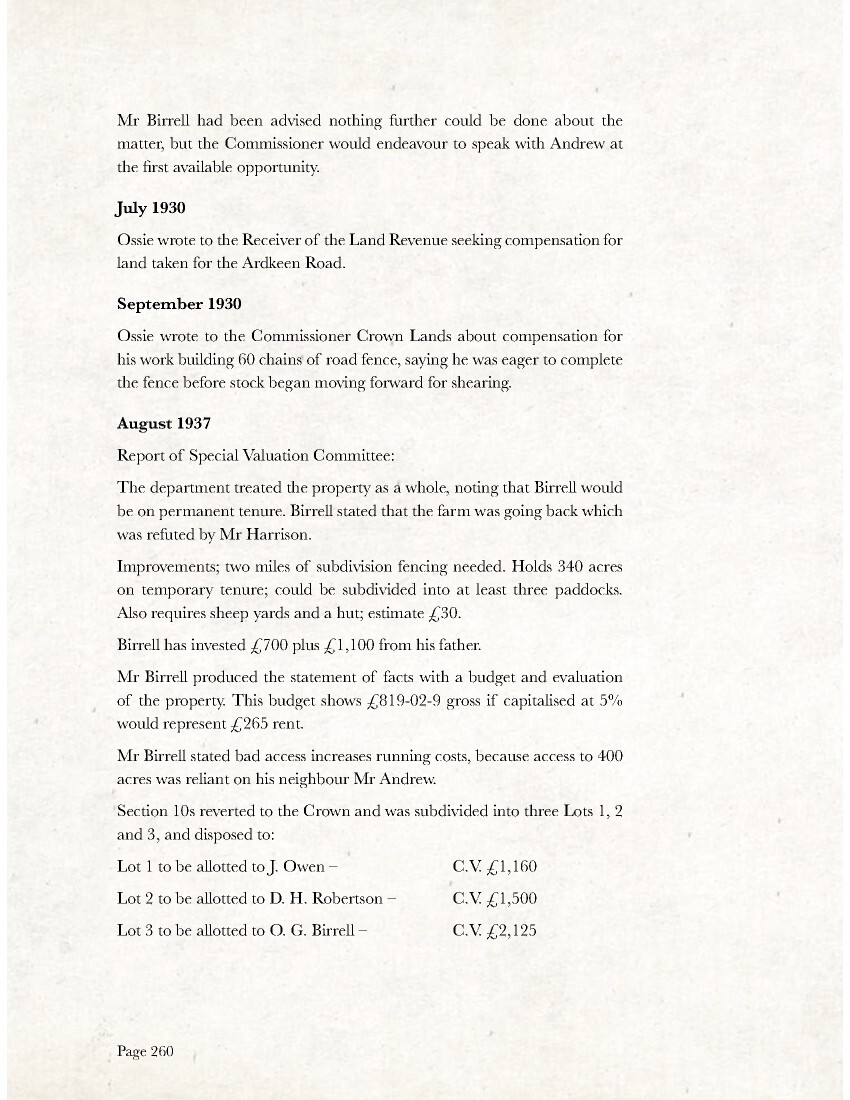
Page 261
Messrs. Owen and Robertson completed their deals but Mr Birrell would not; he considered the C.V. of £2,125 too high. He was granted a temporary tenancy.
The Adjustment Commission set the following rentals:
Lot 1: Owen: £17.10 per annum
Lot 2. Robertson: £18.6 per annum
Lot 3. Birrell: £28 per annum
The Special Valuation Committee reported that the land: Botton Block, held by Mr Birrell, was not economic and Lot 3, on temporary tenancy, should be amalgamated to make one economic unit.
March 1938
The Government valued lot 3 at £995. Rental at 5% equalled £49.15, however the Commission set the rent at £28 per annum. The department opposed this figure but the Court upheld the Commission’s determination. When this recommendation was received in head office, it was pointed out that approval of the Board’s recommendation would create an embarrassing precedent, should other Ardkeen settlers apply for revaluation. The process was investigated by the Central Revaluation Board, which decided that the settlers should retain the areas, on temporary tenancies, and the Commissioner of Crown Lands was instructed to see that the Crown’s improvements were maintained.
The Commissioner of Crown Lands was advised of the Central Revaluations Board’s decision.
On June 21, 1939. The following memorandum set out the Revaluation Board’s position.
Mr Chamberlain, Barrister and Solicitor, Wairoa, acting for Mr Birrell was in communication with Mr Cullen MP, Under-Secretary for Lands.
Photo caption – Allotment of McKay block

Page 262
21 December 1939
I acknowledge receipt of your memorandum of the 14th instant hereon and note the contents. I agree it is difficult for Mr Birrell to arrange finance to develop this section under the existing tenancy and would prefer a permanent lease.
Section 10 of the Land Laws Amendment act 1939 overcomes this case, the legislation has been enacted since the case was heard. I appreciate your suggestion of a revaluation being obtained. But I think a visit is unwarranted. There are three evaluations on record for the area. District Valuer Hamilton assessed the area as freehold at £995, this is a fair figure.
Section 10s was divided into three allotments by me; I have visited the Settlement on various occasions and am acquainted with quality of the land. The area for disposal to Mr Birrell is of a poor quality, the difference in existing values is justified. Field Inspector Tuke’s report dated April 1939 states the section is of poor to medium hill country, with native grasses, light scrub and fern. The present lease commencing July 1940. The Crown claimed clearing and grassing of the 340 acres at 30/- per acre.
I will write after the Land Board meeting.
J. H. Primrose
September 1945
Mattie Andrew agreed to exchange six acres of steep, bush-clad hillside, for an acre and a half of Ossie Birrell’s flats. This provided Ossie with access to a third of his farm.
Photo caption – Mr and Mrs Birrell

Page 263
RECENT HISTORY
In May 1955 Ossie sold his farm to Thomas John and June Davey. Thomas John Davey owned neighbouring Mahanga Station jointly with his brother Frances.
T. J. Davey’s Estate sold the whole of 18s plus pt 3 of 10s 985 acres to Chris and Anne Thompson in 1976.
In 1986 the Thompsons split the farm into three, selling the McKay Block Lot 3 of 10s to Rob Little and the original Birrell section 18s, to Neil Chapman.
In 2002 Neil sold the farm to Maurice and Annie Flood.
The Floods sold the Ardkeen woolshed and yards, about an acre to Valerie Andrew in 2004. Val cleared the site and built a house where she lives today.
The Floods sold the farm section 18s to Jason McConnachie in 2007 Jason sold to Alex and Sue Mackay in 2008.
In 2018 the McKays sold the farm of Section 18s to Martin Wolters and his partner Sonya Smith, the present owners at the time of writing.
The Thompsons sold the homestead of Section 18s to Tim (dec.) and Monica Wealleans in 1986. Monica sold to Jack Baty in 1996.
Jack sold to Robert and Jennifer Anderson in 1998. After Jennifer lost her husband, she sold the homestead Section of 18s to Alex and Sue Mackay in 2008 the then new owners of the farm Section 18s.
In 2018 Sue and Alex Mackay sold to Bevan and Sandy Fraser.
Dec 2020 Martin Wolter sold to Scott & Rebecca Morunga.
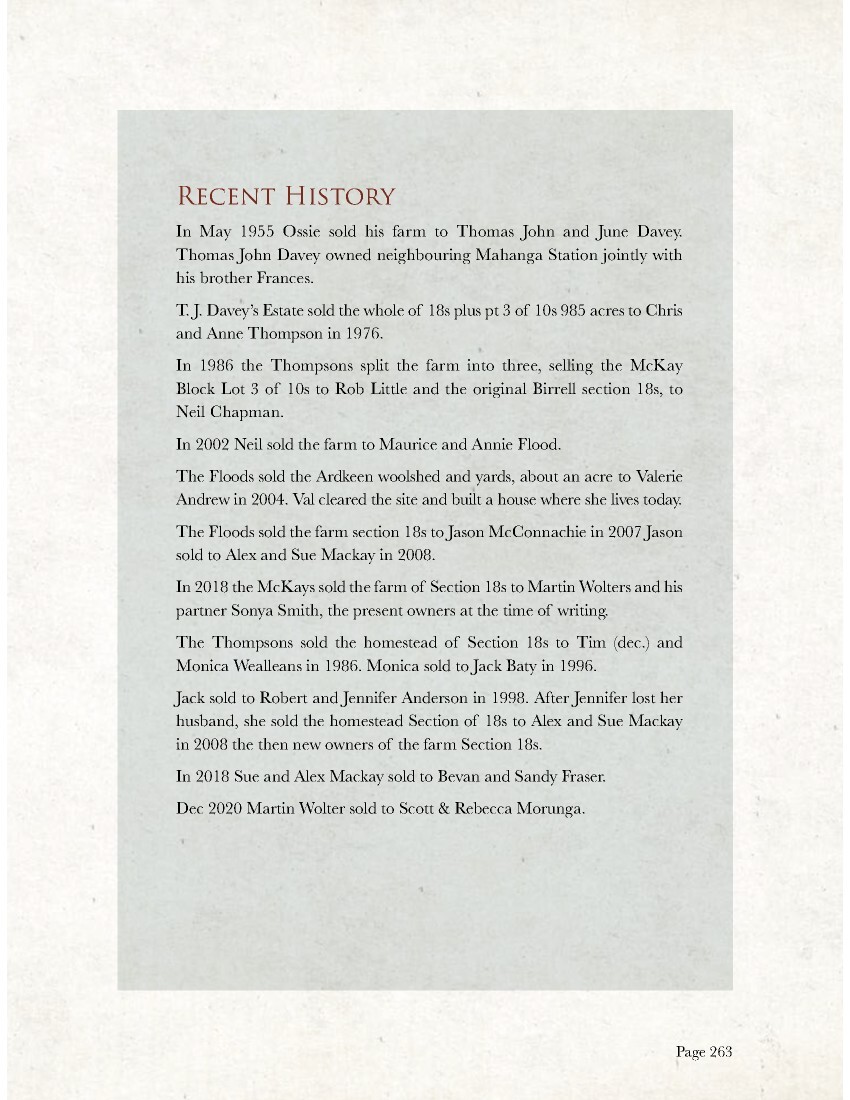
Page 265
THE TITIRANGI ROAD
When Ardkeen was offered for settlement the roads were surveyed, unformed and unfenced stock tracks. Titirangi Road was not open for vehicular traffic until late 1931.
The Department of Lands and Survey allowed for the forming of roads by the Public Works Department in the costs of subdividing the settlement. Subsequent metalling and other improvements were expected to be met by the settlers through their local body rates. 68
The settlers were offered work on roads but often refused because of health problems and the 10 shillings day wages were less than contract navvies would get. 69
ARDKEEN SETTLEMENT ROADS
Because there were no roads on Ardkeen homestead, sections adjacent to the Waikaremoana Road were surveyed from the frontage for the settlers. Gerry Spooner, Ernie Clifton, Mattie Andrew and Ossie Birrell were the only settlers who lived on their farms.
It would take 11 years for Bill Carson, Bob Preston, Jack Owen, Paddy O’Kane, Dave Robertson, Jim Meagher and Jim Tolme to get vehicle access, and a further 15 years before Jim McLean and Margaret Jackson got vehicle access to their gates. This made the lives of the men and their families difficult and impacted on the success of some of the farms, creating practical difficulties, hardship and financial losses.
The situation reflected the lack of a consistent wider policy, although ‘in general, the Department of Lands and Survey allowed for the forming of roads by the Public Works Department in the costs of subdividing the settlement or the preparation of Crown Land. Subsequent metalling and other improvements were expected to be met by the settlers through local body rates. This was based on the assumption councils could afford to spread gravel on the roads from increased rates. 70
Issues about the distance between homestead sites and farms were referred to in a letter from the Department of Lands and Survey to the Minister of Lands in January 1920, when attention was also drawn to the fact that new roads were stock roads and would not be formed to any extent. This
68 Gould, A.N. (1992) Proof of Gratitude, p. 189.
69 Ibid, p. 190.
70 Ibid.
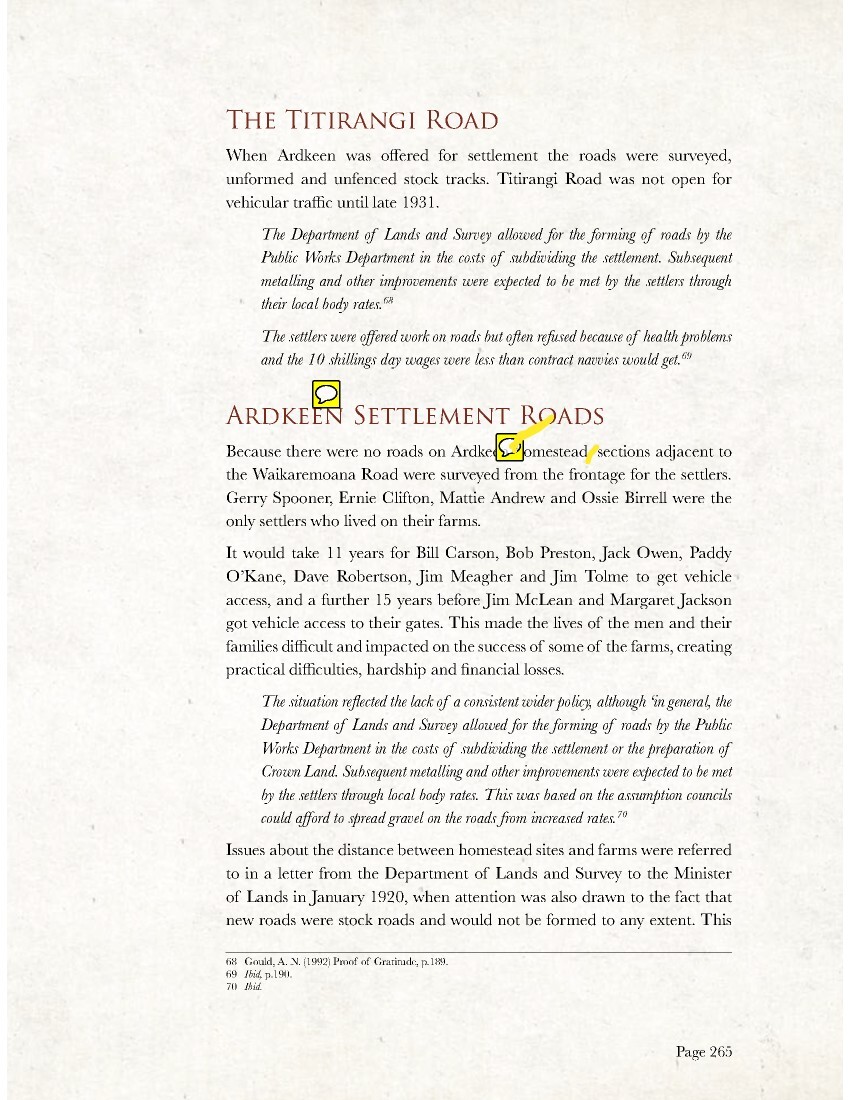
Page 266
was noted, and a line added to the ballot poster, “Those roads shown as stock-driving roads on the plan will not be formed”. At the time of the ballot and shortly afterwards there was discussion and clarification about the closure of various old tracks and roads on the settlement but not about the formation of roads for vehicle traffic.
The subject of roading was raised periodically by settlers in correspondence with the authorities. In his original survey report dated 15 May 1919, D. G. Robertson, Crown Lands Ranger, had estimated construction of about 8 miles of road at a cost of £4,480 for the formation and culverts, with an additional £5,760 for metalling needed. No action was taken despite the importance to the settlement.
£2,500 for roading was provided for in the original balance sheet, £500 was requisitioned in September 1920 for the formation of a dray road and improving a stock track. At the time the sum was considered ‘sufficient to meet the requirements of the settlers for some time to come’.
Correspondence dated July 1921 indicated a survey for forming a dray road would cost £700, with another £200 required for a modest improvement to stock tracks, proving the initial amounts were far from adequate.
CLIFTON LYALL ROAD
In October 1920 Percy Matson, Frank Meagher and Ernie Clifton had written about access to their homestead sections being difficult.
In July 1926 Clifton and Matson again wrote about the 20-chain access road from the main road to Waikaremoana up to their homestead sections that had been formed in 1921, but never completed. They asked for it to be metalled and two culverts put in. ‘The road was a steep cutting off the main road, that every winter or after rain can only be used as a bridle and sledge track, creating a handicap moving produce out (chaff, wool) etc. and manure, timber, and other supplies in. The District Engineer reported the grade was very steep at 1 in 10 and in wet weather ‘becomes impossible for vehicular traffic’. In August 1926 the Public Works Department recommended £70 to complete this work. When the work was done the road was handed over to Wairoa County Council.
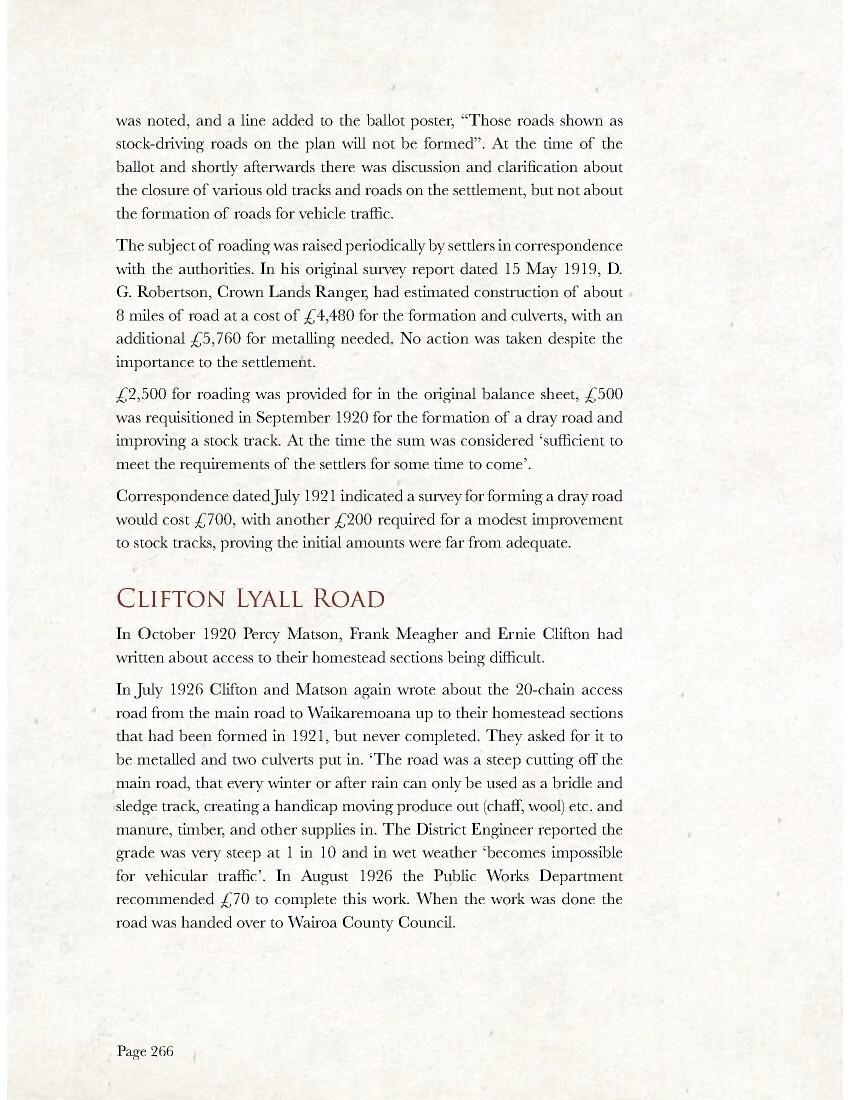
Page 267
COUNCIL RATES
A related and divisive issue was the local body rates, complicated by the high price of land during the time they took up the sections. The position of the counties was difficult; they appeared to be unsympathetic, at the same time under pressure from many areas to complete roading. 71
In a petition from O’Kane on behalf of the settlers, dated September 1928, roading was raised again; ‘Roading of the block is essential in order to give proper access to ten of the now fourteen settlers’. Saying as previously promised this work should be executed as soon as possible along a route with the best grade and to a point or points convenient to all.
In 1929, nearly 9 years after ballot, the access road for Ardkeen on the eastern side of the settlement was addressed. Money was allocated for a survey and £2,000 for work on the road. The survey was completed and a letter from the Chief Engineer indicated the road was 4 miles 52 chains long, 10ft wide would cost £3,100. This figure covered the removal of fences, but not compensation for land taken. £2,000 would come from Lands and Survey and £1,100 from the Public Works Department. Unemployed labour to be used to build the road. This coincided with representations to the Government for work for the unemployed of Napier. At this time nothing could be done until consents had been received from landholders.
In September 1929 it was agreed that a 12ft-wide road would be built at a cost of £3,450. The Ardkeen Settlement Road, later the Titirangi Road, was completed in the summer of 1930. To the frustration of the settlers, there began several months of correspondence between Government and Wairoa County Council, about responsibility for clearing of slips caused by heavy rain and the February 1931 earthquake. The planned handover of the road to the local authority was delayed for several months. Further improvements took place over time, and money was allocated to Ardkeen, for example, under the Government’s subsidy scheme for metalling backblock roads in 1938.
In December 1945 Jim McLean and Mrs Jackson wrote to the Commissioner of Crown Lands about the access to their properties. They had first written in 1939 but war had intervened. They had a strong case, being the only settlers on Ardkeen without road access. They argued a road would allow
71 Gould, A.N. (1992) Proof of Gratitude, p. 192.
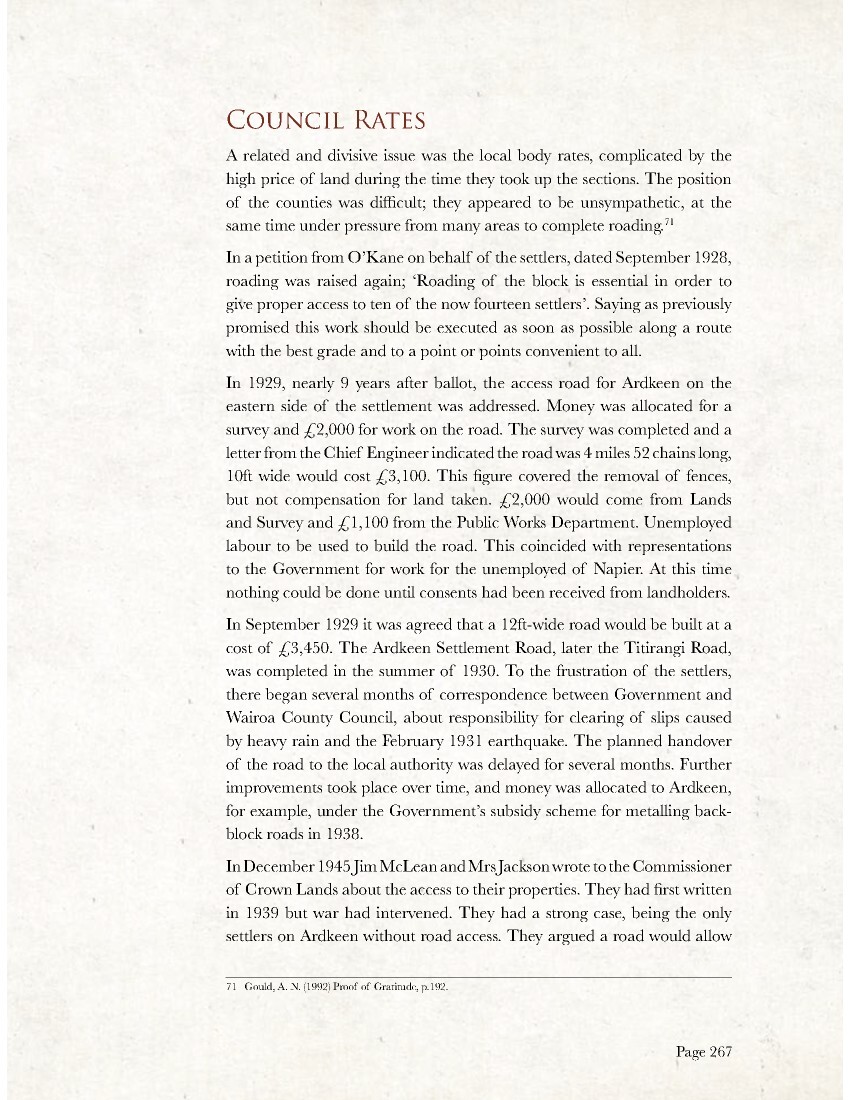
Page 268
them to complete essential repairs, provide accommodation, saving men 4 hours each day in the saddle, deal with scrub, handle stock more efficiently, increase carrying capacity, apply manure, build a sheep dip and woolshed.
Their application was supported by Field Inspector R. C. Tuke. The Commissioner for Crown Lands was unable to explain why the 1929/30 road formation had not continued to Mrs Jackson’s farm, recommending this should be rectified. Money was made available from the Wairoa County Council from the ‘Back-blocks Roading Vote in 1951’. The following year three miles of additional roading on Ardkeen was completed.
In 1962 money from the roads vote, for culverts and metalling of both Ardkeen Road (Jacksons) and the Titirangi was made available. 72
72 WCC First Hundred Years
Photo caption – State Highway 38 and the Titirangi Road intersection
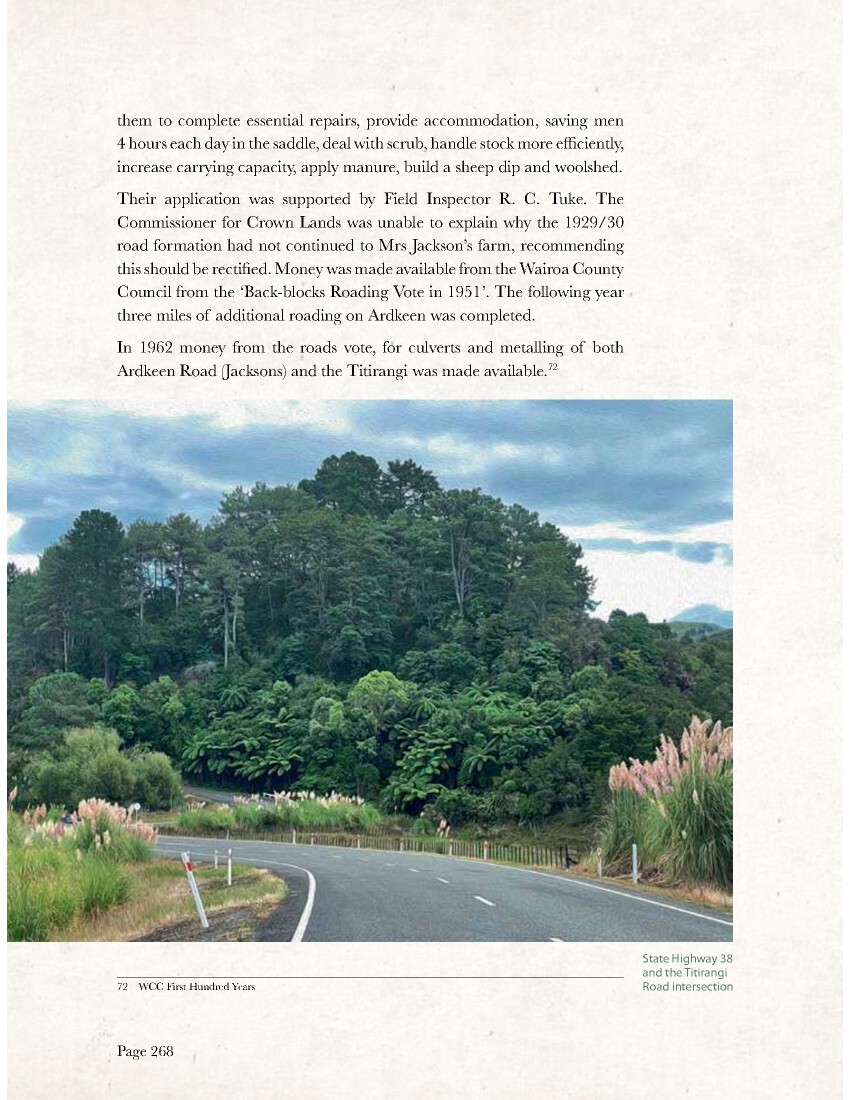
Page 270
The Nilssons built a new woolshed on the site of Mr Elliot’s woolshed in 1905. 73 It was powered by a seven horsepower Gardner engine driving ten ‘shearing stands’ and located on Section 22s. The woolshed was used by all the settlers. The management, financing and maintenance of the shed remained a problem for years. There was confusion about the terms of use from the time of the ballot, compounded by the fact that for the first five years the settlers used it free of charge.
A letter from Lands and Survey dated 1921 about the valuation of the Ardkeen woolshed mentions a memorandum dated 6 April, 1920 which states the woolshed, and sheep dip had been reserved for the use of the settlers. However, the Commissioner’s office had not been advised of the arrangement. No mention was made in the sale poster of the amount to be recovered for the use of the woolshed and dip.
The Commissioner opined ‘any slight monetary loss has been more than met by the satisfaction of the settlers with the generous way in which they were treated’.
In the same letter he goes on, ‘in a measure we were lucky, as Otamauri woolshed had to be sold because the settlers would not agree and Hatuma woolshed after many vicissitudes is now a Domain, but so far the Ardkeen boys have put a lot of their private money into the shed and are pulling well together.’
June 1925
During a visit to the district, the Commissioner discussed a formal tenancy over both Section 19s, situated 3 miles away, in the middle of the Settlement that was set aside as a holding paddock, suggesting a lease for each section, shed and holding paddock, be offered to the Settlers Association at a rental of £1.10s and £2 per annum for 5 years. Ossie Birrell pointed out the settlers were not unanimous and the situation was in a deadlock.
The Commissioner and Field Inspector Robertson suggested Mattie Andrew be appointed caretaker, with a charge of £3 per settler per annum. Mattie to receive a £20 per year management fee, the balance used to pay insurance and meet repairs.
The authorities wanted to discourage settlers from building their own woolsheds, arguing that £3 per annum charge for the use of the woolshed was a small outlay compared with the cost of building their own.
73 New Zealand Herald, 21 November 105
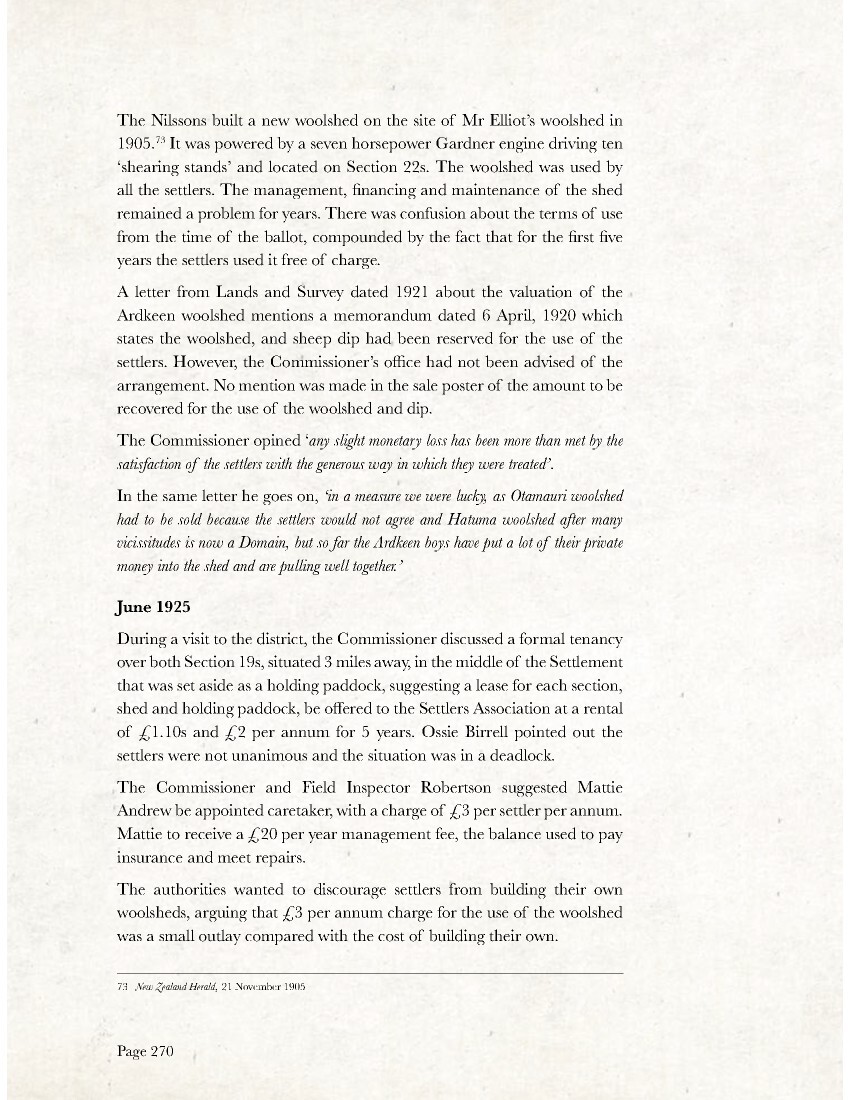
Page 271
5 October 1925
Field Inspector Robertson, wrote to the Commissioner of the difficulties following a meeting with the settlers, saying the settlers had the use of the woolshed free of charge and believed it had been covered in their leases. He explained that the engine and shearing machines were owned by the settlers, making it awkward for the Department to control the shed.
A letter in 1921 from the Department to the Under-Secretary of Lands covered this anomaly. The settlers formed an Association and re-installed the shearing plant at their own expense. The Government had sold the original shearing plant at the clearing sale. The supposition was that the settlers would elect a committee to control and maintain the facilities.
Ranger Robertson pointed out the Ardkeen Settlement was different from others in that it did not have access roads to most of the farms and several settlers refused to pay anything.
October 1925
The Commissioner pointed out to Ossie Birrell the woolshed had not been factored into the original farm valuations. The value of the woolshed was a separate asset although he preferred that the running of the woolshed remain in the hands of the settlers. The Crown would not allow the woolshed to be used free of charge. The Commissioner suggested the settlers pay 5% of the value of the land and woolshed to cover insurance, maintenance of the dip, yards and buildings. In event of a fire, the department would reinstate the building to its full value.
February 1926
An agreement was eventually reached when O’Kane and Carson took responsibility for keeping the woolshed and yards in good repair and paying the insurance.
The main stock route to the woolshed eventually became the Titirangi Road – see Road Chapter.
April 1928
The Power Board charged an availability rate for the woolshed. This lead O’Kane and Carson to seek relief of their tenancy. The Commissioner outlined the situation to the Under-Secretary of Lands. Field Inspector
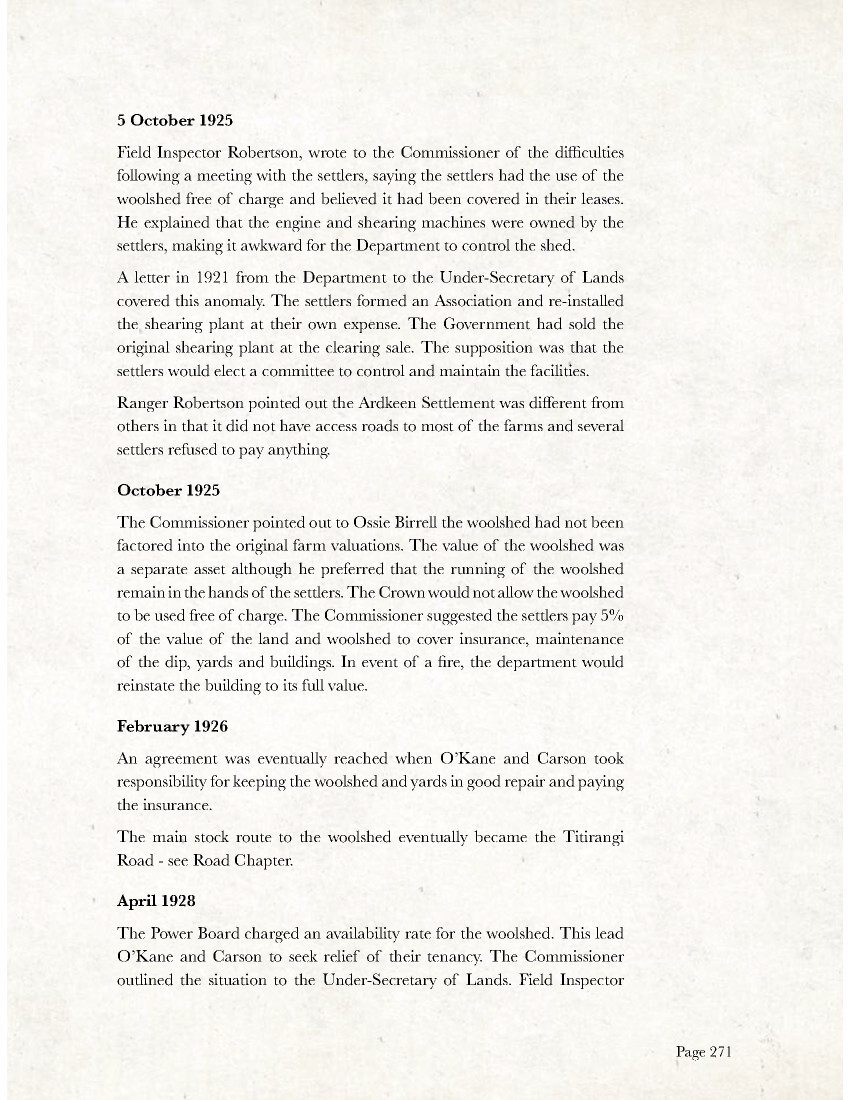
Page 272
Robertson had been asked to negotiate with the settlers. Another arrangement was made in August 1928. At that time McLean and Spooner didn’t use the shed, they used Ossie James’ woolshed.
But the agreement applied to Andrew, Birrell, Clifton, Carson, Preston, Matson, Jackson, Meagher, Tolme, Robertson, Owen and O’Kane. After discussions with Field Inspector Robertson, Andrew reluctantly agreed to take on the caretaker role for £15 per annum with the users agreeing to pay £3 per annum each.
£15 was to be spent on maintenance, £11 on insurance, and £10 would go towards repairs. This arrangement was short lived when Andrew, having heard the views of other settlers, refused the job. He said; ‘As perhaps you know I am not over popular with some of these gentlemen and they don’t want me to be caretaker’ saying, ‘I am not disposed to take it on at any price’.
August 1928
In a letter to the authorities O’Kane wrote that a committee, comprising Birrell, Tolme and himself would take responsibility for the woolshed. O’Kane later stood down because of problems relating to payments due for repairs.
September 1928
While still on the committee, Paddy O’Kane petitioned the minister on behalf of the settlers about a revision of values, provision of adequate roading, rent arrears and the ‘Availability Rate’ claimed by the Wairoa Power Board. The petition also raised the question of a holding paddock. The farmers of the back sections wanted a reserve created of the Bill McKay’s recently vacated homestead 10s section. Paddy pointed out that settlers risk losing stock at shearing time if the weather changed adversely, with flocks being two days’ drove from their paddocks. ‘At present there is no place for the sheep except the yards and shed with nothing to eat for two or three days. A southerly burst, that we often get at shearing time will quickly kill a large number of sheep’. This was not the first petition; none of the issues raised were addressed.
May 1929
The Receiver of Land Revenue wrote to the Controller of Accounts at the Land and Survey Department ‘we tried to get a Committee of Settlers to run
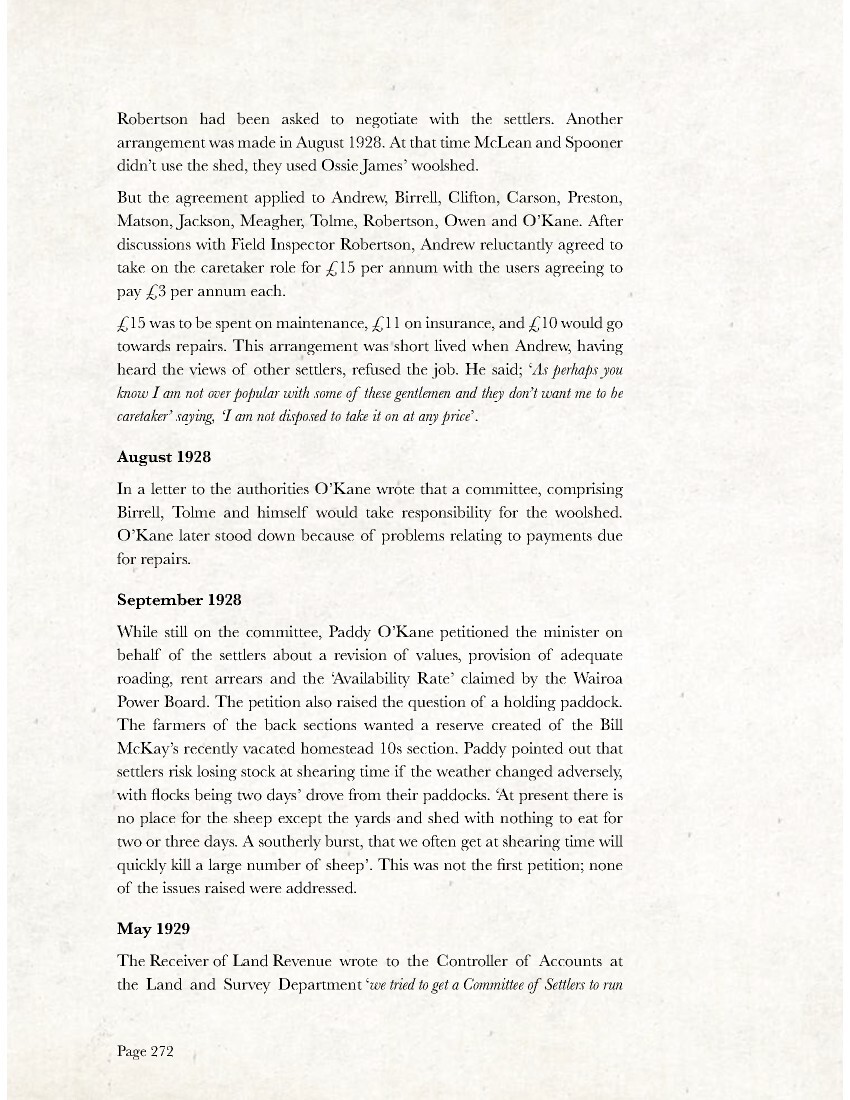
Page 273
this shed and pay all charges, but they are a very difficult lot to deal with and they could not agree amongst themselves’.
March 1930
Ossie Birrell wrote in, suggesting the Department levy the settlers, Ossie saying he would have nothing more to do with it if the matter was not resolved. This left Jim Tolme as the sole member of the committee. Ossie Birrell was still writing to the authorities in November the same year.
1931
There were 10 settlers using the woolshed and still there were outstanding issues. A letter dated April 1931 from Jim Tolme asked how was the collected money to be spent?
1933
Ossie Birrell wrote that an unspecified number of settlers were not making any financial contribution to the woolshed and the burden of costs were falling unfairly on those who did pay.
1933
Birrell and Tolme resigned and a yet another committee was elected, comprising Robertson, Carson and O’Kane.
December 1945
Issues relating to the roads and woolshed remained unresolved. Margaret Jackson and Jim McLean wrote to the Commissioner pointing out they were the only settlers using the woolshed, that their farms were at the end of 3 miles of unformed track, from the top of the Titirangi Road, and 7 miles from their homesteads. The Commissioner recommended the Public Works Department look into providing access.
Jim McLean borrowed £75 to build a small woodshed for crutching in 1937; he continued to use the Ardkeen shed because there was no way of getting his wool out.
In 1937 Gerry Spooner followed by Bob Preston, Dave Robertson and Paddy O’Kane built woolsheds.
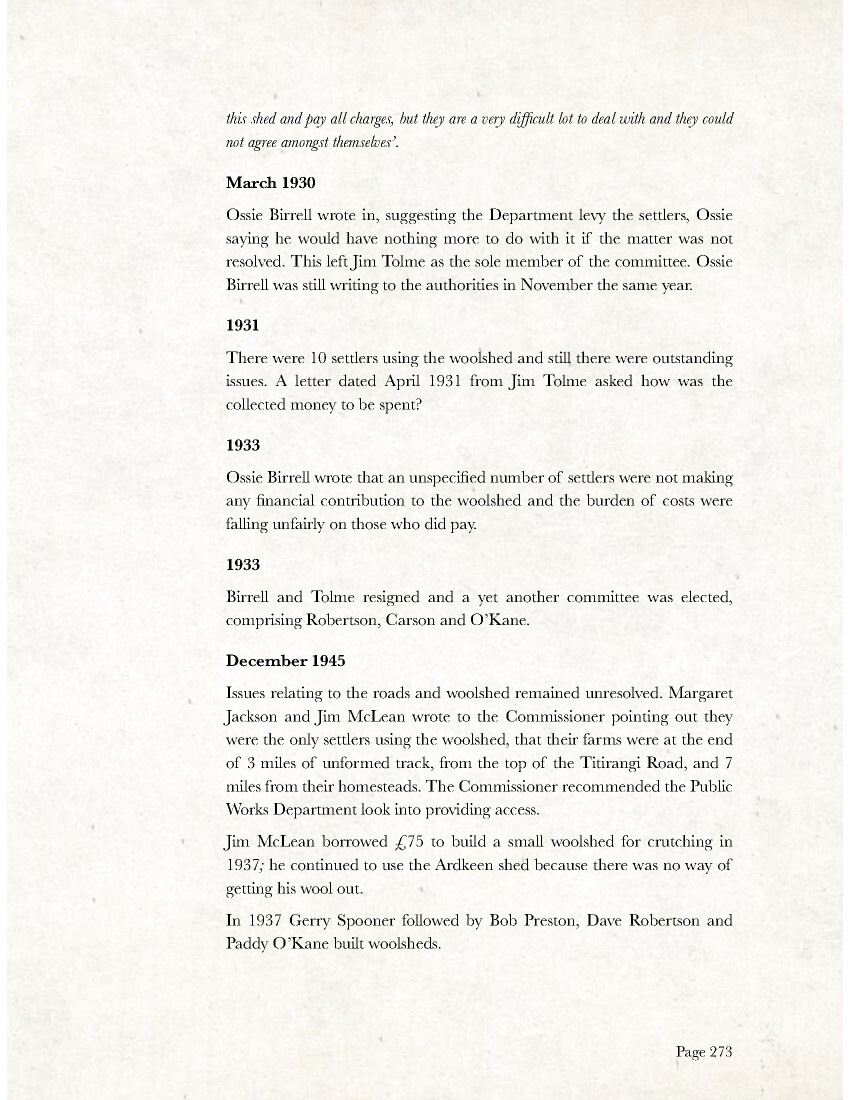
Page 274
Helen McKinnon née Birrell & Audry Webster née Clifton memories: In 1952 the Ardkeen woolshed was dismantled and a small woolshed was built from the material on Section 9s, it continues in service today.
Ossie Birrell built a shed in the place of the original shed and took over the Ardkeen station sheep yards. Roy Andrew converted the shearers’ quarters into a woolshed and the dip yards became his main sheep yards
Shearers’ Quarters that became Mattie Andrew’s woolshed
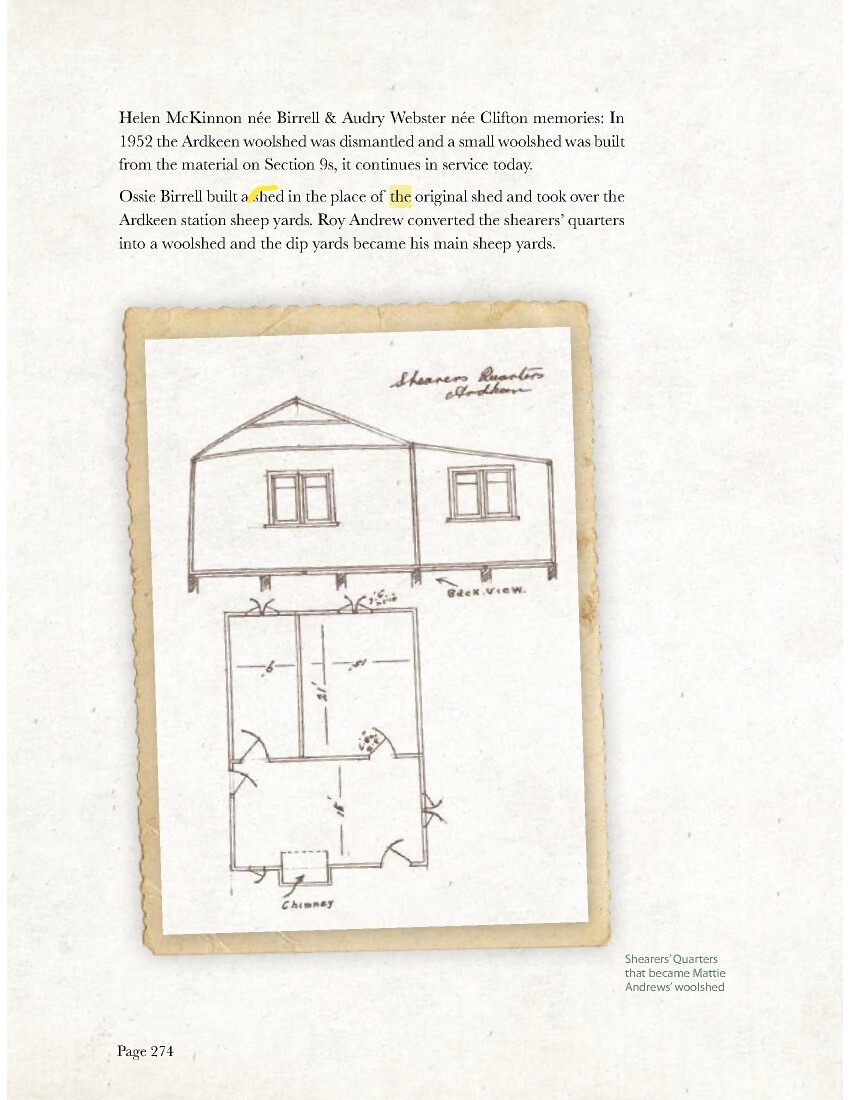
Page 275
Memories from Ardkeen dances
Came time to go home after one of the many Ardkeen dances and brother Peter was the driver – his mates were a little concerned as we left the hall because Peter had had “a few drinks too many”. But off we went and all was well until we turned off the main road to go up the Clifton, Lyall road. Somehow the car refused to take a sharp u-turn off – whoops, we were stuck in the creek bed. Nothing for it but to walk up the hill and both go and confess to “sound asleep” Dad – he was very calm in his sleepy state and next morning the tractor was used to pull the car out of the creek and with no harm done. Dad took it all very well.
Photo captions –
Audrey Webster’s (nee Clifton) recollection
Helen McKinnon’s (nee Birrell) recollection of the Ardkeen Woolshed
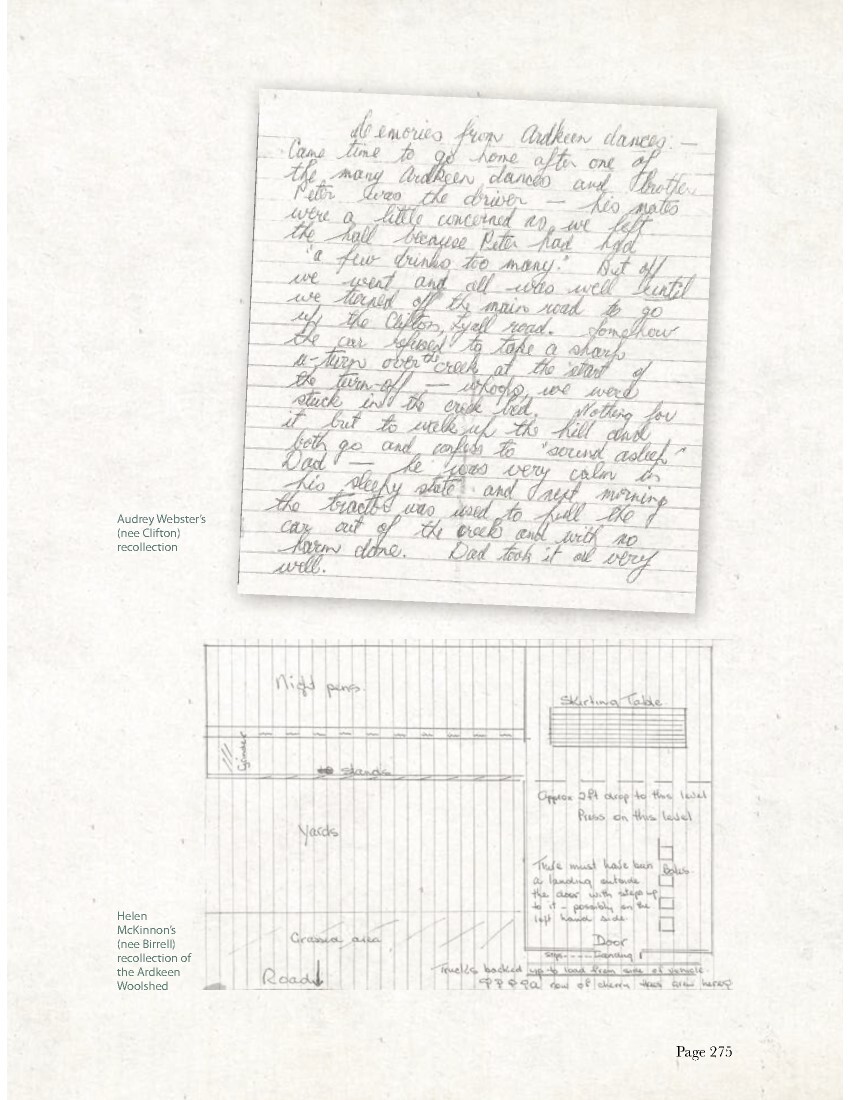
Page 276
Memories of life at Ardkeen
We had a great childhood at Ardkeen when I think back over some of the things we did – there wasn’t time for boredom.
We had what we referred to as top and bottom orchards and when Dad pruned the apple trees he always selected a few longish canes which he kept above the back door – they were disciplinary matters if needed – cant member them being used though – the very thought of them kept us in line probably.
He had two great vegetable gardens – the lower for beans, carrots, parsnips and potatoes – the upper which faced the main road for cucumbers, various melons, pumpkins and corn.
We put the over ripe cucumbers to what we thought was a fun thing to do by hollowing them out and filling them with sheep poo, hiding in the corn and tossing them over the fence at the drover as he came past with a mob – we called him Gypsy Joe.
Rob and Stuart made a cart and we had fun times taking turns at riding down the slope from the hay shed to the cow yard – cant remember any serious mishaps but there must have been some – we became pretty adept at this sport!
Mum would take us swimming in the river – luckily no-one got into difficulties as she could not swim!
She helped with the dipping and haymaking as did some of us. We would “stack” the hay which was put onto the sledge, taken to the end of the paddock and made into a stack. This of course was prior to having a hay baler.
Grandma Goldstone, who lived with us, always made up a large container of a thirst quenching drink from lemon juice, sugar, creamota [Creamoata] and water.
[…] into a bit of strife on one occasion […] and Stuart set off on an adventure […] an axe – unbeknown to them Anne had followed – as Rob swung the axe back it hit her on the head – so off to town to the Dr.
We three were a bit worried about her and asked Cyril Pullen if she was going to die. Cyril was the farm hand at the time and stuttered rather badly, so it took him a little while to reassure us that she would be O.K. Our nickname for him was “Static Pants”.
We used to have some great “cook ups” for the chooks. Vegetable peelings, puha, wind fall fruit – whatever we could find, and any spare milk was put into a container and left in the sun to sour and curdle – this was chook “fine dining”.
At shearing time Anne and I would spend time at the cook house with Mrs Ted (Kapene). After everyone had left after one shearing we found a chook had been left behind so we took her home. Called her ‘Ringa’ after Mrs Ted.
Helen McKinnon
nee Birrell
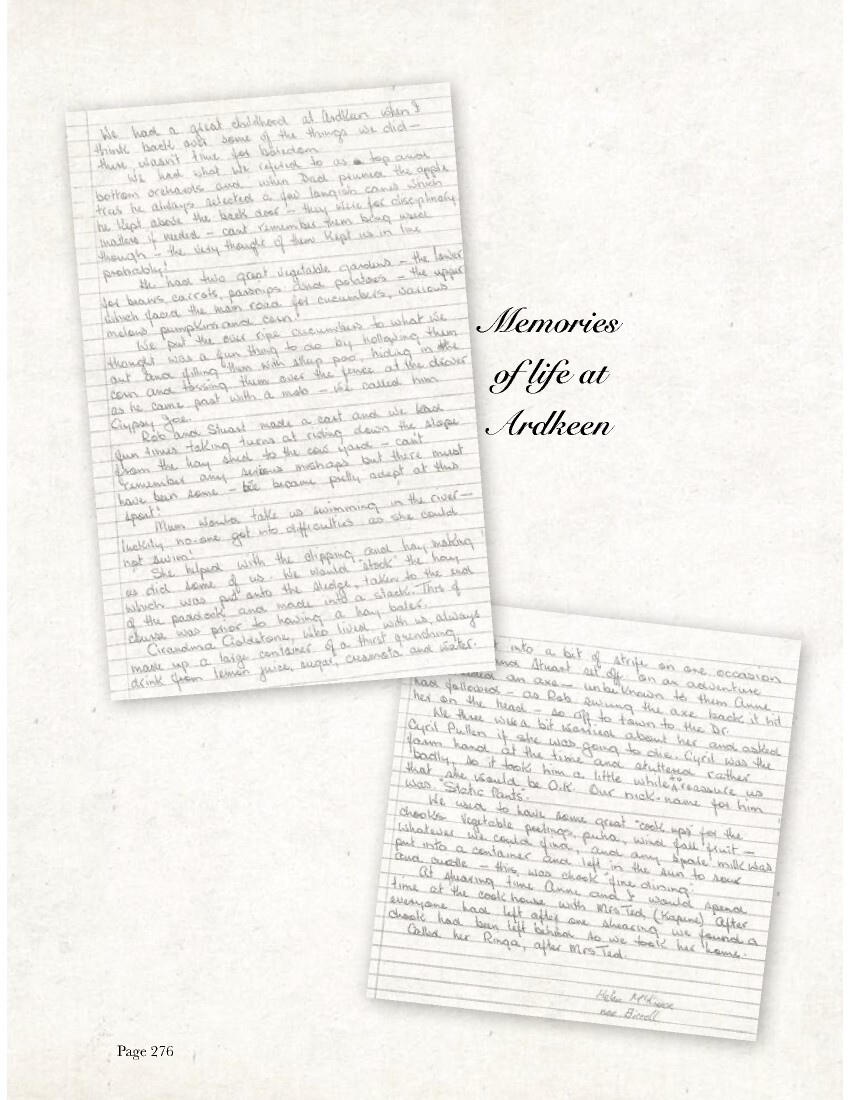
Page 277
Community life
(Woolshed and later the Ardkeen Hall)
As well as having a key role in the working life of the settlement, the woolshed provided a natural social gathering place and important community focus for both Ardkeen and Ohuka settlers in their early years, being located close to the homestead sections on the main road to Waikaremoana. A very early event was reported in the Poverty Bay Herald 17 November 1920 of a celebration of the signing of the Armistice being held in the Ardkeen woolshed on 11 November 1920. It was attended by the Ardkeen and Ohuka soldier settlers and representatives of other soldier settlements in the Wairoa District. This gathering in the early days of the settlement and so close to the end of the Great War was an opportunity for relaxation in what must have been hard times at the start of their tenure. But also, a chance to exchange tales of shared experiences and remember those who had not returned. It reported that it ‘is the ‘Ardkeen people’s intention to celebrate the Armistice night each year.’
The woolshed continued to be used for a wide range of social events.
In 1952 the woolshed was dismantled and some of the material was used to build a woolshed on Bill Taylor’s farm, formerly the Tolme block, at Titirangi. The shareholders at this time were: Bill Carson, Bill Taylor, Jack Owen and Jim Meagher. The shed is now owned by the Bowens.
Leftover posts on the Harbour Board block

Page 278
Unveiling the Cairn
The memorial to the original Ardkeen settlers which is adjacent to Ardkeen Hall
[Brass plaque reads:]
“IN MEMORY OF THE FIRST WORLD WAR DISCHARGED SOLDIERS WHO SETTLED AT ARDKEEN, JUNE 1920
It was their courage, determination and perseverance that laid the foundations for the future of the Ardkeen District.
P.J. Matson
R.J. Meagher
F.P. Meagher
D.H. Robertson
P.J. O’Kane
C.F. Jackson
J.C. McLean
M.P. Malone
J. Tolme
W.J. Mackay
J Owen
R.W. Preston
W.C. Carson
W.H. Nicol
G.E. Spooner
E.C. Clifton
M. Andrews
O.G. Birrell
‘LEST WE FORGET’
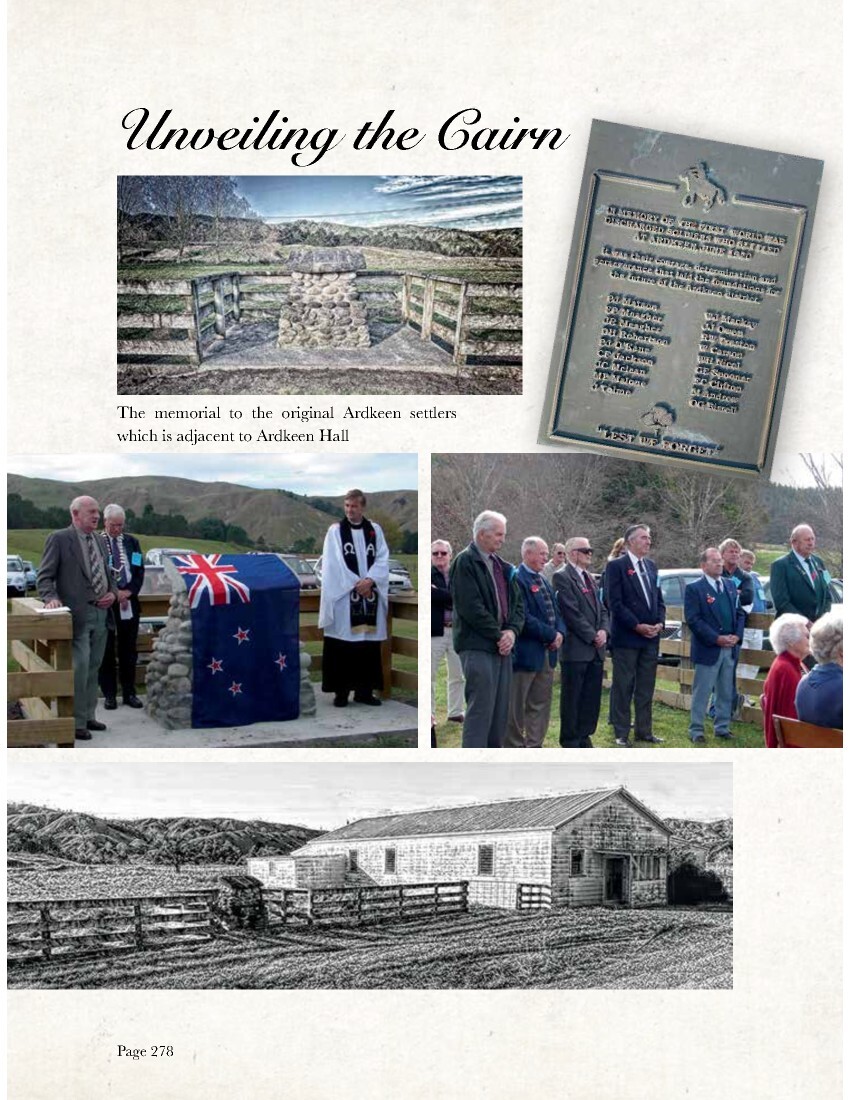
Page 279
Ardkeen & District Hall
With the end of the depression, increasing prosperity and population, the settlers from Ohuka and Ardkeen formed a committee to build a hall on land donated by Mrs Margaret Jackson. Donations, auctions, and raffles were held to raise funds to purchase a disused Railway Hall at the Kotemaori Railway Construction Camp on the Napier Wairoa Road. The hall was opened in 1938 by Wairoa Mayor H. L. Harker. 74
A Hall Society was established in 1941, with a subcommittee of ladies. Cattle were donated and grazed on local farms, furniture was purchased with a grant from the Wairoa County Council.
The hall hosted a variety of activities including church services, meetings, suppers, dances, amateur theatricals and parties. There was an annual sports day held in the adjacent paddock belonging to Bill Carson up to the 1960’s. Maintenance continues to be done by volunteers.
In 2007 Cliff Owen, Brian McKinnon, John Davey, led by Stu Birrell, conceived and built a cairn with a plaque to commemorate the Ardkeen Soldier Settlers
74 Wairoa County Council ‘First 100 Years
Ardkeen Hall

Page 280
The Dog
Most settlers came from a farming background and owned sheep dogs. Managing mobs of several thousand sheep on the New Zealand hill country with paddocks of several hundred acres was impossible without these hard working intelligent creatures.
The first dogs brought to New Zealand were Border Collies, they work the sheep from the rear, and control them by keeping the mobs tight; they are fast and silent dogs. However, when the sheep have been mustered into mobs, particularly when the ewes have their lambs at foot and become mis-mothered, noise and weight is needed to drive the mobs to their destination. On Ardkeen this meant several miles, spread over two or three days, often with little water.
This task fell to the ‘Huntaway’, which evolved from crossing with Australian dingoes, and other noisy breeds. The Huntaway is handsome large and strong. He can be trained to bark on command, he is positioned behind the mob, often leaping onto the backs of the sheep, barking in their ears. He will work at long distance. They are trained to respond to the shepherd’s whistle and/or voice command.
Watching a team of dogs move mobs of sheep across open hill country is a beautiful sight.

Page 281
Ardkeen School
The Poverty Bay Herald, 25 October 1912 reported that Inspector Hill had told the Hawke’s Bay Education Board, that a small school should be erected at Ardkeen, Wairoa. It was decided to appoint a teacher if the settlers provided the school. However, no school was established.
This is also recorded in a published summary of the 1913 Wairoa Council records, ‘the attention of the Government was to be drawn to the necessity of establishing a school (known as the Ardkeen Korakora School) at the junction of Godwin’s Road (Ruapapa Road) with the Waikaremoana Road, and that Mr Hill, School Inspector, had inspected the site, ‘reporting favourably upon it’. No progress was made and on 11 November 1916, the Hastings Standard reported on the Hawke’s Bay Education Board monthly meeting ‘the suggestion re delay in application for a school in Ardkeen was deferred until further information can be obtained.’
In 1917 the question again arose; at this time schools could only be opened with a minimum of 15 children, there were not enough pupils in the area. An alternative suggestion was made in the Hastings Standard,
4 April 1917, again reporting on the Hawke’s Bay Education Board, ‘As a result of a senior inspector’s suggestion for the establishment of a shelter-shed-school at Ardkeen, it was reported that plans of such a school be obtained, the carrying out of the proposal to be left in the chairman’s hands’. This solution proved to be unnecessary. In August of that year, the critical number of pupils was achieved and construction began.
(Shelter-shed-schools: Originally raised in 1905 in a parliamentary discussion (Education Act Amendment Bill) about small schools and shelter sheds, this had later been raised by Mr E. C. Banks, a member of the Auckland Education Board. Reported on 24 January 1912 in the Dominion, Banks suggested that shelter sheds could be built in new districts as a way of getting round Education Department restrictions on minimum numbers of pupils needed before a school could be erected. The sheds ‘could be built as a temporary measure until numbers were sufficient for a proper school’ and could then revert to an outside shelter. The original cost of such a school was around £50.)
The school was established on an acre of land donated by Martin Nilsson,
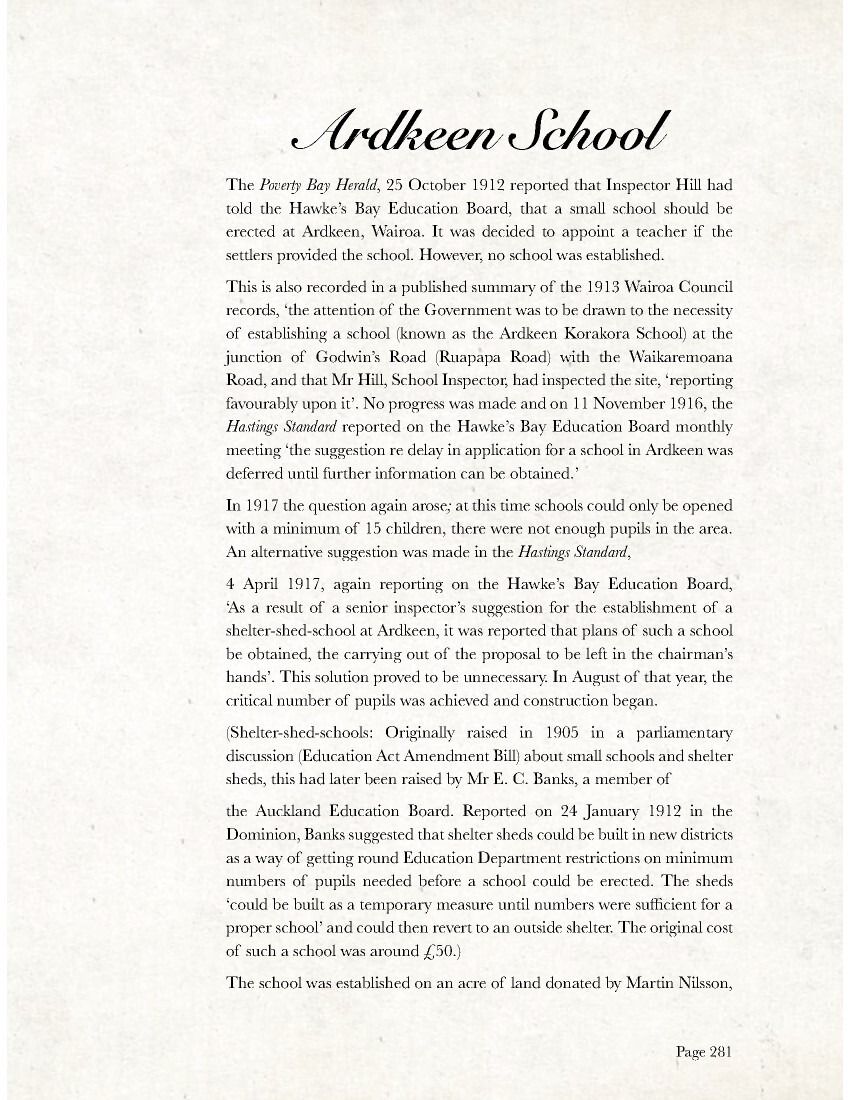
Page 282
the then owner of Ardkeen Station. Along with the donated acre, he sold another two. Although when the school was originally planned he had offered seven acres, that offer lapsed when the plan was abandoned because of insufficient pupil numbers. After the establishment of the Soldier Settlement in 1920, a further acre was added to the school site.
The Hastings Standard, 9 February 1918, reported from the Hawke’s Bay Education Board chairman’s report, under ‘new schools opened’ ‘Ardkeen will open on the 1st March proximo’. The first record of pupils at Ardkeen School on 5 April 1918, was from the attendance register. There were 16 pupils and the first teacher, Miss D. V. MacKay (April 1918 – July 1919).
The original name of the school, Kuru Kuru, was changed to Koro Koro in the early 1920s under teacher Miss L. Fletcher (June 1920 – May 1922).
The school’s growth and development is covered in some detail in published anniversary histories. Of primary interest here is that it was the school that the soldier-settlers’ children attended. As the published anniversary histories record, the community through its school committee was a major financial contributor, raising funds for a range of equipment throughout its life, as it continued to grow and the facilities improved. A number of the soldier-settlers served as chairmen of the school committee.
The Poverty Bay Herald, 9 April 1938, covered the opening of an additional classroom at Ardkeen; at the time there were 44 children enrolled at the school.
On 22 July 1946 the name of the school was changed again, from Koro Koro to Ardkeen, after an application to the Education Board, at the unanimous request of local householders.
The school closed on 27 January 2004, as a result of a review undertaken of Wairoa schools, which found a decline in the number of school-aged children. A notice appeared in the New Zealand Gazette, Thursday 18 September 2003. Ardkeen School Closure Notice:
‘Pursuant to section 154 of the Education Act 1989, I hereby declare that Ardkeen School (2541) at Ruapapa Road, Ardkeen, Wairoa, will close on 27 January 2004, and will cease to be established on that day. Dated at Wellington this 9th day of September 2003. ‘Trevor Mallard Minister of Education.’
The building survives at its original location and is now a residential property.
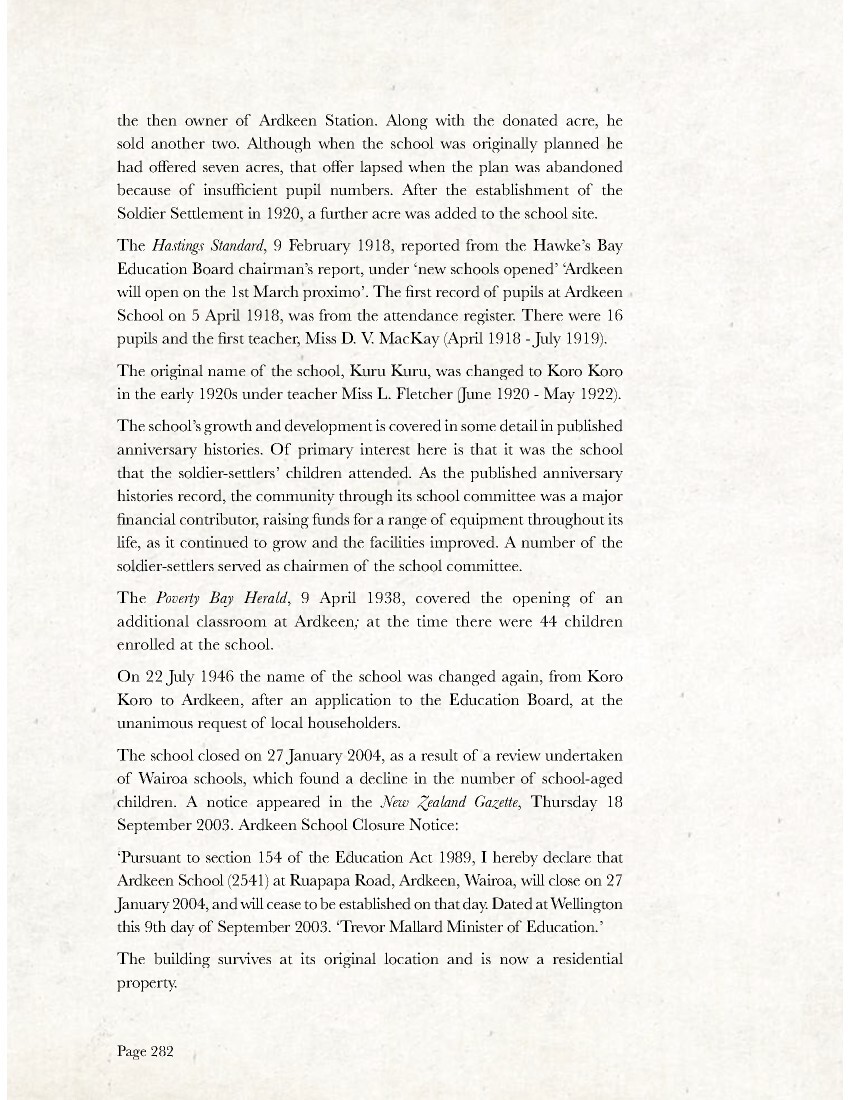
Page 283
THE ARDKEEN PROBLEM
The above transcribed:
The Undersecretary
Lands department
Wellington
Dear Sir,
Please excuse this note, I know it will go straight into the waste paper basket as you probably know what I am about to tell you.
The only trouble with a Ardkeen is the small areas. Otherwise the settlement is as good as any other one. The only way to solve the problem is to cull out the Slugs who will never do any good, if they had the land given to them there is a man or two on a Ardkeen who will never make good. Any member of the old Gisborne Re-evaluation Board can tell you who they are.
Mr Summerfield for preference as he lives practically on the spot. You can take it from me sir, that I know what I am talking about as I have watched a Ardkeen with the greatest of interest right from the start.
I am an old Settler who has made good! And who has not been spoon-fed.
Did you know the settlement can run well appointed residences wireless sets and motorcars.
Little wonder they can’t pay rent
Unsigned

Page 284
AFTERWORD
I was 9 years old when we moved to Ardkeen.
With the farm adjacent to the Titirangi Road and part at the end of the road. It was whilst travelling between the two blocks that we would meet the old settlers. I have a memory of father and my uncle Frances Davey arguing with Jack Owen about a boundary fence. Jack Owen impressed me as a shrewd tough man.
Bob Preston, I remember as an elderly man with a strand of hay in his beard, talking to father on the Titirangi Road, a friendly character with a twinkle in his eye.
Often Bill Carson would park his clean blue Commer truck on the Titirangi Road where he had a horse paddock. Mr Carson struck me as a taciturn fellow of particular habits; I do not remember having a conversation with him.
Dave Robertson, and wife Dorothy who was a university graduate, were a delightful welcoming couple, Mr Robertson had a wise, thoughtful disposition.
Mrs Jackson, I do not remember, although I would have met her; Father John, brother Francis and sister Zoe boarded with Margaret Jackson for a brief period about 1934 when they attended Ardkeen School; Dad liked Mrs Jackson. Cranworth had died in December 1933, he had a reputation as an adventurer, raconteur and a likeable character, drawing in people like Humphry Bayly & grandfather Tom.
Occasionally I delivered messages and parcels to Jim Tolme from Uncle Bill Taylor, who had bought his farm. I would thump endlessly on the front door, he was stone deaf. I remember a gentle smile from a lined old face. There was no conversation, no doubt I talked. Anecdotal conversations indicate Jim Tolme earned income from droving livestock for other farmers, leaving his farm stocked with dry sheep, (no breeding ewes) for lengthy periods. He was an excellent hard-working stockman – keeping the fence battens straight at all times.
Mattie Andrew made up for his lack of humour with the hard work that sent him to an early grave. I have a vague memory of Mrs Mattie Andrew, a small lady of few words, and of course Roi. Our families had happy times in and out of each others homes. I was particularly fond of May Andrew and missed her when she left the farm to marry.

Page 285
Mr and Mrs Ernie Clifton I remember as a friendly older couple with a lovely garden.
My memory of Jim McLean is of a private old fellow, his Singer car negotiating Jackson Road with timber / posts poking out of the windows and dogs sitting in the boot.
Jim Meagher had moved to Woodville where he owned a pub long before my time. Brother Frank died in 1923 when the Matai cage fell into the river.
Paddy O’Kane, an effective, disciplined fellow, had moved away before we came to Ardkeen. His representations on behalf of his fellow settlers dealing with the Wairoa Power Board and leading representations to the Minister of Lands were very much to his credit.
I do not remember Gerald Spooner though he must have been at the annual Ardkeen Sports that ceased in the late 1950s. The Sports Days held in Bill Carson’s paddock were fun. The men’s running races with Bill Wills removing his shoes as they lined up, and winning against the Devers, McRaes, Birrells, McKinnons, Pete Clifton, Roi Andrew and others amidst much laughter and beer.
My favourite piece of Ardkeen is the gently contoured country with pretty creeks covered in Totara that was William McKay’s Lot 10 part 3. This section is adjacent to the Harbour Board Reserve Bush Block, the source of tens of thousands of fence posts, braided with deep pack tracks worn by the horses and men with their loads.
Dad told me William McKay had been sent to Porirua Mental Hospital; I have come to regard him as the saddest settler. A man of extraordinary courage who was 50 years old, unmarried, and from a farming family when he came to Ardkeen. William paid for his livestock with cash. The only settler declared a bankrupt, William died aged 79 years and is buried in Nelson.
Maurice Malone the son of Lt Col. William Malone killed on “Chunuk Bair Gallipoli” depicts another sad situation. Maurice died of medical misadventure, leaving a young wife, and three-year-old daughter. That daughter died about the time I began my research; I was in touch with a niece.
Percy Matson won perhaps the best contoured farm on Ardkeen, but it was the most remote section, with five farms between his farm and the woolshed. To this day there is no road access to Section 1s. Percy lacked
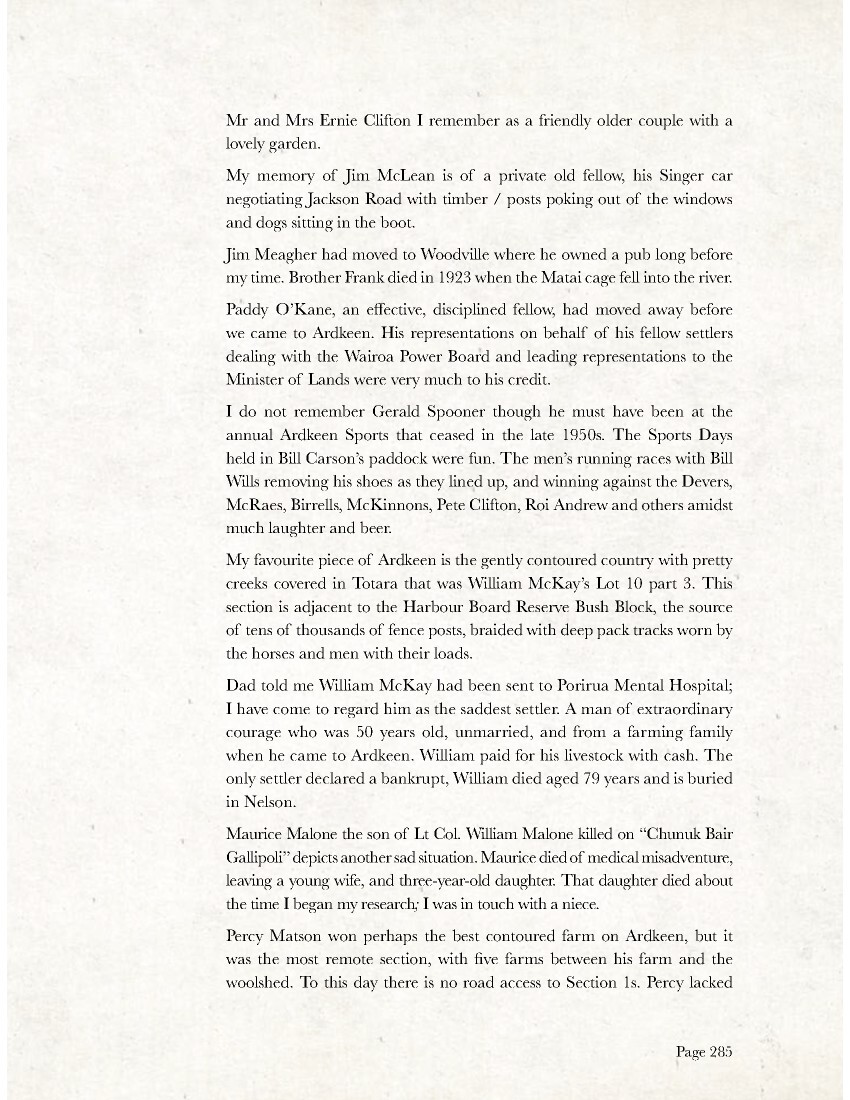
Page 286
opportunity; by account he was a hale and hearty fellow, a keen fisherman and shooter. Mrs Matson was a great beauty and a lovely person.
William Nicol won his ballot after McKeegan, the successful ballot withdrew. William Nicol was unmarried and had been a livestock agent in Timaru. William successfully negotiated his exit from Ardkeen with the Department of Lands in 1929. He returned to the South Island where he married. Records indicate he owned a confectionery shop in Westport.
In 2005 I returned to the house I built on a small part of Mahanga Station where my father Thomas John Davey was born in 1921.
Stu Birrell, an old friend, invited me to join Cliff Owen, Brian McKinnon and himself in building a ‘Cairn’ at Ardkeen Hall to commemorate the Ardkeen Soldier Settlers. Both Stu and Cliff were born on Ardkeen. The project reminded me of the unanswered questions I had about the men, their families and the settlement. Sarah my wife, a professional researcher, found a trove of material including handwritten letters spanning the early years of the settlement; so began our project.
My mother June Vernon, née Joblin, born at Waiatai, Wairoa in June of 1921, provided a first-hand insight into the 1931 Earthquake and Depression years. Mother’s aunt Ruby had married Martin Nilsson in 1920. Olive Nilsson had married Joe Anderson, the Manager of Dalgety’s Stock & Station Agents Wairoa who featured in the lives of the settlers.
The Nilsson family may have been inspired to develop Ardkeen Station for settlement by the passing of the Act to make provision for the Settlement of Discharged Soldiers on Crown and Settlement Lands. To this end a lot of money was spent developing the marginal land of Ardkeen. This land included section 1s section 2s section 6s and section 7s. The land of these sections is parallel in nature of that on Ohuka where soldiers were settled on 1,200 acres each. Records show sheep numbers were increased by about 2,000 prior to sale.
John Davey
March 2020
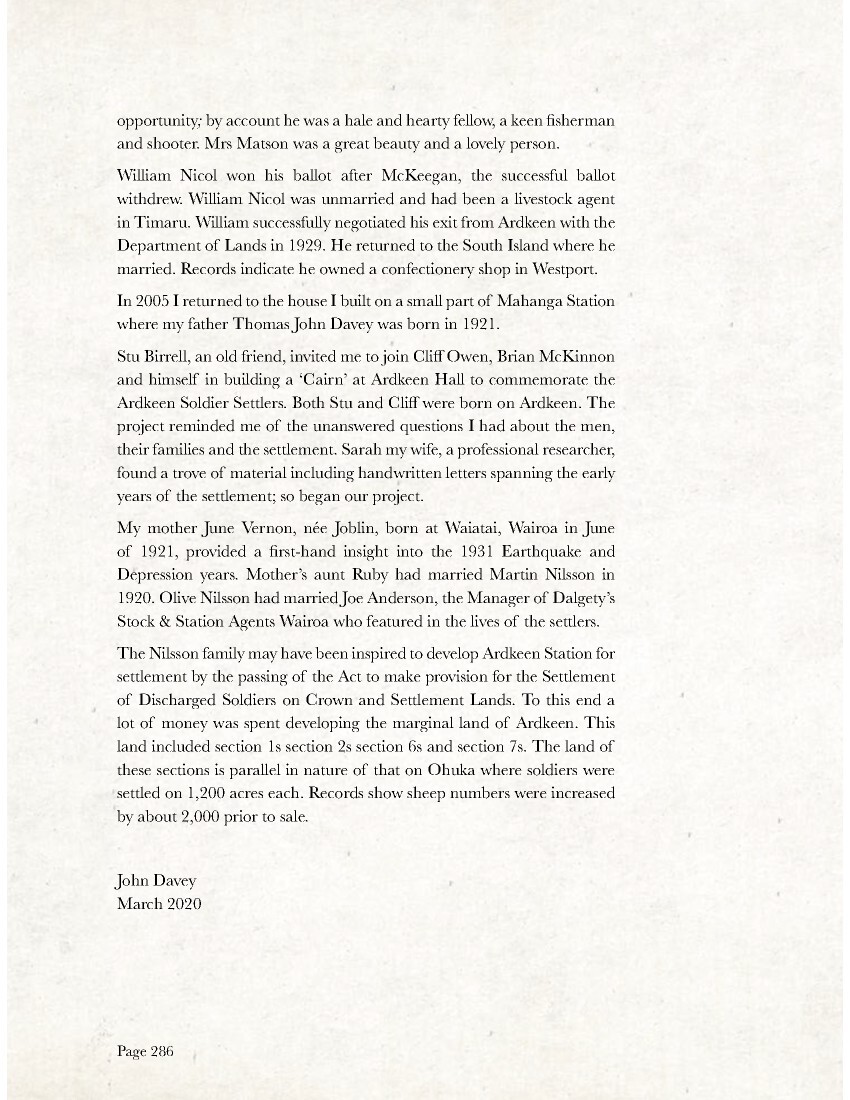
Page 287
OTHER READING
‘Proof of Gratitude Soldier Land Settlement in New Zealand After World War I’. Gould, Ashley Nevil. Massey University [https:]//mro.massey.ac.nz/handle/10179/3003
The Bridge To Nowhere : The Ill Fated Mangapurua Settlement.
By Arthur P Bate. Pub ISBN: 0473000881 Soldiers of the Mangapura [Mangapurua] by Sydney M. Perry. (Self published) 3a 9th Av Tauranga
GLOSSARY
Adjustment Commission
Commissioner of Crown Lands Department of Lands
Field Inspector
Harbour Board
Imperial – Metric:
£1 = $10 approximately as at 2020
1 shilling = 50c approx as at 2020
1 yard = 0.9144 metre
1 Chain = 20.1168
1 mile = 0.609 kilometres
1 acre = 0.4046 square metres
Land Ranger
Land Board Pocket Book
State Advances Corporation
Valuation Committee
Wairoa County Rate
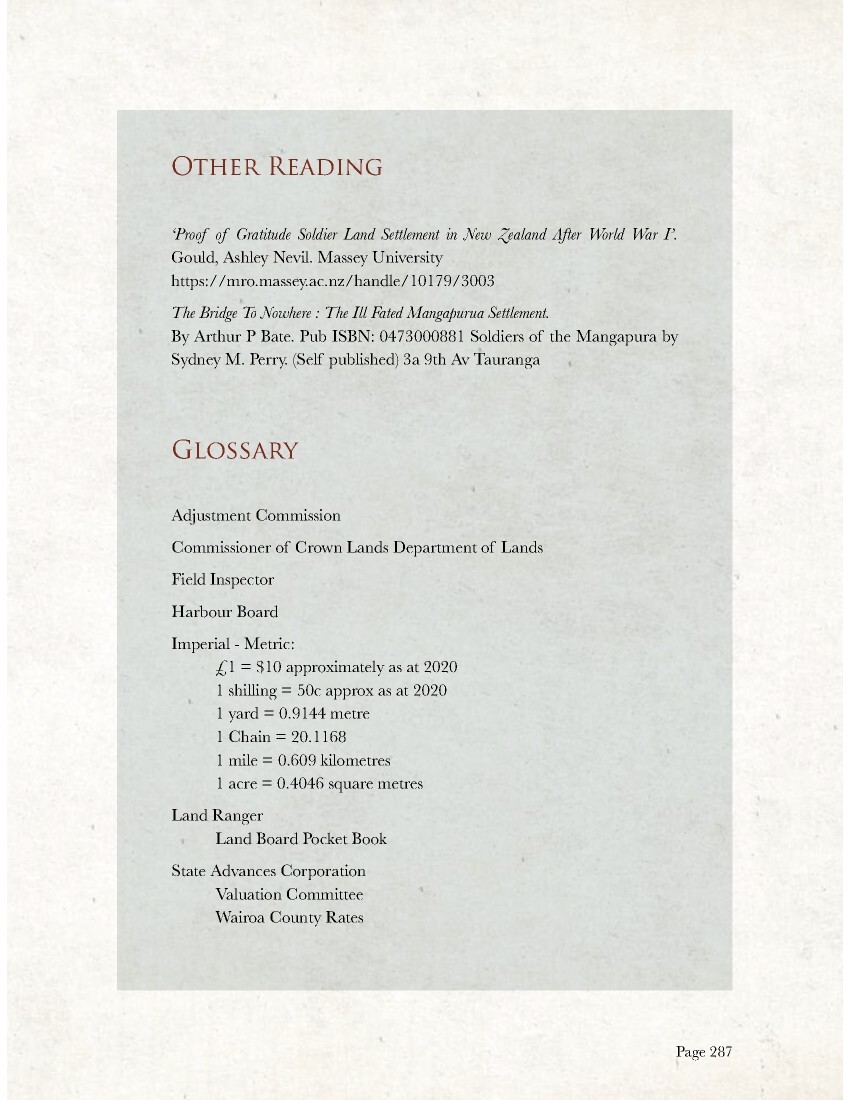
Page 288
INDEX
A
Aires, Iris 71
Aires, Ray 71, 185
Aldridge, Steve and Maree 144, 156
Allott, Roger 6, 71, 156, 172, 185
Anderson, Jennifer 7, 263
Anderson, Joe 93, 99, 180, 286
Anderson, Robert 263
Andrew, Matthew (Mattie) 36, 156, 202, 232, 238, 240, 243, 262, 270, 284
Andrew, May 284
Andrew, Roi 285
Andrew, Valerie 263
B
Baty, Jack 263
Bayly, Charles 86, 96
Bayly, Humphry 92, 95, 284
Baynes, Colin and Marg 6, 44
Beale, Robert and Fiona 71
Beddingfield, Peter 57
Birrell, Mason & Marty 6
Birrell, Oswald (Ossie) 36, 83, 155, 242, 246, 250, 252, 254, 257, 260, 262, 265, 270, 271, 272, 273, 274
Birrell, Stu 279 [plus 6, 286, see Stu Birrell]
Bostock, John 57
Bowen, John 7
Brown, Frank 144, 156
Burridge, Mark and Diane 185
Burton, George 12
C
Campbell, H. M. 93, 94
Carson, William (Bill) 36, 80, 104, 131, 139, 186, 188, 189, 190, 195, 202, 251, 265, 272, 277, 284, 285
Carter, Alison 6, 144
Carter, Bruce and Debbie 144
Carter, Tom 144
Chamberlain, Mr 261
Chapman, Neil 263
Christie, Sam 44
Clark, Reece and Jackie 71
Clifton, Earnest (Ernie) 36, 54, 55, 202, 218, 219, 220, 227, 228, 230, 231, 235, 241, 265, 266, 272, 285
Clifton, Peter 44, 236
Coates, Honourable J.G. 98
Collier, David and Julie 83
Corney, Terry 57, 71
Cotter, John 7
Cotter, Ra 7
Crawshaw, Grant and Sue 6, 57, 71
Cricklewood Station 20
Cullen MP, Mr 261
D
Dalgety’s Stock & Station Agents 286
Davey, Frances 263, 284
Davey, John 279
Davey, June 263
Davey, Thomas John (Tom) 79, 92, 263, 284, 286
Davey, Zoe 284
Davies, Mr R. 129
Denton, Ian 185
Dever, Tom 44, 107
E
Ekberg, Elina 21
Elliot, Isobel (nee Turnbull) 15, 17
Elliot, William 15, 16, 17, 18, 20
Elwin, W. M. (William) 152, 154
F
Fahey, G.A. 153
Farney, Mr. E.H. 80
Flood, Maurice and Annie 263
Fraser, Bevan and Sandy 263
G
Gardiner, A.L. 35
Gould, Dr Ashley 6
Goullet, Felix 12
Green, Mr E. J. 154
Greenslade, Liz 7
Grooby, Jill 6
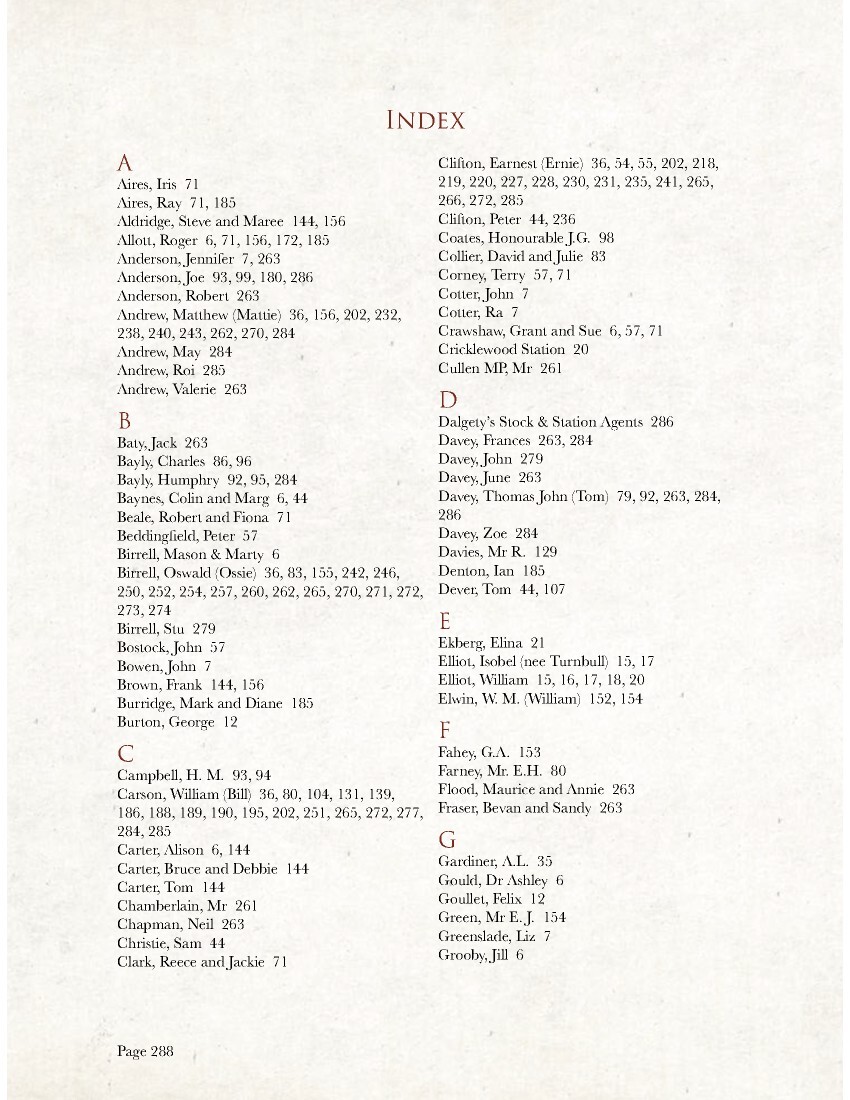
Page 289
H
Hall, Mr T. 48
Hangaroa River 12, 13
Harbour Board Reserve Bush Block 285
Harker, Mayor H.L. 279
Harley, Leonard Jack 129
Harrison Snow, Ross 6
Hauhau Pai-Marire 12
Hawke’s Bay Farmers Co-op 112, 113, 115, 117, 118, 161, 162, 168, 171, 221, 228, 230, 231, 252, 253
Henry Williams and Son builders 219
H. M. Yacht Britannia 90
Holden, Andrew and Caroline 6, 71, 83
Hoyle, Theresa 156, 172
J
Jackson, Captain Cranworth Franklyn 36, 40, 43, 84, 85, 86, 87, 90, 95, 103, 110, 115
Jackson, Mrs Margaret 93, 96, 97, 98, 99, 102, 105, 106, 107, 265, 272, 273, 279, 284
James, Ossie G. 151, 152, 272
James, Raymond 36, 48
Jardine, Dr 129
Jerram, Bill 83
Jones, Brian and Lynn 6, 57, 71
K
Karaka, Mere 13
Kauhauroa Stream 12
Kelt, John and Sue 185
Kemp, Tony and Jenny 57
Kerley, Martin 185
Kopu, Chief Pitihera 12, 13
L
Lacroix, Father 49
Lake Waikaremoana 12, 13
Lane, Gustave 199
Levy, Mr. 162
Little, Craig 7, 185
Little, Jack and Joan 83
Little, Jan 185
Little, John Allenby (Jack) 82
Little, Judy 214
Little, Rob and Wendy 83, 263
Little, Scott 214
Little, William (Dinty) 6, 44, 214
Locke, Samuel 13
Logan, John and Heather 57
Lyall, Bert 44
Lyall, Hugh 44
M
Mackay, Alex and Sue 263
Malone, Maurice Patrick 36, 124, 126, 128, 129, 131, 132, 138, 150, 153, 154, 198, 285
Malone, Moana 129, 131, 138
Malone, Sydney 162
Mangaaruhe River 11, 16
Mangapoike Stream 12
Manutawhiorangi 11, 12, 15, 16, 17, 20, 77
Marsh, W. F. 30
Martin, Jean and John 185, 195
Martin, Mr Arthur 48
Matson, Percy Jonas 36, 38, 41, 42, 43, 91, 110, 114, 266, 285
Maxwell, Airlie 6, 123, 144
Maxwell, Douglas 123
Maxwell, Doug Snr 123, 195
McConnachie, Jason 71, 263
McFarlane, Mary Eliza 20
McKay, Bill 150, 151, 257, 272
McKay, Hugh 150
McKay, William John 36, 64, 138, 146, 149, 150, 153, 154, 155, 162, 285
McKeegan, Mr C. W. 198
McKinnon, Brian 279, 286
McKinnon, Helen 6, 274
McKinnon, John and Yvonne 7, 195
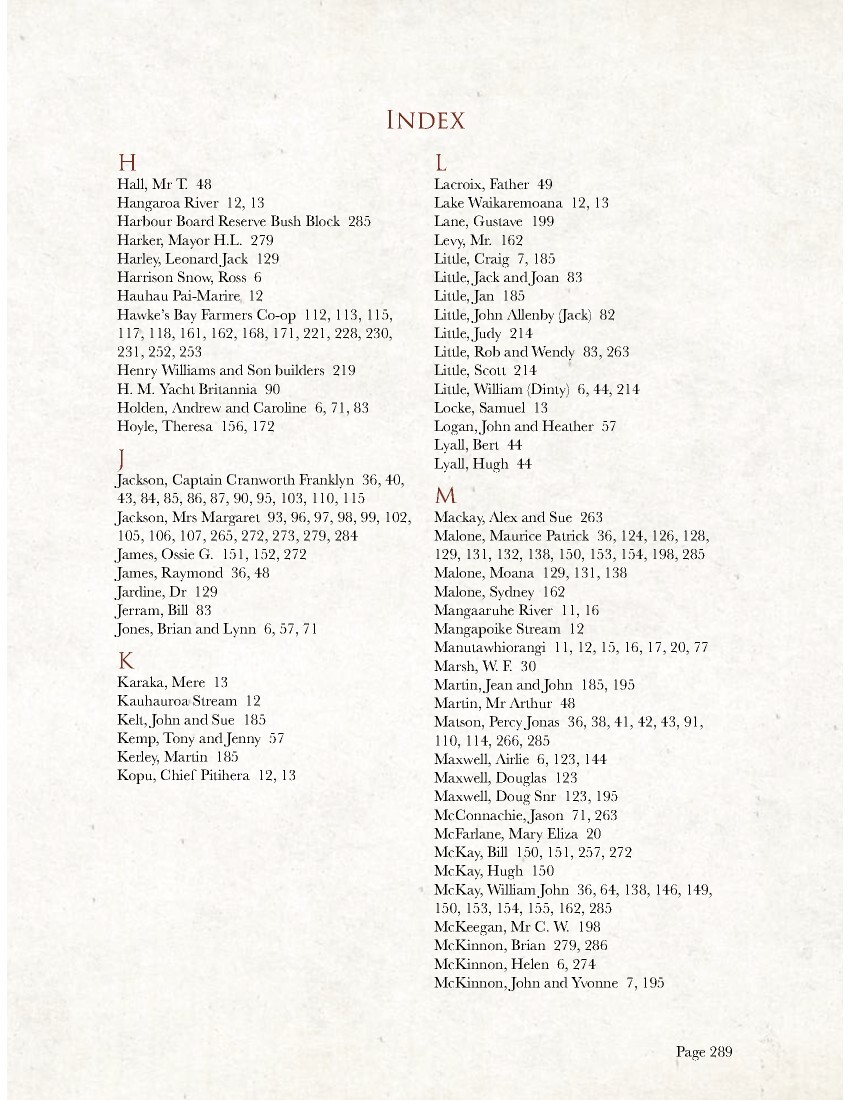
Page 290
McLagan, Malcolm 6
McLagan, Malcom and Stewart 195
McLagan, Mrs 185
McLagan, Murray 57, 185
McLagan, Sheena 57
McLean, Donald 41, 106, 108, 156
McLean, Jim 36, 41, 92, 103, 104, 108, 110, 111, 112, 113, 114, 115, 116, 117, 118, 120, 122, 123, 139, 141, 144, 156, 265, 267, 273, 285
McLean, Mr 13
McNabb, Sherayl 7
McRae, Mr Farquhar 36, 136
Meagher, Frank 46, 48, 55, 114, 266, 285
Meagher, Jim 48, 52, 54, 55, 57, 265, 272, 277, 285
Meagher, J. R. 198
Meagher, Mr J. F. 50
Meagher, Raymond James 36
Morunga, Scott & Rebecca 263
Mullany, Mr 48
Munro, Dennis 7, 9
N
Narey, Annabelle 7
Nicol, William Harold 36, 48, 196, 198, 199, 200, 201, 202, 286
Nielsen, Jens 21
Nilsson, Kjersti 21
Nilsson, Magnus 20, 93, 253
Nilsson, Martin 20, 281, 286
Nilsson, Olive 286
Nilsson, Oscar 20
Nilsson, Ruby 286
Nolan, Mr. 64, 79, 94
Norris, Mr. F. 81
O
Ohuka Station 17, 20
O’Kane, Mrs. Genevieve 77
O’Kane, Patrick (Paddy) 36, 80, 82, 83, 152, 178, 251, 272, 273, 285
O’Malley, Mr G. M. 151, 152, 153, 154
O’Neil, David Edward 17, 20
O’Neil, Henry James 17,
Orbell, Florence 90
Owen, Cliff 279, 286
Owen, Doreen 7
Owen, Graham and Fiona 71
Owen, Harry 172
Owen, Jack 36, 44, 150, 154, 155, 158, 160, 162, 167, 169, 170, 171, 208, 226, 251, 260, 265, 272, 277, 284
Owen, Leita 172
P
Paget, Dr 126, 130, 138
Palmer, Susan 7
Powdrell, Jefferson and Amanda 144, 156
Prestage, Bill and Fiona 6, 156, 172
Preston, Bob 36, 57, 65, 176, 178, 180, 181, 182, 183, 185, 190, 195, 202, 251, 265, 272, 273, 284
R
Ranson, Mr. E. A. 98
Redmond, Chris 7
Reid, Nicky 71
Revington, Ann 7
Robertson, Alice 71
Robertson, Dave 36, 57, 58, 60, 71, 251, 273, 284
Robertson, D. G. 51, 54, 113, 141, 163, 167, 182, 189, 198, 220, 227, 228, 232, 259, 266
Robertson, D. H. 198, 260
Robertson, Dorothy 284
Robertson, Jock 71
Robinson, Dave 151
Robinson, Norm 7
Rofe, Neville 185
Ruakituri River 12
Ryan, Rupert 7
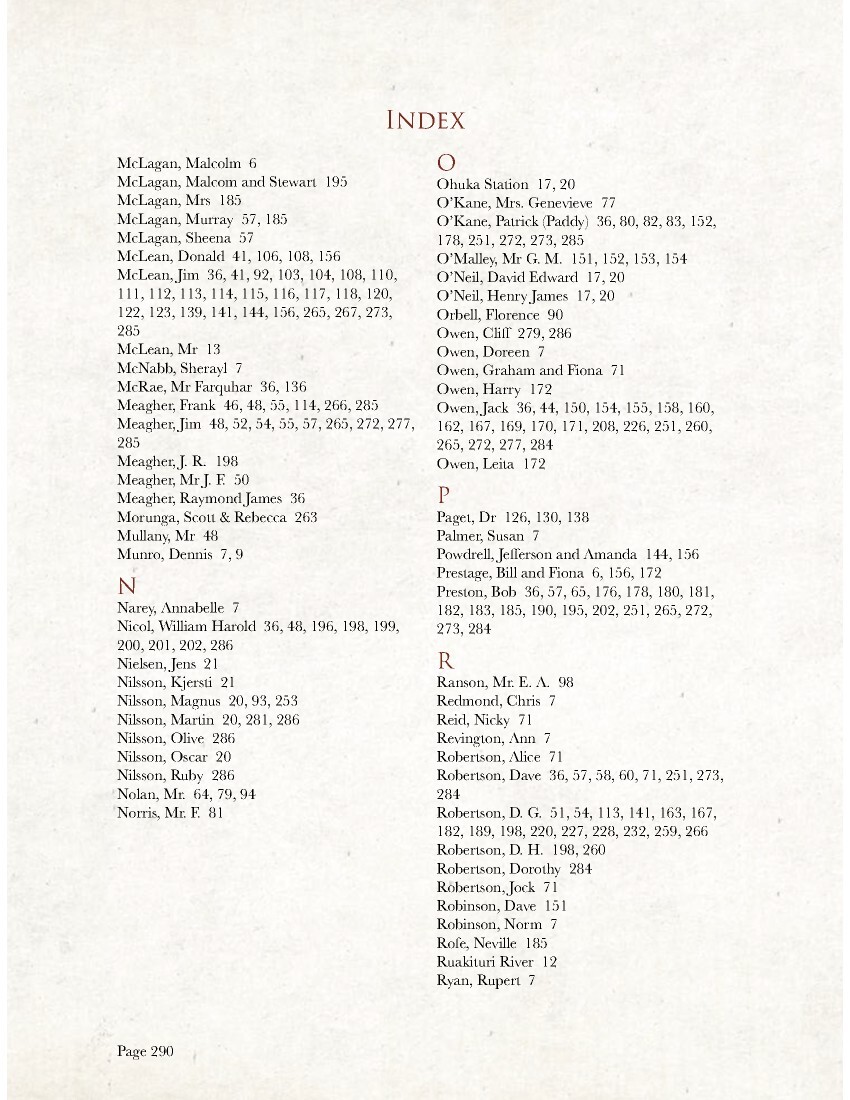
Page 291
S
Scott, Mike and Lynda 71
Simmons, Barry 44
Simpson, James 153
Smith, Conrad 57
Smith, Sonya 83, 263
Somerville, Dr 48 1, 214, 265, 273, 285
S.S. Mararoa 18
Steed, Alan 156
Steed, Jeanette 6, 156
Steele, Harry 20
Steven, Mr Dick 230
Straphell, Mr 13
Stu Birrell 6, 286 [plus 279, see Birrell, Stu]
Swann, Donna 6
Swann, Ivan 57, 172
Symons, Lieutenant-Colonel 87
T
Taafe, Mr 198
Taylor, Bill 144, 277, 284
Taylor, William Bryan 143
Thompson, Chris and Anne 263 T
Thomsen, Chris and Tabby 83
Tolme, Jim 36, 104, 114, 115, 123, 131, 134, 136, 137, 138, 139, 140, 141, 144, 150, 156, 241, 251, 265, 272, 273, 284
Tuke, R. C. 268
V
Vernon, June 7, 286
Vette, Kevin and Anne 195
W
Wade, Sergeant 48
Waiau River 11, 12, 13, 15, 16, 17, 48, 111, 258
Waikaretaheke River 11, 12, 13
Wairoa County Council 15, 17, 41, 49, 78, 224, 266, 267, 268
Wairoa Electric Power Board 139
Wallace, Richard and Harmony 6, 156, 236, 245
Wealleans, Monica 263
Wealleans, Tim 263
Webster, Audry 274
Westcott, Ray 57
Williams & Kettles Co. Ltd. 150, 201
Wills, Bill 2
Wolters, Martin 83, 263
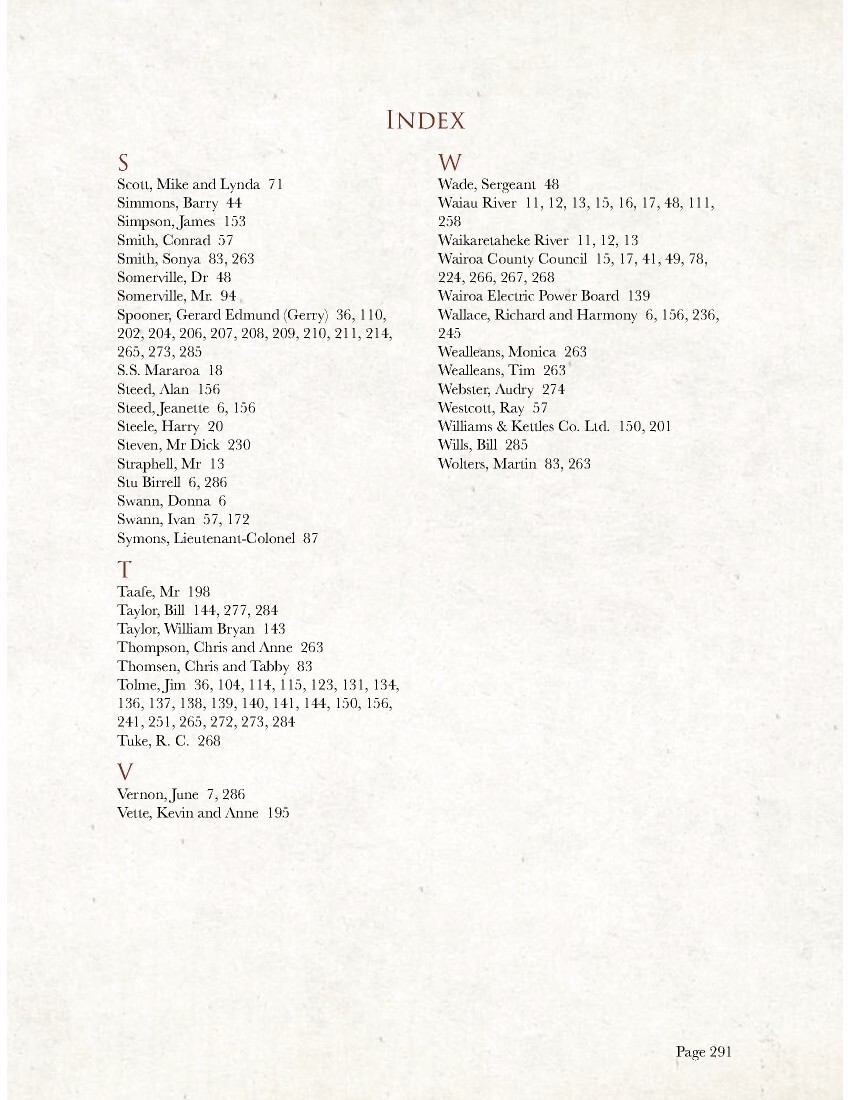
Page 292
REFERENCES
Archives New Zealand Te Rua Mahara O Te Kawanatanga.
Alexander Turnbull Library.
Knowledge Bank Hawke’s Bay.
Kōpututanga Taonga o Te Wairoa Museum.
National Library of New Zealand (Te Puna Mātauranga o Aotearoa).
Papers Past.
‘Proof of Gratitude Soldier Land Settlement in New Zealand After World War I’. Gould, Ashley Nevil. Massey University (1992).
Salute Wairoa WW1 Touch Table.
The Story of Old Wairoa and the East Coast District of New Zealand, Lambert, Thomas. Reed Publishing (1925).
The Wairoa Star.
Wairoa County Council – the first Hundred Years (1978).
Wairoa District Council Archive
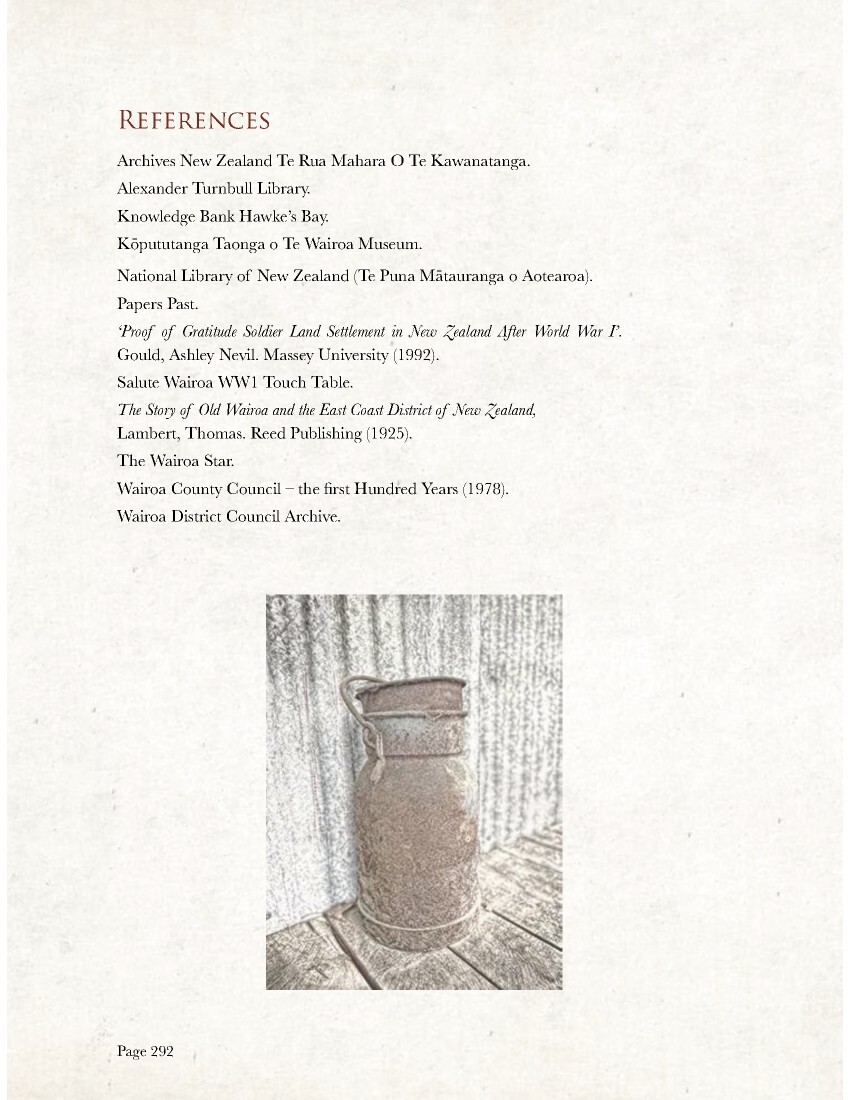
Non-commercial use

This work is licensed under a Attribution-NonCommercial 3.0 New Zealand (CC BY-NC 3.0 NZ).
Commercial Use
Please contact us for information about using this material commercially.Can you help?
The Hawke's Bay Knowledge Bank relies on donations to make this material available. Please consider making a donation towards preserving our local history.
Visit our donations page for more information.
Description
Surnames in this book –
Aires, Aldridge, Allott, Anderson, Andrew, Baty, Bayly, Baynes, Beale, Beddingfield, Birrell, Birrell, Bostock, Bowen, Brown, Burridge, Burton, Campbell, Carson, Carter, Chamberlain, Chapman, Christie, Clark, Clifton, Coates, Collier, Corney, Cotter, Crawshaw, Cullen, Davey, Davies, Denton, Dever, Ekberg, Elliot, Elwin, Fahey, Farney, Flood, Fraser, Gardiner, Gould, Goullet, Green, Greenslade, Grooby, Hall, Harker, Harley, Harrison Snow, Holden, Hoyle, Jackson, James, Jardine, Jerram, Jones, Karaka, Kelt, Kemp, Kerley, Kopu, Lacroix, Lane, Levy, Little, Locke, Logan, Lyall, Mackay, Malone, Marsh, Martin, Matson, Maxwell, McConnachie, McFarlane, McKay, McKeegan, McKinnon, McLagan, McLean, McNabb, McRae, Meagher, Morunga, Mullany, Munro, Narey, Nicol, Nielsen, Nilsson, Nilsson, Nolan, Norris, O’Kane, O’Malley, O’Neil, Orbell, Owen, Paget, Palmer, Powdrell, Prestage, Preston, Ranson, Redmond, Reid, Revington, Robertson, Robinson, Robinson, Rofe, Ryan, Scott, Simmons, Simpson, Smith, Somerville, Steed, Steele, Steven, Straphell, Swann, Symons, Taafe, Taylor, Thompson, Thomsen, Tolme, Tuke, Vernon, Vette, Vette, Wade, Wallace, Wealleans, Webster, Westcott, Wills, Wolters
Subjects
Format of the original
Book hardbackDate published
2021Creator / Author
- John Davey

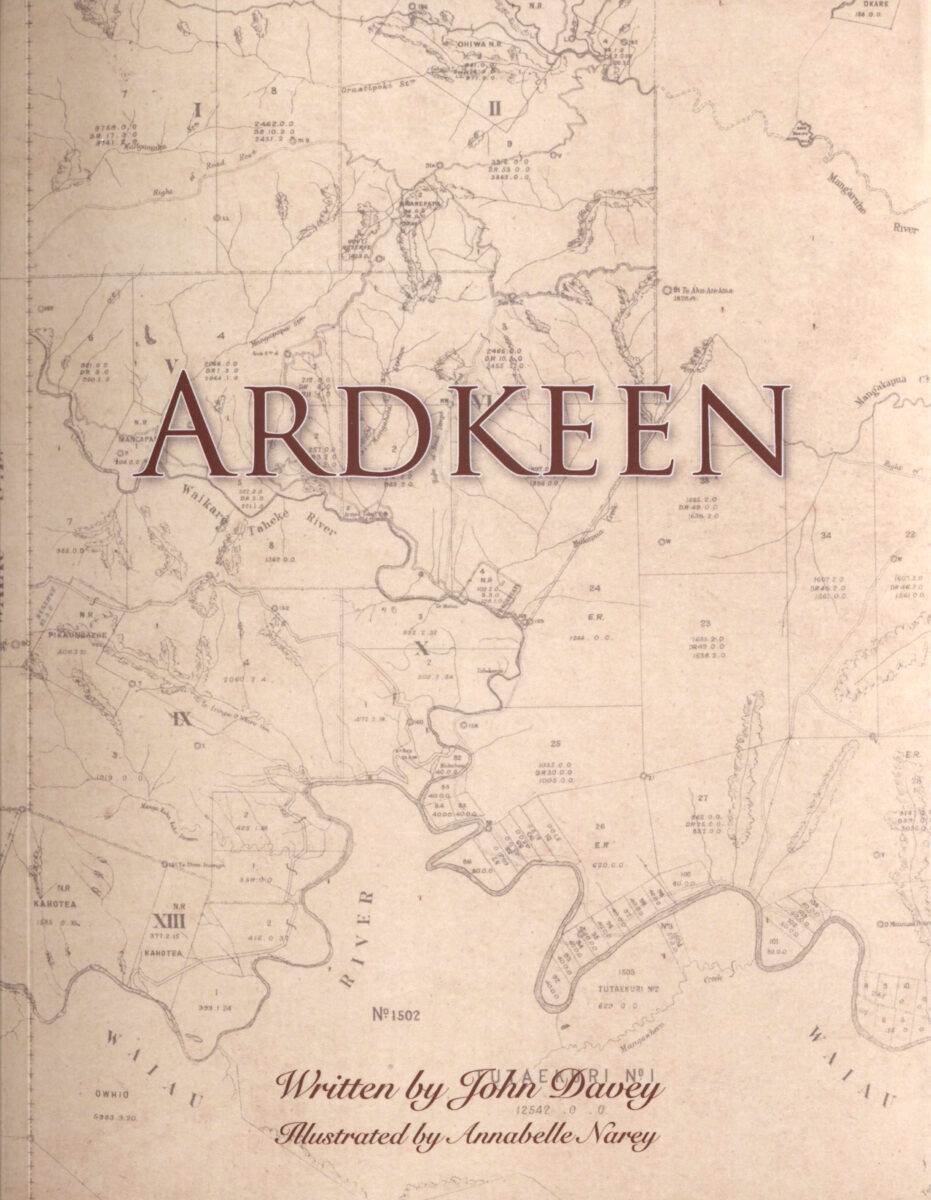
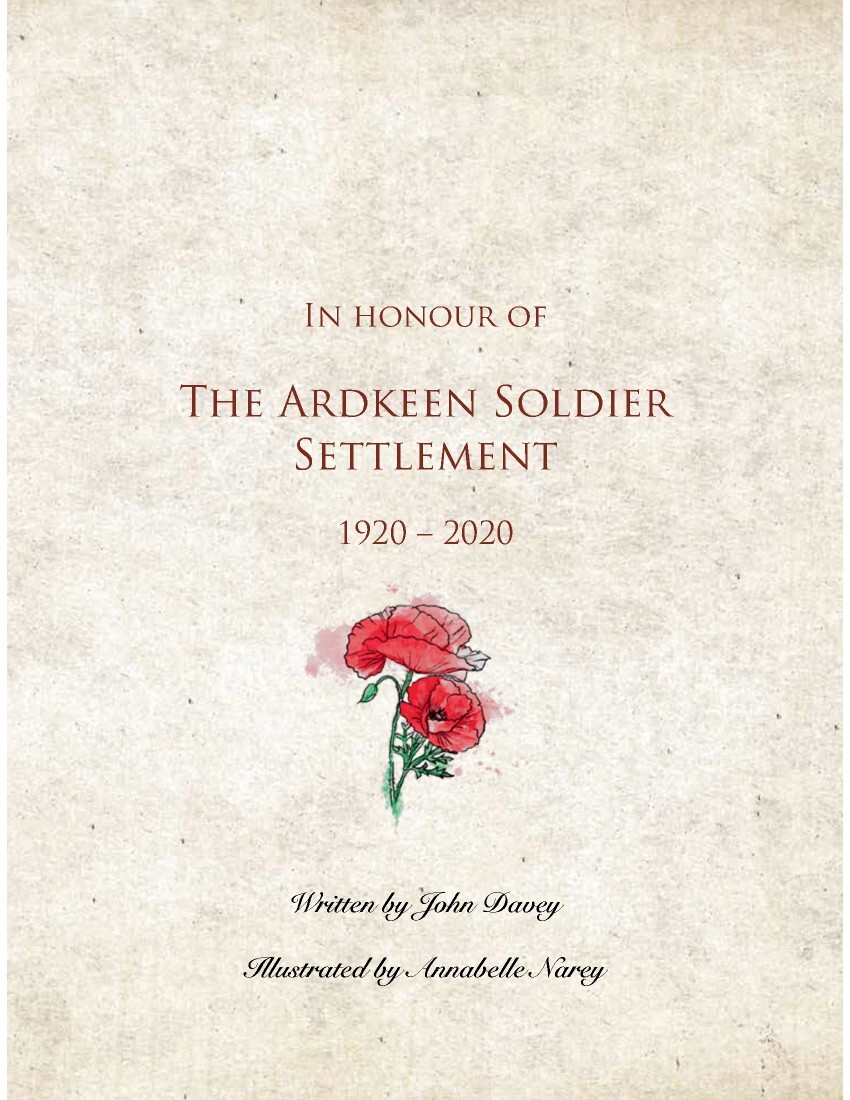
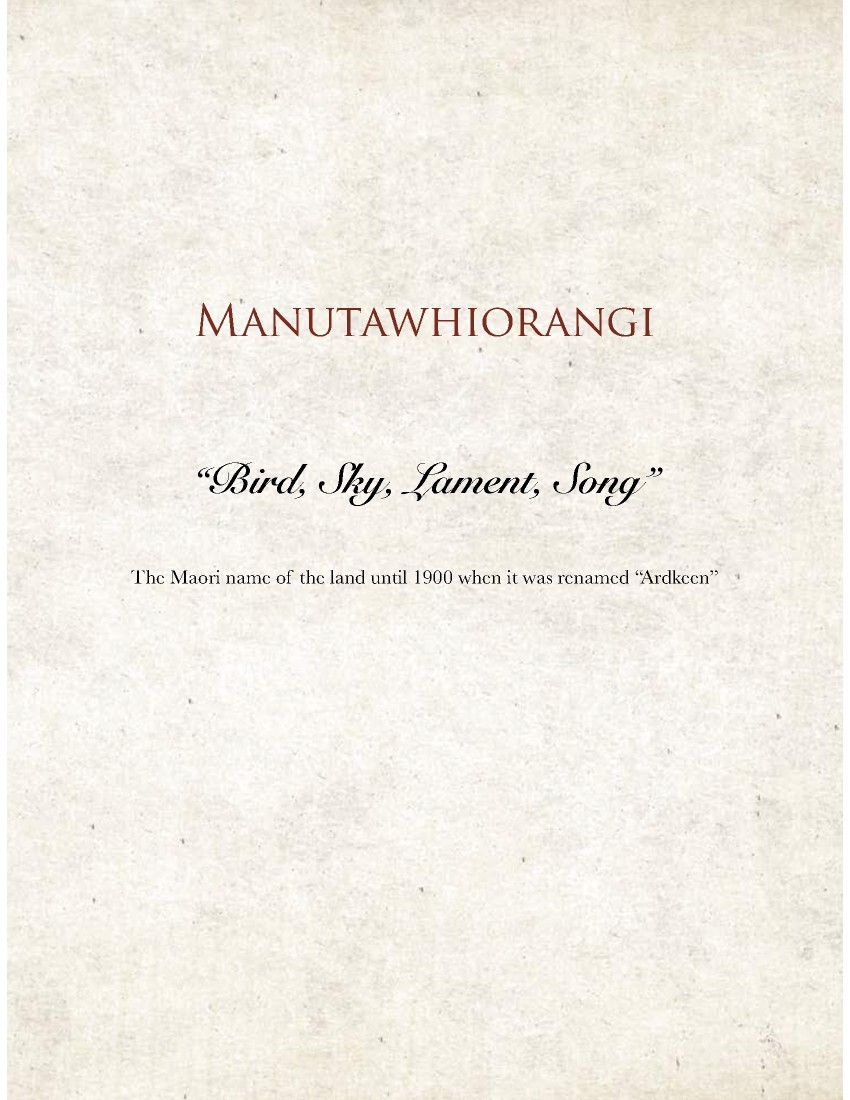
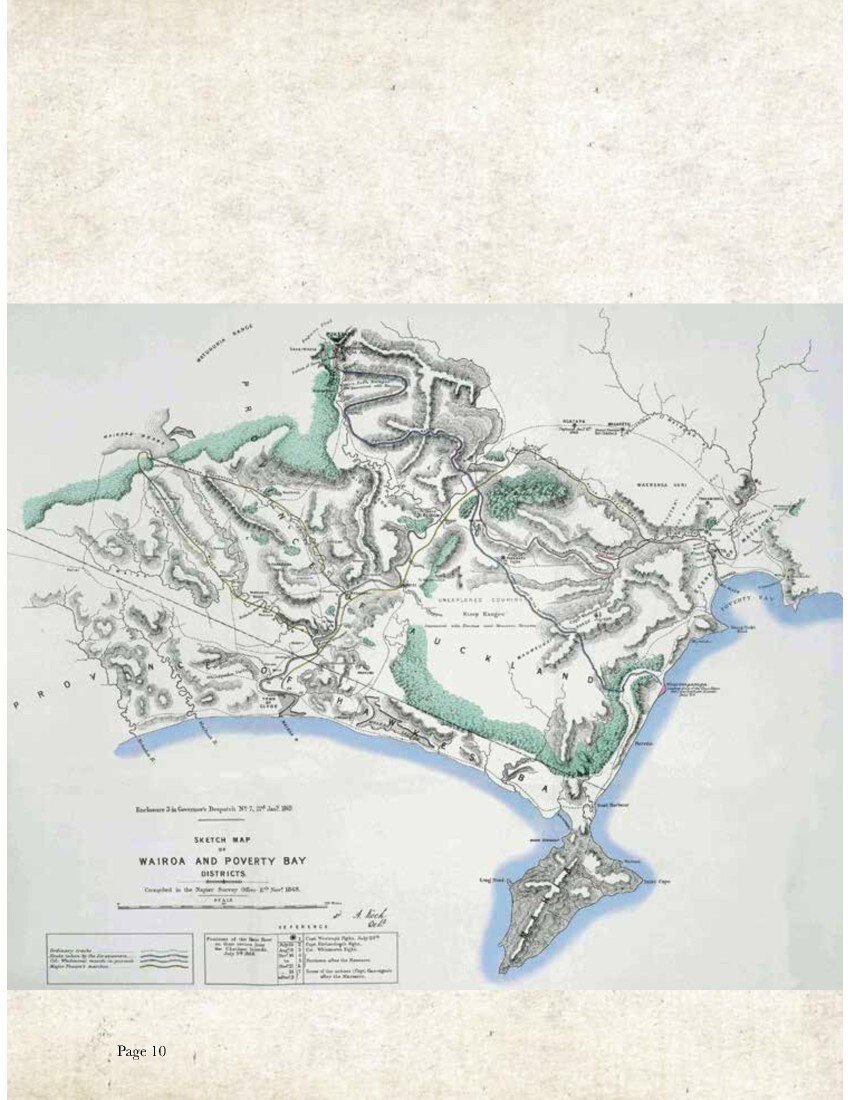

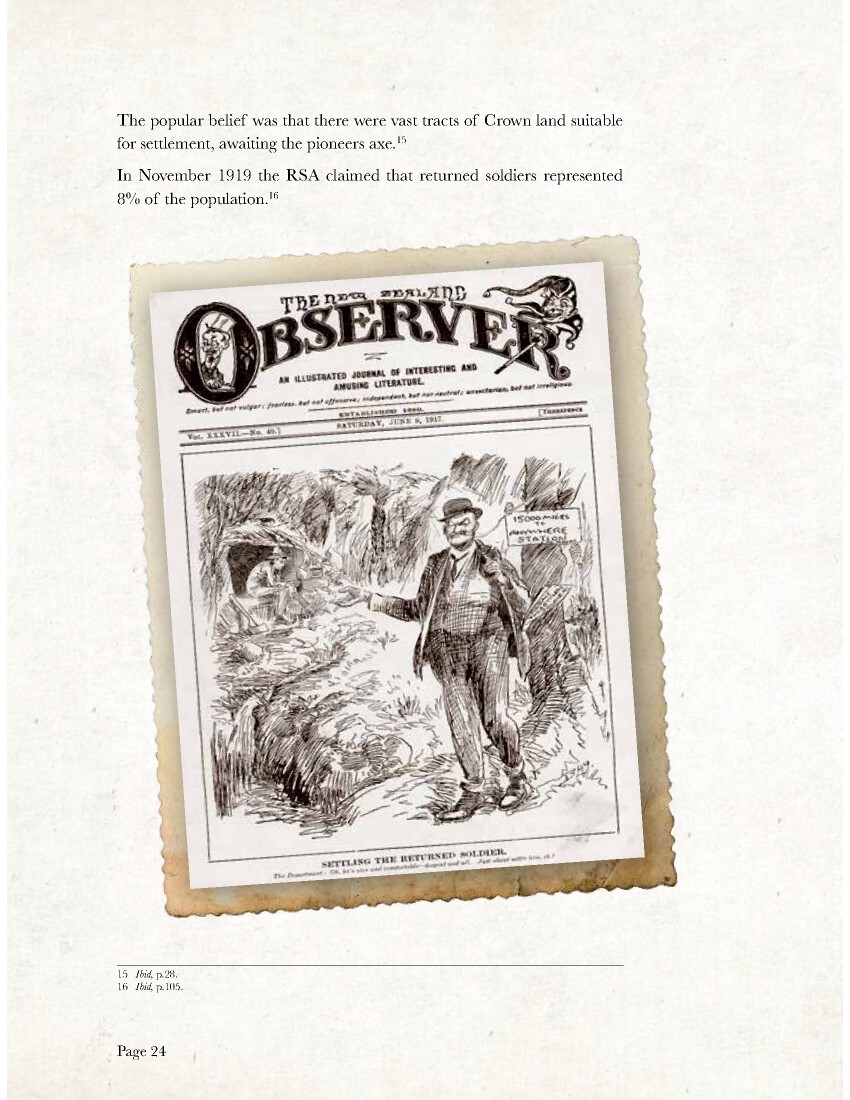
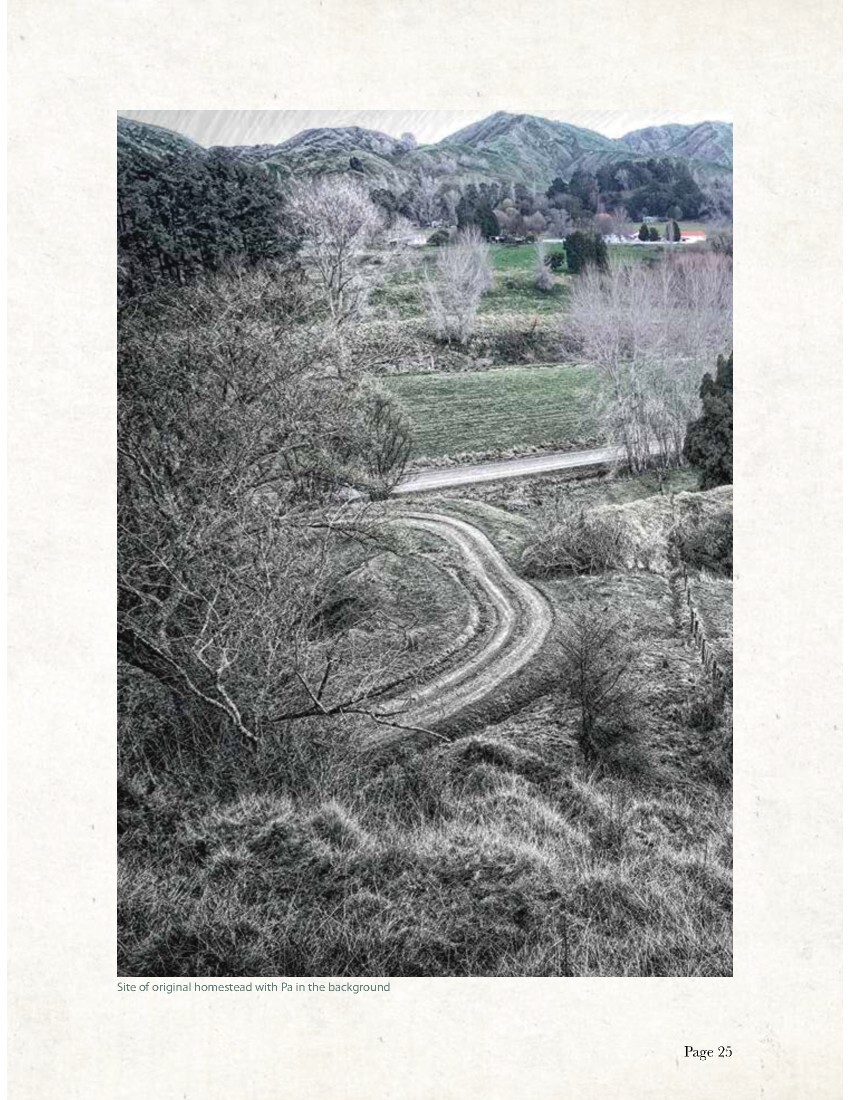

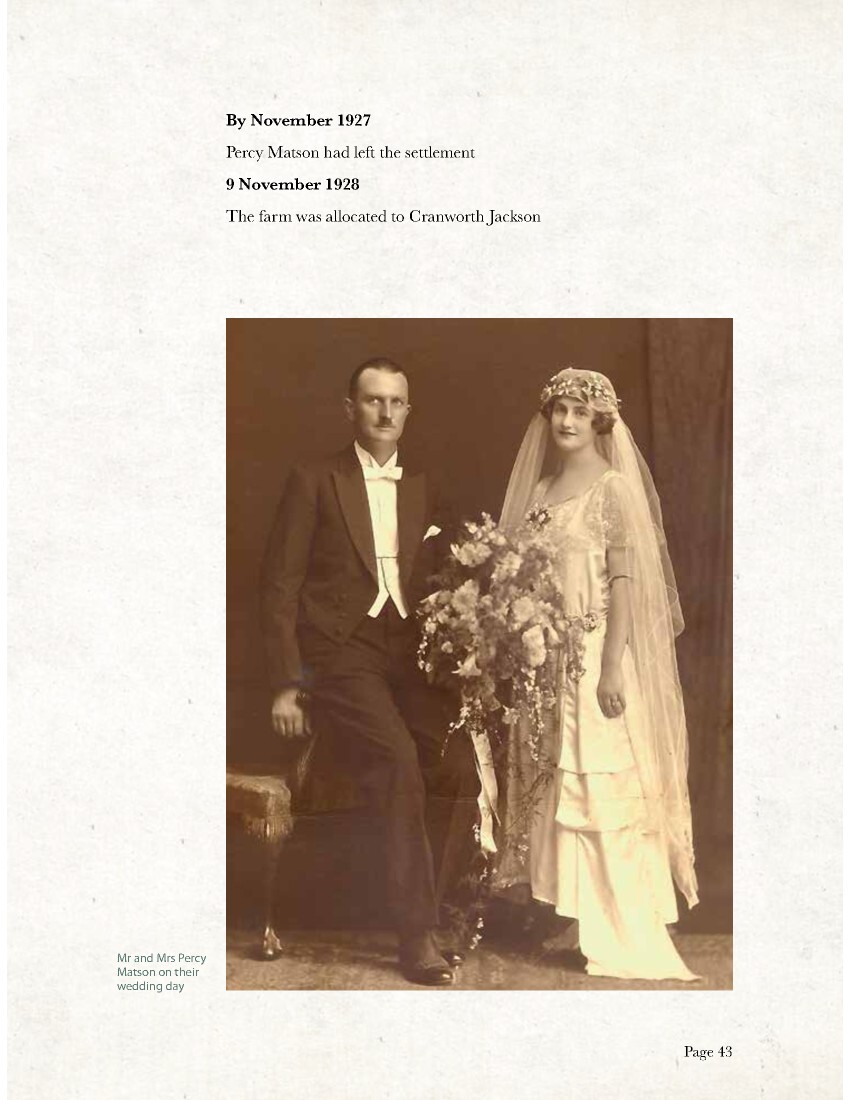

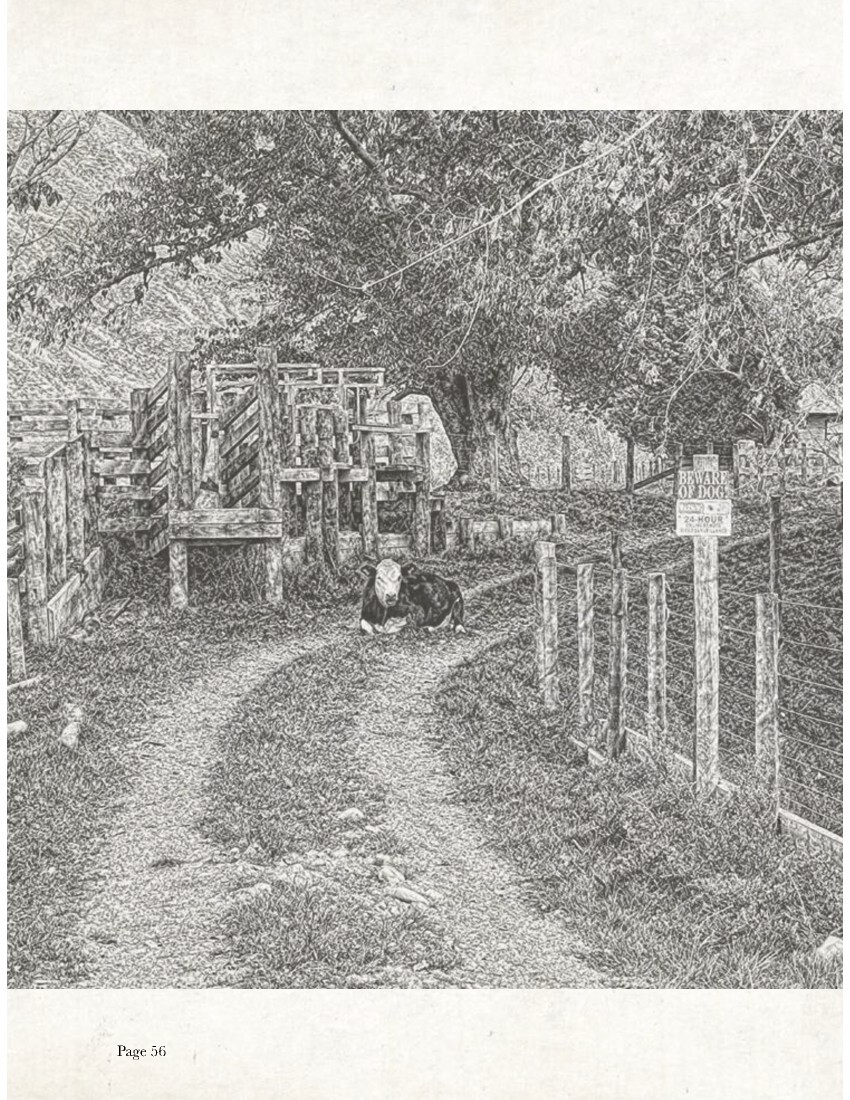
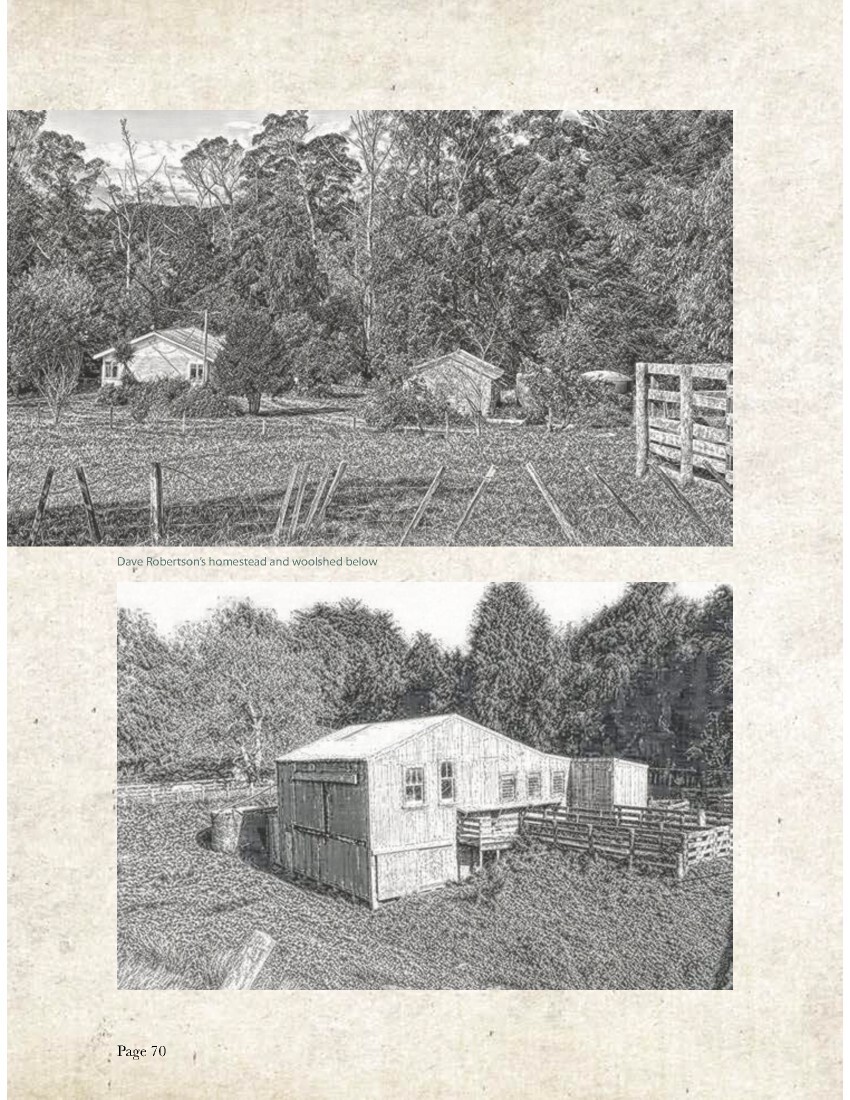
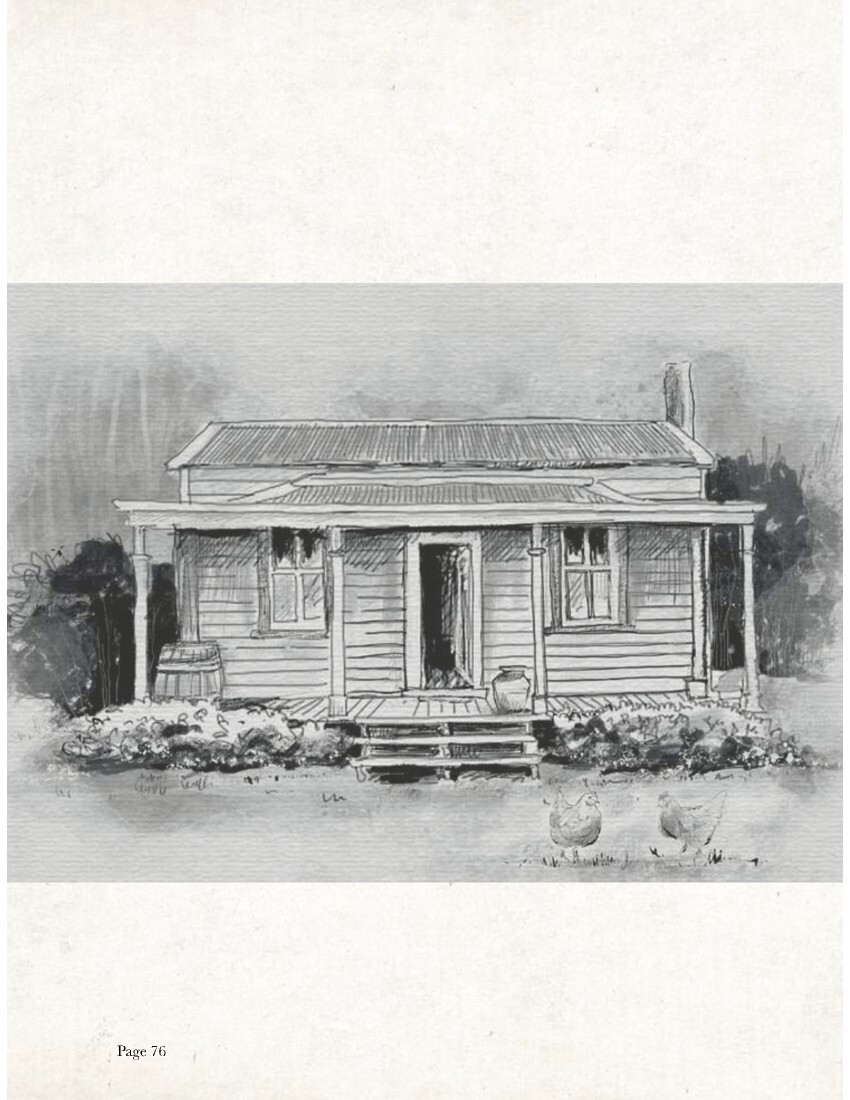
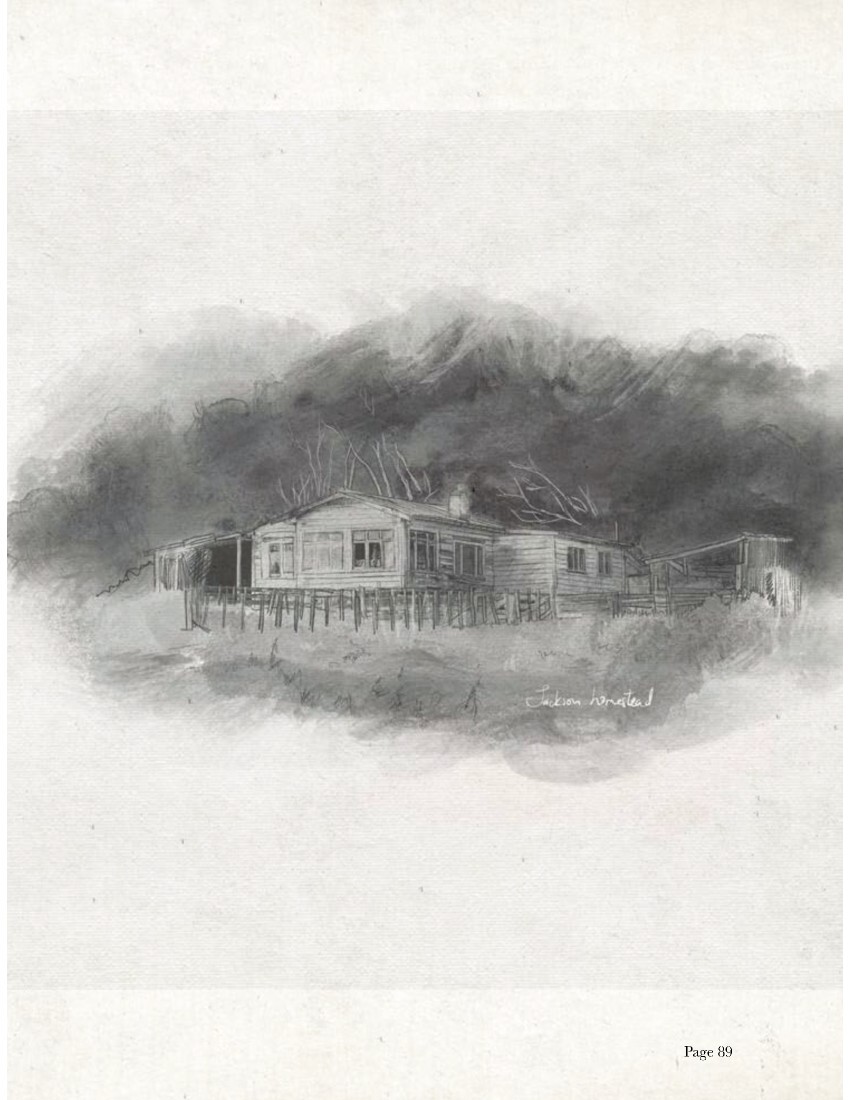
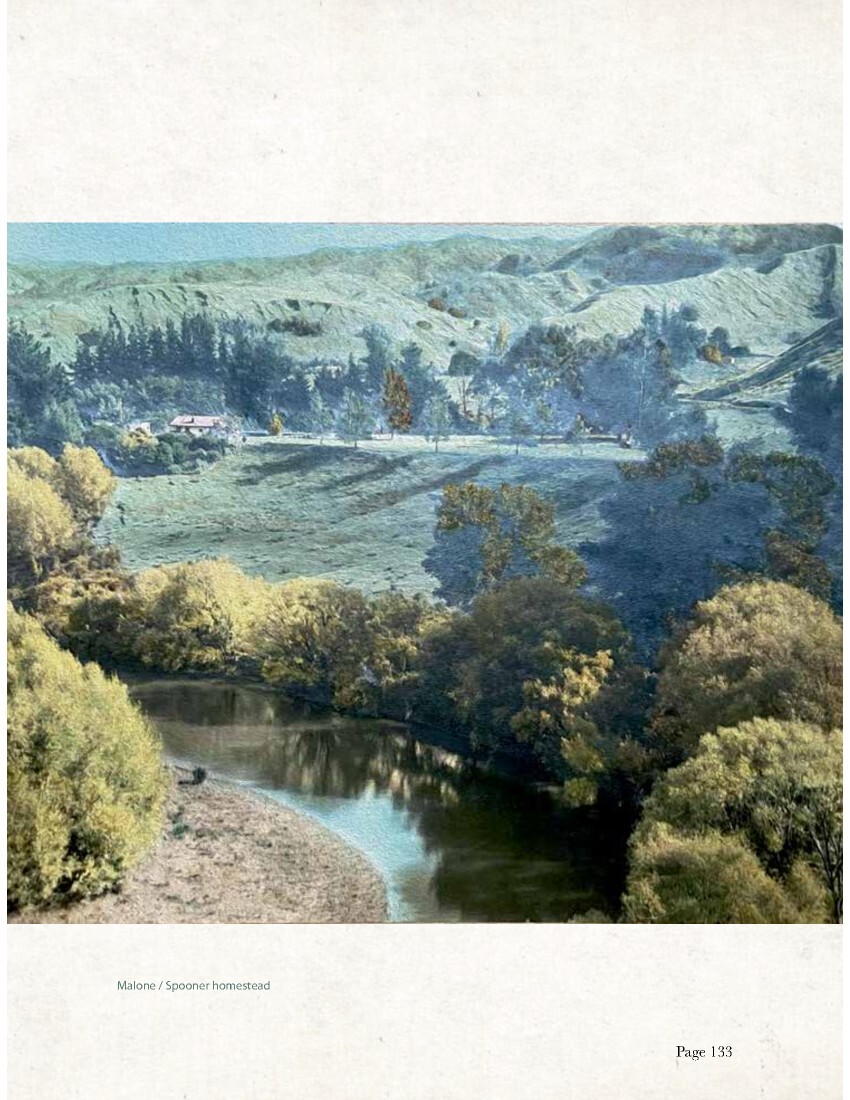

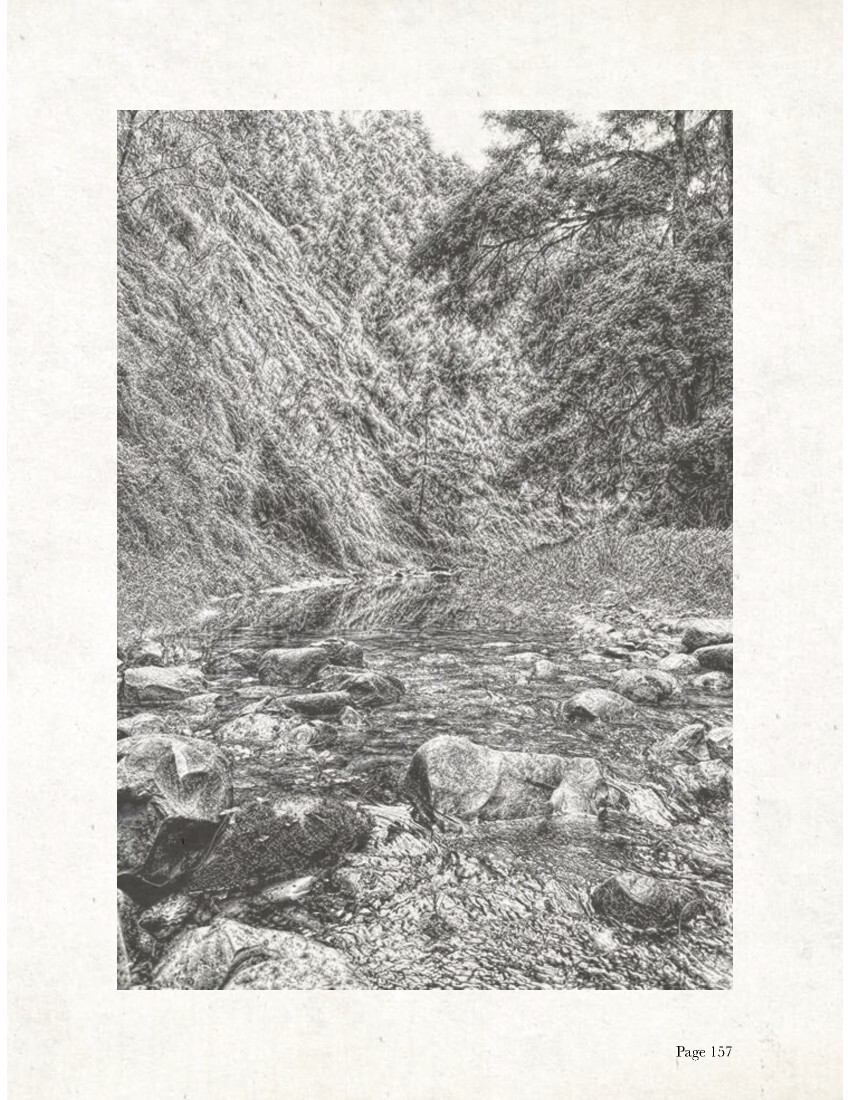

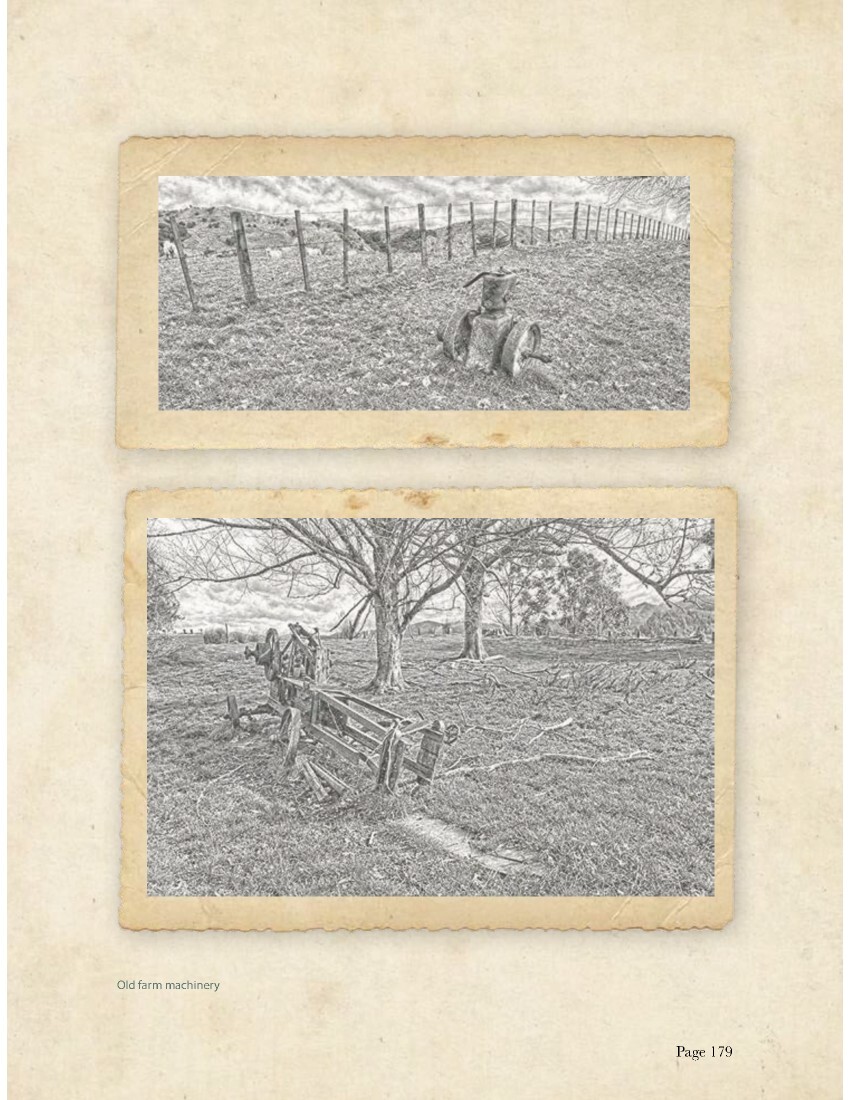
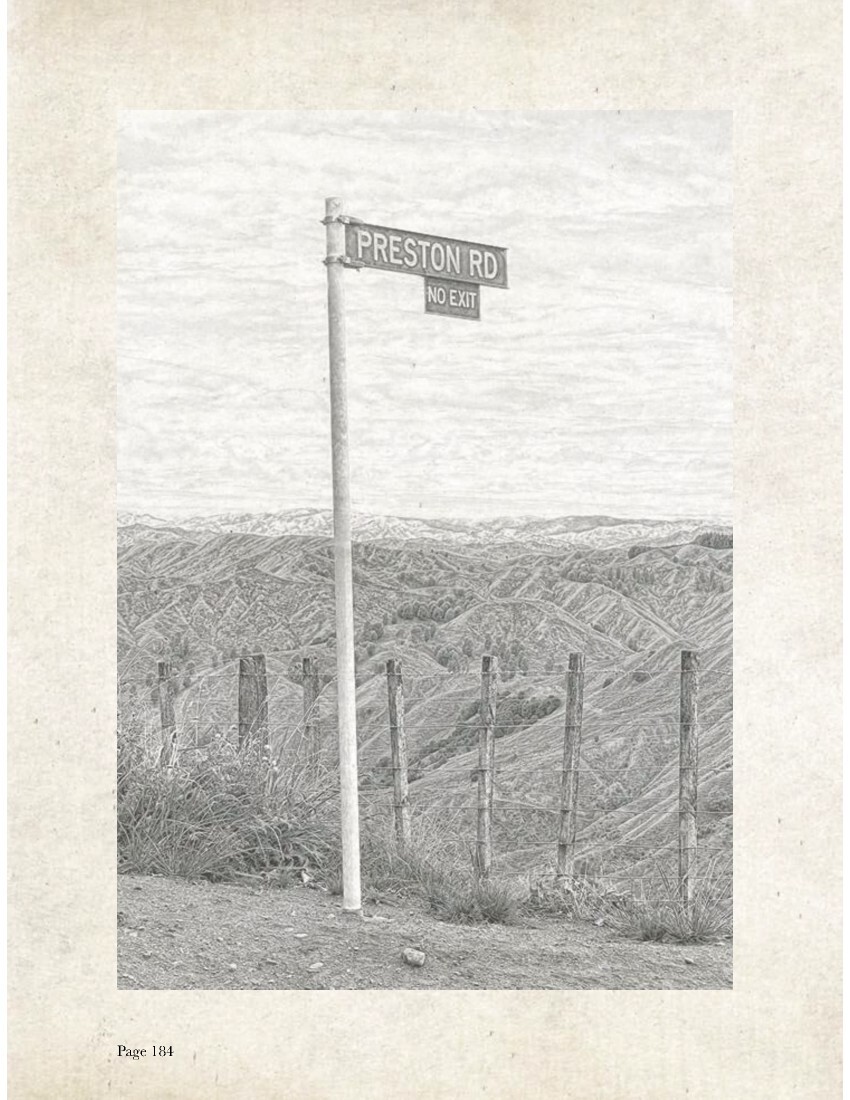


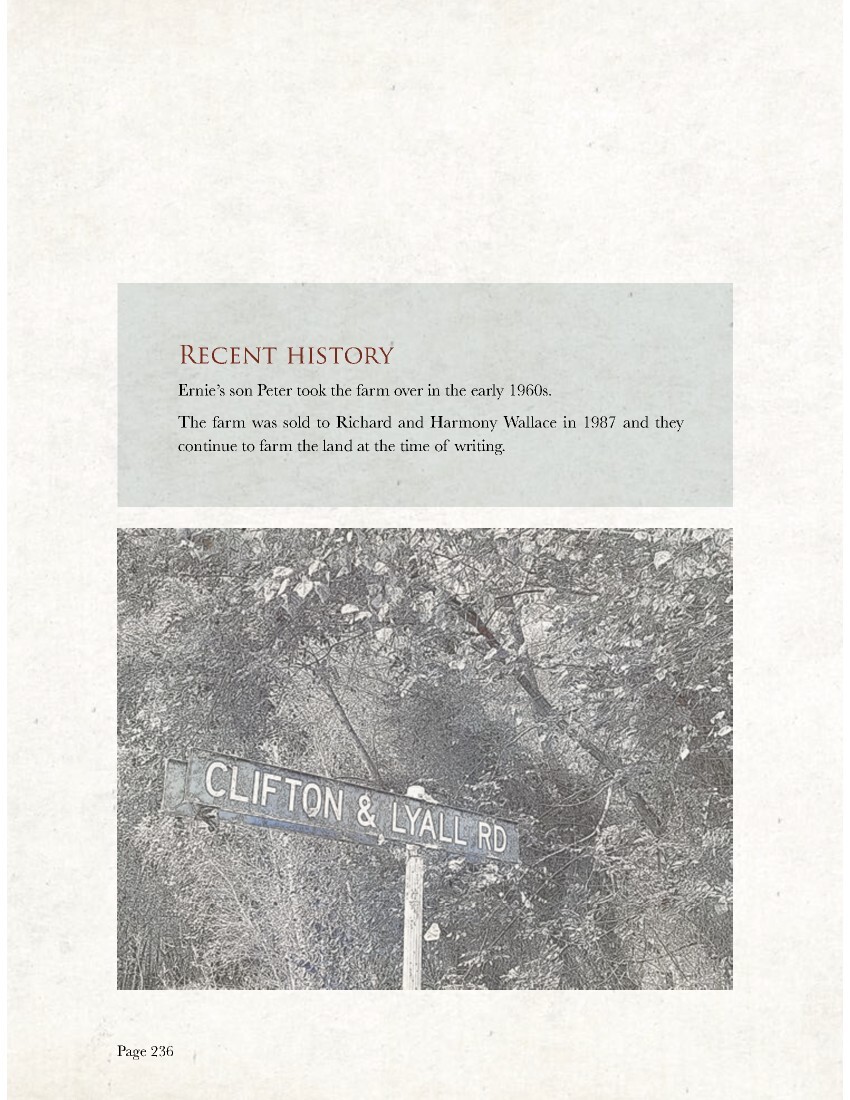
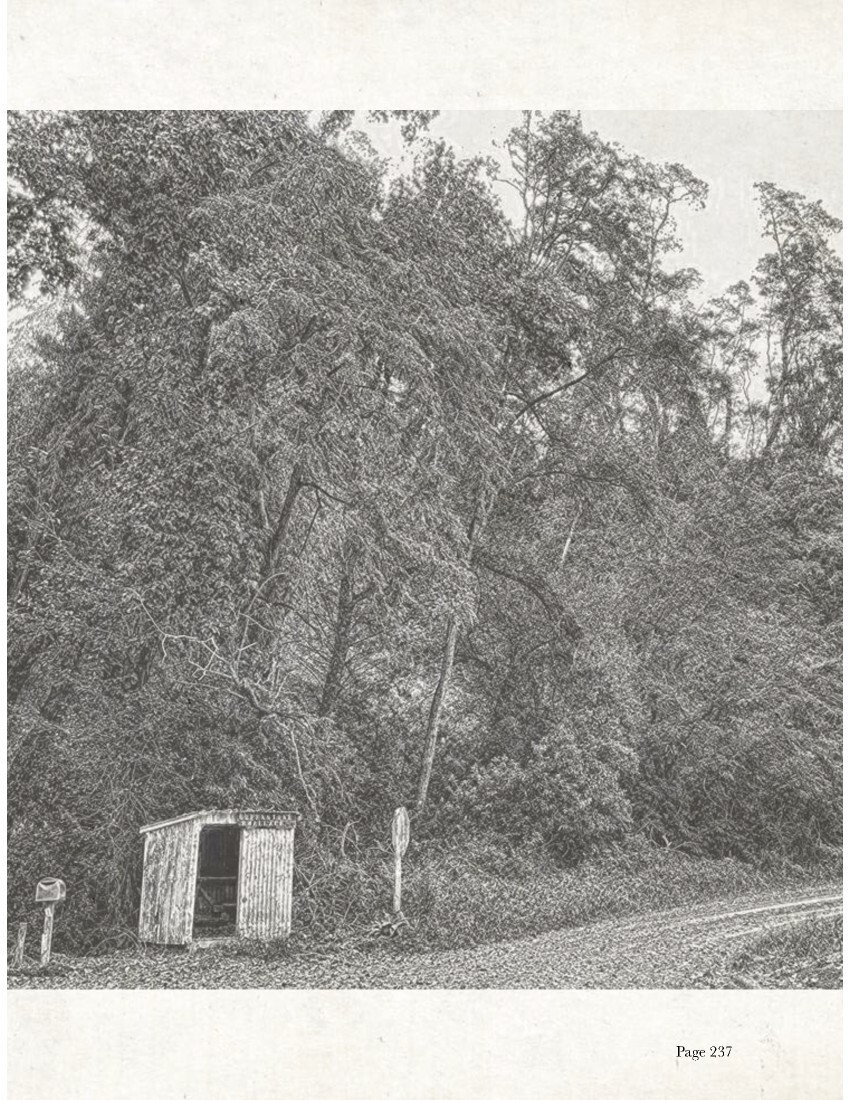
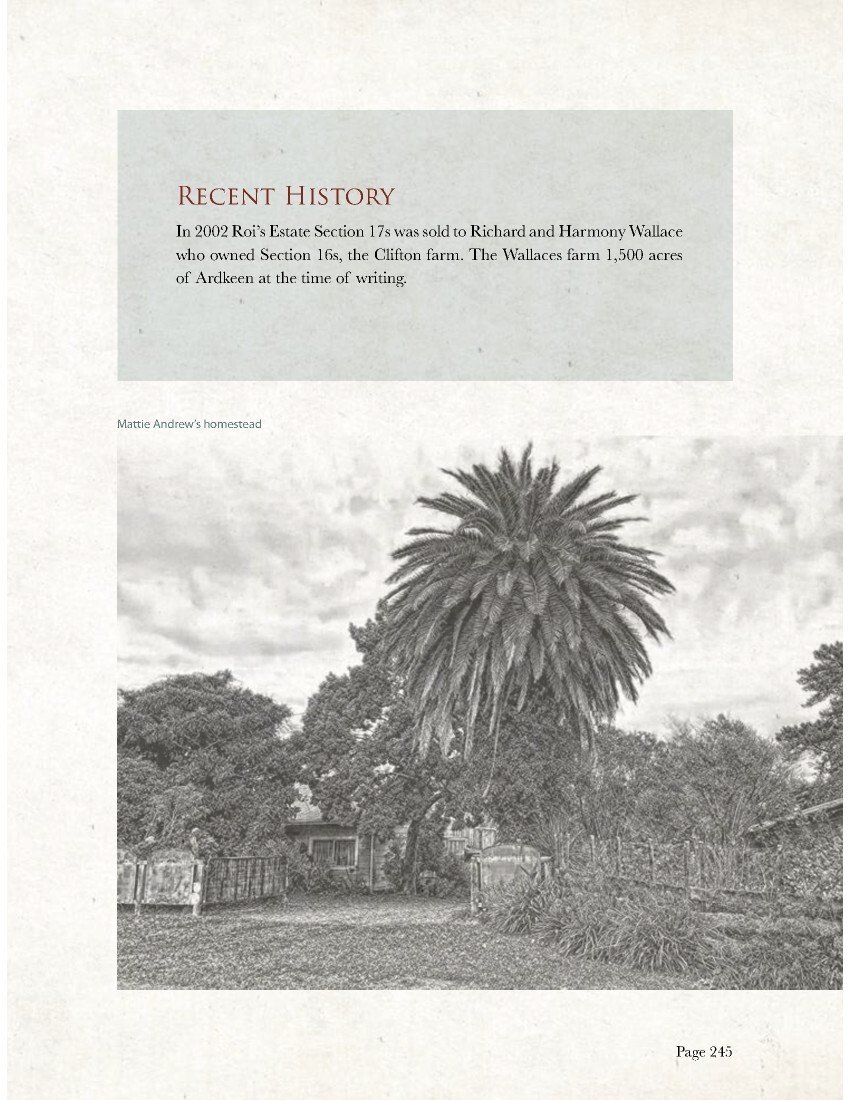
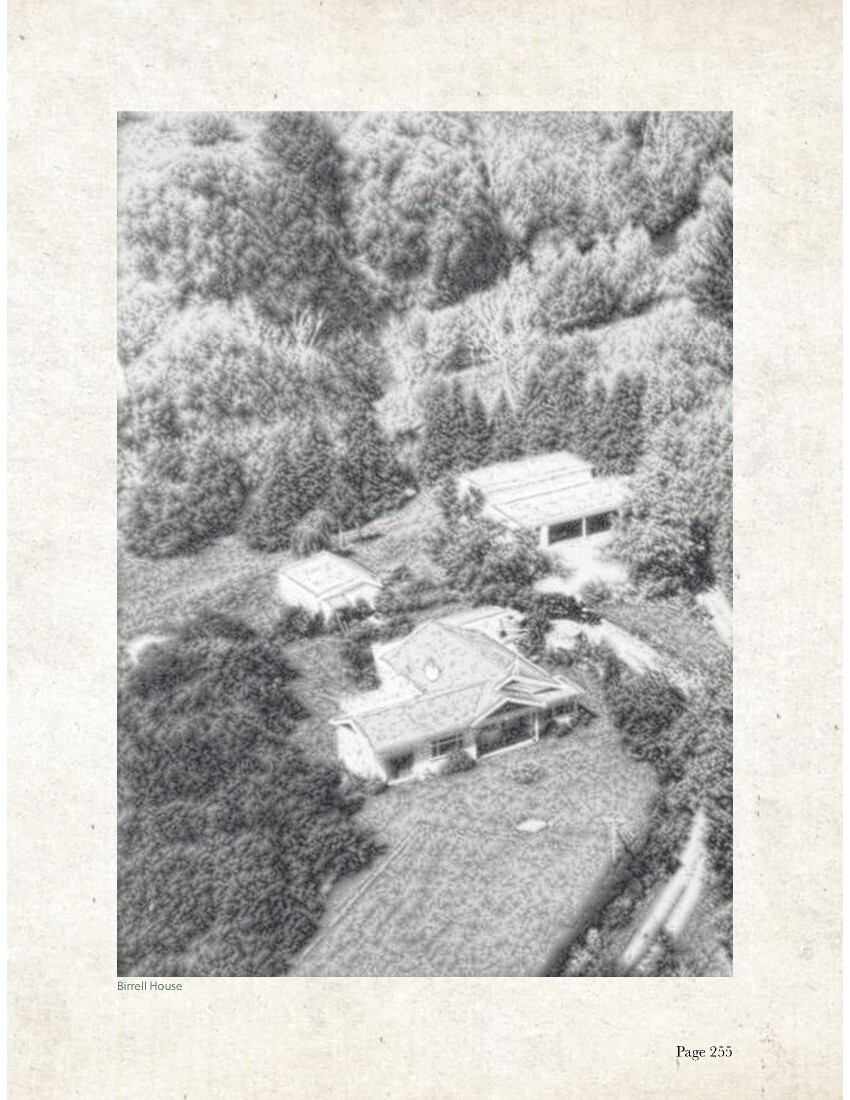
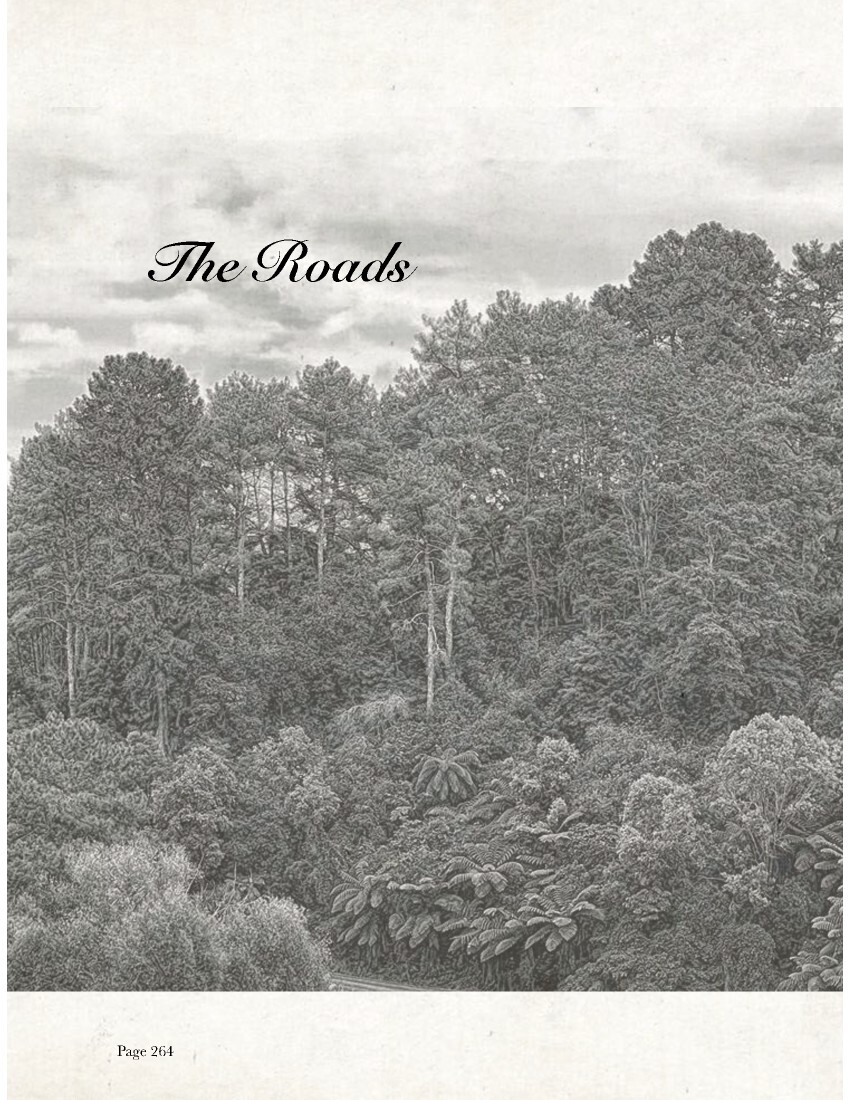










Do you know something about this record?
Please note we cannot verify the accuracy of any information posted by the community.